BMW has revealed the new R 12 nineT (left) and R 12 (right) models for 2024. (BMW/)
BMW dropped more than a couple of hints last year that we might see a midsize cruiser model joining its Heritage lineup, and wouldn’t you know, the brand is staying true to its word. Say hello to the new 2024 R 12 and R 12 nineT, which despite their word salad monikers, look to continue the clean lines of their R nineT predecessor.
With the original R nineT in 2013, BMW combined classic motorcycle design and modern tech with a host of customizing options. There’s now a whole family of these roadsters in the Heritage line, but any casual observer could see there was a big disconnect between them and the R 18 cruiser in terms of design language and configuration. The R 12 and R 12 nineT are here, apparently, to remedy the situation by carrying on the look and custom possibilities of their forebear, but with some key redesigns. Both bikes share the same 1,170cc boxer engine, but it’s hung from a new steel trellis frame with a bolted-on rear section, with a six-speed transmission and shaft drive to put down the power. Of the two, the R 12 nineT roadster hews to the same urban feel as the R nineT, while the R 12 configuration is more laid-back, embracing a relaxed, classic cruiser vibe.
Related: New BMW Cruisers
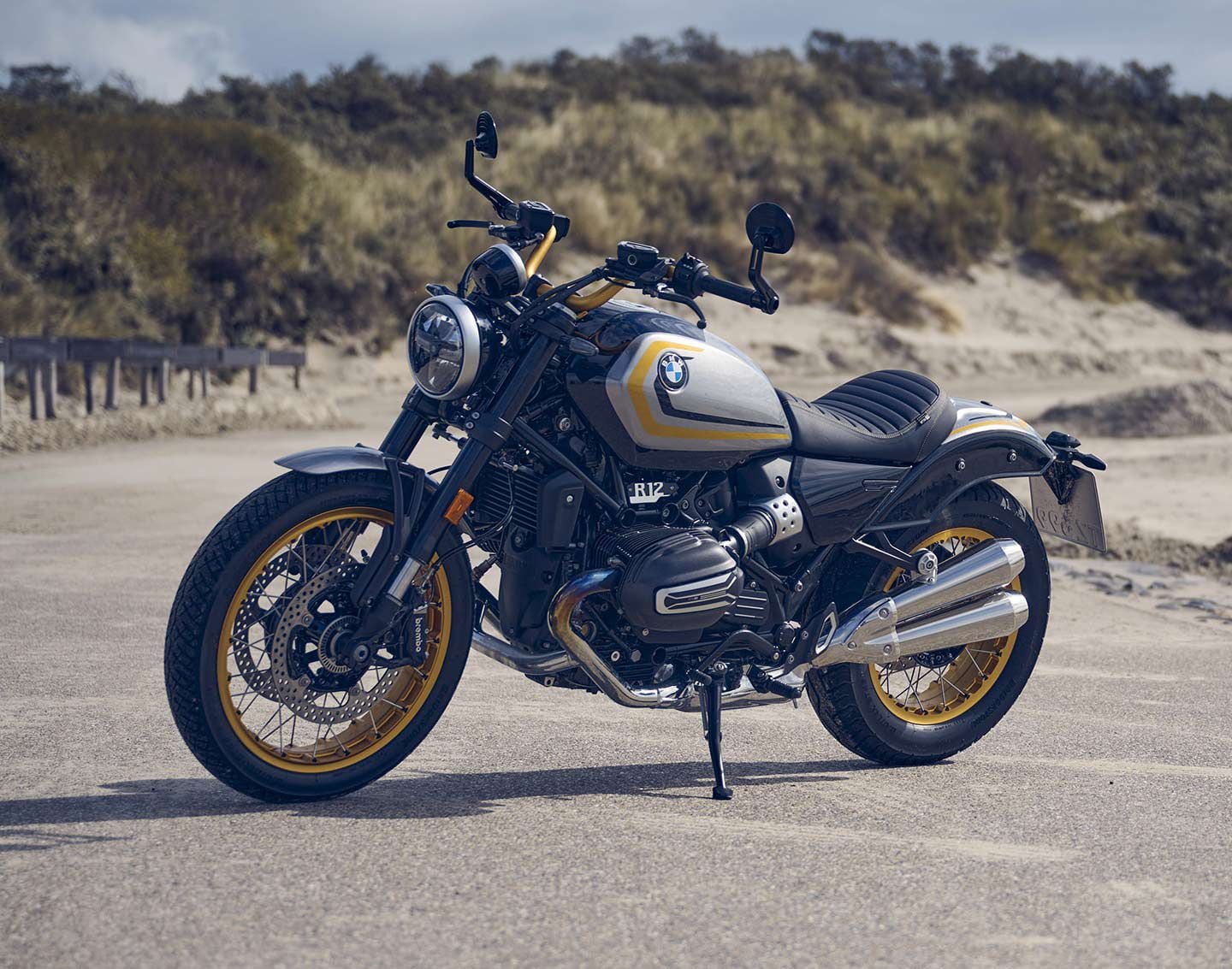
The new 2024 R 12 cruiser shares its boxer engine and new frame with the R 12 nineT, but rolls with a differently shaped steel tank and a more sedate engine tune. (BMW/)
2024 BMW R 12
Let’s dig into the shared elements first. Both bikes are powered by the same 1,170 air/oil-cooled boxer derived from the OG R nineT’s opposed twin, with the same bore and stroke, though it has been updated to meet emissions standards and also sports redesigned cylinder head covers. The airbox has been redesigned and relocated underneath the seat, and the exhaust has been tweaked as well. Both come equipped with a six-speed transmission and a hydraulic clutch, with shaft drive to lay down the power. Dynamic Traction Control and Engine Drag Torque Control also appear on the duo, as does the same braking arrangement; dual 310mm discs and radially mounted four-piston calipers up front, with a 265mm disc, two-piston caliper setup out back. BMW Motorrad ABS Pro is standard as is full LED lighting, keyless ride, USB and 12V power sockets, and adjustable hand levers.
Both bikes even look similar and share the same new one-piece steel trellis frame, which delivers a cleaner look and saves weight over the original R nineT’s two-piece unit. The steel trellis rear subframe is still a separate piece that’s bolted to the frame.
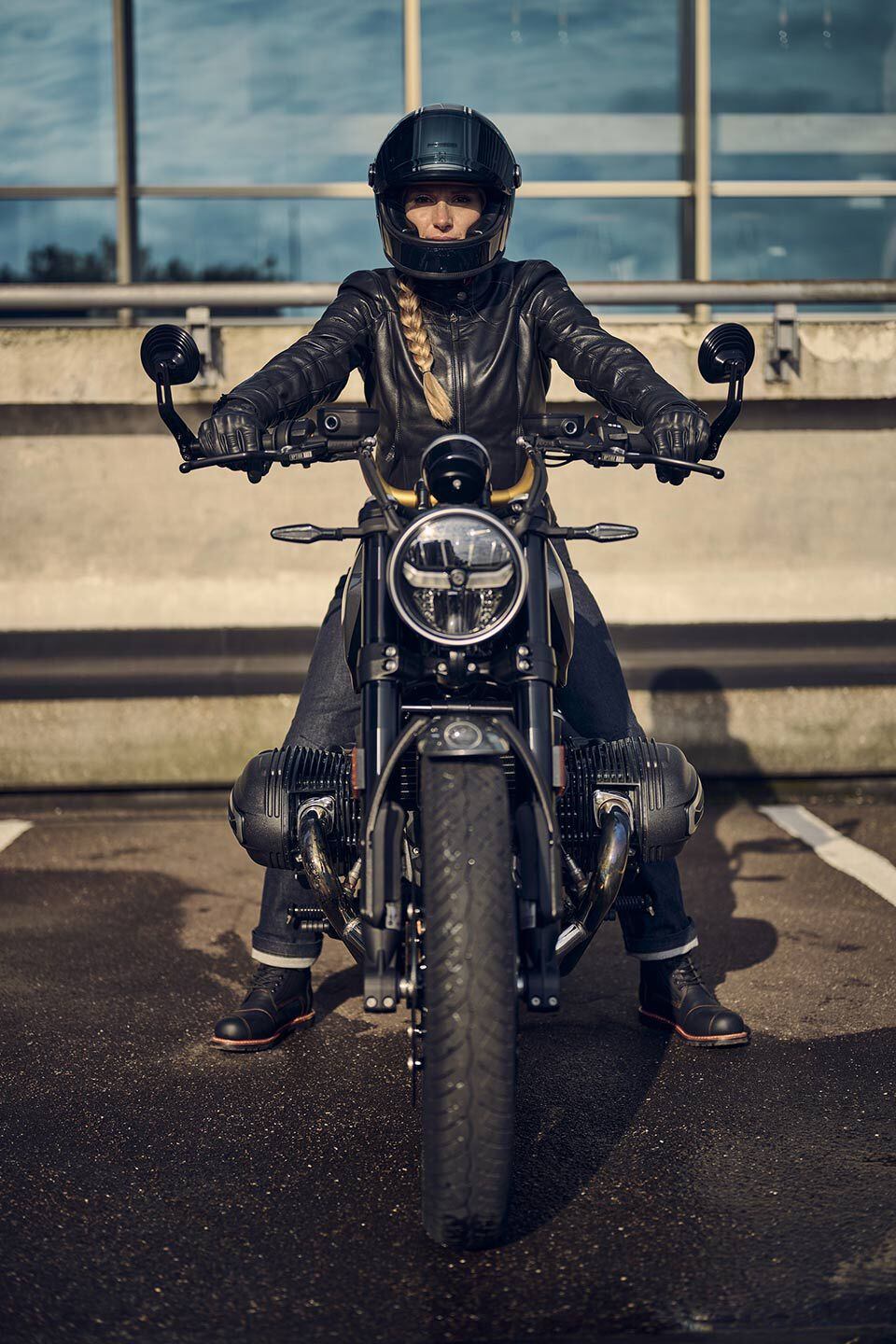
LED lighting comes standard on both bikes, but BMW says you can accessorize the new R 12 in a head-spinning number of ways. (BMW/)
There are telltale differences: The R 12′s steel tank has a unique shape, in homage to the “Toaster” tanks from ‘70s-era /5 models, and the wheels are more cruiser appropriate, with a 19/16 configuration that results in a slightly longer 59.8-inch wheelbase. Both bikes are spec’d with an upside-down 45mm fork, but the R 12′s is more basic and without the adjustability of the R 12 nineT unit, and the rake is lazier. Suspension travel is less too, with 3.5 inches available front and rear, which also contributes to a lower seat height. The R 12 sports a single round instrument panel, and the new exhaust layout has a different brushed finish on the rear muffler.
The mellower mill on the R 12 serves up 95 hp at 6,500 rpm and 81 lb.-ft. of torque at 6,000 rpm, less than its nineT counterpart, but more than enough for its intended purpose. You also get just two ride modes on the R 12—Roll and Rock (as on the R 18 models)—as opposed to the three on the R 12 nineT. Roll is the mellower of the two, while Rock uncorks more power thanks to more immediate throttle response and less invasive DTC.
You’ll be able to get the R 12 in Blackstorm Metallic or Aventurin Red Metallic. There’s also the Option 719 Thorium which features Avus Silver Metallic paint contrasted with yellow striping and gold colored handlebars. Pricing is to be announced.
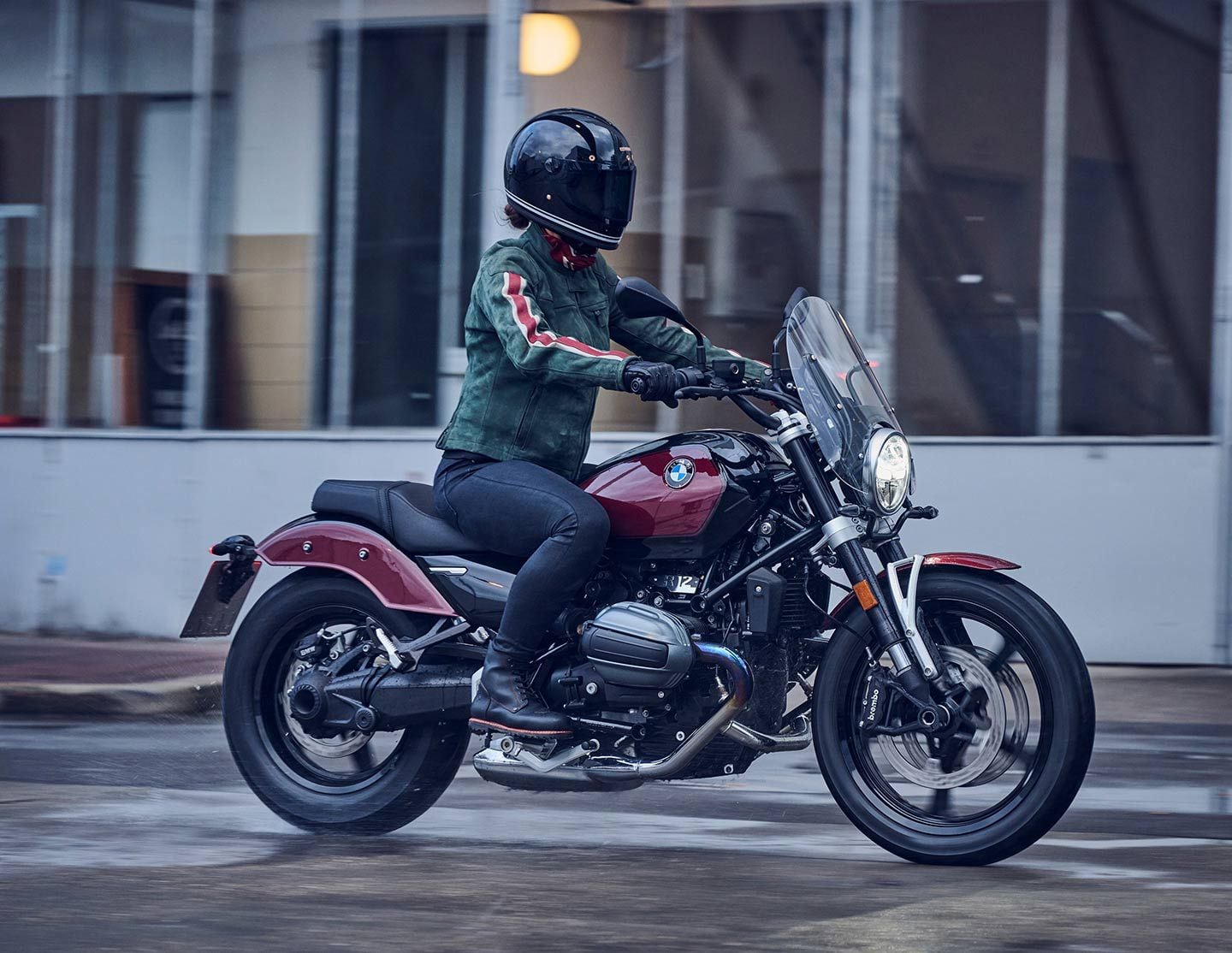
The 2024 BMW R 12 cruiser in Aventurin Red Metallic and an accessory windscreen. (BMW/)
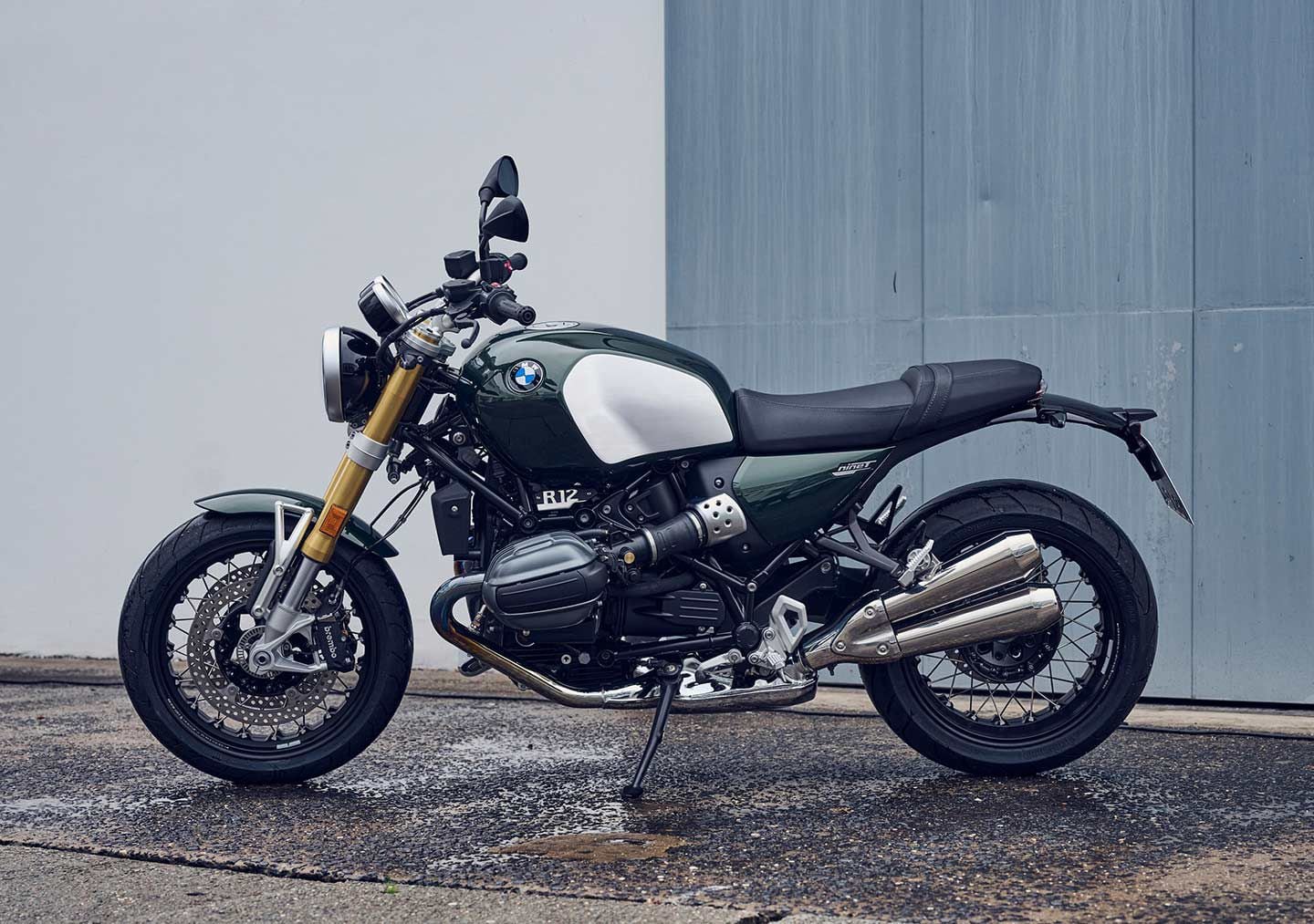
Although it also gets the new one-piece frame, the sportier R 12 nineT inherits most of its predecessor’s streetwise attitude, with more power, 17-inch wheels, and a taller seat than the R 12. (BMW/)
2024 BMW R 12 nineT
The R 12 nineT is the sportier of the two, both in the aesthetic sense as well as in the performance department. Edgar Heinrich, head of BMW Motorrad Design, explained the design team’s approach:
“The purist design language is dominated by the clear tank/seat/rear line, in the style of the traditional /5 or the legendary R 90 S of the ‘70s. At first glance, the tank itself is a classic BMW boxer tank, with a typical bend in the lower edge and classic knee contact.”
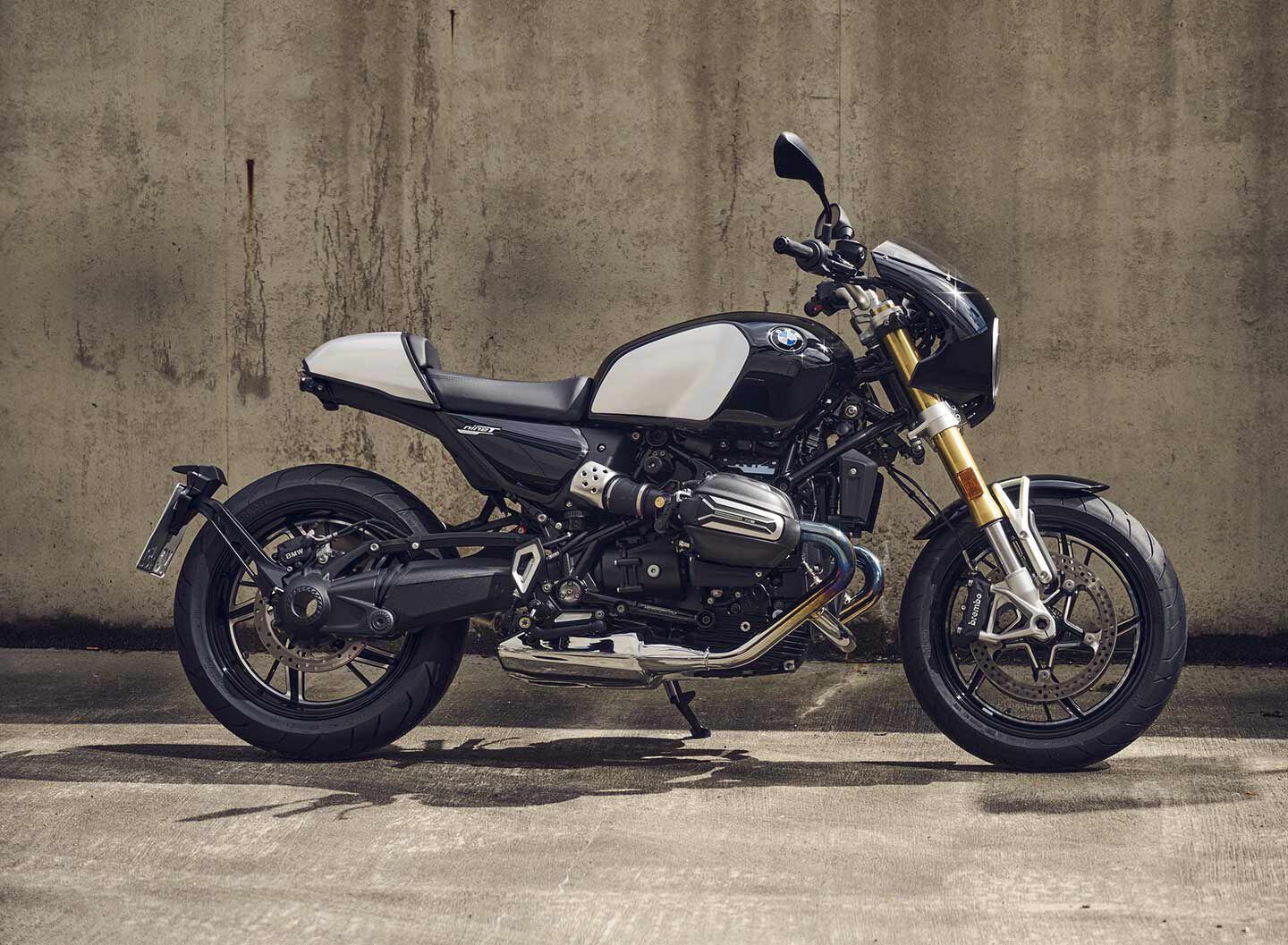
The 2024 R 12 nineT roadster offers adjustability on its 45mm fork, and gets a different tank than the R 12 cruiser, recalling /5 models of the ’70s. (BMW/)
All that plays out in the new aluminum tank which features brushed and clear-coated panels leading back to a tail hump, but the chassis elements differ too, with the R 12 nineT rolling on 17-inch cast alloy wheels front and rear, giving it a slightly shorter wheelbase than the R 12. Its 45mm fork is adjustable for rebound and compression and offers a more robust 4.7 inches travel, and is paired with a paralever swingarm linked to the rear shock which features rebound damping and spring preload adjustability.
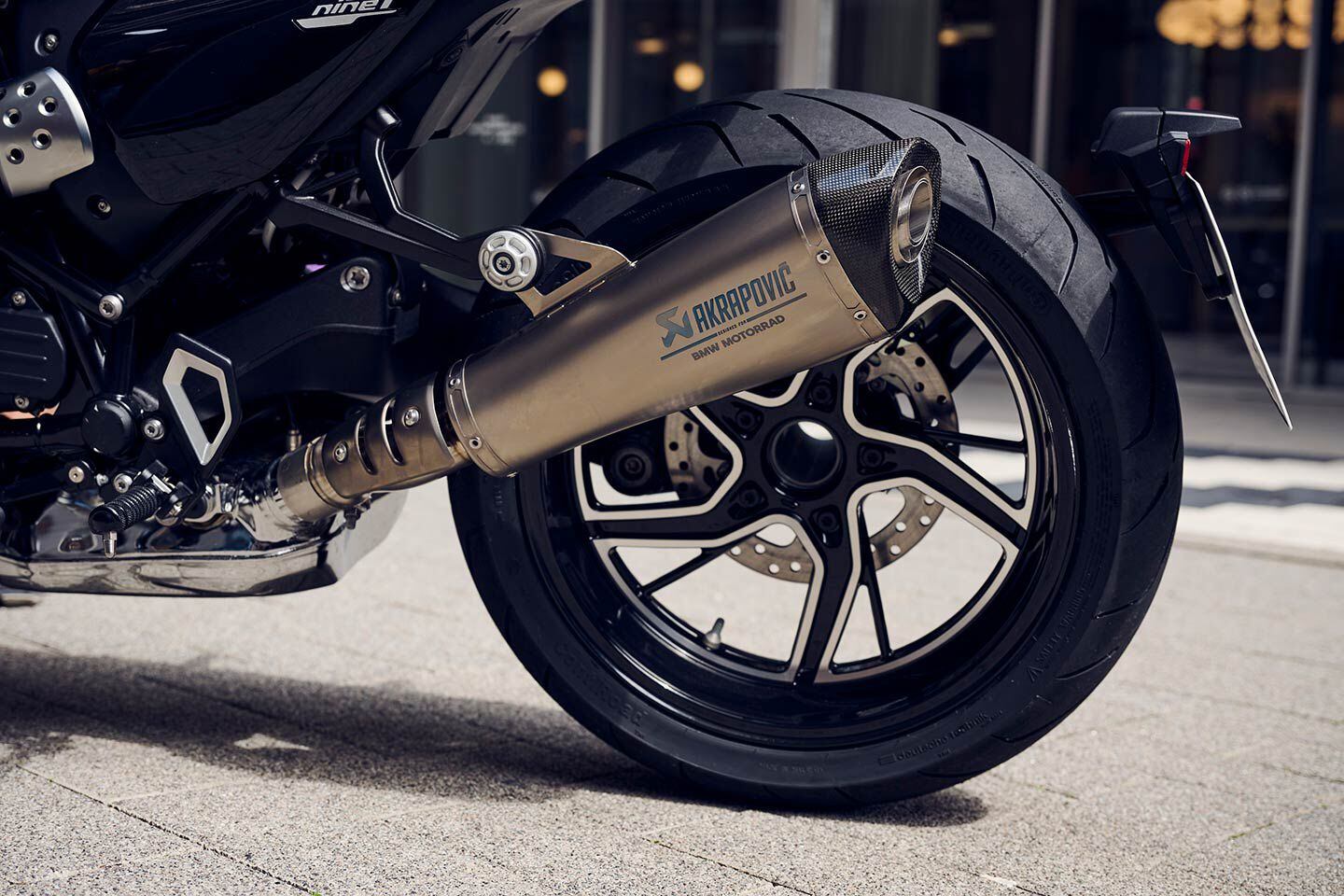
Accessories galore are available for both models, including this mint Akro pipe. (BMW/)
The R nineT gets a performance boost as well, with a different engine tune that results in an impressive 109 hp available at 7,000 rpm and 85 lb.-ft. of torque at 6,500 rpm. You can tweak engine performance via three ride modes, with Rain, Road, and Dynamic on offer. The cockpit looks different too, with the R 12 nineT sporting dual round instruments, different handlebars, as well as smoked rear turn signals and a twin pipe exhaust system with chrome-plated pipes and front muffler along with a polished rear muffler.
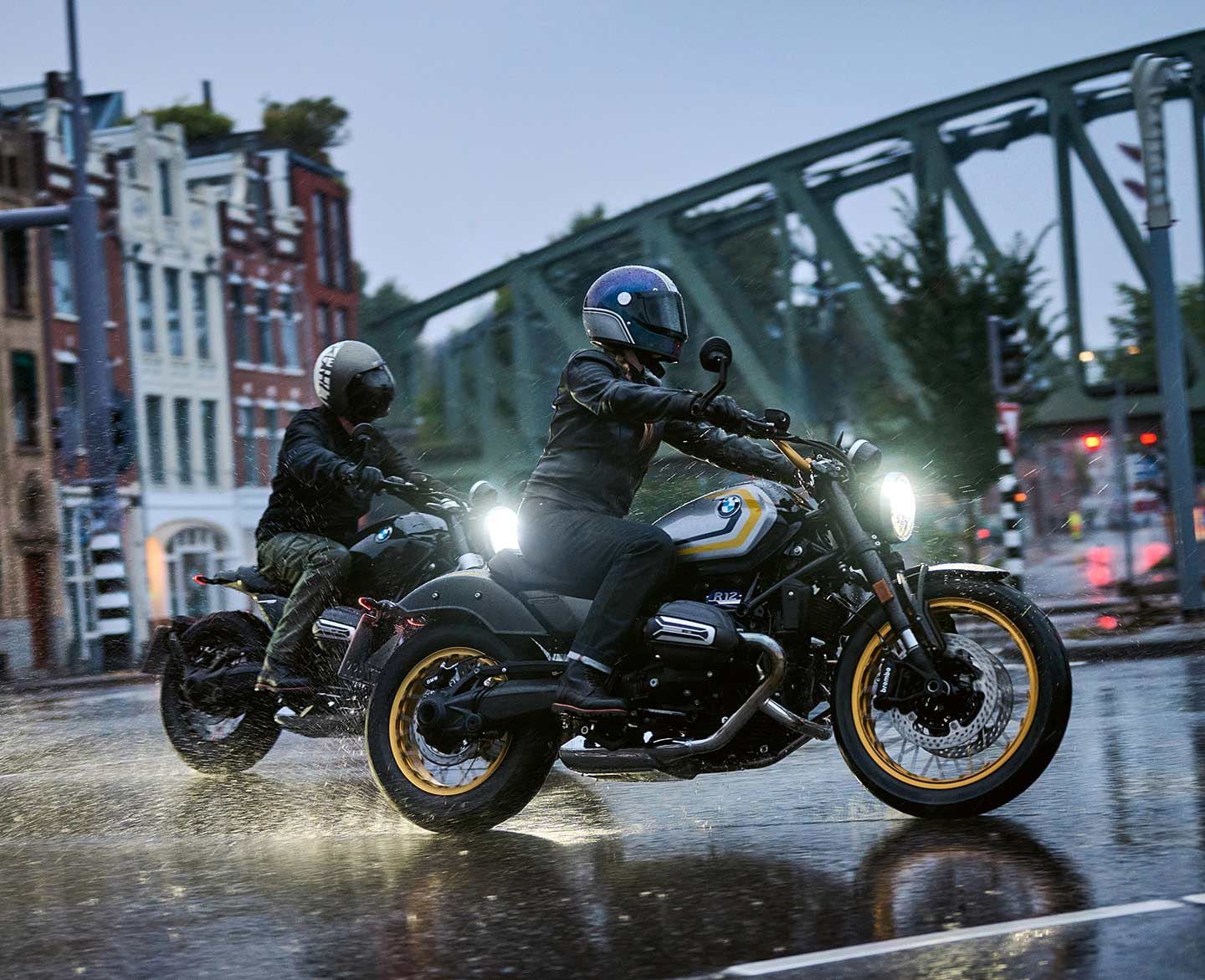
The 2024 R 12 and R 12 nineT will be available early next year, says BMW, with pricing yet to be announced. (BMW/)
As with the R 12, there are a host of optional upgrades available, things like heated grips, Hill Start Assist Pro, Cruise Control, Option 719 packages, Shift Assist Pro, and a pile of other cosmetic, performance, and functional accessories.
The R 12 nineT will be available in Blackstorm Metallic and San Remo Green Metallic, both with gold-colored forks and black frames, or an Option 719 Aluminum in brushed aluminum with black fork, red frame, and a clear-coat brushed aluminum fuel tank with matching tail cover. The bikes will be available in early 2024, with pricing to be announced.
2024 BMW R 12 / R 12 nineT Specs
| MSRP: | NA |
|---|---|
| Engine: | DOHC, air/oil-cooled boxer twin; 4 valves/cyl. |
| Displacement: | 1,170cc |
| Bore x Stroke: | 101.0 x 73.0mm |
| Compression Ratio: | 12.0:1 |
| Horsepower (Claimed): | 95 hp @ 6,500 rpm / 109 hp @ 7,000 rpm |
| Torque (claimed): | 81 lb.-ft. @ 6,000 rpm / 85 lb.-ft. @ 6,500 rpm |
| Transmission/Final Drive: | 6-speed/shaft |
| Fuel System: | Electronic fuel injection |
| Clutch: | Dry, single disc; hydraulically operated |
| Frame: | Steel trellis bridge |
| Front Suspension: | 45mm inverted fork; 3.5 in. travel / 45mm inverted fork, fully adjustable; 4.7 in. travel |
| Rear Suspension: | Monoshock; adjustable rebound and preload 3.5 in travel / adjustable rebound and preload, 4.7 in. travel |
| Front Brake: | 4-piston radial-mount calipers, dual 310mm discs w/ ABS |
| Rear Brake: | 2-piston floating caliper, 265mm disc w/ ABS |
| Wheels, Front/Rear: | Cast; 19 x 2.75 in. / 16 x 4 in.; 17 x 3.5 in. / 17 x 5.5 in. |
| Tires, Front/Rear: | 100/90-19 / 150/80-16; 120/70-17 / 180/55-17 |
| Rake/Trail: | 29.3°/5.2 in.; 27.7°/4.4 in. |
| Wheelbase: | 59.8 in. / 59.5 in. |
| Seat Height: | 29.7 in. / 31.3 in. |
| Fuel Capacity: | 3.7 gal. / 4.2 gal. |
| Claimed Curb Weight: | 500 lb. / 485 lb. |
| Contact: | bmwmotorrad.com |
For 2024, Honda is bringing back the Rebel 1100T touring cruiser unchanged, save for this new matte green color. Prices start at $10,699. (Honda/)
While Honda was grabbing headlines at EICMA last week with its new CB Hornet and CBR1000 sportbike unveilings, Team Red’s American division quietly announced the return of several of its core cruiser models. Among them were the 1100T bagger and its base Rebel 1100 brother, as well as the stalwart entry-level Rebel 300 and 500 models all of them unchanged for the 2024 model year, except for new colors.
Honda also snuck in news of its returning chopper-style Fury cruiser, likewise unchanged but also wearing a funky new color. Let’s get into it.
Related: First Look: 2023 Honda Rebel 1100T Bagger
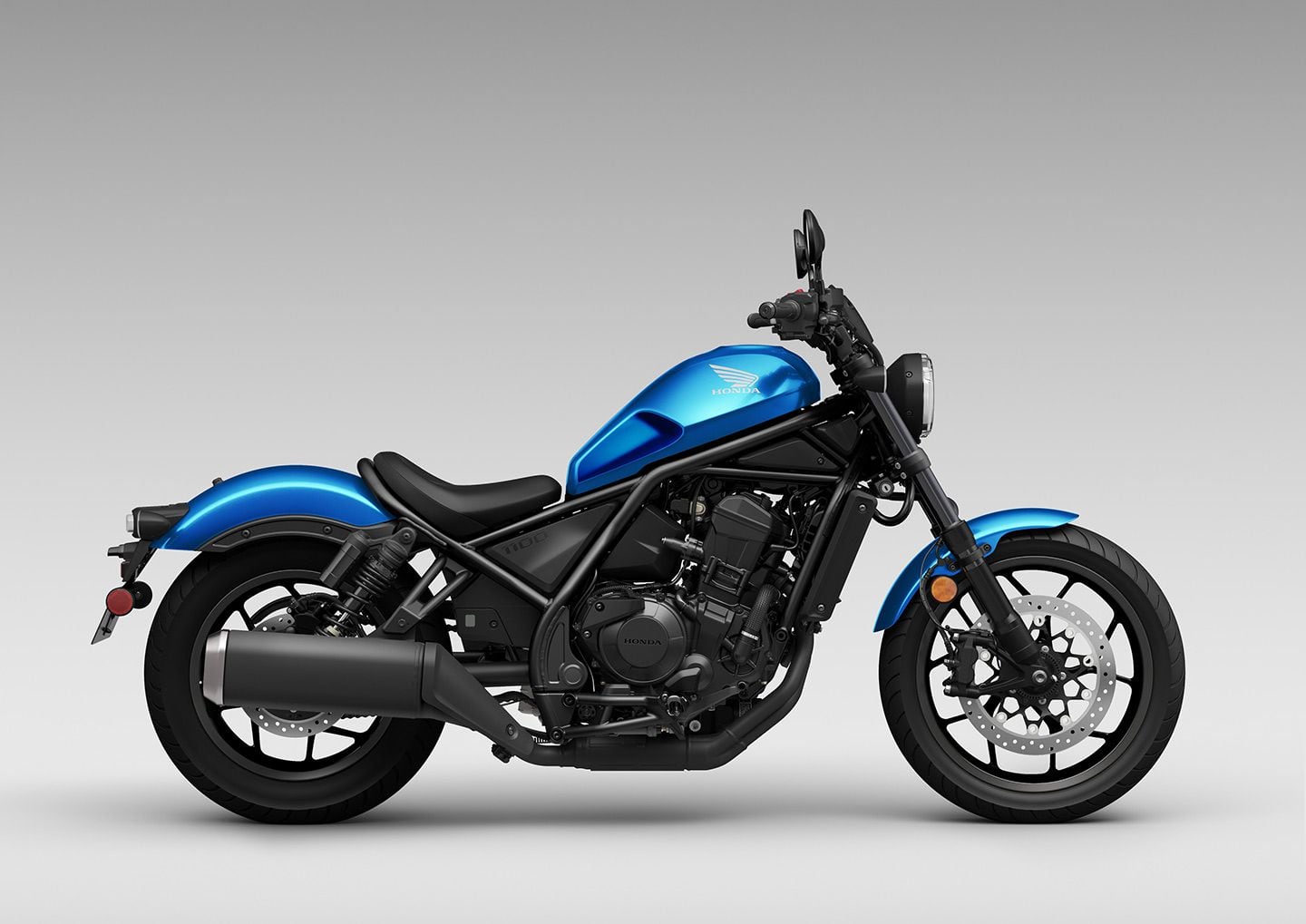
The standard Rebel 1100 is back as well, and is available in this Metallic Blue for an MSRP of $10,149 (DCT). (Honda/)
Honda Rebel 1100 and 1100T
The biggest Rebel returns in two trims, with the base 1100 rocking a six-speed manual transmission and the Rebel 1100 DCT sporting the automatic dual-clutch transmission. Neither bike gets mechanical changes or significant updates, just what Honda calls “contemporary colors,” for the new year.
The Rebel 1100 in either DCT or manual form can be had in Gray Metallic or Metallic Blue, with prices starting at $9,549 for the base model and $10,149 in DCT.
The closely related Rebel 1100T is back as well with two transmission options, and builds on the base model’s stripped-down approach by ladling on a few light touring amenities like a large half-fairing and hard color-matched saddlebags serving up 35 liters of room.
Both trims get the two fresh color options—which for Honda are definitely a departure from the usual red or black choices. The new Matte Armored Green Metallic gives the bagger more of a gritty street look, while the Metallic Black scheme adds a pair of new bronze wheels to offset the usual ebony tones for a performance vibe.
The Rebel 1100T DCT will have an MSRP of $11,349, and the manual Rebel 1100T will be priced at $10,699. All four 1100 bikes hit dealers in January 2024.
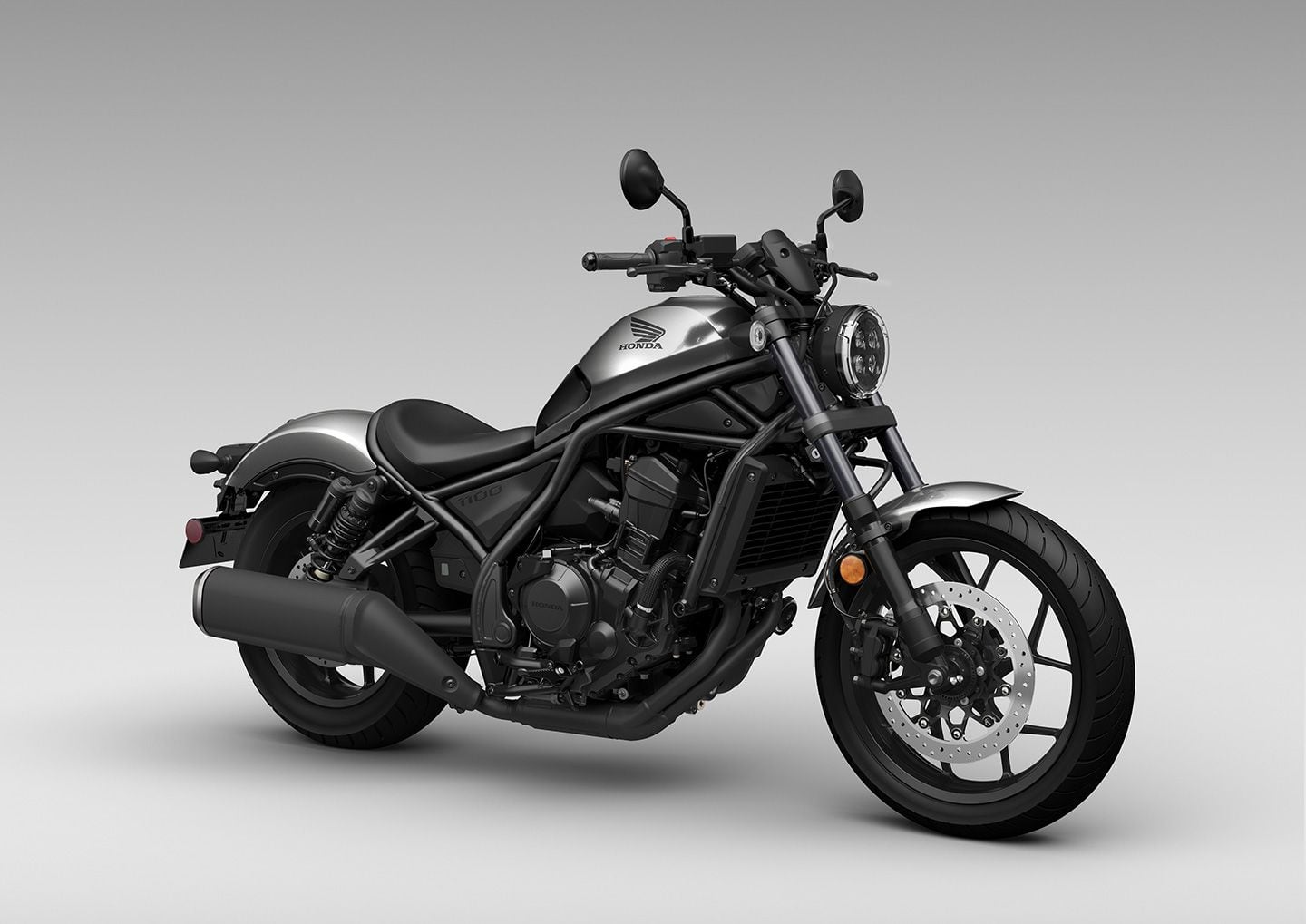
The 2024 Honda Rebel 1100 in Gray Metallic. Price is $9,549 for the standard version. (Honda/)
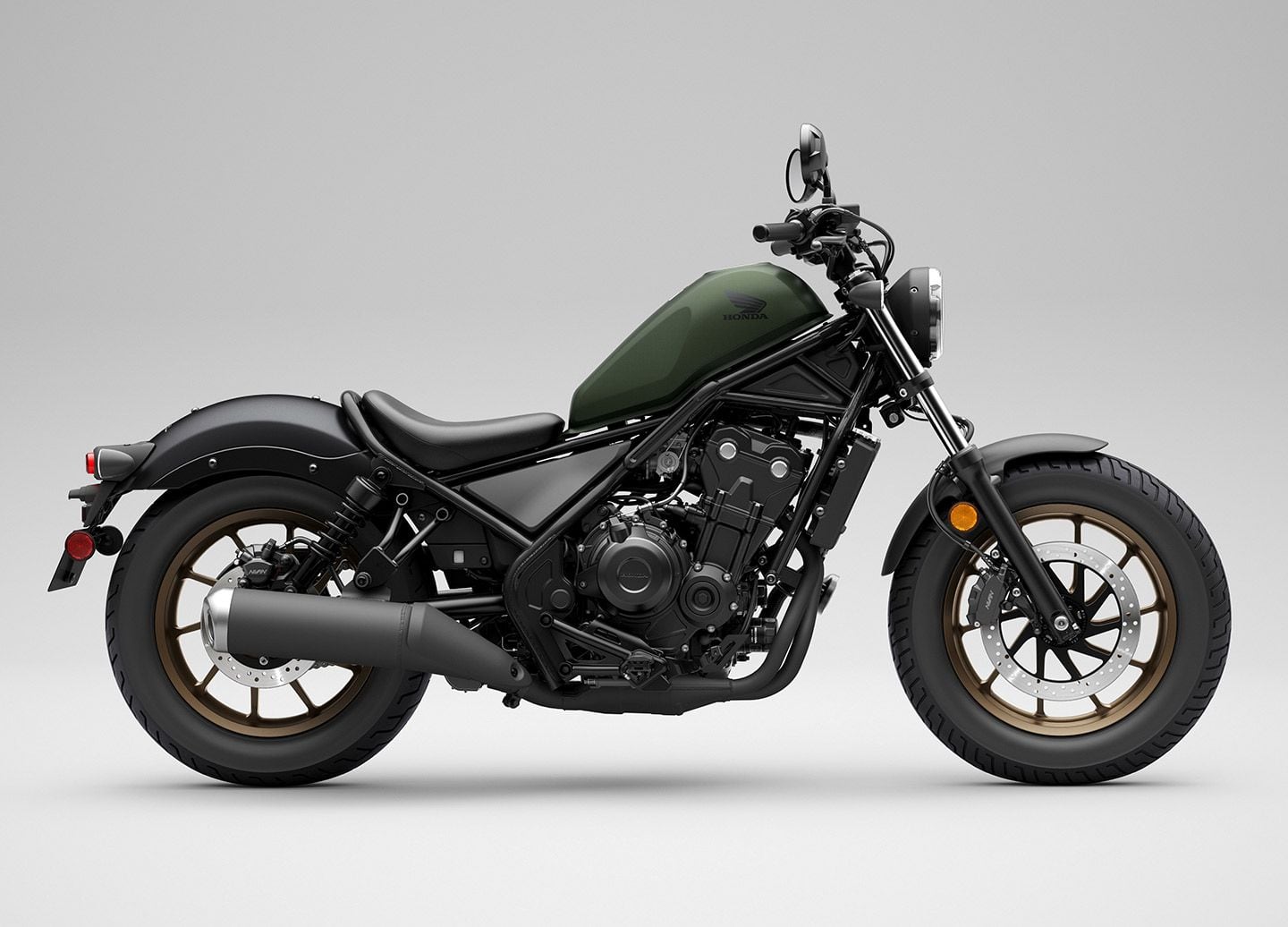
Green seems to be a popular color over at Corporate this year; the Rebel 500 gets it for 2024 as well. (Honda/)
Honda Rebel 500 and S
No surprise, Honda’s massively popular Rebel 500 is returning unchanged this year, but you can choose from three versions. The 500 middleweight keeps on keeping on with a user-friendly 471cc parallel-twin engine managed via a slipper/assist clutch, with its relaxed ergonomics making it a good fit for new and returning riders alike. The stripped-back, “bobber” style with tube steel frame is also unchanged, though you can choose from two new paint options for 2024.
New this year is a Matte Laurel Green Metallic which joins Pearl Black with bronze wheels; both the Rebel 500 and Rebel 500 ABS will be available in these colors. Riders can choose the Rebel ABS SE trim as well, which tricks out the base model with accessories like a headlight cowl, black fork gaiters, and a different seat. In the US, the ABS SE will be available in Pearl Smoky Gray for the 2024 model year.
Pricing starts at $6,499 for the non-ABS base model, with the 500 ABS going for $6,799 and the Rebel 500 ABS SE going for $6,999. All the bikes will be in dealers this January.
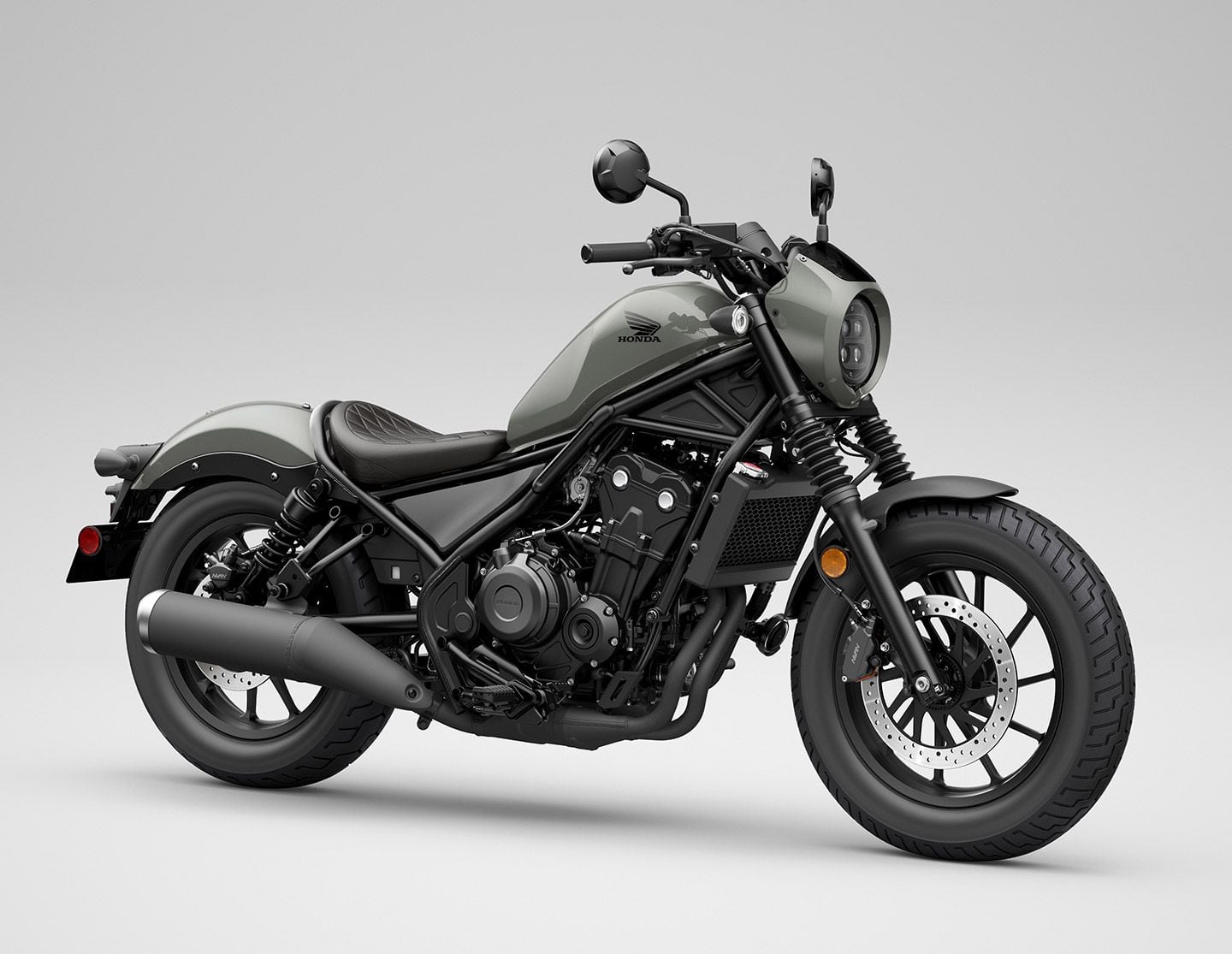
The Rebel 500 SE ABS returns for 2024 as well, but with a new-for-this-year Pearl Gray color. (Honda/)
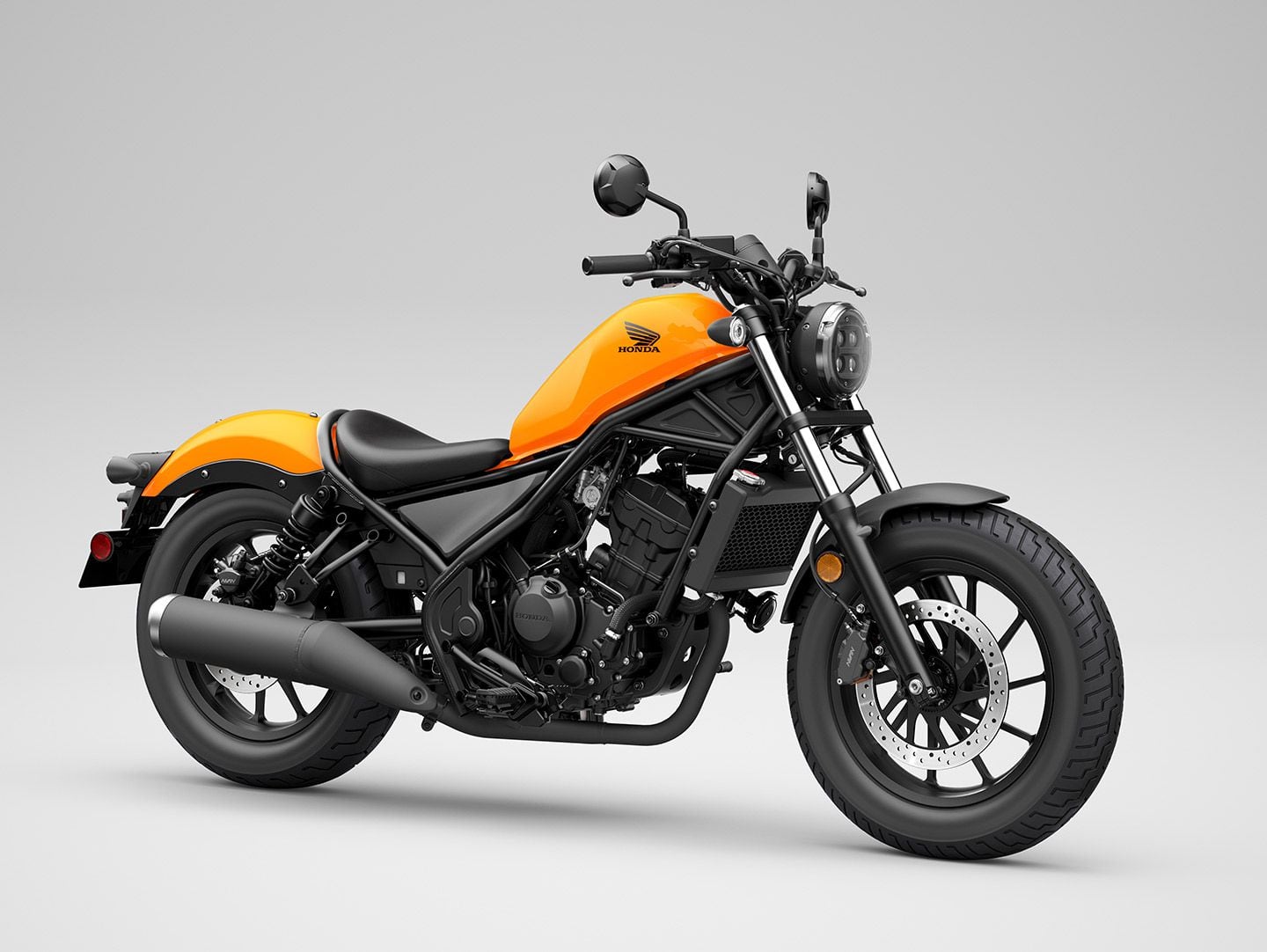
The Honda Rebel 300 can be had in this funky Nitric Orange color this year. (Honda/)
Honda Rebel 300
Honda says it’s “approachable and fun,” and honestly, that’s not too much of an exaggeration for the smallest Rebel. The sorta-cruiser but modern styling has recognizable cues like a peanut fuel tank, solo seat, and blacked-out engine components, but it also has its own identity. This year the 286cc single-powered machine is back in standard and ABS versions in two colors: Pearl Black (no bronze wheels here) and Nitric Orange, with prices starting at under $5,000.
The Rebel 300 ABS is priced at $5,149 while the Rebel 300 has an MSRP of $4,849.
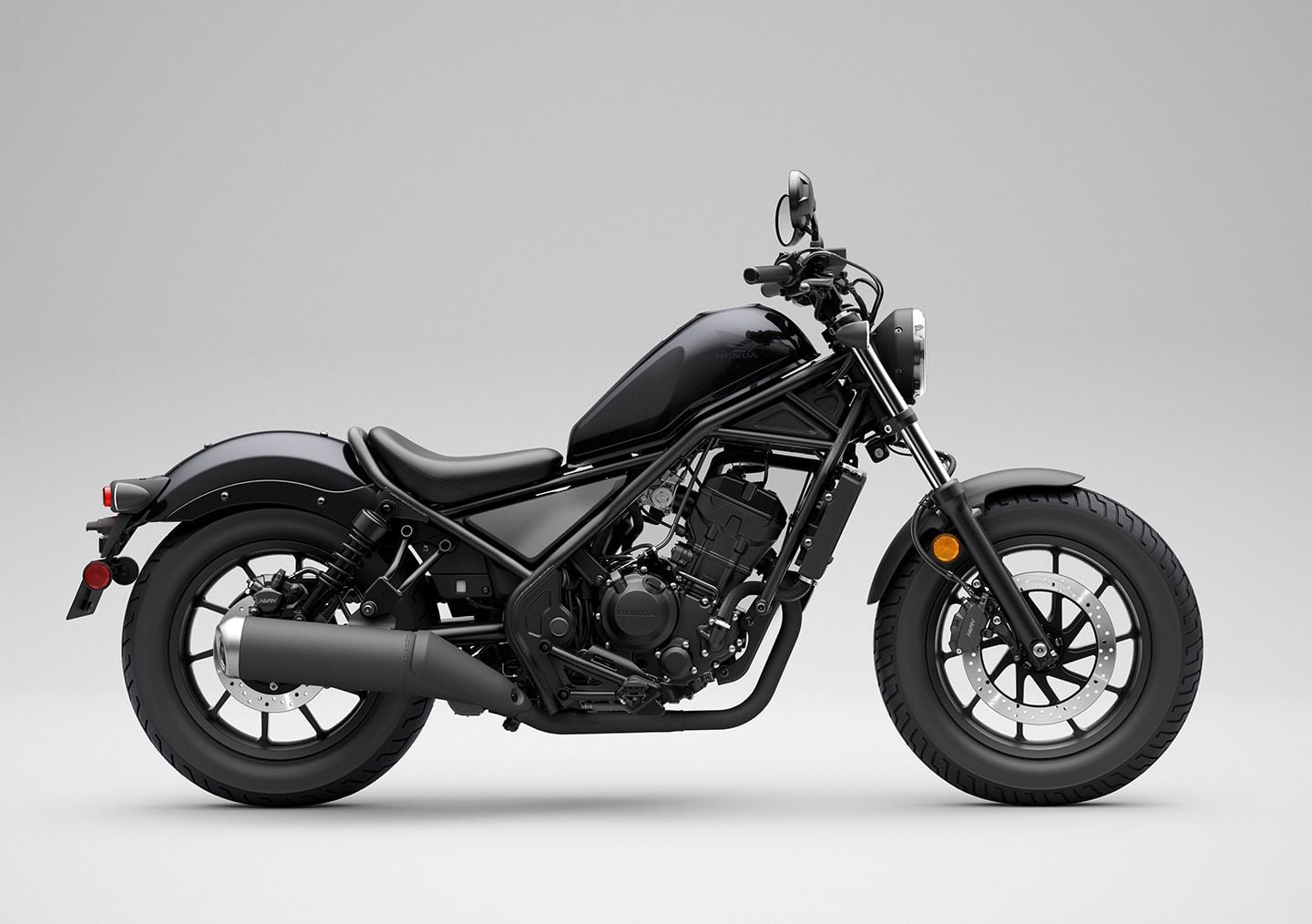
The 2024 Honda Rebel 300 in Pearl Black. MSRP is $4,849 for the base non-ABS model. (Honda/)
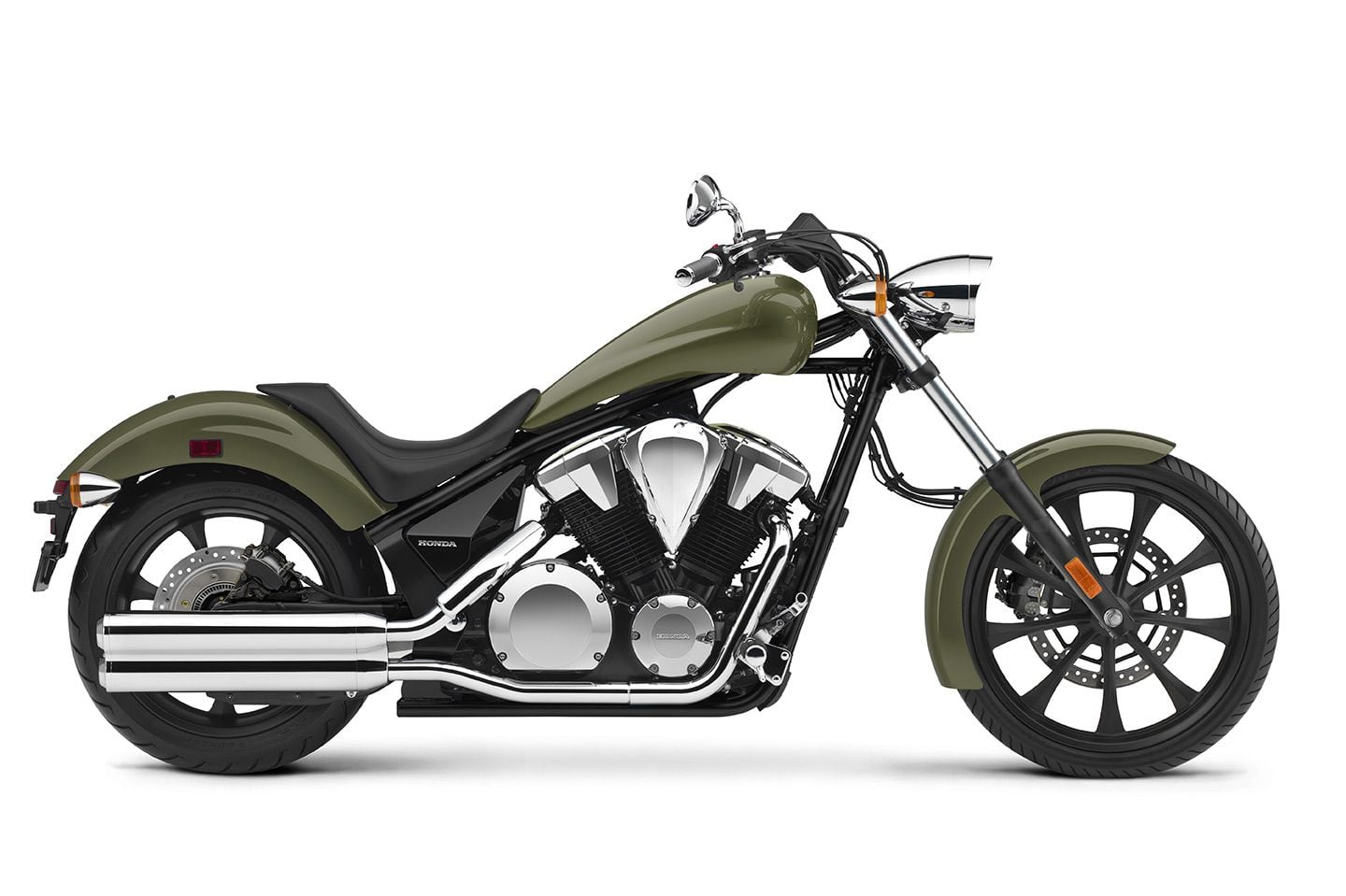
Behold the 2024 Honda Fury, resplendent (?) in Adventure Green. (Honda/)
Honda Fury
It may look a lot different from previous models, but there’s nothing new on the 2024 Fury either—except for the definitely different, new Adventure Green paint job.
The longest current-model Honda we can think of measures 71 inches between the wheels and has a 32 degree rake on the front end, while keeping up appearances with hardtail styling. Despite all that, it handles better than you think, and the 1,312cc V-twin engine is liquid-cooled and fuel injected for modern reliability and a more than adequate punch. All the usual cruiser cues like forward controls, a low 26.9-inch seat, a shapely stretched-out 3.4-gallon tank, and a five-speed transmission can be found here as well, though honestly—who expects shaft drive on a chopper? Yes, there is a rear shock Virginia, and it’s even adjustable for rebound and preload, but travel is a mere 3.5 inches. The nonadjustable 45mm fork, though, gets a reasonable 5.1 inches of travel.
Honda’s custom-style outlier has somehow hung around in the streetbike lineup pretty much unchanged since its 2010 reveal, getting just the usual annual color swaps. And for 2024 it’s more of the same; no changes except for the new Adventure Green paint on the fenders and tank. Sticker price is $11,499—the same as last year—and the bike will be available in December.
]]>Indian rolls out the upgraded 2024 Challenger Elite bagger featuring new Charcoal Candy/Candy Black paint and a completely redesigned audio system. (Indian Motorcycle/)
Indian has released its new model announcements for 2024, and the big news on the list is the new 2024 Challenger Elite, a limited-edition bagger that sits at the top of its ultra-premium Elite series. Actually, can we even call it a series anymore? The press release mentioned no other Elite models (Indian’s website shows a Pursuit Elite and Chieftain Elite but we’re told those aren’t 2024s) so it looks like the Challenger Elite is the sole representative this year, with what’s being called “a sinister blacked-out performance look,” a revamped seat, and most importantly, Indian’s redesigned PowerBand audio system. The bike will be limited to 325 units worldwide.
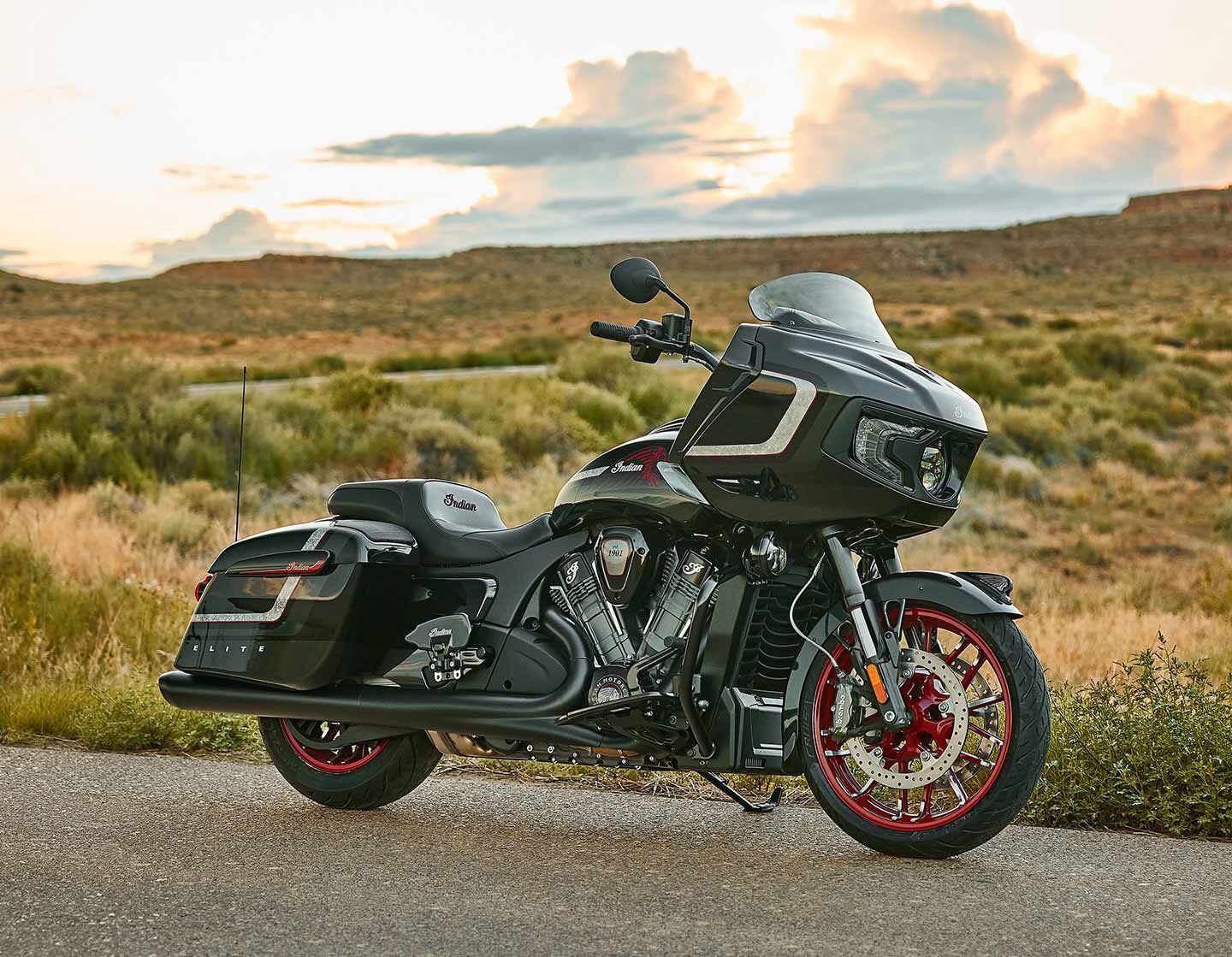
The limited-edition Challenger Elite will have only 325 units available worldwide. MSRP is $38,499. (Indian Motorcycle/)
First up is the new Charcoal Candy/Candy Black paint job, which starts with black candy color applied over a charcoal metallic paint. An acid-etched silver graphic flows from front to back on the fairing, tank, and bags, with a contrast red stripe outline for impact. Redline badges, stitches on the seat, and even the wheels carry the same red theme. Below those styling refinements, though, you’ll still find the excellent foundation of the base Challenger, with a 108ci liquid-cooled PowerPlus engine good for a claimed 122 hp and 128 lb.-ft. of torque along with an aluminum frame, chassis-mounted fairing, and a full complement of luxury touring amenities.
Related: 2022 Indian Challenger Elite and Chieftain Elite First Look
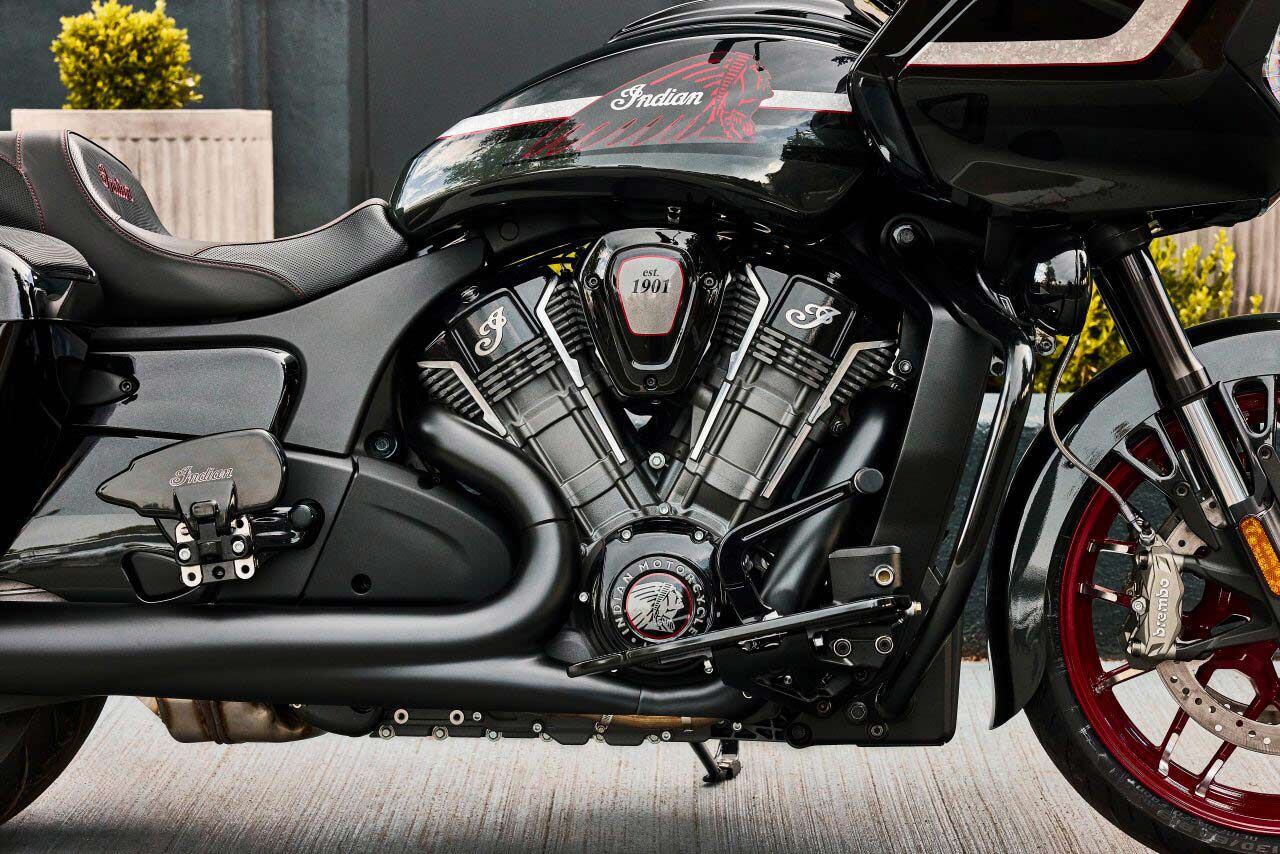
The 1,768cc liquid-cooled PowerPlus engine gets a darker charcoal tone and special Elite badging, while the seat carries new stitching as well. (Indian Motorcycle/)
As with all Elite models there’s no shortage of creature comforts on the Challenger version, which rocks an adaptive LED Headlight, LED driving lights, an adjustable flare windscreen, driver and passenger floorboards, heated grips, saddlebag lights, saddlebag closeouts, and three selectable ride modes including Tour, Standard, and Sport. Then there’s the slick, electronically adjustable Fox rear suspension, which comes standard on the Challenger Elite and allows riders to adjust the preload right from the bike’s infotainment system.
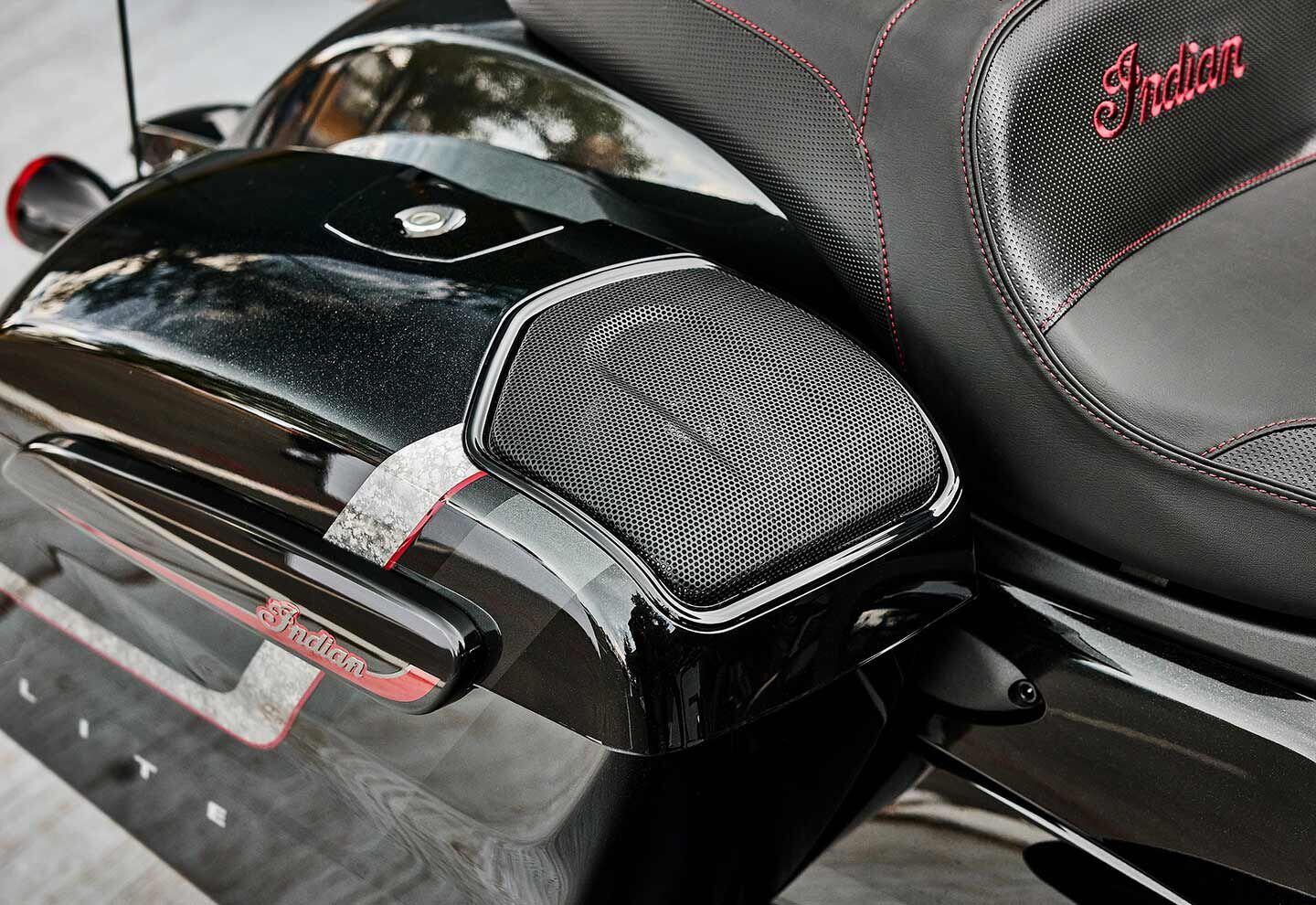
Redesigned PowerBand audio includes eight revised speakers that now feature accent LED lighting and a new look. (Indian Motorcycle/)
That infotainment setup should come as no surprise either, with the familiar 7-inch touchscreen powered by Indian’s Ride Command system taking center stage and offering Apple CarPlay integration, turn-by-turn navigation, Bluetooth connectivity, and more. Riders can access the bike’s IMU-enabled Smart Lean Technology from here as well to tune traction control and ABS or select ride modes (Rain, Standard, or Sport). Backlit switch cubes help you spot crucial control functions at night while the Pathfinder Adaptive LED headlight and LED driving lights serve to illuminate nighttime cruises, and an adjustable tinted flare windshield up front can be raised or lowered with the push of a button.
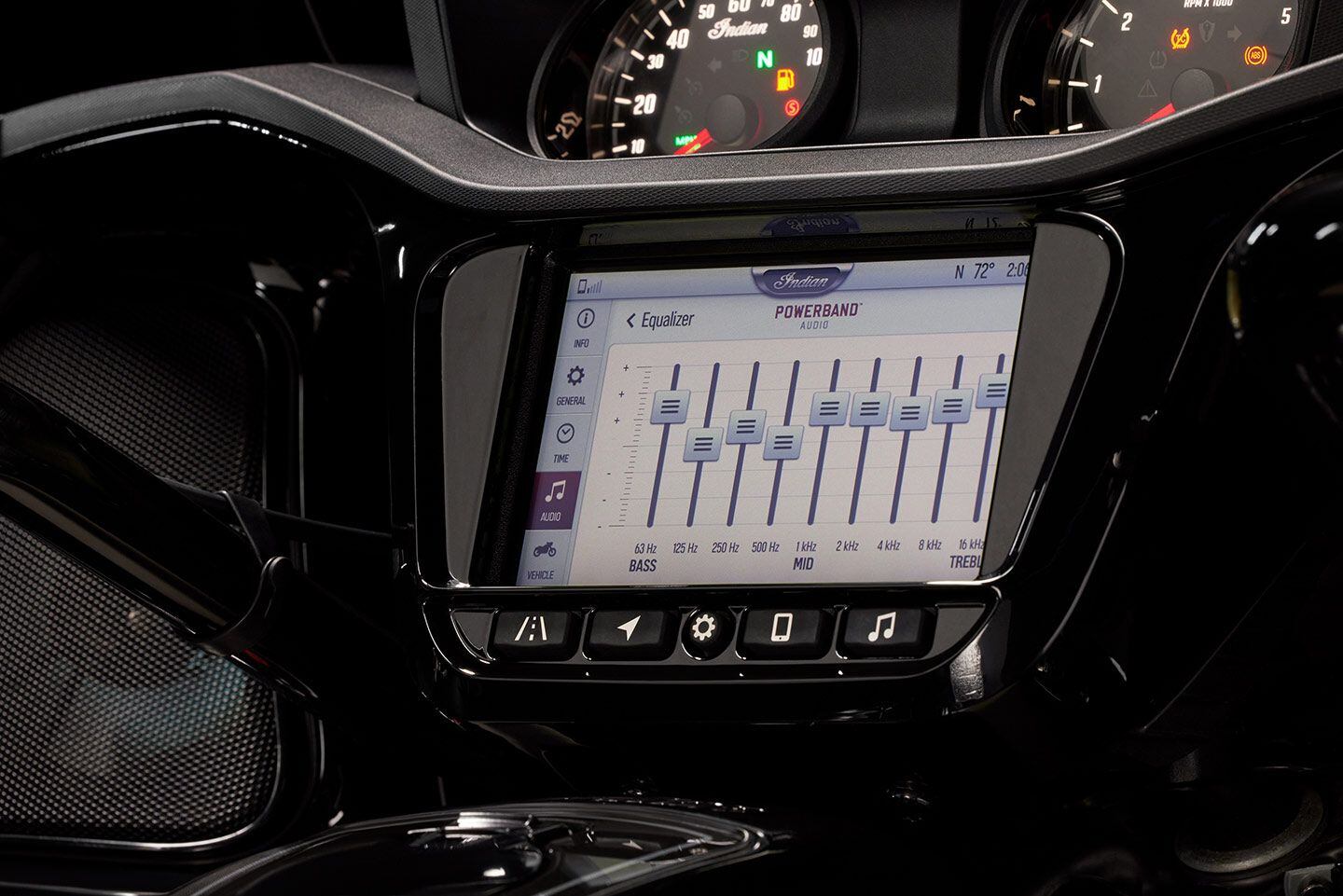
The new audio system uses Ride Command on the 7-inch display to access amplifiers and a nine-band equalizer for higher volume and better clarity at speed. (Indian Motorcycle/)
But the main upgrade Indian is pushing on the Elite is its completely redesigned PowerBand audio system featuring four 100-watt speakers, two fairing speakers, and two saddlebag speakers. It comes standard exclusively on the Challenger Elite, though it’s available as an upgrade on the other Challenger models. The system leverages Ride Command to operate a cluster of built-in amplifiers, a nine-band equalizer, and 16 speakers to deliver what Indian says is “better sound clarity at speed.”
The 100-watt speakers are said to produce higher volume, clearer tones, and 50 percent more bass via the new Bass Boost Tune. New Dynamic EQ optimizes tunes for the highest-quality audio as conditions change, and the speakers are also redesigned for a more modern look, as well as getting new UnderGlow LED accent lighting.
The company says it’s the “loudest audio in Indian Motorcycle history,” with riders able to take the system up to 800 watts; the new PowerBand system can be easily installed on 2020–2024 models or owners can get the Bass Boost Tune software upgrade at the local dealership.
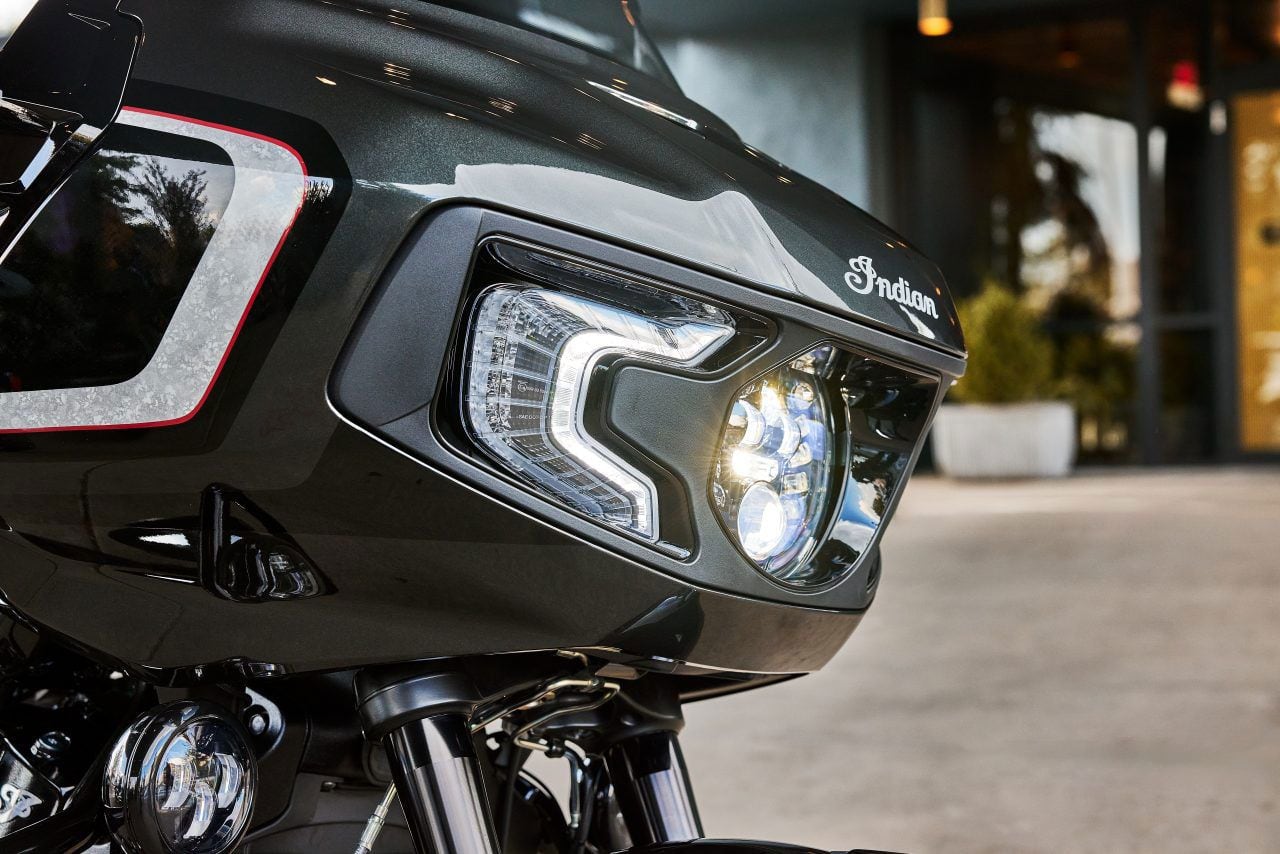
The Challenger Elite also comes standard with a Pathfinder Adaptive LED headlight and LED driving lights integrated into the lower fairings. (Indian Motorcycle/)
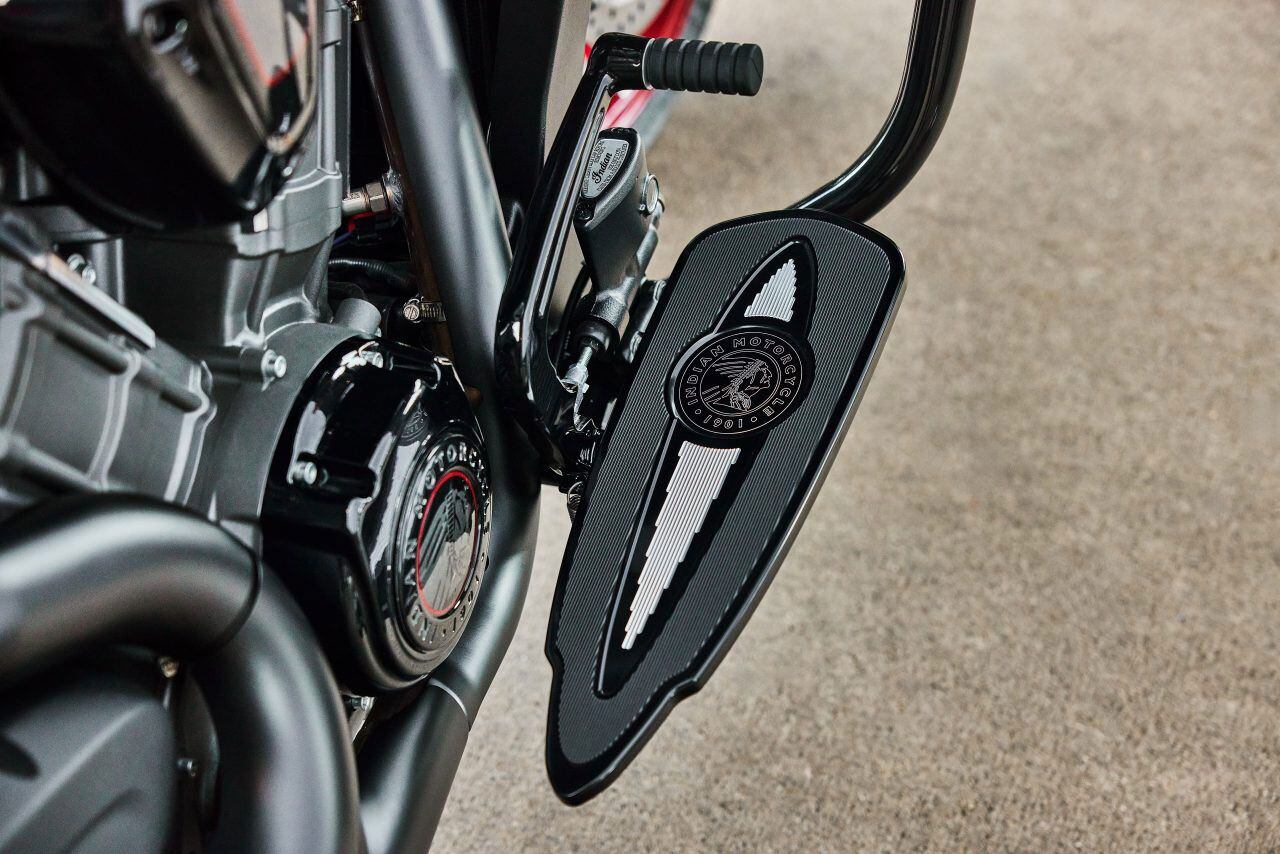
Rider and passenger floorboards feature a new headdress design this year. (Indian Motorcycle/)
Other returning Challengers for 2024 include the base-model Challenger, the Challenger Dark Horse, and the Challenger Limited, though they’re mostly unchanged except for new colors and pricing.
The 2024 Indian Challenger starts at $26,499 and will be available in either Black Metallic or Titanium Smoke.
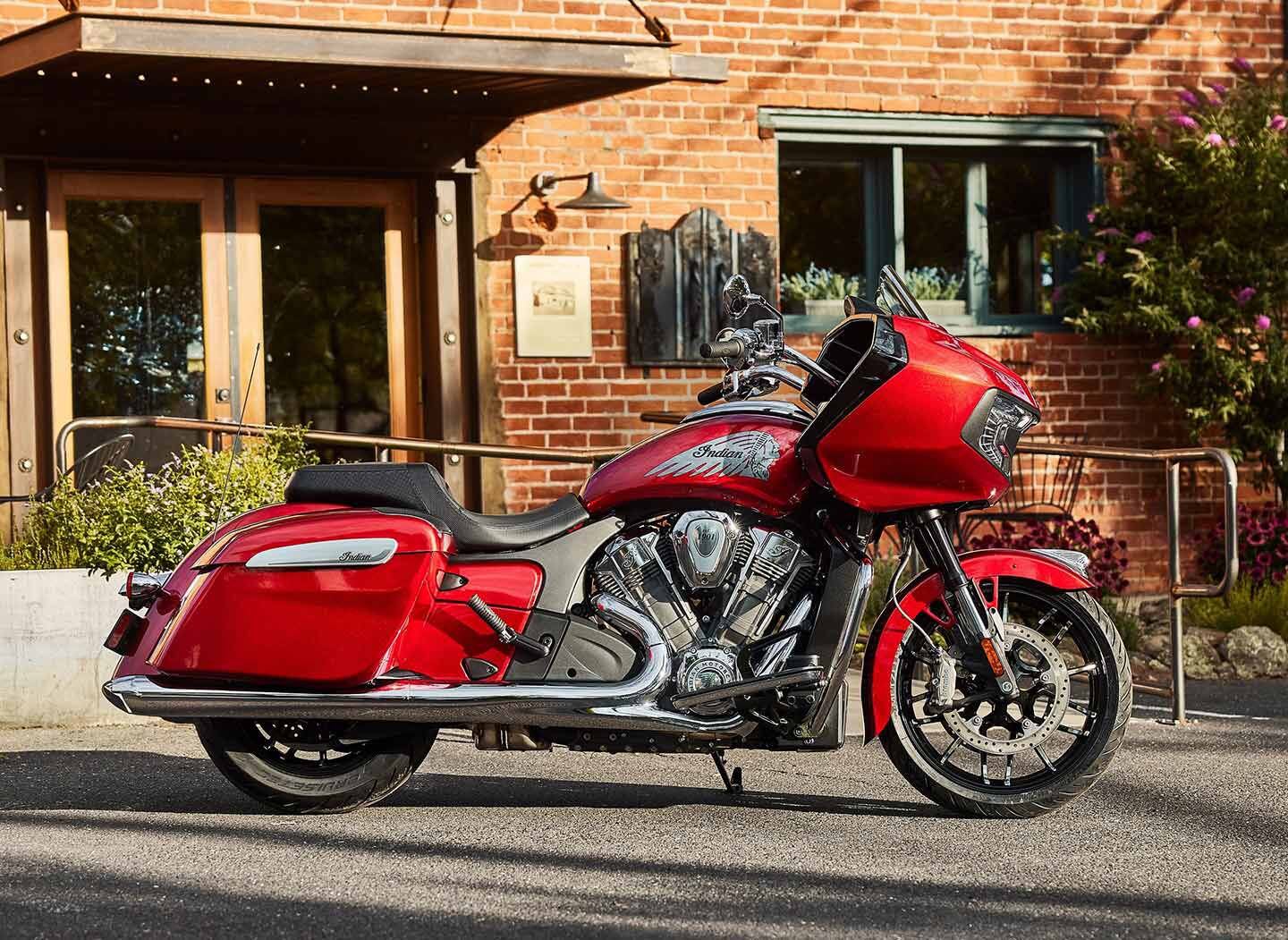
The 2024 Indian Challenger Limited is unchanged this year but has new color options. (Indian Motorcycle/)
The 2024 Indian Challenger Limited has a starting MSRP of $29,999 and is available in Black Metallic, Ghost White Metallic, or Sunset Red Metallic colors.
The 2024 Indian Challenger Dark Horse rolls in at $30,999 to start, with color options including Black Smoke; Sunset Red Smoke; Spirit Blue Smoke; Sunset Orange (Icon); Storm Gray (Icon); Black Metallic over Smoky Quartz Metallic Pearl (Icon).
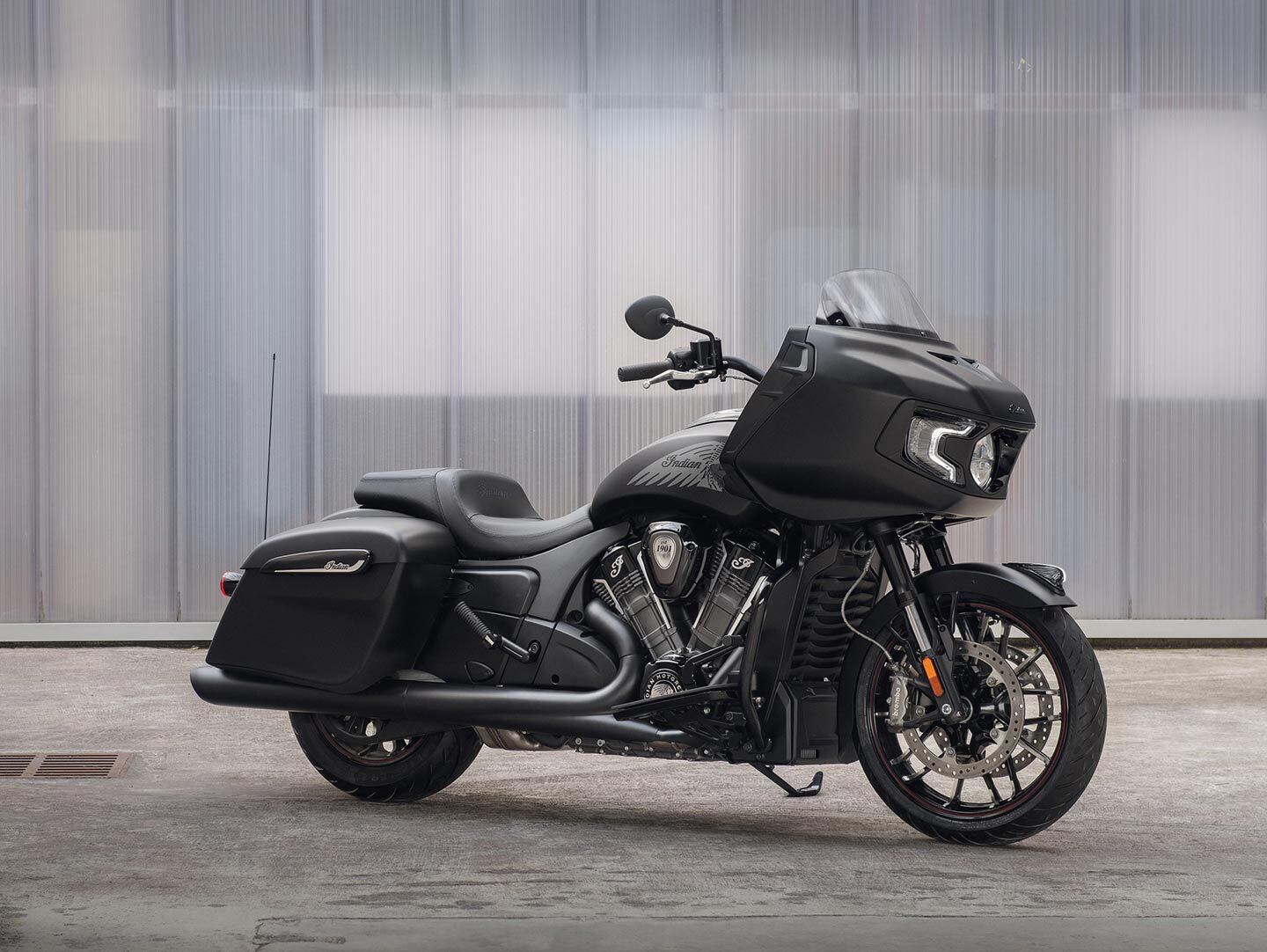
The Challenger Dark Horse is also the same mechanically as last year’s model; MSRP starts at $30,999. (Indian Motorcycle/)
The 2024 Indian Challenger Elite starts at $38,499 and comes only in the custom-inspired Charcoal Candy/Candy Black color. All the bikes will start shipping to Indian dealers in the US and Canada this month. More info can be found at indianmotorcycle.com.
2024 Indian Challenger / Challenger Elite Specs
| MSRP: | $26,499–$38,499 |
|---|---|
| Engine: | 1,768cc, liquid-cooled, 60-degree V-twin |
| Bore x Stroke: | 108.0 x 96.5mm |
| Compression Ratio: | 11.0:1 |
| Claimed Horsepower: | 122 hp |
| Claimed Torque: | 128 lb.-ft. @ 3,800 rpm |
| Transmission/Final Drive: | 6-speed/belt |
| Fuel Delivery: | Closed-loop electronic fuel injection w/ 52mm throttle bodies |
| Clutch: | Wet, multiplate w/ assist |
| Front Suspension: | 43mm telescopic fork; 5.1 in. travel |
| Rear Suspension: | Fox shock, hydraulically adjustable preload, 4.5 in travel; Fox shock, electronically adjustable preload; 4.5 in. travel |
| Front Brake: | 4-piston calipers, dual 320mm semi-floating discs w/ ABS |
| Rear Brake: | 2-piston caliper, 298mm floating disc w/ ABS |
| Wheels, Front/Rear: | 5-spoke cast; 19 x 3.5 in. / 16 x 5 in. / (w/ tire pressure monitoring) |
| Tires, Front/Rear: | Metzeler Cruisetec; 130/60B-19 / 180/60R-16 |
| Rake/Trail: | 25.0°/5.9 in. |
| Wheelbase: | 65.7 in. |
| Ground Clearance: | 5.4 in. |
| Seat Height: | 26.5 in. |
| Fuel Capacity: | 6.0 gal. |
| Claimed Dry Weight: | 796 lb. / 804 lb. |
| Contact: | indianmotorcycle.com |
Triumph calls on its in-house paint shop to work its magic once again for the eight Bonneville Stealth Edition models. (Triumph/)
If you’re a manufacturer with a well-respected paint shop already set up in-house, you might as well get the most you can out of it, right? So goes the thinking (we imagine) over at Triumph Motorcycles, which seems to have found a winning formula in issuing limited-edition versions of its Classics line, each sporting high-zoot new paint jobs. We’ve seen the Gold Line Editions, Chrome Editions, and now, the latest series sporting dramatic hand-finished custom colors, the Bonneville Stealth Editions.
The limited-edition Stealth models will be available for one year only, starting in 2024, and look to showcase a dramatic new paint technique from Triumph’s paint team. The process starts with a mirror-finish silver base coat, and a carefully layered Sapphire Black graphite vignette goes over that, transitioning from a dark to light tone front to back. The final touch is a translucent tinted lacquer applied in several layers for a deep top coat. According to Triumph, the paint looks different from every angle, and pops especially when exposed to light in varying hue and tone. Because the paint is applied by hand, that means there are subtle variations, “making every motorcycle truly unique.”
But while all the bikes look far more sophisticated under a new coat of paint, there are no mechanical or cosmetic changes to these 2024 editions; after all, most of the Bonneville platform received a major update in 2022, with some models also renamed.
Triumph says orders can be placed now at dealers, with units arriving in dealerships by February 2024.
Related: Triumph Announces Cruiser and Modern Classic Models for 2023
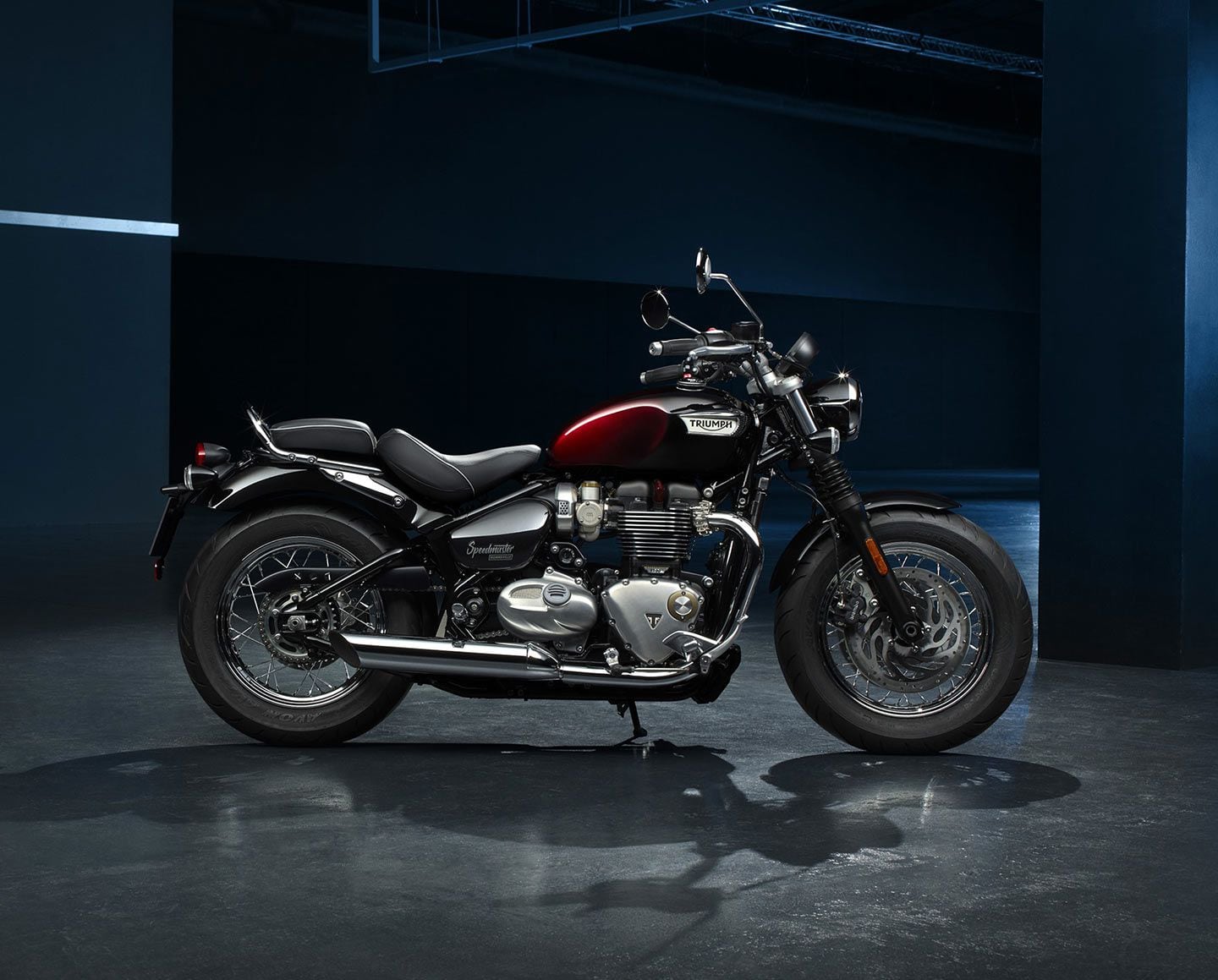
The Bonneville Speedmaster Red Stealth Edition keeps its 1,200c engine but gets an intense new red design. (Triumph/)
Bonneville Speedmaster Red Stealth Edition | from $13,795
Triumph’s classic cruiser gets a truly vibrant pop in Stealth Edition guise. The fat tires with spoke wheels, comfortable, laid-back ergos, and smooth liquid-cooled 1,200cc parallel twin remain, but there’s a bit more attitude now, thanks to the rich red color contrasting with its black powdercoated cylinder heads and premium metal badges.
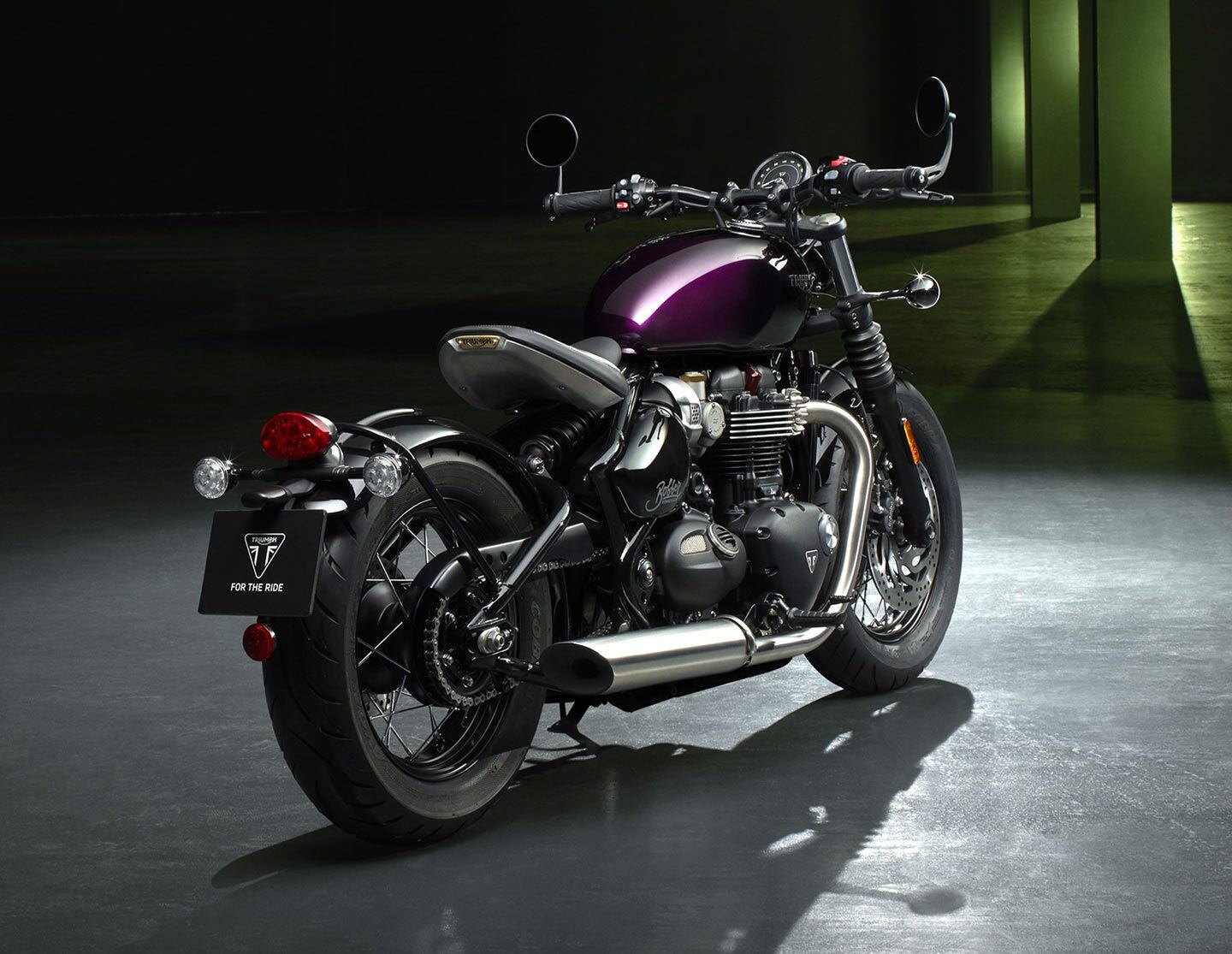
The Bonneville Bobber Purple Stealth Edition plays on the bike’s stripped-back style with a deep purple color. (Triumph/)
Bonneville Bobber Purple Stealth Edition | from $14,595
That unmistakable fat front wheel and chunky 47mm fork will always betray the Bonneville Bobber’s muscular presence. But despite its looks—along with a solo seat and rigid-looking rear suspension—this bobber is far more rider-friendly than you’d think with an adjustable seat, adjustable traction control, dual riding modes, and electronic cruise control. Dip it in a vibrant purple color, and all bets are off.
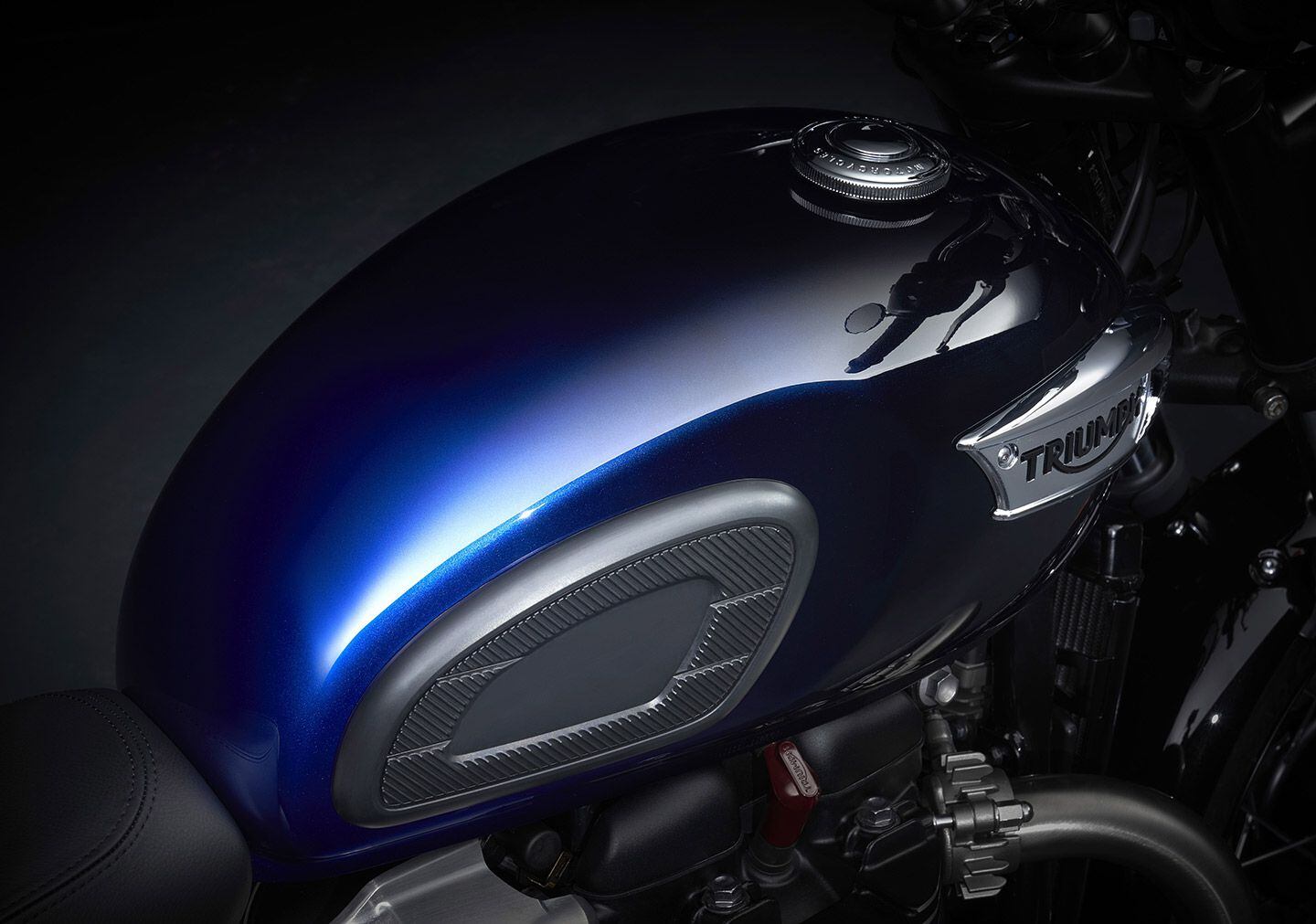
The T100 classes it up with a rich blue tone on the tank to contrast with its blacked-out bits. The bike’s easy-handling, responsive 900cc engine is unchanged. (Triumph/)
Bonneville T100 Blue Stealth Edition | from $11,745
Accessible and easy handling was always a hallmark of the Bonneville series, and the T100 keeps things as they were, with a 900cc engine that’s easygoing but punchy when you need it to be. The rich Sapphire Blue tones against the rest of its blacked-out components give it a classier vibe, but the T100 Blue Stealth still has the latest-generation ABS and switchable traction control.
Related: 2022 Triumph Bonneville Gold Line Edition Photo Gallery
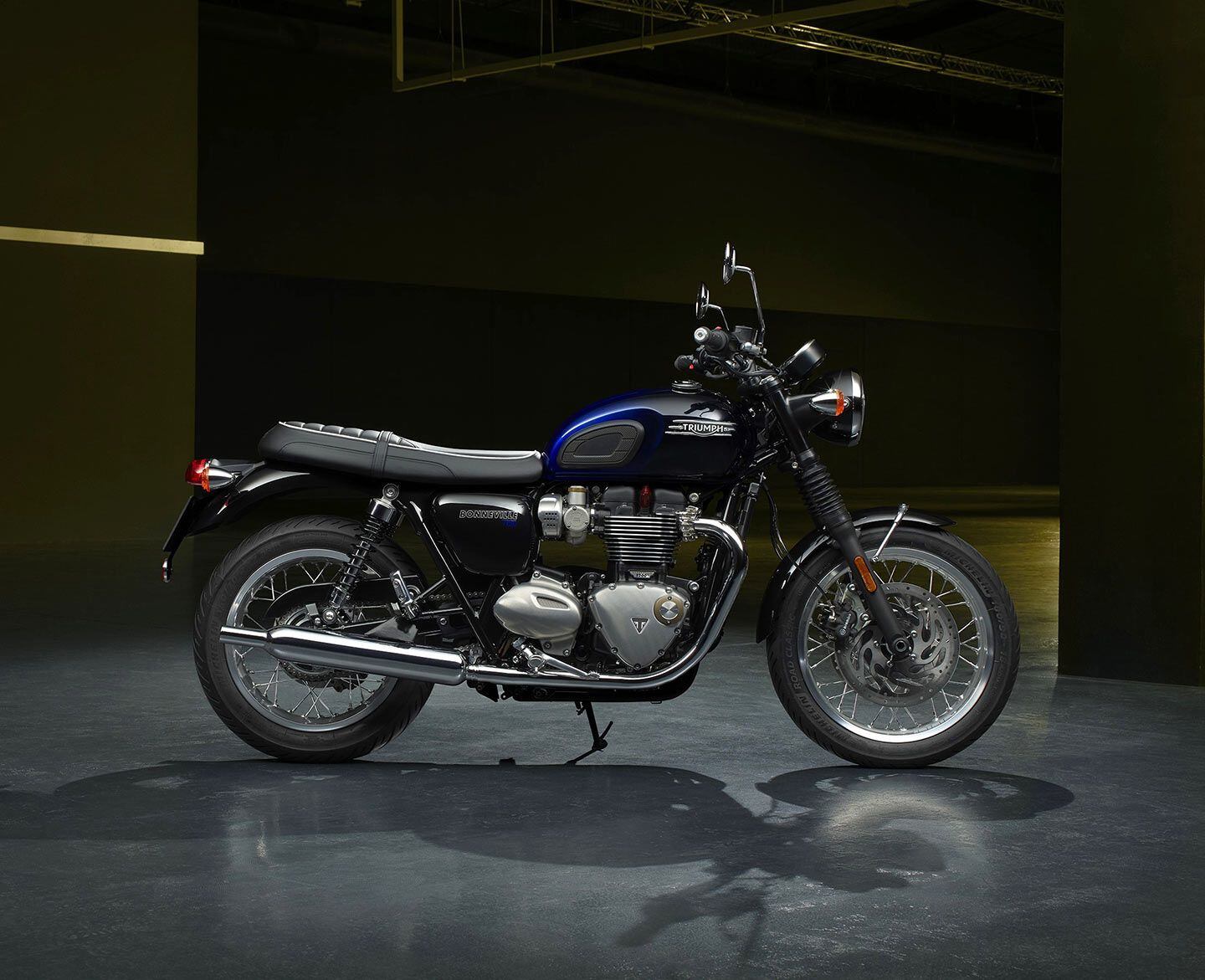
The higher-spec T120 Blue Stealth gets the same paint treatment, but rolls with a 1,200cc engine and more premium components. (Triumph/)
Bonneville T120 Blue Stealth Edition / Black Stealth Edition | from $13,495
The Bonneville T120 Blue Stealth Edition brings the same spec as the base model, with preload-adjustable rear suspension and Brembo front brake calipers with ABS. The 1,200cc twin engine also delivers the same healthy 80 hp at 6,550 rpm; it’s just finished in Sapphire Blue/Silver Blue or Matt Silver Ice/Matt Sapphire Black in Stealth form, and gets a slight boost in price. The T120 Black Stealth Edition’s tank fades to silver at the back, and the limited-edition model also retains the other blacked-out details like wheel rims, fenders, engine covers, handlebars, headlamp, and exhaust.
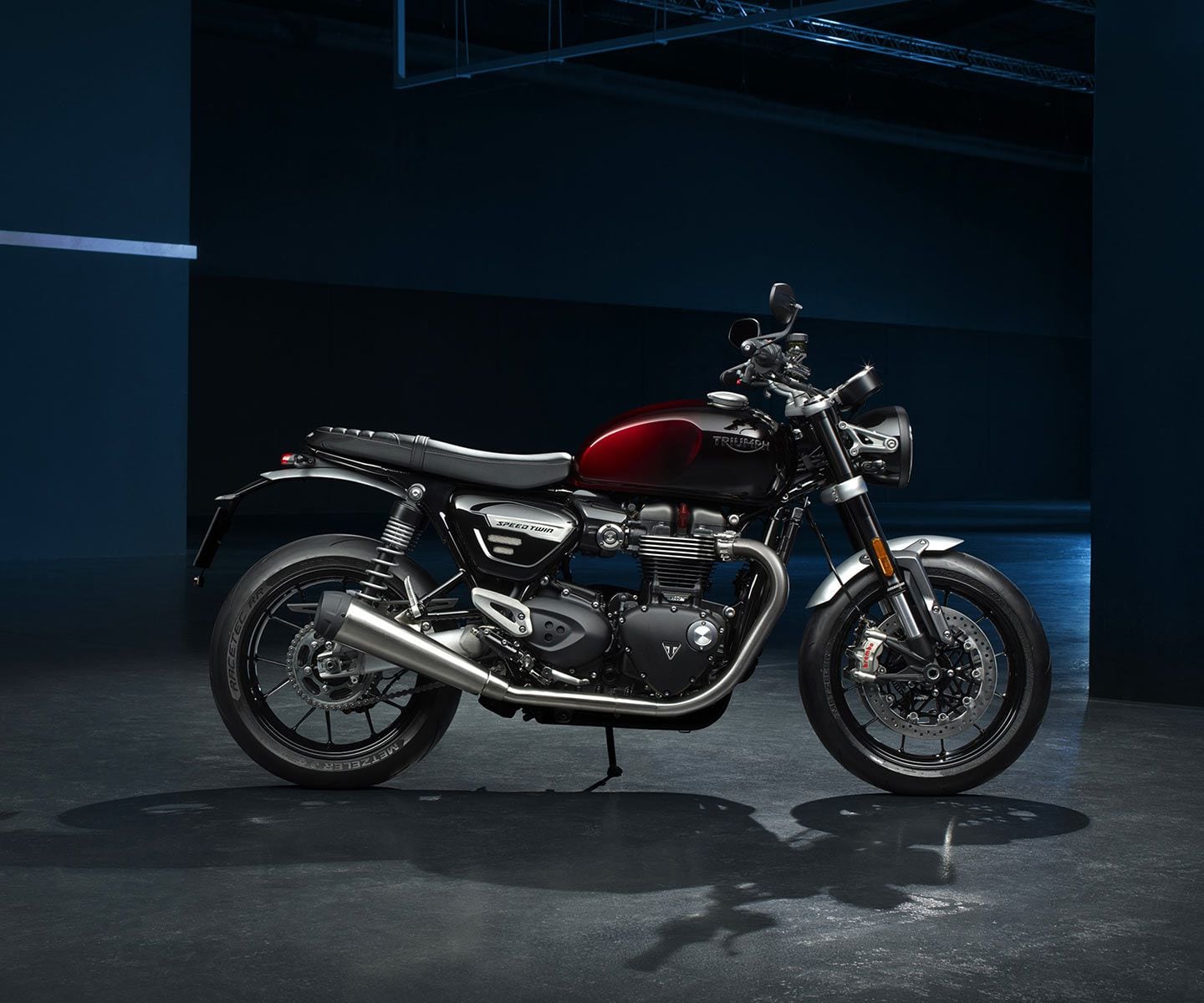
Along with a ripping 100 hp, 1,200cc engine, the Speed Twin 1200 Stealth brings a vivid candy red paint that gleams in the light. (Triumph/)
Speed Twin 1200 Red Stealth Edition | from $13,695
The 1,200cc high-power parallel twin is a popular choice across the Bonneville series, and with a strong and linear power delivery, topping out at 100 hp here, it’s easy to see why. The brushed stainless steel megaphone twin mufflers add style and tone, and in Stealth form, the Speed Twin’s Sapphire Red/Silver Red tones give it even more presence.
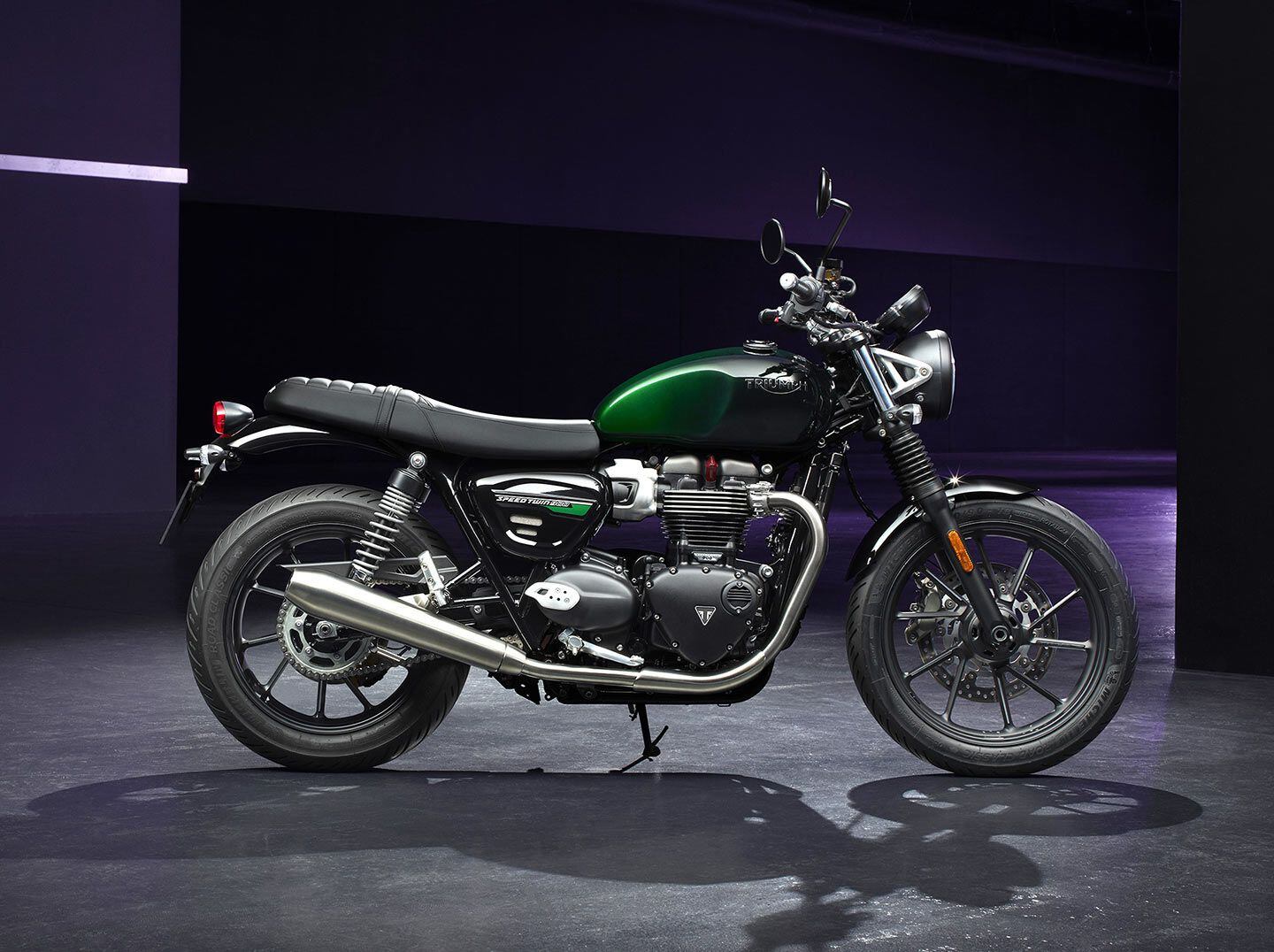
The Speed Twin 900 Green Stealth Edition gets a lovely Sapphire Green/Silver Green color combo. (Triumph/)
Speed Twin 900 Green Stealth Edition | from $10,645
The Speed Twin 900 Green Stealth Edition gets a standout deep green tank design that sort of reminds you of a lovely British racing color of yore, though it is unique enough to give the smaller Speed Twin its own identity. Otherwise you get the familiar 900cc Bonneville twin engine, cast wheels, ride modes, and an appealing custom-inspired classic look.
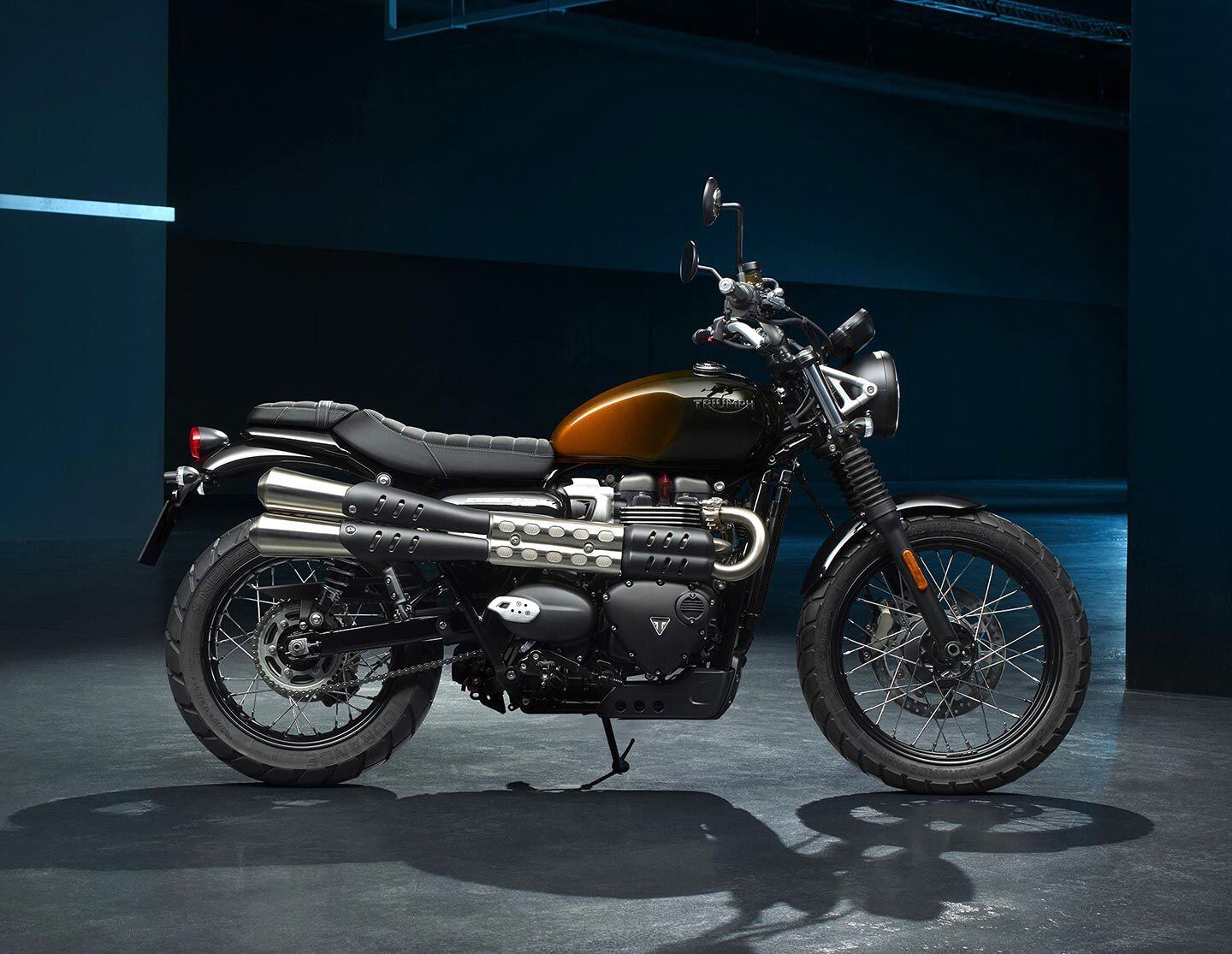
The Scrambler was always a looker, and in 2024 you can opt for the Scrambler 900 Orange Stealth Edition. (Triumph/)
Scrambler 900 Orange Stealth Edition | from $12,245
With its unique frame, sit-up style, and mid-mount controls, the Scrambler always seemed like an outlier in the Bonneville family, but then that along with its custom style and good looks are what made it so appealing. For 2024, the Scrambler 900 Orange Stealth Edition ups the ante with a deep orange shade option.
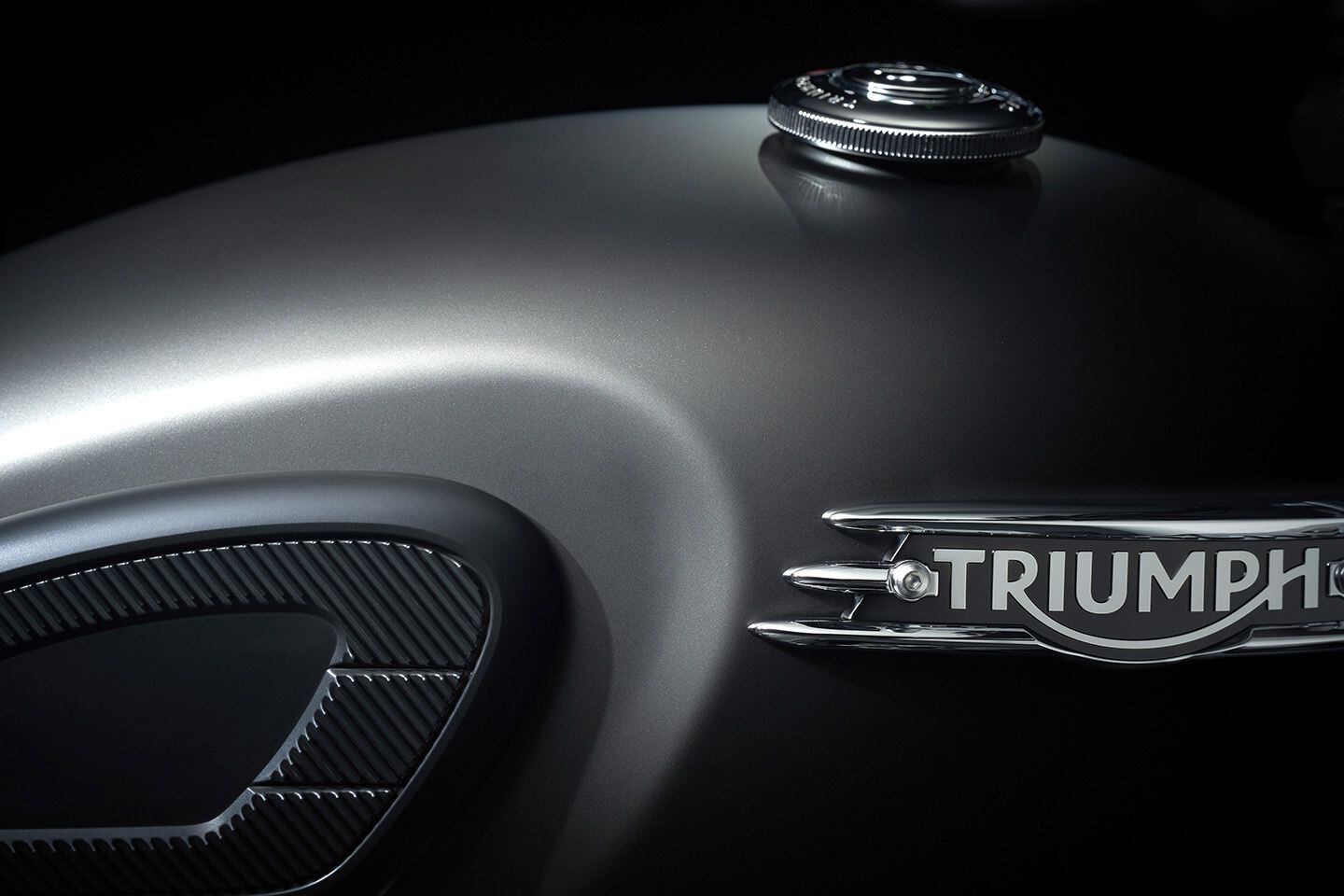
Detail of the Bonneville T120 Black Stealth Edition tank. (Triumph/) ]]>
Honda is bringing back the Honda Gold Wing base model (manual and DCT versions) in a new Matte Armored Green color for 2024. (Honda/)
Honda’s European arm usually trumpets its new model year bikes well before the North American region has its say, but this time, American Honda announced the return of its luxurious Gold Wing and Gold Wing Tour flagships right on the heels of the UK release. None of the models see any mechanical changes for model year 2024, and are just updated with what the company calls “contemporary” color schemes.
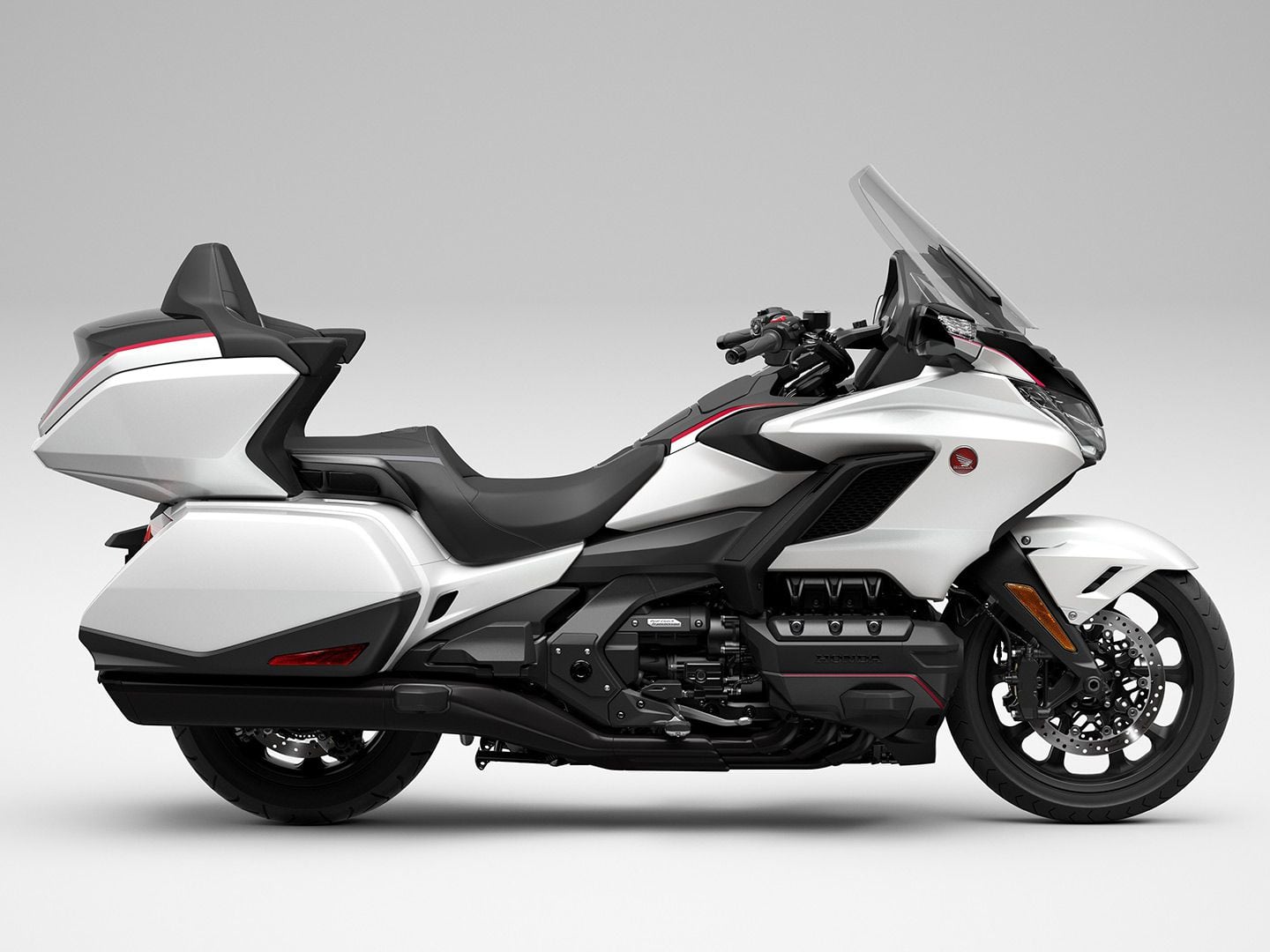
The top-of-the-line 2024 Honda Gold Wing Tour Airbag DCT will come in this Pearl White color and also sees no changes. (Honda/)
2024 Honda Gold Wing DCT, Gold Wing Tour DCT, Gold Wing Tour Airbag DCT
As we know, the luxury tourer was almost completely redesigned for the 2018 model year, dropping a pile of weight and getting a double wishbone front suspension as well as a reworked flat six-cylinder engine. The changes instantly broadened its appeal, and further improvements to suspension, electronics, audio and rider conveniences in subsequent years helped evolve the big Wing further. All of which is to say that for 2024, the venerable Wing is essentially unchanged, but you’re still getting a feature-packed spec sheet, with a seven-speed DCT transmission, a 7-inch TFT screen, navigation, Apple CarPlay, Android Auto, an adjustable electric windscreen, Smart Key operation, four riding modes, traction control, Hill Start, and more. The Gold Wing Tour variant adds a rear luggage box with integrated backrest and even more comfort features.
For 2024 the big Wing is returning in top-of-the-line Gold Wing Tour Airbag DCT form, with a $33,000 MSRP and will be available in Pearl White.
The Gold Wing Tour in both DCT and manual forms is back as well, in Gray Metallic/Black or Pearl White options for $29,700 and $28,700, respectively.
The base-model Gold Wing and Gold Wing DCT, however, do feature a new color for 2024; both are available in Matte Armored Green Metallic, with brown detailing on the engine cases. The base Wing rings in at $24,700, and the DCT version at $25,700.
The bikes will be in dealers November, 2023.
Related: Honda’s Bringing Back the Gold Wing for 2023
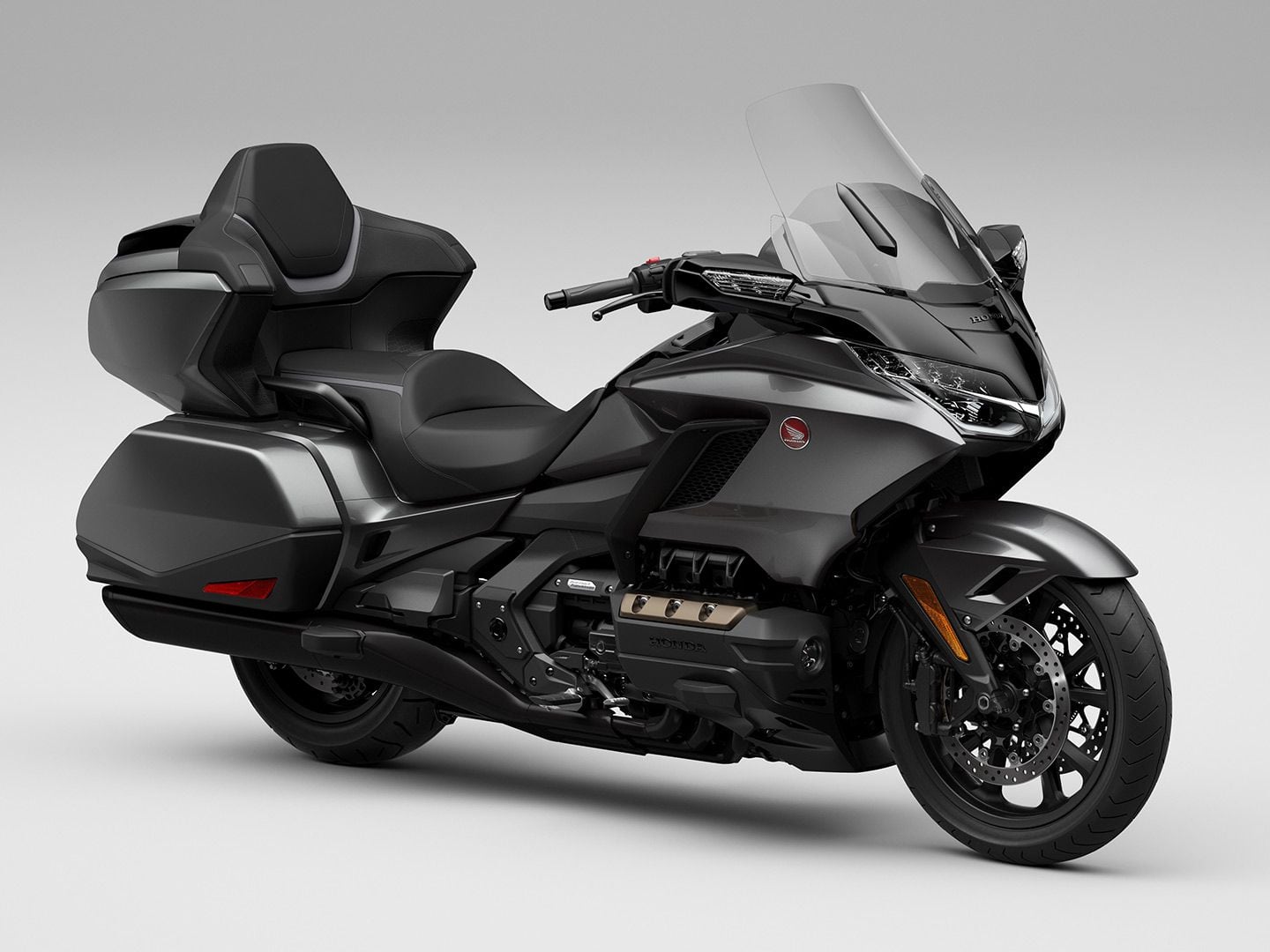
The Gold Wing Tour returns with both DCT and manual transmission options and will get this Gray Metallic color. (Honda/)
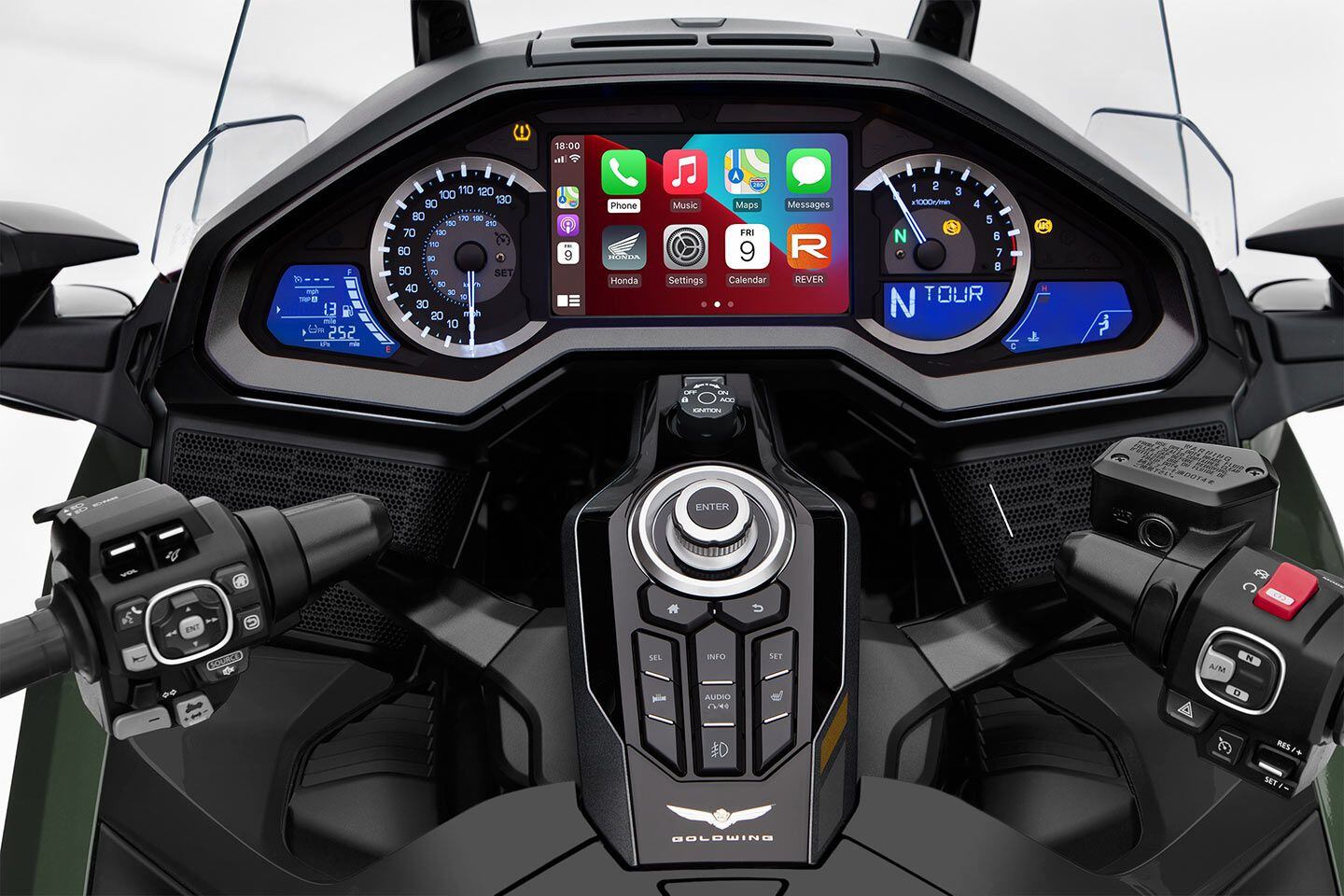
Full-featured 7-inch screen allows access to navigation, Apple CarPlay, Android Auto, four riding modes, traction control, Hill Start, and more. (Honda/) ]]>
The Super Meteor 650 is Royal Enfield's flagship model. (Josh Shipps/Klings/Royal Enfield/)
Royal Enfield’s Super Meteor 650 may be the most significant motorcycle to ever come out of India. Its classic styling, impressive performance, and excellent build quality exhibit where Royal Enfield has been, where it is, and where it’s going. The Super Meteor’s classic styling pays homage to the brand’s original cruisers such as the 1952 Meteor and 1956 Super Meteor. Its 648cc parallel twin maintains the thumpy character that we have come to love in the INT650 and Continental GT 650. And the impressive fit and finish of the Super Meteor 650 represents a new standard for Royal Enfield.
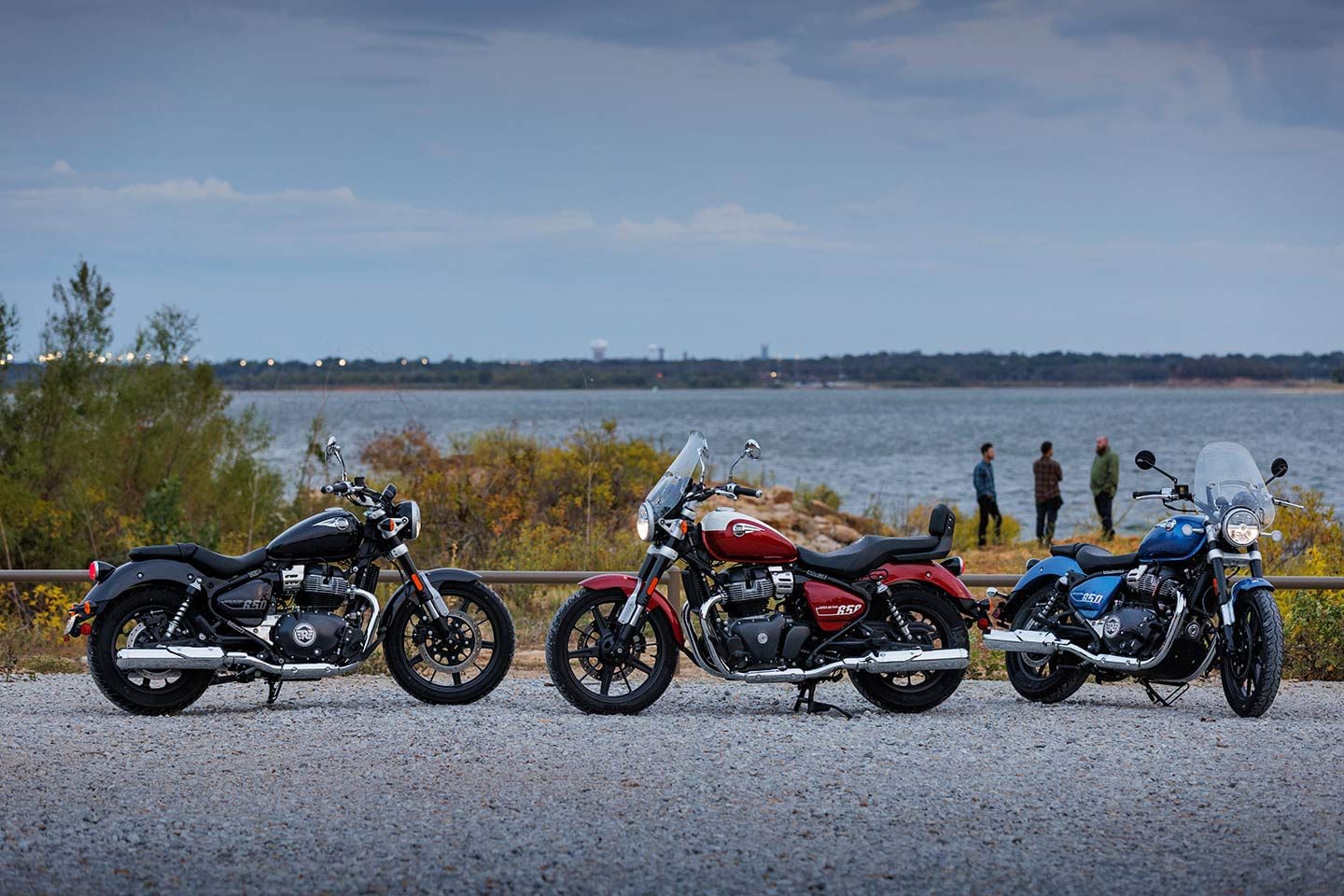
The Royal Enfield Super Meteor 650 model lineup. (Josh Shipps/Klings/Royal Enfield/)
2023 Royal Enfield Super Meteor 650 Overview
The Super Meteor 650 is a retro-styled middleweight cruiser designed to be as accessible as it is functional, while delivering a relaxed stance. Starting MSRP is a class-best $6,999, but that’s the only thing “cheap” about this cruiser. Everything else is top-notch. Designed around Royal Enfield’s sweet parallel twin, the Super Meteor 650 slots nicely into the middleweight cruiser class, competing against models such as the Kawasaki Vulcan S and the Honda Shadow line. And even if it’s smaller in displacement and stature than the discontinued Harley-Davidson 883 Sportster, it is definitely a candidate for filling the void left by that American V-twin.
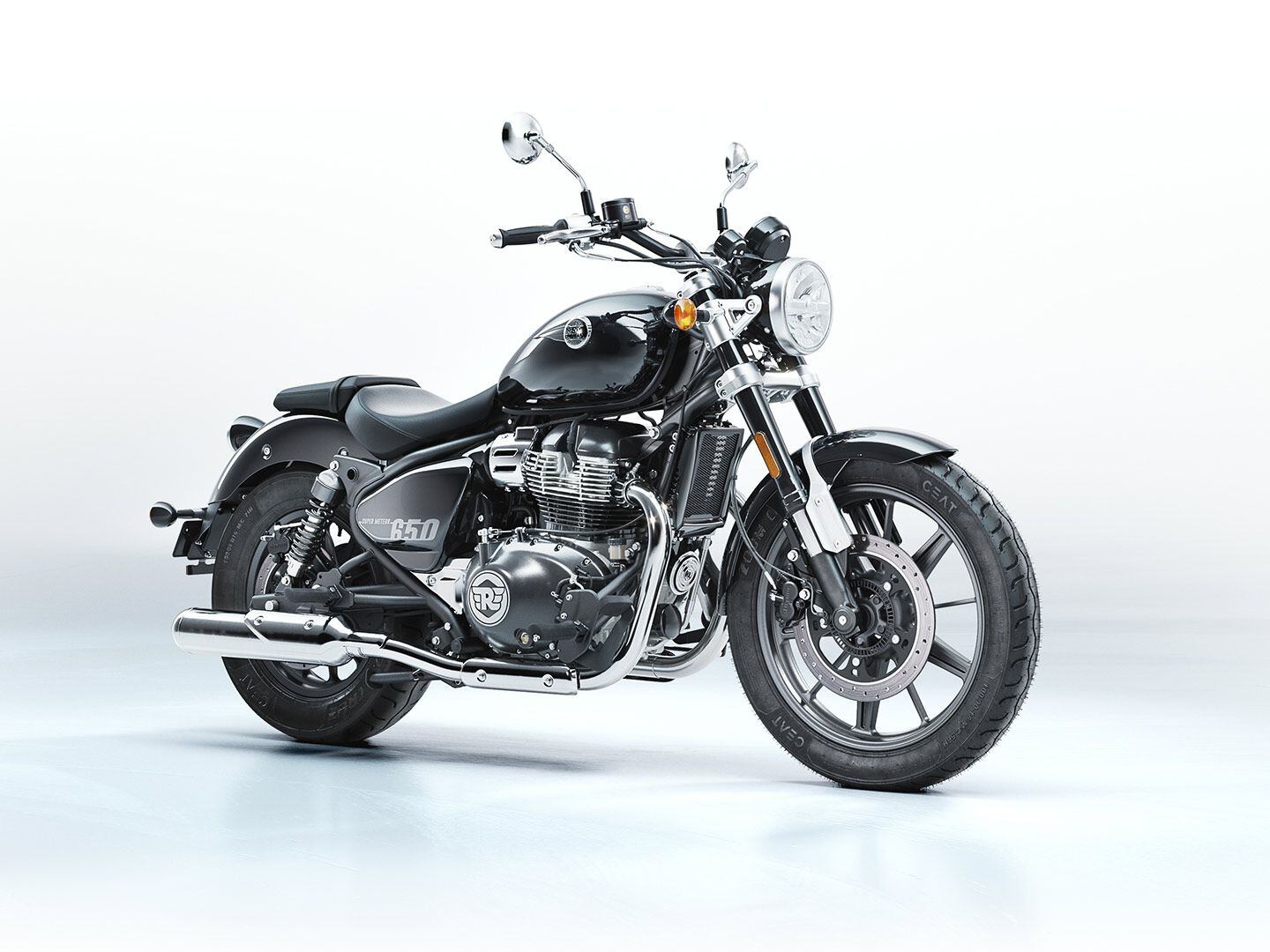
The Royal Enfield Super Meteor in Astral Black ($6,999). (Josh Shipps/Klings/Royal Enfield/)
The SOHC fuel-injected engine has a 78.0 x 67.8mm bore and stroke and four valves per cylinder working with a 9.5:1 compression ratio. The engine produces a claimed 46.4 hp and 38.6 lb.-ft. of torque. For reference, we had the 2022 Royal Enfield INT650 on the Cycle World in-house Dynojet 250I dyno last year and recorded 40.9 hp at 6,800 rpm and 37.4 lb.-ft. of torque at 5,100 rpm at the wheel. The Super Meteor 650 has a different intake and exhaust system that results in slightly different power delivery, says R-E, but we expect similar results on our dyno.
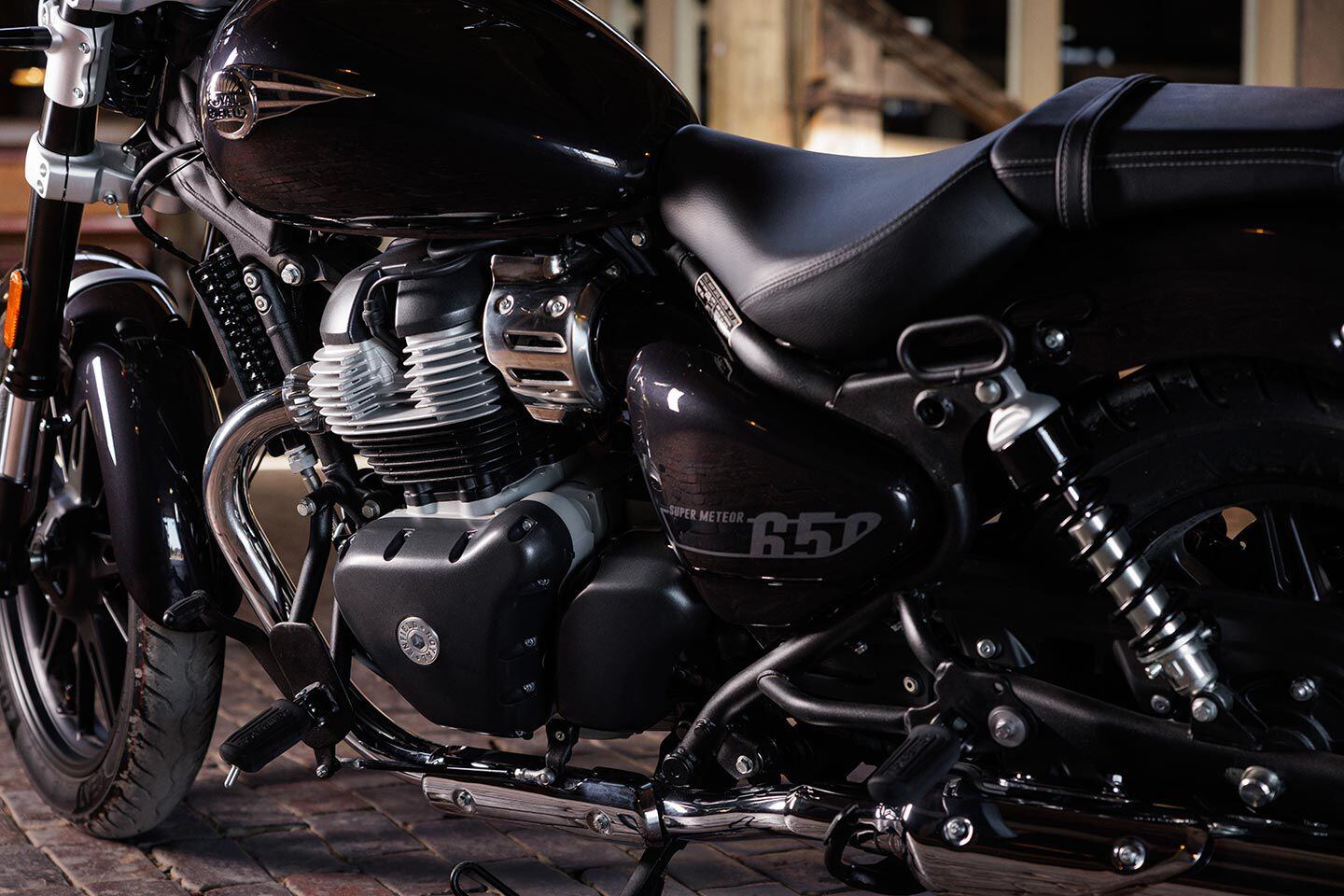
Royal Enfield's 648cc parallel twin is full of character, thanks in part to its 270-degree crankshaft that gives the engine a 90-degree V-twin sound. Impressive low-end grunt is followed by strong midrange pull and solid high-rpm performance. (Josh Shipps/Klings/Royal Enfield/)
The Super Meteor has an all-new chassis designed by famed British chassis specialists Harris Performance, owned by Royal Enfield since 2015. The tubular-steel frame helps achieve both a low center of gravity and a low seat height of 29.1 inches. Rake is 27.6 degrees, trail 4.7 inches, definite steps to the relaxed side from the Continental GT and INT 650′s 24.0/4.1 figures. The Super Meteor’s wheelbase is 59.1 inches, 4 inches longer than that of the Conti/INT. This all helps set the tone for the stance of the bike, increases stability, while the wheelbase in particular makes more room for a passenger. (Read Technical Editor Kevin Cameron’s story about wheelbase and chassis geometry here if you’d like to learn more.) Tires are 100/70-19 front, 150/80-16 rear, mounted to tubeless alloy rims.
A nonadjustable 43mm Showa Big Piston inverted fork (the first used by R-E) provides 4.7 inches of travel and twin shocks with five-step adjustable preload offer 4.0 inches of travel.
A set of tubeless alloy rims in conjunction with a centerstand are a testament to the Super Meteor’s sincerity as a long-distance cruiser. And with the addition of a windscreen, deluxe touring seat, and pillion backrest for the Celestial variant ($7,499), the Super Meteor 650 is tailor-made for cruiser touring despite its middleweight displacement.
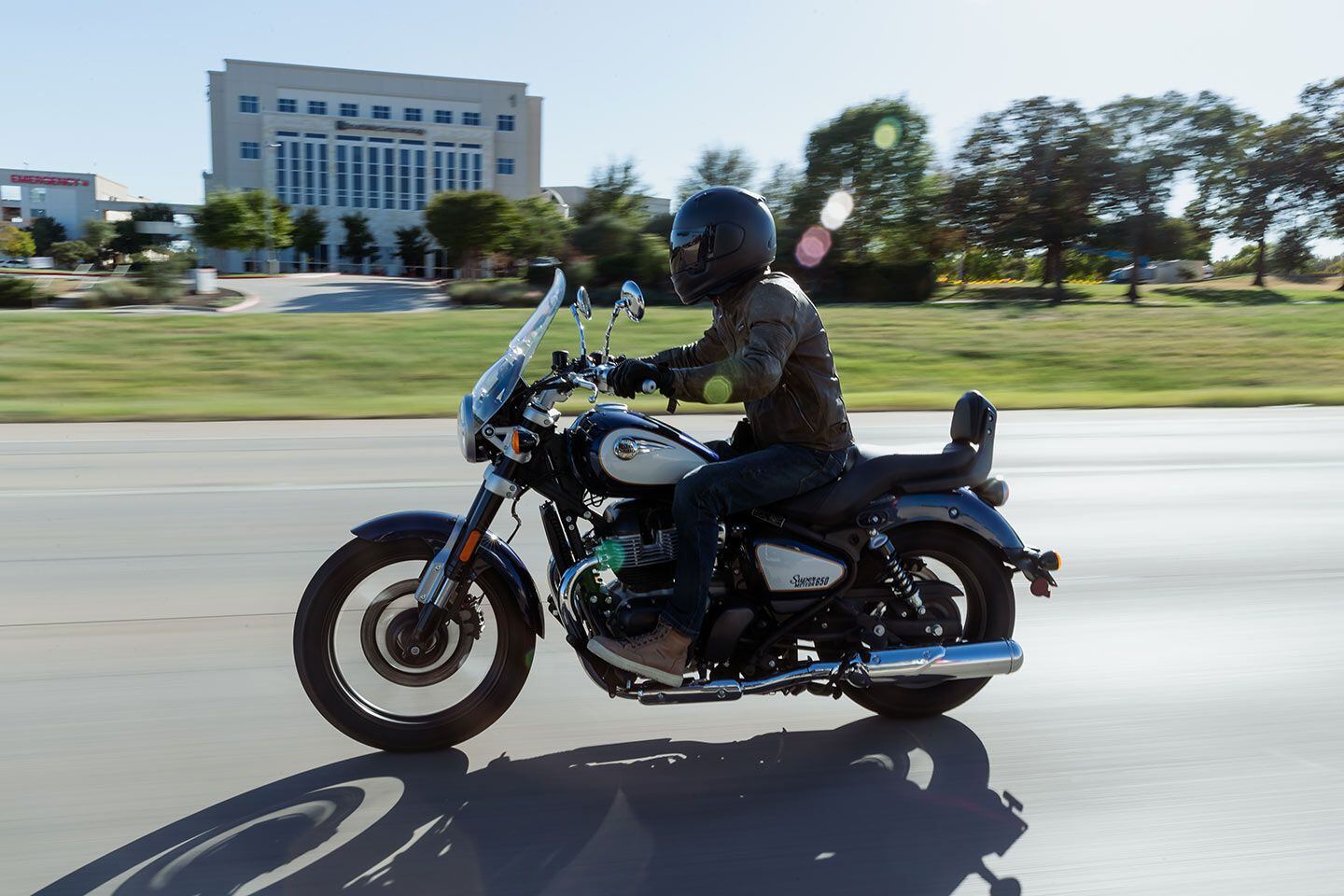
Whether your journey takes you across town or across the county, the Super Meteor 650 is comfortable for miles on end. (Josh Shipps/Klings/Royal Enfield/)
Available safety equipment includes non-switchable ABS. No other electronic intervention or ride modes are present, maintaining a classic experience that is felt throughout the entire motorcycle. A retro-themed instrument panel utilizes an analog speedometer with a digital information screen displaying a fuel gauge, gear position indicator, tripmeters, and a clock. The Super Meteor 650 also features Royal Enfield’s Tripper turn-by-turn navigation pod. Riders can link to the navigation pod via Bluetooth through their smartphone. Further adding to the visceral feel of this Royal Enfield is a mechanical throttle cable that provides a solid, analog connection between rider and machine.
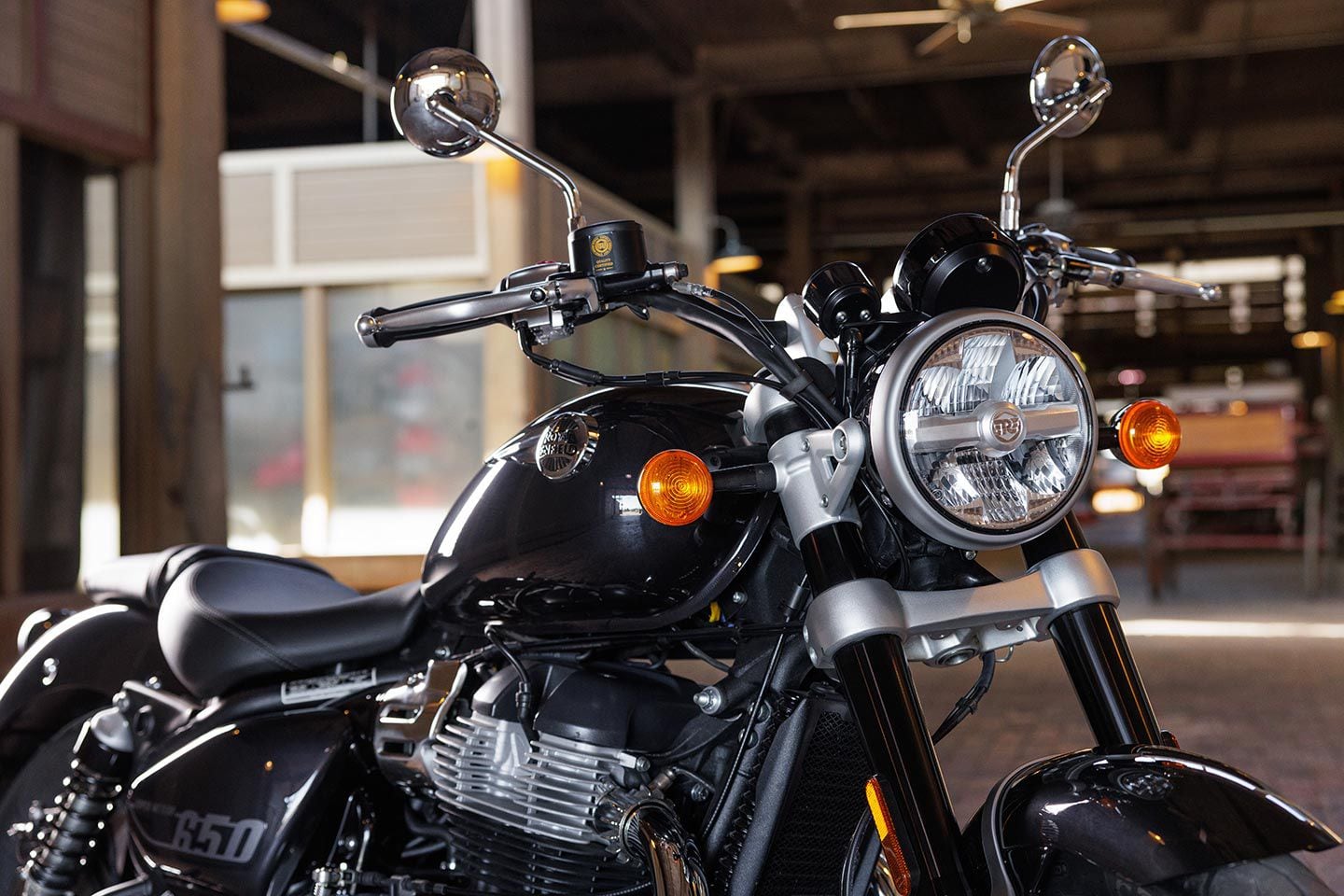
The Super Meteor 650 is the first Royal Enfield motorcycle to receive an LED headlight. (Josh Shipps/Klings/Royal Enfield/)
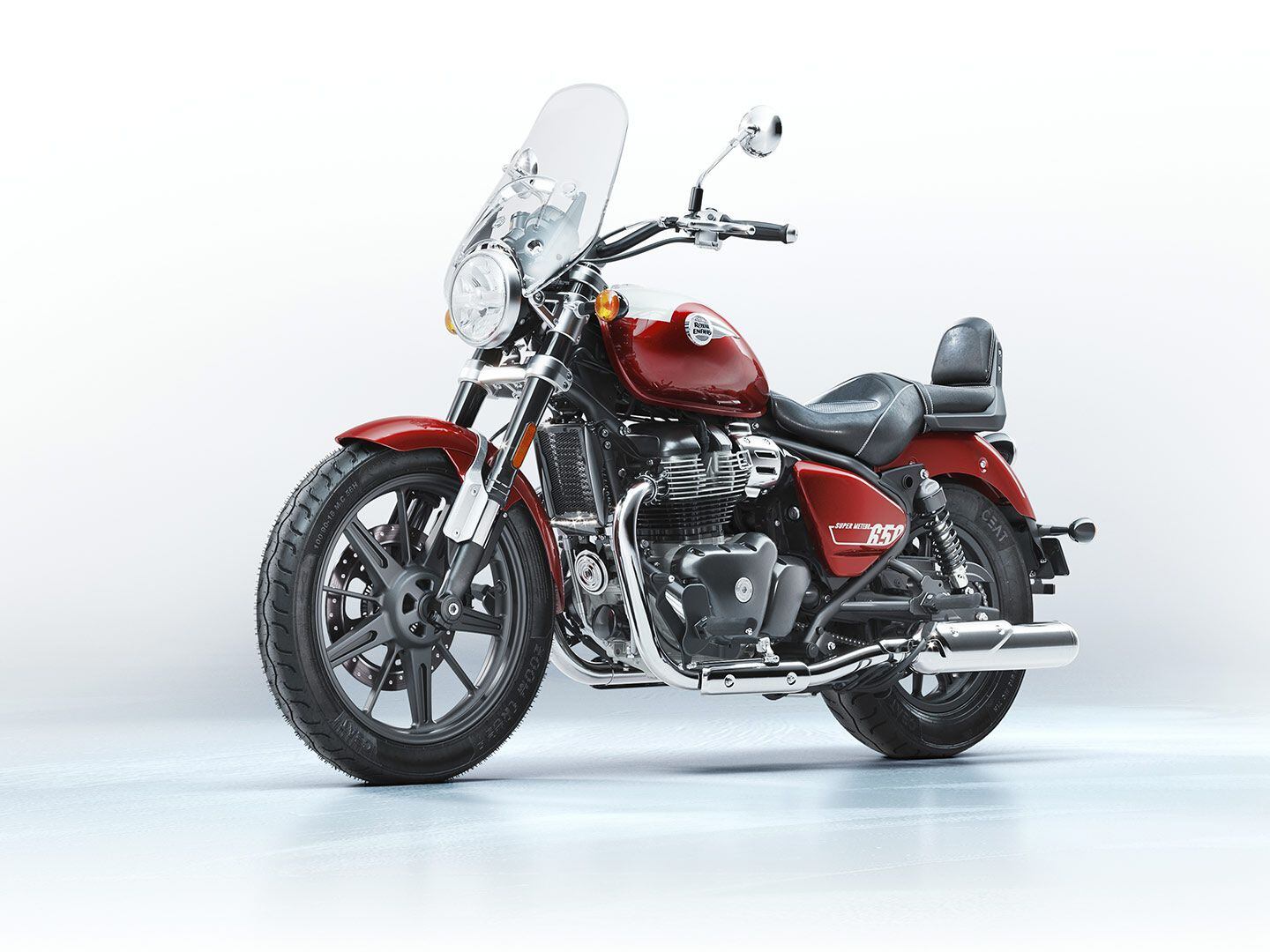
The Super Meteor 650 Tourer comes with a windscreen, deluxe touring seat, and a pillion backrest. (Josh Shipps/Klings/Royal Enfield/)
The Royal Enfield Super Meteor 650 is available in three variants: Astral ($6,999), Interstellar ($7,299), and Celestial ($7,499). The Astral model comes in three color options (green, black, and blue). The Interstellar features a two-tone paint scheme in two colors (green or gray), and the Super Meteor 650 Tourer is available in Celestial Red or Celestial Blue and features a windscreen, deluxe touring seat, and pillion backrest. Adding to the bike’s iconic cruiser styling is the 4.2-gallon teardrop fuel tank with a metal gas cap. LED lighting, a first for Royal Enfield, is standard on all.
Royal Enfield has a gamut of Genuine Motorcycle Accessories for the Super Meteor 650 which include the windscreen, the deluxe touring seat, the pillion backrest, and a range of other accessories including engine guards, footpegs, mirrors, and LED turn indicators.
2023 Royal Enfield Super Meteor Riding Impression
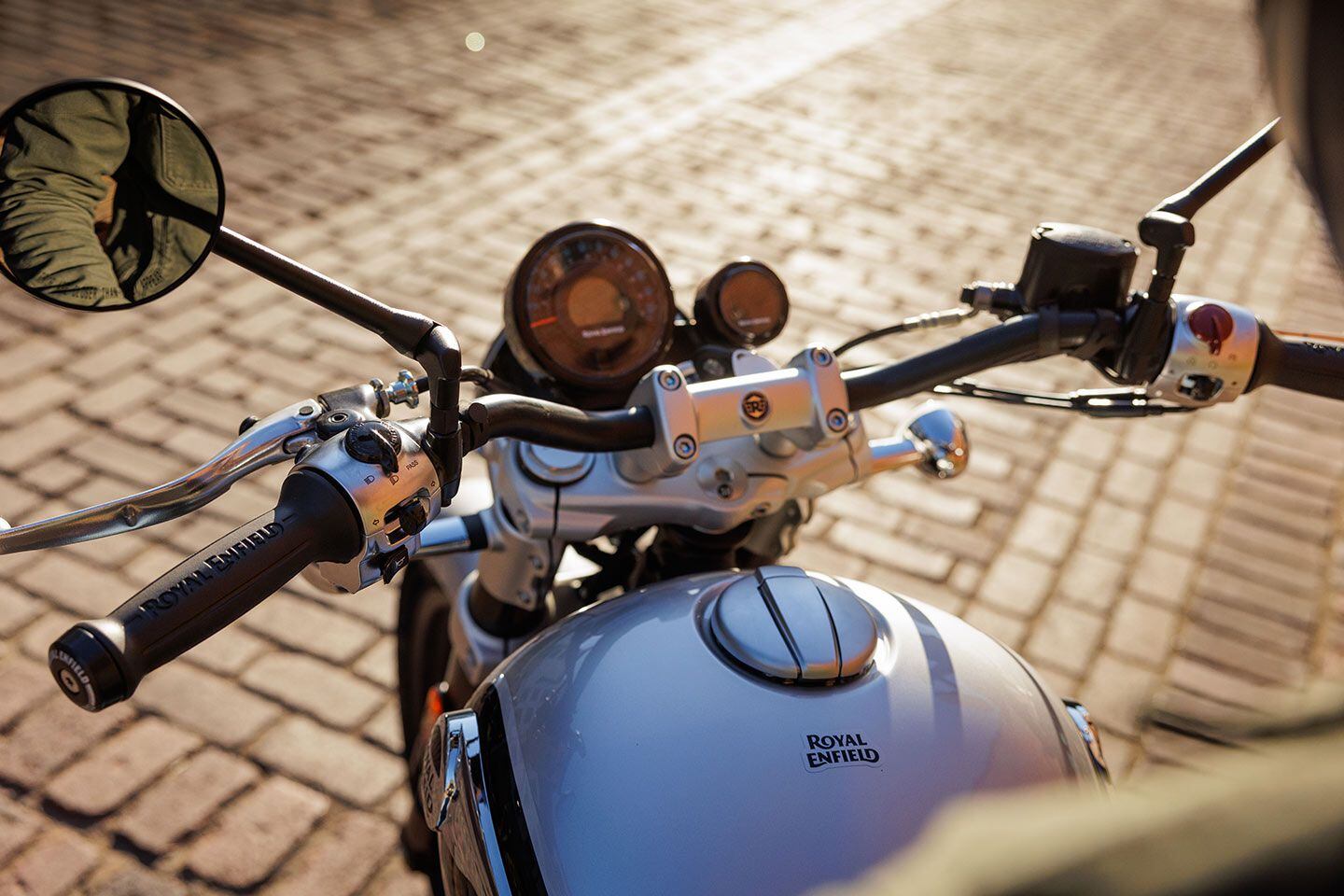
The fit and finish of the Super Meteor 650 is like nothing we've seen before on a Royal Enfield. The craftsmanship is comparable to a Triumph motorcycle. (Josh Shipps/Klings/Royal Enfield/)
Swinging a leg over the middleweight cruiser for the first time, the quality of the Super Meteor 650 becomes abundantly clear. From the cockpit, the fit and finish of this Royal Enfield is reminiscent of Triumph’s lauded detailing. The sparkle paint is deep, rich, and without blemishes. At the controls, the switch cubes are surrounded by plated aluminum and the levers are adjustable. Fire up the 648cc parallel twin and the rider is greeted with a soft rumble. The cable-actuated clutch has a great feel and a broad, easy-to-manage engagement range. Its pull is not overly strenuous but strong enough to deliver positive feedback.
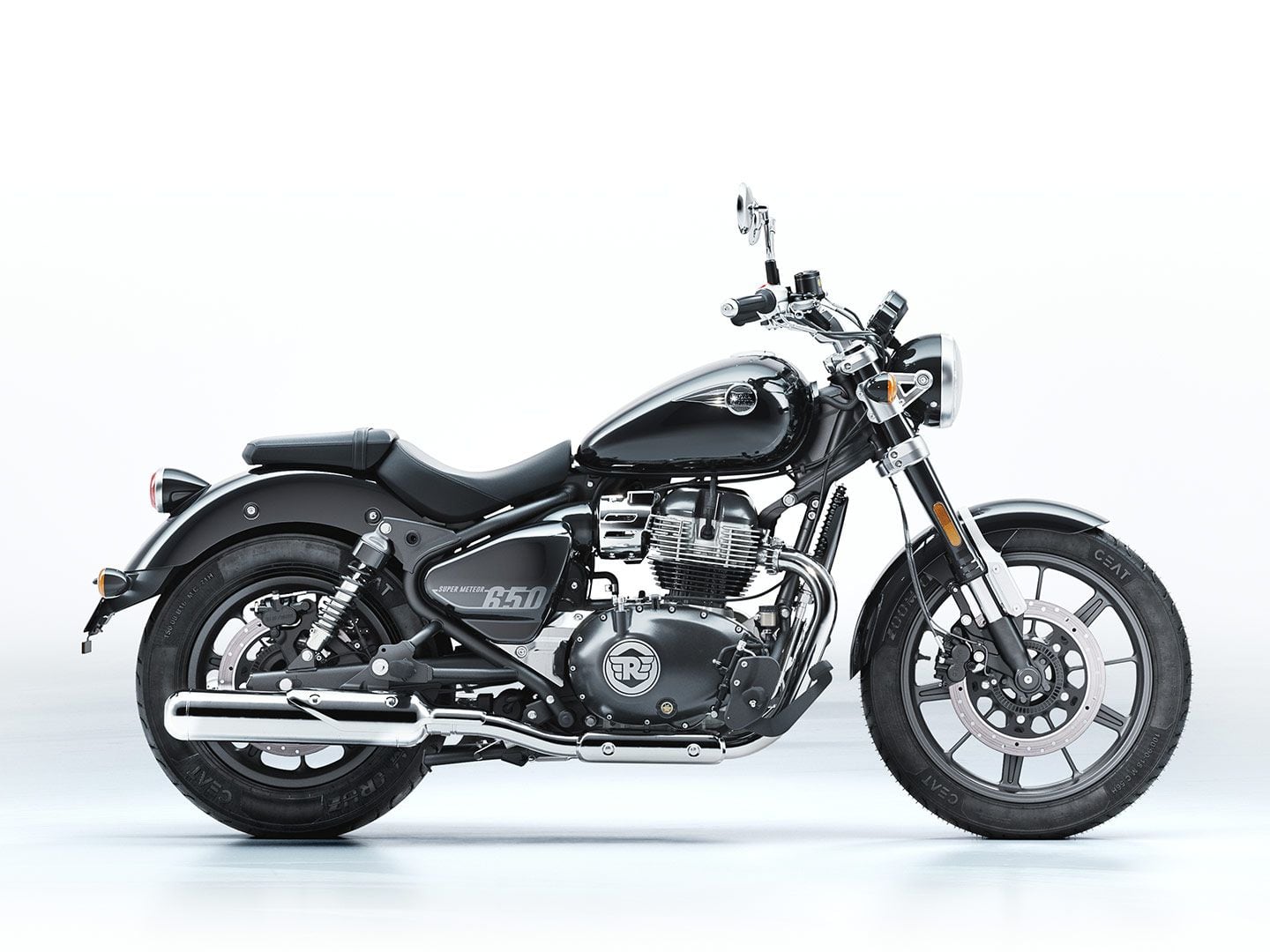
Royal Enfield’s Super Meteor 650 utilizes the same 648cc parallel twin as the INT650 and Continental GT 650. (Josh Shipps/Klings/Royal Enfield/)
The 650 twin generates plenty of usable torque down low—essential for a cruiser. And, because it’s so readily available, riding a gear high is easy and you don’t sacrifice much get-up-and-go. Rev the engine out for passing, and the Super Meteor continues to perform. Running the engine high into the rpm range does not generate any uncomfortable buzzing and the power continues to pull. At one point on the ride, the Super Meteor 650 was traveling north of 90 mph and it easily could have gone more.
As we made our way out of Dallas before entering the highway, the Super Meteor’s ability to cruise through town in any gear is impressive. Pulling away from a stoplight, I could short-shift up to fourth gear and cruise effortlessly at speeds as low as 20 mph. Clicking through the gearbox, the shifts are quick and decisive whether the clutch is used or not.
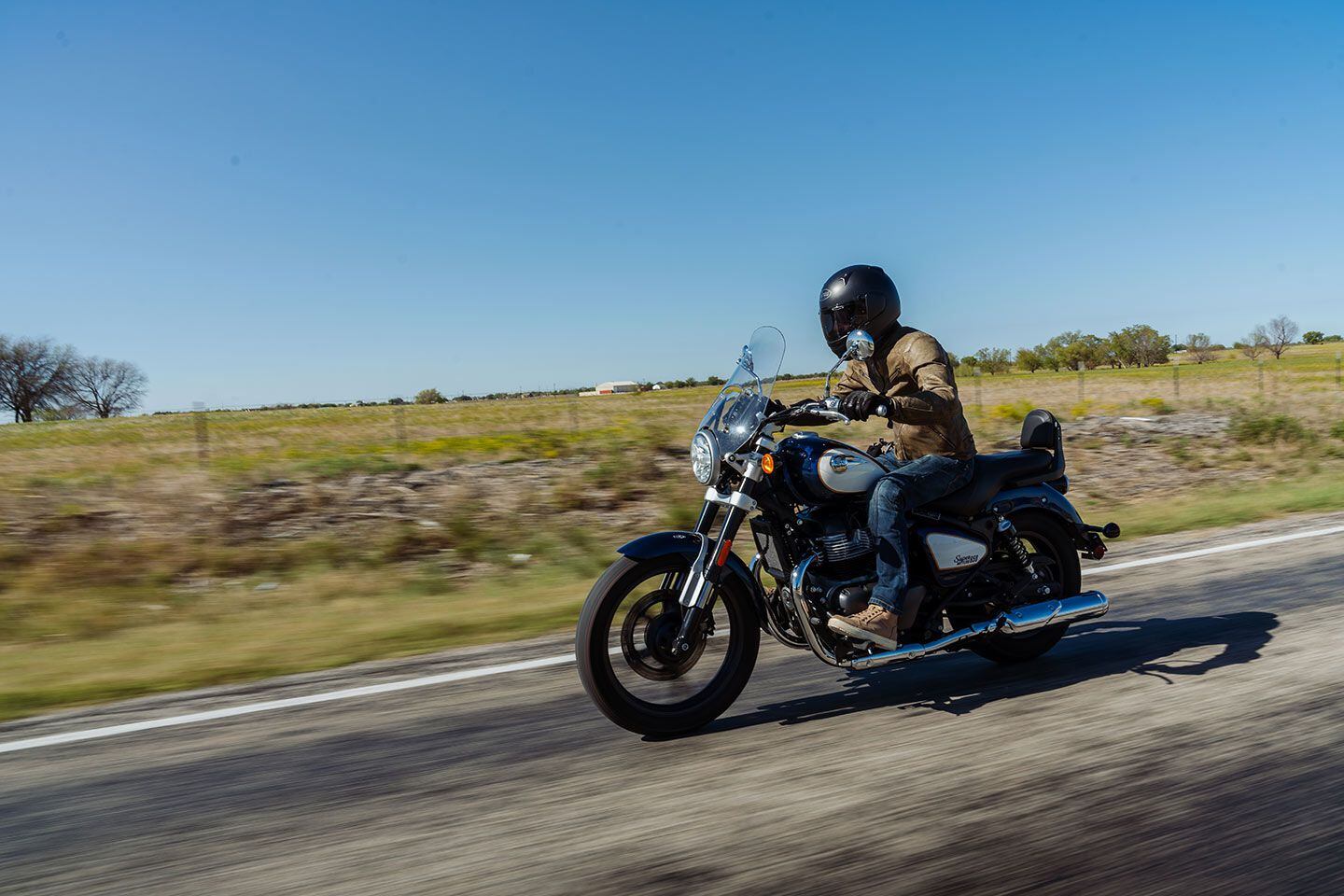
On the Super Meteor 650 Tourer, the windscreen (available on Astral and Interstellar models through Genuine Motorcycle Accessories) provided plenty of wind protection for my body, but generated a lot of buffeting around my helmet. (Josh Shipps/Klings/Royal Enfield/)
Traversing through the urban sprawl of Dallas, the suspension provides a stable, precise ride. The nonadjustable suspension settings (preload adjustment on the twin shocks) are taut which allows the bike to maintain a neutral ride despite external forces being applied to the chassis. Grabbing a handful of gas or brake does not make the Super Meteor 650 wallow or seesaw. The 43mm Showa Big Piston Fork offers plenty of holdup when contacting uneven surfaces and provides ample bottoming resistance.
At the rear, the twin shocks are oversprung for a middleweight cruiser. Their stiff spring rate makes the shock ride up in the stroke despite being set on the lowest preload setting. Hitting unexpected bumps in the road can be jarring at the rear, popping my 125-pound frame out of the seat. Some may find this discomforting but I much prefer a bike to be too stiff than too soft.
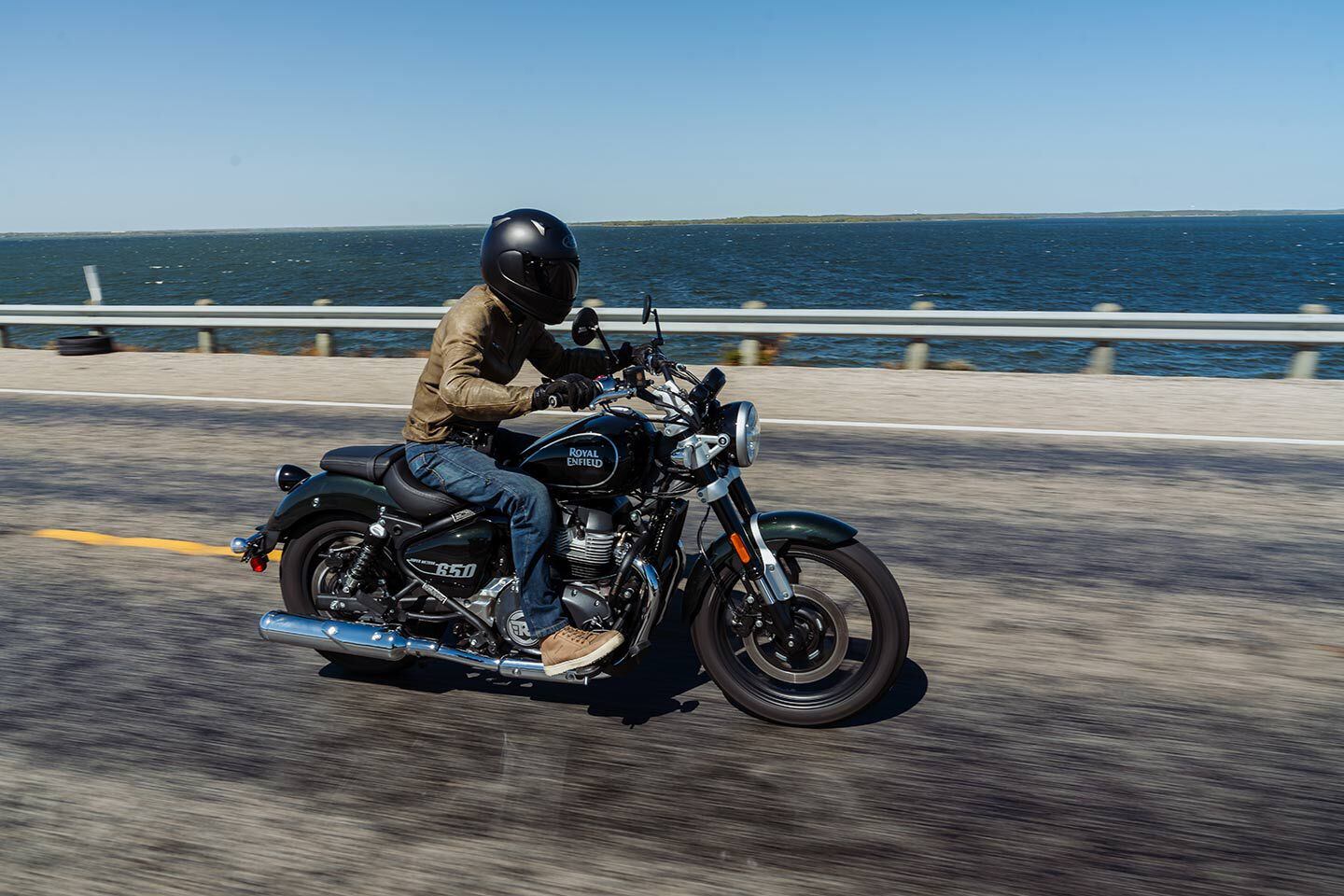
Cruising lakeside on the Super Meteor 650 in Astral Green. The British racing green paint color is fitting for a brand with so much lineage to the UK. (Josh Shipps/Klings/Royal Enfield/)
Handling is relaxed and neutral, but if needing to make a quick maneuver, an aggressive input into the wide handlebar will quickly change the trajectory of the motorcycle. We did not find any twisty roads near Dallas, despite trying, but on freeway on-ramps, the Super Meteor 650 easily rolls onto the side of the tire and maintains its lean angle quite comfortably. Coming into corners, initiate the lean angle and maintain it with the throttle before mashing the gas and standing the bike up upon exit. If the roads stayed twisty, the Super Meteor would dance all day.
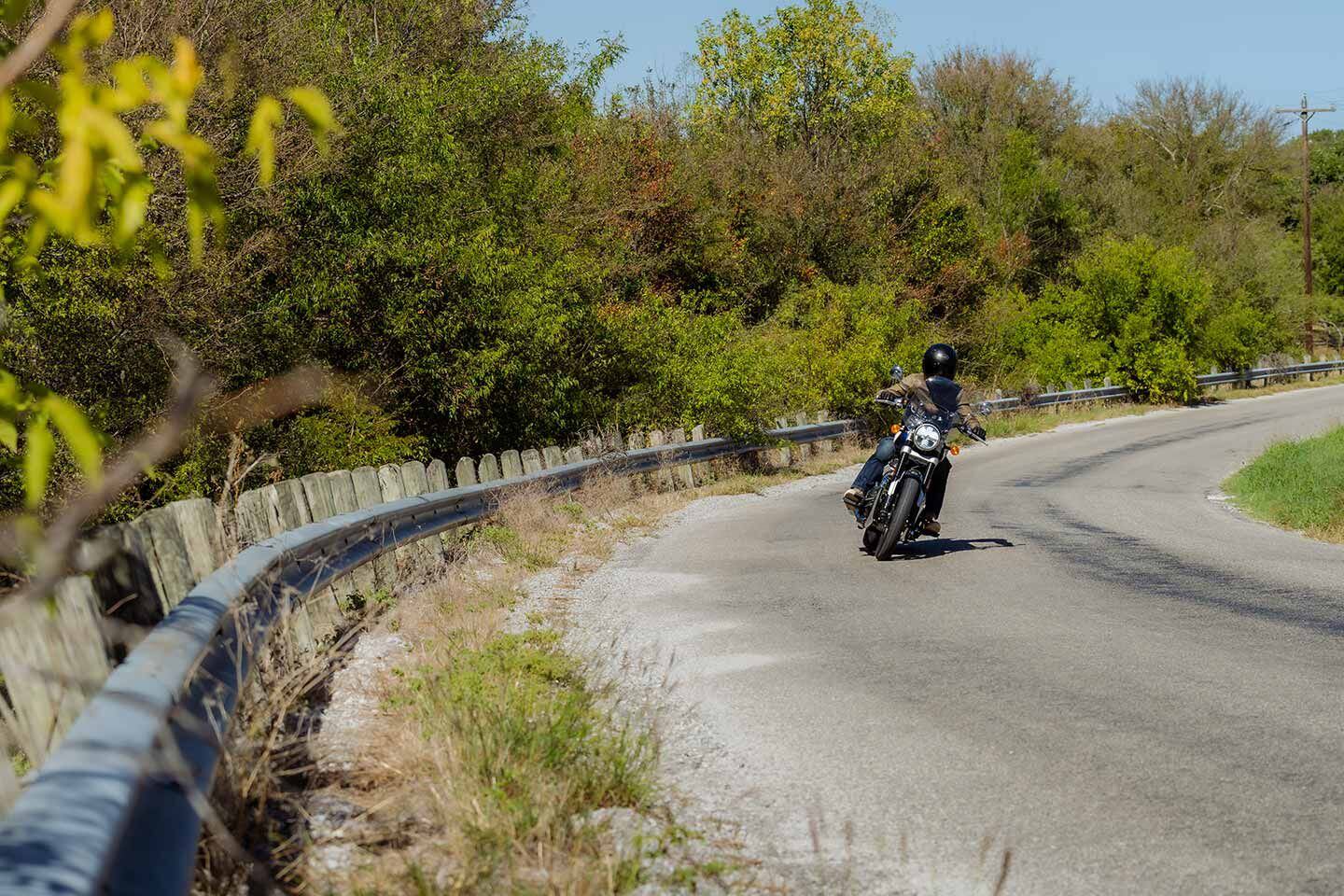
Leaning through one of the few curves available on a backroad near Dallas. (Josh Shipps/Klings/Royal Enfield/)
Traveling on straight roads, the Super Meteor 650′s open rider triangle is comfortable cruising for miles on end. Forward controls, a low seat, and a wide handlebar put the rider in a classic cruiser stance. Sit back, put your feet up, and let the time tick by; the only thing this cruiser needs for easier cross-country travel is cruise control.
The ByBre brake system utilizes a single 320mm front disc with a twin-piston floating caliper. A 300mm disc with a twin-piston floating caliper slows the rear wheel. Both brakes feature a dual channel ABS system. Throughout our ride, we did not encounter any hard braking zones. But when testing stopping performance in a straight line, the brakes will quickly shed speed and with a hard enough pull the ABS system will activate.
2023 Royal Enfield Super Meteor 650 Conclusion
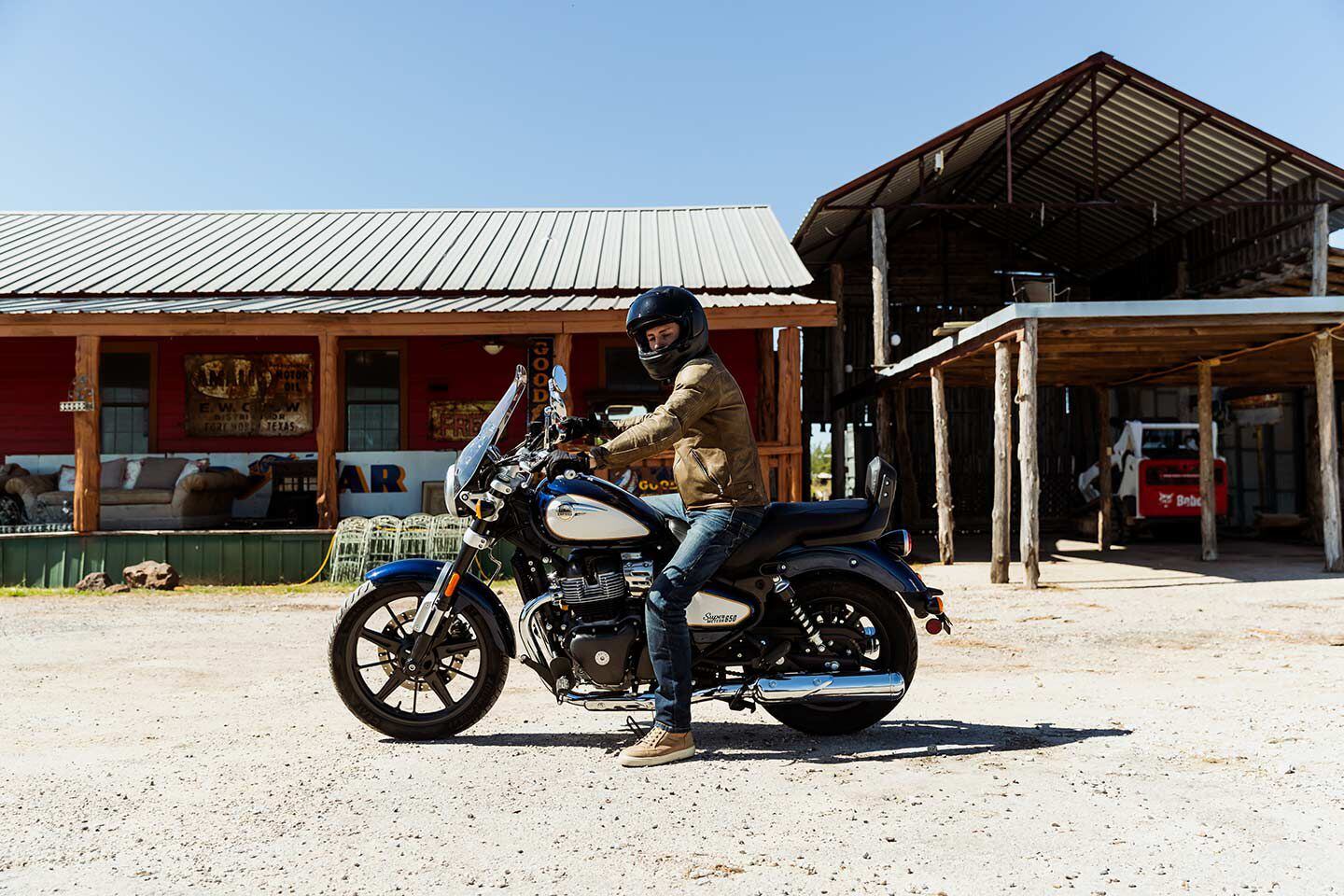
The classic styling of the Super Meteor 650 gives the motorcycle a timeless appearance. (Josh Shipps/Klings/Royal Enfield/)
The Super Meteor 650 is a benchmark for Royal Enfield moving forward. In this new middleweight cruiser, Royal Enfield has delivered a level of quality we have not seen from it before. It’s not just “good for a Royal Enfield.” Starting at $6,999, this classic cruiser offers quality craftsmanship, a versatile engine, comfortable ergonomics, and a three-year unlimited-mile warranty with roadside assistance. Any rider entering the middleweight cruiser market must consider the Super Meteor 650.
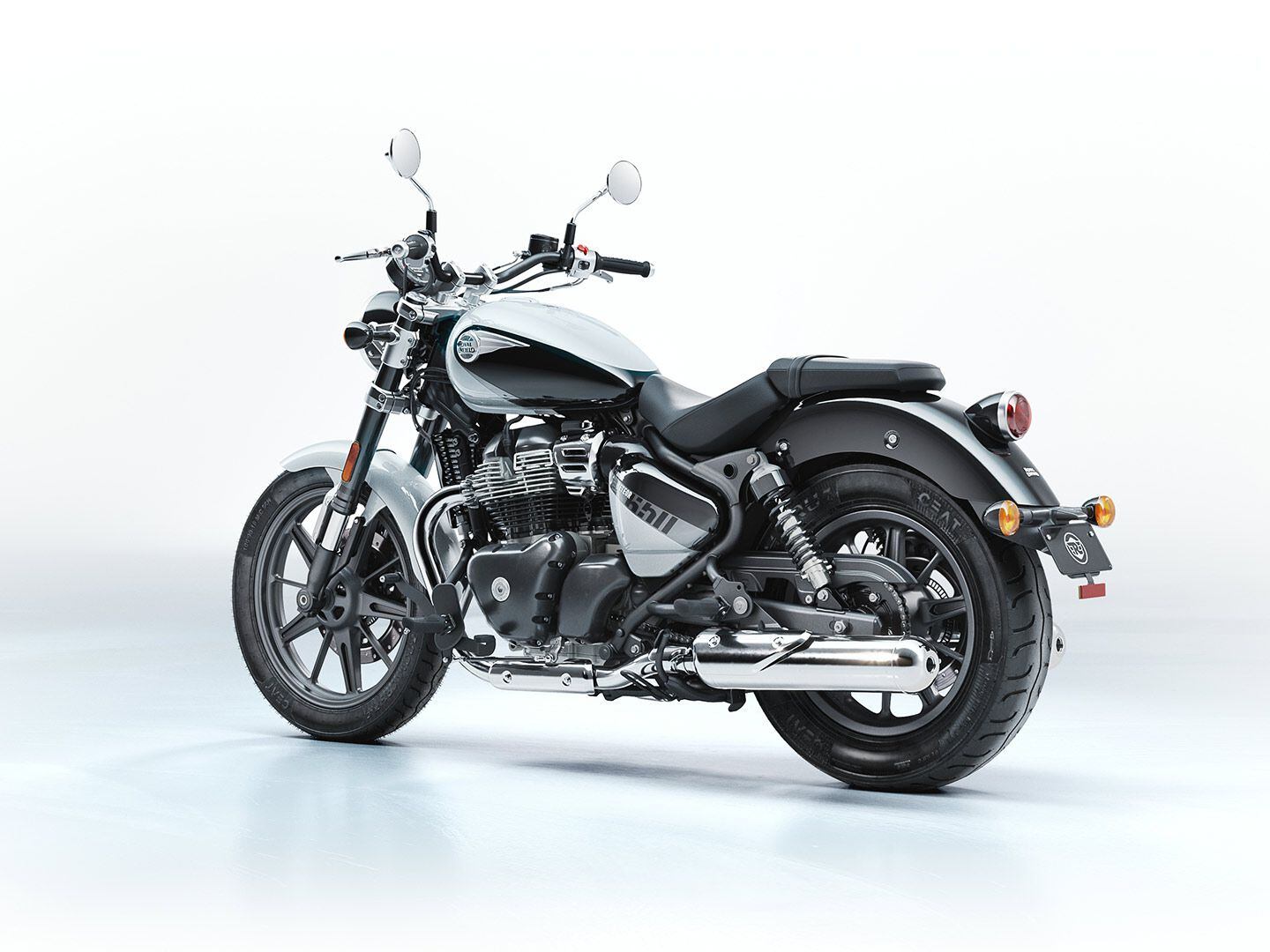
The Royal Enfield Super Meteor 650 in Interstellar Grey ($7,299) features a two-tone paint scheme whereas the Astral models are solid colors. (Josh Shipps/Klings/Royal Enfield/)
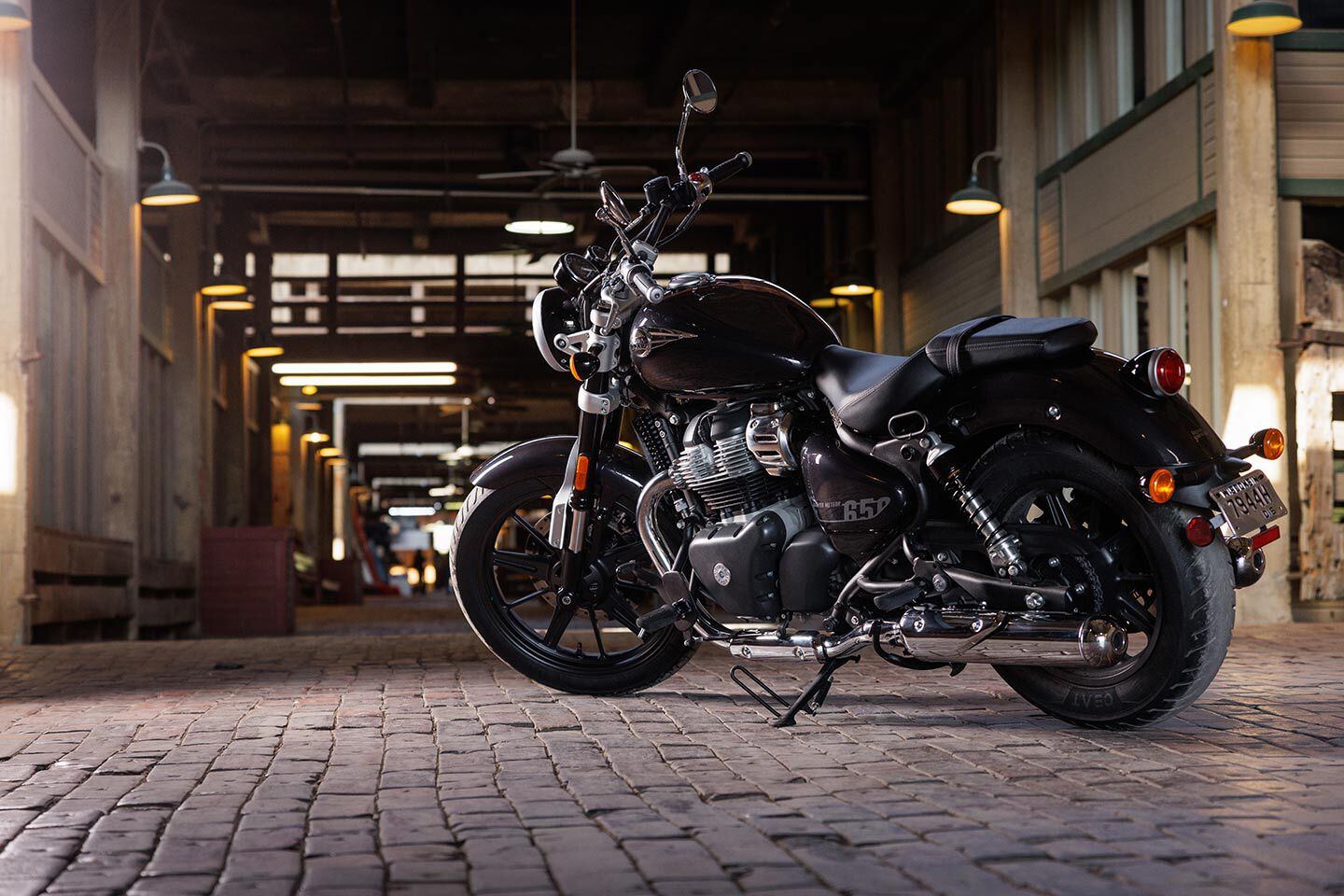
The Super Meteor 650 is by far the most stylish cruiser in its class. (Josh Shipps/Klings/Royal Enfield/)
2023 Royal Enfield Super Meteor 650 Specs
| MSRP: | $6,999–$7,499 |
|---|---|
| Engine: | SOHC, air/oil-cooled, 4-stroke parallel twin |
| Displacement: | 648cc |
| Bore x Stroke: | 78.0 x 67.8mm |
| Compression Ratio: | 9.5:1 |
| Transmission/Final Drive: | 6-speed constant mesh/chain |
| Claimed Horsepower: | 46.39 hp @ 7,250 rpm |
| Claimed Torque: | 38.57 lb.-ft. @ 5,650 rpm |
| Fuel System: | Electronic fuel injection |
| Clutch: | Wet, multiplate |
| Frame: | Steel tubular spine |
| Front Suspension: | 43mm inverted Showa Big Piston; 4.7 in. travel |
| Rear Suspension: | Twin shocks, preload adjustable, 4.0 in. travel |
| Front Brake: | 2-piston floating caliper, 320mm disc w/ ABS |
| Rear Brake: | 2-piston floating caliper, 300mm disc w/ ABS |
| Wheels, Front/Rear: | 19 in./16 in. |
| Tires, Front/Rear: | 100/90-19 / 150/80-16 |
| Wheelbase: | 59.0 in. |
| Ground Clearance: | 5.3 in. |
| Seat Height: | 29.1 in. |
| Fuel Capacity: | 4.2 gal. |
| Claimed Weight: | 531 lb. w/ 90% fuel & oil |
| Contact: | royalenfield.com |
Gearbox
Helmet: Arai Regent-X
Jacket: Spidi Garage
Gloves: Spidi Garage
Pants: Spidi J-Tracker Denim Pants
Boots: Rev’It Grand Shoes
]]>Triumph is sending off its flagship cafe racer with one last bang—the 2025 Thruxton Final Edition. (Triumph/)
Some of you may be inclined to shed a tear as word comes that Triumph’s signature cafe racer, the Thruxton, is no more. Or at least, it won’t be after the 2025 model year, as the Brit brand has announced the end of the bike’s production run next year. But at least the iconic model will be going out with a bang and not a whimper; behold the 2025 Thruxton Final Edition, a lavishly finished love letter to what some have called one of the best factory cafe racers around.
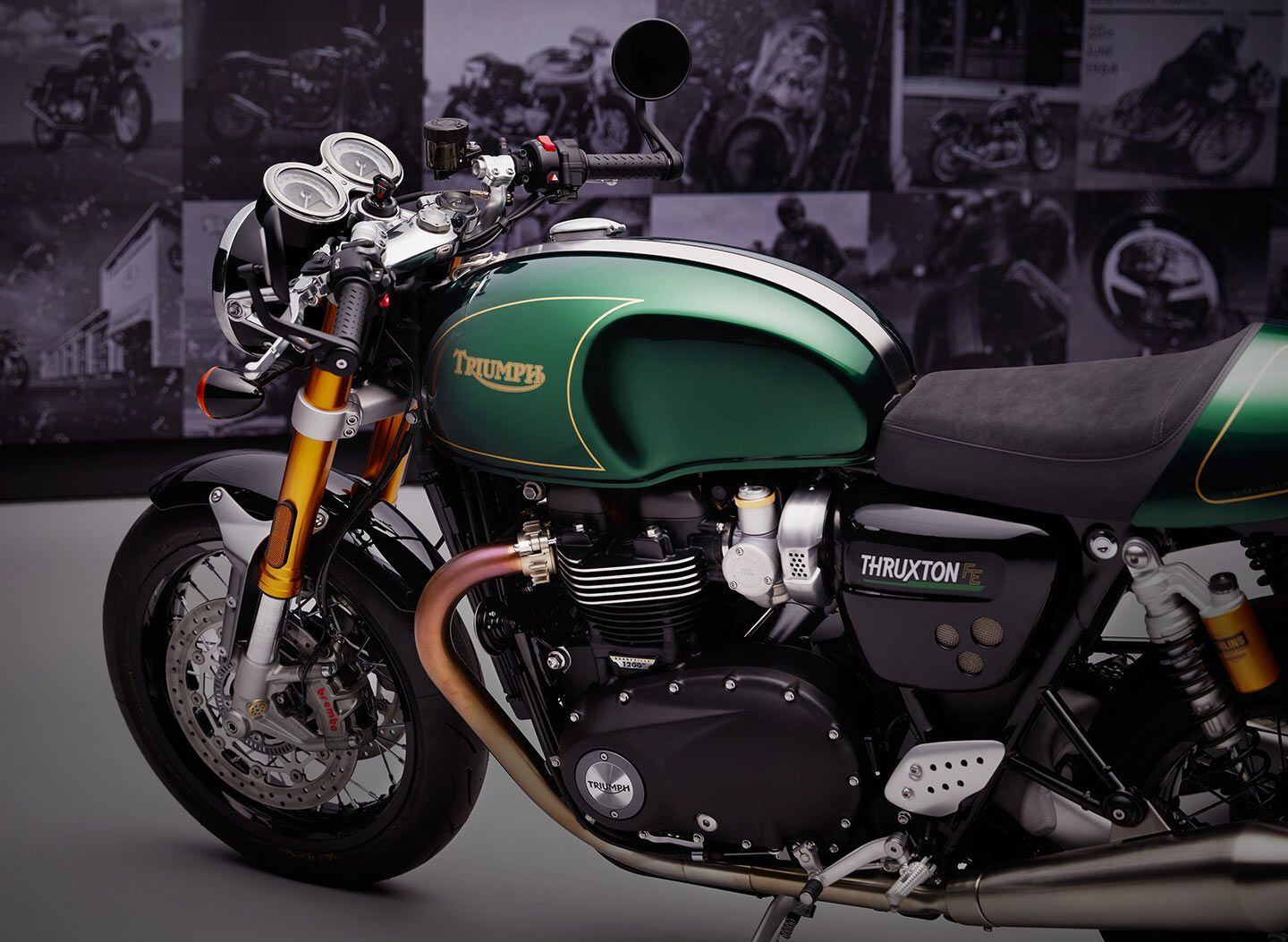
The Thruxton FE is based on the Thruxton RS model but tarts it up with a custom Competition Green paint job, special branding, and model-specific logos. (Triumph/)
The end comes after 20 years on the Hinckley assembly line, with the Thruxton’s final production run scheduled for 2024—though in reality, the Thruxton has been around on and off since 1964. To send off the award-winning flagship cafe racer, Triumph has unveiled the Thruxton Final Edition, a special-edition model sporting what it calls “incredible specification, performance, capability, and timeless style.”
In current form the bike is based on the up-spec Thruxton RS, which debuted three years ago with fully adjustable Showa USD fork, twin Öhlins piggyback shocks, and Brembo M50 monoblock brake calipers. The bike rolls on lightweight 17-inch aluminum 32-spoke wheels fitted with Metzeler Racetec RR tires aimed for sure-footed stability.
Those premium components act in the service of a 1,200cc Bonneville engine, tuned and mapped specifically for the Thruxton to be the punchiest in the Modern Classics line, with a claimed 103 hp at 7,500 rpm and 82 lb.-ft. of torque hitting at 4,250 rpm. Managing all that grunt are switchable rider modes, traction control, and ABS, with twin clocks to provide info. And the engine externals also carry through on the Thruxton’s signature cafe racer styling, with black powdercoated engine covers, cam cover finishes, and anodized black wheel rims. Even in stock form, she’s a beauty.
Related: 2016 Triumph Thruxton and Thruxton R: Overview
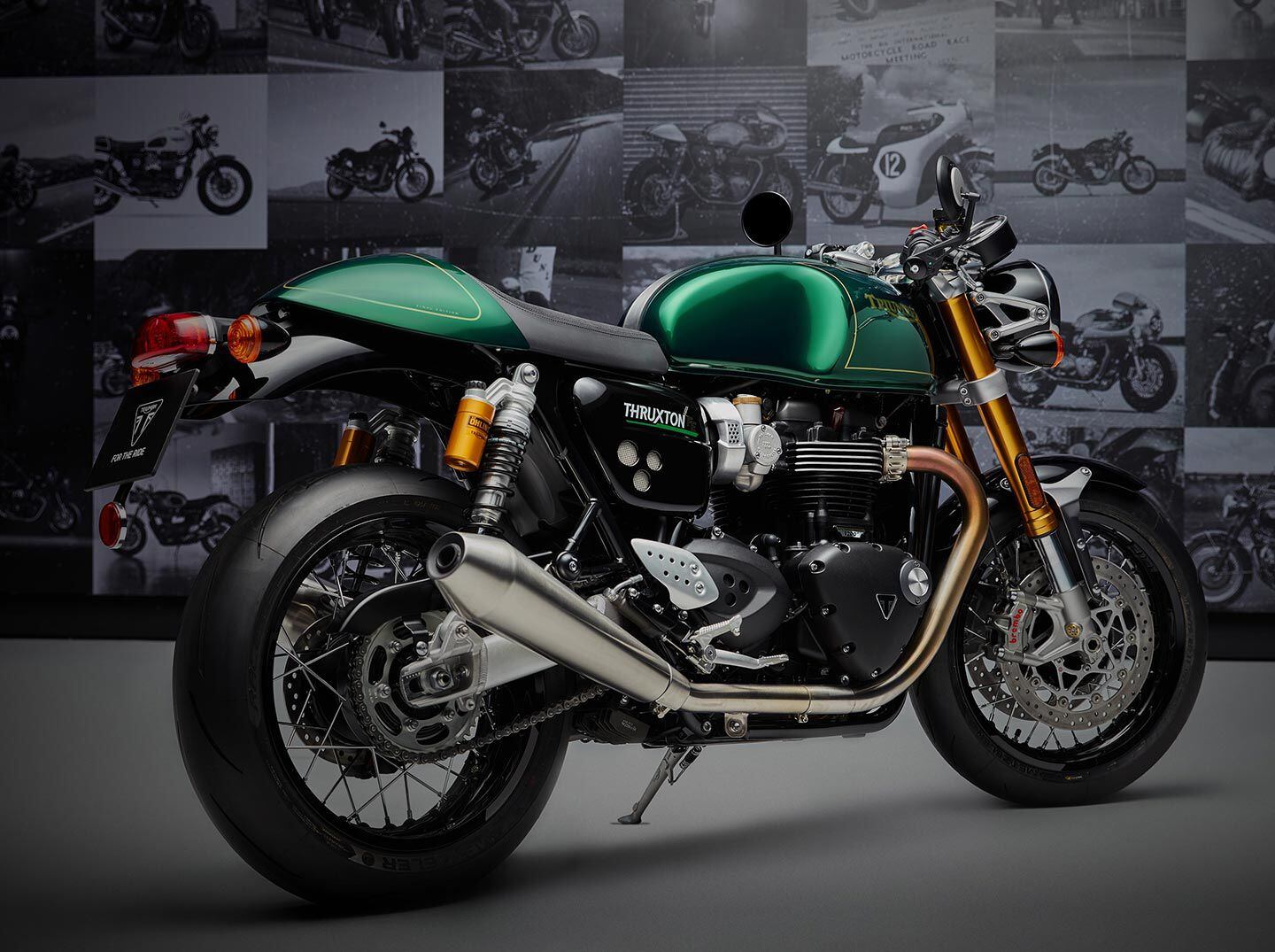
The 2025 Thruxton FE carries on the cafe racer styling with clip-ons and bullet seat, and retains premium Showa and Öhlins components from the RS. (Triumph/)
The special edition piles onto that RS spec sheet with a host of premium finishes and rich detailing for what Triumph says will be a limited-edition motorcycle, though the brand isn’t specifying how many units will be produced. We do know the bike will be strikingly finished in an exclusive Competition Green metallic paint scheme, complete with hand-painted gold lining; the paint is meant to celebrate the Thruxton’s racing heritage with a classic Triumph logo and matching gold-line detailing on the sculpted fuel tank and seat cowl. The rich, deep green is set against the lustrous black side panels and fenders, with the panels showcasing an exclusive Thruxton Final Edition logo.
Otherwise, all the other trademark Thruxton details carry over on the FE, from the single bullet seat and Monza-style fuel filler cap to the brushed stainless steel tank strap, clear anodized aluminum swingarm, and clip-on handlebars.
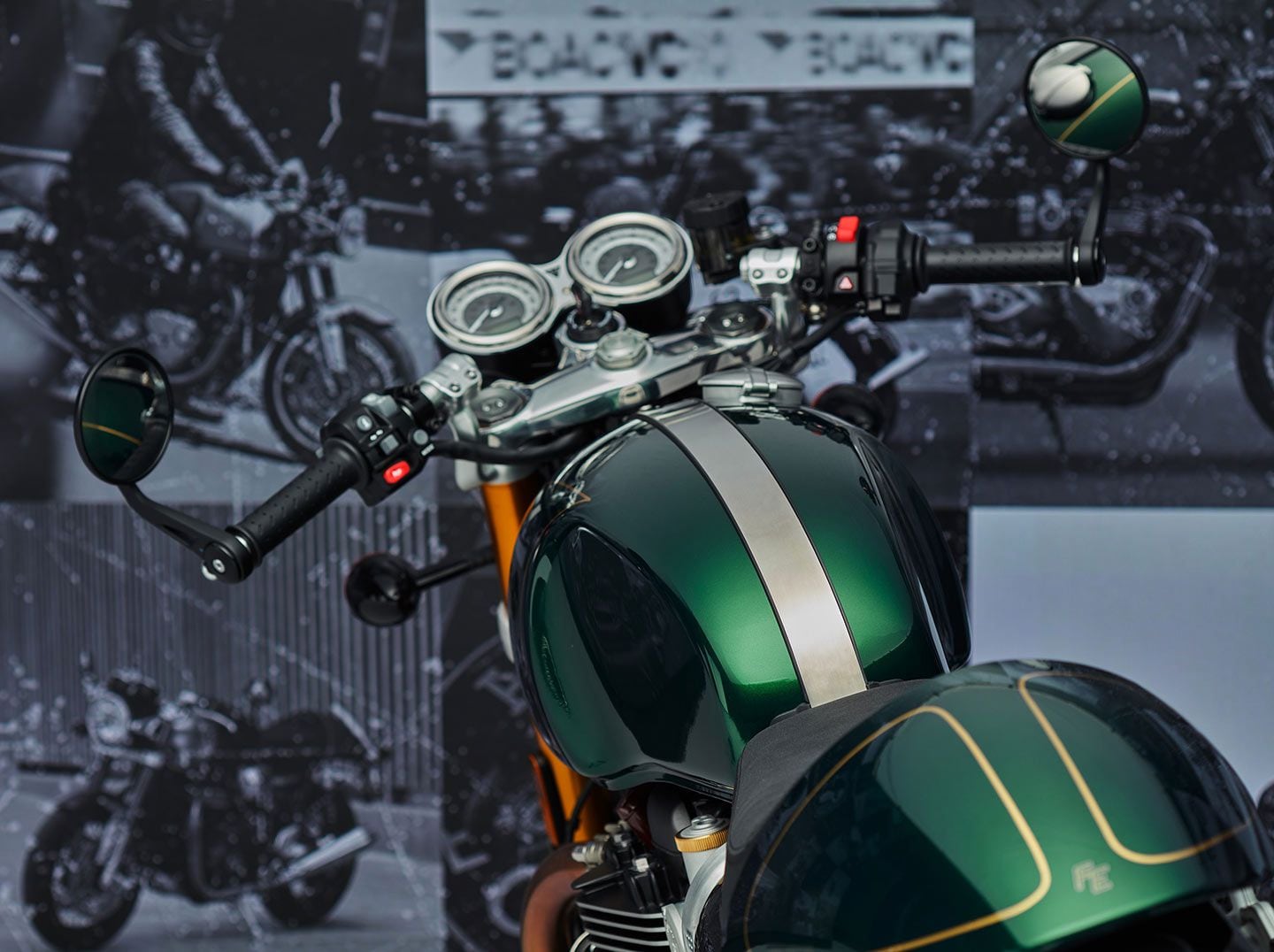
Rear view of the 2025 Thruxton FE shows details like the stainless tank strap, dual gauges, and rear cowling. (Triumph/)
Triumph also notes that each Final Edition will come with a certificate of authenticity marked with the bike’s unique VIN and signed by members of the Thruxton 1200 design team and Triumph’s CEO, Nick Bloor. The bike also comes with a unique Final Edition engine badge with a gold-finished surround and “Final Edition” graphic infill.
Related: 2020 Triumph Thruxton 1200/R/RS
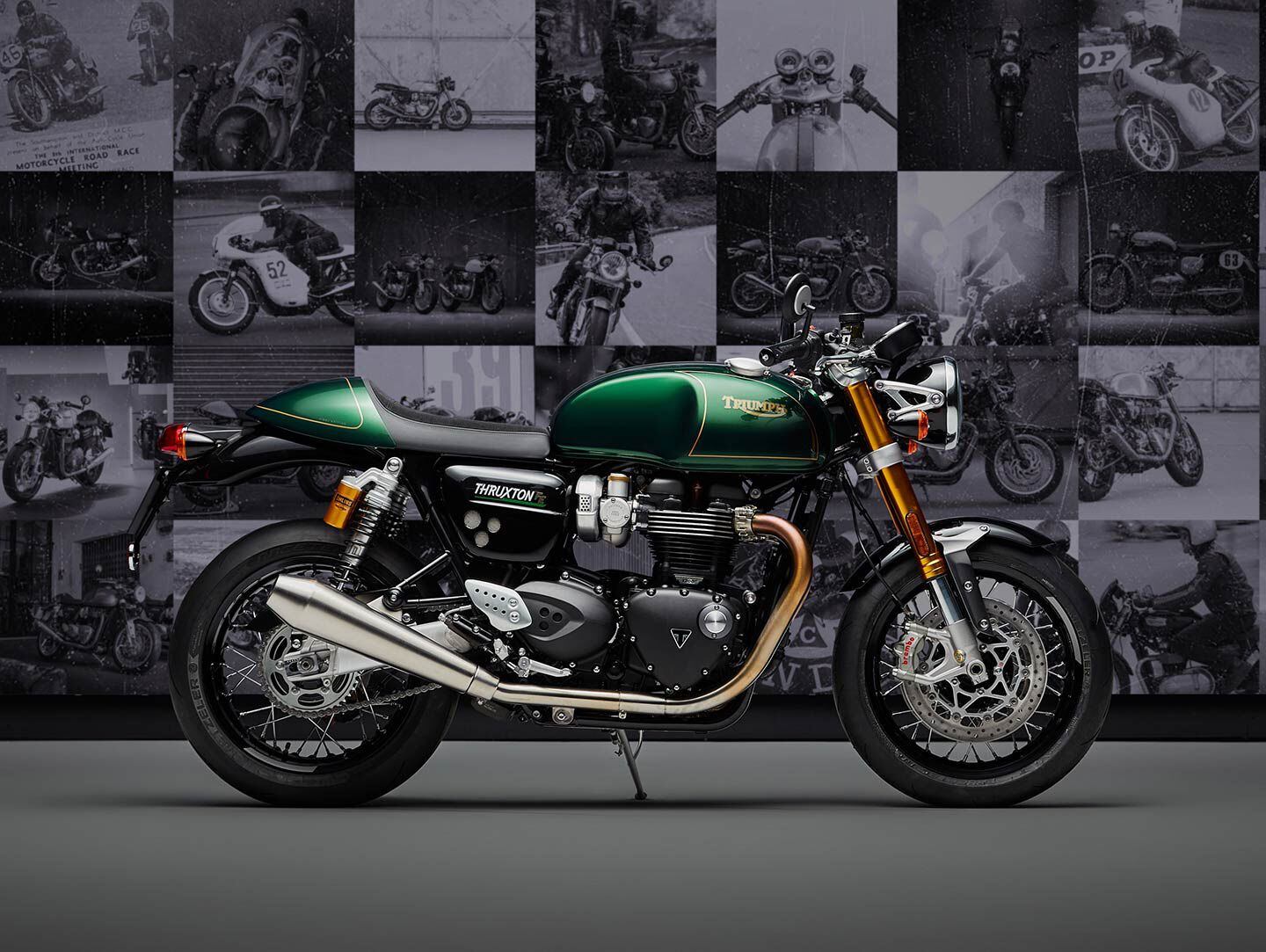
The 2025 Thruxton Final Edition will be available in 2024 as a special edition with an MSRP of $17,995 for the US. (Triumph/)
Naturally, Triumph is also reminding us that the 80 accessories it already offers for the Thruxton can fit onto the FE, but there’s also a special custom accessory designed to fit just the Final Edition: a dedicated accessory cockpit fairing, color matched to blend with the limited-edition Competition Green paint scheme (presumably its the same one as is available for the RS). The add-on should definitely take the cafe racer style to the next level, especially on the already-flash Final Edition.
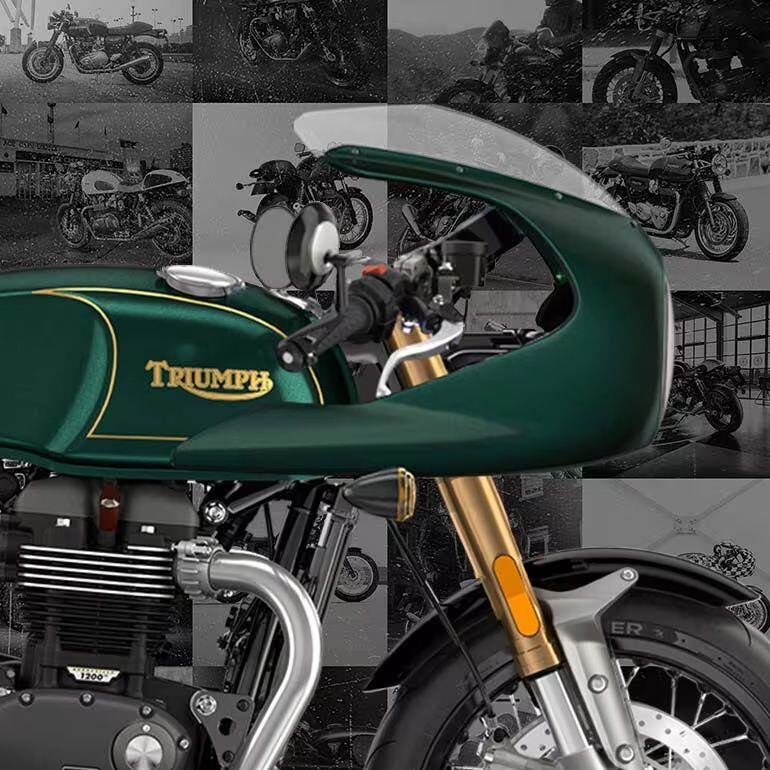
An accessory color-matched fairing is also available for the Thruxton FE. (Triumph/) ]]>
Honda has revised its Shadow Phantom for 2024 with key updates to the chassis and styling. (Kevin Wing/)
The metric cruiser (or Japanese-made cruiser) has survived the test of time, providing exceptional value and excellent quality for decades. Like its Eastern rivals, Honda has been trying to cash in on the popularity of American-style cruisers for a long time, in particular with its Shadow motorcycles. All the way back in 1983, Honda released the 45-degree V-twin-powered Shadow 750, followed by the Shadow ACE 750 in 1998, then the Shadow Phantom with its then-new 52-degree V-twin in 2010. Honda’s current cruiser lineup consists of seven models including the revised Shadow Phantom, which received some key updates for 2024 to keep it in the scrum for years to come.
Cruising is as much about styling as it is performance, and the Japanese companies haven’t always done a great job of hitting that nail on the head, often so close, but just lacking the nuances that make bikes from Harley-Davidson the ones that all others are judged against. However, there are other areas that Honda has executed very well.
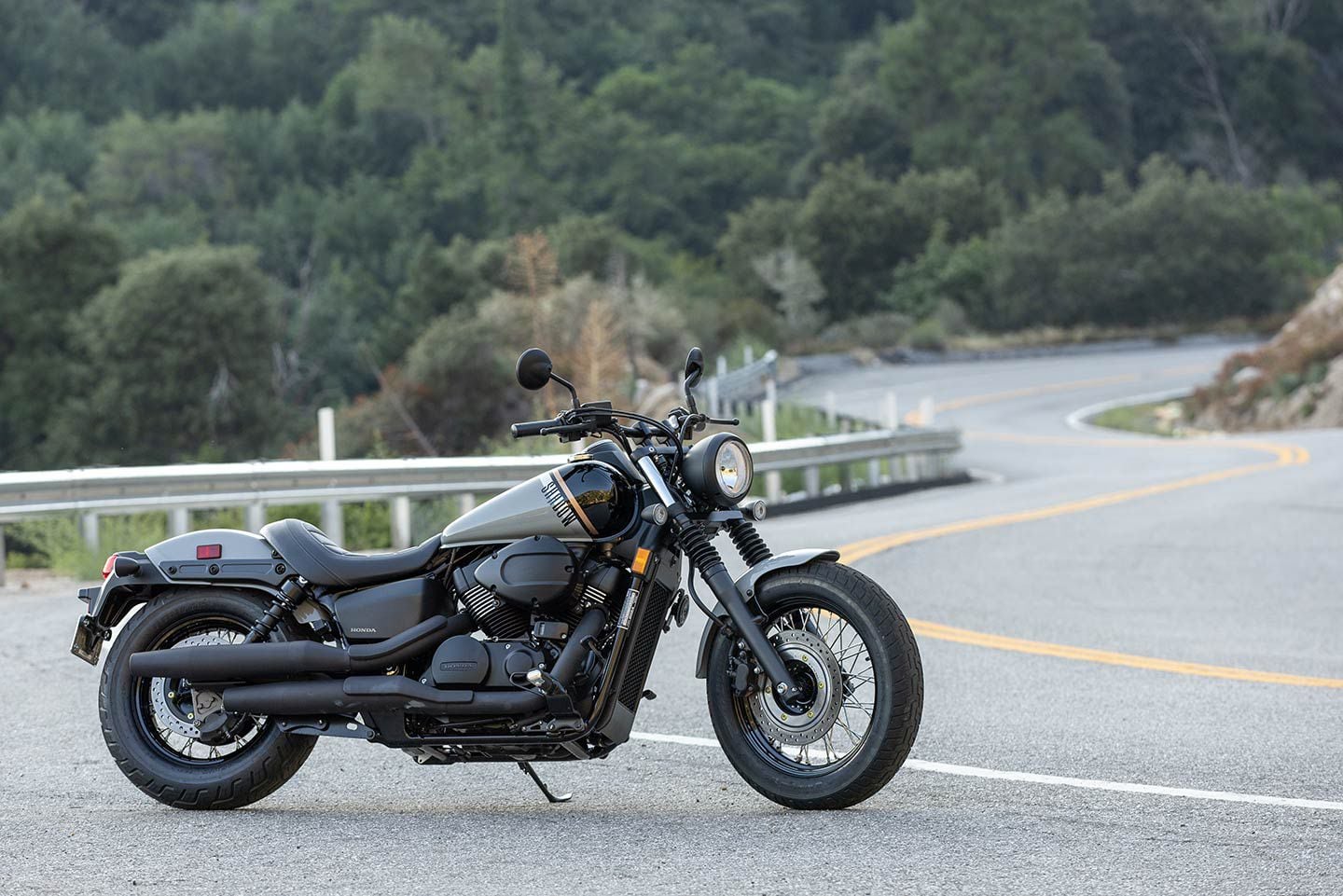
2024 Honda Shadow Phantom in Deep Pearl Gray. (Kevin Wing/)
Honda’s updated Shadow Phantom capitalizes on the growth of the midsize cruiser market, which really got some legs during the pandemic as people took advantage of downtime to jump back into motorcycling or purchase bikes for the first time. But where Honda has carved out a niche for itself is by offering excellent bang for the buck. Updates to the $8,399 Shadow Phantom include fresh styling, a revised riding position, the availability of ABS ($399 option), and a new disc rear brake replacing the drum unit of the previous model. And the classic bobber styling is, in our opinion, right on the mark.
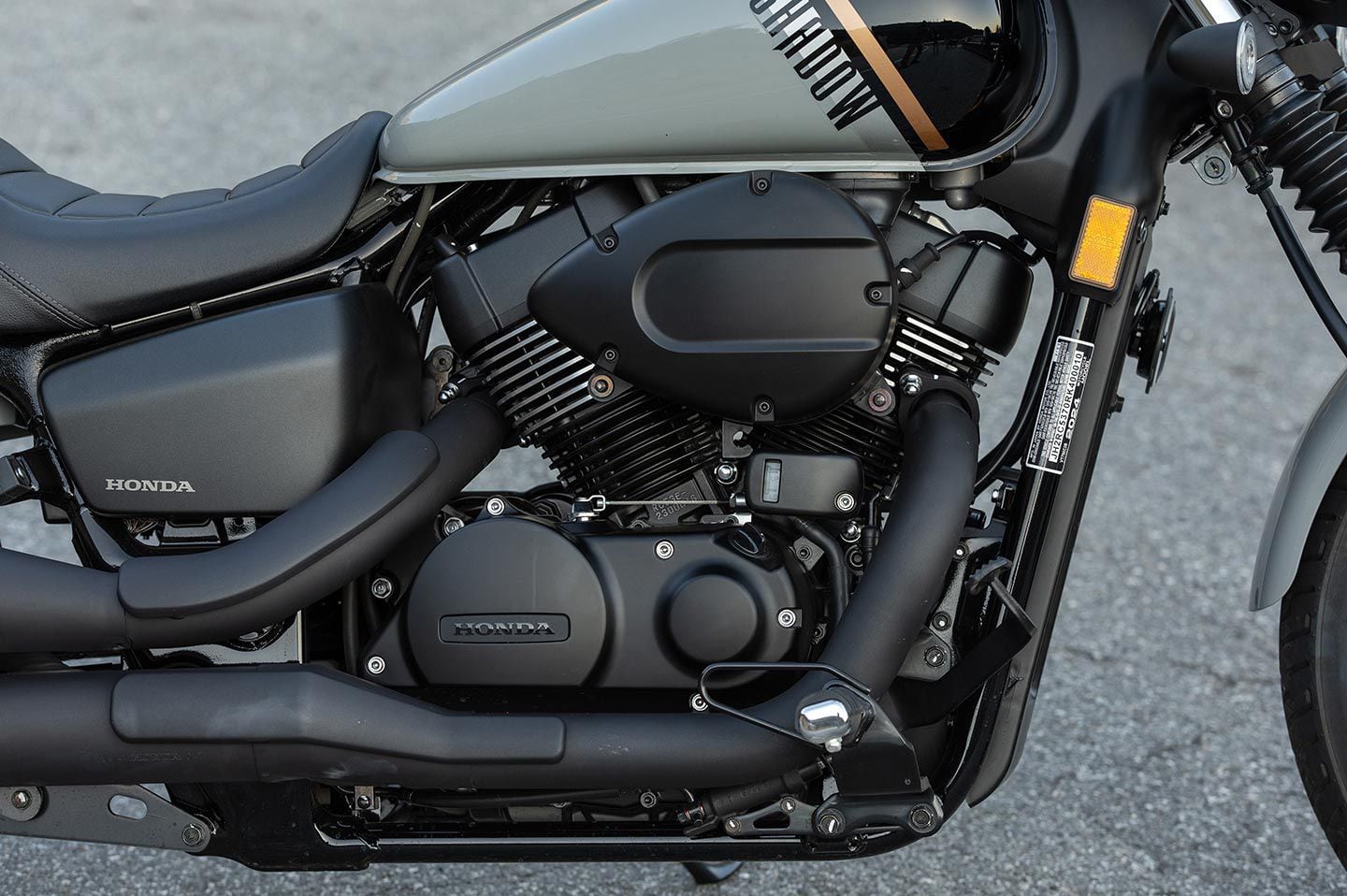
The Phantom’s 745cc V-twin remains unchanged for 2024. (Kevin Wing/)
Power comes from a liquid-cooled 745cc 52-degree V-twin with 79.0 x 76mm bore and stroke dimensions. The valve train features three valves (two intake, one exhaust) per cylinder with a single overhead cam in each. Air-fuel mixture is fed via a 34mm throttle body controlled by the Programmed Fuel Injection (PGM-FI) system. Power is sent to the rear wheel via a five-speed transmission and then to a low-maintenance shaft final drive.
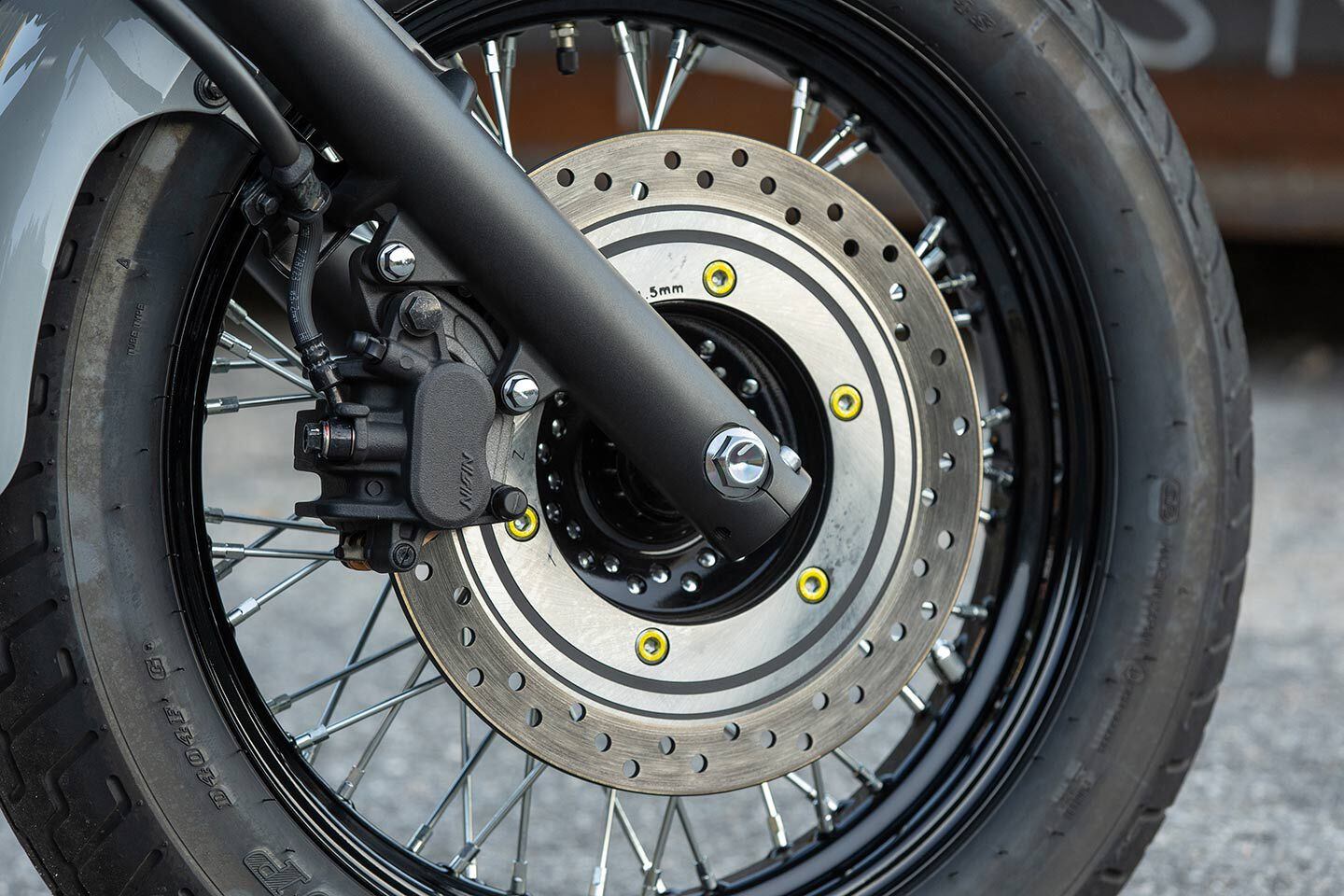
The standard fork provides 5.1 inches of travel, while a single 296mm disc is pinched by a twin-piston caliper. (Kevin Wing/)
Chassis highlights include a 41mm standard fork with 5.1 inches of travel and a pair of preload-adjustable shocks that provide 3.5 inches of rear-wheel travel. Braking is handled by a single 296mm front disc with a single twin-piston caliper, while the new rear disc measures 276mm and has a single-piston caliper. Up front is a 17-inch spoked rim mounted with a 120/90-17 tire, while at the rear is a 15-incher and 160/80-15 tire.
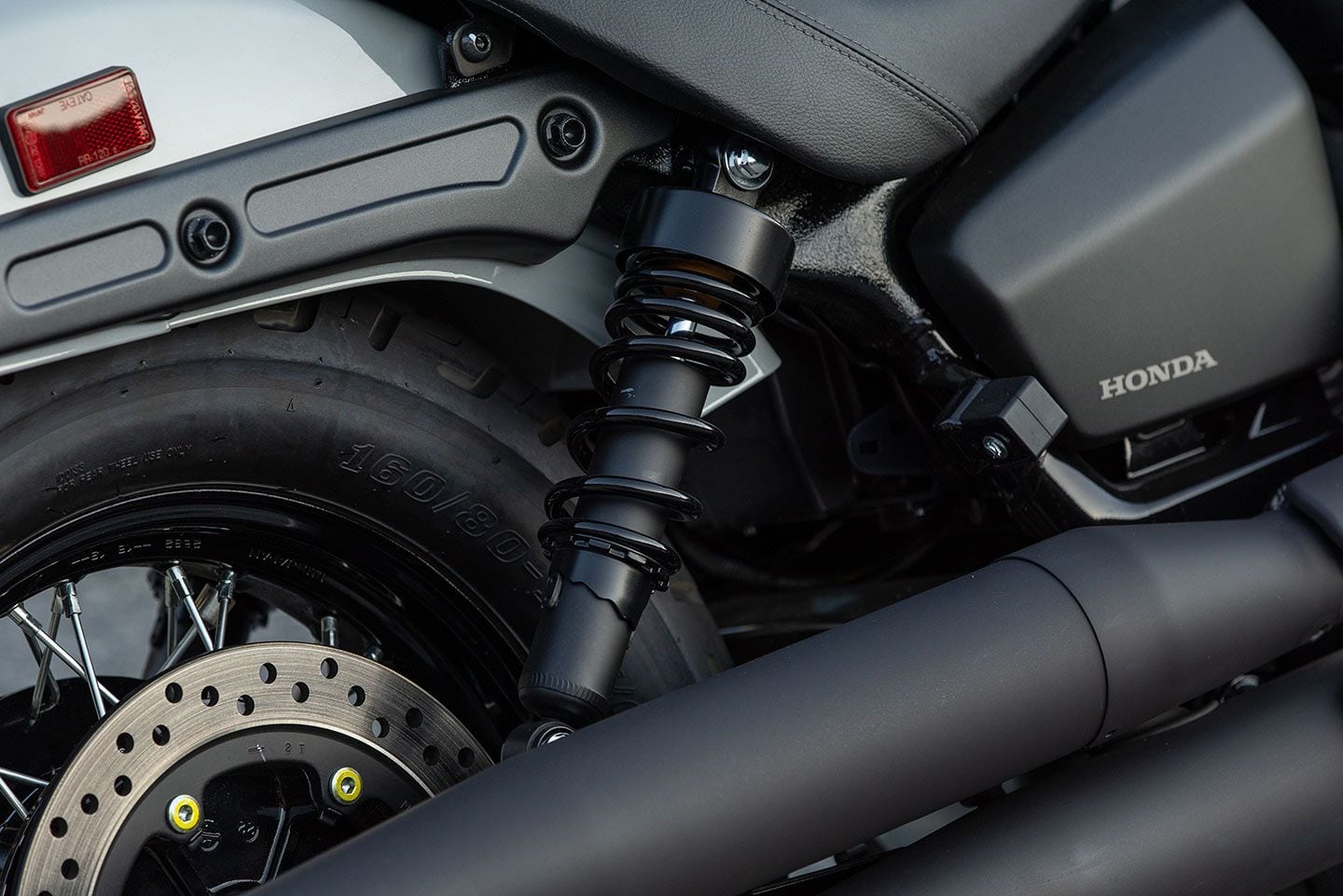
A pair of preload-adjustable shocks provide 3.5 inches of rear-wheel travel. (Kevin Wing/)
The Shadow Phantom’s wheelbase measures 64.6 inches with front-end geometry measuring 34 degrees of rake and 6.3 inches of trail. But perhaps the most important dimension is the ultralow 25.6-inch seat height. The rider triangle has been altered with the handlebar now moved forward 3.4 inches with the width increased by just under three-quarters of an inch, while the seat and footpeg relationship remains the same.
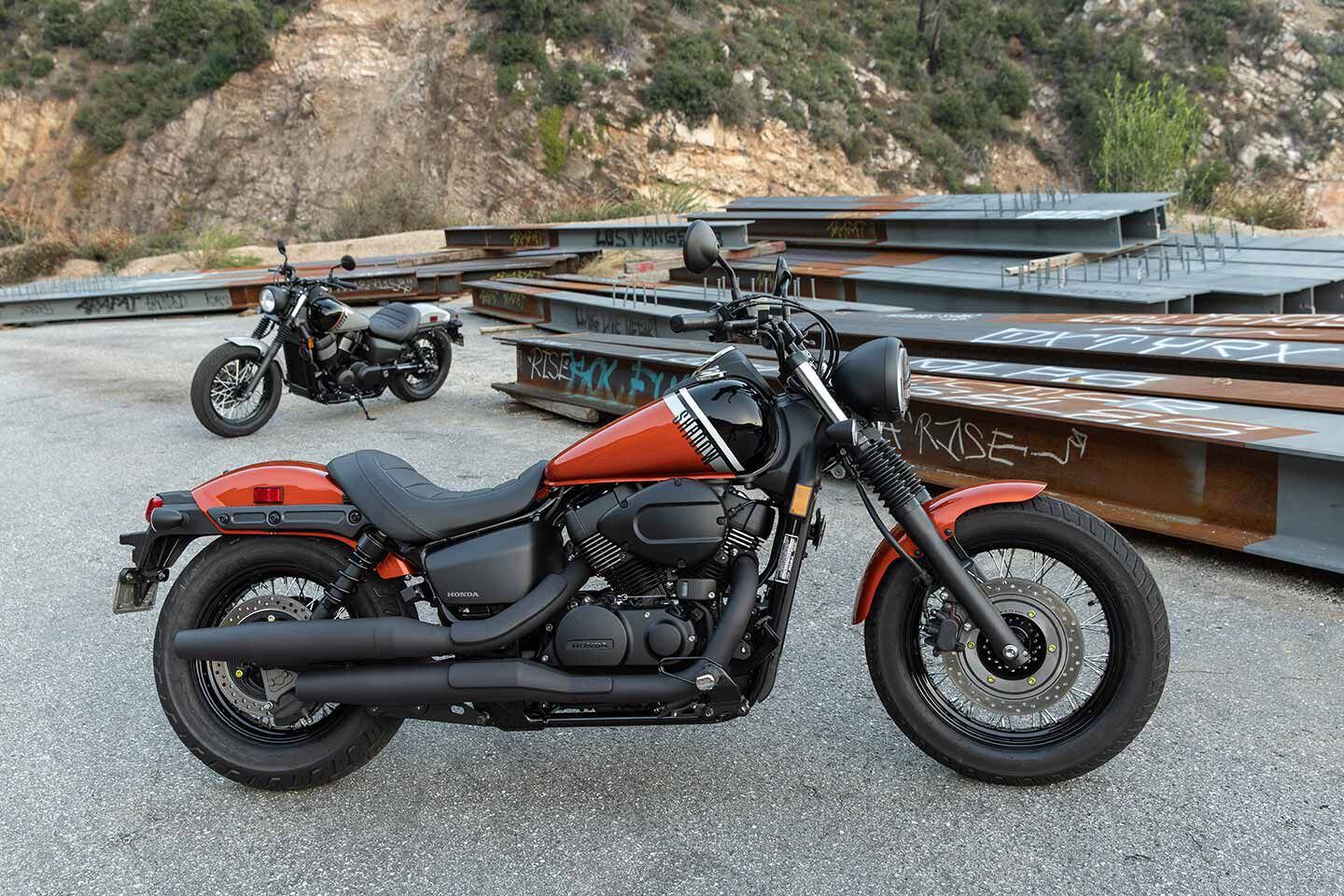
The 2024 Honda Shadow Phantom is available in Metallic Orange or Deep Pearl Gray. (Kevin Wing/)
Areas that have been refreshed in terms of styling include a new front fender, rear fender and seat rail, new seat shape, LED turn signals all around, a new air-cleaner cover, headlight nacelle, rubber boots on the fork legs, machine-cut cylinder-head fins, and most obvious is the two-tone fuel-tank paint. Two colors are available: Deep Pearl Gray or Metallic Orange.
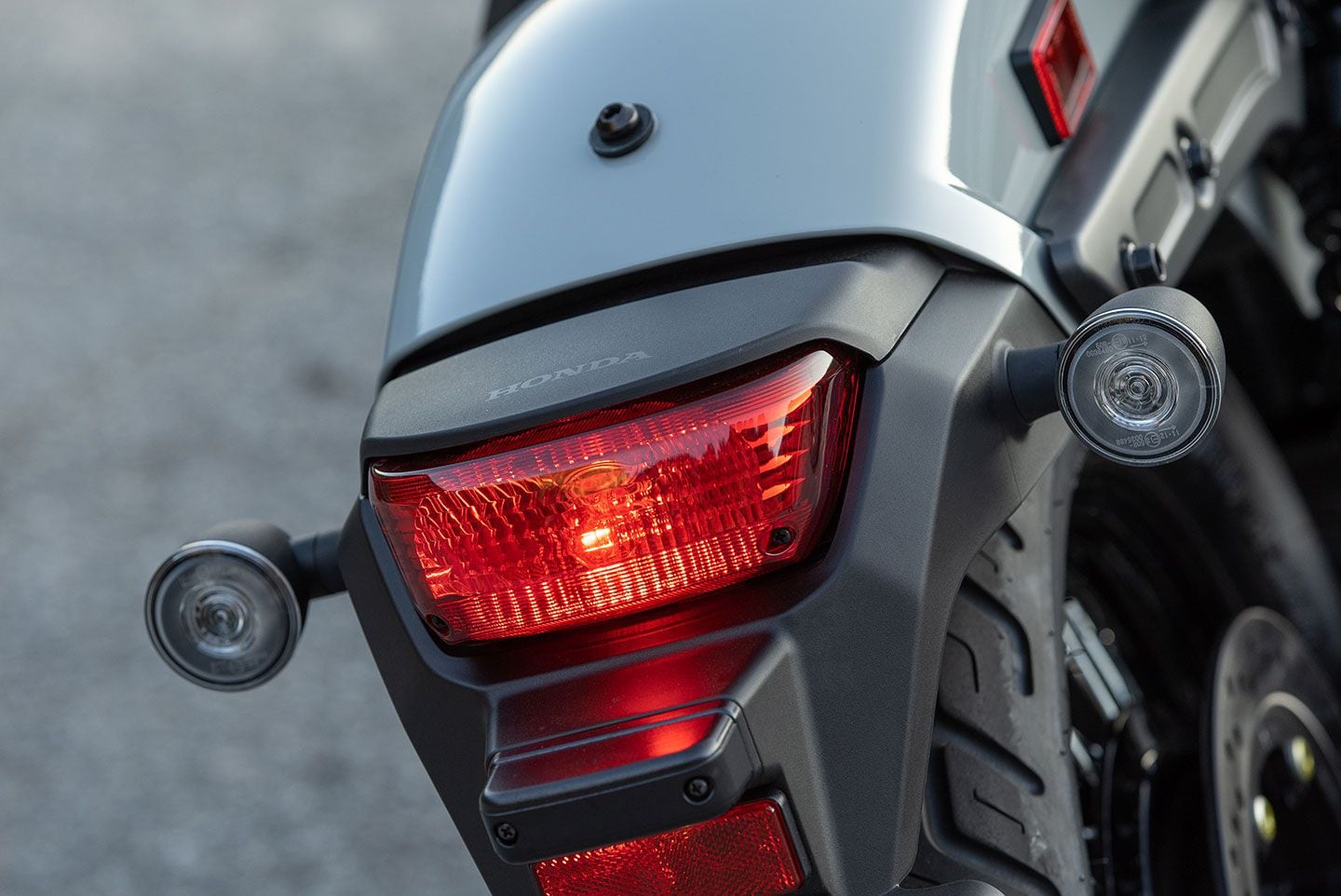
The Shadow Phantom gets LED turn signals at each corner. (Kevin Wing/)
A quick walk around the Phantom in a parking lot reveals a bike with excellent fit and high-quality finishes from the tank and fender paint to the blacked-out (grayed out?) covers and brackets. One of the most appealing features of the bike for potential buyers has to be that ultralow seat, which makes getting on and off the bike and managing its light-by-cruiser-standards 543-pound fueled weight really easy. Reach up to the bars and you are greeted by modern switches and controls. On top of the fuel tank is the bike’s lone gauge with an analog speedometer and inset LED screen for basic info like the tripmeter, clock, and so on.
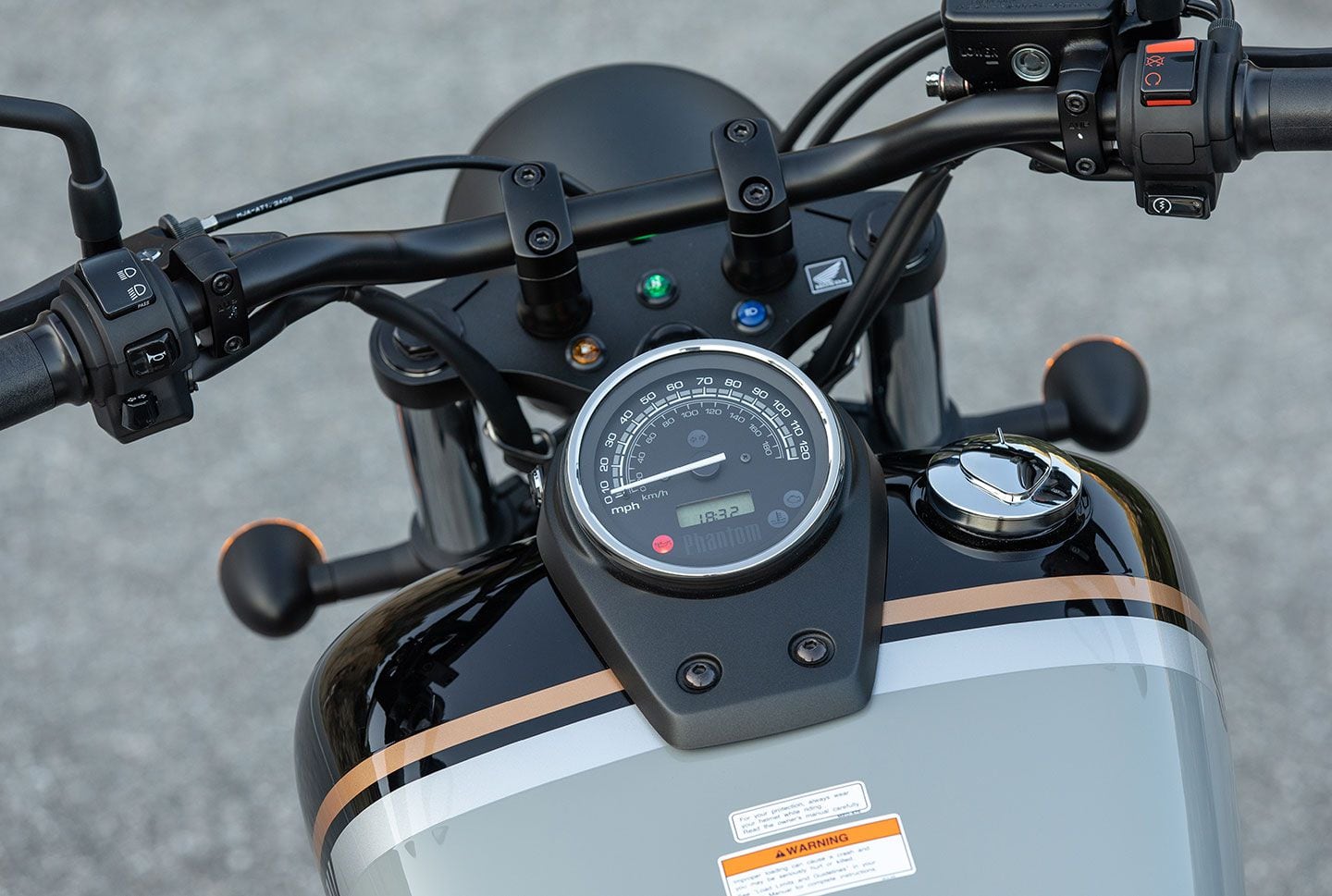
A simple and classic single gauge provides all the basic info. (Kevin Wing/)
Fire up the engine and it settles into a pleasant V-twin rumble. Snicking the transmission into gear and pulling away from a stop is helped by light action from the cable-actuated clutch, while shifting through the gears is smooth and positive without any clunkiness. Around town in urban environments, the Phantom is light steering with excellent and balanced low-speed handling. The seating position pulls this 5-foot, 11-inch rider’s upper body just forward with an easy reach to the bars and a relaxed bend of the legs to the forward-mounted foot controls. The seat is firm enough to provide good support for the lower back, but comfortable enough for longer stints. The low seat height should provide solid footing at stops for all but the most height-challenged riders.
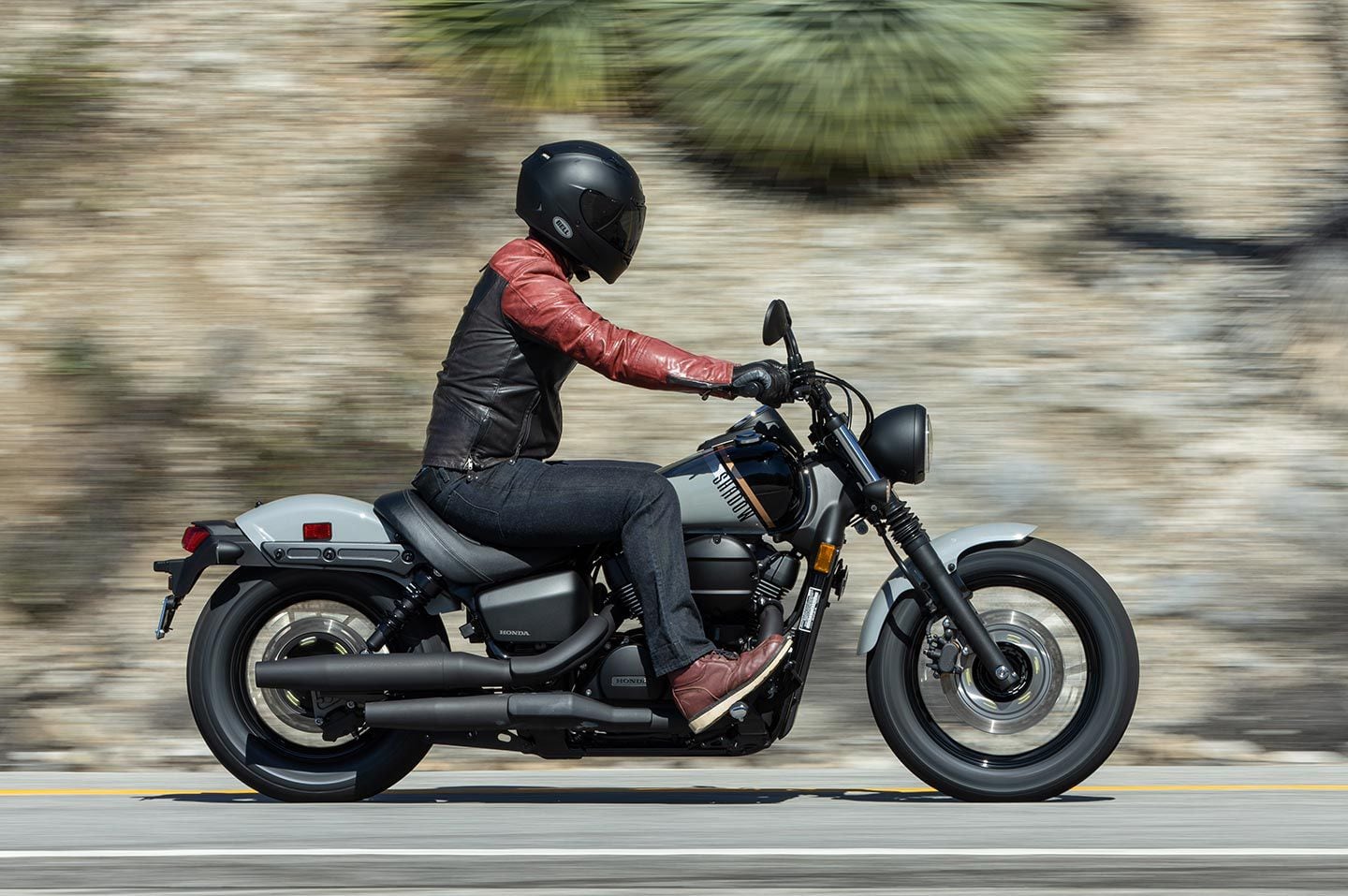
The Shadow Phantom’s riding position has been altered to pull the rider forward with a new bar position. (Kevin Wing/)
Heading out into the mountains above Azusa, California, the Phantom provides predictable and stable handling and flicks into corners with light and neutral steering. Pick up the pace through tighter hairpin bends and the forward foot controls’ peg feelers will drag (as will the heel of your boots). The suspension is plush and offers a cushy ride, eating up bad asphalt with no issues, but will tend to bounce a bit after hitting G-outs in the road with less than ideal rebound damping. The only adjustment to suspension is preload for the twin shocks, so fine-tuning the ride is aimed more at firming up the rear if you add a passenger with the optional fender-mounted seat and passenger pegs.
Performance from the 745cc V-twin is good, with decent low-end to midrange torque on tap. Around town and exiting tight corners, the engine provides good drive, but the power definitely falls off in the upper rpm range. Making a quick pass of another vehicle usually requires a downshift if you’re hanging out in the upper two gears. But overall, the engine is smooth, with excellent fueling and a good spread of power for a middleweight cruiser.
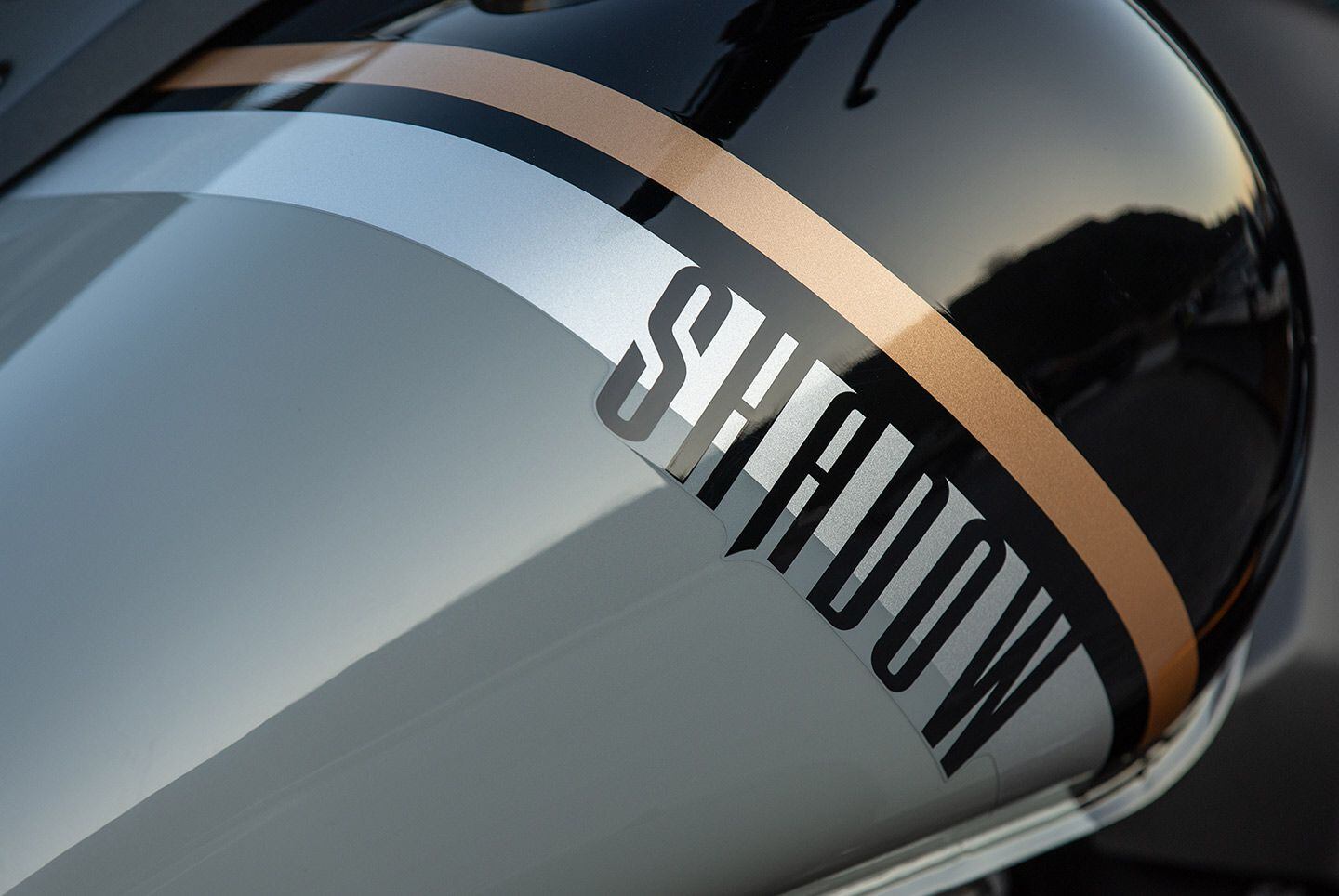
Paint and finishes appear to be top quality. (Kevin Wing/)
At a normal riding pace the front brake provides decent power, but if you need to get slowed down in a hurry for an upcoming hairpin, you have to grab a big handful at the front lever. The brake never provides a super-crisp bite but is progressive and predictable. Thankfully Honda has added that big rear disc which can supplement the front and help get the bike stopped without issue. The bike we rode for the day didn’t have ABS, but we can’t imagine why you’d want to forego that option considering it only adds $399 to the price.
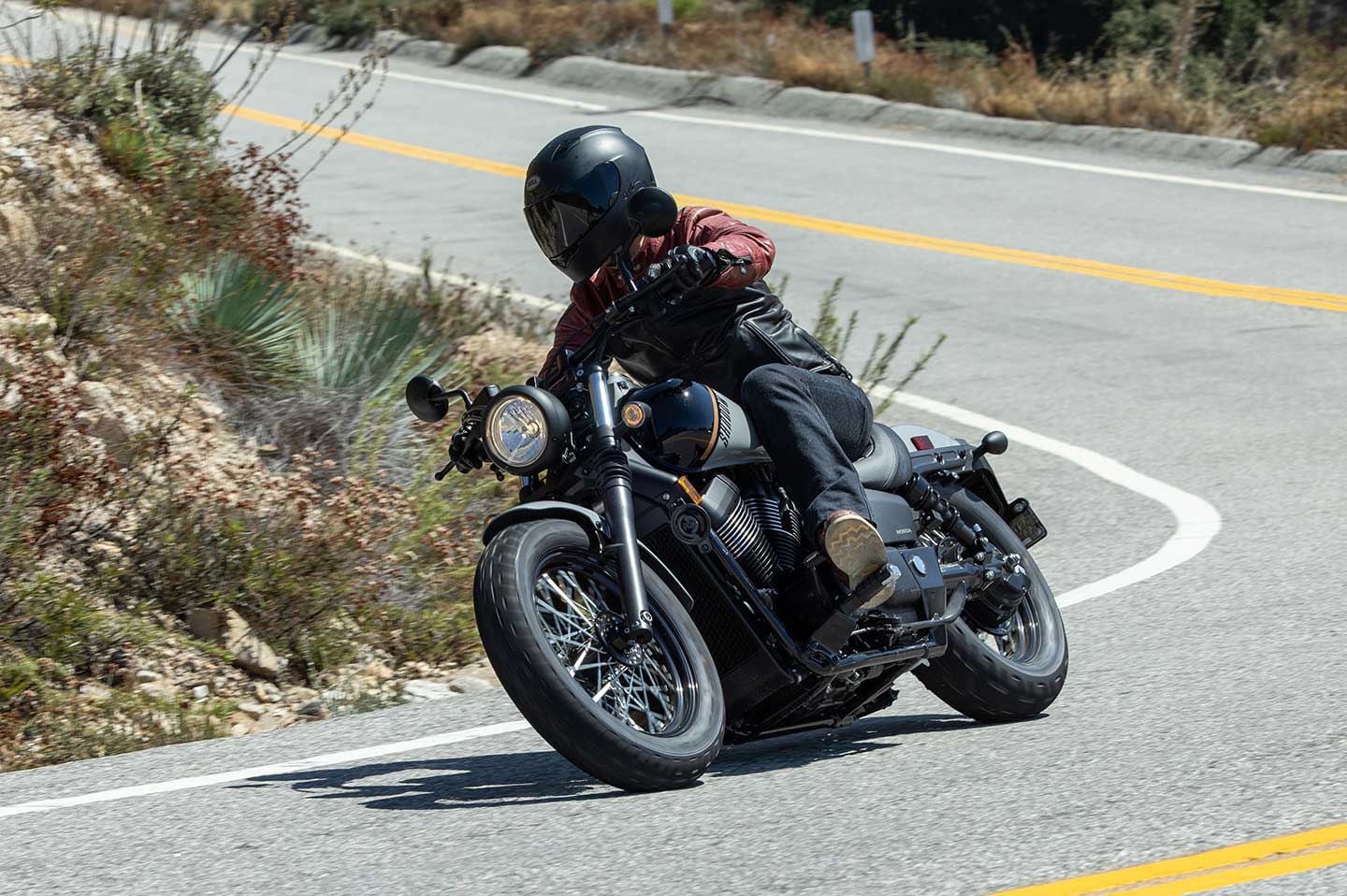
Honda’s Shadow Phantom provides a plush ride, and good handling, from its lightweight package. (Kevin Wing/)
The bottom line here is that there are very few options out there for buyers looking for a midsize cruiser, especially one that looks this good in person. Perhaps the most popular bike of all time in this category, the Harley-Davidson 883 Sportster was dropped after the 2022 model year (having been in production since 1957), leaving some big shoes to fill. Currently there are just a handful of bikes remaining to give the Honda Shadow Phantom any serious competition, like the $10,359 Suzuki Boulevard C50T and $8,999 Kawasaki Vulcan 900 Classic.
Clearly recognizing the opportunity, Honda has thrown some smart updates at this bike and delivers a great-looking motorcycle that isn’t intimidating for newer riders with its low curb weight, nice low-speed handling, and mellow power delivery. On the flip side, it delivers enough engine performance for seasoned riders looking for a really nice bike at a very reasonable price and offers all the hallmarks of a Honda, like excellent fit and finish, quality components, and a large dealer network. The Shadow Phantom is available in dealers now.
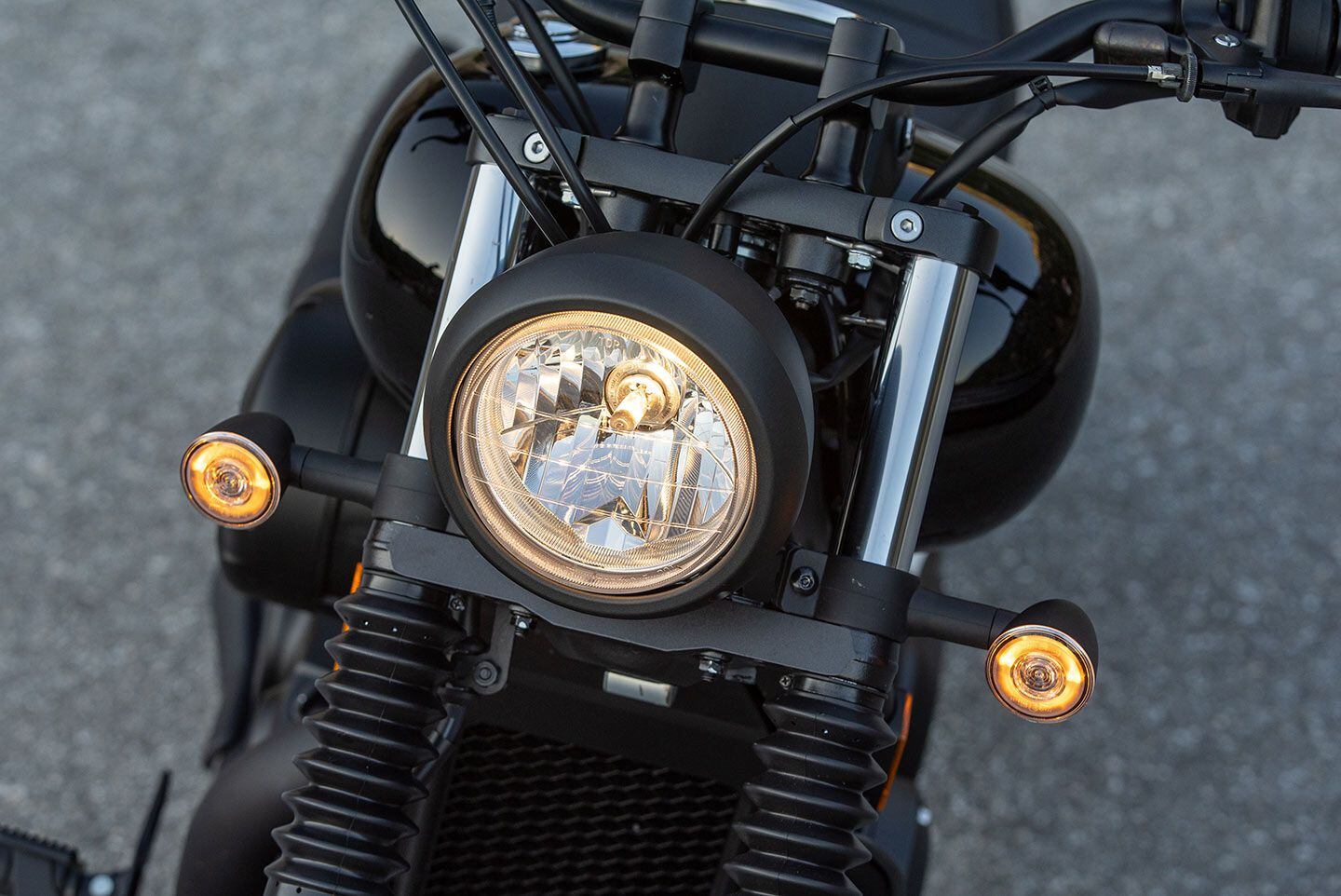
The blacked-out headlight bezel is bookended by new LED turn signals. (Kevin Wing/)
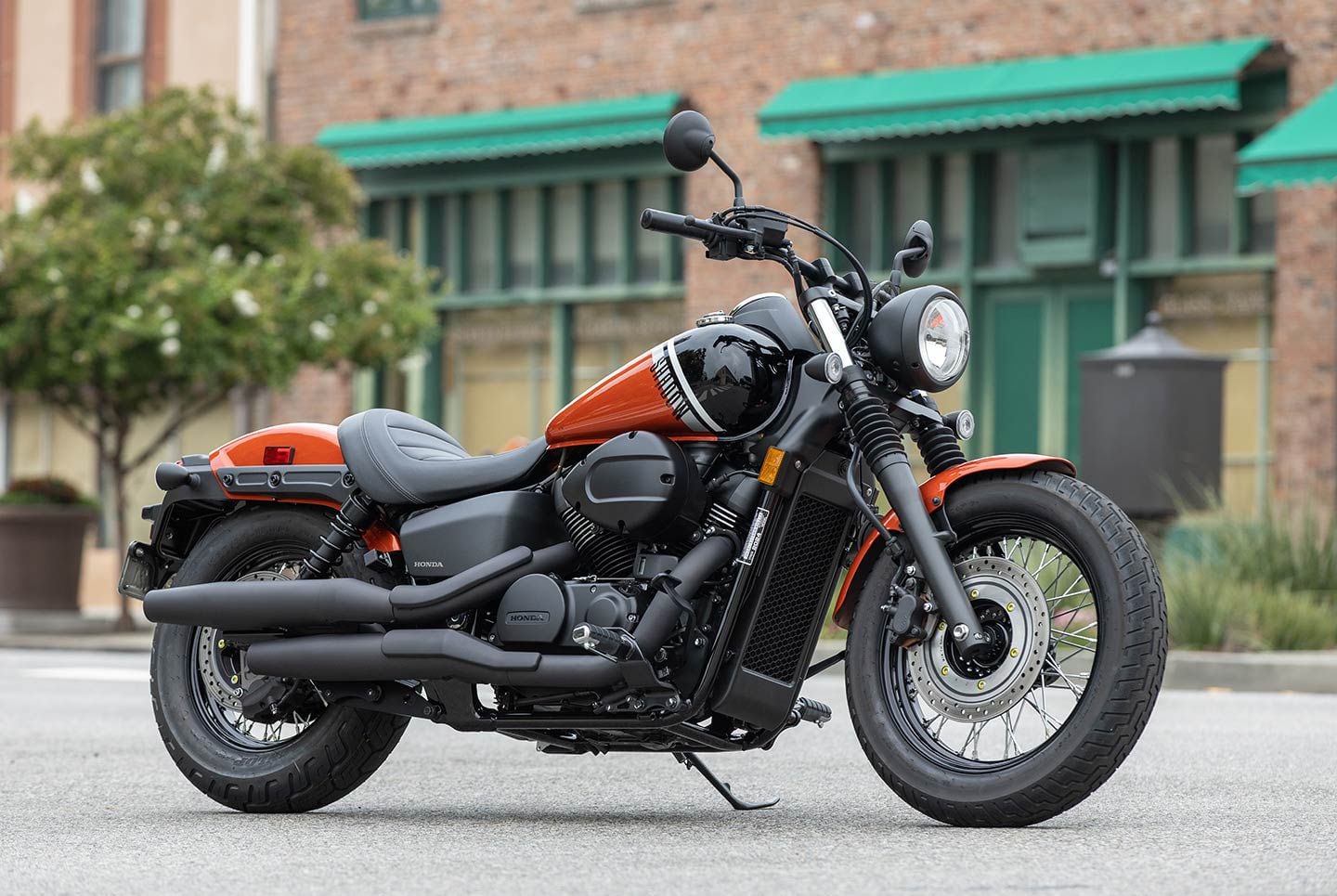
The 2024 Honda Shadow Phantom in Orange Metallic. (Kevin Wing/)
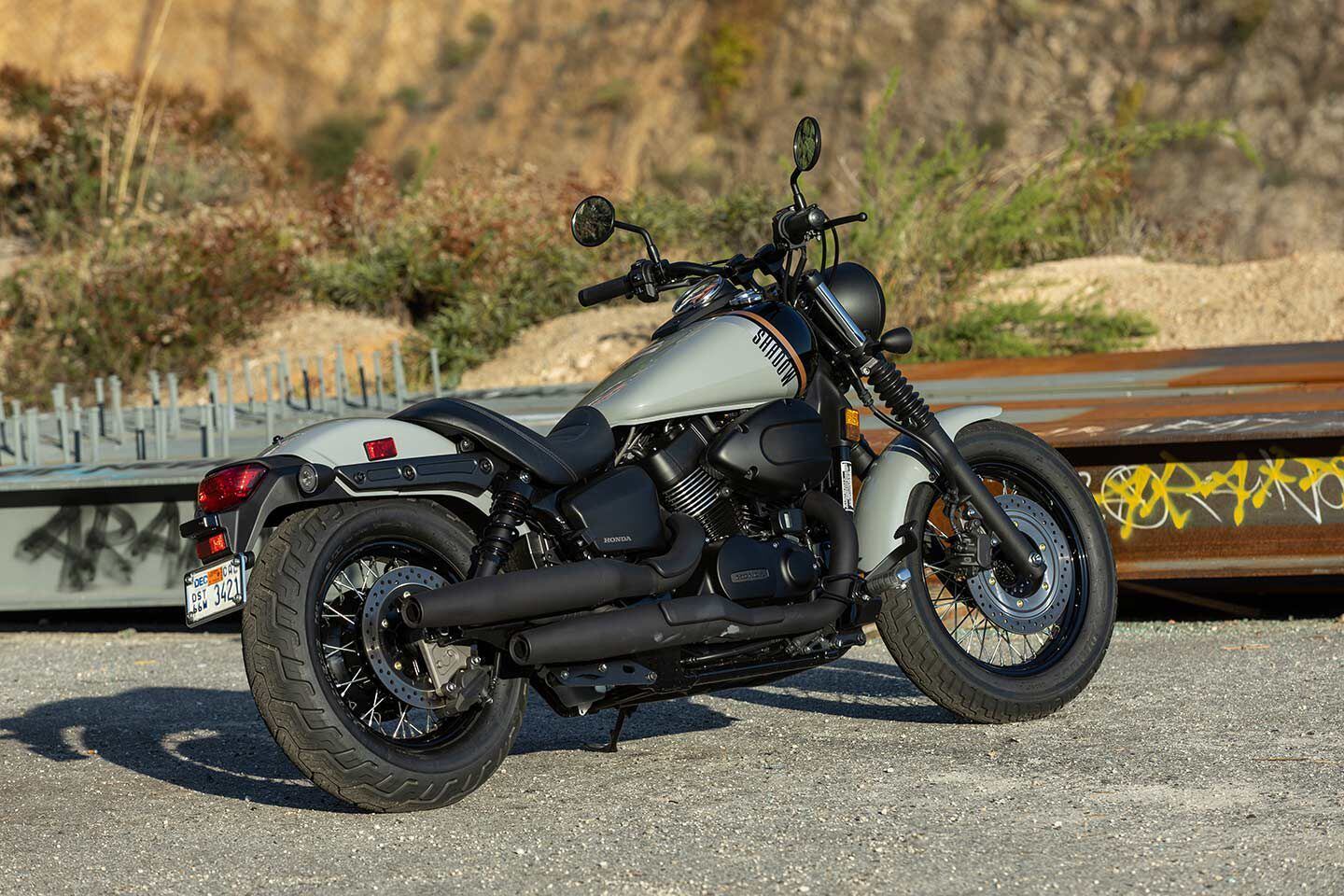
The 2024 Honda Shadow Phantom in Deep Pearl Gray. (Kevin Wing/)
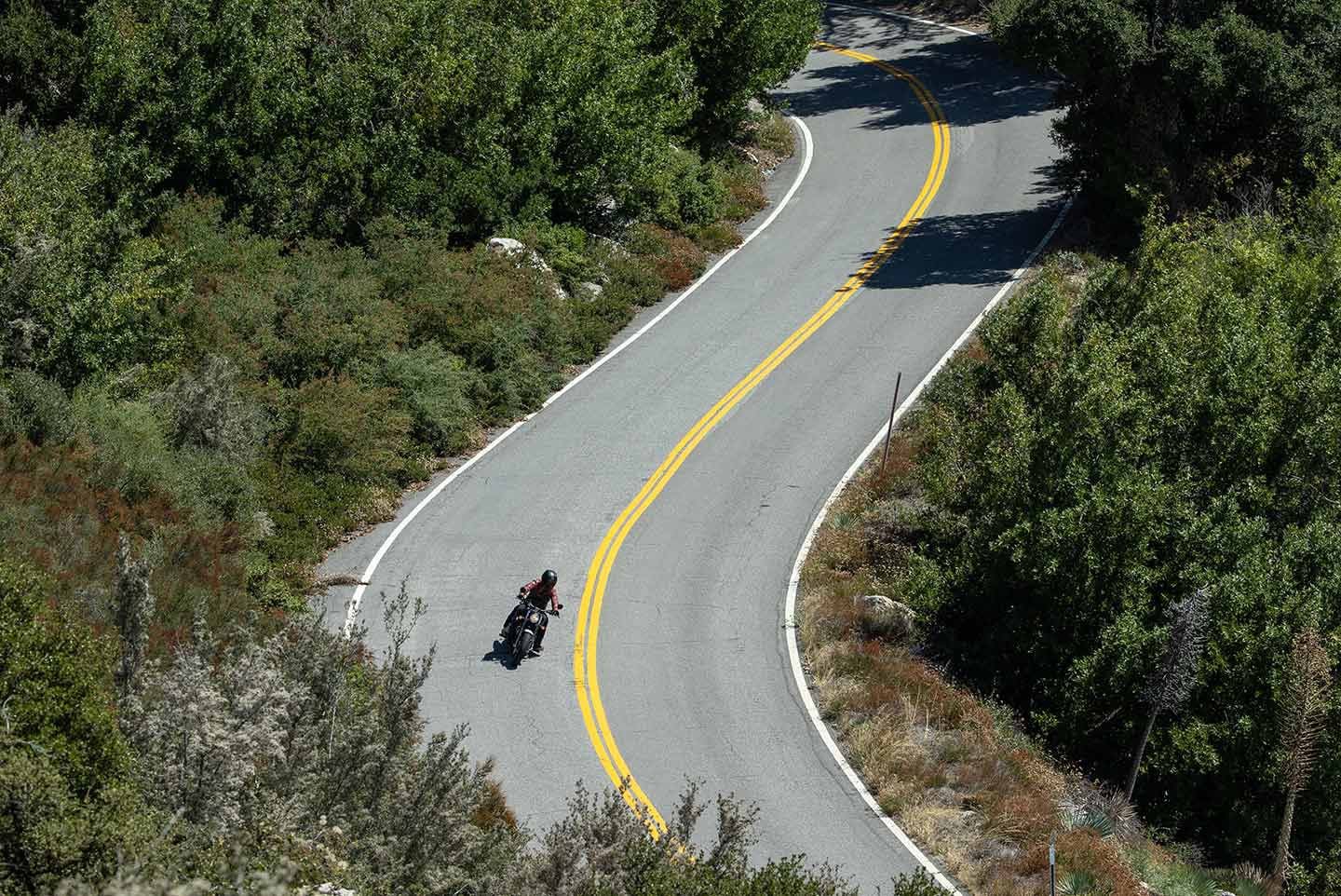
Don’t be afraid to hit the curves on the Shadow Phantom. (Kevin Wing/)
2024 Honda Shadow Phantom Specs
| MSRP: | $8,399/$8,699 (ABS) |
|---|---|
| Engine: | SOHC, liquid-cooled 52-degree V-twin; 3 valves/cyl. |
| Displacement: | 745cc |
| Bore x Stroke: | 79.0 x 76.0mm |
| Compression Ratio: | 9.6:1 |
| Transmission/Final Drive: | 5-speed/shaft |
| Fuel System: | Programmed Fuel Injection w/ 34mm throttle bodies |
| Clutch: | Wet, multiplate |
| Engine Management/Ignition: Electronic | |
| Frame: | Steel |
| Front Suspension: | 41mm fork; 5.1 in. travel |
| Rear Suspension: | Twin shocks, preload adjustable; 3.5 in. travel |
| Front Brake: | 2-piston caliper, 296mm disc, available ABS |
| Rear Brake: | 1-piston caliper, 276mm disc, available ABS |
| Wheels, Front/Rear: | Wire-spoked; 17 in./15 in. |
| Tires, Front/Rear: | 120/90-17 / 160/80-15 |
| Rake/Trail: | 34.0°/6.3 in. |
| Wheelbase: | 64.6 in. |
| Ground Clearance: | N/A |
| Seat Height: | 25.6 in. |
| Fuel Capacity: | 3.9 gal. |
| Claimed Wet Weight: | 543 lb. |
| Contact: | powersports.honda.com |
Kawasaki’s all-new Eliminator is just as comfortable on twisty backroads as it is in city traffic. (Kevin Wing/)
Market research shows that many motorcycle sales are won and lost on the dealership floor. New and beginning riders value two things more than any other: engine size and seat height. Kawasaki found that entry-level riders prefer 500cc and below. Understanding that research and realizing a gap in its model lineup below the Vulcan S, Kawasaki reintroduced the Eliminator badge as a lightweight cruiser.
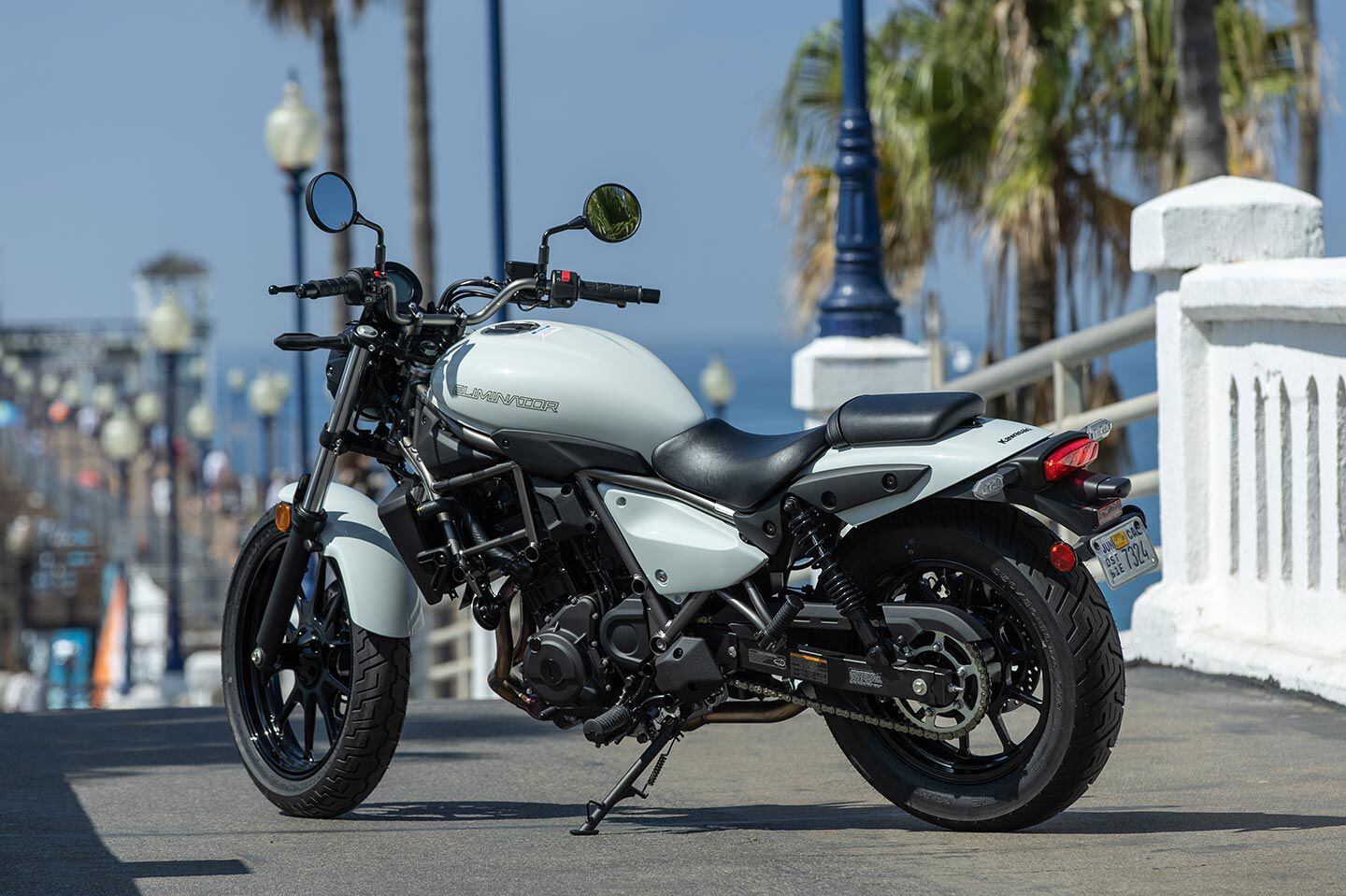
The 2024 Kawasaki Eliminator in Pearl Robotic White. (Kevin Wing/)
Kawasaki’s 2024 Eliminator can be described as a mix between a standard and a cruiser. Derived from the Ninja 400 and Z400 streetbikes, the new Eliminator utilizes the same engine, but with a larger displacement of 451cc. The parallel-twin engine found in the Eliminator has the same bore (70.0mm) as its sporty siblings, but with a 6.8mm larger stroke (58.6mm) for increased low-end torque. Its steel trellis frame is inspired by the Ninja 400 platform but has revisions to achieve a 28.9-inch seat height and a 59.8-inch wheelbase, giving the Eliminator its cruiser stance.
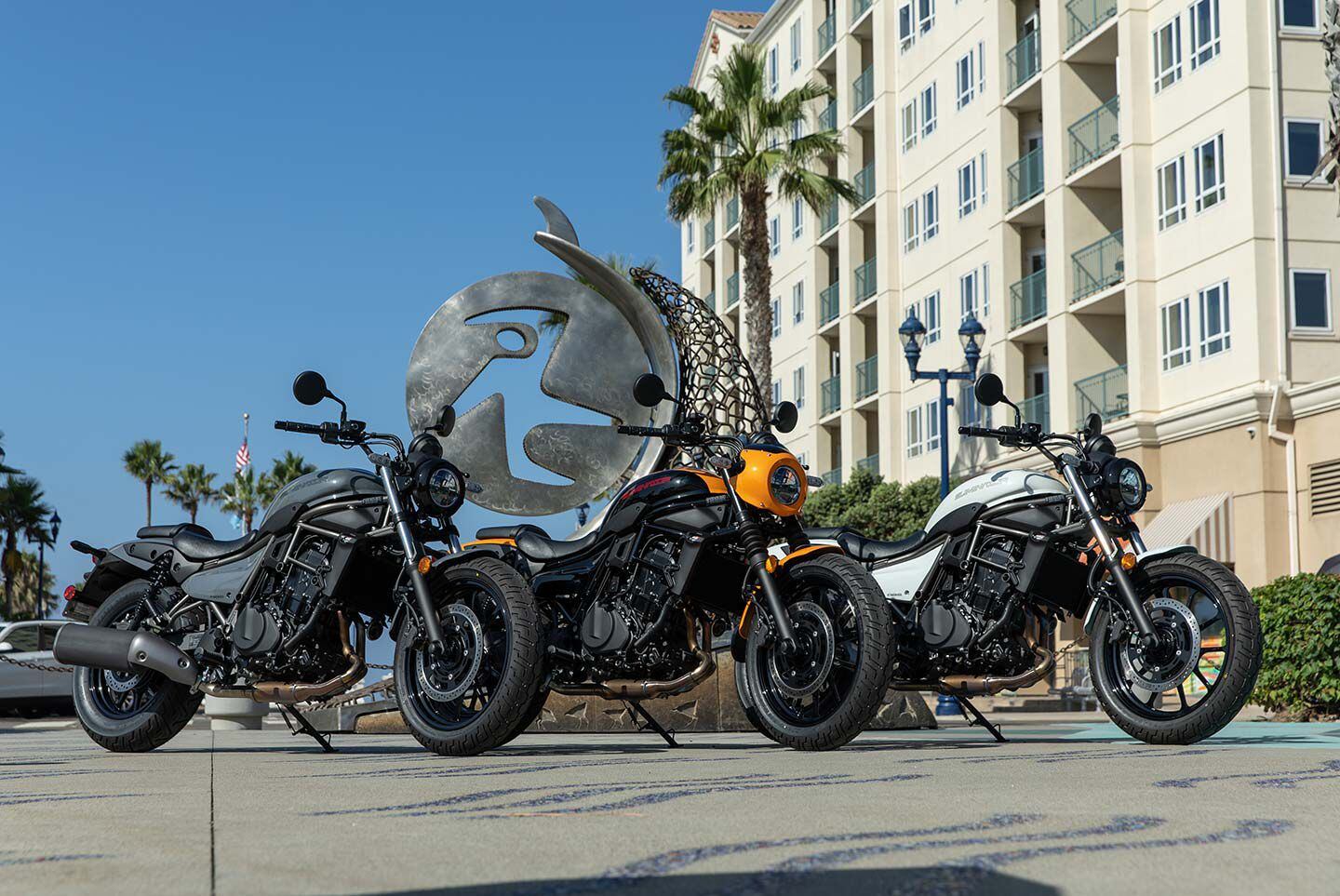
The 2024 Kawasaki Eliminator lineup. (Kevin Wing/)
When the Kawasaki Eliminator was originally introduced in 1985, it was a large-displacement power cruiser—a drag bike. Now, the Eliminator name returns as an entry-level, “easy rider” cruiser.
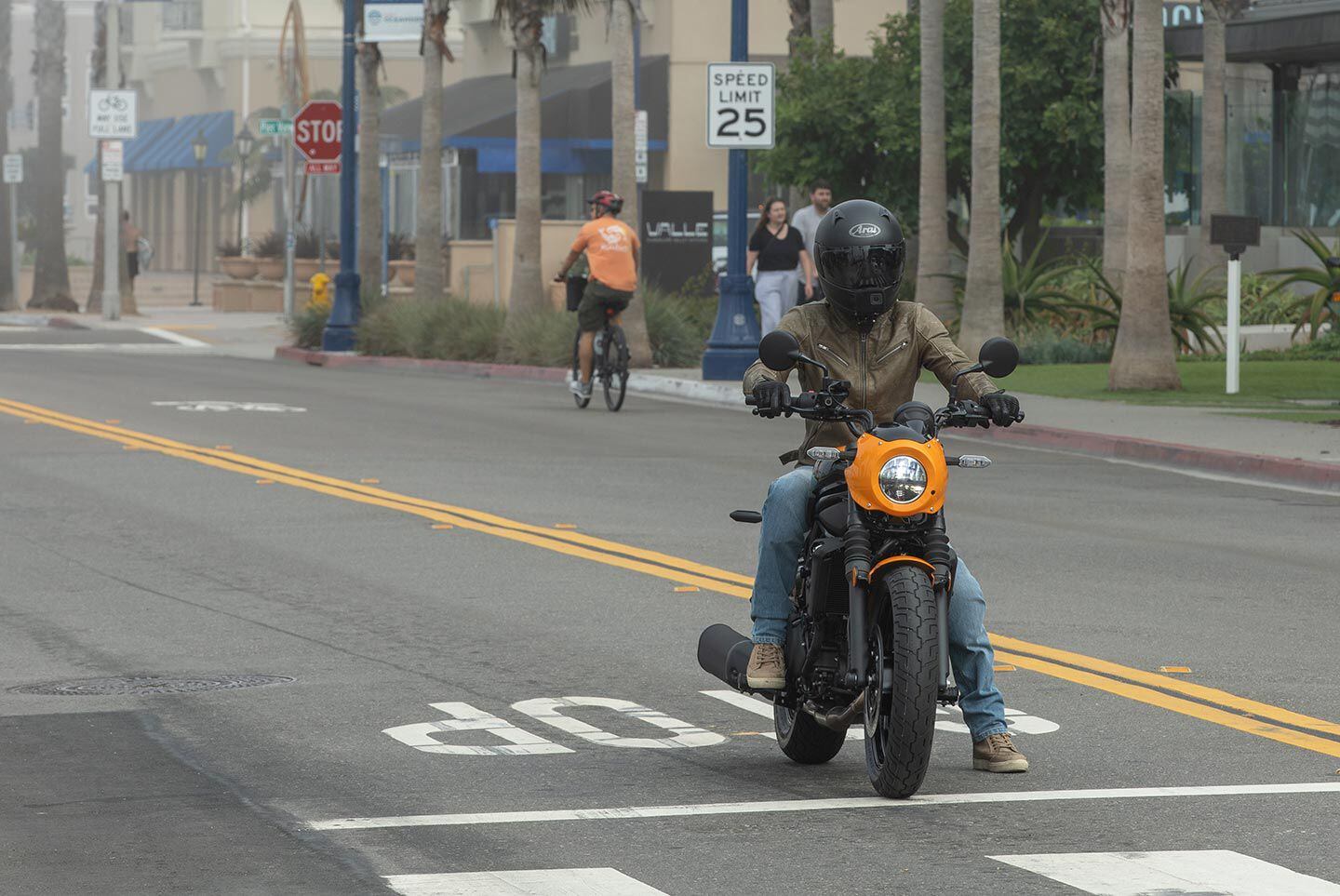
At 28.9 inches, the Eliminator has a lower seat height than the Z125 Pro (31.7-inch seat height). (Kevin Wing/)
“Just Ride.” That’s Kawasaki’s motto with the 2024 Eliminator. Designed with beginner-friendly features such as a manageable engine, low seat height, agile chassis, and a neutral rider triangle, the Eliminator is aimed to be one of the easiest riding motorcycles on the market. Although labeled as “new rider friendly,” it has enough charm to please experienced riders as well.
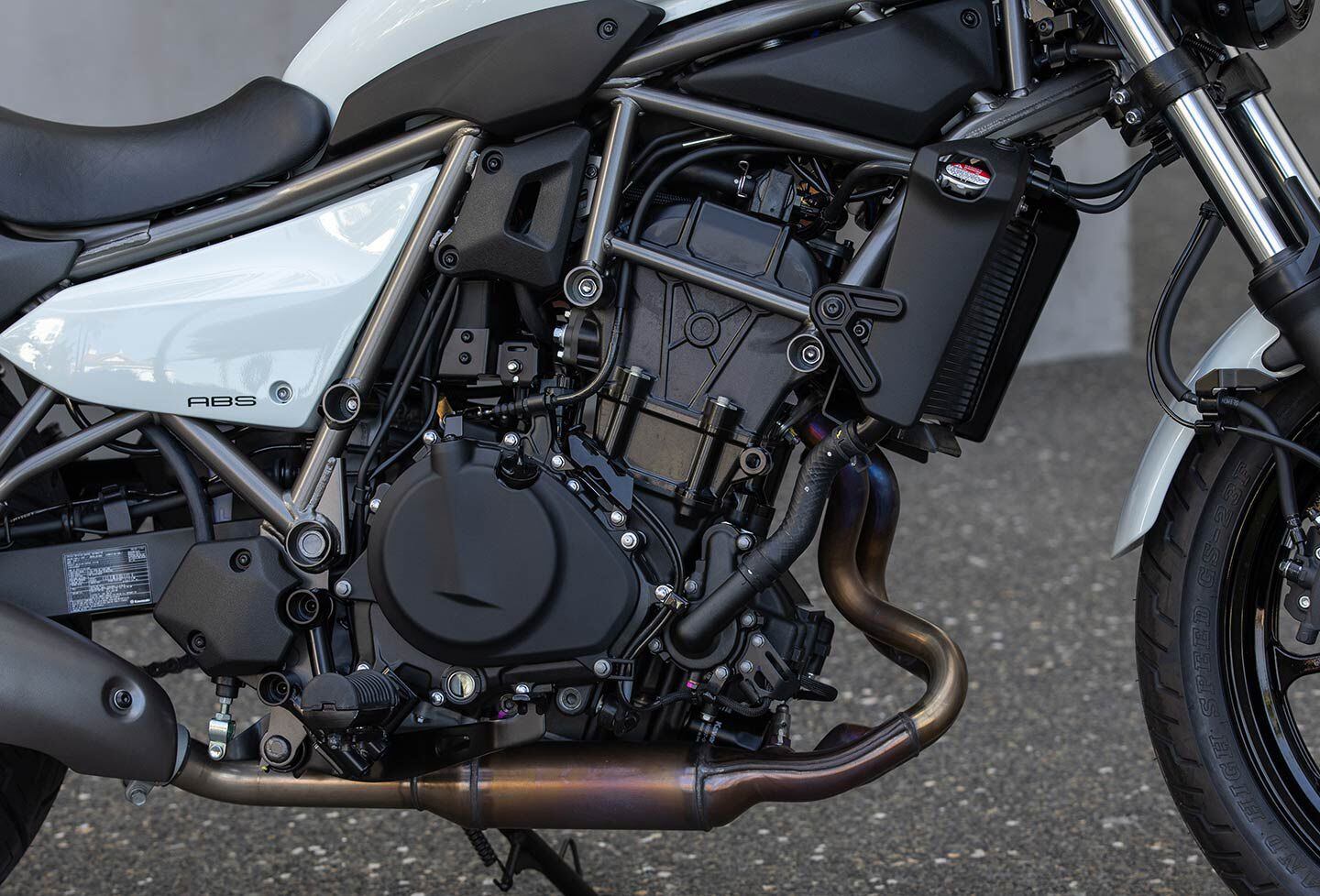
The Eliminator’s 451cc parallel twin is derived from the Ninja 400 and Z400. To achieve a larger displacement over its cousins, the Eliminator received a larger stroke of 58.6mm. (Kevin Wing/)
The 451cc parallel twin utilizes a downdraft intake in a space under the seat to improve cylinder-filling efficiency. Intake funnels on the 5.8L airbox have different heights to tune out torque valleys throughout the rpm range for smooth engine response. A lightweight flywheel enables the engine to rev quickly and the exhaust system is designed for low- to midrange power.
The Eliminator’s six-speed transmission has close gear ratios for optimized power delivery with a final gear ratio of 43/14. Further adding to the Eliminator’s ease of use is an assist and slipper clutch which provides a superlight lever pull and prevents the rear tire from hopping during excessive engine-braking.
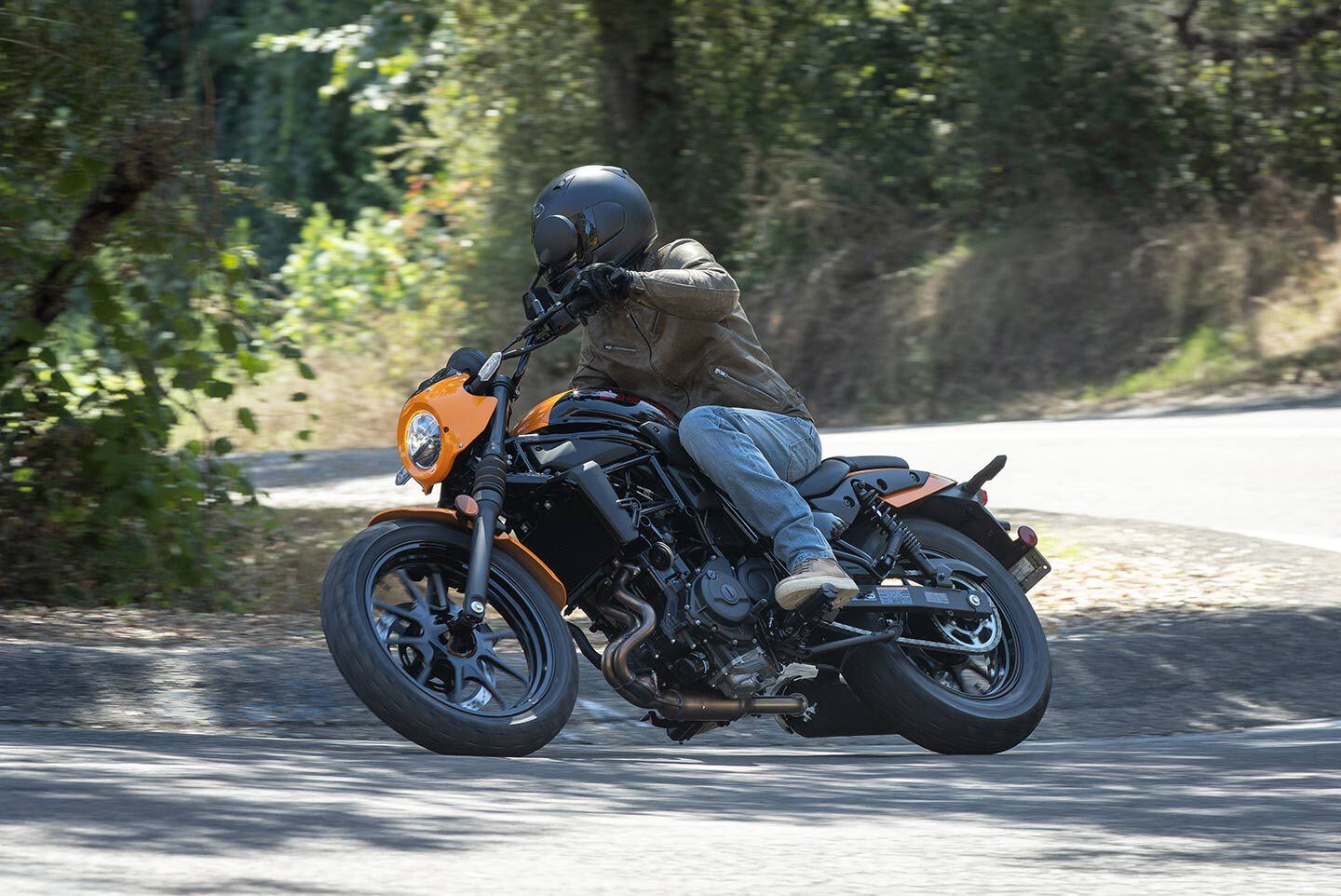
The 41mm fork and dual shocks provided a great balance of performance and comfort. (Kevin Wing/)
In an effort to reduce weight, Kawasaki utilizes the engine as a stressed member. The square-tube-construction swingarm mounts to a die-cast aluminum plate that is bolted to the back of the motor. A nonadjustable 41mm telescopic fork offers 4.7 inches of travel while twin shocks with preload adjustment provide 3.1 inches of travel in the rear. The braking system utilizes a 310mm disc with a dual-piston caliper up front and a 220mm disc and single-piston caliper slows the rear. The 2024 Kawasaki Eliminator is available without ABS for $6,649, with ABS for $6,949, and the upscale SE model is only available with ABS for $7,249.
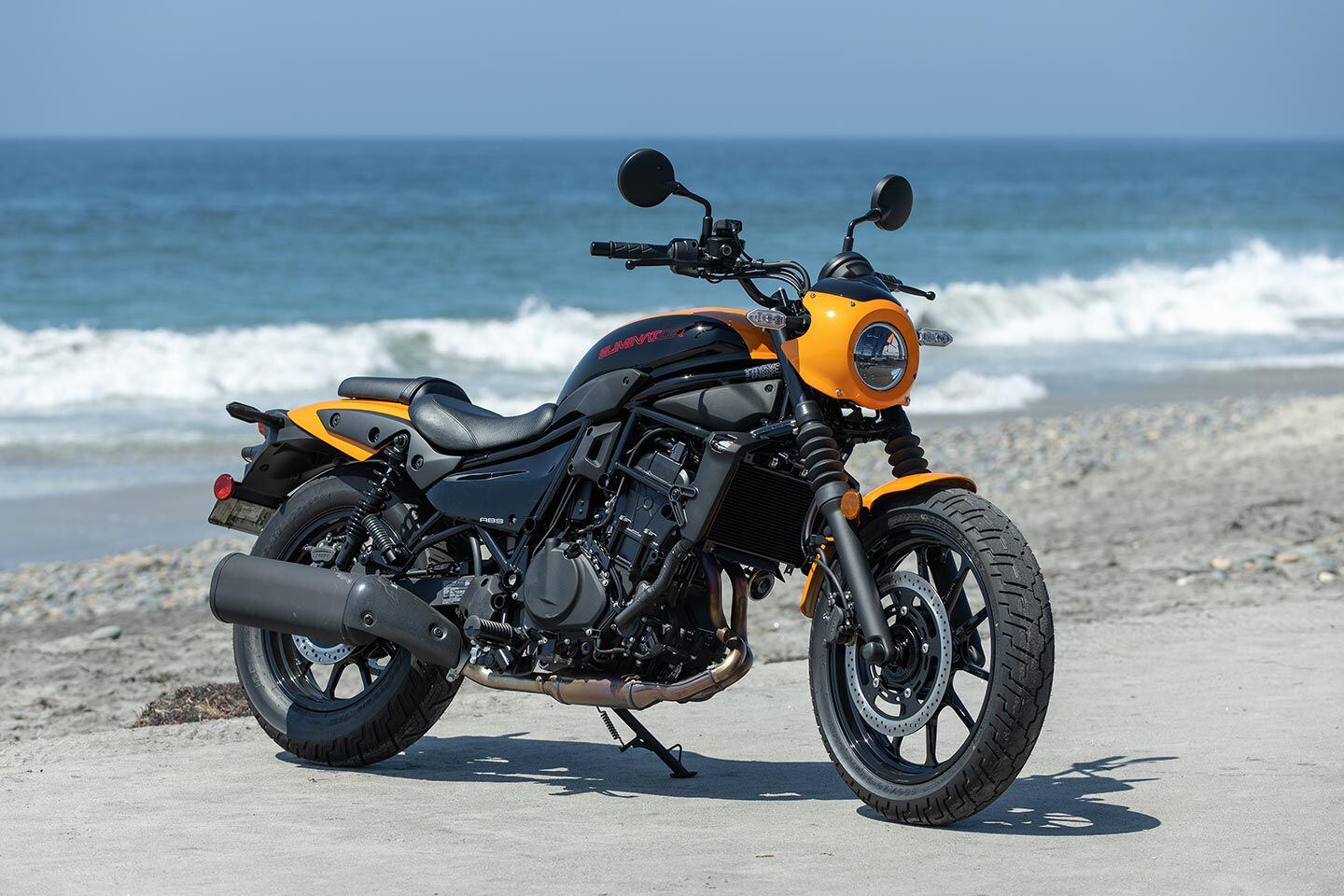
The Kawasaki Eliminator SE ABS in Candy Steel Furnace Orange/Ebony ($7,249). (Kevin Wing/)
Emphasizing the Eliminator’s cruiser looks is a stretched gas tank with a fuel capacity of 3.4 gallons and a pair of 10-spoke wheels. Where the rubber meets the road, the Eliminator features an 18-inch front and 16-inch rear wheel sizes wrapped in IRC Grand High Speed GS-23F tires. Maintaining a strong balance between form and function, the Eliminator features full LED lighting, a digital instrument panel with a gear position indicator, and has Bluetooth connectivity through the Kawasaki Rideology app which allows riders to check vehicle information, record their routes via GPS, and receive phone notifications.
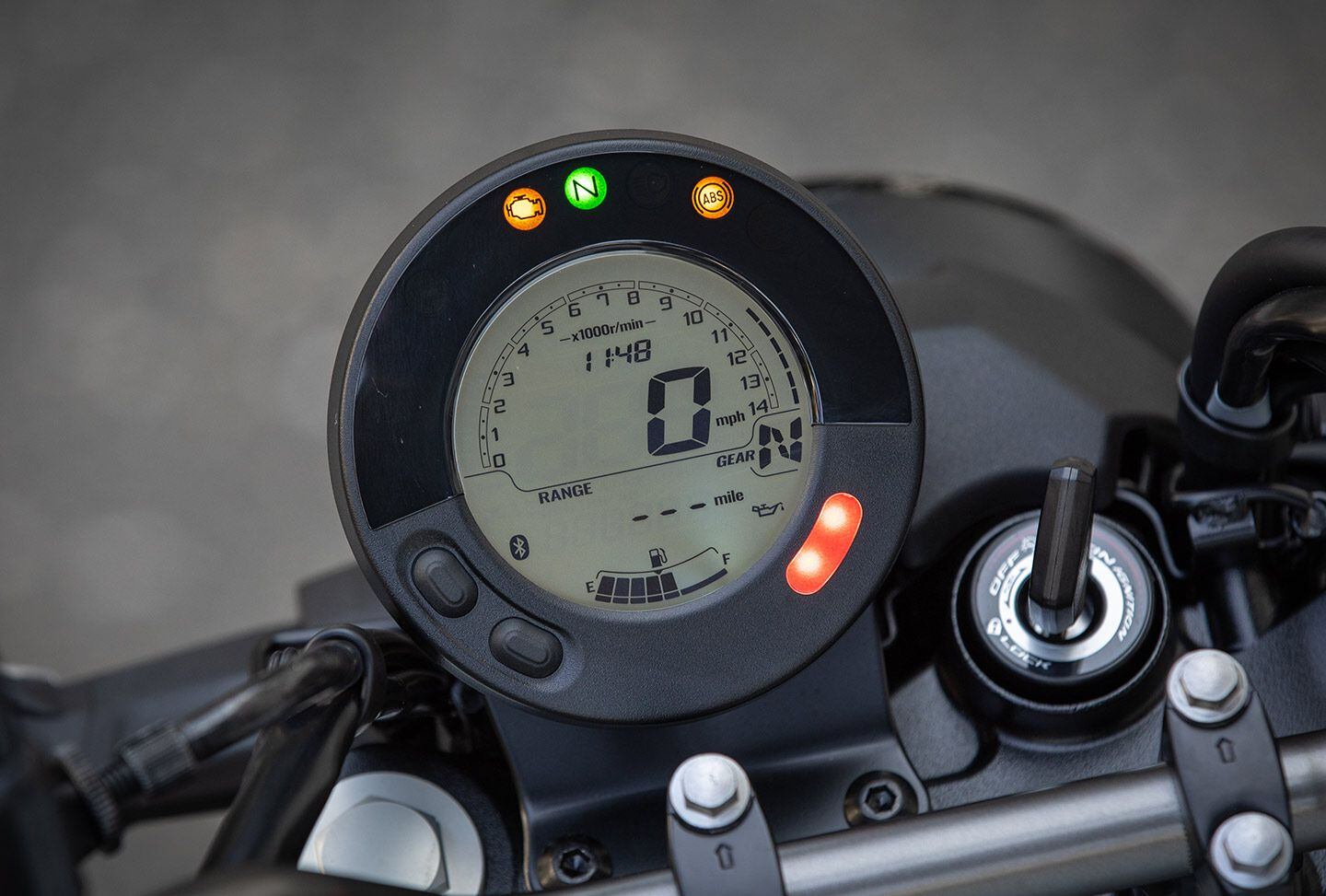
The digital instrument panel provides a gear position indicator, Bluetooth indicator, current and average fuel consumption, maintenance reminders, and smartphone notifications along with all the other standard information. (Kevin Wing/)
Swinging a leg over the Kawasaki Eliminator for the first time, what’s instantly apparent is just how manageable this motorcycle is. The 28.9-inch seat height gives confidence knowing it is easy to keep the bike upright at a stop, regardless of the surface beneath. With an inseam of 28 inches, I find there are very few motorcycles that allow me to plant both feet flat on the ground. This is one of them. Rolling away from a stop is easy and repeatable with the help of the assist and slipper clutch. The tractable engine ensures the bike won’t get away from the rider but is lively enough to make the ride exciting.
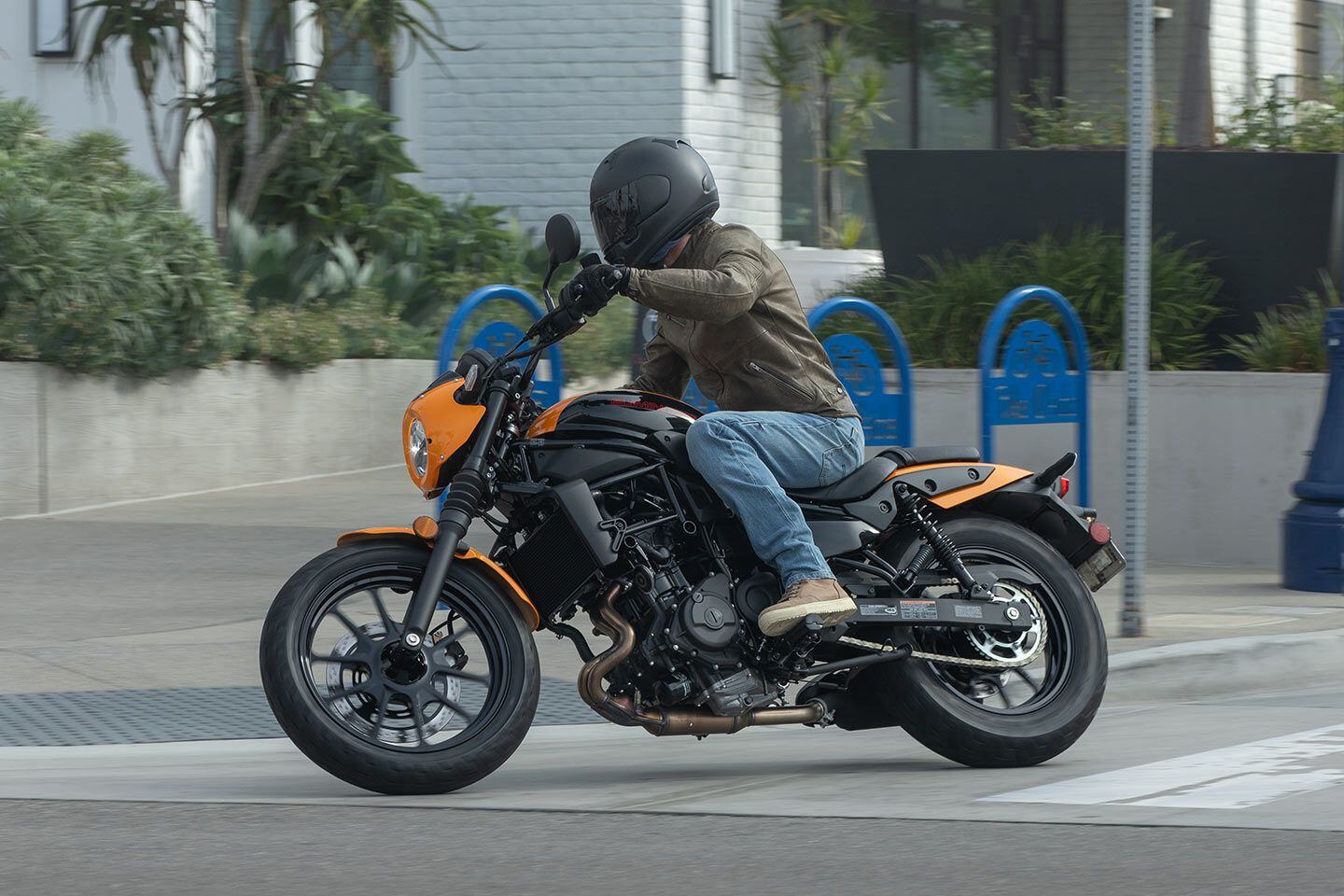
Pulling away from a stop is easy and repeatable with the help of the assist and slipper clutch. (Kevin Wing/)
Cruising down Pacific Coast Highway in Oceanside, California, the low-end power provides enough torque to lug the bike at 3,000 rpm and short-shift it from one light to the next. It can easily pull away from a stop in second gear without abusing the clutch or risk stalling. Plus, the engine can carry fifth gear at 25 mph comfortably. The 451cc parallel twin has just enough chuggability to act like a cruiser around town, but can equally perform in the upper rpm range on backroads and highways like a standard.
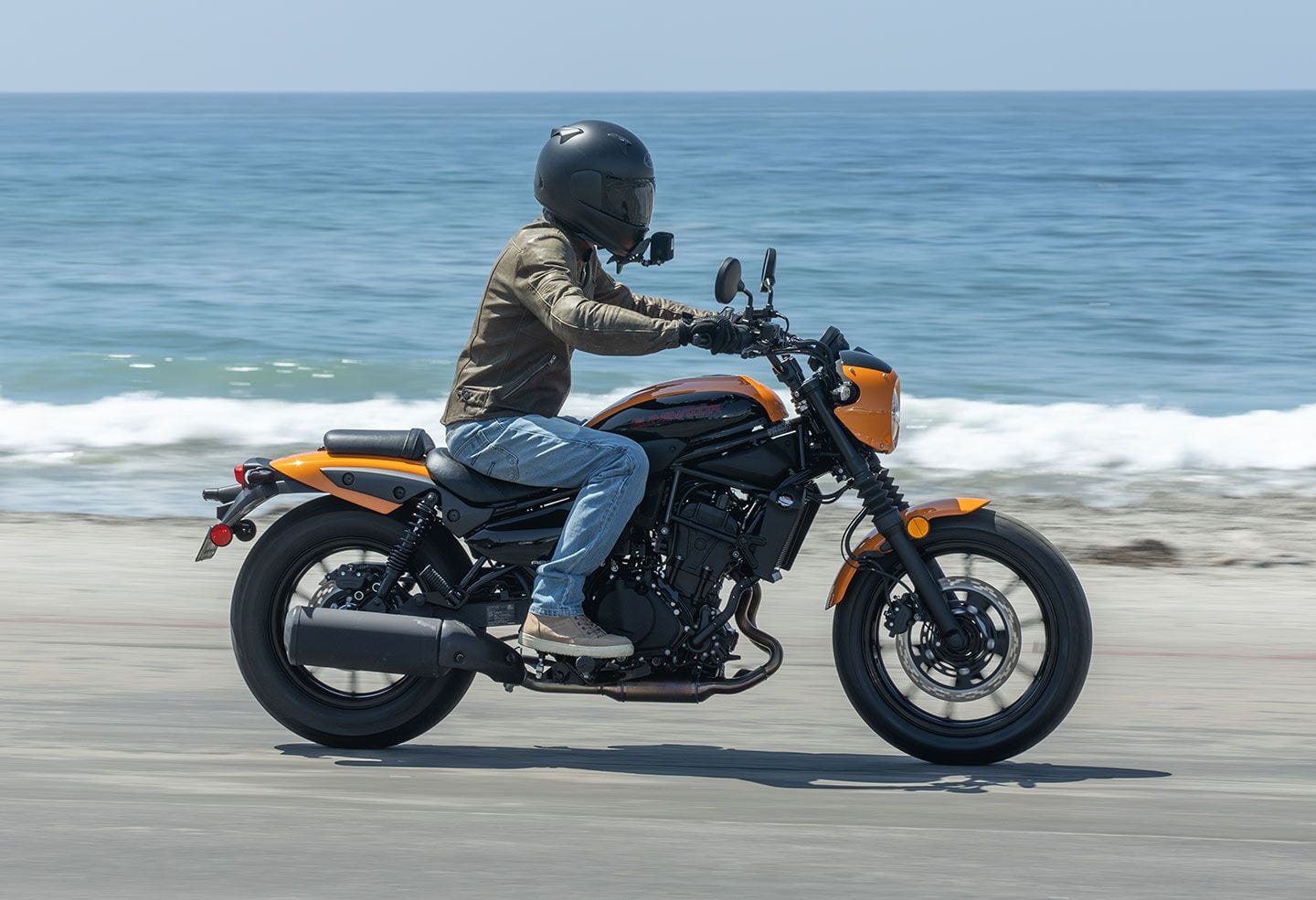
Feeling the ocean breeze on the 2024 Kawasaki Eliminator. (Kevin Wing/)
Power delivery is extremely smooth and predictable. Utilizing throttle-by-wire, the system is precise and intuitive; even the tiniest throttle adjustments are reciprocated at the rear wheel. In the twisties, it’s evident this bike is derived from a Ninja 400. Rev the Eliminator out high into the rpm range and it continues to put the power down. Its quick-revving nature makes the bike sporty and willing to attack corners. Neutral ergonomics further enhance its agile chassis on twisty pavement. But, because of a low stance, ground clearance becomes an issue if the Eliminator is leaned too far over.
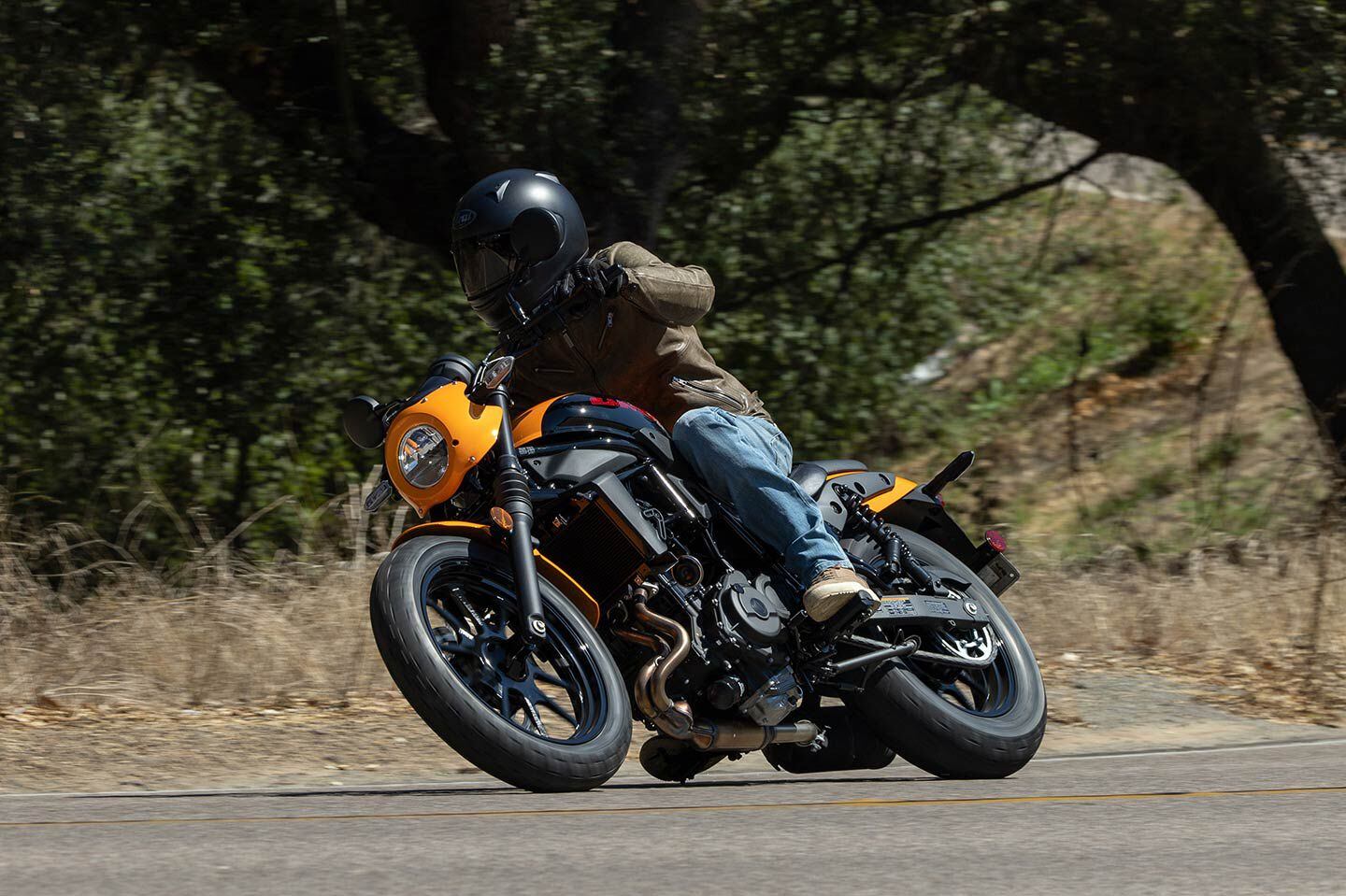
As sporty as the Eliminator is on canyon roads, its low ground clearance can hold it back if ridden too aggressively. (Kevin Wing/)
The Eliminator has a claimed curb weight of 390 pounds (SE ABS model), but feels even lighter in motion. Cutting through traffic or carving up backroads, the 2024 Kawasaki Eliminator requires minimal handlebar input to initiate lean angle and stays planted and controlled on the side of the tire. Suspension is balanced and offers the perfect combination of comfort and performance. At my weight of 125 pounds, the suspension components managed to absorb the bumps and holes on the road while still providing plenty of holdup on fast corners or under hard braking. Of course, a large bump or crater can get the bike unsettled, but let’s remember, this is a cruiser. And not once, despite a few large imperfections on the surfaces traveled, did the twin shocks bottom out.
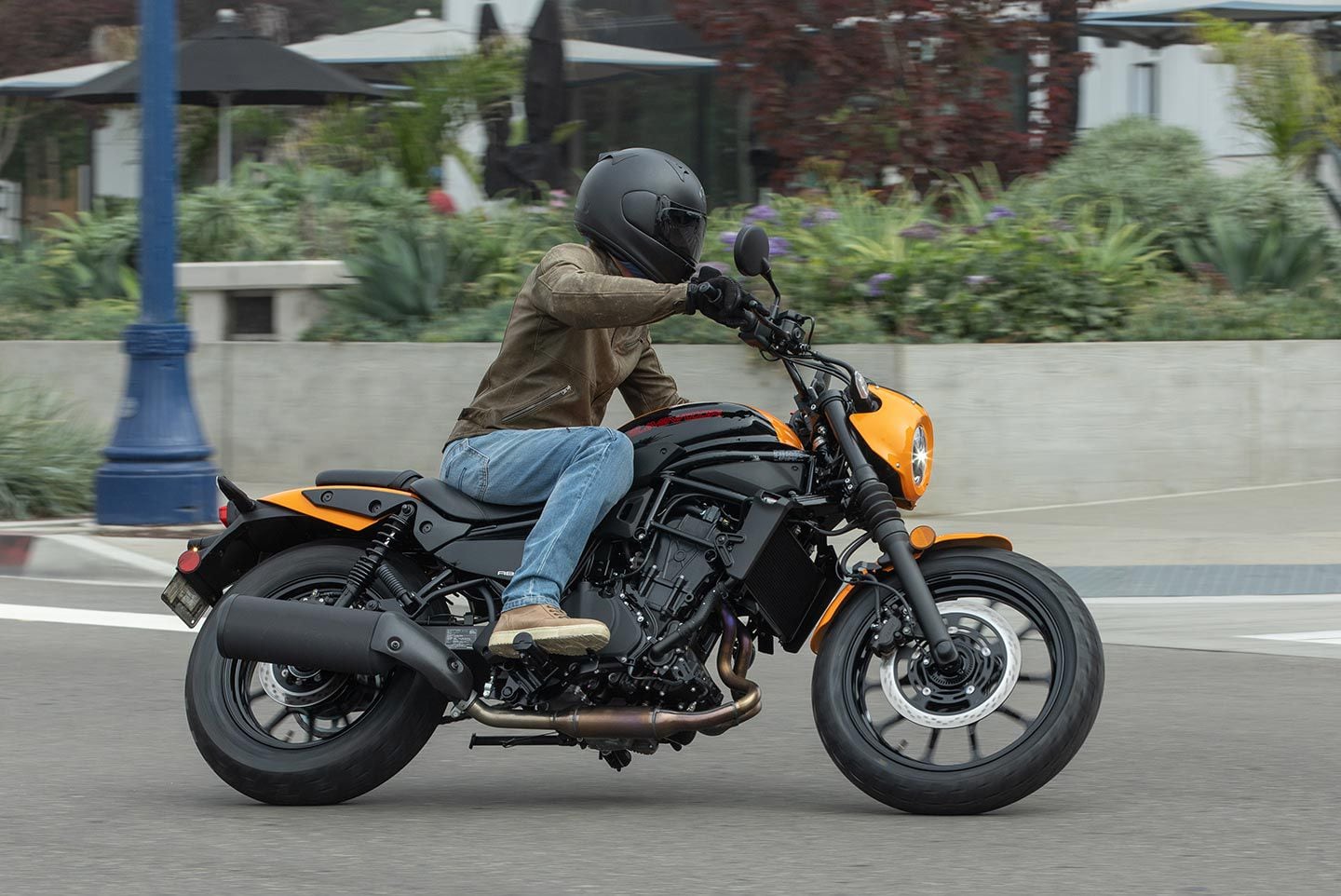
Headed for the hills on the 2024 Kawasaki Eliminator SE. (Kevin Wing/)
Hopping back and forth from urban landscapes to winding backroads, the Kawasaki Eliminator’s performance remains constant. The only component that shows any weakness in the twisties is the front brake. Getting a little too ambitious on the binders coming into corners reminds you that this is a cruiser. Leave plenty of space to slow down and flow from corner to corner; the brakes provided ample stopping distance at slower speeds.
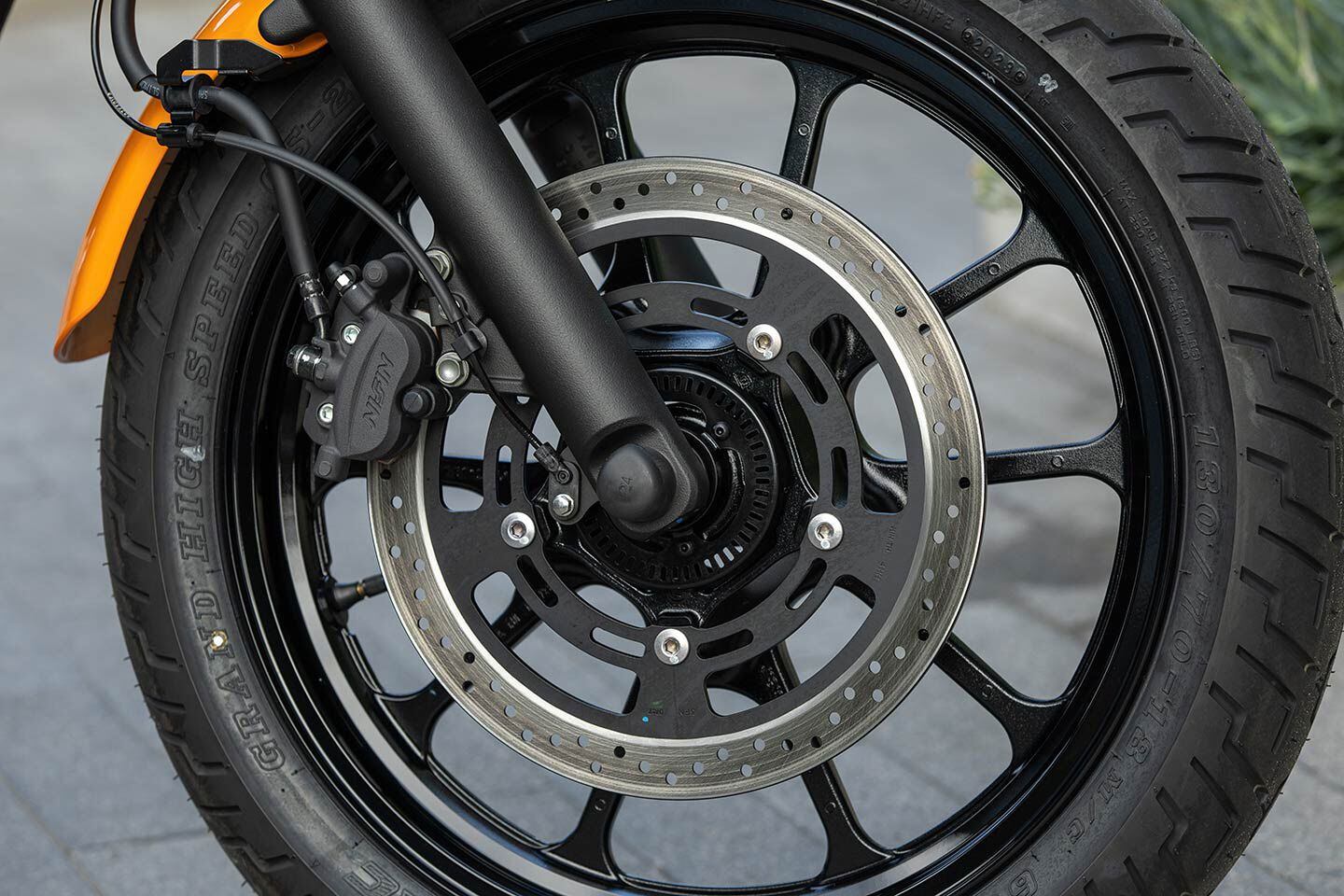
A single 310mm disc and dual-piston caliper handles braking on the front end. The 2024 Kawasaki Eliminator is available with or without ABS in Pearl Robotic White and Pearl Storm Gray. (Kevin Wing/)
Banging gears up and down on backroads was a good test of the six-speed transmission. The gearbox is exceptional. A very short throw enhances the riding experience when shifting up or down, and the Eliminator seamlessly goes from one gear to the next without any stickiness or resistance. The Kawasaki Eliminator’s transmission features an easy neutral finder system that does not allow the bike to shift from first to second at a stop. This makes putting the bike in neutral at a stop effortless without fail and is something beginners will adore and experienced riders will appreciate.
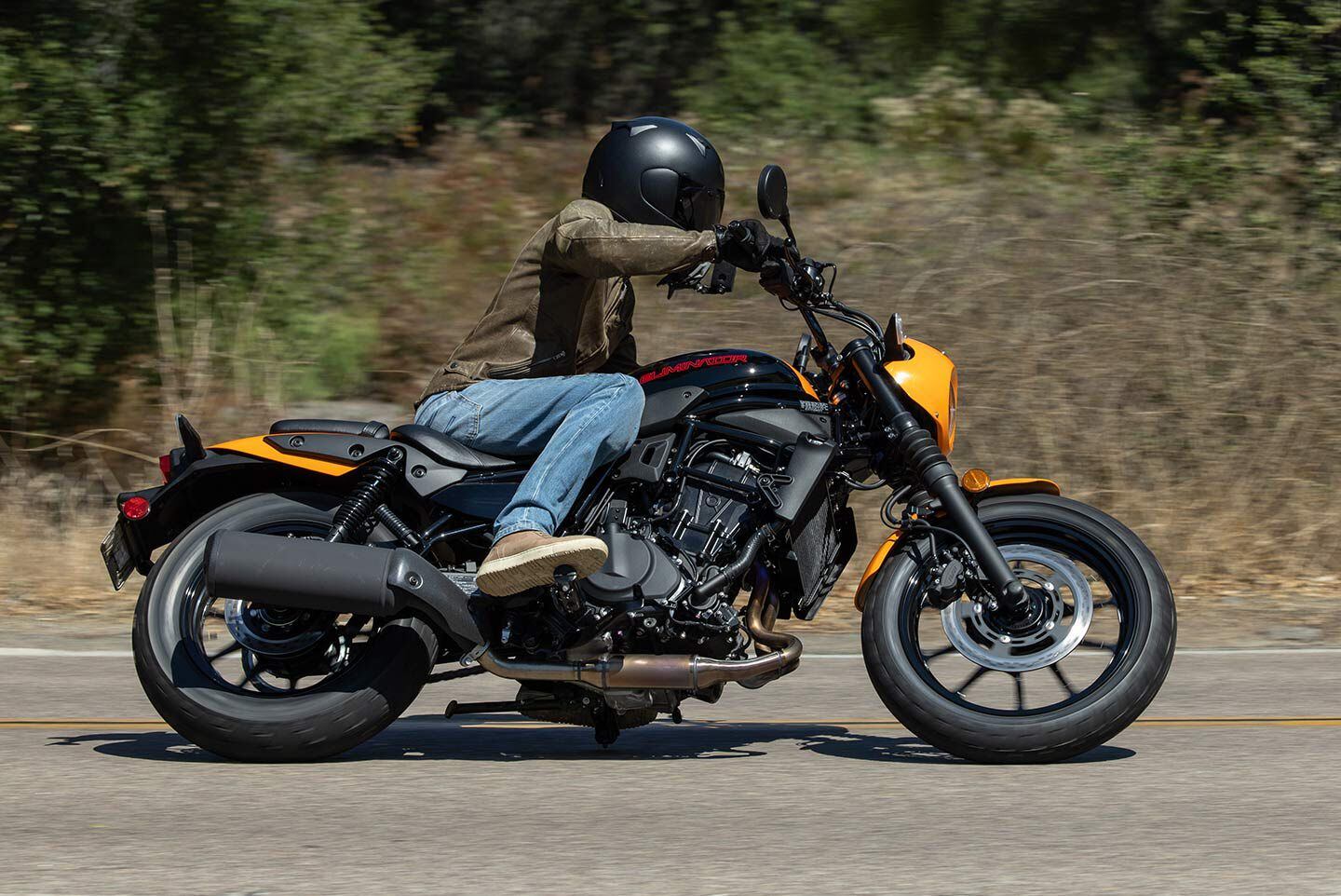
The IRC Grand High Speed GS-23F tires provided excellent grip on the roads traveled. (Kevin Wing/)
Further illustrating the Eliminator is a standard in cruiser clothing, Kawasaki says the rider triangle of its Z400 is nearly identical to that of the Eliminator. The Eliminator has a slightly lower seating position, a higher handlebar, and a similar footpeg location. All these attributes make the 2024 Kawasaki Eliminator comfortable for all-day riding. At 5 feet, 8 inches, I never felt the need to get off the bike and stretch my legs. For those taller or shorter, Kawasaki Genuine Accessories offers two additional seat options: high seat (30.1 inches) and low seat (28.1 inches). Standard seat height is 28.9 inches.
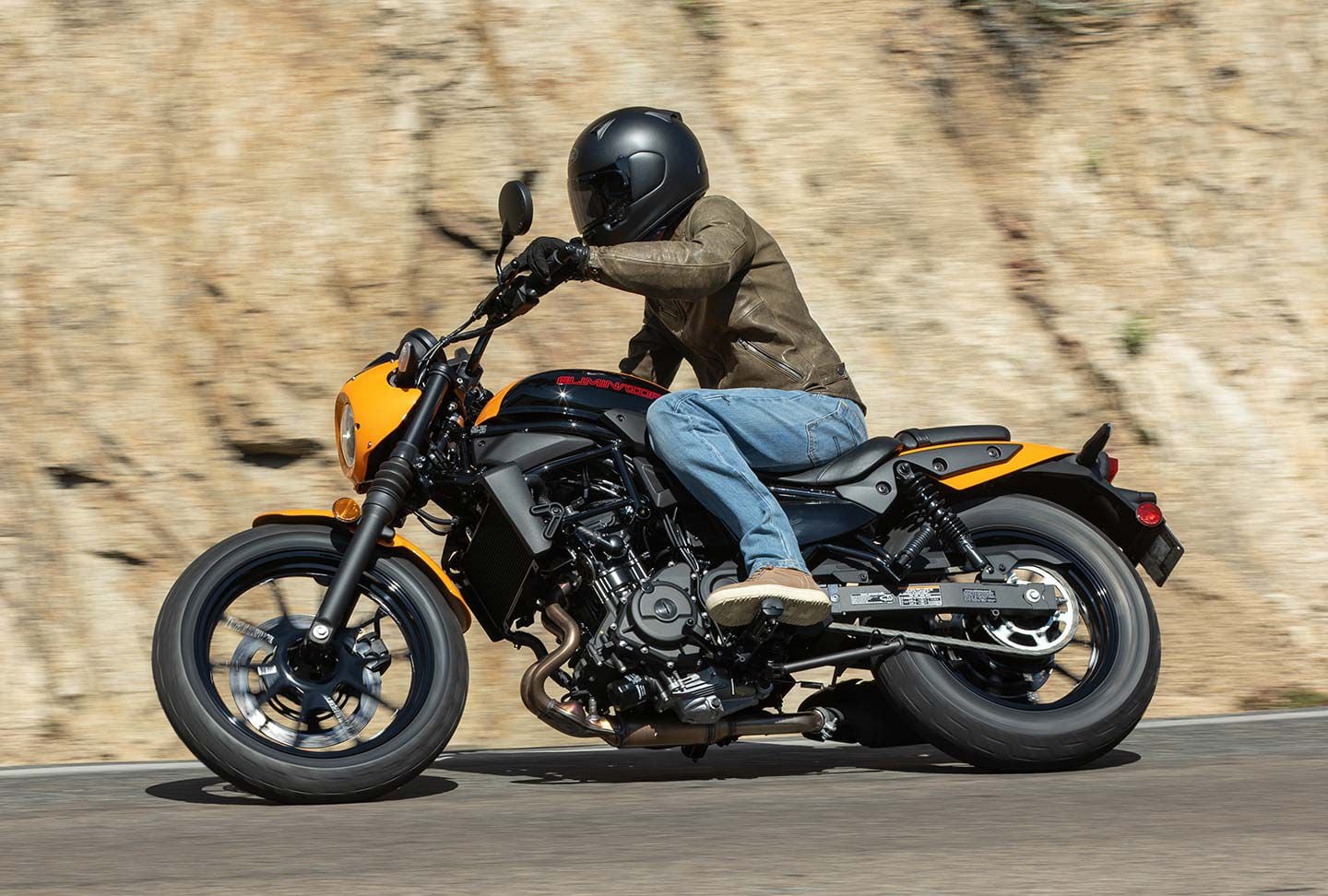
The Eliminator’s neutral riding position pays dividends in the twisties. (Kevin Wing/)
The Kawasaki Eliminator SE builds on the standard Eliminator with Candy Steel Furnace Orange/Ebony two-tone paint, a color-matched headlight cowl, a two-pattern stitched seat, fork boots, and a waterproof USB-C outlet. The 2024 Kawasaki Eliminator SE ($7,249) is only available with ABS.
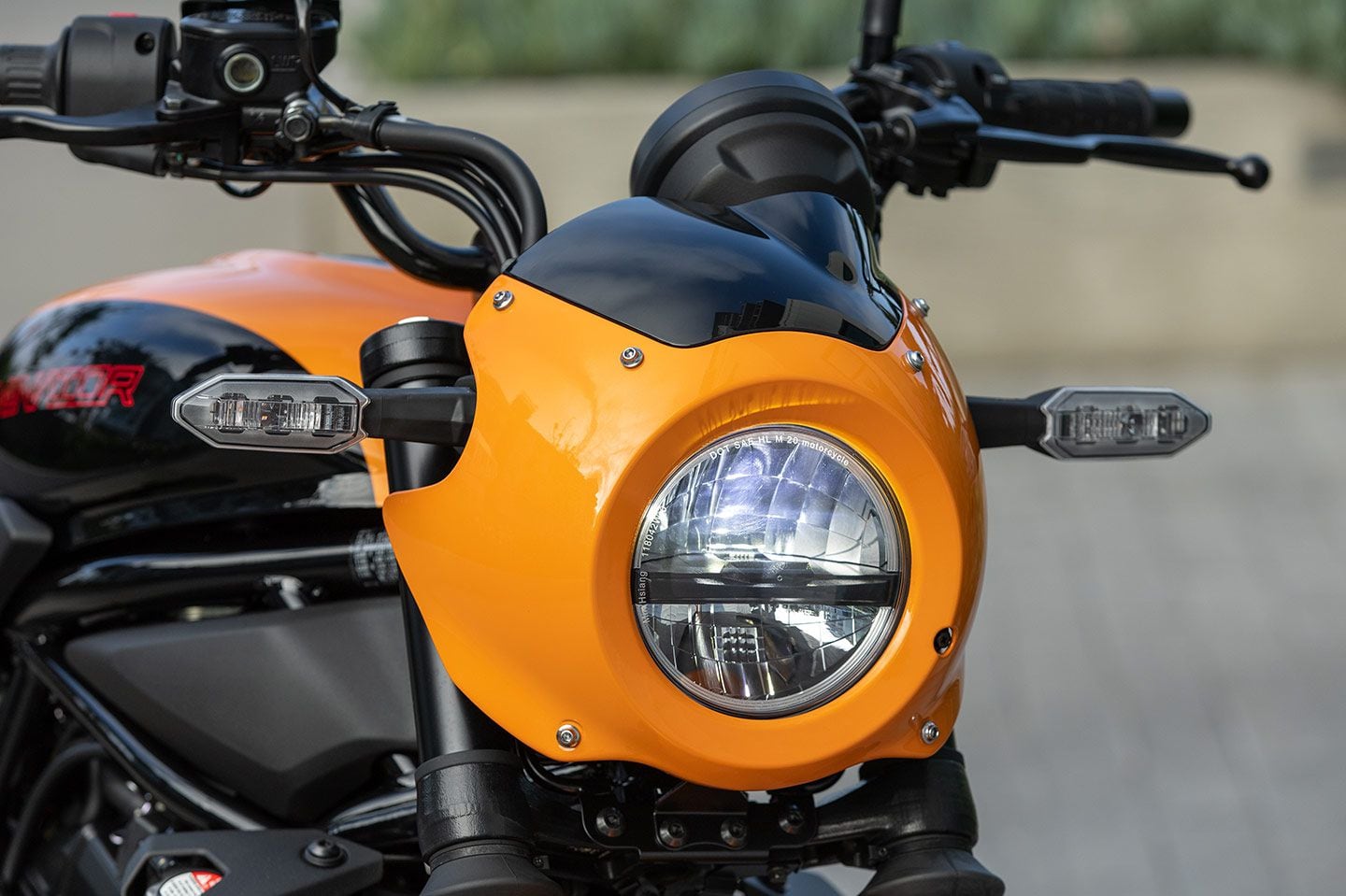
A 130mm LED headlight is fitted on all three Eliminator models. The upscale SE model features a color-matched headlight cowl. (Kevin Wing/)
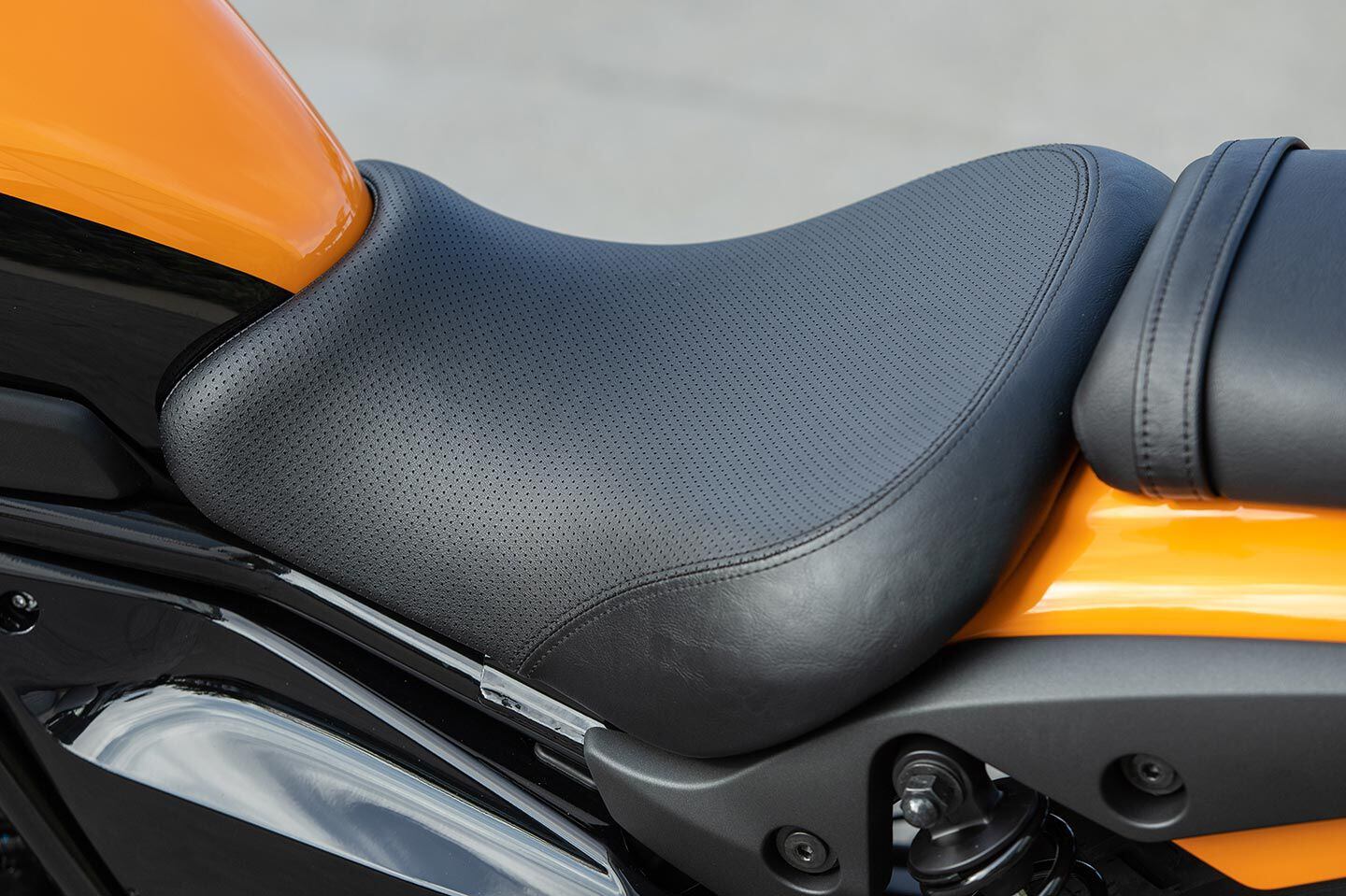
Specific to the Eliminator SE is a two-pattern leather seat with top-edge stitching. (Kevin Wing/)
Kawasaki took its already existing Ninja 400 and Z400 streetbike platform and reworked it for customers wanting cruiser styling while infusing new-rider approachability. As the 2024 Kawasaki Eliminator enters the market, it is sure to compete with models such as the Honda Rebel 500 and Royal Enfield Meteor 350. Its flexible engine, agile chassis, approachable seat height, and accessible price point make the Eliminator a strong contender in the lightweight cruiser class.
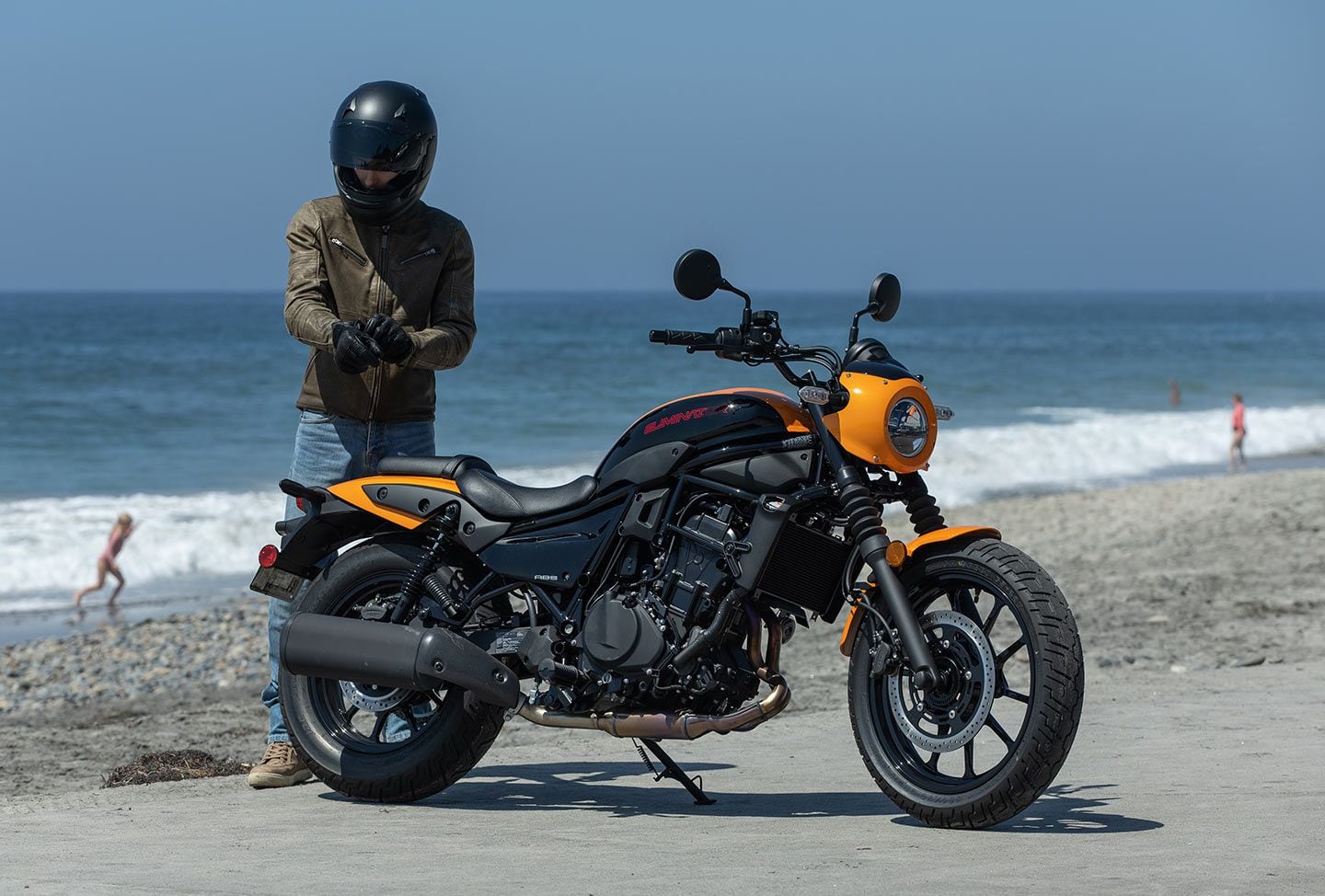
A quick stop to check the waves and we were on our way. (Kevin Wing/)
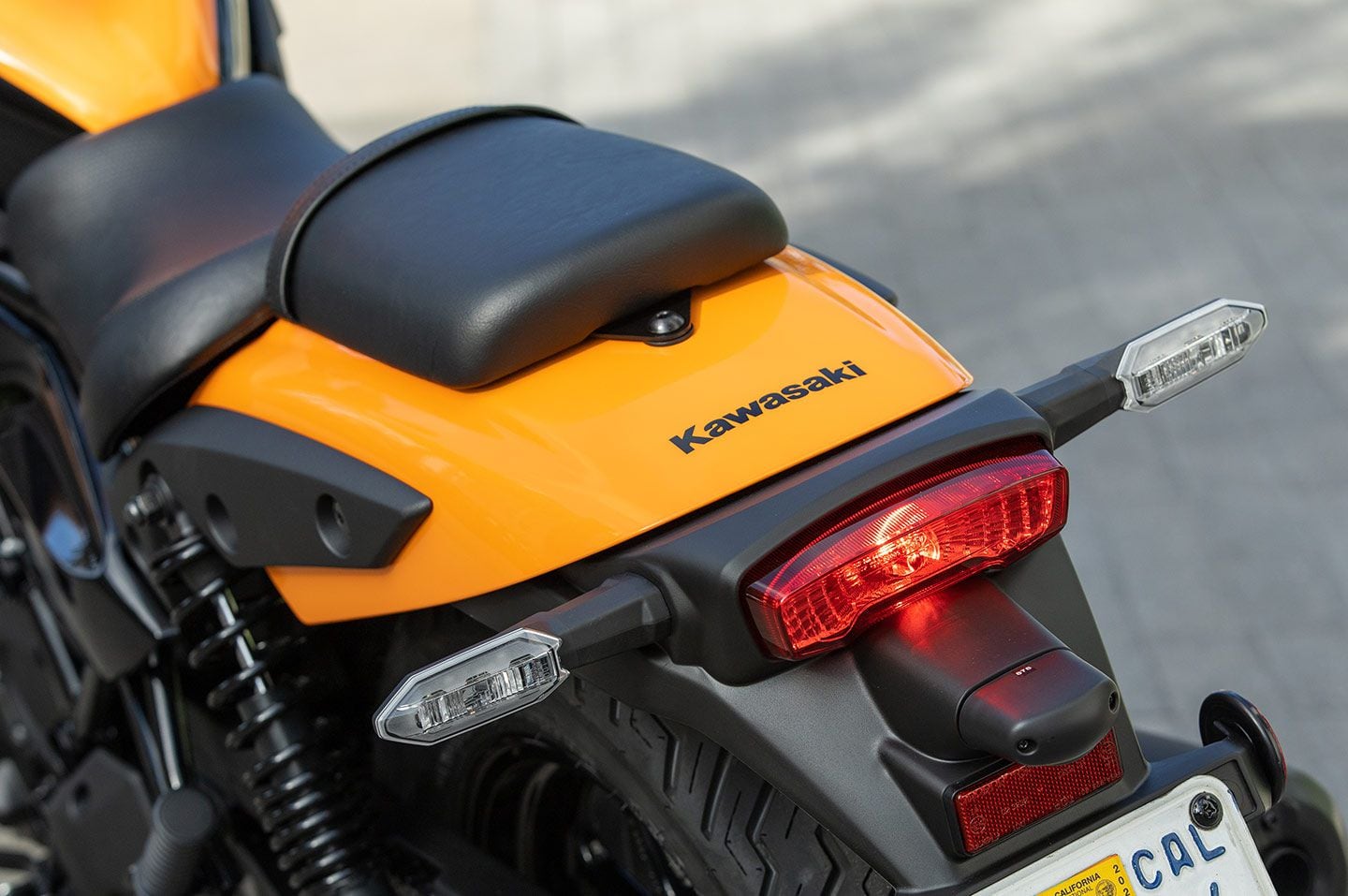
Maintaining the long and low styling of a cruiser, Kawasaki designed the tailsection to pay homage to the Eliminator lineage. (Kevin Wing/)
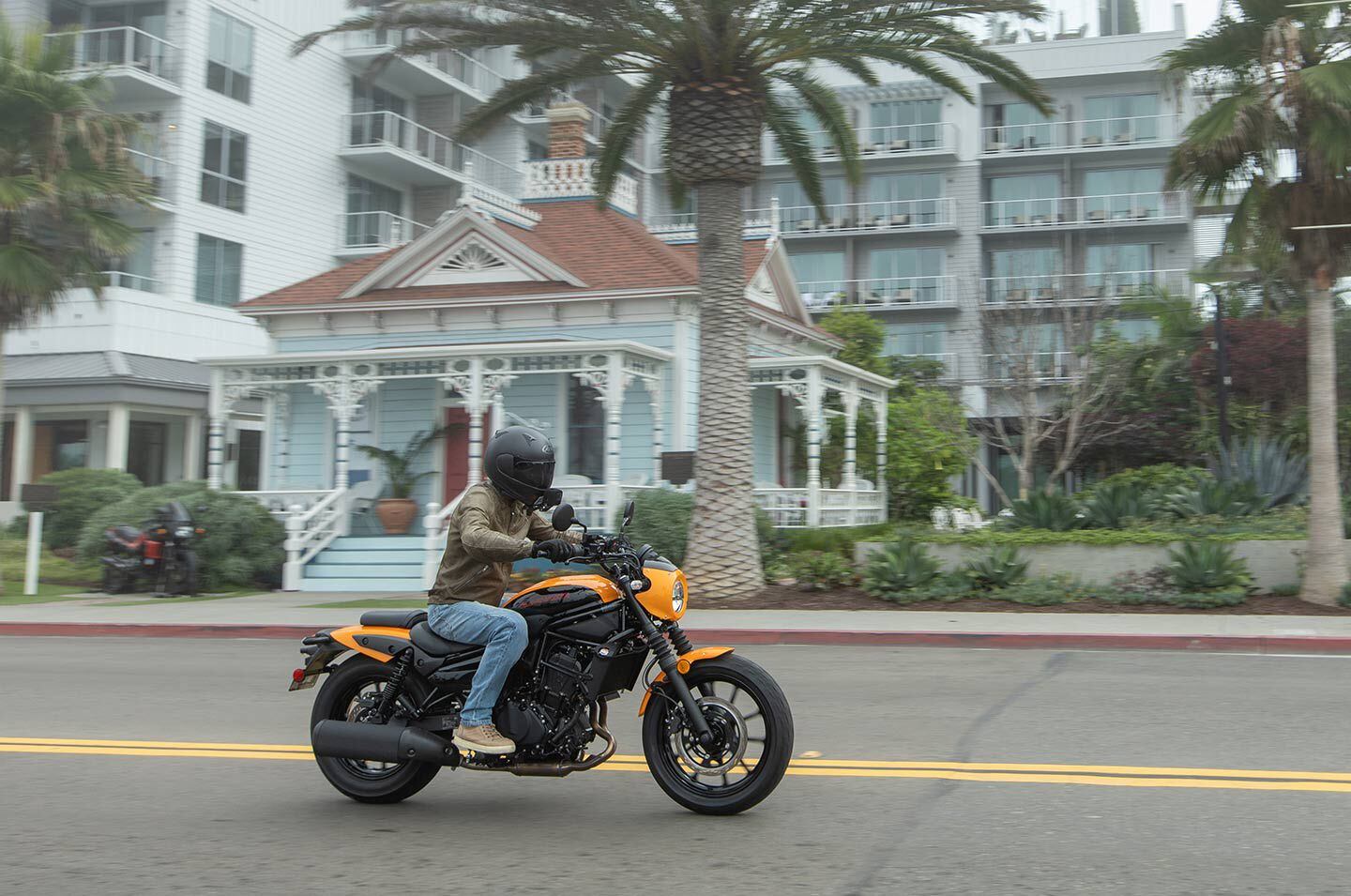
It was fitting to have the 2024 Kawasaki Eliminator launch at the Mission Pacific Hotel in Oceanside, California. In the background you can see an exact replica of Maverick’s Kawasaki ZX900 parked next to the original <i>Top Gun</i> house from the 1986 film. (Kevin Wing/)
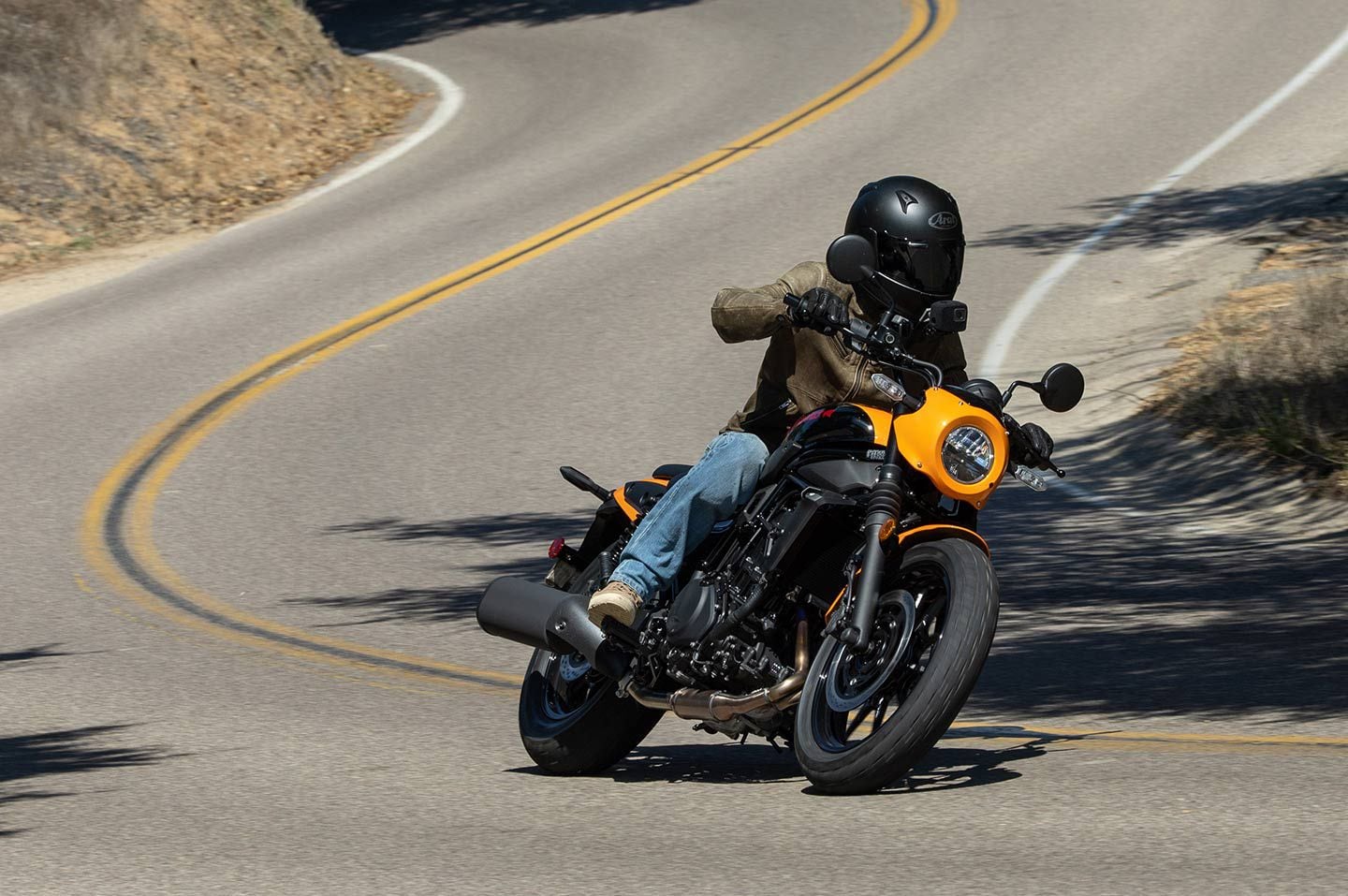
Whether the roads are straight and slow or twisty and fast, the 2024 Kawasaki Eliminator is a blast. (Kevin Wing/)
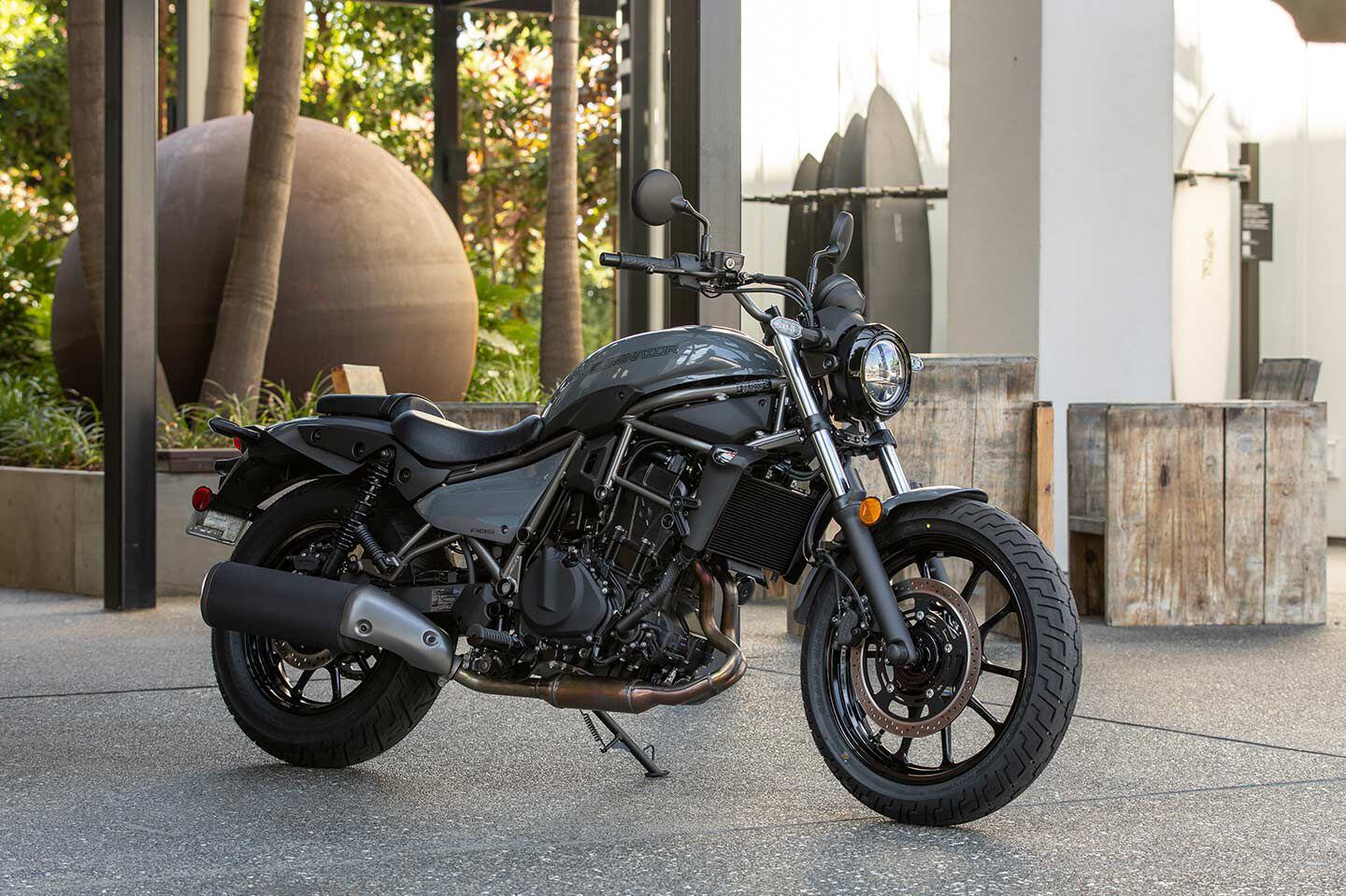
The 2024 Kawasaki Eliminator in Pearl Storm Gray starts at $6,649. (Kevin Wing/)
2024 Kawasaki Eliminator Specs
| MSRP: | $6,649–$7,249 |
|---|---|
| Engine: | DOHC, liquid-cooled, 4-stroke parallel twin |
| Displacement: | 451cc |
| Bore x Stroke: | 70.0 x 58.6mm |
| Compression Ratio: | 11.3:1 |
| Transmission/Final Drive: | 6-speed, return shift/sealed chain |
| Claimed Horsepower: | N/A |
| Claimed Torque: | 31.7 lb.-ft. |
| Fuel System: | DFI w/ 32mm throttle bodies |
| Clutch: | Wet, multiplate slipper/assist |
| Engine Management/Ignition: | TCBI w/ Digital Advance |
| Frame: | Trellis, high-tensile steel |
| Front Suspension: | 41mm telescopic fork; 4.7 in. travel |
| Rear Suspension: | Twin shocks, spring preload adjustable; 3.1 in. travel |
| Front Brake: | 2-piston caliper, 310mm disc (w/ ABS) |
| Rear Brake: | 1-piston caliper, 220mm disc (w/ ABS) |
| Wheels, Front/Rear: | 10-spoke; 18 in./16 in. |
| Tires, Front/Rear: | 130/70-18 / 150/80-16 |
| Rake/Trail: | 30.0°/4.8 in. |
| Wheelbase: | 59.8 in. |
| Ground Clearance: | 5.9 in. |
| Seat Height: | 28.9 in. |
| Fuel Capacity: | 3.4 gal. |
| Claimed Weight: | 386 lb. (non-ABS) / 388 lb. (ABS) / 390 lb (SE ABS) |
| Contact: | kawasaki.com |
Gearbox
Helmet: Arai Regent-X
Jacket: Spidi Garage
Gloves: Spidi Garage
Pants: Spidi J-Tracker Denim Pants
Boots: Rev’It Grand Shoes
]]>The 2023 Rebel 1100T DCT in Bordeaux Red Metallic ($11,299). A windscreen, standard Dual Clutch Transmission (DCT), and hard saddlebags make the 1100T the top of the Rebel food chain. (Honda/)
Ups
- Hard bags and a windscreen add comfort, versatility, and style
- Adjustable power delivery, traction control, and engine-braking enable riders to tailor performance to their preference. And there’s a lot of performance to be had!
- Relatively light weight and affordable price tag make it an anomaly in the bagger category
Downs
- Only available with automatic DCT transmission
- Cramped rider triangle
- 35 liters of luggage capacity is tiny
Verdict
The bagger-style Honda Rebel 1100T DCT fills out Honda’s Rebel lineup, adding style and versatility to an already great platform. Thanks to a lightweight design and affordable price tag, the bike opens up the bagger world to a larger segment of riders.
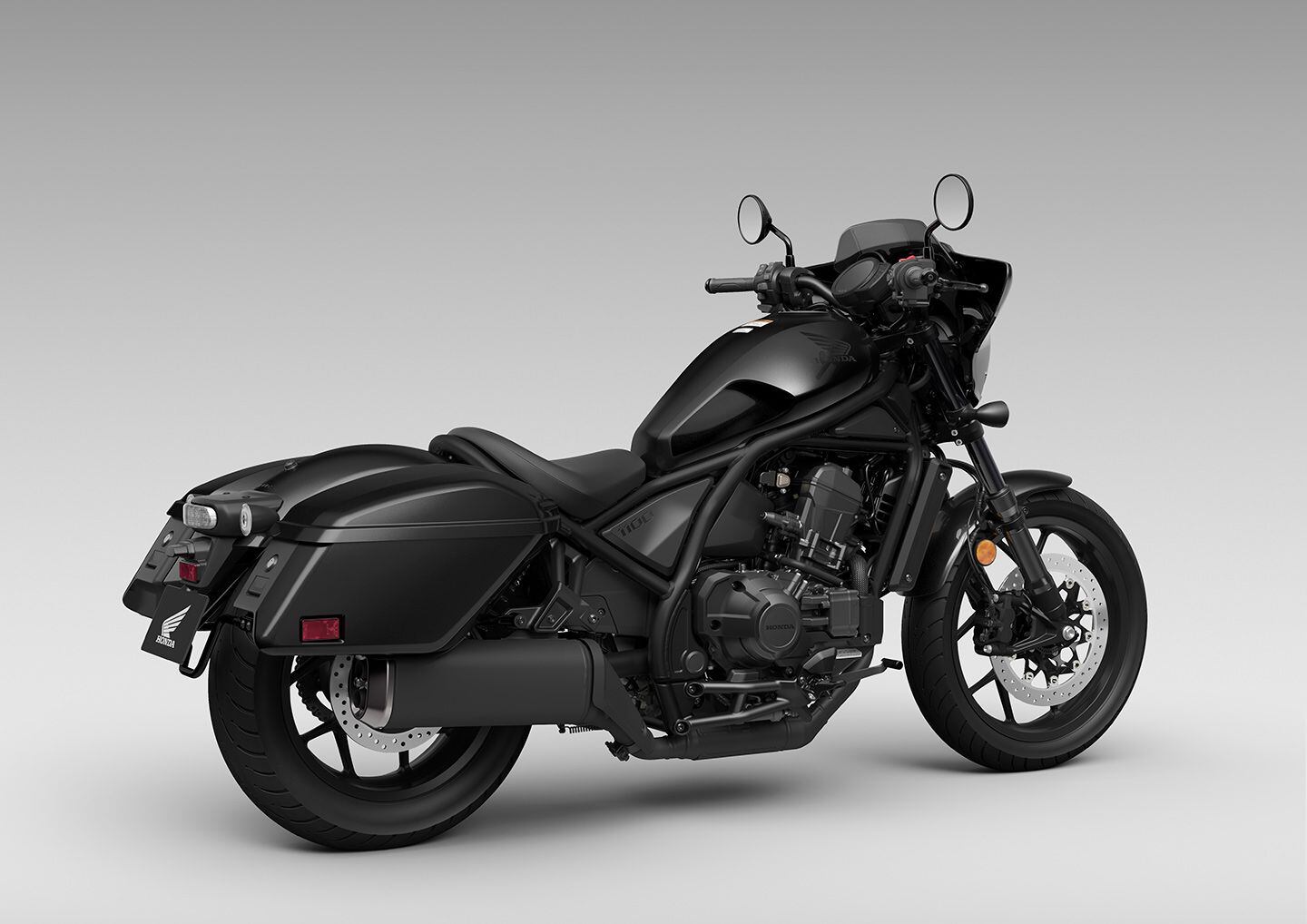
Honda Rebel 1100T DCT in Metallic Black. Notice all of the blacked-out components Honda has incorporated into the design. (Honda/)
Overview
If the Rebel 1100 is the reinvention of the metric cruiser, then the Rebel 1100T DCT is the reinterpretation of the bagger. While most baggers weigh in excess of 800 pounds and cost north of $20,000—often way north—the 1100T weighs a claimed 524 pounds and costs $11,299.
The 1100T DCT differentiates itself from the Rebel 1100 DCT with hard saddlebags and a fairing/windscreen. And that’s about it. It’s a pretty no-frills model for a category that often has from-the-factory “custom” paint and integrated speakers in the saddlebags. But that’s part of the Rebel T’s appeal. For decades, many of the Big Four’s cruiser offerings were chromed-out imitations of America’s highest-selling motorcycles. Often, they were reliable, finely engineered machines catering to a certain segment of the market that didn’t care—or at least claimed they didn’t care—what badge was on the tank. For many of today’s consumers, however, perceived authenticity is a firmly held value, and a “Harley clone,” no matter how well-made, is anything but authentic.
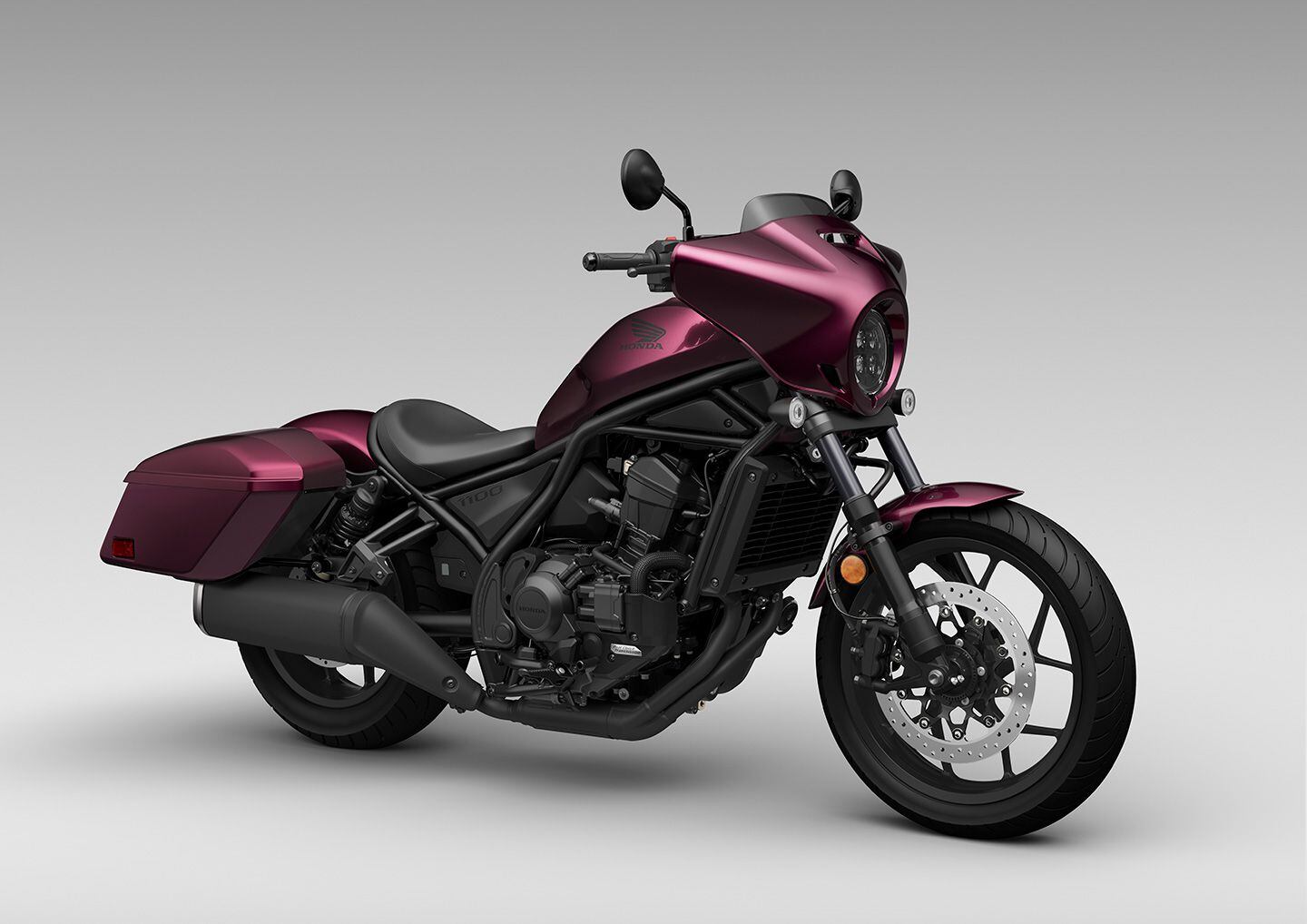
Color-matched fairing and saddlebags add to the overall look. (Honda/)
Honda’s revamped Rebel lineup and the Rebel 1100T DCT take a different approach. Rather than imitate some other brand’s schtick, Honda gave the 1100T its own identity, right down to the parallel-twin engine derived from the company’s Africa Twin adventure bike.
While the 59.8-inch wheelbase, 28-degree-raked front-end, and mid-controls immediately announce “cruiser,” Honda’s DNA shines through; the1100T has electronic rider aids, ABS, a sweet-handling chassis, and an automatic transmission.
Think of the Rebel 1100T DCT as an affordable alternative to a Harley or Indian, but the keyword here is alternative. It offers its own unique take on what a bagger can be. For some, that makes it authentically, proudly subversive. To others, it’s just a good motorcycle at a good price. No matter how you look at it, it’s a whole lot more accessible than big V-twin baggers.
Updates for 2023
The Rebel 1100T DCT was a new addition to Honda’s lineup for 2023. It’s available in Metallic Black or Bordeaux Red Metallic.
Pricing and Variants
The Rebel 1100T DCT is available for $11,299. For comparison, the standard Honda Rebel 1100 is available for $9,499, while the DCT-equipped version is $10,099.
Competition
The Rebel 1100T DCT is sort of in a class of its own. While the standard Rebel models compete with the Harley-Davidson Nightster ($13,499) and the Indian Scout Rogue ($12,749), neither of those models come in bagger variations. Mind you, both of those bikes are an accessory windscreen and saddlebags away from similar functionality.
The Harley-Davidson and Indian both have modern V-twin engines and more true-to-type—though still forward-looking—cruiser styling. The Rebel’s parallel-twin engine and trellis frame help it step out of the shadow of Harley and Indian, allowing it to wear its Honda wing badge with pride. Of the three, the Rebel 1100T is the only one that includes an automatic transmission.
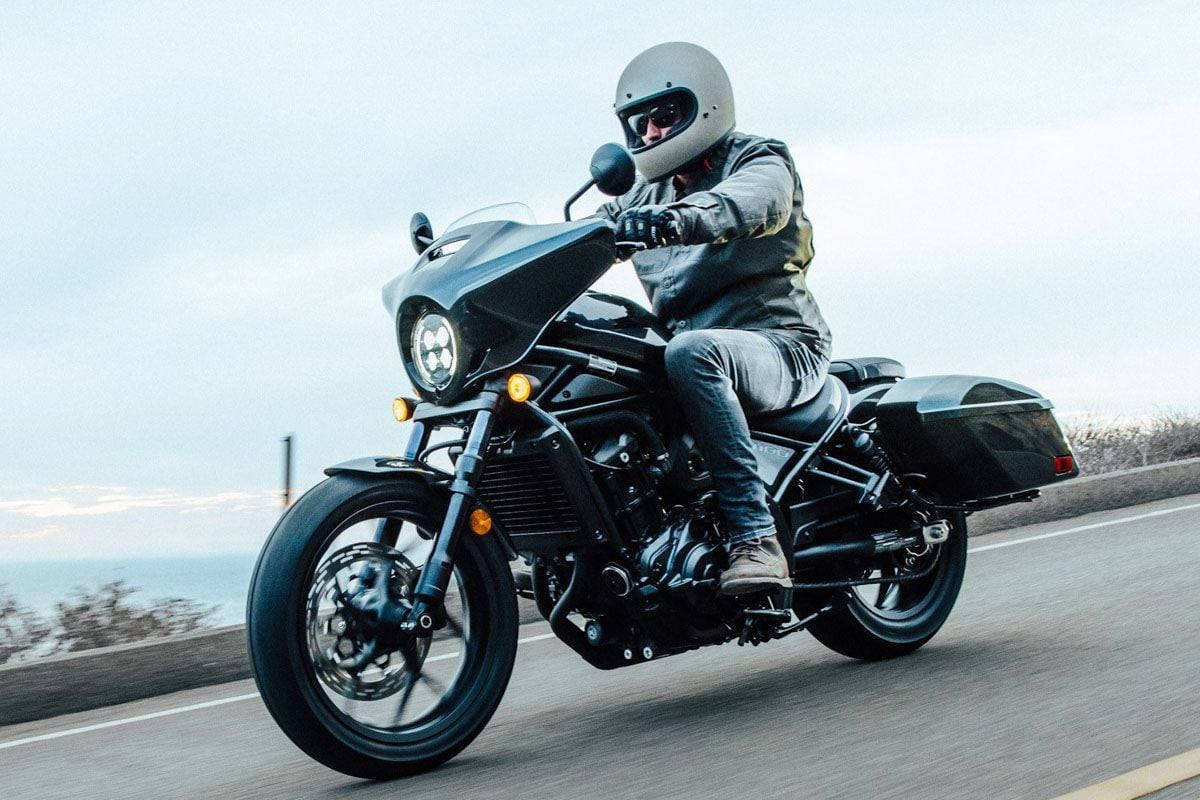
Tweaked and modified to suit the cruiser vibe, the Rebel’s engine has unique engine mapping, a 20 percent larger flywheel for increased inertia, and revised camshaft profiles that give what Honda calls “power pulses,” as though to further mimic the feel of a V-twin. (Honda/)
Powertrain: Engine, Transmission, and Performance
The Rebel 1100T is powered by a liquid-cooled 1,083cc Unicam parallel twin derived from the Honda Africa Twin. Tweaked and modified to suit the cruiser vibe, the Rebel’s engine has unique engine mapping, a 20 percent larger flywheel for increased inertia, and revised camshaft profiles that give what Honda calls “power pulses,” as though to mimic the feel of a V-twin. On the Cycle World dyno, the standard Rebel 1100 produced 81 hp at 7,000 rpm and 67.9 lb.-ft. of torque at 5,000 rpm.
Power delivery is smooth and strong and the engine is well balanced. But even with that flywheel it doesn’t have the classic cruiser pulse. Or, for that matter, an exhaust note that makes you want to blip the throttle at a red light. Three programmed modes alter power delivery, engine-braking, traction control, and shift points. Even with so much technology between the right hand and rear wheel, riding the Rebel is uncomplicated and pure. Twist the throttle and it goes; focus on what’s ahead, not what it takes to get there.
The Rebel 1100T’s automatic Dual Clutch Transmission (DCT) eliminates the clutch lever and the need to manually shift gears. Naturally, it also prevents the possibility of stalling. A manual setting allows the rider to use paddle shifters to take back some control. It’s a nice touch on the Rebel, especially for less experienced riders.
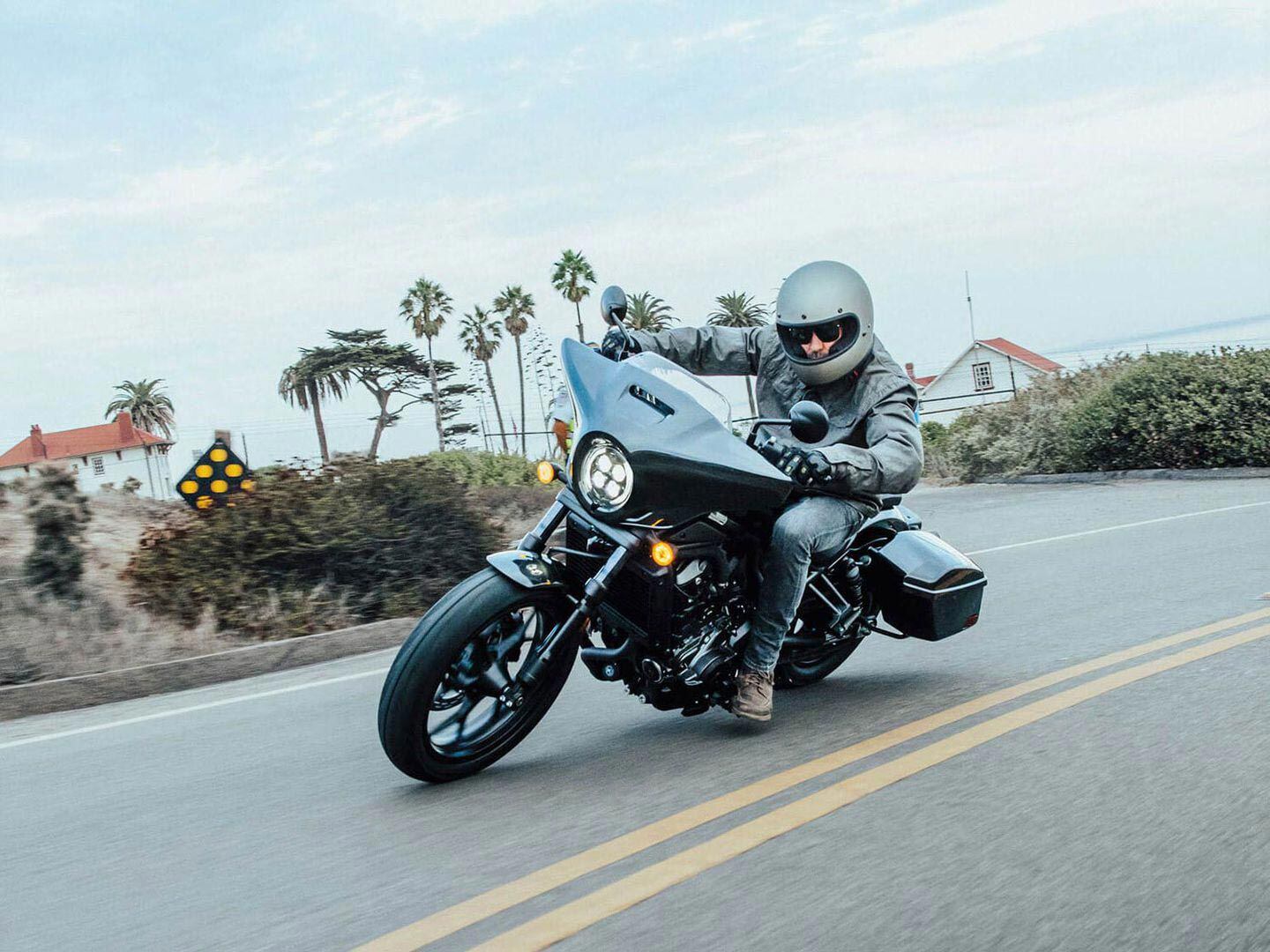
Power delivery is smooth and strong and the engine is well balanced. But even with that flywheel it doesn’t have the classic cruiser pulse. Or, for that matter, an exhaust note that makes you want to blip the throttle at a red light. The Rebel 1100T’s automatic Dual Clutch Transmission (DCT) eliminates the need to ever use a clutch lever. Riders can use paddle shifters if they choose. (Honda/)
Chassis/Handling
The Rebel 1100T uses a steel tube trellis frame with a nonadjustable fork and preload-adjustable shocks, both from Showa.
Handling, as we’ve come to expect from Honda, is delightfully neutral and inspires particular confidence at low speeds. Thanks largely to the engine placement’s effect on weight distribution, the 524-pound Rebel 1100T feels incredibly well balanced and nimble. The chassis feels planted, with no pitching aft as you accelerate out of one corner and brake hard into another. Even leaned over, carrying speed through a turn, the chassis provides excellent feedback and allows for midcorner inputs without the worry of losing composure.
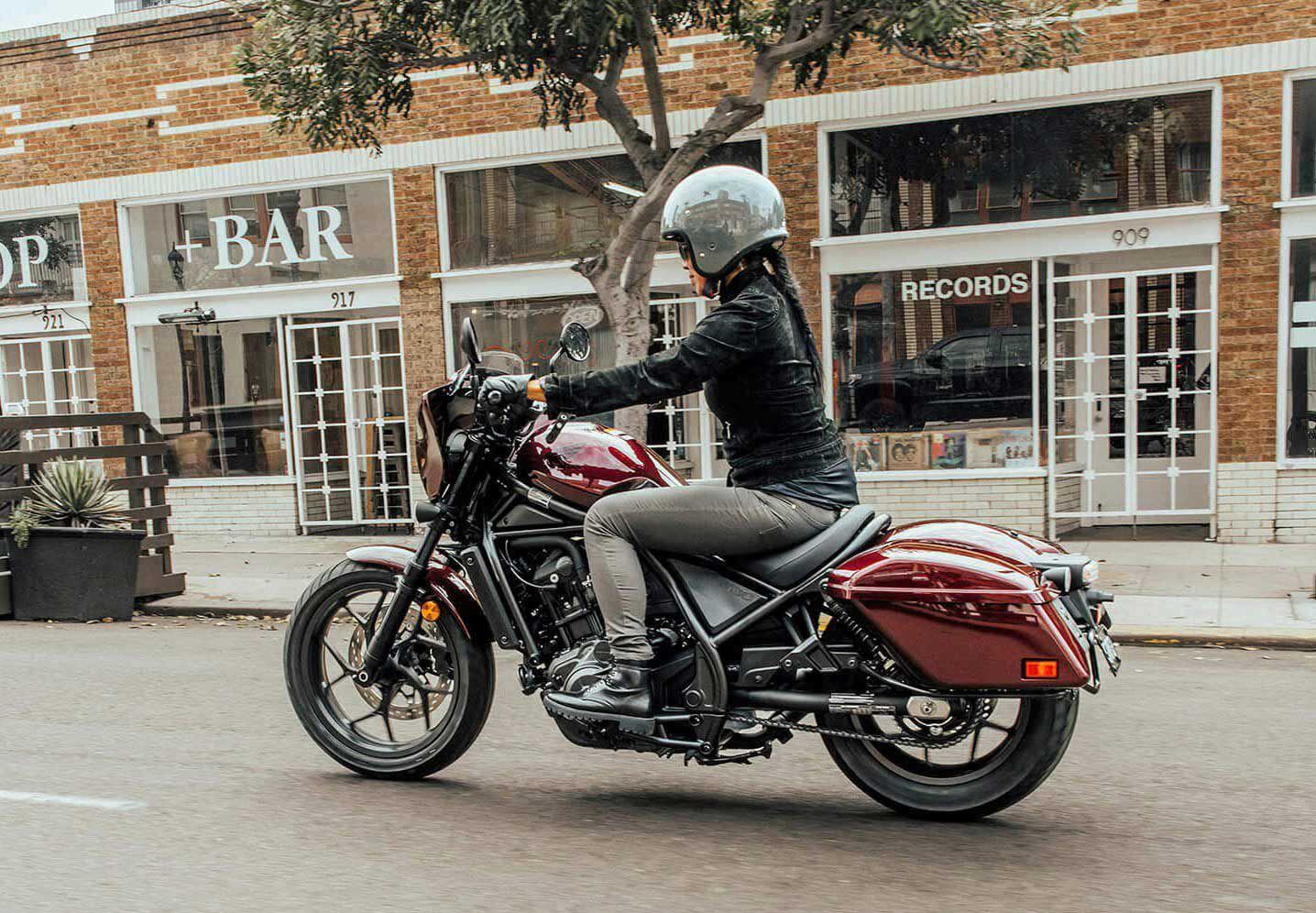
The Rebel 1100T uses a steel tube trellis frame with a nonadjustable fork and preload-adjustable shocks, both from Showa. It uses a dual-piston Nissin caliper up front, and a Tokico four-piston caliper in the rear. (Honda/)
Brakes
The 1100T stops with a Nissin dual-piston caliper on a 256mm disc in the rear and a single radially mounted Tokico four-piston caliper on a 330mm rotor in front. Brakes are responsive with good feel through the adjustable lever, allowing for precise application to help explore the limits of the front suspension and the OE-fitted Dunlop D428 tires. ABS is standard.
Fuel Economy and Real-World MPG
Cycle World-measured fuel economy on the non-T Rebel 1100 is 37.6 mpg.
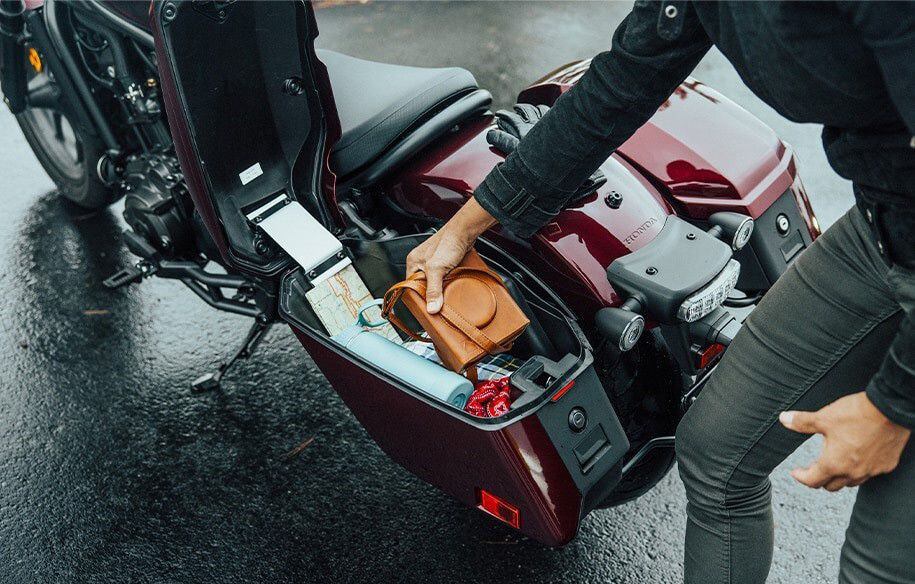
LED lights are standard. Unfortunately, the 1100T’s saddlebags have a combined capacity of only 35 liters. Long-distance hauls will require additional luggage options. (Honda/)
Ergonomics: Comfort and Utility
The Rebel 1100T has a 27.5-inch seat height and shares a similar ergonomic configuration to siblings. The standard Rebel’s ergonomics are somewhat cramped for taller riders. Mid-mounted footpegs sit high on the frame and put riders in sort of a cannonball position, which can be uncomfortable on longer stretches of highway. This peg positioning is reflected in the Rebel’s 35 degrees of claimed lean angle—significantly greater than its competitors—but testers unanimously agree they’d trade some lean angle for cruising comfort.
Cruise control and ABS are standard. Other nice features include 3 liters of underseat storage and a USB-C charging port.
The 1100T brings a windscreen and fairing to the party as well as hard saddlebags. Unfortunately, with a combined capacity of 35 liters (the Harley-Davidson Low Rider ST’s luggage capacity is nearly 54 liters), long-distance hauls will require additional luggage options.
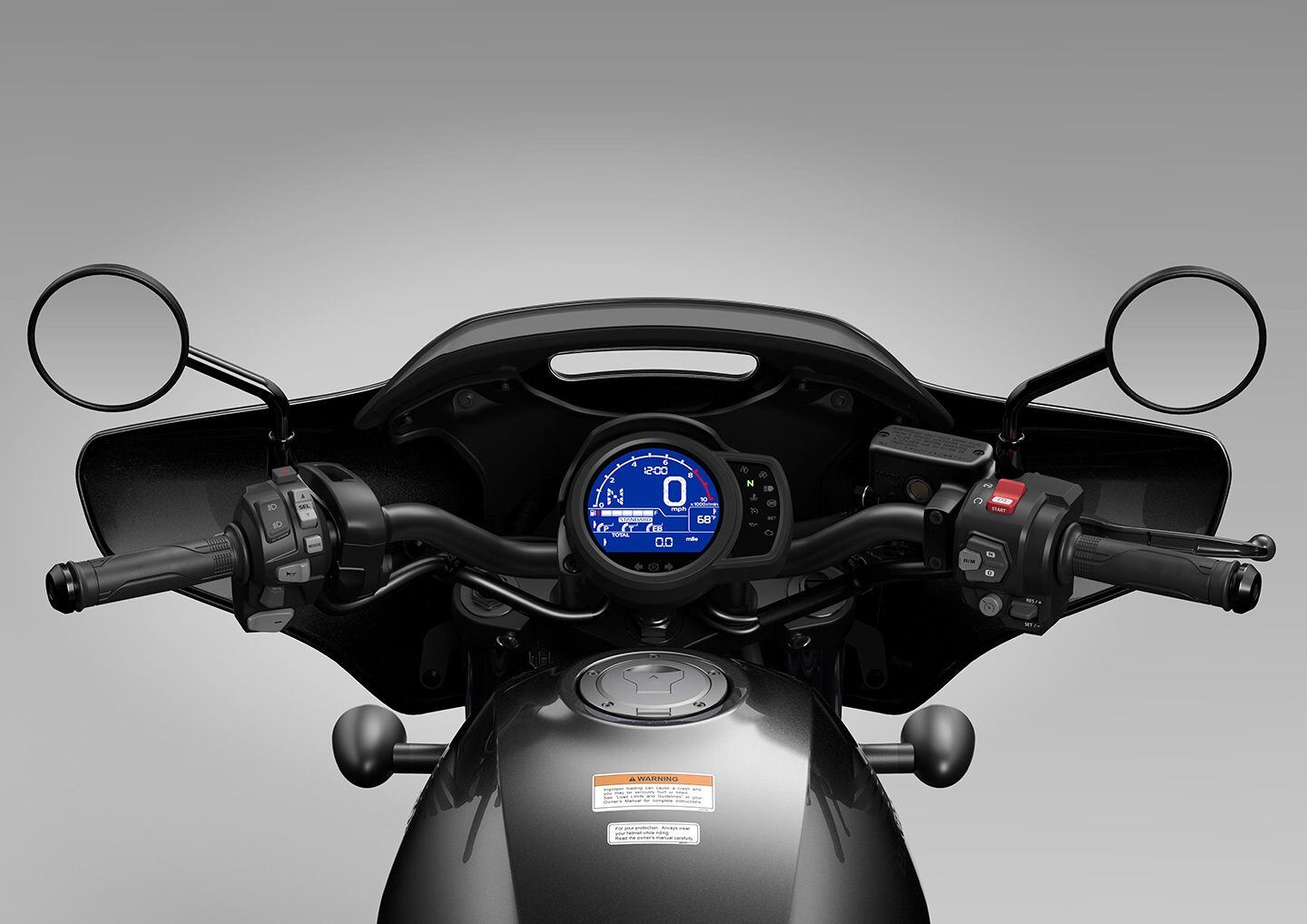
The Rebel’s simple LCD dash is basic but straight-forward to use, allowing riders quick adjustment of various settings. Note: cruise control and the left bar-mounted paddle shifters. (Honda/)
Electronics
The Rebel 1100T has three riding modes (Rain, Sport, Tour) that preselect power delivery, engine-braking, and traction control, while a fourth User mode allows riders to customize the settings. The Rebel 1100 also gets full-LED lighting and a basic LCD display to relay all pertinent riding information. ABS comes standard.
Warranty and Maintenance Coverage
Honda offers a one-year, transferable, unlimited-mileage limited warranty for the Rebel 1100T.
Quality
The Rebel 1100T feels well engineered and boasts some high performance for what is otherwise a friendly cruiser. Plastic paneling and an excess of wires and exposed plumbing rob it of top-notch aesthetics. Still, blacked-out finishes, clean welds on the frame, high-quality metalflake paint, full-LED lighting, and other touches exude Honda quality. The 1100T is clearly built to a very high standard and without much flash or glitz to distract. Honda has found its own style with the Rebel line, rather than mimic American cruisers.
2023 Honda Rebel 1100T DCT Claimed Specs
| MSRP: | $11,299 |
|---|---|
| Engine: | 1,083cc, SOHC, liquid-cooled Unicam parallel twin; 4-valve/cyl. |
| Bore x Stroke: | 92.0 x 81.5mm |
| Transmission/Final Drive: | 6-speed/chain |
| Fuel Delivery: | PGM-FI electronic fuel injection w/ 46mm throttle bodies |
| Clutch: | Wet, multiplate |
| Engine Management/Ignition: | Ride-by-wire/full transistorized ignition |
| Frame: | Steel-tube trellis construction |
| Front Suspension: | 43mm telescopic fork w/ dark titanium oxide coating, spring preload adjustable; 4.8 in. travel |
| Rear Suspension: | Dual Showa shocks w/ 12.5mm shafts, piggyback pressurized reservoirs, spring preload adjustable; 3.7 in. travel |
| Front Brake: | 4-piston monoblock, radial-mount hydraulic caliper, floating 330mm disc w/ ABS |
| Rear Brake: | 1-piston hydraulic caliper, 256mm disc w/ ABS |
| Wheels, Front/Rear: | Cast; 18 in. / 16 in. |
| Tires, Front/Rear: | Dunlop D428; 130/70-18 / 180/65-16 |
| Rake/Trail: | 28.0°/4.3 in. |
| Wheelbase: | 59.8 in. |
| Ground Clearance: | 4.7 in. |
| Seat Height: | 27.5 in. |
| Fuel Capacity: | 3.6 gal. |
| Wet Weight: | 524 lb. |
| Contact: | powersports.honda.com |
Powering this one-of-a-kind bike is The Motor Company’s Milwaukee-Eight 117. We recently had the same motor on our dyno in the 2023 Harley-Davidson Breakout 117 and were impressed with its exhilarating torque.
Related: Why Harley-Davidson Engines Look The Way They Do
On our in-house Dynojet 250i dynamometer, the 2023 Harley-Davidson CVO Road Glide Limited Anniversary Edition produced 90.1 hp at 4,660 rpm and 111.2 lb.-ft. of torque at 3,290 rpm. Pumping out less peak horsepower and torque than the Breakout 117 as well as weighing 963 pounds on the Cycle World automotive scales (281 pounds more than the Breakout) the CVO Road Glide Limited is noticeably slower off the line from one stoplight to the next.
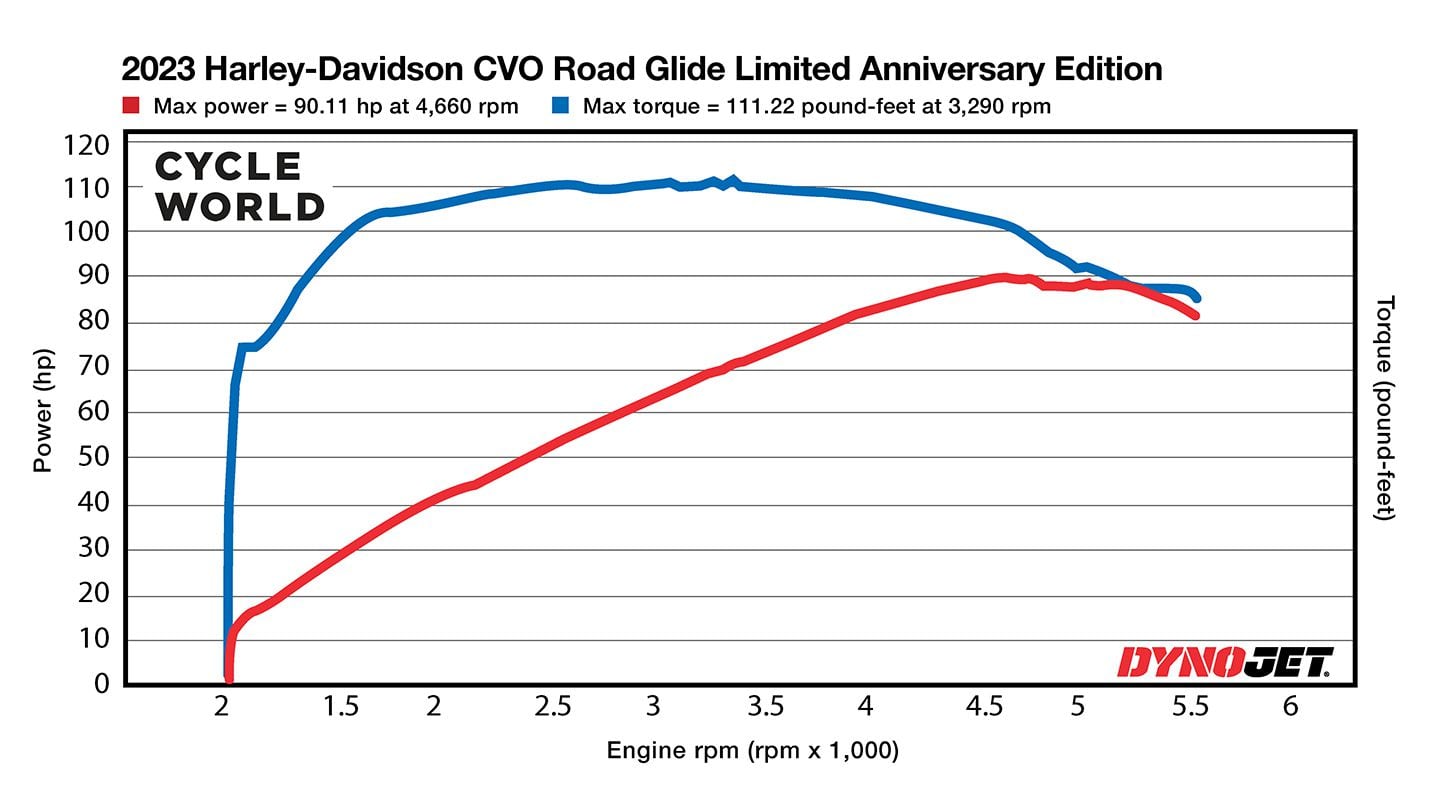
2023 Harley-Davidson CVO Road Glide Limited Anniversary Edition Dyno Chart. (Robert Martin/)
Although the 2023 Harley-Davidson Road Glide Limited Anniversary Edition’s performance numbers may be inferior to the Breakout on paper, it serves riders in a different way. Our testing staff fell in love with its comfort, character, and charm. Cruising in style and luxury while jamming tunes through the Rockford Fosgate Stage 1 audio system produces an incredible experience. A Harley-Davidson experience. And for those wanting a little more punch off the line: Harley’s 2024 CVO Road Glide Limited comes fitted with the larger VVT Milwaukee-Eight 121 V-twin engine.
]]>Bring on the night. Sunset over Sturgis, South Dakota. (Michael Lichter/)
One word still epitomizes motorcycling in America, even for those who’ve never ridden.
Like it or not, Sturgis is shorthand for freedom, anarchy, and opportunism in motorcycle culture. Not a fan? So much the better for the 458,161 (or so) people who came to Sturgis in 2023. Keep judging, they’ll keep coming.
Riders come to Sturgis to celebrate life on two wheels, past and present. It’s a good thing they do. People put food on the table and pay mortgages with the income earned from a week and a half of biker hedonism. It’s a celebration of freedom in multiple ways. It’s a showcase for the spiritual, logistical, and economic power of our country. And of course, it’s a good time.
It’s OK if Sturgis isn’t your thing. It’s not supposed to be everybody’s thing. Common sense and best practices guide most things in life. But America is partially built on luck, chance, and productive anarchy. For a weekend or two a year, these principles rule the 3,483 square miles of Meade County.
Enjoy the pictures photographer Michael Lichter captured this year.
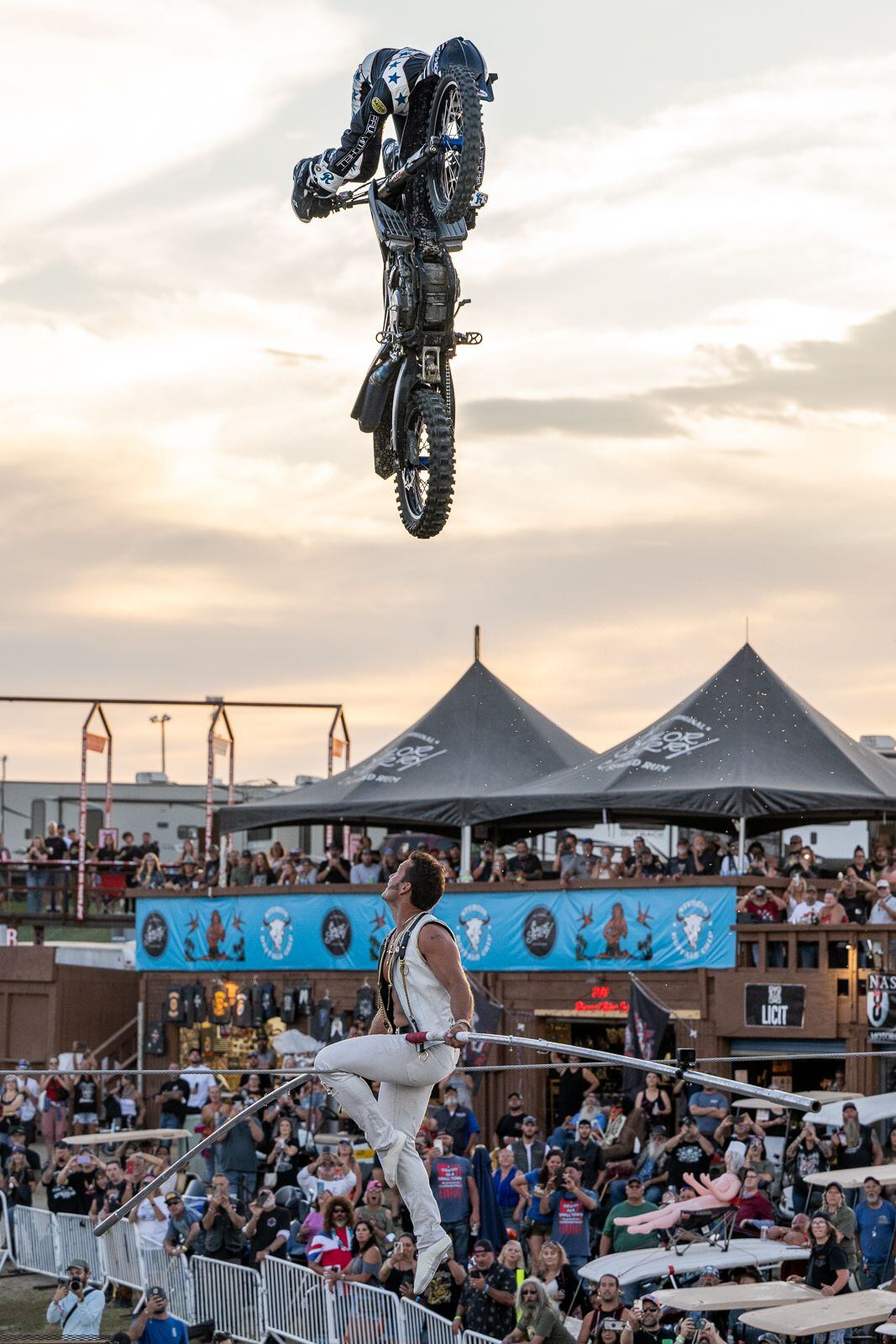
Famous, indeed. Kyle Ives, of Ives Brothers Wall of Death fame, jumped the 375-foot tightrope of Blake Wallenda, of Flying Wallenda’s fame at the Sturgis Motorcycle Rally, South Dakota. (Michael Lichter/)
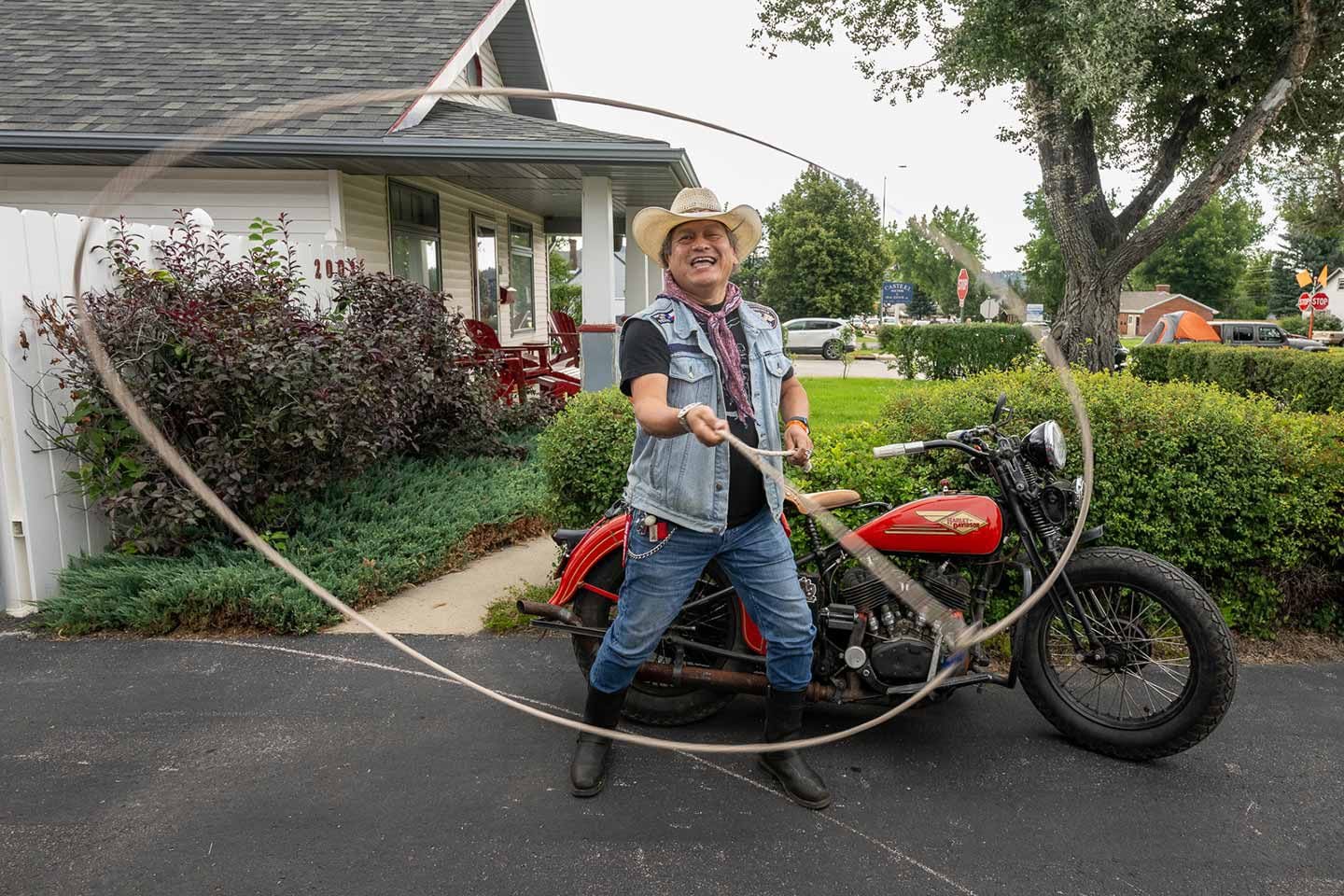
Jose Torres (@blue1932vl) shows off his roping skills in front of his 1934 Knucklehead during the Sturgis Motorcycle Rally. (Michael Lichter/)
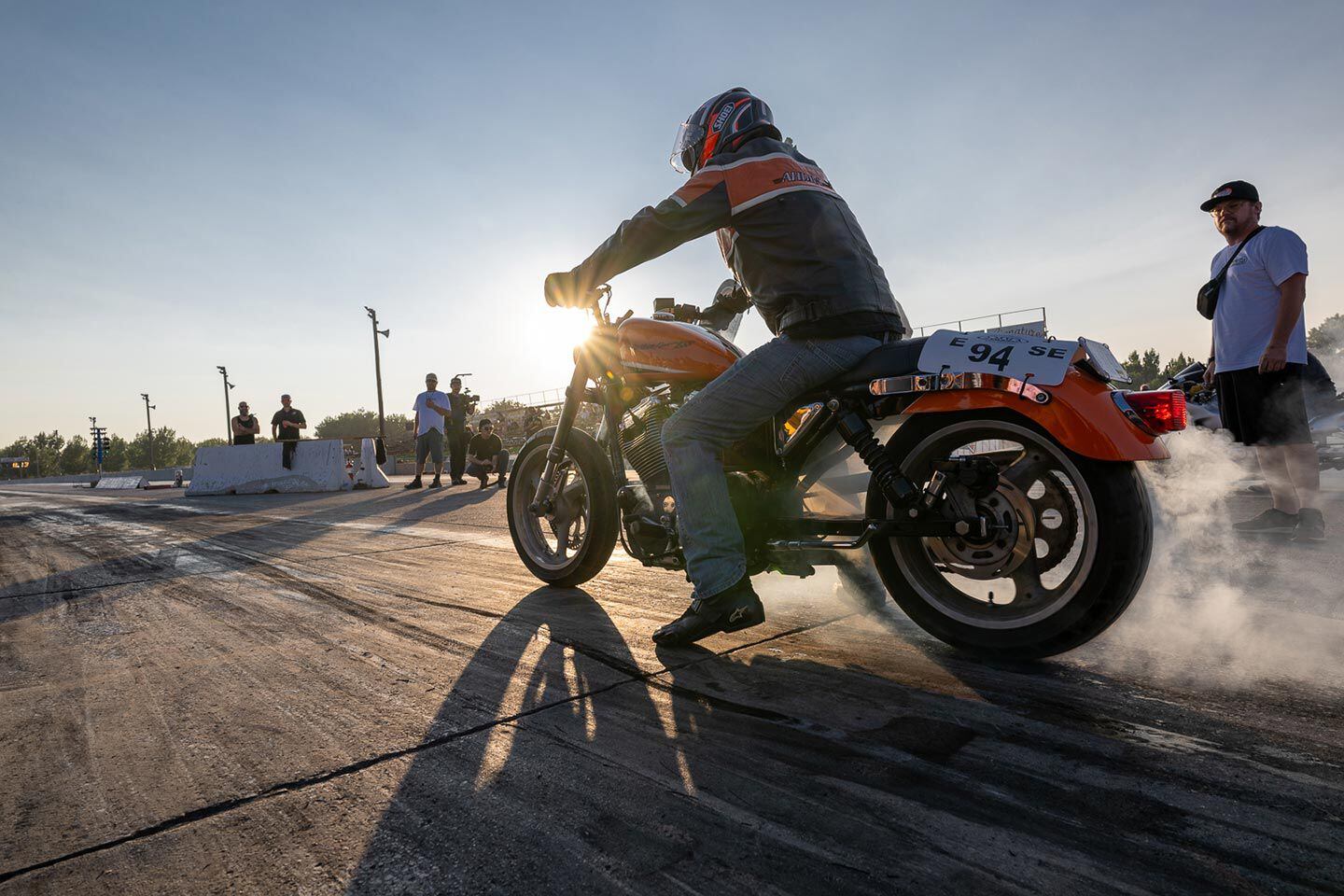
Run-what-you-brung, tires sold separately. The 8th Annual Free Baker Drivetrain drags at the Sturgis Dragstrip. (Michael Lichter/)
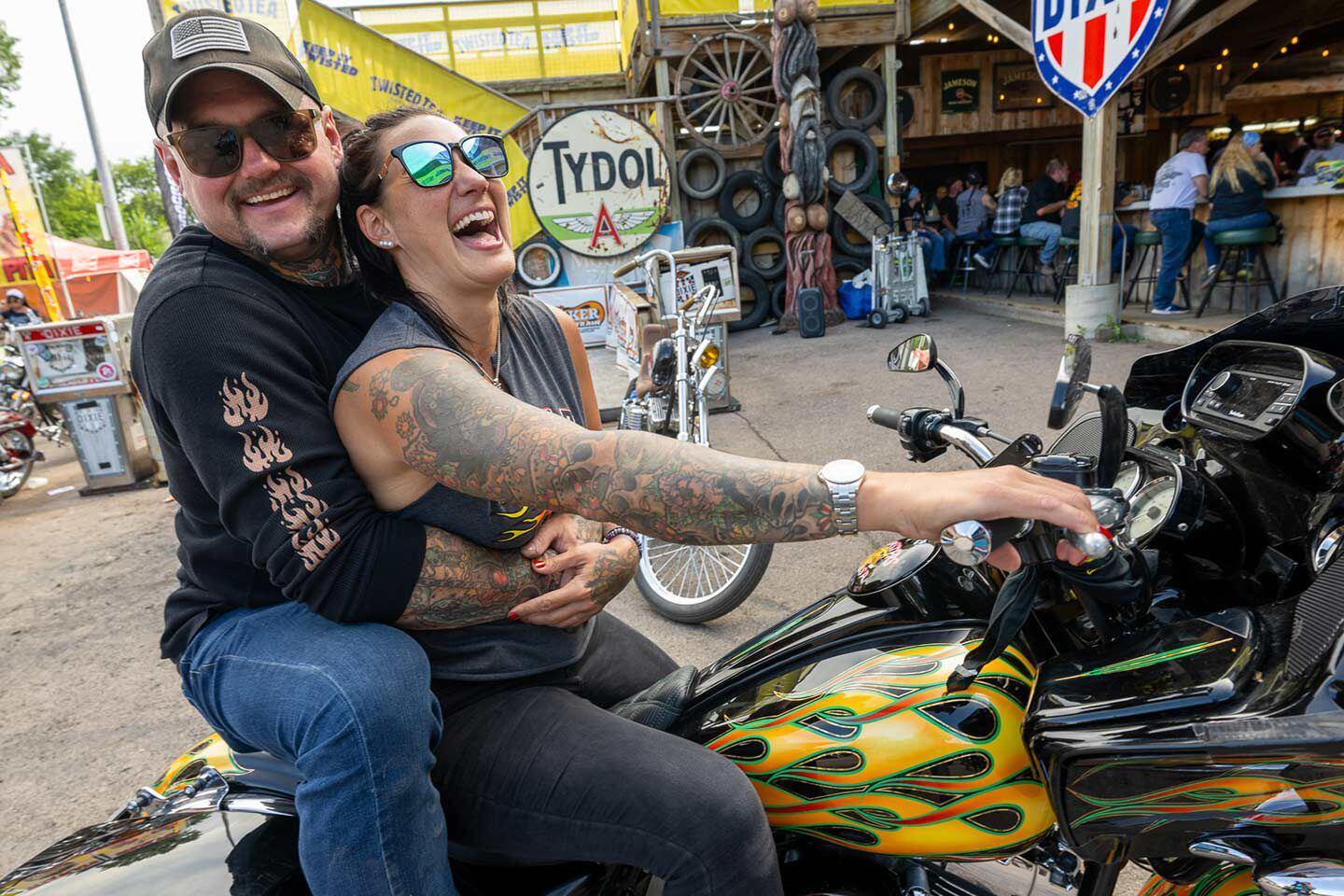
Ladies to the front, as they say. Jody Perewitz gets a squeeze from friend Paul Wideman of Bare Knuckle Choppers. (Michael Lichter/)
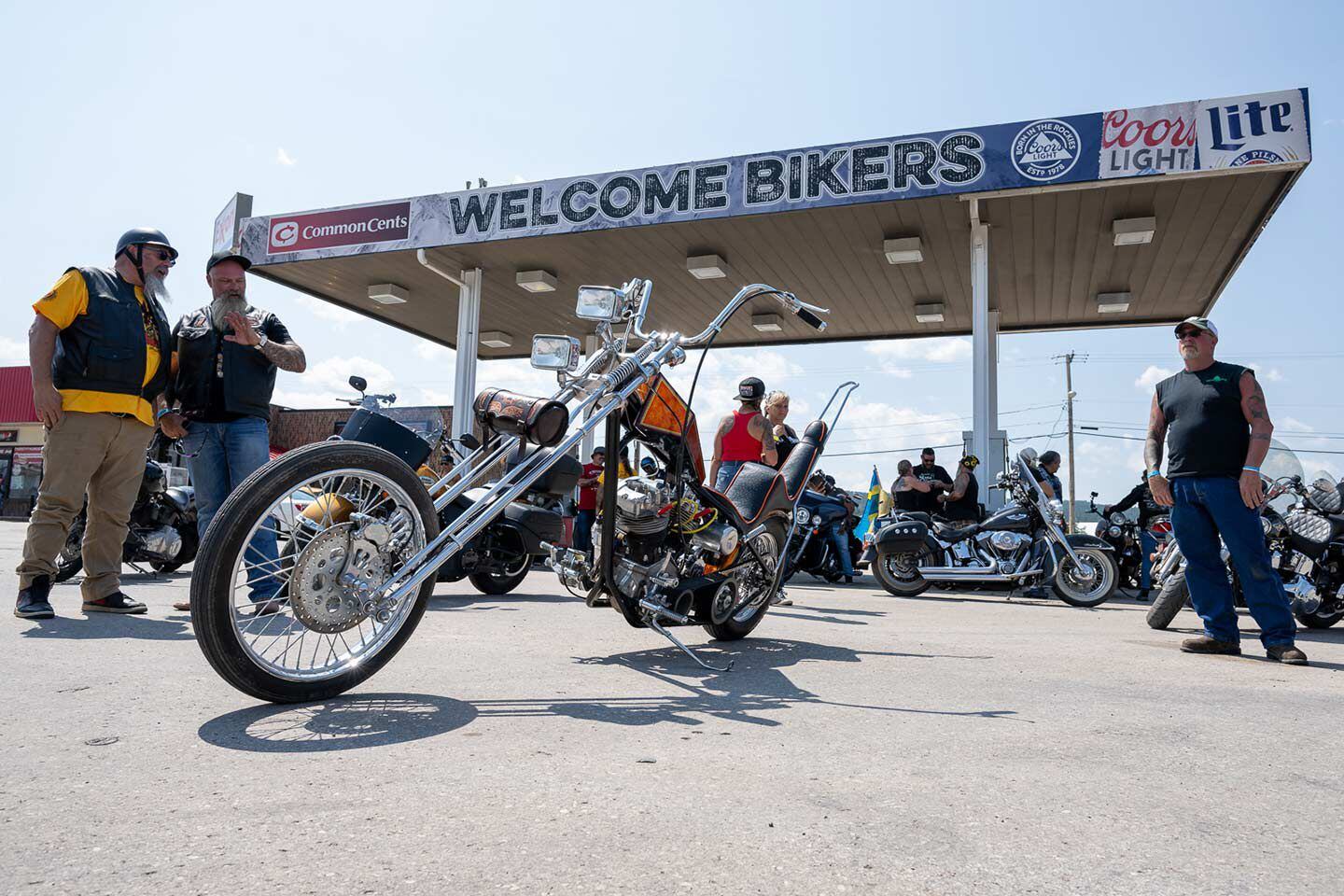
Ready for an Italian tuneup. Bob McKay (@bobkzcustomkult) getting ready to ride up Vanocker Canyon to the Nemo Guest Ranch during the Sturgis Motorcycle Rally. (Michael Lichter/)
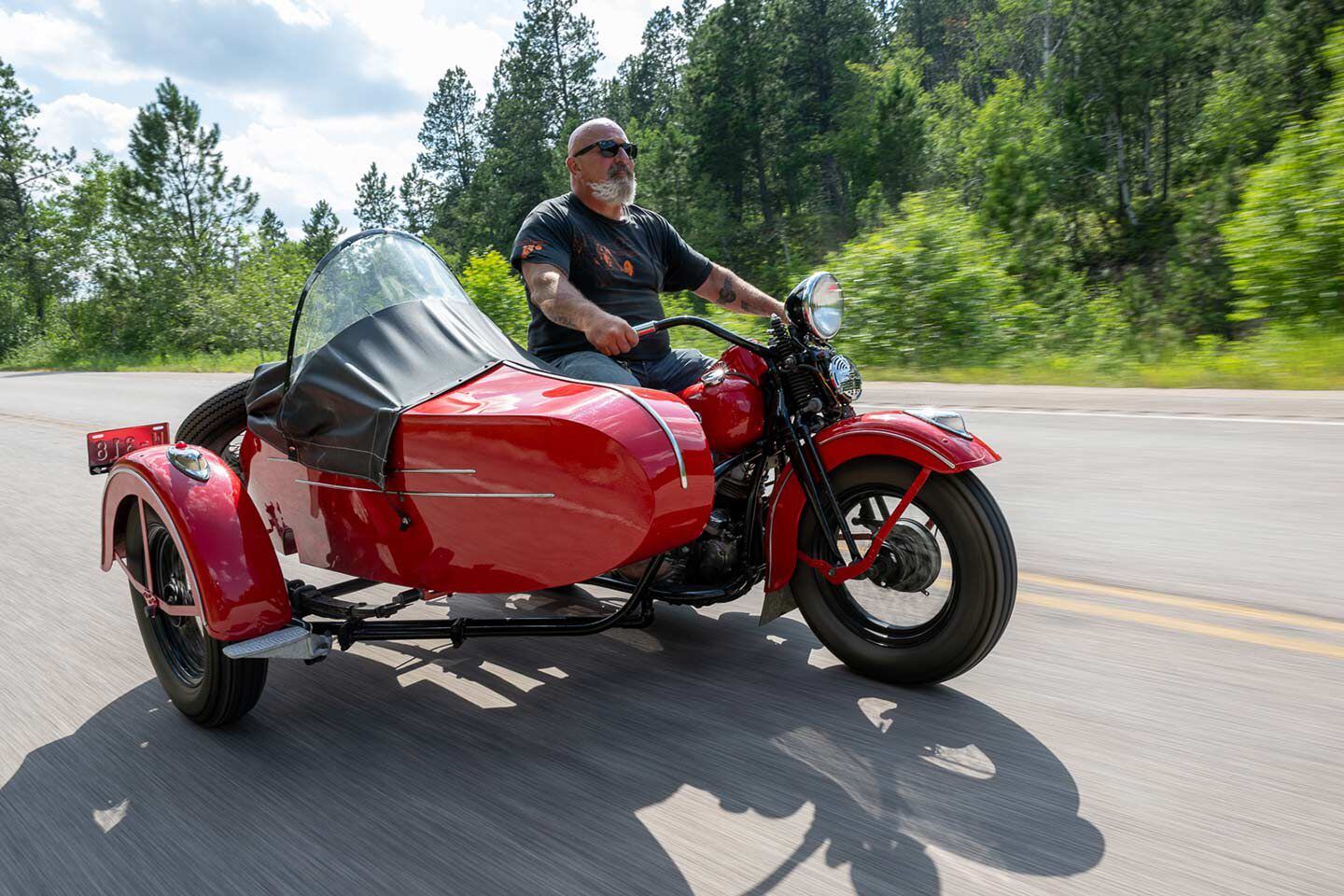
Scotty Busch (@scottybuschhd) riding Vanocker Canyon on his 1948 Panhead with sidecar. (Michael Lichter/)
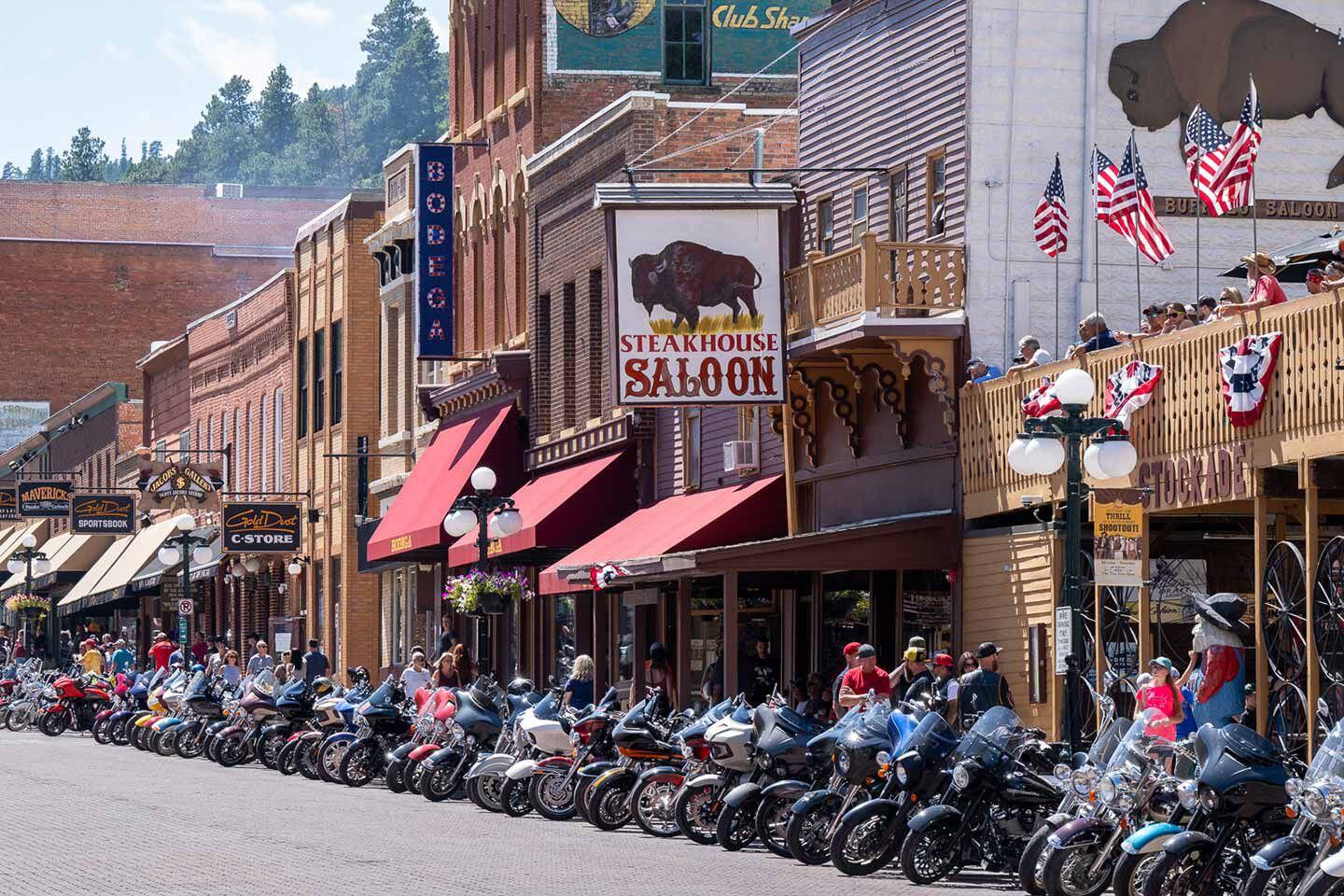
Meanwhile, in Deadwood, South Dakota, Main Street’s motorcycle-only parking fills up. (Michael Lichter/)
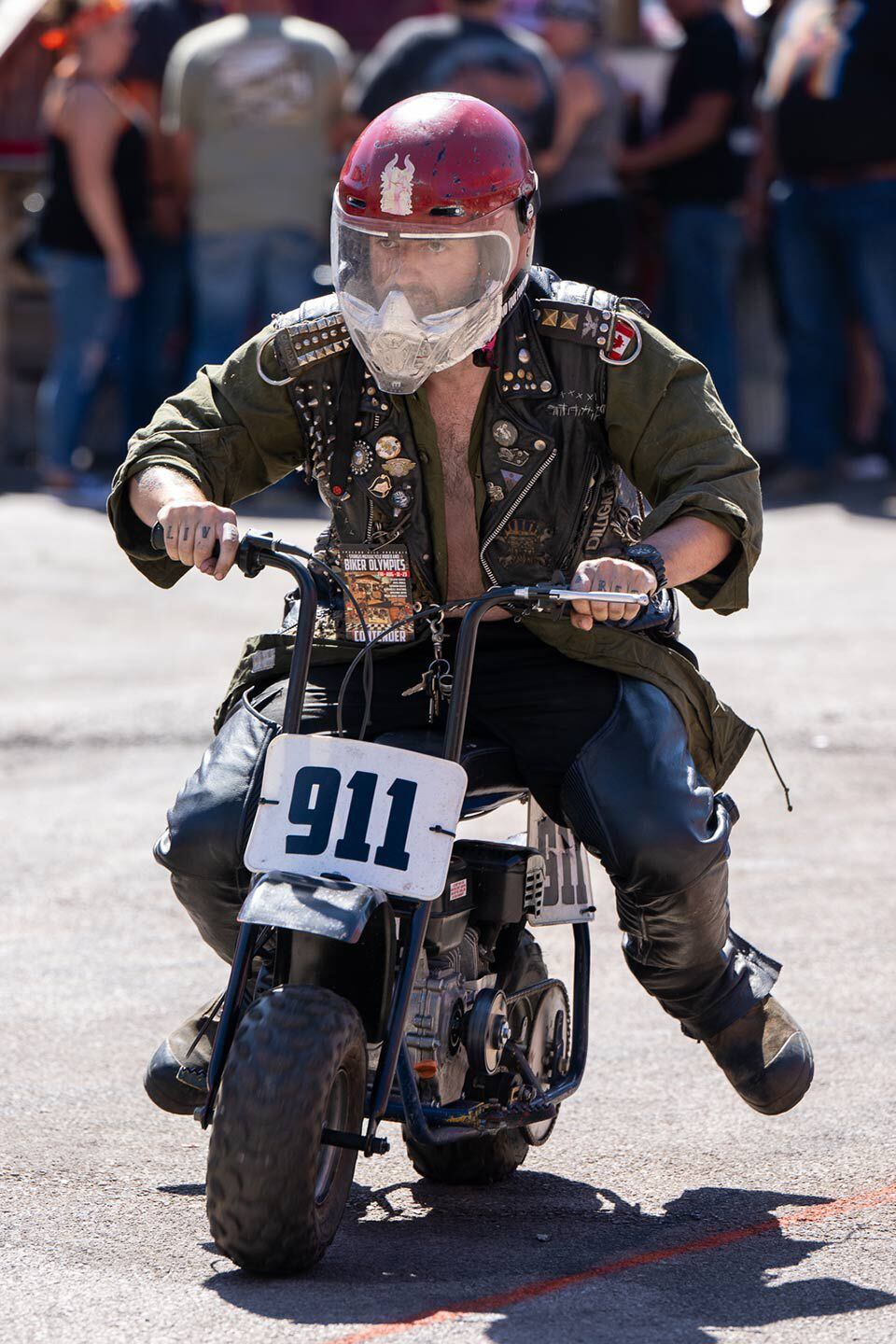
Minibikes, big fun. Cycle Source–hosted minibike barrel racing at the Iron Horse Saloon. (Michael Lichter/)
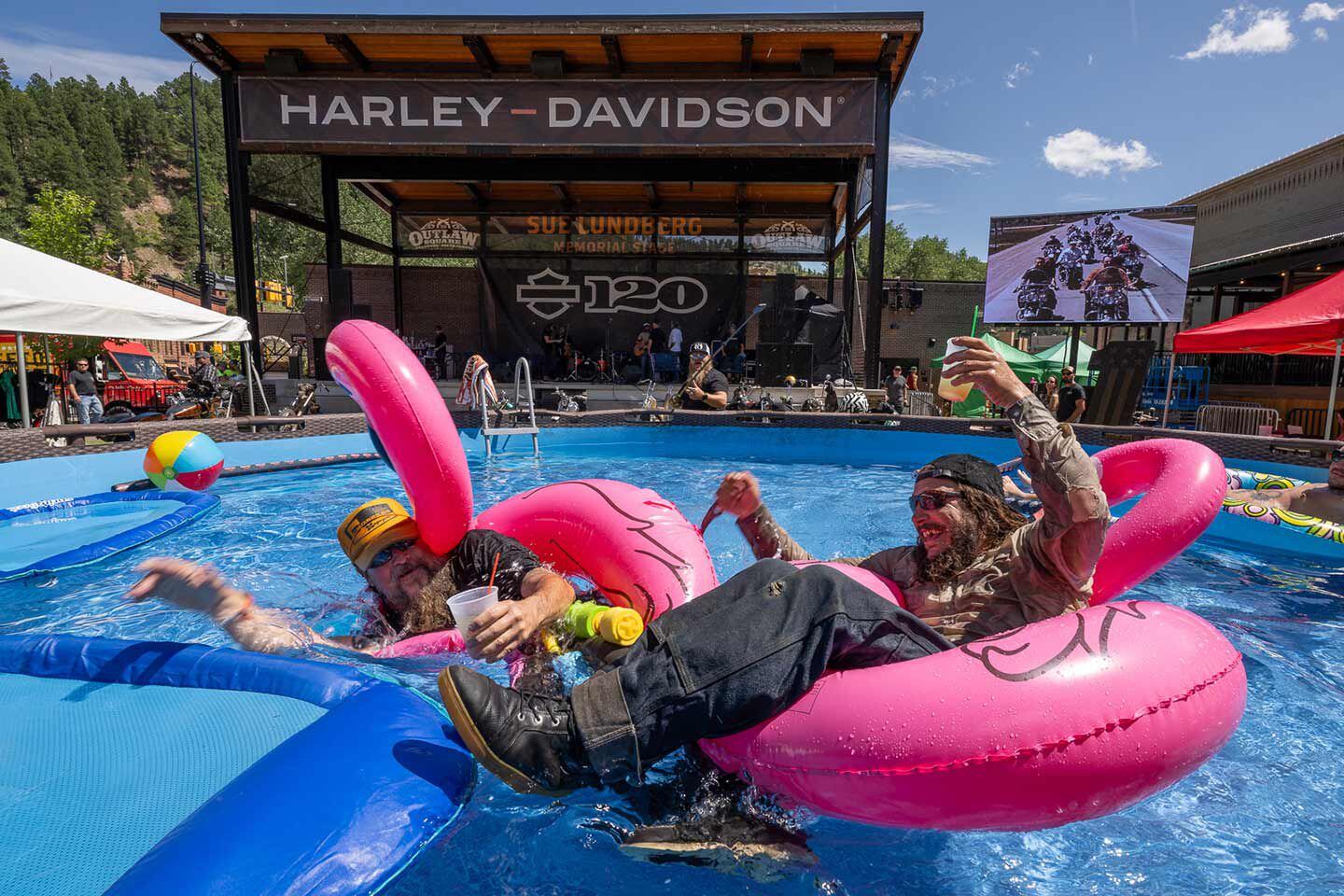
You’re sinking my battleship, man! Danger Dan Hardick (@DangerDanimal) attacks Pat Patterson’s (@LedSledCustoms) dinghy at Pat’s Sportster Showdown in Deadwood, South Dakota. (Michael Lichter/)
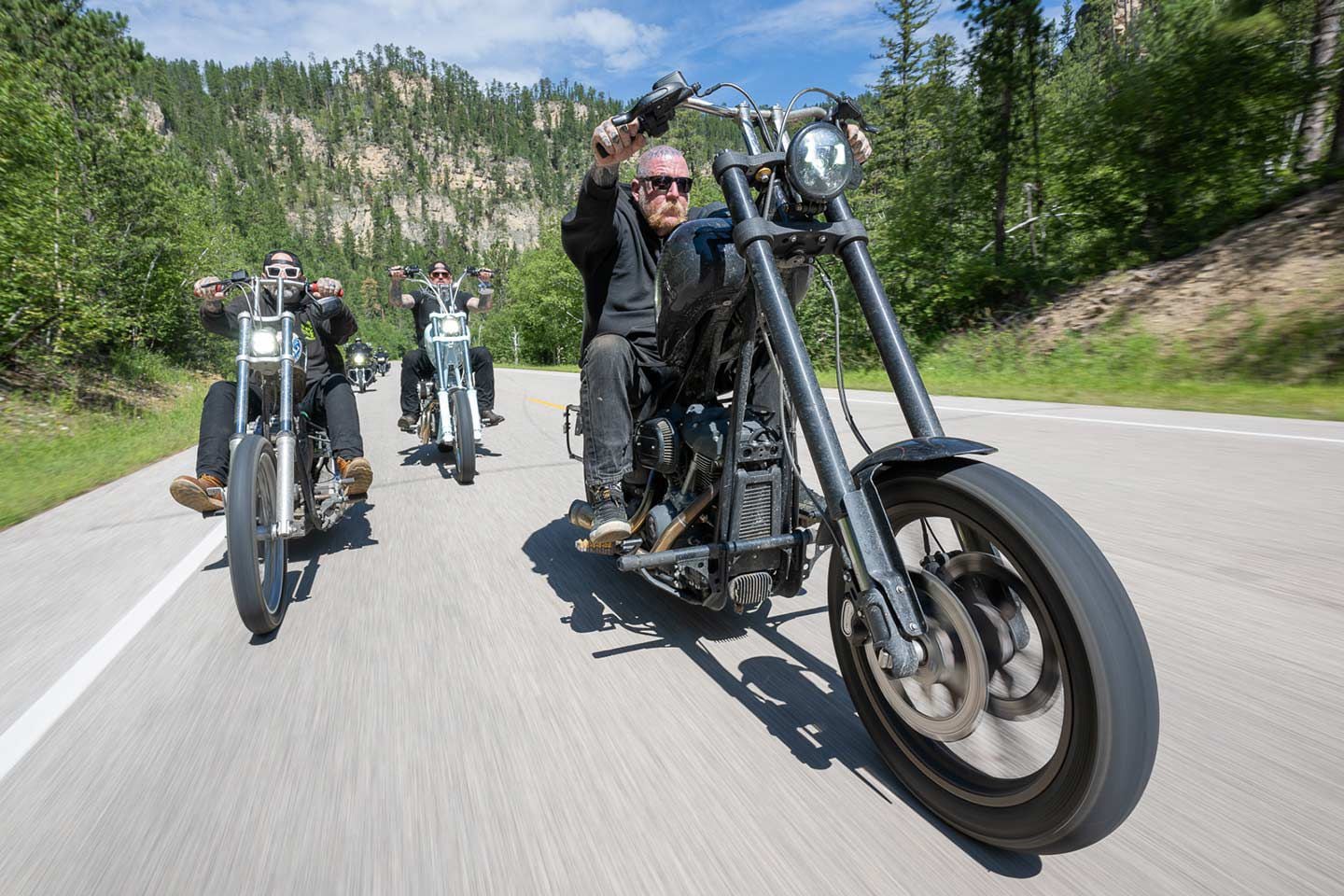
Jeff Quilty leading the @strikingviking74 ride along Spearfish Canyon with Darren McKeag (@mckeagart) and Paul Wideman (@bareknuckleperformance). (Michael Lichter/)
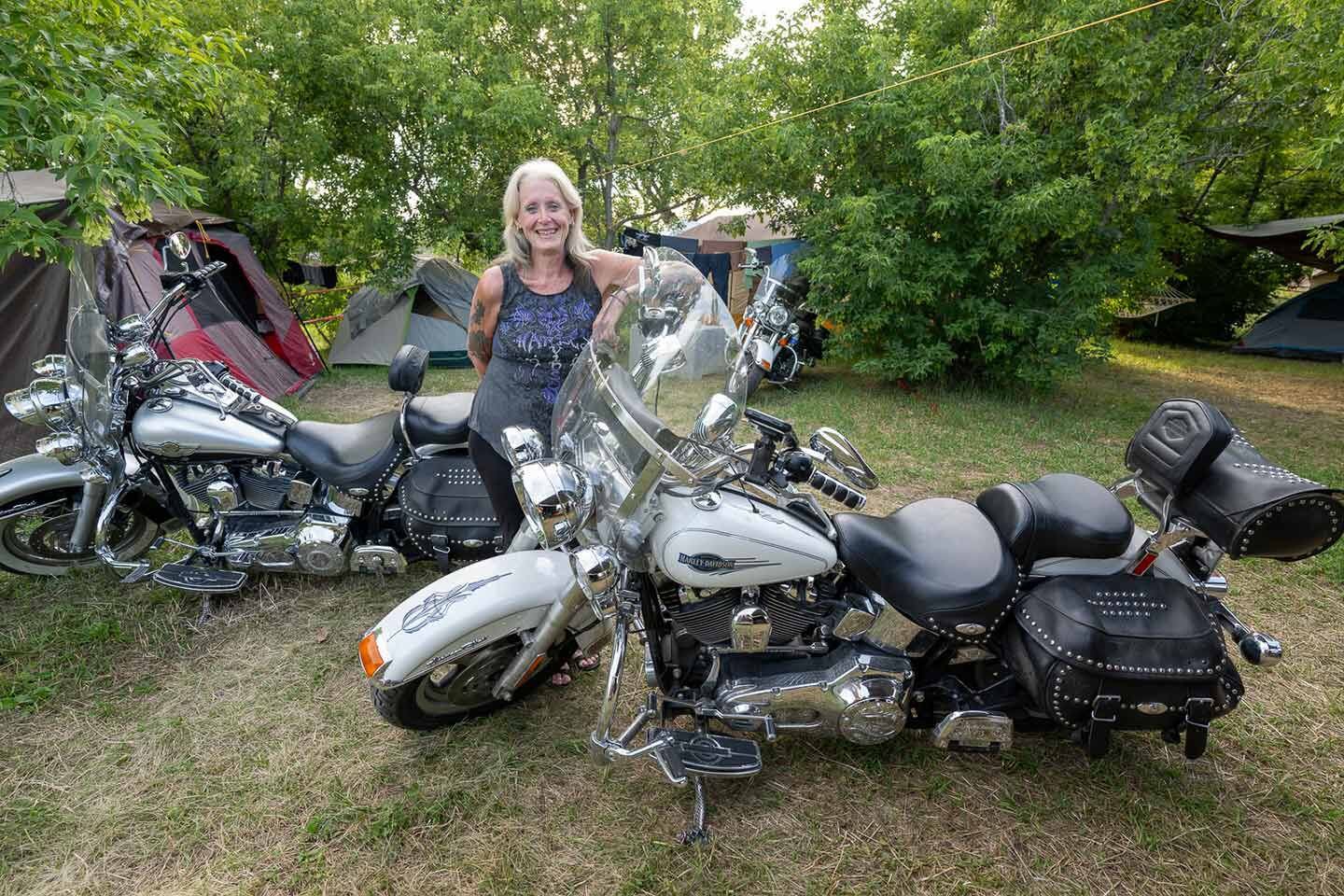
Still life with rider and steed. Camping at the Sturgis Buffalo Chip campground during the Sturgis Motorcycle Rally. (Michael Lichter/)
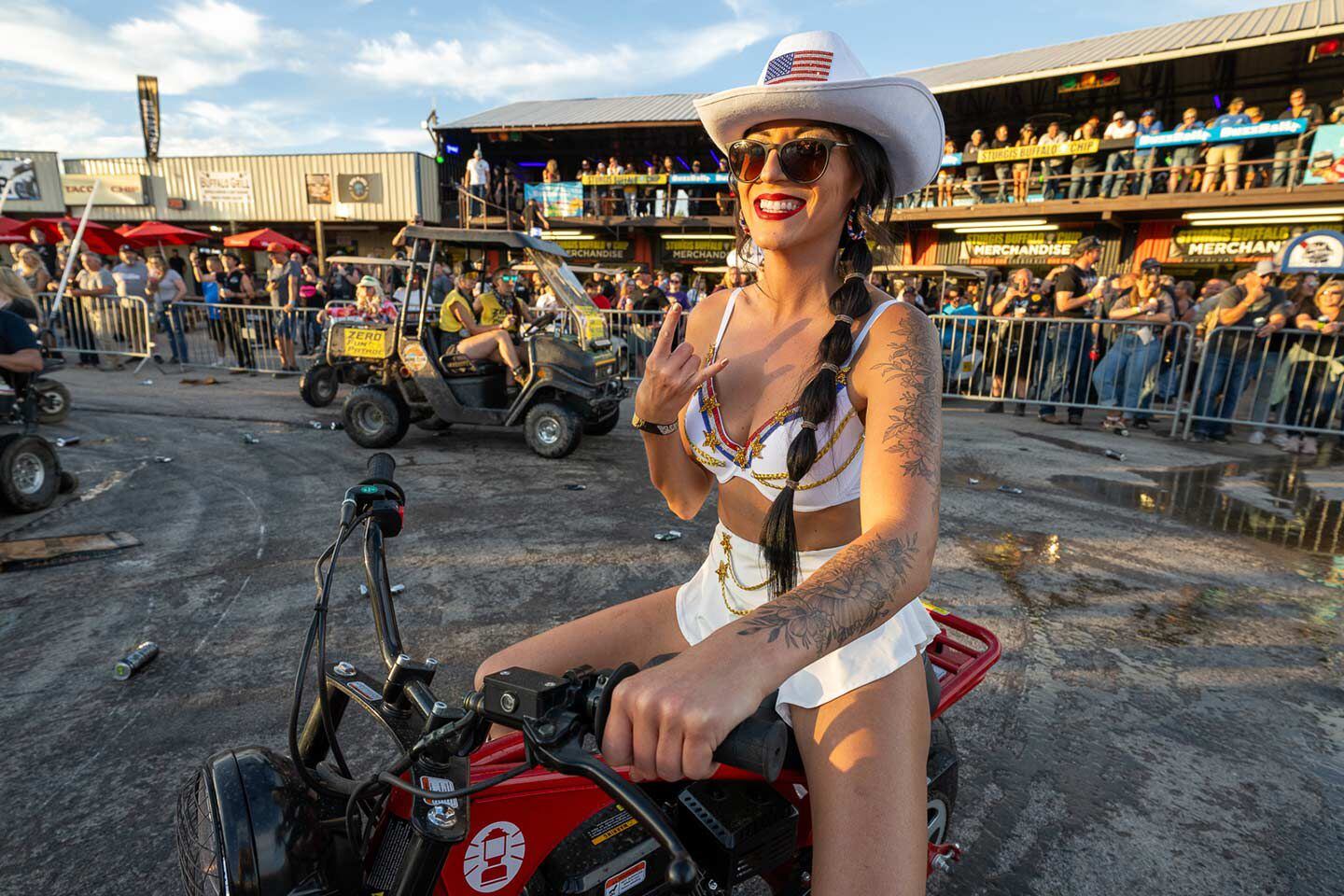
As 2023 Miss Buffalo Chip Poster Model, ambassador and model Em Powered (@__em.powered__) adds to the craziness at the Chip. (Michael Lichter/)
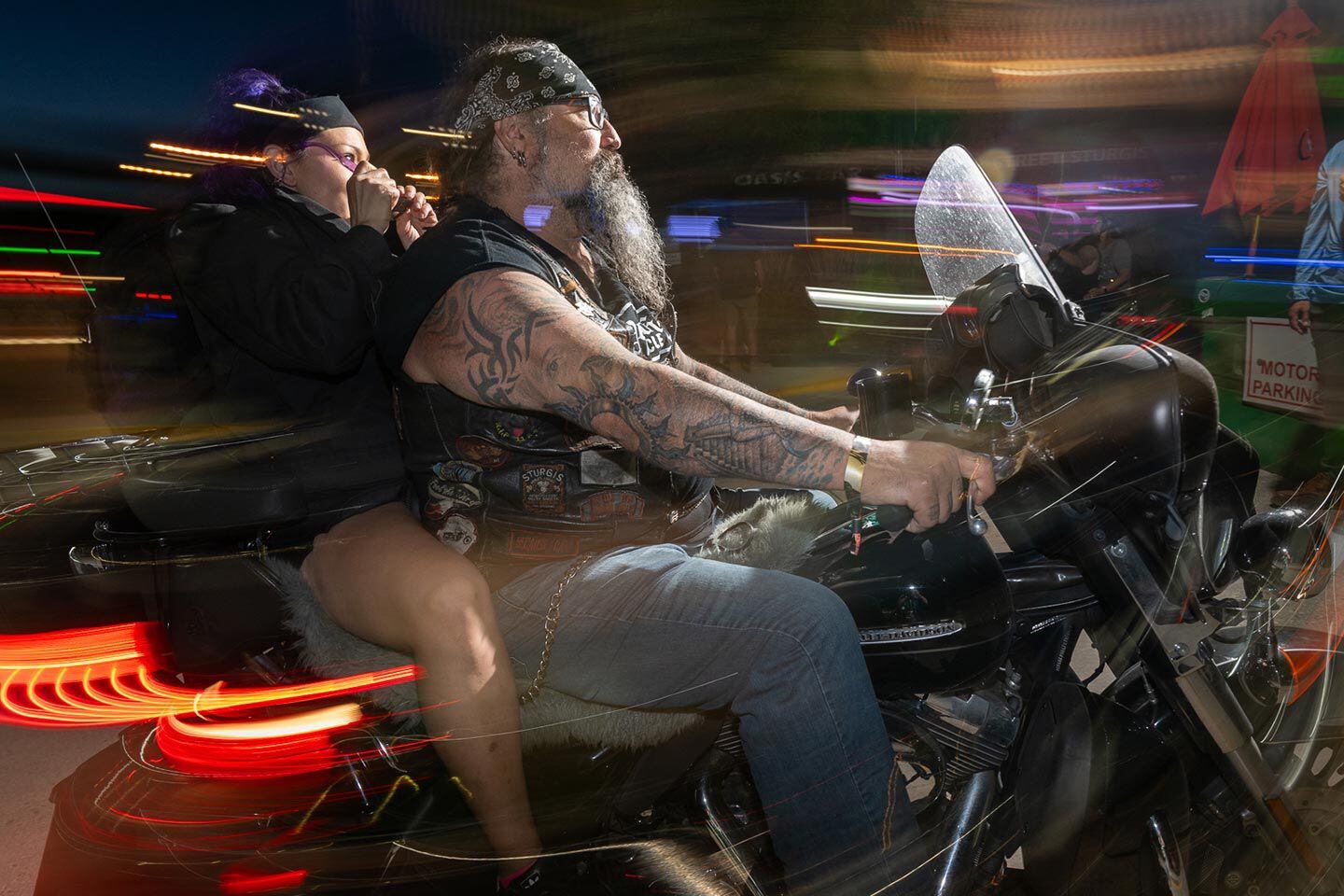
Next stop, night fun. Riding Main Street at dusk during the Sturgis Motorcycle Rally. (Michael Lichter/)
The Sportster S had big shoes to fill when it rolled onto the scene in 2021, and while many still miss the simplistic nature of previous-generation Sportsters, there’s no denying the performance of this latest version. (Jeff Allen/)
If you came here looking for an inexpensive and elemental cruiser intended for quick rips through town, you’ve come to the wrong place. Harley-Davidson could have built that bike, but it chose not to. And while the Sportster S will gladly shuttle you from stoplight to stoplight, then home again, Harley-Davidson always intended for this bike to be something more than that.
But who is the Sportster S for, and where does it work best? After spending a limited amount of time with the bike since it first showed up on the “Sport” section of the Harley-Davidson website, we decided it was time to check in with the Sportster S and understand what it’s like living with H-D’s most performance-oriented cruiser. If not to answer the question: Are power and technology enough to draw riders into the H-D family?
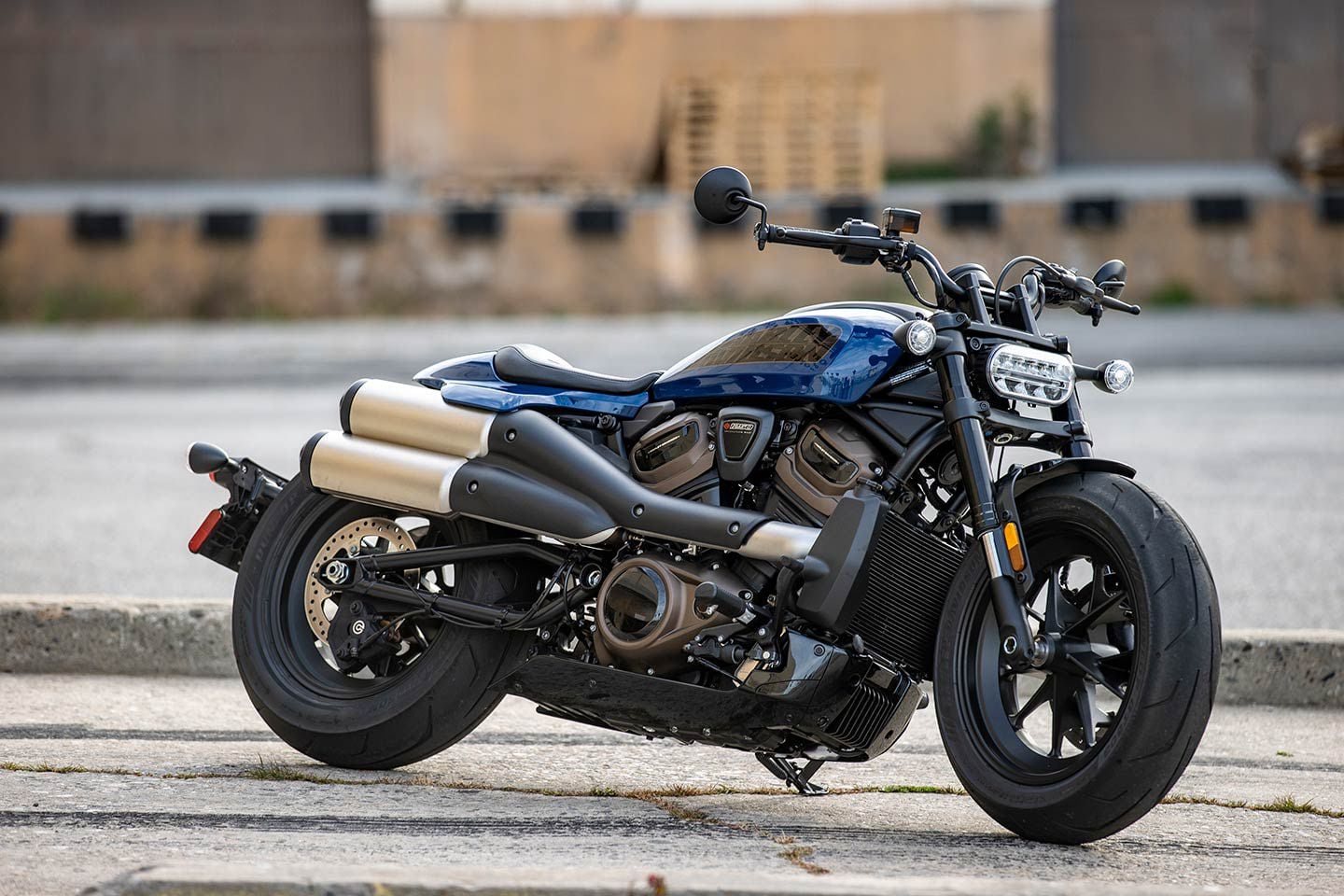
The Sportster S reminds us of an American muscle car; wide tires and a stocky stance give it presence, but the star of the show is the Revolution Max 1250T engine. (Jeff Allen/)
About the Bike
Introduced in 2021, the Sportster S is Harley-Davidson reaffirming its commitment to a revamped and fully modern lineup, and to using a clean-sheet approach to new models. Updating the air-cooled, Evolution-based platform would not suffice even if it did appease Sportster loyalists and extend a legacy begun in 1957. Nor would a new air-cooled platform have made sense from a manufacturing standpoint, as Harley-Davidson has heavily invested in the new Revolution Max engine that powers the Pan America. Modifying the Rev Max and using it across different H-D models helps amortize the costs associated with designing, developing, and assembling an entirely new engine platform.
So while the Sportster might be one of Harley-Davidson’s biggest success stories and one of the longest continually produced motorcycles in history (more than 50,000 models were shipped a year from 2012–2017), it’s important to recognize that the Sportster S almost had to be different. One look at the spec sheet and you’ll realize just how different it is.
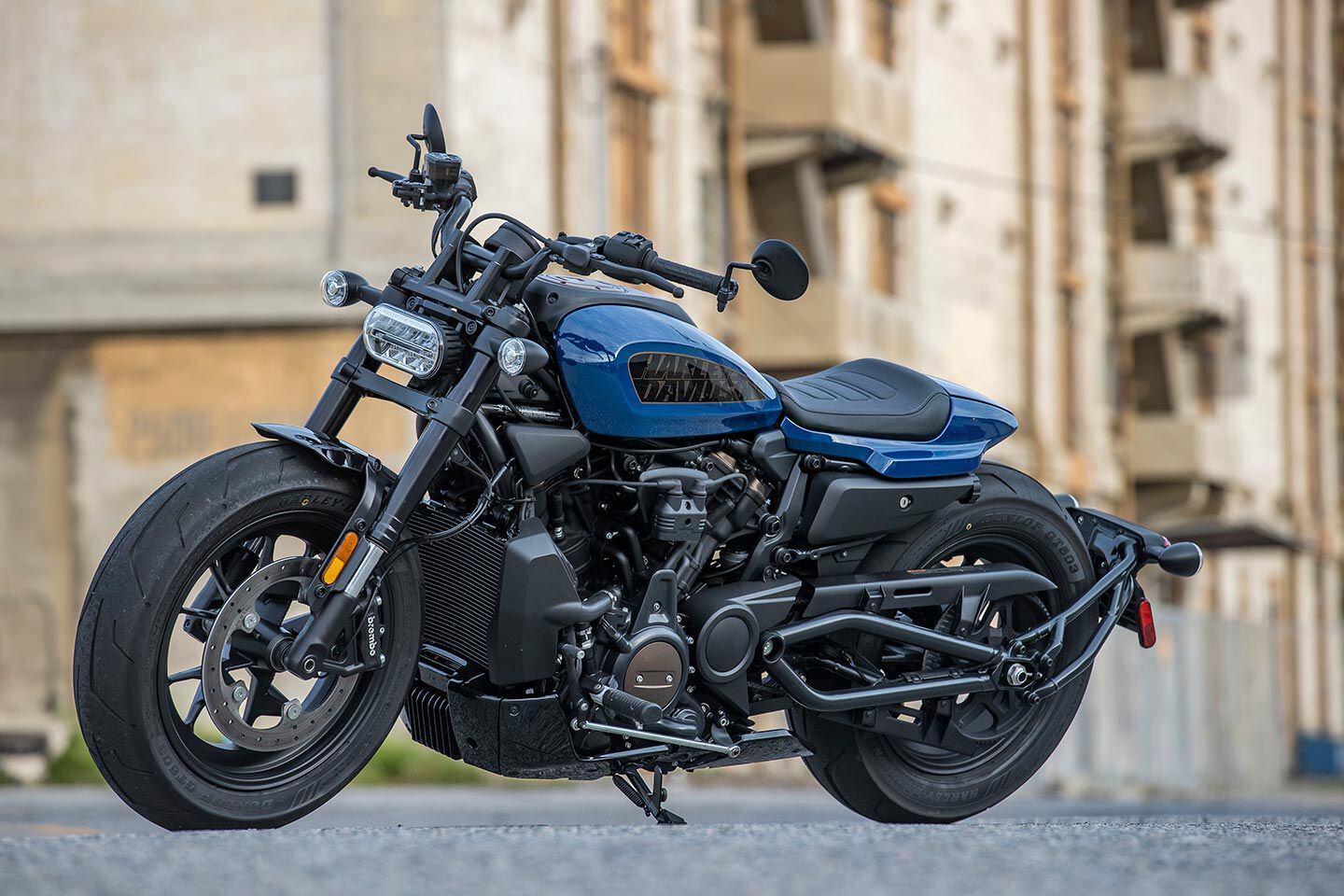
Harley-Davidson took a unique approach to the Sportster S design. There are design elements from the bobber world but also design cues from the XR-750 flat-tracker. Just look at that tail and solo seat. (Jeff Allen/)
The 1,250cc Revolution Max 1250 engine is the focus here. Dubbed the Revolution Max 1250T, this version of Harley’s liquid-cooled 60-degree V-twin uses smaller valves and ports and a different combustion chamber shape than the Pan America 1250, for added torque at low and midrange rpm. Variable Valve Timing (VVT) remains on intake and exhaust cams (the Nightster’s Revolution Max 975T engine has VVT on the intake side only), and maintenance-free hydraulic lash valve adjusters are used. Harley says torque is up 10 percent between 3,000 and 6,000 rpm when compared to the Revolution Max 1250 engine in the Pan America.
Strapping the bike to our in-house Dynojet dyno supports that claim; our testbike produced 109.6 hp at 7,530 rpm and 85.2 lb.-ft. of torque at 6,000 rpm, whereas the last Pan America we tested made 127.6 hp at 9,040 rpm and 78.4 lb.-ft. of torque at 4,480 rpm. The torque curve is as promised, the Sportster S making near peak torque at roughly 2,500 rpm and the Pan America not getting to its peak torque number until around 4,500 rpm.
You can watch the full Sportster S dyno video here.
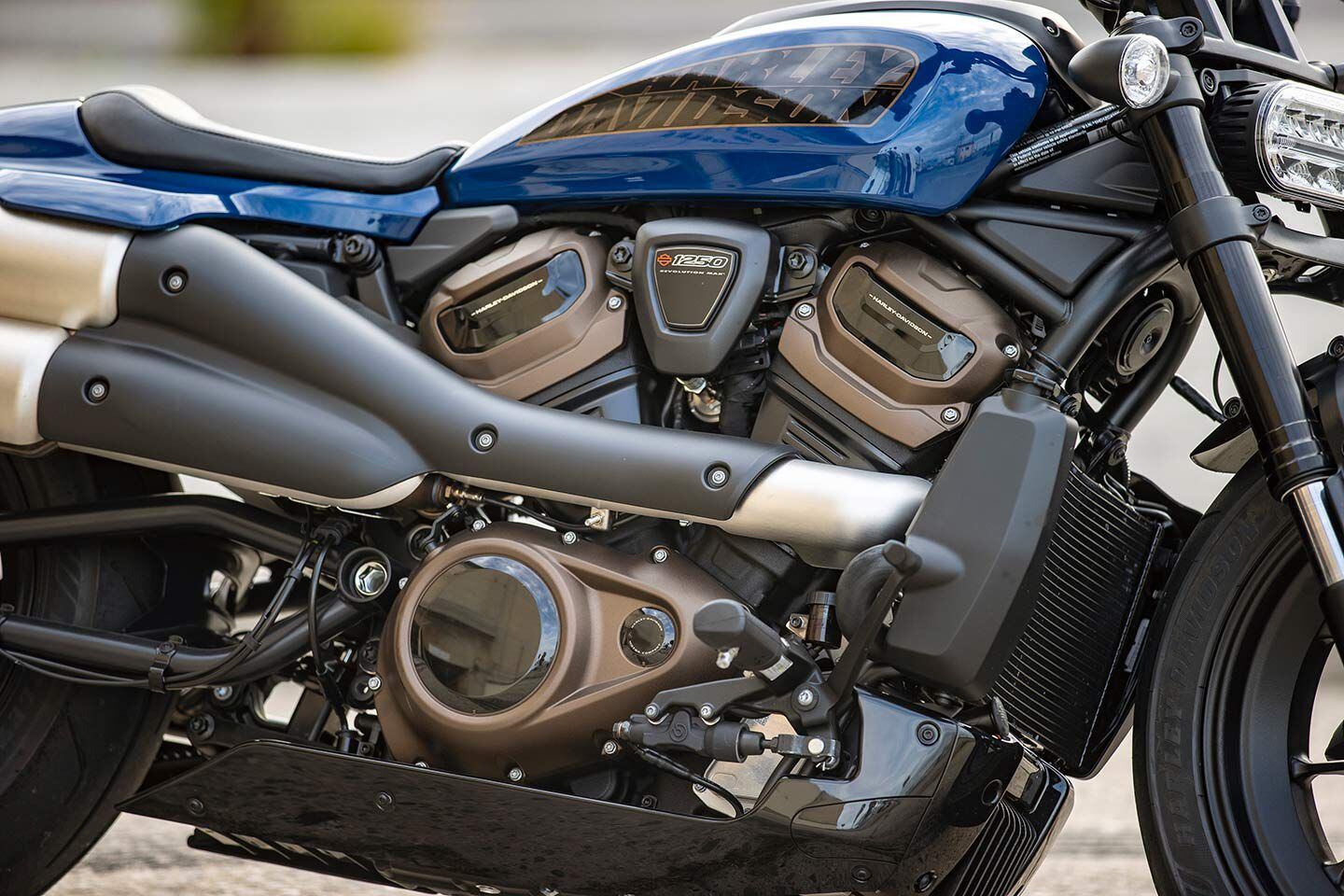
The Revolution Max 1250T looks nothing like a traditional Harley-Davidson engine. (Jeff Allen/)
The engine pulls double duty, acting as a stressed member of the chassis and removing the need for a traditional frame. In its place are a front frame, mid frame, and swingarm that mount directly to the engine, which is designed to be rigid so that it can act as a chassis component. And while that might limit how much the at-home builder can customize the Sportster S, there are benefits to this design, the biggest being reduced weight and a comparatively stiff “chassis” that’s better suited for spirited riding.
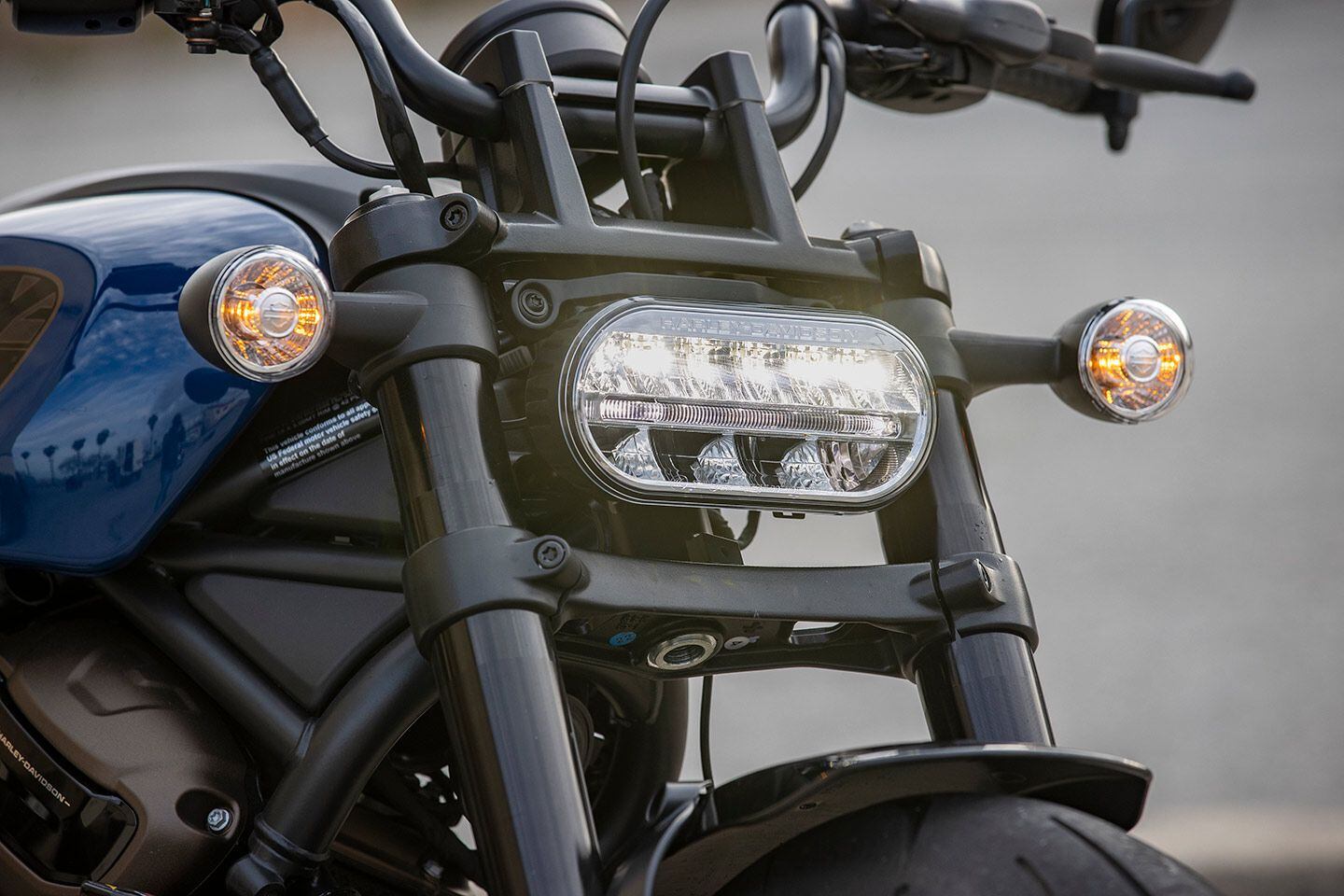
The Sportster’s engine is used as a stressed member of the chassis, meaning there’s no traditional frame. A trellis front frame bolts directly to the engine. Fork legs are spread wide to accommodate the chunky 160/70-17 front tire. (Jeff Allen/)
More hints at H-D’s performance-first approach come in the form of Brembo brakes and Showa suspension, the Sportster S rolling on a fully adjustable 43mm inverted cartridge fork and fully adjustable piggyback reservoir shock with hydraulic preload adjustment. Yes, there’s only one front brake disc, but at least it’s paired to a Monoblock caliper. More unfortunate is that the rear suspension has just 2.0 inches of travel, which contributes to the bike’s low, stocky stance but doesn’t help much at anything other than a standstill. Old habits die hard, and here Harley is acknowledging that stance still matters.
To build a sportier Sportster and not outfit it with the latest electronic rider aids would defeat the purpose, thus Harley-Davidson threw everything it had at the Sportster S. Three preprogrammed ride modes (Sport, Road, and Rain) are available alongside two Custom modes that the rider can build to their liking, with options for engine map, engine-braking, throttle response, and traction control. Not only do those Custom modes increase the versatility of the Sportster S, but they also help distinguish the more expensive Sportster S from the “entry-level” Nightster, which comes only with H-D’s three preprogrammed ride modes.
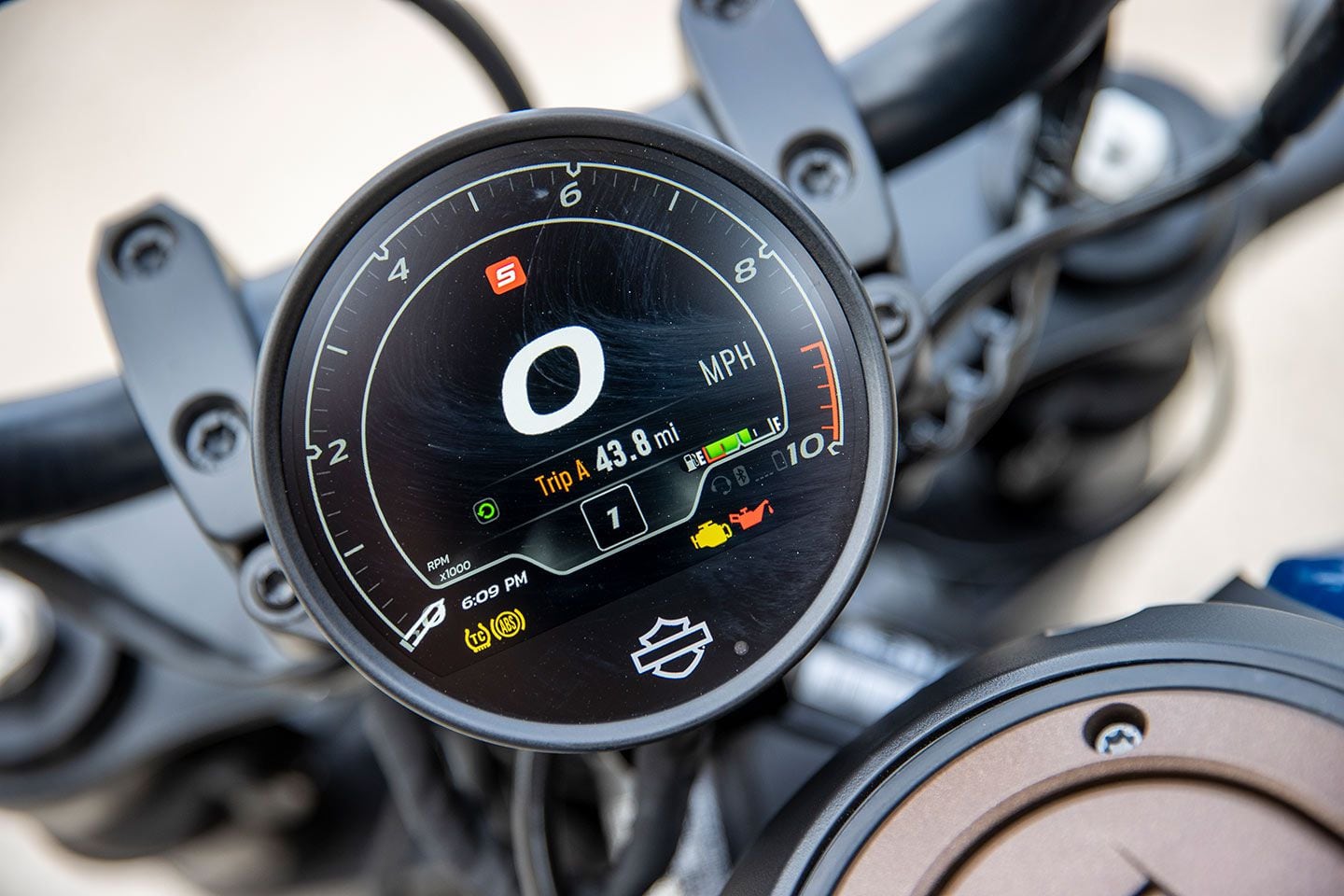
The 4-inch-diameter TFT display doesn't feel busy, and is easy to navigate when it comes time to adjust rider modes. (Jeff Allen/)
Harley’s Cornering Rider Safety Enhancements (RDRS) rider-aid suite adds an extra layer of safety, the Sportster S coming standard with such technology as lean-sensitive traction control with Rain, Road, and Sport settings. All of these systems are managed through a 4-inch-diameter TFT screen and Harley’s latest switch gear. Riders can connect the display to their Bluetooth device and headset, which allows them to listen to music, take calls, or even get navigation directions when using the Harley-Davidson App.
Riding Impressions
The best way to approach the Sportster S is to not think of it as a Sportster, or to allow yourself to be boxed in by what you think this bike is supposed to do.
Even just throwing a leg over the bike you’ll notice its flexibility; a rather accommodating rider triangle allows you to sit back in a relaxed position, at the middle of the seat in a more upright, commanding position, or leaned over the tank in a sportier riding position perfect for spirited canyon riding. You’re not locked in place or limited by traditional cruiser ergos that would otherwise make the bike feel out of place as the scenery changes.
Keep in mind that this is with the Sportster S model’s standard forward controls. Harley-Davidson offers a mid-control conversion kit ($693.95) that moves the footpegs to just under the seat, for a sportier riding position and to accommodate shorter riders. Great to have options, sure, but for anyone over 6 feet tall the forward controls feel more accommodating. Maximum stated cornering lean angle is 34 degrees on both sides, and that was more than enough to keep us from dragging pegs in most situations.
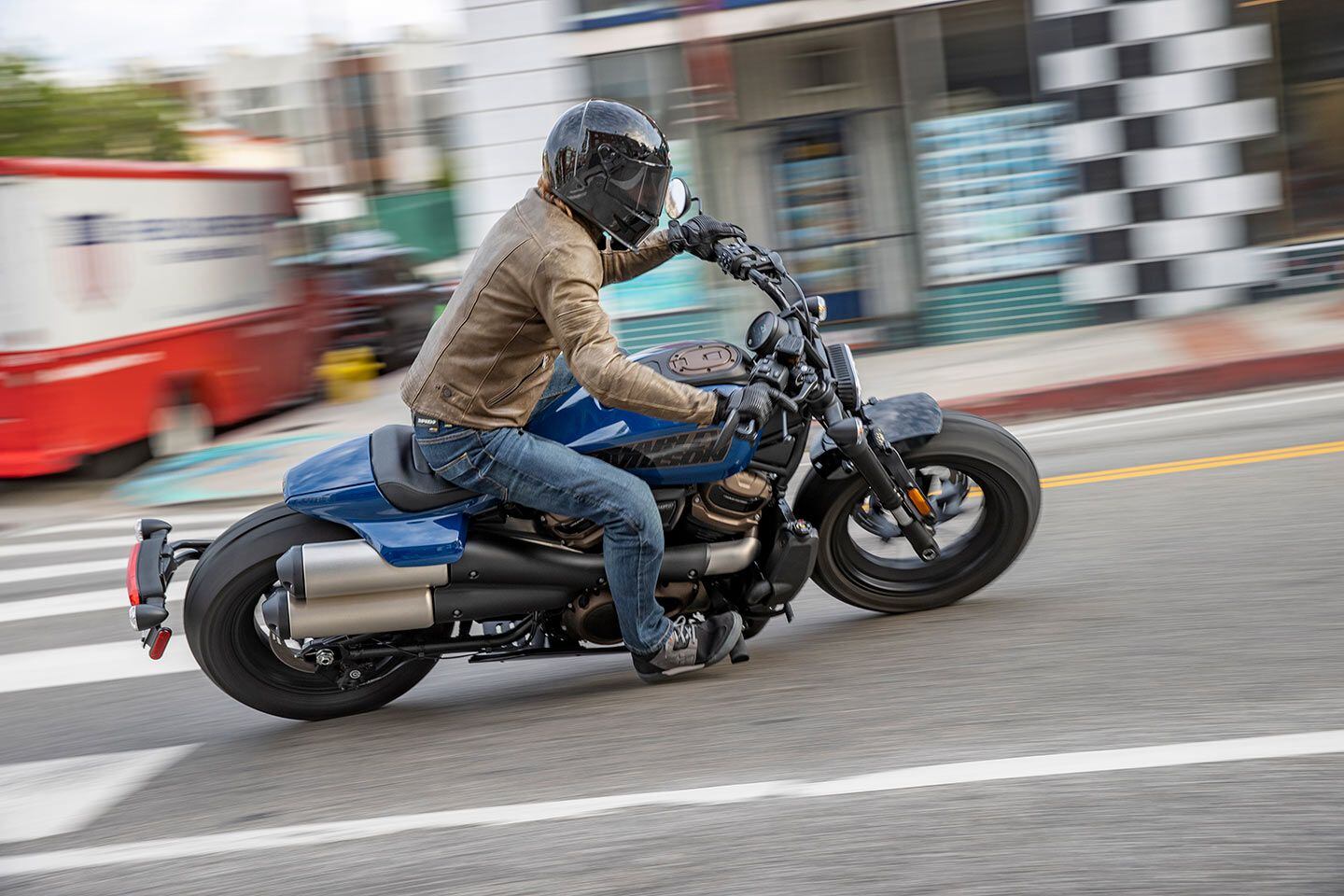
The Sportster S feels right at home on city streets. The real fun comes when you can crack the throttle on the Revolution Max 1250T engine. (Jeff Allen/)
It might feel strange reading about “going farther” on the Sportster S and “tackling the canyons,” but that’s what happens when you have an engine that’s as capable and fun as the Revolution Max 1250T, which is in many ways the best part of this bike.
VVT makes all the difference, allowing the engine to be smooth and controllable off idle but open up as the digital rev counter sweeps past 4,000 rpm. This is an extremely free-revving powerplant that isn’t limited in any situation, with a usable spread of power and enough over-rev past 7,000 rpm to keep you from constantly shifting. There’s very little heat from the engine or high-mount exhaust. The only real component we don’t love is the clutch, which has a light pull but limited feel through the lever travel. This can make it tough to launch the Sportster S when leaving a stoplight, especially if you’re using one of the less-responsive riding modes.
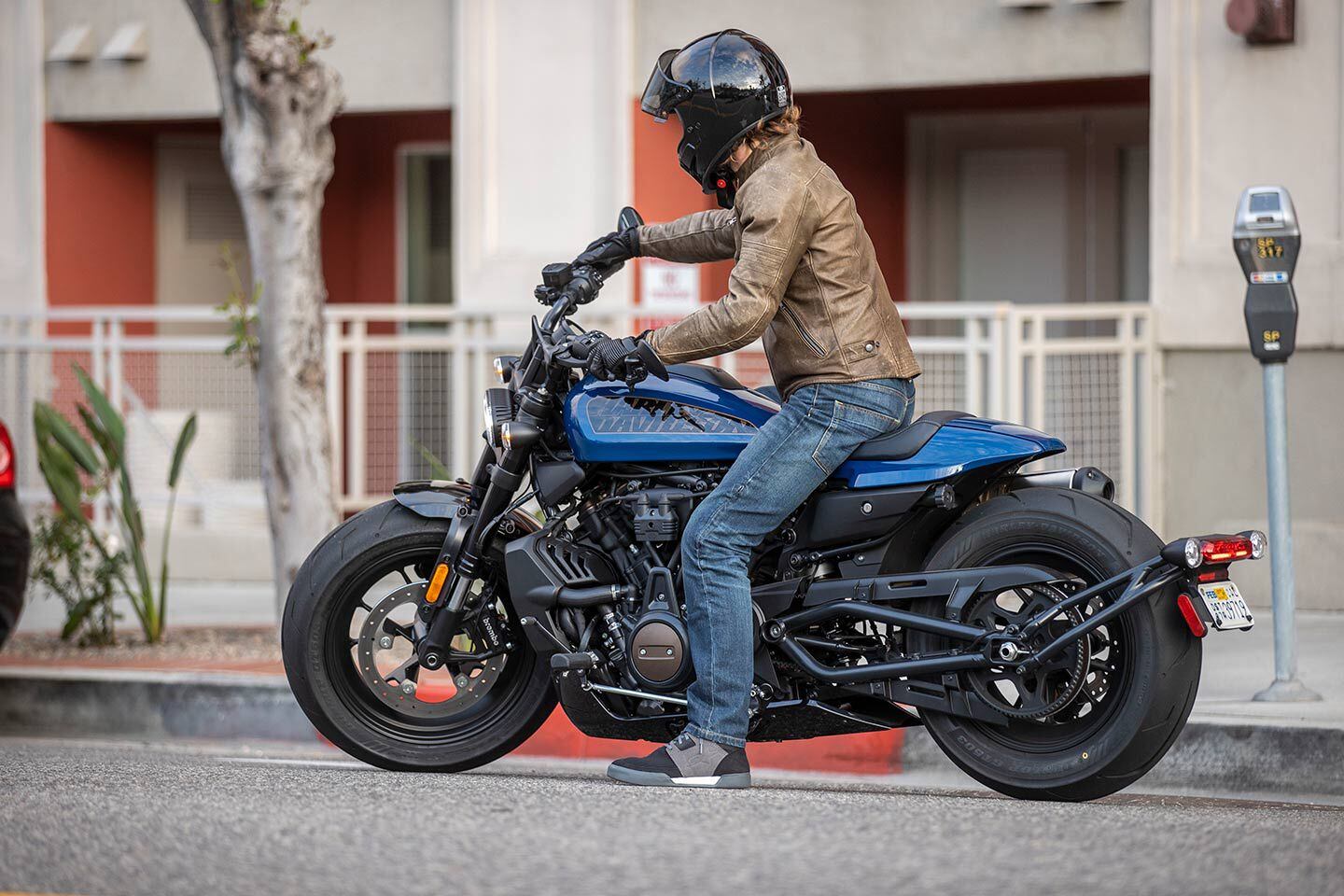
The left side of the Sporter S is a little busy. (Jeff Allen/)
The modes themselves add to the bike’s versatile nature, though the only preprogrammed mode we were drawn to was Sport, with its direct throttle response and linear power delivery. Road mode is OK when trudging through afternoon traffic, but in every other situation the tempered throttle response and limited clutch feel make it hard to get going in a way that resembles good, smooth riding. That’s a little bit ironic as we’d otherwise have argued that Road mode would help new riders get comfortable on the Sportster S before tapping into its full potential. If anything, this is an indication that Harley-Davidson is still getting comfortable with what electronic control is best for a platform like the Sportster.
There are of course more options, and ultimately we preferred a Custom ride mode with Sport Engine Map, Base Engine-Braking (five levels total), +1 Throttle Response (five levels total), and Sport Traction Control. We noticed very little difference between engine-brake settings. Another funny thing to mention is that the bike has an Off-Road Engine Map, a clear indication the system’s roots are in the Pan America. And seeing as how unlikely it is the Sportster S will go off-road, one could argue Harley should have taken the time to relabel or remove this. If nothing else, you can see how quickly H-D is working to bring these systems to new models.
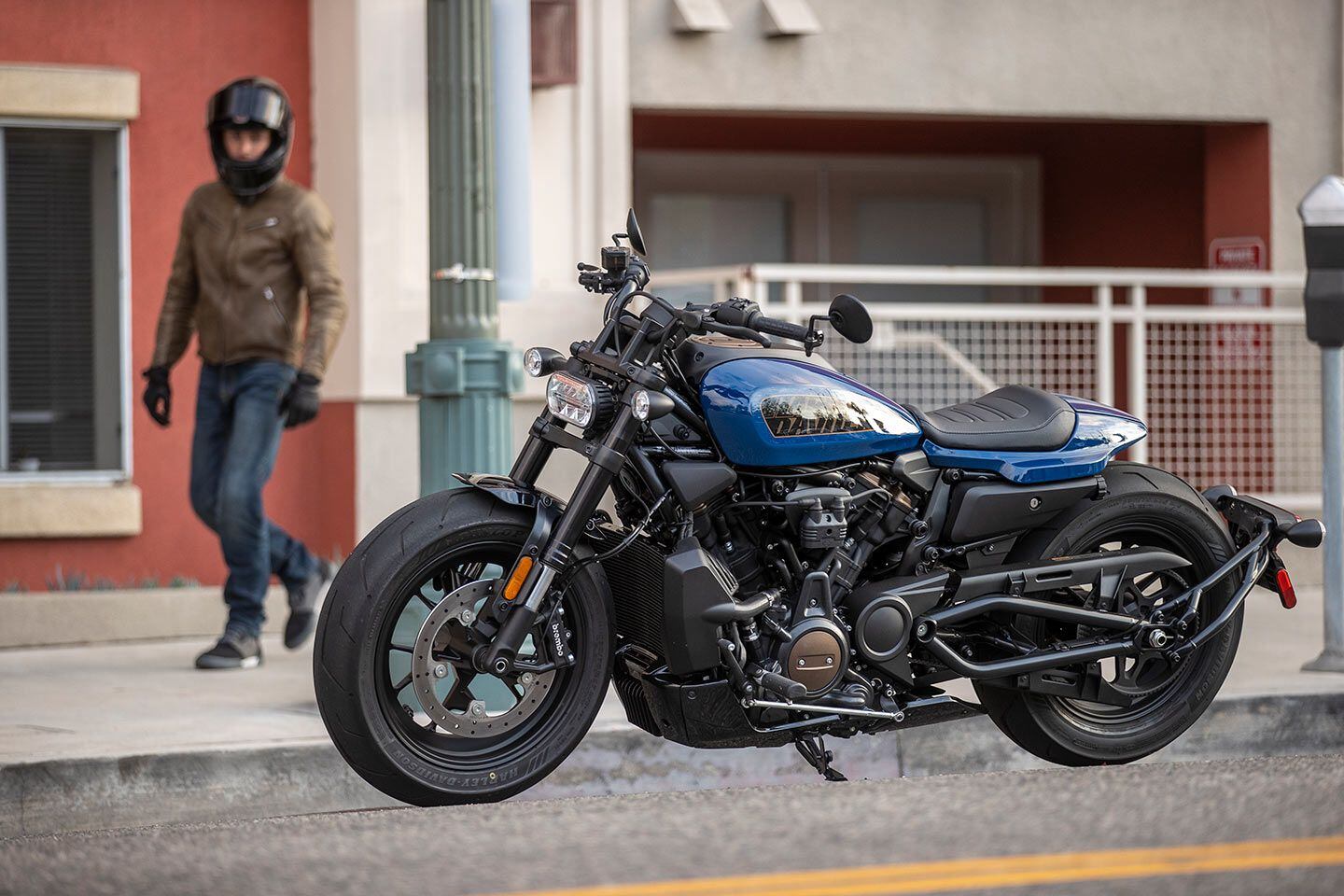
A single, 320mm front brake disc and Brembo Monoblock caliper keeps things simple while offering more than enough stopping power. Something else Sportster S owners should consider is front tire replacement; the 160/70-17 Dunlop GT503 sells for $299.95 on the Harley-Davidson website, a $120 premium over the more traditional 100/90-19 on the Nightster. (Jeff Allen/)
The engine does well in its role as a structural element of the chassis, which is to say the bike handles surprisingly well as you work your way up a winding mountain road. The bike remains planted and balanced, allowing you to drive through a corner in a way earlier Sportsters couldn’t unless you’d thrown thousands of dollars at an aftermarket catalog. The only problem here is that the 160/70-17 front tire and narrow handlebar make it heavy to steer, which limits how fast you can attack a set of turns. Even just gently adding front brake pressure in a corner will make the bike stand up, and making small line adjustments midcorner requires effort.
So no, this isn’t a sportbike. But it is a great option for the rider who wants to chase down KTM 390 Dukes on a “cruiser.”
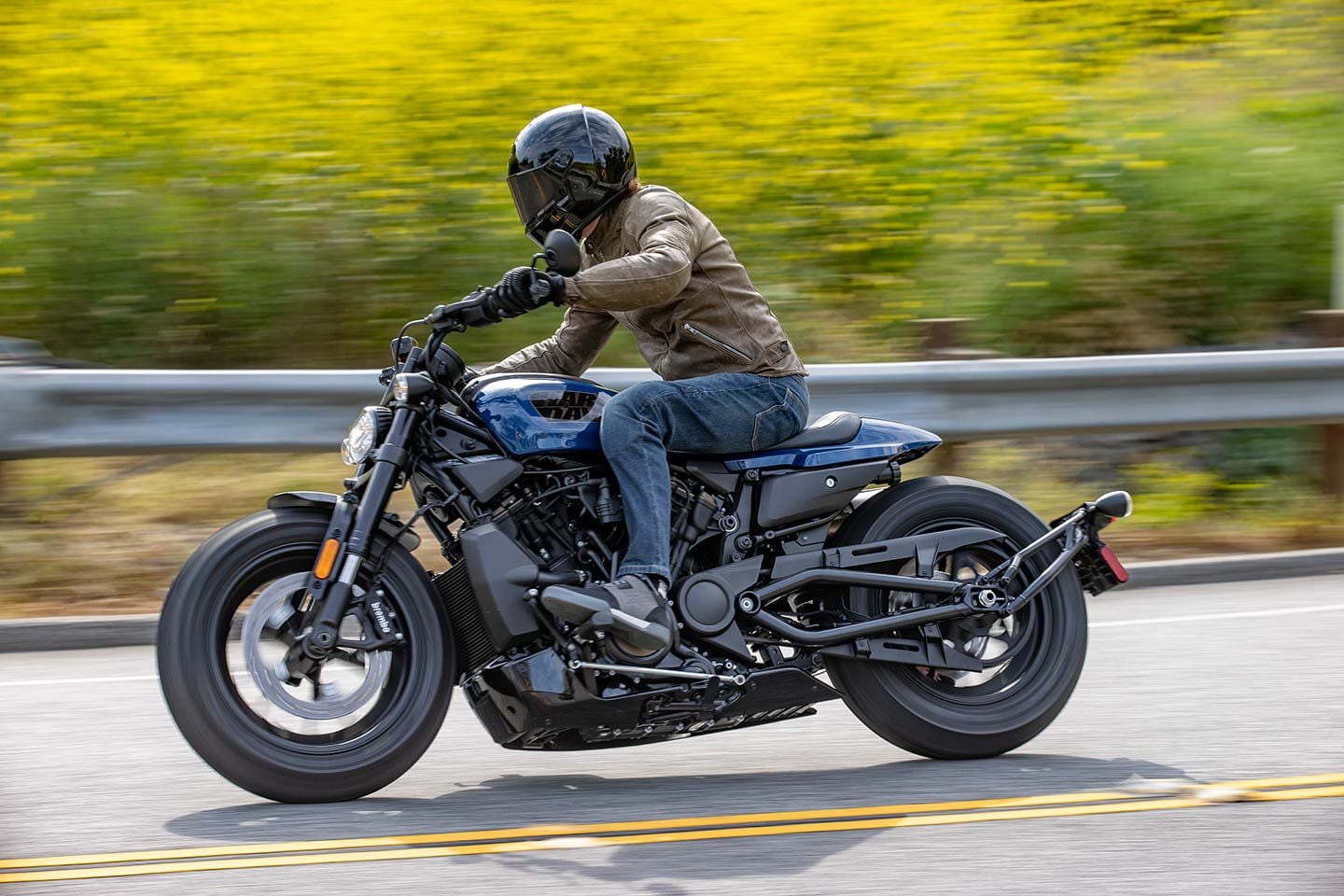
Once you get past the heavy turn-in, the Sportster S is a lot of fun on a canyon road. (Jeff Allen/)
Mind you, that rider will find other limitations, the biggest one being the rear suspension. Two inches of travel isn’t enough to smooth out even moderately bumpy roads, and it’s not long before your back is starting to curse the Harley design team that decided this was the best solution, as there’s essentially no suspension change you can make to get around that limited travel. Fortunately, the Showa fork offers a lot more in the way of bump absorption and road holding, and it’s easy enough to adjust the clickers with a flat blade, for more support during spirited riding. Once heading back to the highway, we’d simply pull compression damping back out and be on our way.
The performance that Harley has pumped into this package makes you wonder about the Bronx naked bike that Harley teased in 2018. Harley is limited by what it can do with the Sportster S while maintaining a traditional cruiser stance, but that wouldn’t be the case with a true streetfighter. Harley-Davidson reps say they “have not officially ever said if it was coming to market or not,” but riding the Sportster S strengthens the desire for that bike, particularly because of how good this engine is.
More laid-back riding gives you a chance to appreciate the areas where Harley has made advancements in recent years, which in this case means the gauge cluster and switch gear. That display is covered in nonreflective glass so that it’s easy to read in any lighting, and the new control layout Harley-Davidson is using makes it incredibly easy to navigate through the rider-aid options. The same can be said for navigating music options with the buttons on the right side of the handlebar. We’re glad to not have turn signal buttons on each side of the handlebar too—more small signs that Harley is willing to leave some things in the past.
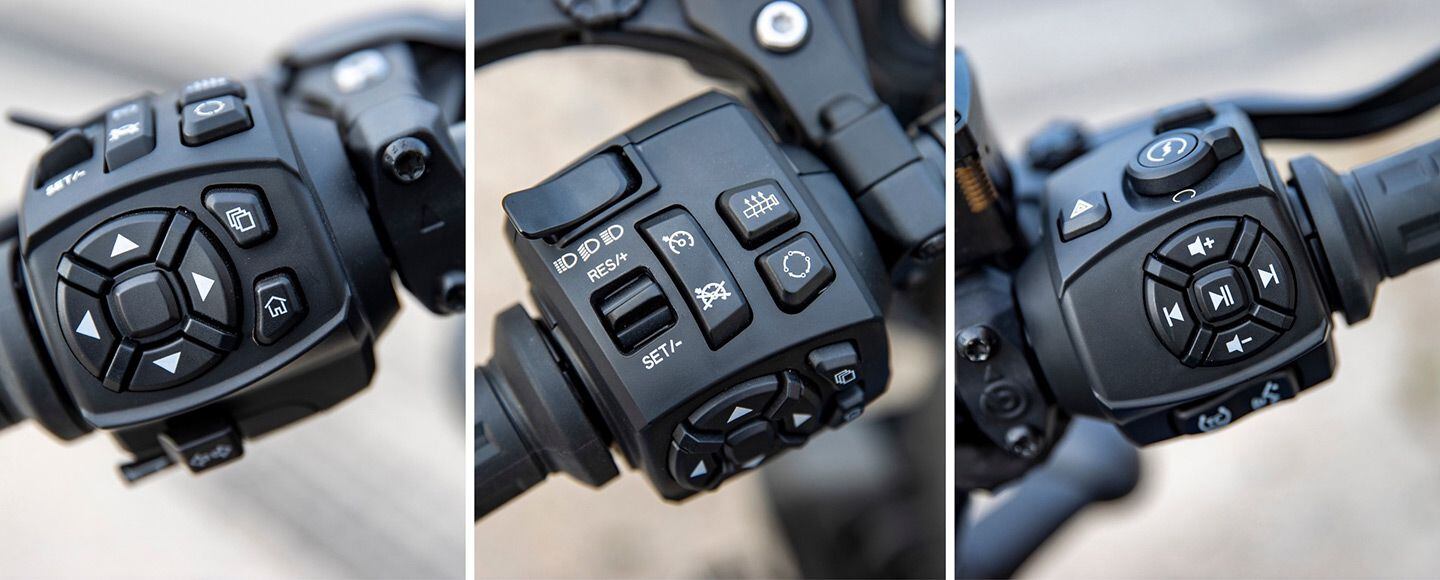
Harley-Davidson’s latest switch gear is a step in the right direction and overall very easy to use. The bike is prewired for heated hand grips (notice the heated grips button), but those grips need to be purchased separately. (Jeff Allen/)
Final Thoughts
Perhaps the best compliment we can give the Sportster S is that we didn’t walk away from the test missing the old Sportster. There will always be comparisons to that platform, sure, but Harley-Davidson has done well to make the Sportster S excel in ways the old bike never could. This Sportster has the potential to work for more people of different riding skill and experience, as the performance potential is so much higher than any Sportster that came before it.
Mind you, performance and a more expansive electronics package comes at a cost. MSRP for the 2023 Sportster S is $16,399, a $2,900 premium over the entry-level but still costly Nightster, which is priced at $13,499. You can’t help but feel like Harley-Davidson is ignoring potential new riders with this high barrier to entry. For reference, MSRP for the 2021 Iron 1200 was just $9,999, with the upgraded Forty-Eight at $11,459.
The other concern is in how much the limited rear travel impacts the experience. This is a genuinely impressive platform in terms of engine and handling, but that matters very little if the only thing your lower back remembers is every pothole you pummeled through on your way up to the canyons. Perhaps this would matter less if we hadn’t been teased with the Bronx, which would almost certainly offer all of the same performance as the Sportster S but in a platform with sportbike-like suspension that would be more suitable to the spirited riding that the Sportster S encourages.
Those who are willing to sacrifice a little comfort for a traditional cruiser stance will be rewarded with a fully modern bike that’s a balance between style and performance. But that person must place more value on power and technology, because that is what defines the modern Sportster.
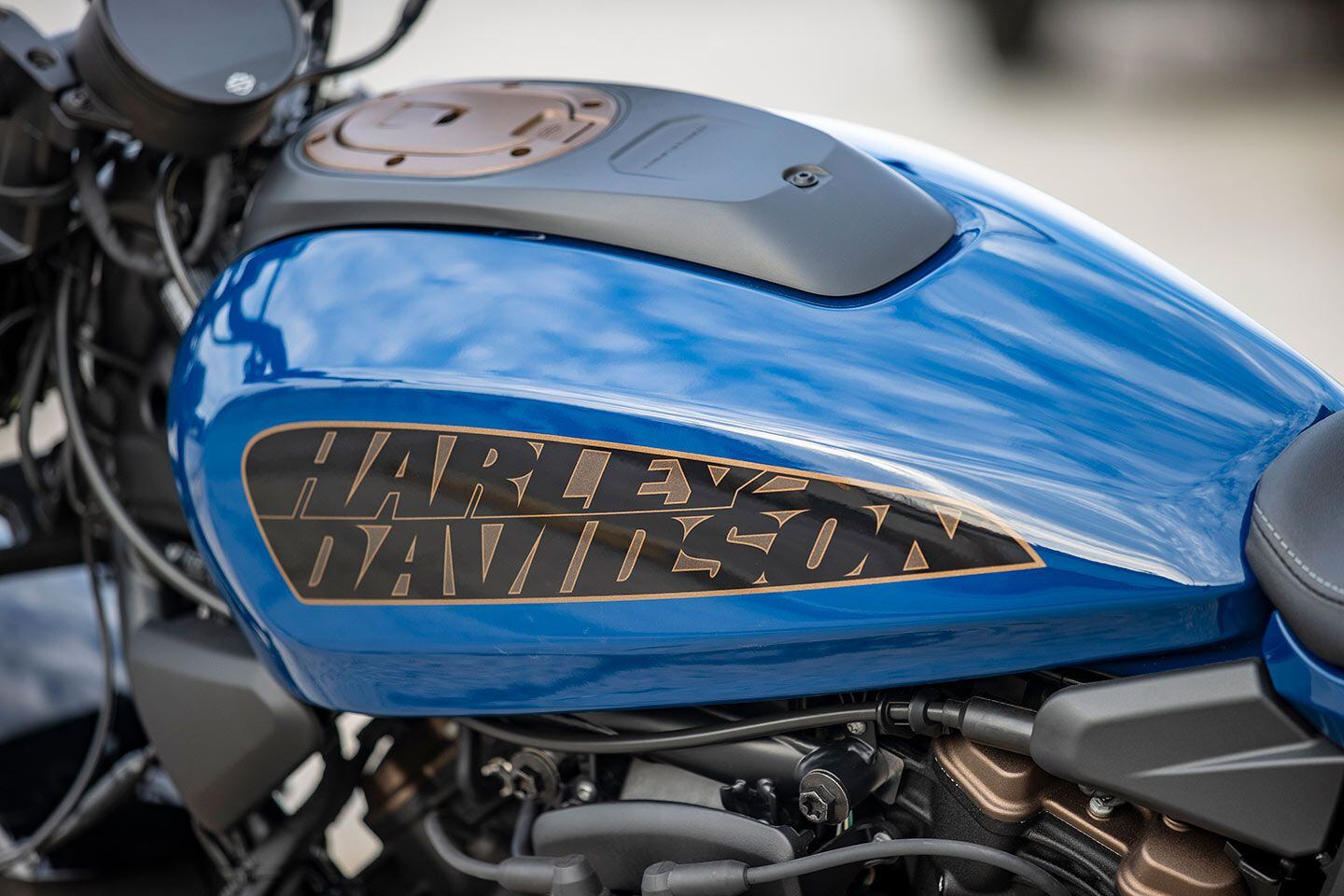
A 3.1-gallon tank sets the tone, and doesn’t allow you to go too far. The bulk of our fuel stops were done in under 100 miles. (Jeff Allen/)
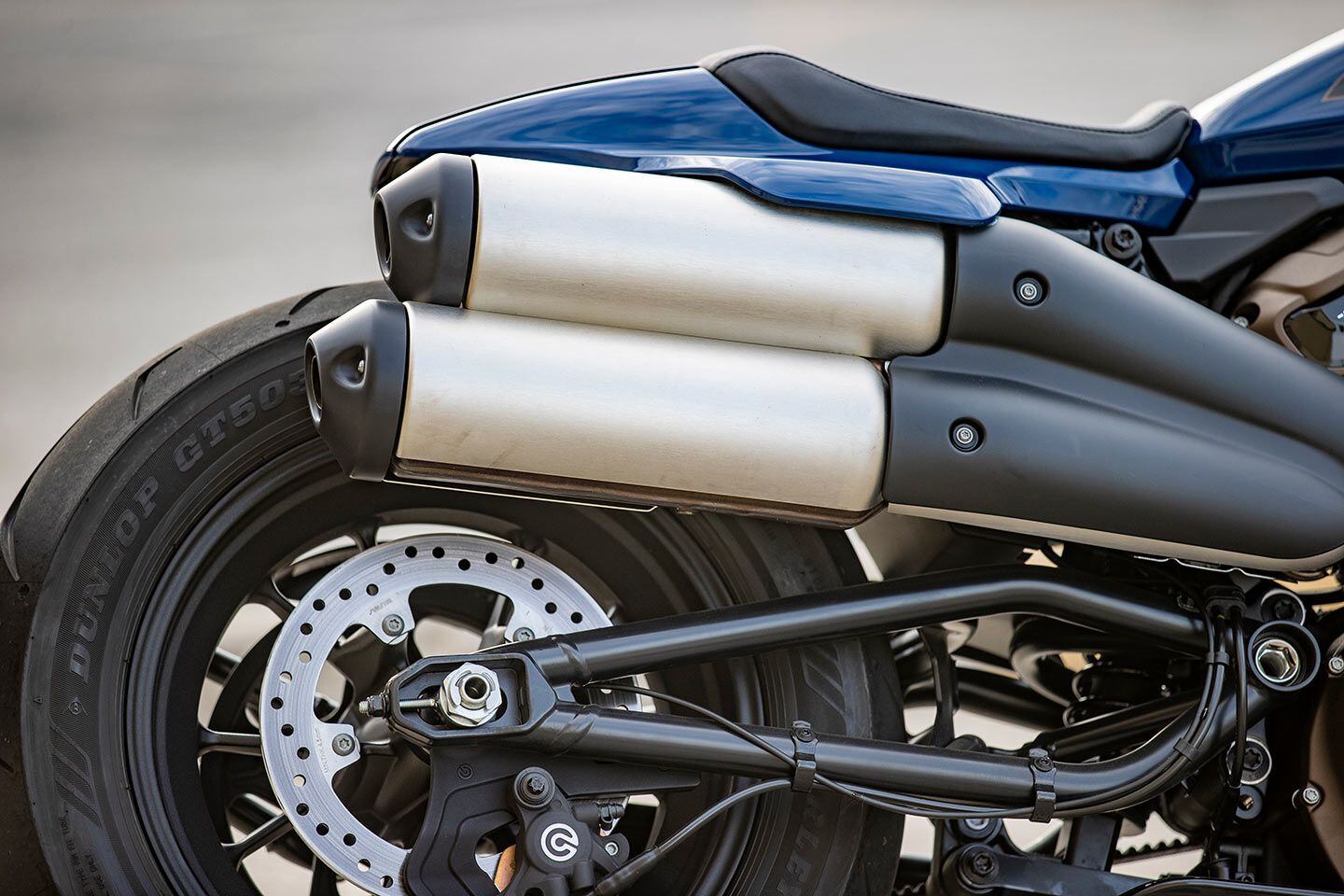
The high-mount exhausts don’t get in the way nearly as much as you’d expect. The seat is thin, but nice in that you can move around on it easily. (Jeff Allen/)
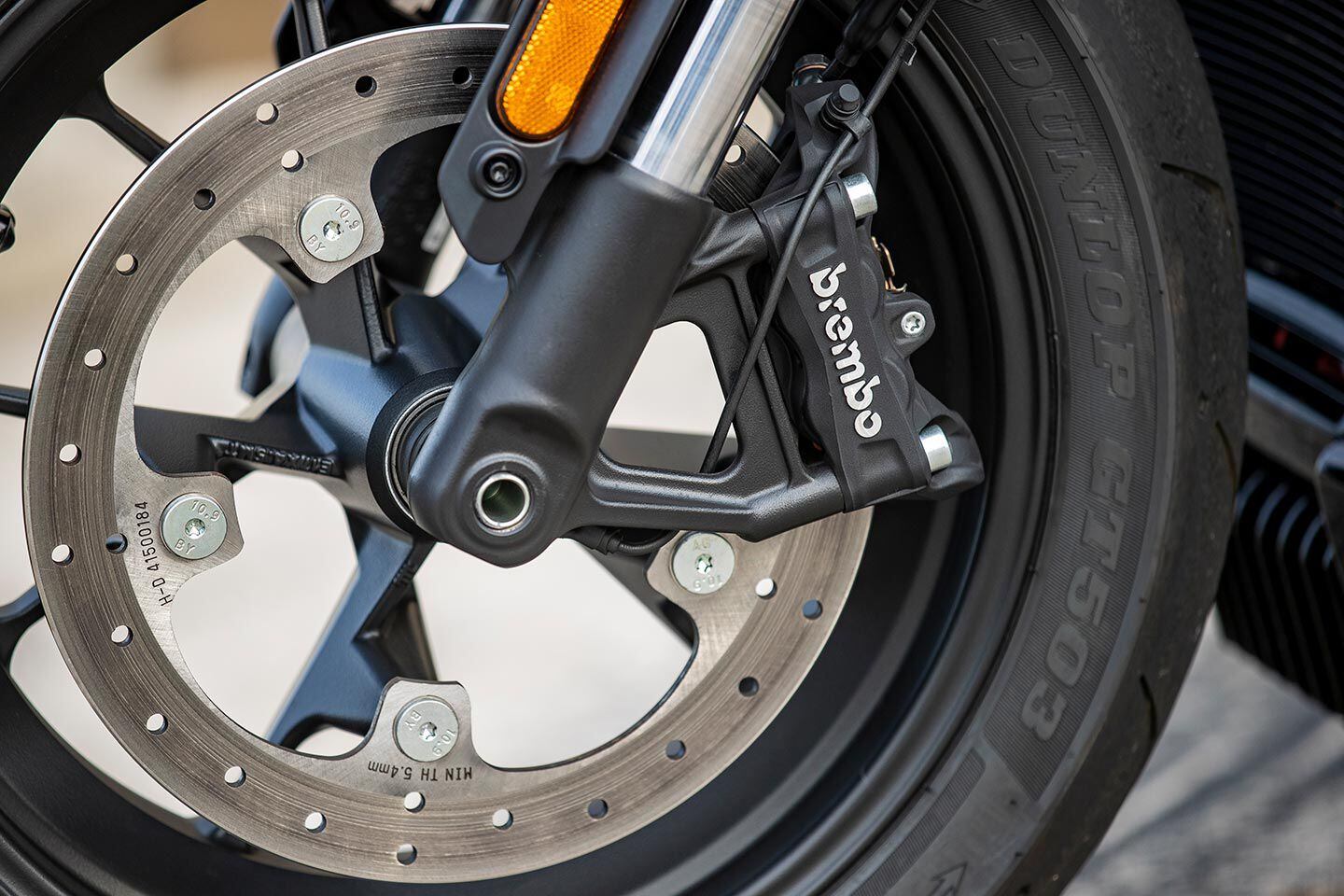
Closer look at the Sporter S front brake. (Jeff Allen/)
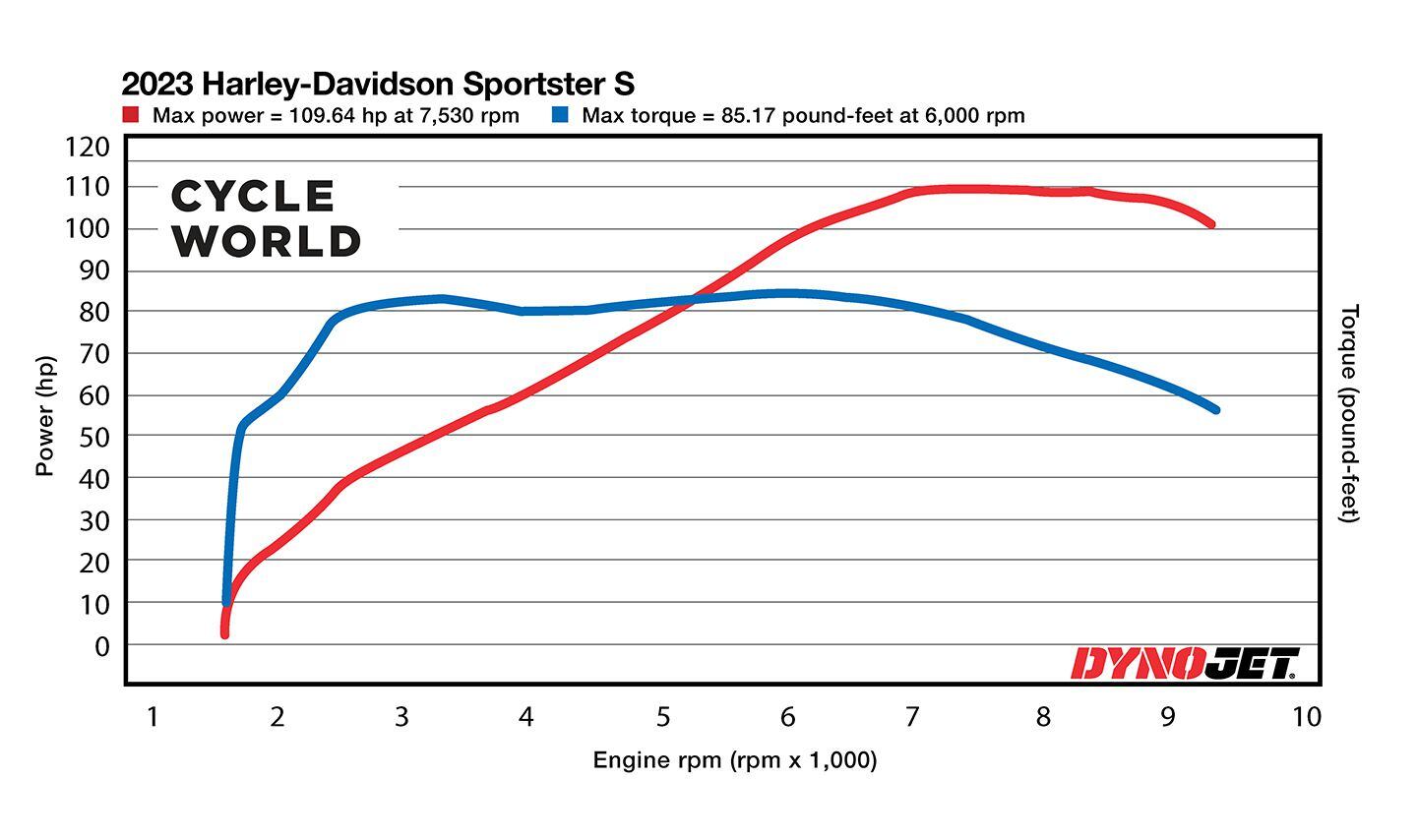
The Sporter S uses a Revolution Max 1250 engine that’s been updated for more low and midrange torque. (Robert Martin/)
2023 Harley-Davidson Sportster S Specs
| MSRP: | $16,399 |
|---|---|
| Engine: | DOHC, liquid-cooled, 60-degree V-twin w/ variable valve timing; 4 valves/cyl. |
| Displacement: | 1,252cc |
| Bore x Stroke: | 105.0 x 72.3mm |
| Compression Ratio: | 12.0:1 |
| Transmission/Final Drive: | 6-speed/belt |
| Cycle World Measured Horsepower: | 109.6 hp @ 7,530 rpm |
| Cycle World Measured Torque: | 85.2 lb.-ft. @ 6,000 rpm |
| Fuel System: | EFI w/ 50mm throttle bodies; ride-by-wire |
| Clutch: | Wet, multiplate w/ assist and slip |
| Engine Management/Ignition: | Electronic |
| Frame: | Steel trellis frame w/ stamped, cast, and forged junctions, and forged aluminum mid-structure |
| Front Suspension: | Fully adjustable Showa 43mm inverted fork; 3.6 in. travel |
| Rear Suspension: | Fully adjustable Showa monoshock; 2.0 in. travel |
| Front Brake: | Radially mounted Brembo Monoblock 4-piston caliper, 320mm disc w/ Cornering ABS |
| Rear Brake: | Brembo 1-piston floating caliper, 260mm disc w/ Cornering ABS |
| Wheels, Front/Rear: | Cast aluminum; 17 x 4.5 in. / 16 x 5.0 in. |
| Tires, Front/Rear: | Dunlop Harley-Davidson Series Radials; 160/70R-17 / 180/70R-16 |
| Rake/Trail: | 30.0°/5.8 in. |
| Wheelbase: | 59.8 in. |
| Ground Clearance: | 3.5 in. |
| Seat Height: | 29.6 in. |
| Fuel Capacity: | 3.1 gal. |
| Average MPG: | 39.3 mpg |
| Cycle World Measured Wet Weight: | 508 lb. |
| Contact: | harley-davidson.com |
GEARBOX:
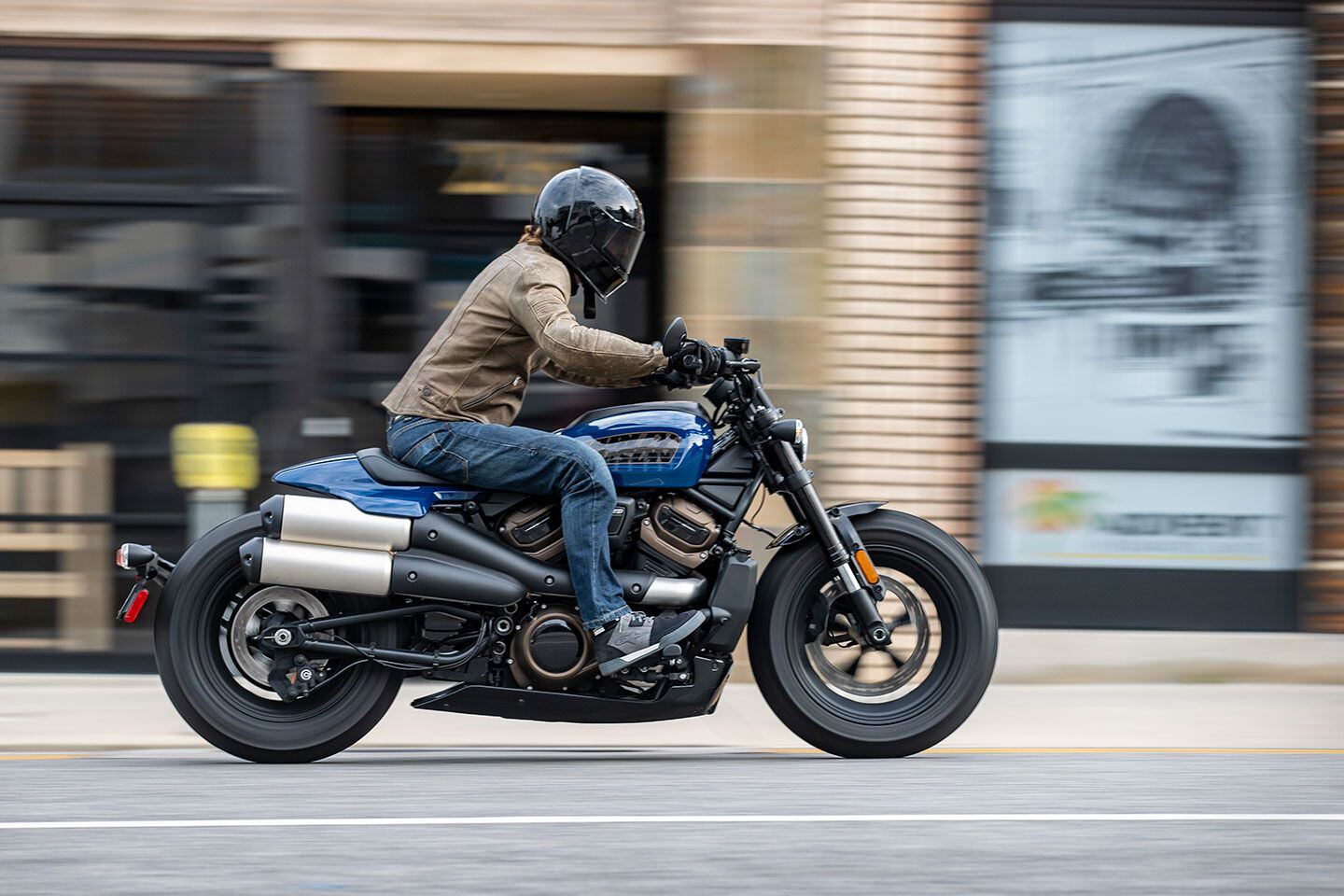
2023 Harley Davidson Sportster S (Jeff Allen/)
Helmet: Bell Eliminator Helmet
Jacket: Spidi Garage Jacket
Pant: Spidi J-Tracker Tech Denim
Gloves: Spidi Garage
]]>Taking a close look at Harley-Davidson’s 131R engine used in its factory King of the Baggers racing effort. (Harley-Davidson/Brian J. Nelson/)
First big obvious thing about the Harley-Davidson King of the Baggers racer bike is its strong, deep sound. Its syncopation comes from its irregular firing intervals, which result from the engine’s since-the-beginning 45-degree Vee angle. On the track its usual operating rev band is 6,000–7,000 and it sounds remarkably like one of the classic big radial aircraft engines of World War II—powerful and authoritative.
M-8 131R crate engines are delivered to product development where they are modified for KOTB use. Bore and stroke are 4.310 x 4.5 inches. That stroke was created for the M-8 114 engine. “M-8″ tells us these are “Milwaukee-Eight” engines, meaning they have a single chain-driven four-lobe camshaft operating four valves per cylinder through pushrods by means of newly designed and longer rockers unburdened by old-time screw-and-nut adjusters. Equal valve operation is guaranteed by holding dimensional tolerances. 131R heads are CNC-ported and combustion chambers are fully machined, giving 10.7 compression. The cam supplied is SE8-517. Valves are 1mm oversize.
These heads have dual ignition with a centrally mounted solenoid-driven timed decompression valve to assist starting.
Not so long ago the realists in NHRA Pro Stock Auto got really tired of trying to design camshafts whose wiggly shape would compensate for the constant flexing of the camshaft itself between its bearings, of the pushrods, of the rockers. Instead, they focused on improving control by making the parts much stiffer. In the old days stiffer meant heavier, and heavier meant valve float. Be that as it may, today’s approach to pushrod valve control is to use really stiff components. And it has worked.
Related: From Road Glide to Roadrace
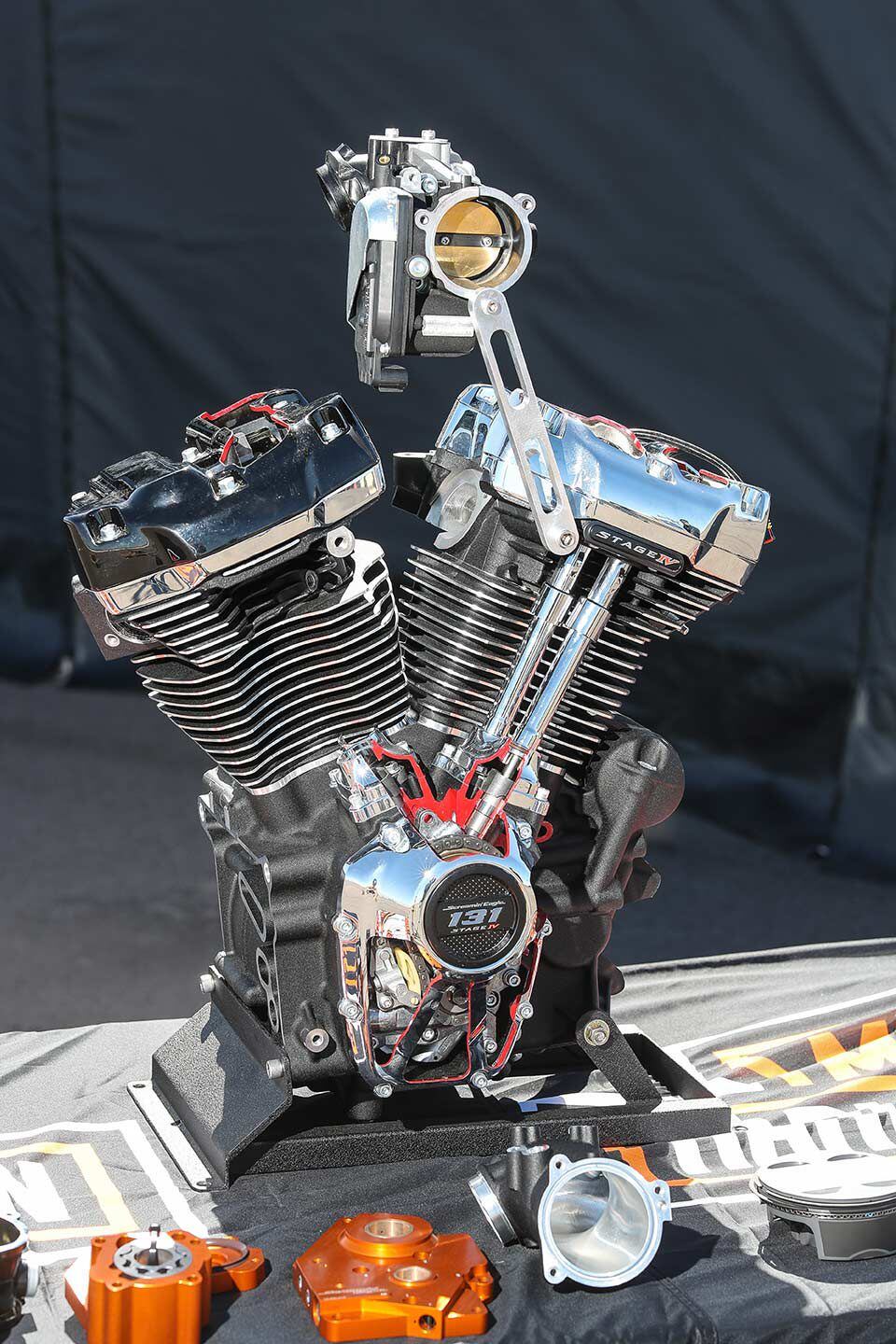
Forged pistons in a 4.310 bore stroke through 4.5 inches in the 131R. (Harley-Davidson/Brian J. Nelson/)
When engineers need to know the details of valve motion at speed, they go to the “Spintron” which drives the valve train with an electric motor while monitoring valve position to high accuracy by light interferometry. Analysis reveals the natural frequencies of the flexing parts.
That 4.5-inch stroke is a long way to go at 7,000 rpm. Makes me think of England’s Manx Norton racing 500 singles, which began to break crankpins without warning in the 1950s, as peak revs reached 7,000. Their stroke was 78.4mm, or 3.086 inches—only 69 percent of that of this 131R. Let’s next compare piston accelerations at 7,000 revs. For the Manx it was 2,638 times the acceleration of gravity (2,638 Gs), while for this KOTB Harley it is 46 percent greater at 3,847 Gs. When I asked a team engineer about crank reliability I was told, “Really good. Really, really good.” That’s because of two differences between modern and classic Harley engines. First, large-diameter straight crankpins pressed in place replaced the spindly taper-and-nut pins used 25 years ago. This greatly increases strength and raises the “elephant ears flapping” frequency of the flywheels and crankpin vibrating as a giant tuning fork. And second, the fatigue resistance of bearing roller materials has been hugely increased since the ‘50s, driven by the needs of aircraft gas turbines.
On the other hand, because rules allow achieving the displacement limit by any desired combination of bore and stroke, team principal Jason Kehl said, “We may play with it.”
This engine’s peak piston acceleration at 7,000 rpm is far from excessive, considering that F1 engines of 15 years ago were pushing 10,000 Gs.
Looking at a cutaway 131R engine displayed outside the race tent all I could see was an arc of the flywheels and the upper parts of the forged steel rods (which are still of classic fork-and-blade construction). That engineer, following my gaze, continued to assure me that rod design has been greatly improved by application of Finite Element Analysis, in seeking to reduce stress concentrations. Somewhere, on some engineer’s computer, there is a false-color stress comparison of old and new rods. We’d all love to see it.
The production 131R has a single gear-driven balancer that reduces primary shaking force about 75 percent. It is deleted from the race engine.
When I picked up a 131R forged piston from the table on which the cutaway was resting, it had the smoothly curving organic shape I have come to expect from FEA-designed parts. I can only call it beautiful—something that John Britten would have admired. It is a very short “ashtray” design, its skirts coated with a dark anti-friction break-in coating. The light weight of such pistons is fundamental to reliable operation at 7,000 with so long a stroke.
Normally, such a short-skirted piston could not be expected to maintain the cool crown temperature that is essential to preventing an engine from detonating (knock, or detonation, is a destructive abnormal form of combustion provoked by exposure of the unburned mixture to high temperature). Light modern pistons coexist with air-cooling in this engine because of oil cooling from jets in the crankcase, aimed up at the undersides of the piston crowns. The essential details of this engine are thoroughly engineered by modern methods. The traditional appearance—as a 45-degree air-cooled pushrod V-twin—is maintained.
Related: Why King of the Baggers Racing Is So Popular
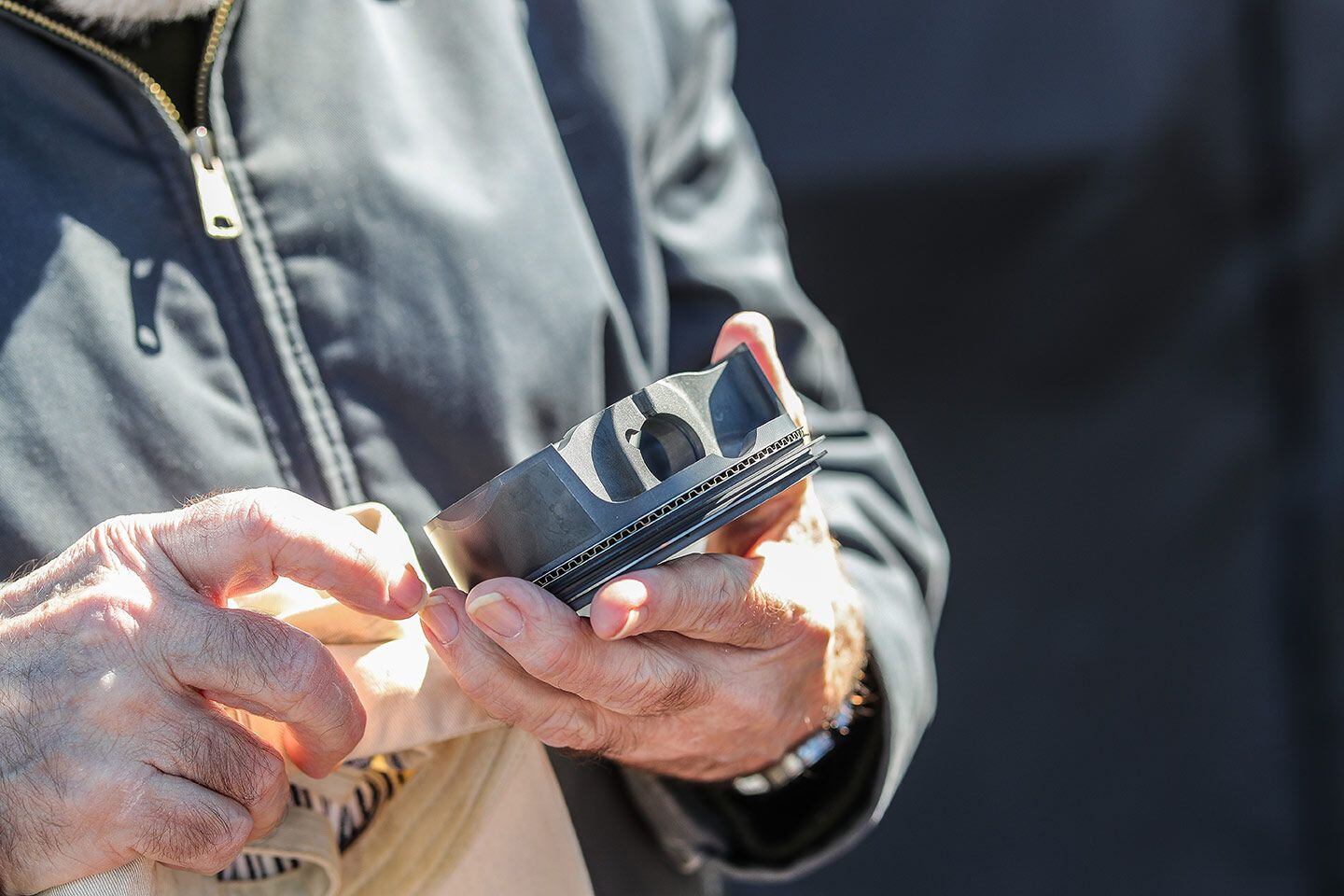
Holding a 131R forged piston reveals a short skirt and organic shape. (Harley-Davidson/Brian J. Nelson/)
The pistons used in the KOTB bikes are machined from the same forging as the piston I saw, which had only the slightest fly-cuts in its crown for valve clearance. The race pistons surely offer more compression (the class operates on a spec fuel, VP’s T4) and perhaps have deeper fly-cuts to allow valve lifts greater than the 0.515 inch of the SE8-517 cam.
Higher lift? Classic production torque curves were shed-roof shaped. The high peak of the roof was very high torque at low revs, sloping down as the engine revved up because of what engine pioneer Harry Ricardo called “wire-drawing.” The higher the engine revs, the harder it is to pull enough air through an intake system dimensioned to deliver peak torque at lower revs.
That has changed somewhat in recent years, moving toward a “haystack” torque curve peaking in the 3,000 to 3,500 rev range where on-ramp acceleration and passing take place. Below and above that peak, less torque is needed.
For a racing engine, the need for power pushes everything to the right, to higher rpm. I was told the KOTB engine spends a lot of its time between 6,000 and redline at 7,000. That in turn requires increased valve lift (and, likely, later intake valve closure and increased overlap) as means to allow a good cylinder charge to be taken in in less time (at 3,500 revs, the intake event takes maybe 0.009 second, but at 6,000 that dwindles to 0.006 second). Something has to compensate for the shorter time.
Rules require use of a stock gearbox. When I wrote out the ratios it was immediately clear that sixth is a touring overdrive in which rpm at a given road speed falls 19 percent to reduce vibration. That big gap means it’s not going to be used much on a roadrace course because that much rev drop at upshift pulls the revs down enough to compromise acceleration. Conversation with team members revealed that first is little used after the start. What is the result? In effect, this class is using a four-speed gearbox. That in itself places some limitations on how narrowly the engine can be tuned.
If we decide the engine makes 160 hp at 7,000 rpm, that implies a stroke-averaged net combustion pressure (or bmep, as engineers term it) of 138 psi. This is about two-thirds of what is achieved in a mature purpose-designed racing engine, and it makes sense because the KOTB class is young. There’s a lot of tuning territory left to exploit. The more power you make, the more cooling you need. Keep an eye on oil cooler sizes.
The present engine is served by a single giant throttle body and a billet CNC-contoured Y-manifold about the size of a softball. One possibility, should more power be required, would be what was done to the XR-750 years ago—giving each cylinder its own separate and straight-in intake system (where would you put it?). In the present system, the single throttle body faces to the right and a bullet-shaped air filter assembly points straight ahead.
Related: Harley-Davidson Prepares for Daytona
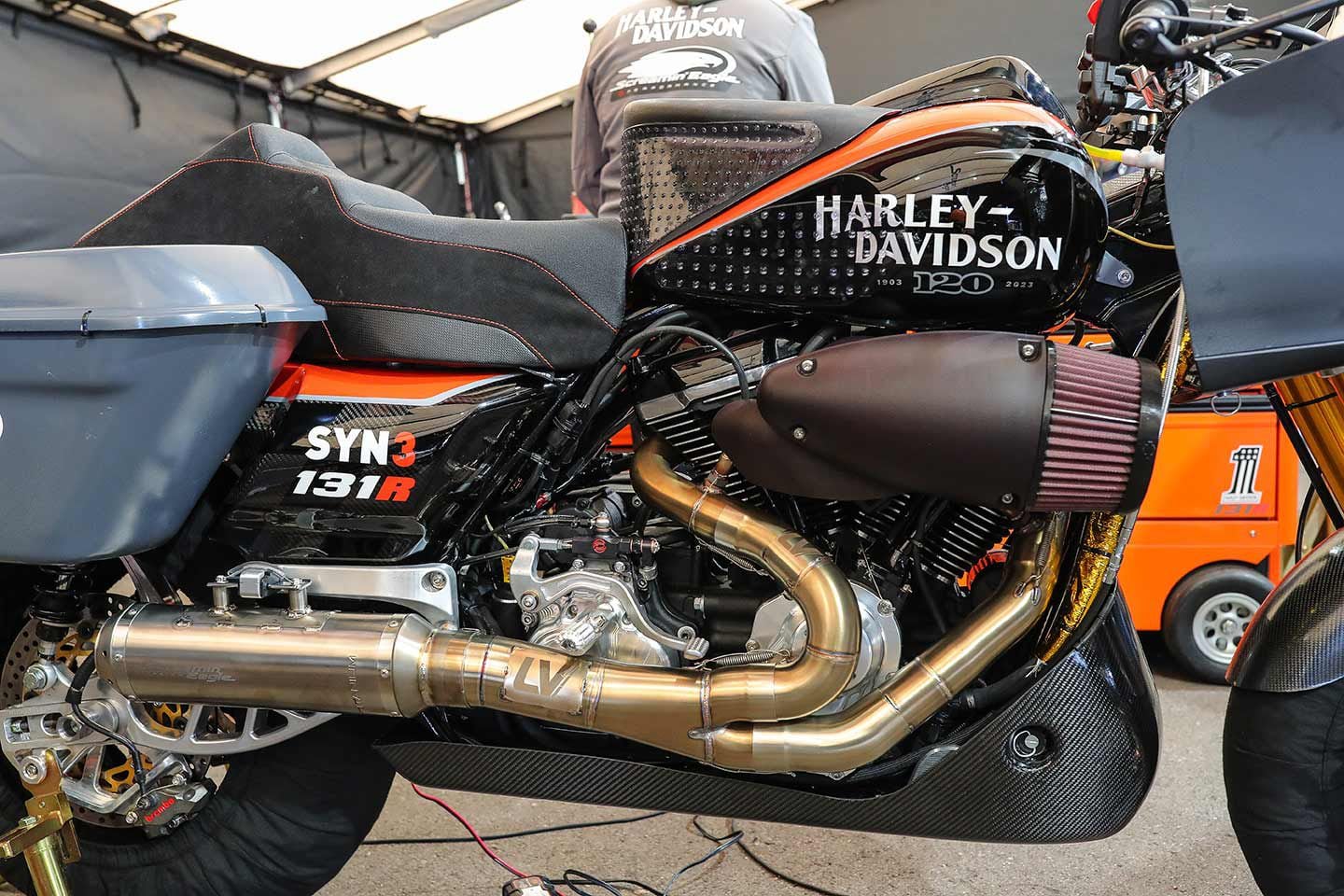
A massive bullet-shaped air intake feeds the 131R’s single throttle body. (Harley-Davidson/Brian J. Nelson/)
It has never been easy to control temperatures in air-cooled engines, which naturally run hotter on hot days and cooler on cool ones. When I asked one of the crew if they’d been able to get their engines to detonate, he replied, “Oh yes! Thermal management has required some serious work.”
I had seen welded-on cooling fin extensions on the 2022 bike, but they are no longer used. I was told, “Getting air to the rear head is crucial.” A substantial air scoop on the left side serves that purpose (you can’t cool anything with air already heated by passing through the hot fins of another cylinder). Team principal Kehl noted that the usual place for a racebike cooler is under the fairing nose, but on this bike that would block airflow to both heads. Therefore the large cooler is located up in the frame-mounted fairing, replacing the lights. Think of the cooler as an “infrared headlight.” I was pleased to see rock screens on these coolers. Racebikes kick up little stones from track surfaces—you don’t want them hitting a heat exchanger core or getting between a drive belt and pulley at 250 feet per second.
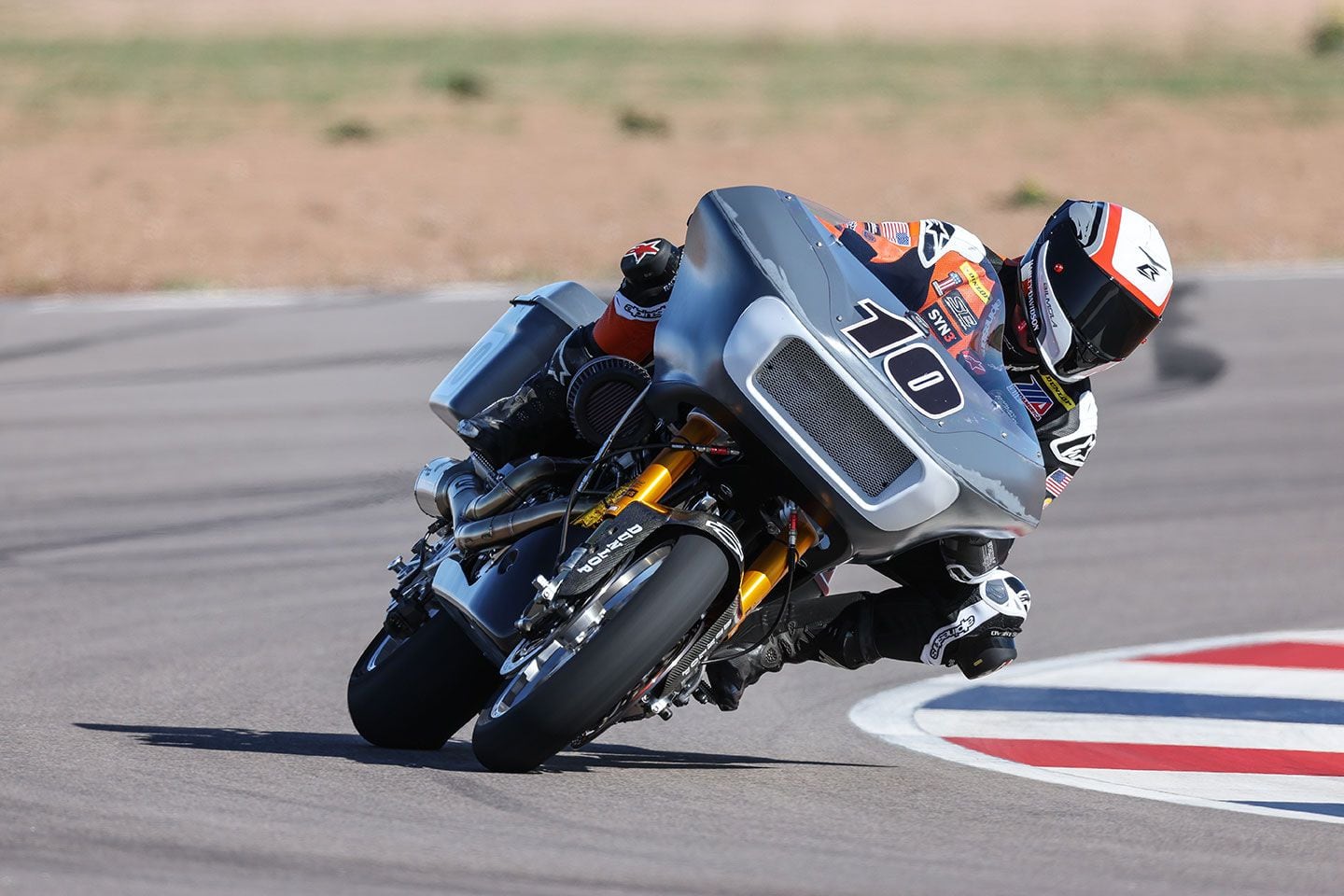
An oil cooler sits where the headlights would normally be found inside the Road Glide fairing. (Harley-Davidson/Brian J. Nelson/)
Another classic air-cooled problem is cylinder head distortion. When metals are hot and operate under considerable stress, gradual yielding can occur even at temperatures nowhere near melting point. This is called “creep.” If creep slightly displaces or ovalizes exhaust valve seats, seal is lost and bad events follow. Two supplemental cooling schemes are possible on 131R—the so-called “Twin Cooled” (normal air-cooling plus engine coolant circulated through a heart-shaped passage surrounding the paired exhaust valve seats) and the oil-cooled (oil pumped at high speed through a passage between the exhaust valve pairs). The team’s testing revealed that the cooling needs of the KOTB engine were better served by the latter, pulling heat directly out of the most heat-affected region.
You can recognize a Twin Cooled engine by the presence of water radiators and the pairs of black coolant pipes fastened to the exhaust side of each head.
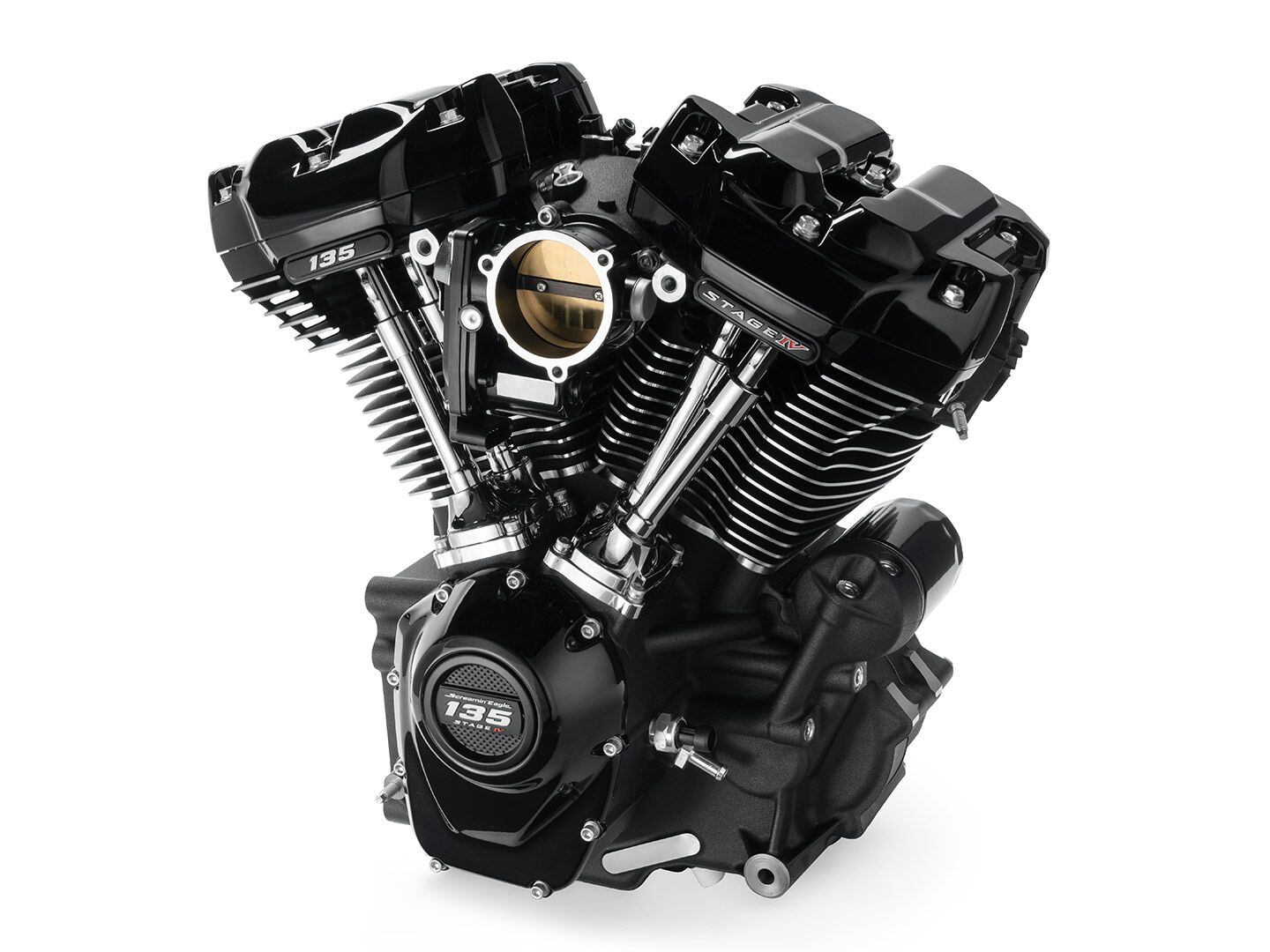
Harley-Davidson has incorporated lessons learned in King of the Baggers racing in its new 135ci Screamin’ Eagle Stage IV crate engine. (Harley-Davidson/Brian J. Nelson/)
Revealed on March 1 was a further enlarged and powered-up Screamin’ Eagle Stage IV crate engine, the 135R, whose crankpin is moved outward 0.0625 of an inch to give a 4.625-inch stroke and a 135ci displacement. Why mention that here? The reason is that the team is very pleased that their KOTB R&D was quickly applied to this new product. Displacement has increased only 3 percent but power and torque have risen 10 percent. That’s a claimed 130 hp and 143 lb.-ft. of torque at the rear wheel. Remember when they used to say that “racing improves the breed”?
]]>Kevin Cameron has been writing about motorcycles for nearly 50 years, first for <em>Cycle magazine</em> and, since 1992, for <em>Cycle World</em>. (Robert Martin/)
Indian’s “Challenger” went 180 mph at Daytona this year. That’s 10–12 mph faster than a year ago. Things are heating up fast in this class, which has become American factory racing. At MotoAmerica’s Laguna Seca national on the weekend of July 10, the top Bagger lapped quicker than Eddie Lawson did on Yamaha’s fearsome two-stroke YZR500 in the 1988 US Grand Prix.
This stuns and surprises us, making this MotoAmerica’s most popular class. It’s the last thing we expect from heavy, long-wheelbase motorcycles designed for comfy interstate touring or chugging to Sunday club breakfasts. But we love to be surprised.
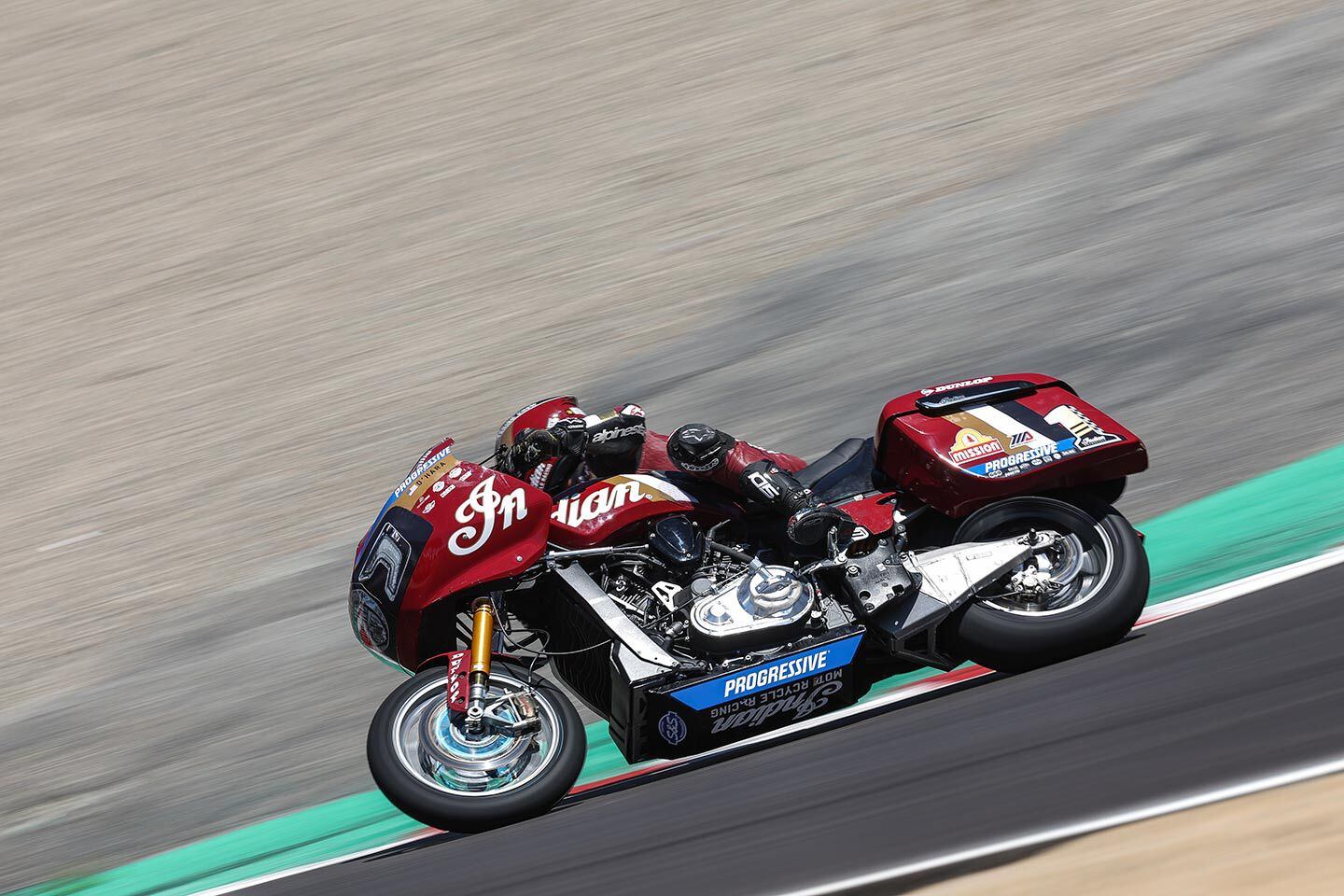
Indian Motorcycle’s race Challenger may be long and heavy, but anyone who has witnessed MotoAmerica’s King of the Baggers racing knows they are anything but slow and boring. (Brian J. Nelson/Indian Motorcycle/)
Indian’s riders in both KOTB and Super Hooligan classes are current class champion Tyler O’Hara and “the man who’s ridden everything,” development specialist Jeremy McWilliams.
Early this spring I attended Harley-Davidson’s pre-Daytona baggers race team test at Podium Club raceway, southeast of Phoenix, Arizona, to see the new racing class. Then I was invited by its great rival, Indian, to MotoAmerica’s Laguna Seca national near Monterey, California.
There, in Baggers Race 1 on Saturday, I saw O’Hara and H-D’s Kyle Wyman carve each other up in close quarters, flicking (Yes! Flicking!) down Laguna’s famous Corkscrew, then both losing the front entering turn 11, giving the win to Hayden Gillim on a Vance & Hines H-D. O’Hara somehow righted his 620-pound machine and restarted quickly enough to finish fourth!
Related: Diesels
The two building blocks of that 180 mph Daytona speed are mighty acceleration off the chicane and the power to force the mandatory 29-inch-wide front fairing through the resisting air (sportbike fairings are 19–21 inches wide). Acceleration? Because these bikes have huge V-twin engines (Indian’s liquid-cooled PowerPlus 60-degree V-twin is 108ci/1,825cc) and long wheelbases over 65 inches, they are like 2022 MotoGP bikes with their variable ride height systems on minimum. Being long and low turns both into dragsters. I was told that on certain tracks the Baggers achieve quicker sector accelerations than Superbikes.
Why the 60-degree vee angle, when traditional Indians had 42 degrees? As such large-bore pistons approach bottom center (BDC) the vee angle must be large enough to prevent skirt-to-skirt clashing.
I had a long conversation with S&S Chief Engineer Jeff Bailey, who is supervising engine development (and as I would soon see, pitching in as a line mechanic when needed). When I repeated what’s often said about the class, that horsepower is somewhere between 155 and 165, he said, “More.”
More To Come
If we imagine that “more” is 170, we can combine that with the 7,700 rpm rev limit MotoAmerica gives Indian to find that this modified engine breathes and burns well enough to achieve a 162 psi stroke-averaged net combustion pressure (aka “BMEP,” for brake mean effective pressure). That number, about 80 percent of what is achieved in MotoGP or World Supers, indicates that this engine is at a decent but moderate level of development, implying more to come.
Running this engine to 7,700 rpm with its nearly 4-inch stroke (96.5mm) results in an average piston speed of 4,880 feet per minute and a peak piston acceleration of 4,020 G. Compare the latter figure with the 7,000 G regularly achieved in redlined 600 Supersport engines, or with the 11,000 G in MotoGP engines at 18,000 rpm.
Harley-Davidson’s larger 131-inch engine is given a rev limit of 7,000. Before upper rpm limits were set, engines were wrecked by over-revving but reliability now seems solid. Although stock Challenger bore is 108mm, for this class it is 110mm, giving a 112ci displacement.
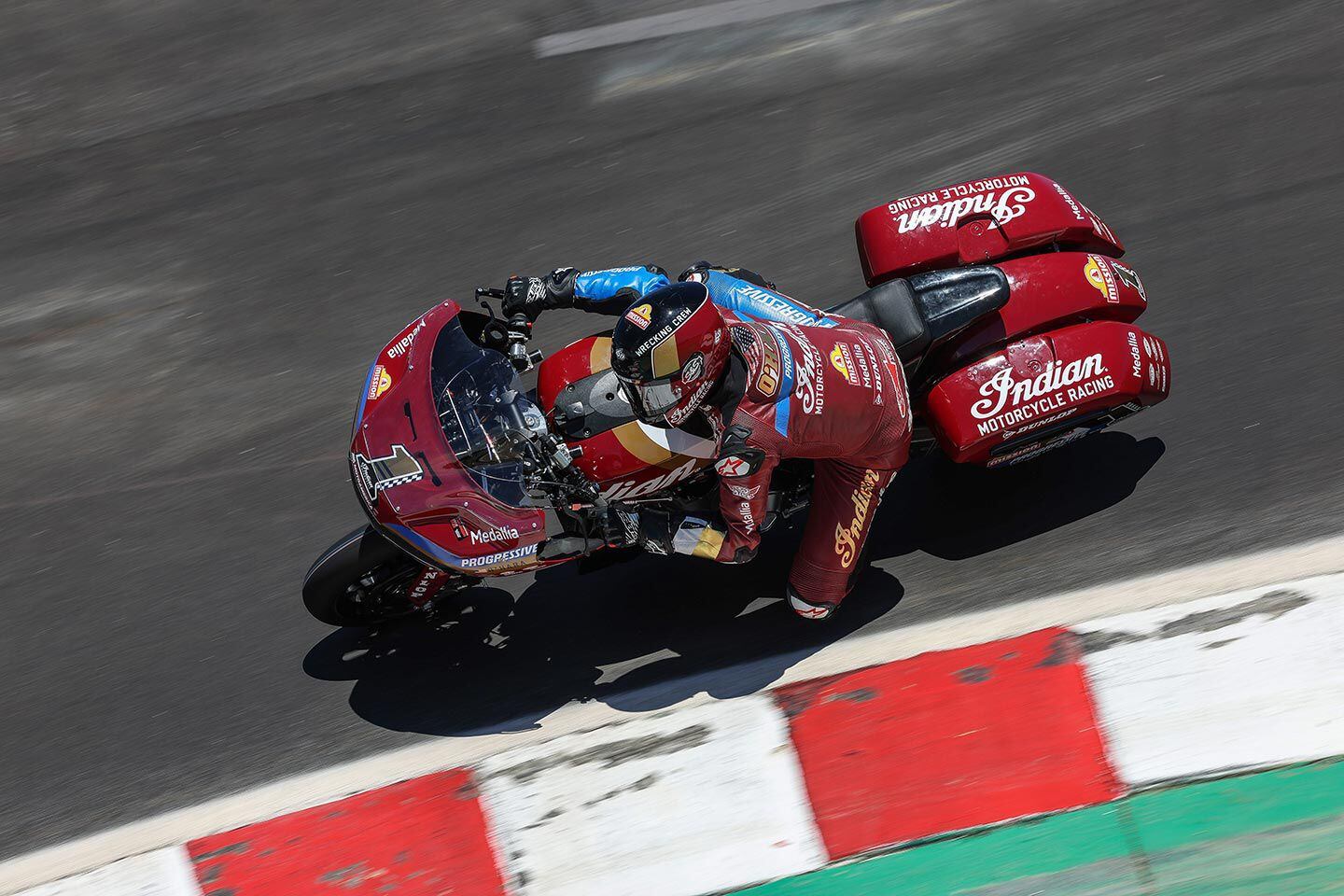
“More” than 165 hp is being produced by Indian’s 112ci V-twin used in the KOTB Challenger. (Brian J. Nelson/Indian Motorcycle/)
Sitting to one side in Indian’s work area was a 9-foot-long wheeled engine cabinet containing two fresh-off-the-dyno engines, fully dressed and ready for use. At one end of the cabinet was a set of handlebars with a hand brake.
Compare Indian’s engine with Chevy’s famed 427 V-8, whose dimensions were a near-identical 108 x 95.5mm. If the KOTB-modified Indian makes 170 hp, four of them combined into a V-8 would make a perky 680 hp.
Intake System
On stock Challenger engines there are two vertical intake pipes whose oval cross section is equivalent to two 52mm round holes. Intake area was limited by the section of the cast main frame beam directly above the cylinder heads but the modified engine needed more air. The team elected to bypass the frame beam by making a CNC-ported and additive-manufactured right angle bend served by a giant 78mm throttle body on the right side. Despite losses likely associated with the bend, this gained 10 or more horsepower.
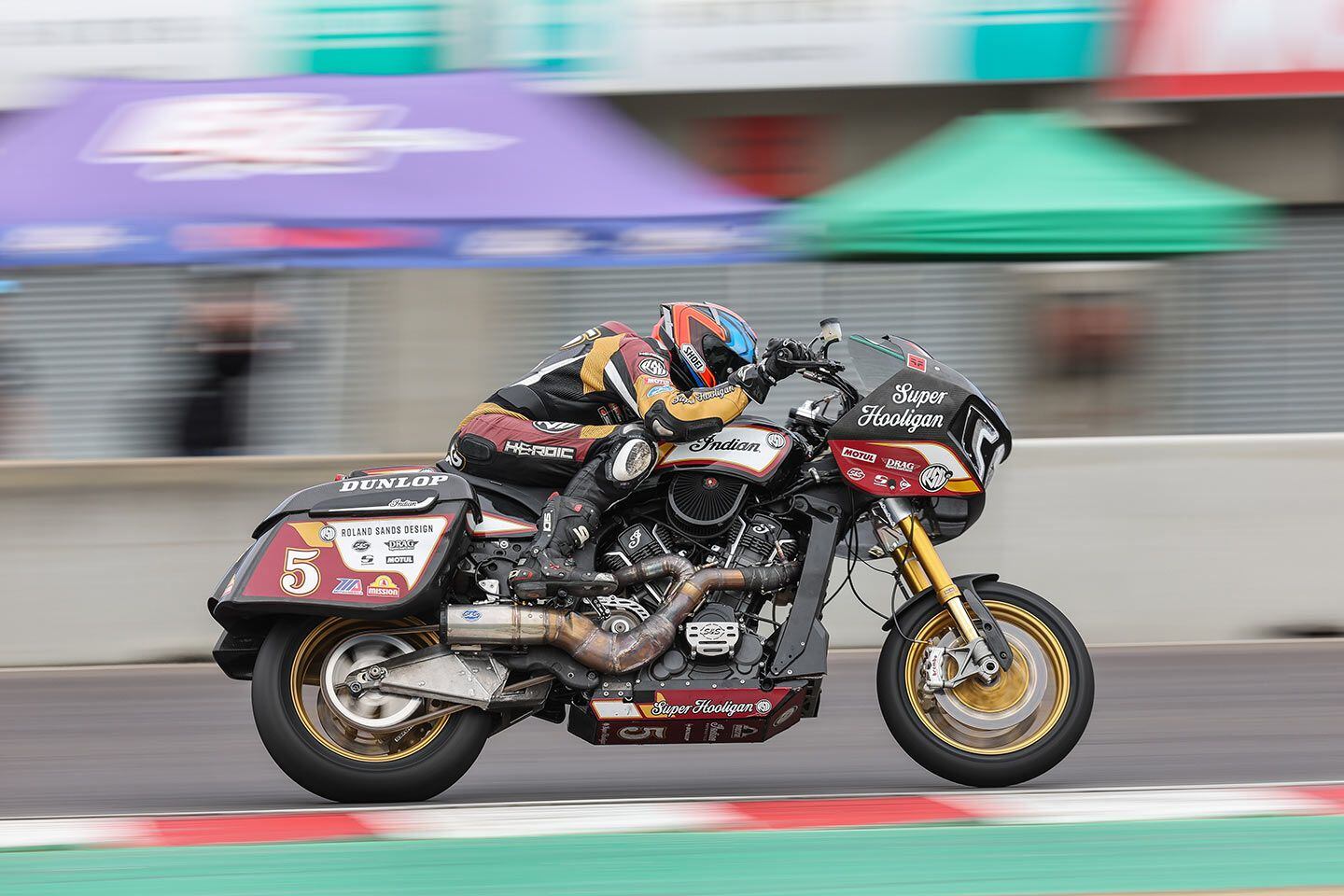
A massive air filter feeds a 78mm throttle body. (Brian J. Nelson/Indian Motorcycle/)
Development is always “triaged”: Early in the process, it’s the big items offering large gains that get tackled first. As the project matures, the focus can shift to smaller problems. This is an exciting time, as the technology is visibly changing from race to race.
Cam lift and timings are not regulated in this class, so when these engines are started they sound like V-8s with long cams. They ka-thump ka-thump until warmup evaporates more of the injected fuel, bringing in the second “voice.”
Lubrication
Because this is a modern all-plain-bearing engine, its life depends upon reliable delivery of air-free solid oil 100 percent of the time (bad things happen when air gets into plain bearings). But being originally designed for the low mounting position of a touring engine, it was not designed with a deep sump as found on Superbikes. Bailey told me there is a cavity behind the crankshaft into which the scavenge oil is pumped, assuring that the pressure pump’s intake will remain submerged.
Internal Parts
As in sportbike engines, Challenger’s crankshaft is a one-piece forging having a single crankpin carrying the two connecting rods side by side rather than in a single plane in fork-and-blade fashion. For this reason its separate Nikasil-plated cylinders are offset by the thickness of one rod.
Primary drive from crank to gearbox is by gear, and drive to the rear wheel is by an S&S chain conversion.
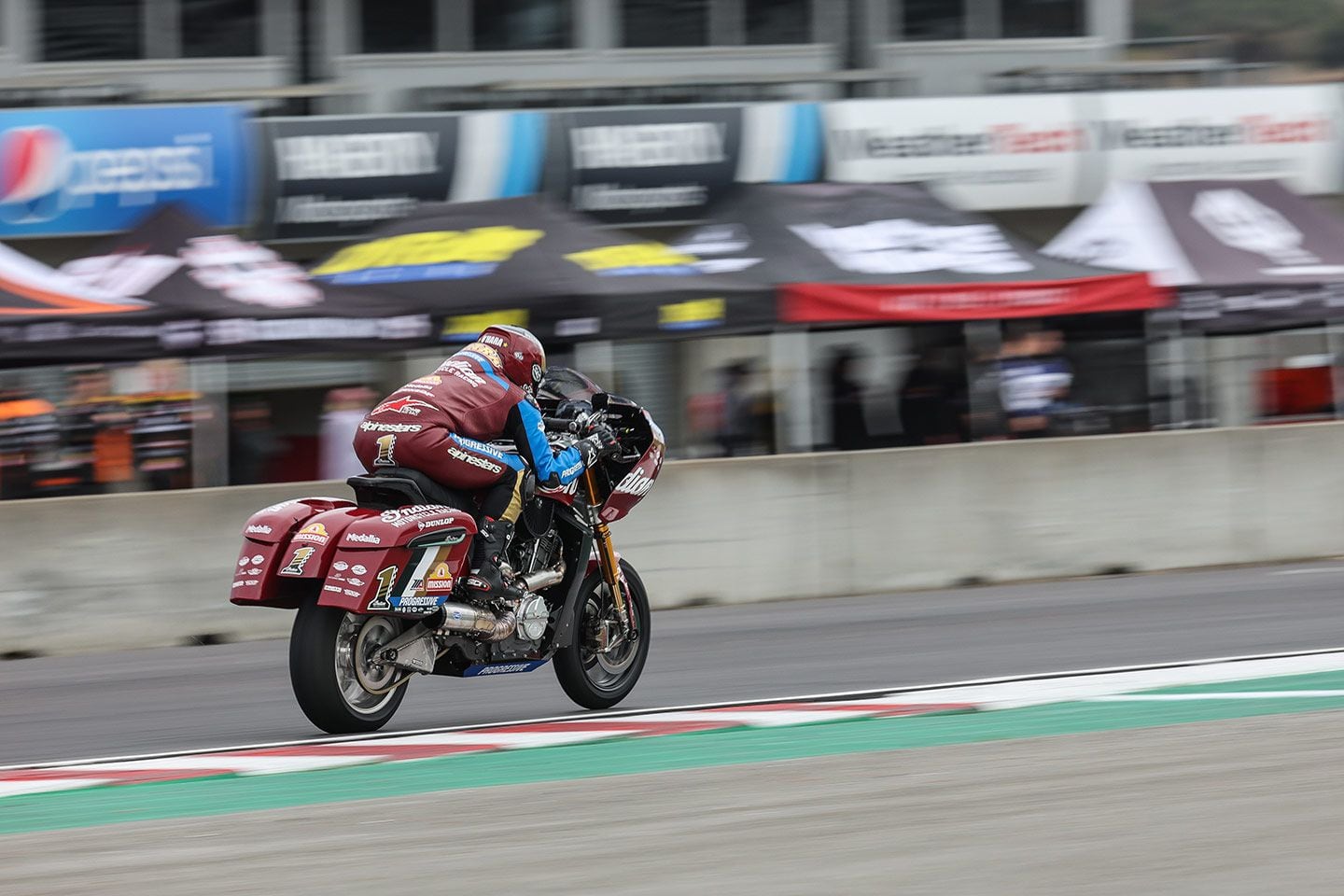
Power to the rear wheel is delivered by an S&S chain conversion. (Brian J. Nelson/Indian Motorcycle/)
In early development it was found that the crankshaft flung off too little oil to guarantee gearbox lubrication, so oil jets are provided (there are also piston-cooling oil jets). Like the two-speed Indians that finished 1-2-3 at the 1911 Isle of Man TT, this six-speed gearbox is shifted by light dog-rings rather than by sliding the substantial gears themselves (one key to quick shifting is to reduce the total mass that the rider must move when changing gear).
Chains drive single overhead cams in each head, originally operating four valves per cylinder by forked rockers carrying compact hydraulic clearance adjusters. S&S provide billet rockers with mechanical lash adjustment, eliminating the mass (and a possible “pump-up” rpm limit) of the hydraulics.
Shaping the Torque Curve
When this engine was originally conceived its torque curve was planned to be “rainbow-shaped”—emphasizing midrange acceleration essential for on-ramps and passing. This is in contrast to what was long traditional for such bikes—the “lean-to” torque curve of older two-valve big-inchers—with peak torque at the bottom, decreasing as engine speed climbs, and finally wheezing out approaching 5,000 rpm.
As with any modern engine, PowerPlus torque curve shaping is achieved by a combination of port and valve sizes (in what rpm range will the intake velocity best for cylinder filling occur?) plus intake port downdraft angle (how will the kinetic energy of the intake flow be divided between the two tasks of cylinder filling and the generation of combustion-accelerating tumble motion?).
Compression and Head Temperature
Cylinder heads on Indian’s KOTB engines are CNC-ported. Stock compression ratio of 11-to-1 reflects the value of liquid-cooling, but because the competing 131-inch pushrod Harley circulates cooled oil between its paired exhaust valves, it probably doesn’t suffer as much from high head temperature as a pure air-cooled. Compression ratio may therefore not be that different between the competitors. Maximum torque is achieved by running the highest compression ratio possible without knock on the fuel provided.
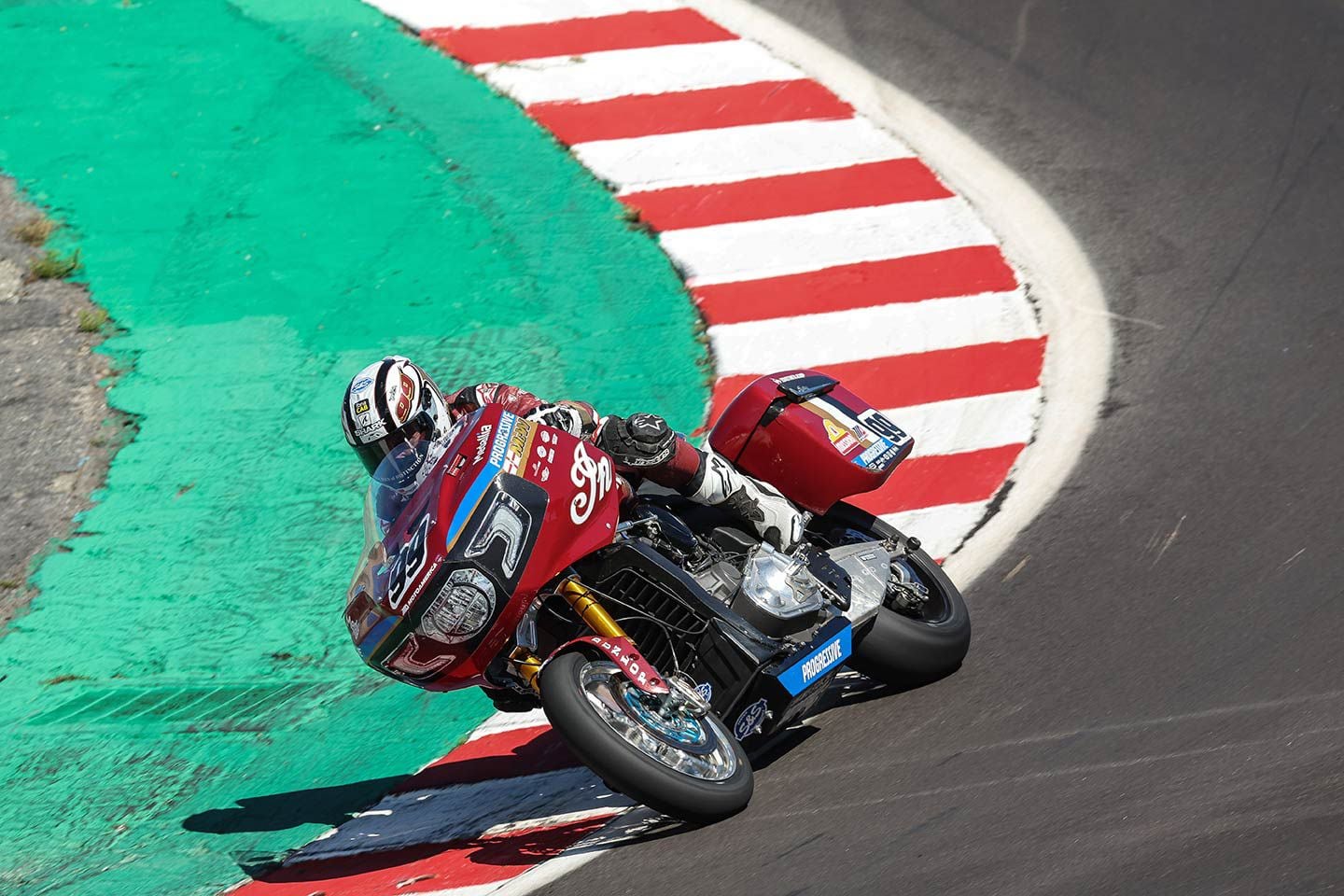
Tyler O’Hara flicking the Challenger through the bottom of Laguna Seca’s famed Corkscrew. (Brian J. Nelson/Indian Motorcycle/)
The fuel in this case is VP’s T4, characterized as a pour-in replacement for pump gasoline. It is lead-and-ethanol-free but does contain the oxygenate MTBE.
Exhaust System
The exhaust headers begin with additive-manufactured stainless pieces joining the head ports to cut-and-welded head pipes that merge into a large high-mounted and horizontal collector. Each cylinder has its own oxygen sensor, allowing it to be tuned as a “separate engine,” with its own fuel and spark maps. The large exhaust collector brought important gains. Because the engine is wide and originally mounted quite low, it’s difficult to arrange for equal-length header tubes and still stow the collector under the right-hand footpeg. Again, because this engine was born to tour, it was designed “backward”—with the compromise falling on the exhaust system (in the form of sharply curved exhaust ports) rather than on the chassis.
On Friday I learned that the engines had a few new parts on them not tried before, but they were only an ignition rotor cover and primary cover, both in low profile for cornering clearance.
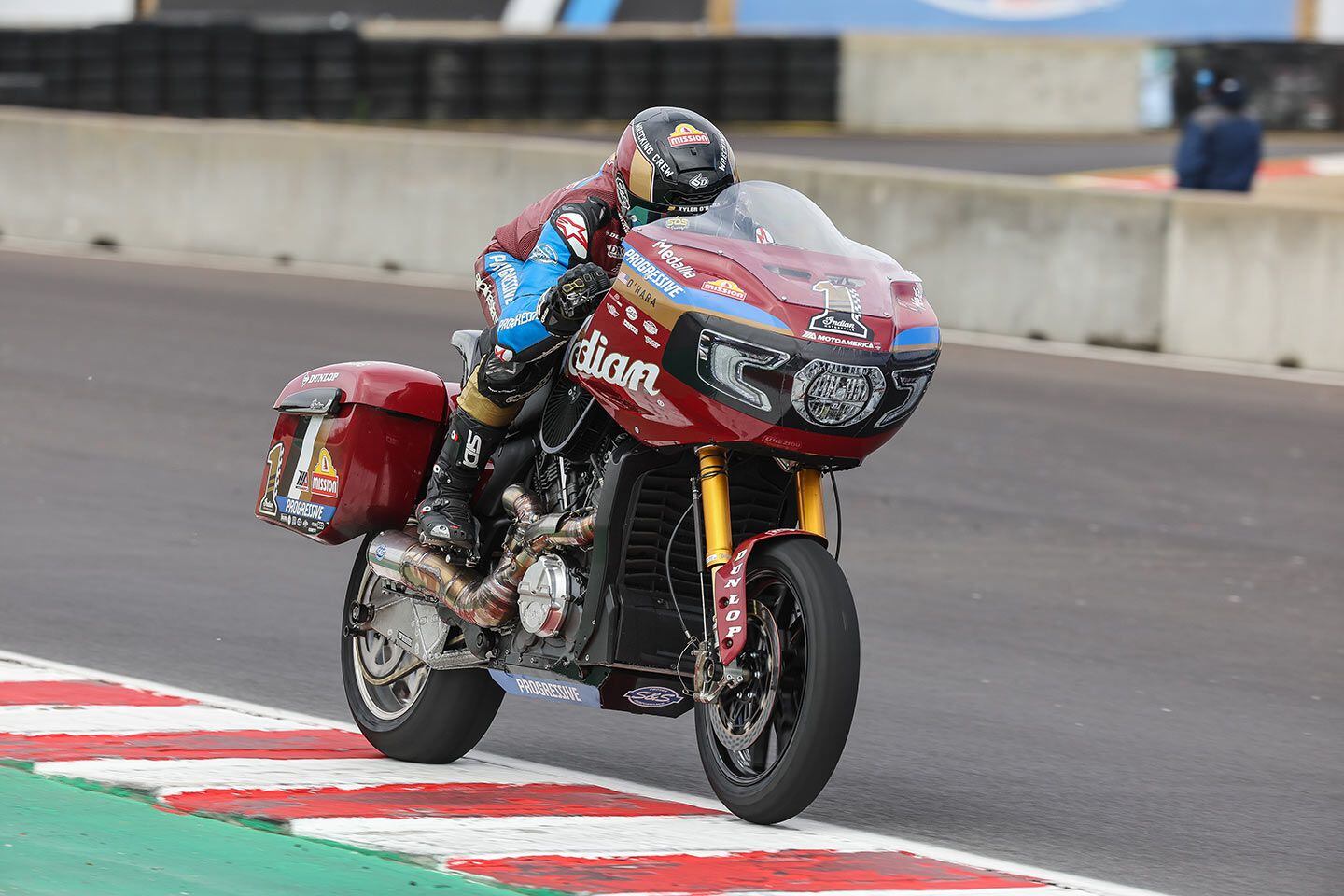
Old and new tech—and cut-and-weld and additive manufacturing—is used to create the Challenger’s massive exhaust system. (Brian J. Nelson/Indian Motorcycle/)
Tyler O’Hara’s crew chief Al Ludington (who was at American Honda Racing in the Miguel Duhamel years) said the riders typically use five of the six transmission speeds: if you ignore first, the ratio of second to sixth resembles a proper roadrace trans. But from first to second there is a whopping 47 percent drop in engine rpm!
The weekend showed that Indian certainly has competitive power but that Harley may at the moment have more sophisticated control over theirs. Ludington summed up by saying, “On a clear track we can do the lap times, but in a race there can be another bike blocking you.” He noted that corner exit and acceleration are already good. The present problems are in braking and corner entry. He also said, “The bike responds differently to the rider in right- and left-handed corners.”
When a bike is capably ridden near its grip limits, small improvements in engine throttle connection and smoothness can have large effects. Riders on the 2023 MotoGP Ducati speak of such improvements over the previous year’s software. In racing, time, funding, and resources are always in crisis. Everything is a race—winter development, spring testing, and every practice in season.
Pay attention to this racing class because it has the full attention of major American corporations. It is a fast-advancing demo of all the techniques of racing development and rider versatility being applied to a class of motorcycle no one ever imagined on a racetrack.
]]>Just recently, we had a chance to ride with the new Milwaukee-Eight 121 VVT in the 2023 CVO touring models. Utilizing the same piston diameter as the 117ci, but increasing the stroke from 4.5 inches to 4.625 inches, the larger 121ci engine is claimed to produce 12 hp and 13 lb.-ft. more than the 117ci M-8. As 121 VVT test models become available, we will run them on the dyno for a direct power comparison.
But before riding the 2023 Harley-Davidson CVO Street Glide and CVO Road Glide 121, we had the opportunity to dyno the highly anticipated Screamin’ Eagle 135ci Stage IV crate engine fitted in a Fast Johnnie Street Glide ST. The biggest and most powerful street-compliant engine offered by Harley-Davidsons is available as an upgrade for 2021 and later Touring models equipped with an air/oil-cooled Milwaukee-Eight engine.
Featuring Screamin’ Eagle Extreme CNC-ported cylinder heads, an SE8-517 high-lift cam, new high-compression forged pistons, a high-performance cam bearing, high-performance tappets, patent-protected 4.31-inch steel sleeve cylinders, a new 4.625-inch flywheel, new 68mm throttle body, CNC-machined 68mm intake manifold, new 6.2 grams/second fuel injectors, and Screamin’ Eagle Pro Billet Cam Plate and Oil Pump, the 135ci crate engine will be the most powerful street-legal H-D we have tested to date.
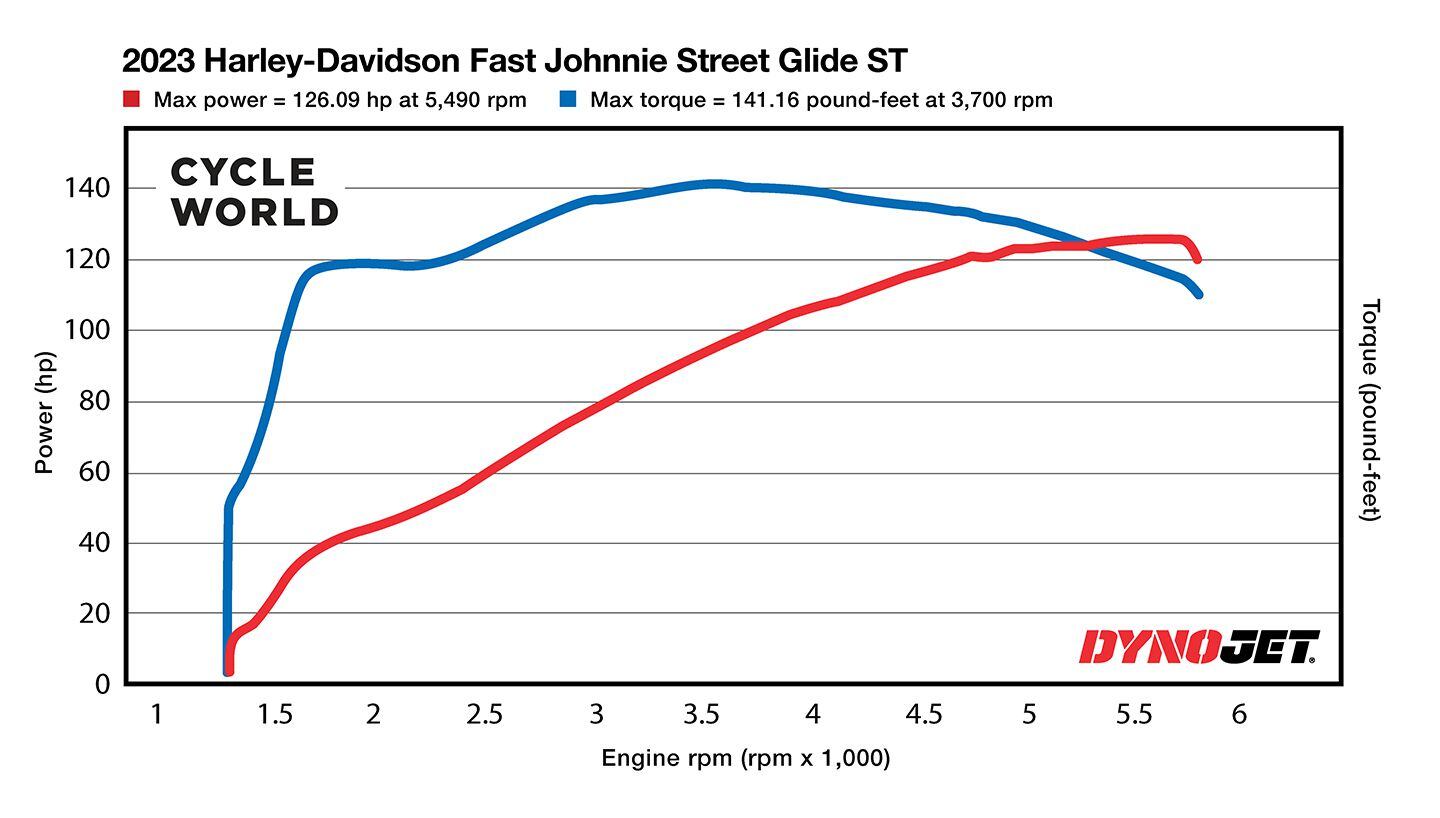
2023 Harley-Davidson Fast Johnnie Street Glide ST With 135 Crate Engine Dyno Chart. (Robert Martin/)
On the Cycle World Dynojet 250i dynamometer, the 2023 Fast Johnnie Street Glide ST with 135 crate engine produced 126.1 hp at 5,490 rpm and 141.2 lb.-ft. of torque at 3,700 rpm. That’s 34.1 percent more hp and 19.7 percent more torque at the rear tire than the 117ci mill in the Breakout. For those wanting the most powerful street-legal Harley-Davidson engine available, it will cost you $7,999.95. But there is one stipulation: It’s 49-state US EPA compliant, meaning it’s not for sale in California for use on public roads.
]]>The new Sportster S platform received the Revolution Max 1250T V-twin engine. A liquid-cooled DOHC powerplant featuring variable valve timing, three ride modes (Sport, Road, Rain) including a customizable map, and electronic safety features such as Cornering Enhanced ABS and traction control. On our in-house Dynojet 250i dynamometer, the 2023 Harley-Davidson Sportster S produced 109.6 hp at 7,530 rpm and 85.2 lb.-ft. of torque at 6,000 rpm.
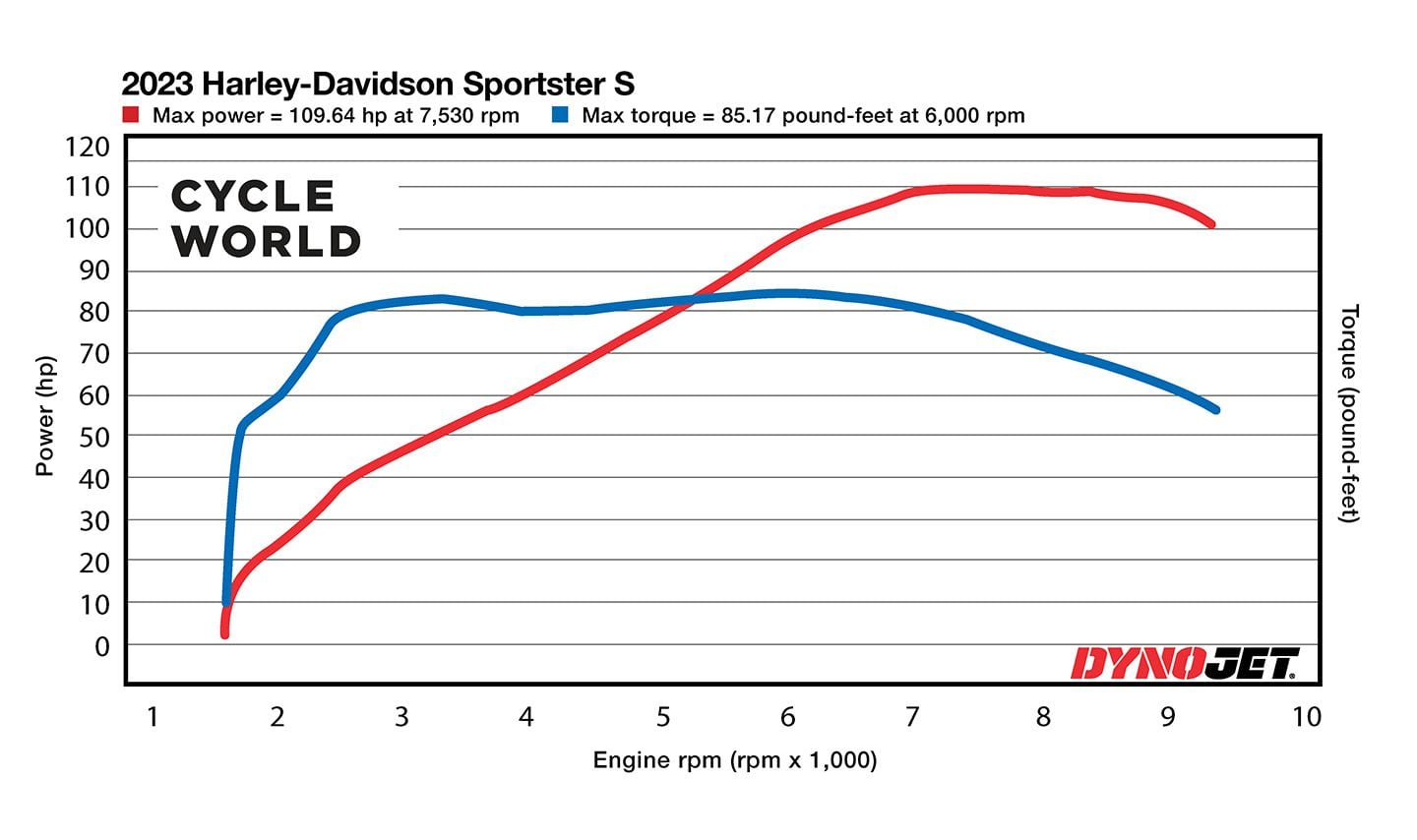
2023 Harley-Davidson Sportster S Dyno Chart. (Robert Martin/)
A linear power delivery, flat torque curve, and quick-revving nature deliver a riding experience unlike any other traditional Harley-Davidson model. Whether you are zipping down the boulevard or pinning it out of a corner on a backroad, the 2023 Harley-Davidson Sportster S is an exhilarating ride thanks to its punchy, arm-tugging engine characteristics.
]]>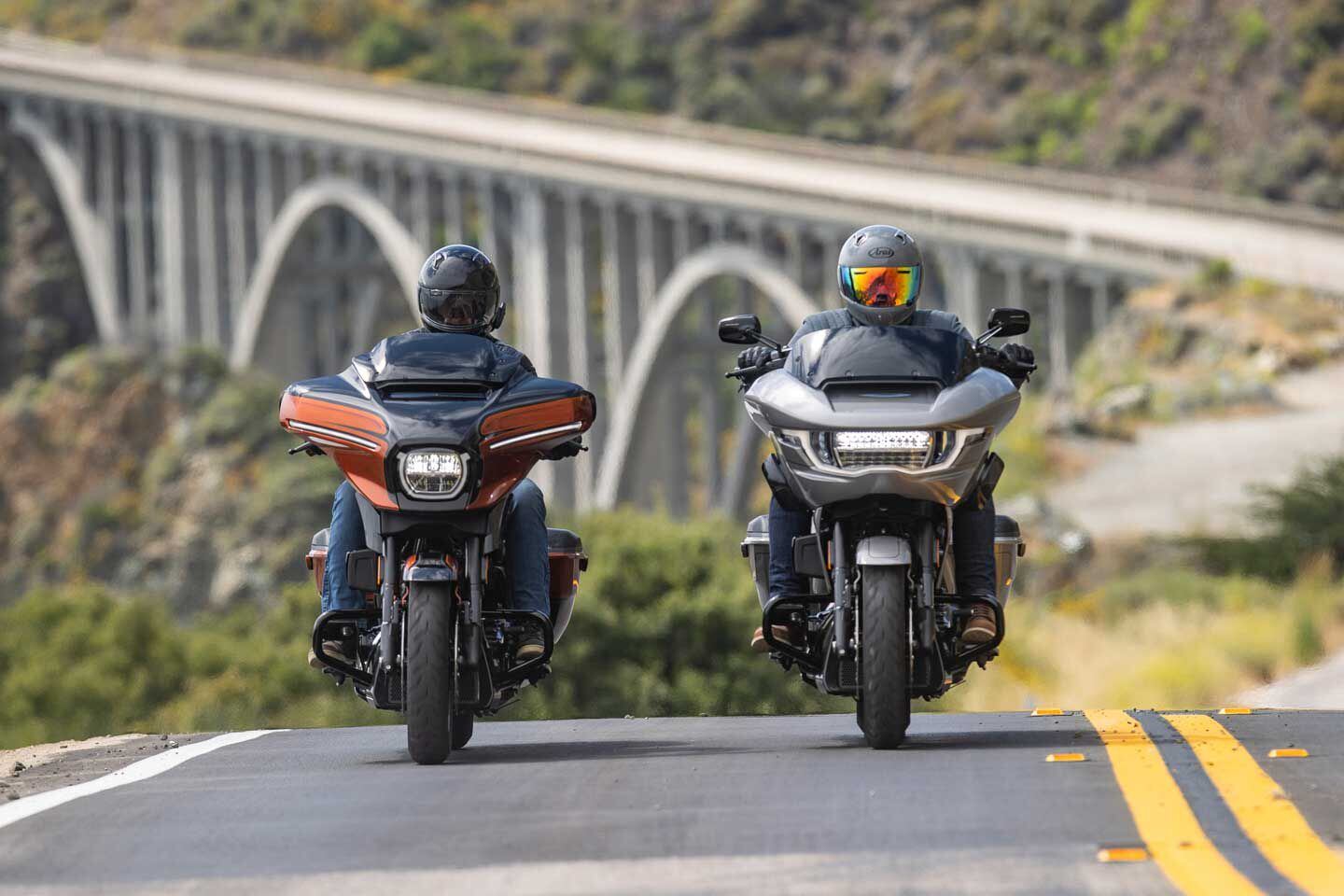
Although the fairings are all new, you know immediately you are looking at Harley’s CVO Road and Street Glide. (Jeff Allen/)
In terms of volume and type, Harley-Davidson’s biggest competitor is itself—in the used market. Since 2000, Harley-Davidson has sold well more than 2 million touring models. That’s your Street Glide, Road Glide, Ultra, and similar bikes, not cruisers like the Softail Fat Boy or old Dynas, which also have sold in similar numbers over the same time period. The now-discontinued air-cooled Sportster sold nearly 1.2 million during that period. Harley-Davidson motorcycle shipments from 2000 through 2022, as published by Harley-Davidson, total 5,808,881 units.
That, folks, is a lotta potatoes.
So keeping the Grand American Touring line (Harley’s official name for the platform) attractive—more attractive than last year’s Road Glide and the rest—is exceedingly important.
Which is why Harley-Davidson introduced the 2023 CVO Road Glide and CVO Street Glide with significant changes to the traditional 45-degree V-twin, upgraded suspension, new infotainment, and heavily reworked styling.
Every crease, contour, and edge of the redone fairings is new, and yet the world knows exactly what two bikes it is looking at.
CVO 121 VVT Engine
When the new engine fires up, the world also knows exactly what it’s hearing. Well, you’ll recognize the potato-potato sound as a 45-degree V-twin, but please notice the “VVT” on the side of this 121ci Milwaukee-Eight engine. At long last, a Big Twin finally has variable valve timing.
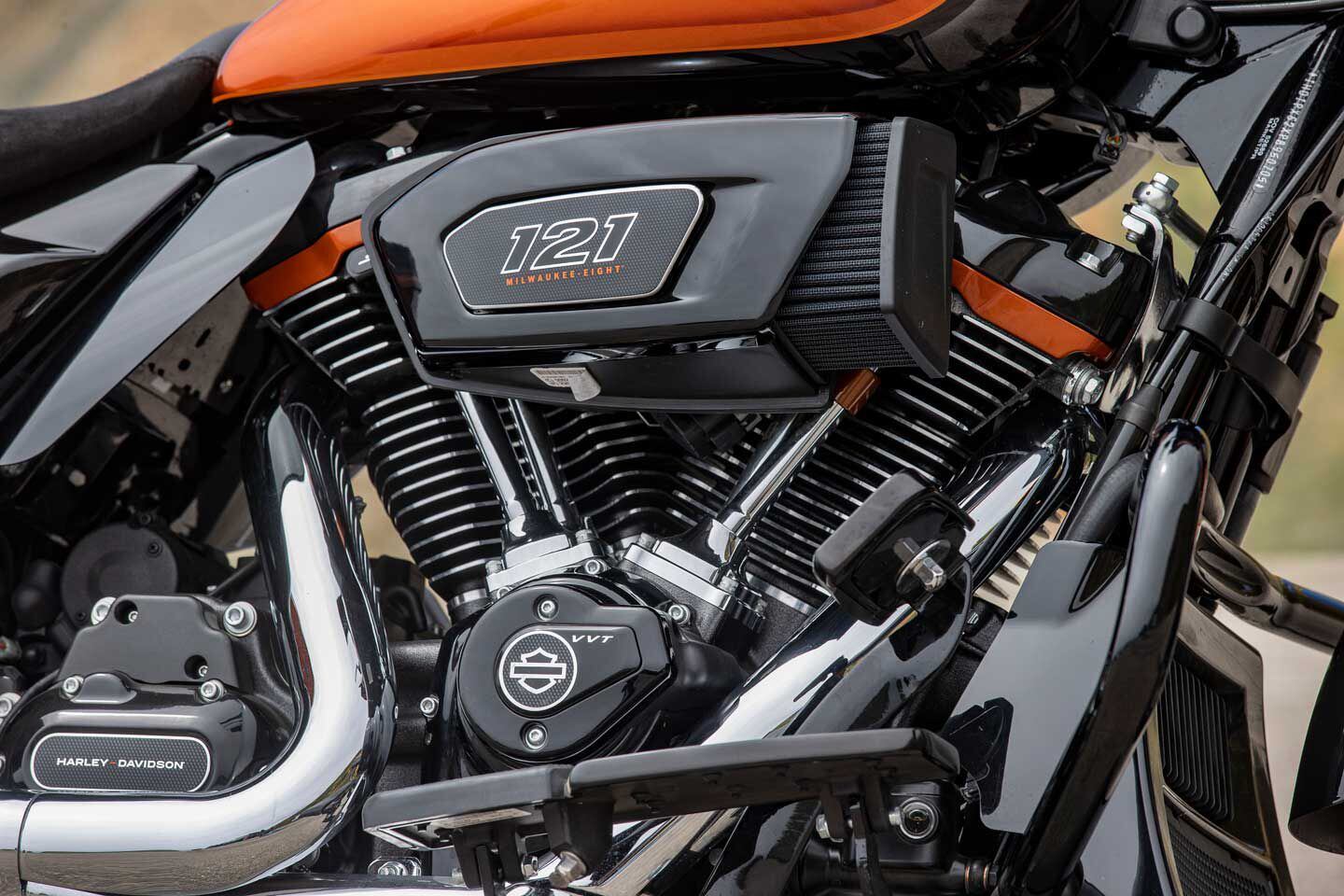
A new 121ci (1,977cc) Milwaukee-Eight with VVT powers both the 2023 CVO Street Glide and CVO Road Glide. (Jeff Allen/)
The VVT moves the single higher-lift and longer-duration cam through 40 degrees of adjustment (relative to the crankshaft), smoothing and increasing power across the rev range. VVT can be more effective working on separate intake and exhaust cams to control overlap (reducing it at low rpm smooths idle and reduces emissions, increasing it boosts high-rpm output), but because Harley-Davidson’s cams are generally turned for torque and use less overlap than your average Ducati, working on a single cam where the relative position of the intake and exhaust valves is fixed isn’t a big deal.
VVT works with a larger 4-liter airbox that feeds a 58mm (up from 55mm) throttle body and straighter, freer-flowing ports for the four-valve heads. Valve seats and combustion chamber are reshaped, the former providing better flow and the latter giving more squish and improved combustion. Combustion chamber changes and revised strategic liquid-cooling allowed a significant bump in compression from 10.2:1 to 11.4:1 versus the 117.
Piston diameter is the same as the 117ci Big Twin at 4.075 inches, but a very long 4.625-inch stroke helps this 1,977cc engine produce a claimed 139 lb.-ft. of torque at 3,000 rpm, and 115 hp at 4,500 rpm. This compares favorably to the non-VVT 117′s claimed numbers of 103 hp at 4,750 and 126 lb.-ft. at 3,500. For reference, the recent Breakout 117 we ran on the dyno made 118 lb.-ft. and 94 hp at the rear wheel (measured rwhp is usually about 7–15 percent lower than any factory’s claimed numbers). Claimed peak output increases for both horsepower and torque tracks with the roughly 4 percent increase in displacement between the 117 and 121, but the bigger engine feels like it has more area under these curves, meaning a broader spread of power. We will dyno the 121 VVT and get rear-wheel numbers as soon as a testbike is available. Harley-Davidson claims a potential 3–5 percent increase in fuel economy as well.
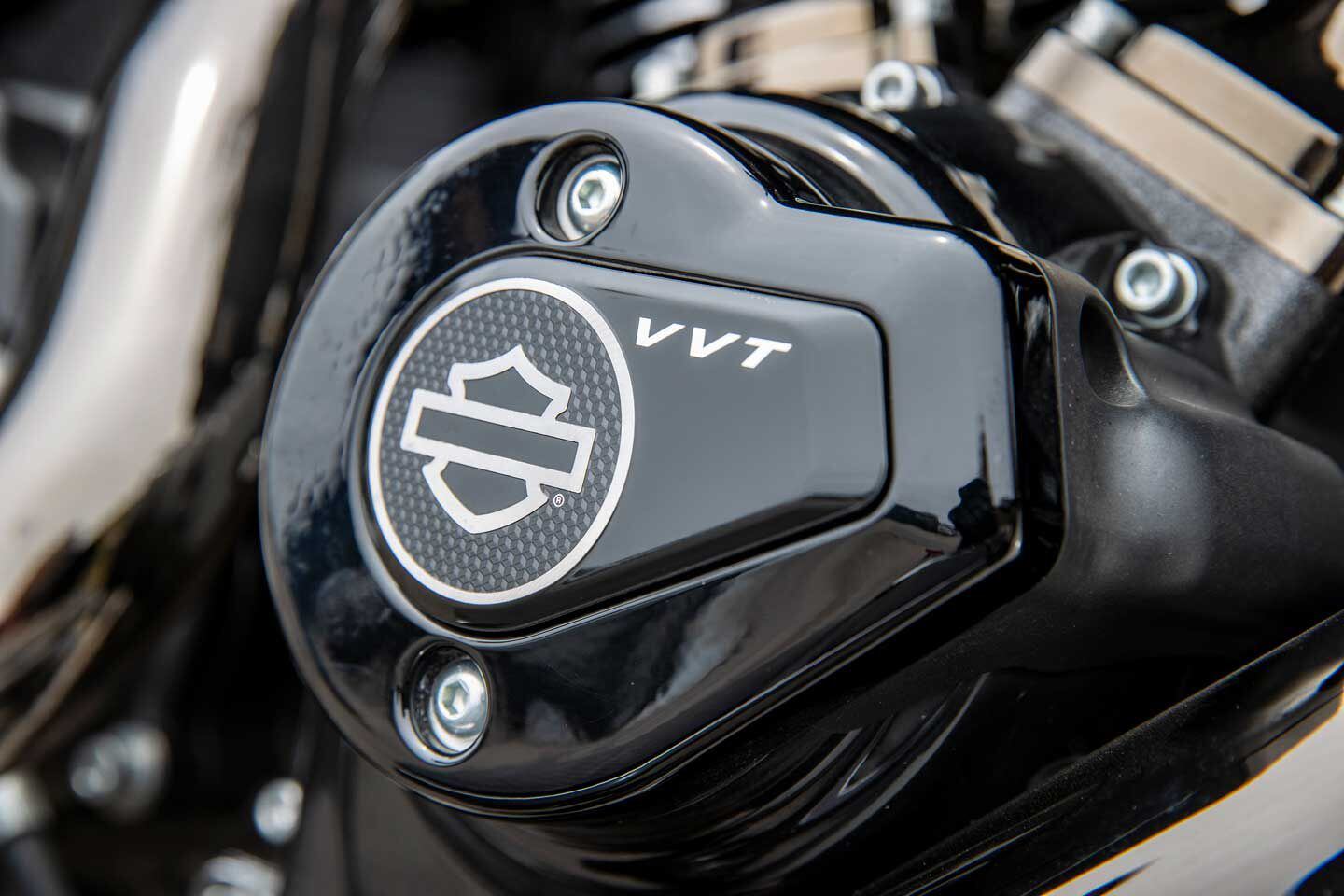
Harley’s new VVT system moves the higher-lift and longer-duration cam through 40 degrees of adjustment relative to the crankshaft. (Jeff Allen/)
On the road, these engine changes add up to significantly increased performance and livelier response. The Milwaukee-Eight 121 VVT is smoother down low, pulling cleaner from just over 1,000 rpm, where the non-VVT engine would sometimes jerk back and forth against the torque compensator and bounce off either side of the driveline lash, so to speak. The 121 is freer revving, as well, zinging through midrange in a way no factory engine has before. This is followed by strong top-end for what is clearly broader, smoother, and more abundant power than any factory Big Twin we’ve tested. The engine runs to about 6,300 rpm before the rev limiter cuts in.
As we rode on California Highway 1 from Monterey south through Big Sur and to Lucia on our early first ride of the CVO Road Glide and Street Glide, we got an excellent mix of slow corners and 80-plus-mph straightaways, and it makes you think you’d like to see a 121 VVT in all the Big Twin bikes.
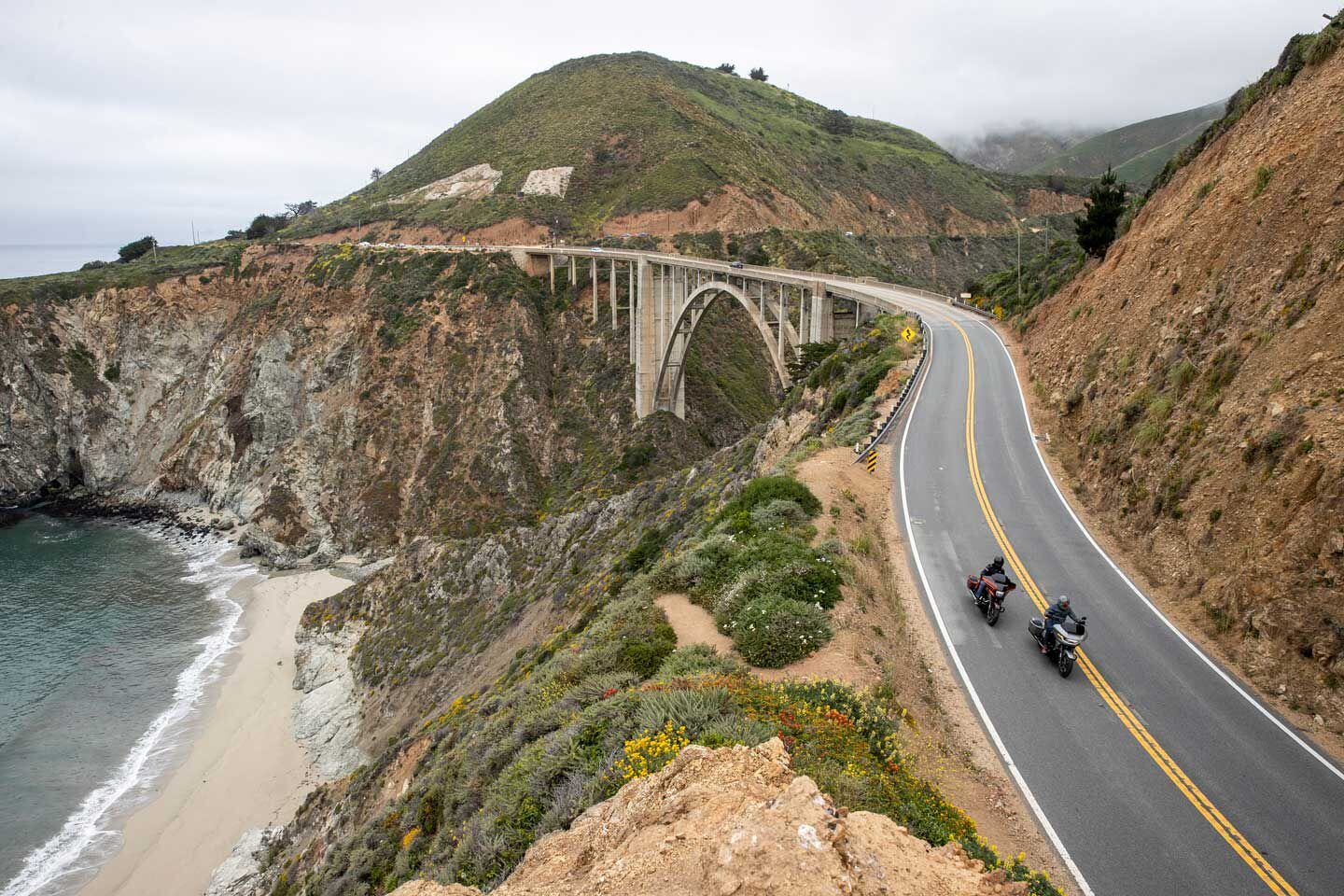
There are few roads better than California Highway 1 for testing touring cruisers. (Jeff Allen/)
Chassis and Suspension
I’ve ridden many thousands of miles on various Glides over the years and my familiarity was updated with a 500-mile day on a current Street Glide ST prior to jumping on the CVOs, riding from our Southern California headquarters to Monterey for the MotoAmerica round at WeatherTech Raceway Laguna Seca, including the Mission King of the Baggers races.
While the main frame with rubber-mounted engine is largely unchanged from the significantly upgraded 2009 Touring line, the CVO Road Glide and Street Glide have a new inverted 47mm Showa fork with 4.6 inches of travel, larger 320mm Brembo front floating disc brakes (up from 300), and Brembo-branded radial-mount calipers.
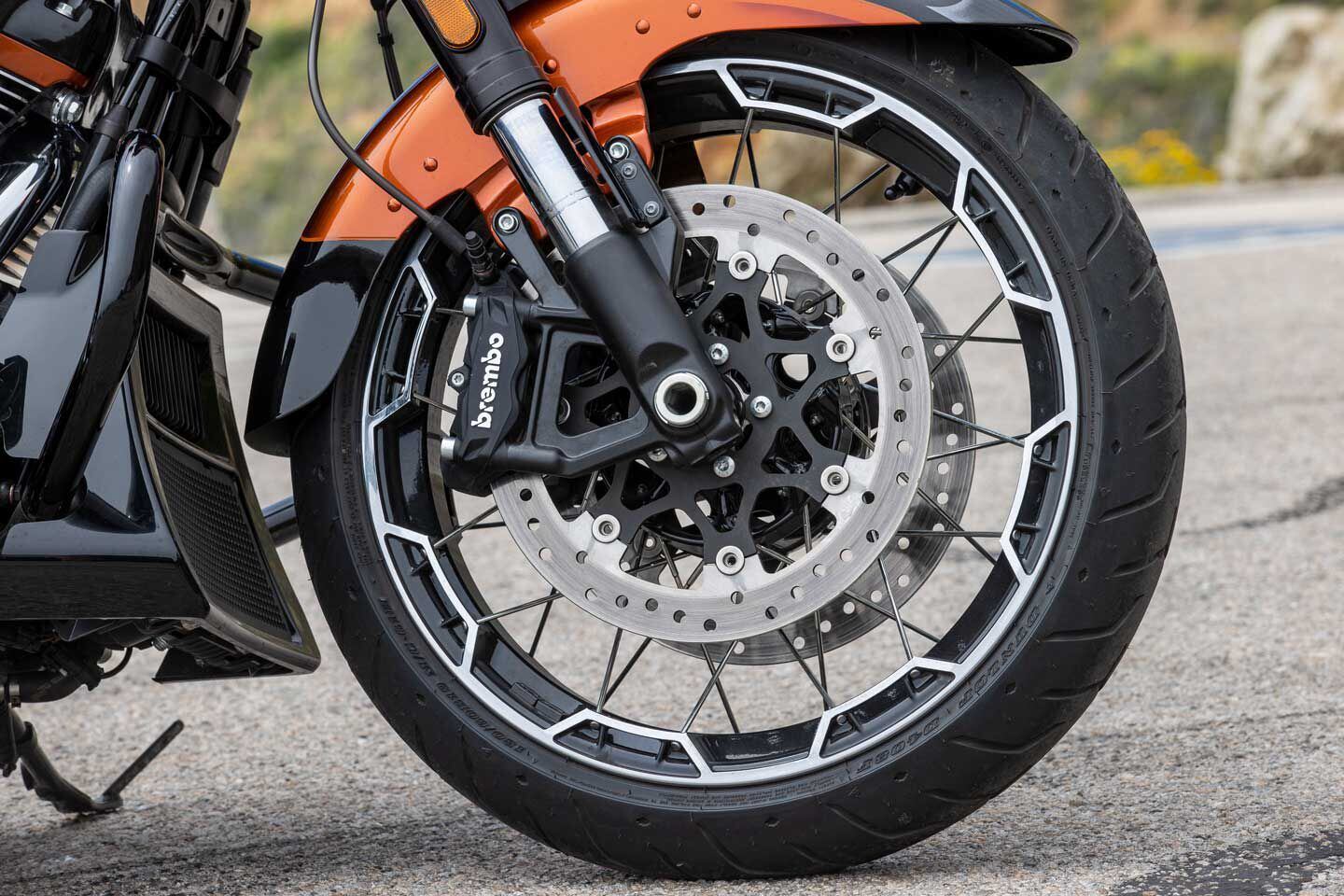
Brembo radial-mount calipers and 320mm discs increase the CVO Glides’ braking performance. (Jeff Allen/)
At the rear, a new Showa shock with spring preload and rebound damping adjustment offers a 50 percent increase in travel. Now, 3.0 inches of rear wheel travel is still not a lot, but it’s a lot more than 2.0 inches. The old bike did pretty well with that limited rear travel, but it always felt “trapped,” so to speak, as the damping/springing tuning tried to keep you in a useful range of travel out back so there was something left for the next bump. Damping is tuned to suit, and the rear ride quality and control is better.
Notably absent, however, is any fork damping or spring-preload adjustment, and the major rear spring preload (a threaded collar) and rebound damping adjustments are only accomplished with the bags removed. There is an easily accessible hydraulic rear spring-preload adjustment knob on the left side of the bike to fine-tune within the range you select with the threaded collar.
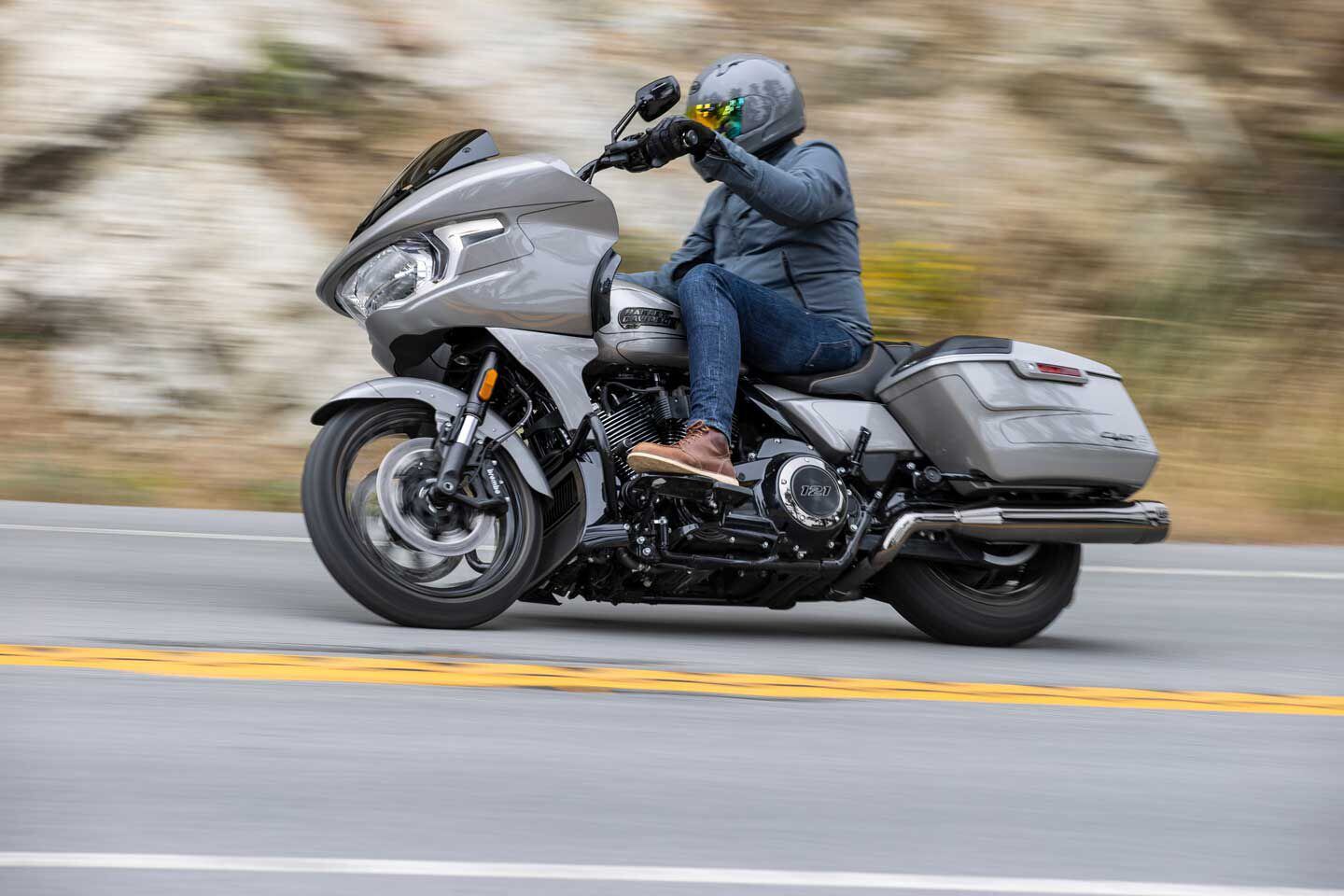
Rear suspension travel has increased 50 percent—from 2 inches to 3. (Jeff Allen/)
On a range-topping touring bike at this price, the market, at least in other segments, is expecting electronic suspension adjustment, including especially rear-spring preload. What if, like on the Pan America adventure bike, rear spring preload and adaptive ride height just took care of itself? What if when you parked, the bike could lower itself for that killer slammed stance, but add suspension travel/ride height as you fired up and traveled down the road? This had to have been discussed during development, and we’d like to see this kind of useful tech employed on the touring range.
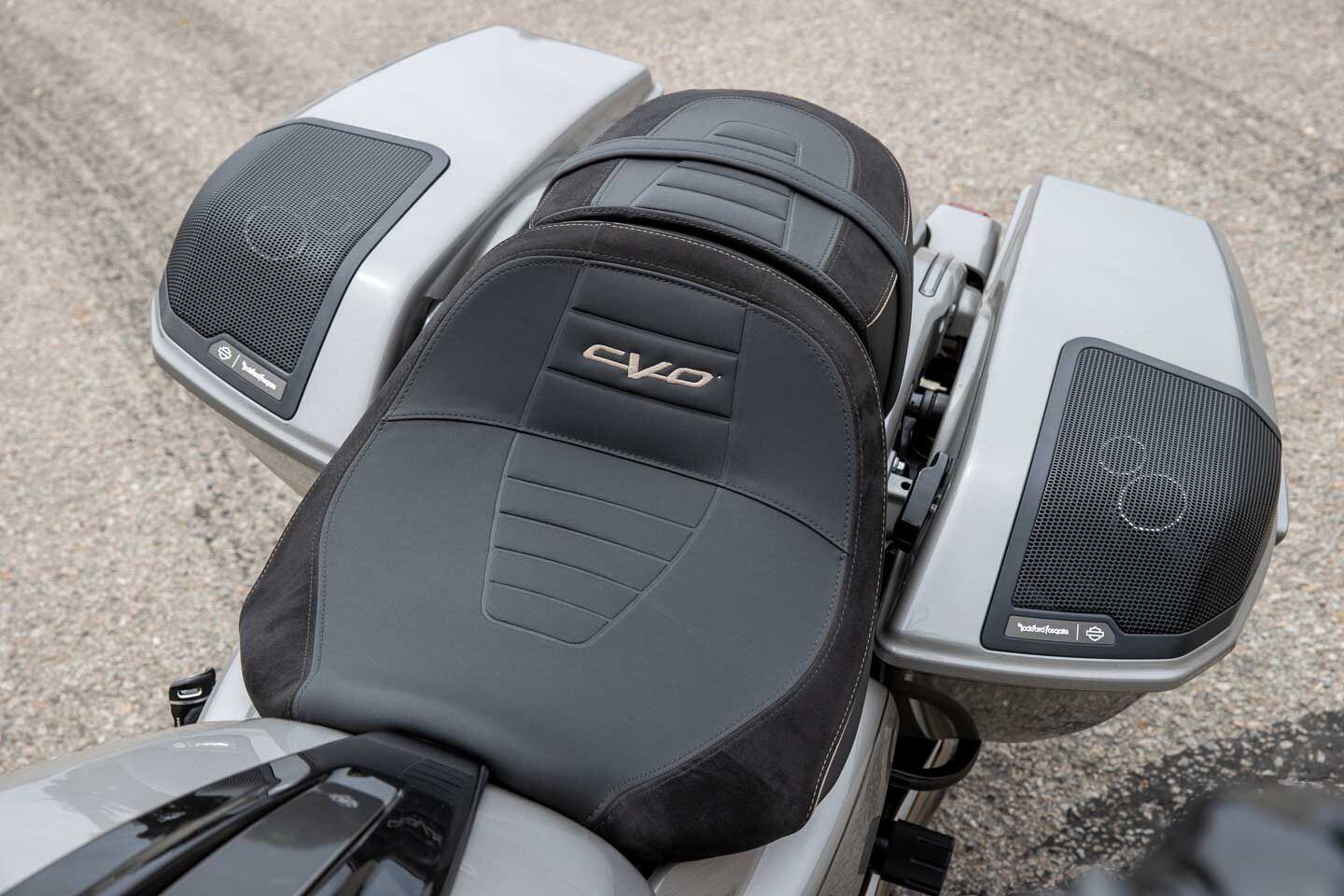
If you want to make large adjustments to the shock-spring preload, one of the reshaped bags must be removed. (Jeff Allen/)
Front braking is lower effort and with better feel, these qualities combining with the stiffer fork to make for improved turn-in response, particularly when trail-braking into corners.
The CVO Glides lean a claimed 32 degrees left and right, where the previous version only gave you 31 degrees in left turns. Party in the engineering house! Kidding aside, the Softail Fat Bob offers 32 right/31 left, so the CVO Glides are officially the lean kings of the traditional Harley-Davidson models. For reference, LiveWire has 45 and Pan America has 42 degrees of stated lean angle.
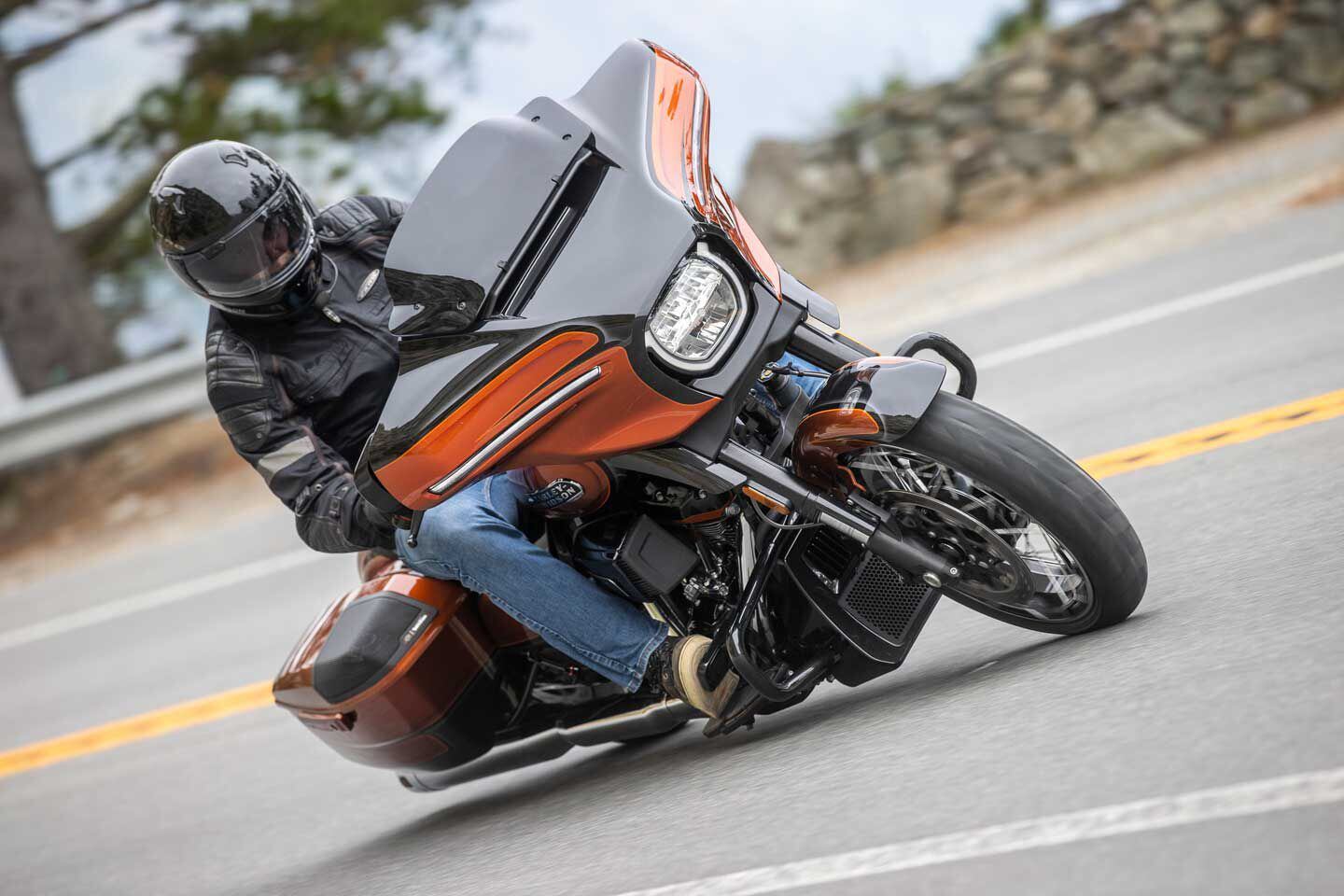
Available lean angle is essentially the same as on previous touring models. (Jeff Allen/)
Also of note is a 31 (SG) and 35 (RG) pound weight reduction for the CVOs, highlighted by a 7-pound-lighter lower triple clamp. It’s nice to see the weight conversation finally entering the room for these models. Sure, we bought pizza for the Harley-Davidson Product Development Center staff when they beat the challenge we laid out for the Pan America to come in under 550 pounds in an early story on the adventure bike, but the touring models haven’t been subject to quite the same scrutiny.
So the weight loss on the CVOs is great news, but the Road Glide is still a claimed 862 pounds “in running order,” and the Street Glide is 838. The Road Glide comes off the sidestand easier than the previous model, certainly, but, hey, how about another round of pizza and beer if you guys hit 750 for Road Glides and Street Glides?
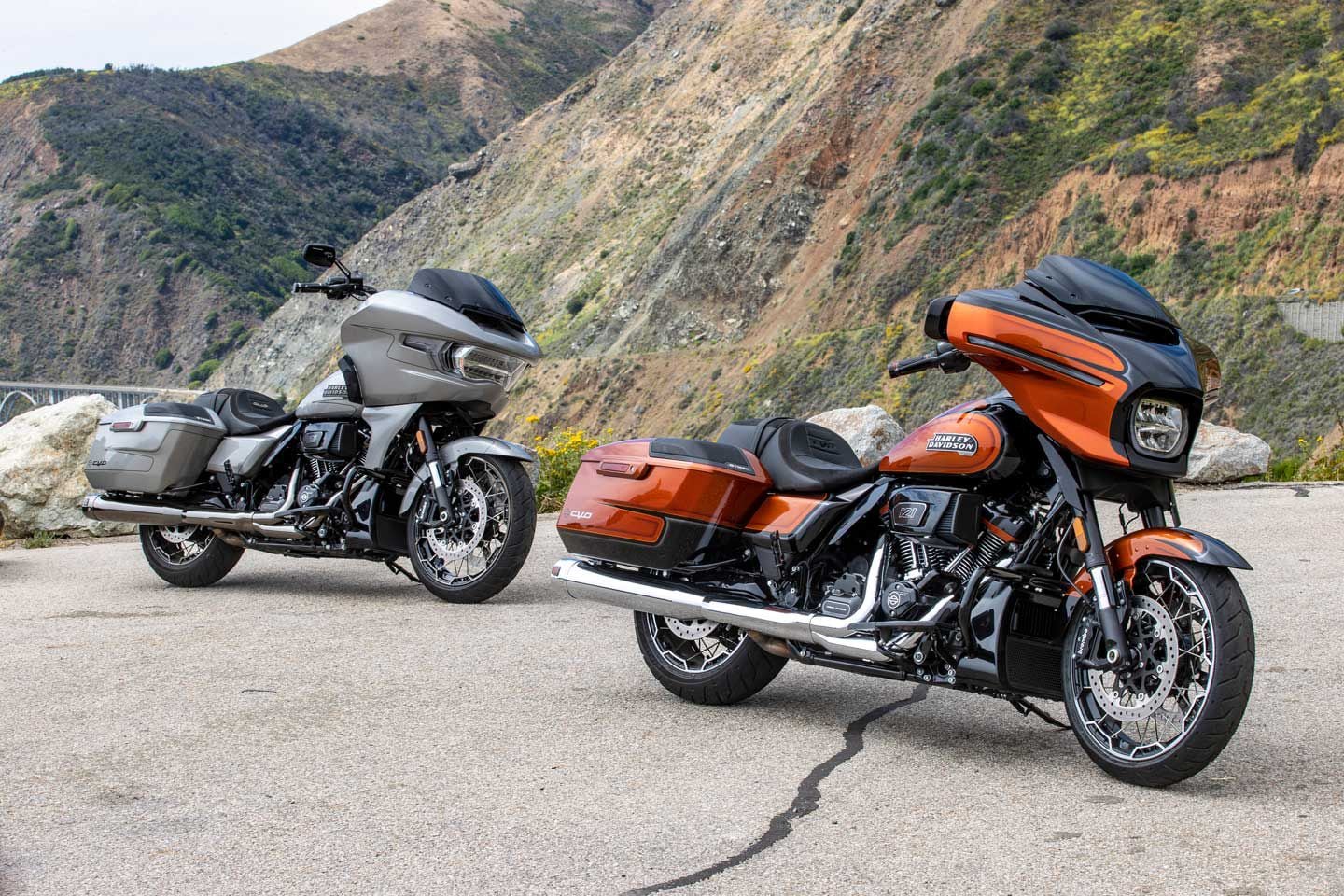
Claimed wet weight for the CVO Road Glide is 862 pounds and 838 for the CVO Street Glide. (Jeff Allen/)
These are still big, long, heavy touring bikes but they are more poised and capable than before and riding in your mental “sport mode” is rewarded with a quick pace.
Although the Road Glide “rides bigger” thanks to the physical presence of that large dash and fixed fairing, its steering is lighter and more precise because that fairing is not attached to the fork. You are therefore steering only the mass of the fork and front wheel. Its riding position is also more open thanks to the sort of mini-ape handlebar.
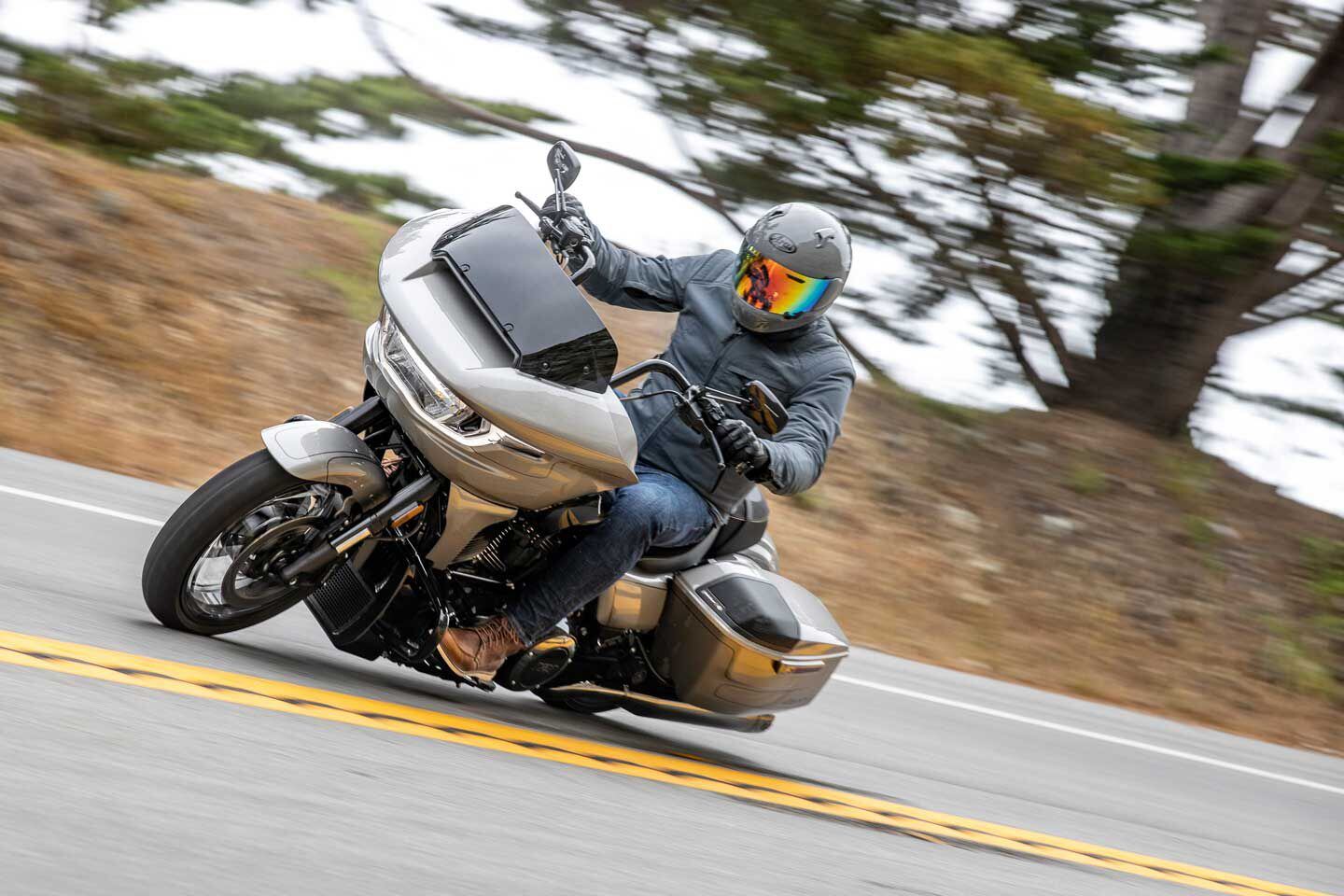
Although the CVO Road Glide weighs more and has a more spacious cockpit, it steers lighter and is more planted in corners than the Street Glide. (Jeff Allen/)
You just can’t get around the fact that the Street Glide’s fairing is attached to the fork. At higher speeds, it leads to feedback from wind that is always there and can affect steering. This generally means the Street Glide has a slightly less planted feeling at the front versus the Road Glide. And that fairing’s extra mass attached to the fork influences steering feel and effort, as well because you have to move it along with the fork and front wheel every time you turn in.
All up, though, there is increased comfort and composure from the CVOs versus previous touring models.
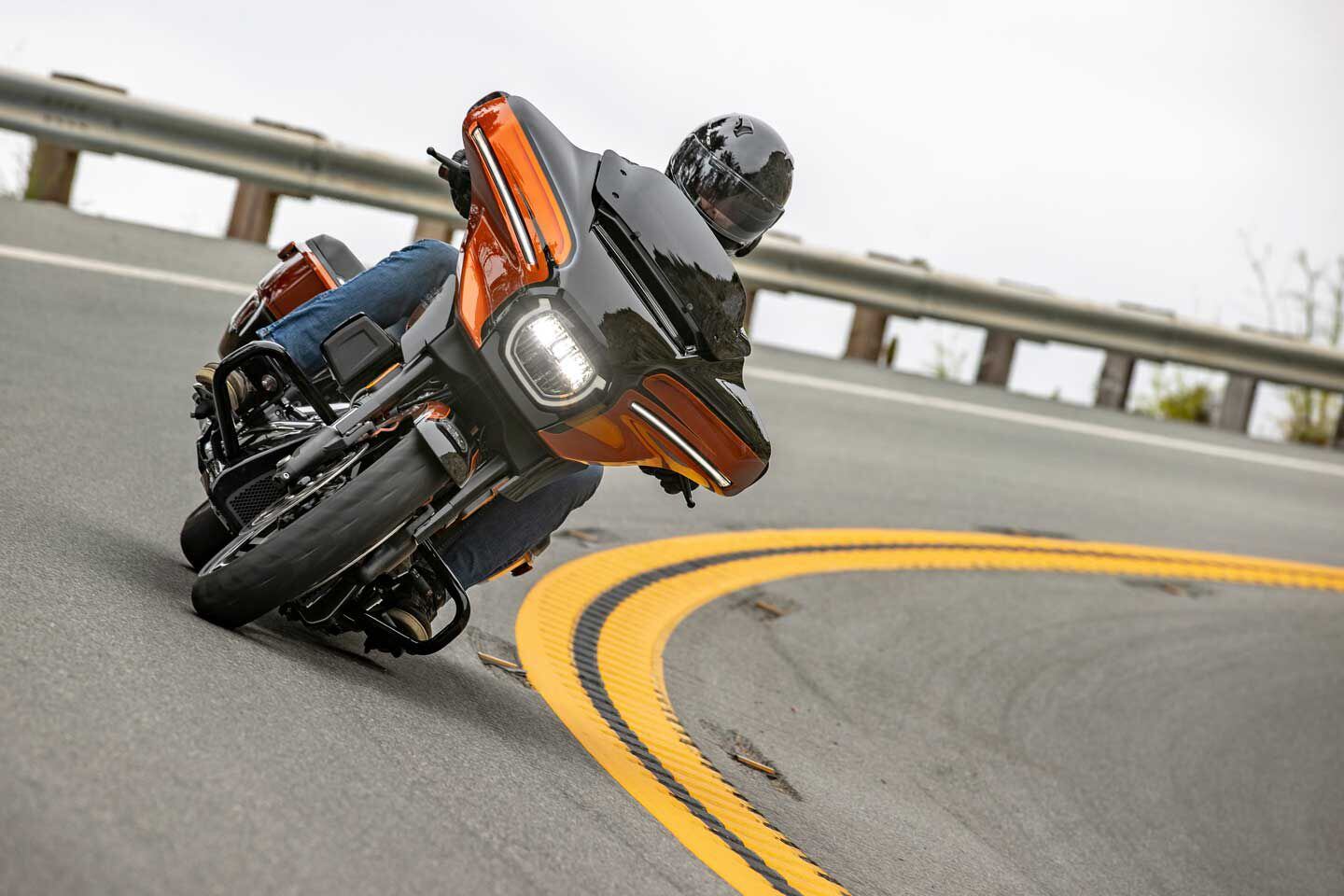
At high speeds, the CVO Street Glide’s fork-mounted batwing fairing affects steering and effort as well as front-end feel, making it less planted and slightly heavier-steering than the Road Glide. (Jeff Allen/)
Styling and Ergonomics
The Street Glide’s batwing fairing and the Road Glide’s fixed fairing are heavily reworked yet also instantly recognizable. Same goes for the reshaped 6.0-gallon fuel tank (expect 240-mile range based on our early fuel economy number) and slightly larger saddlebags. The 500-mile day on the previous Street Glide I mentioned reminded me that the fairing works pretty well up to about 60–65 mph, but buffeting and wind noise increase dramatically at speeds above this. Especially in the presence of trucks and/or under the influence of crosswinds.
The new Street Glide fairing is a big improvement in all regards, providing more still air at helmet level with reduced buffeting and lower wind noise.
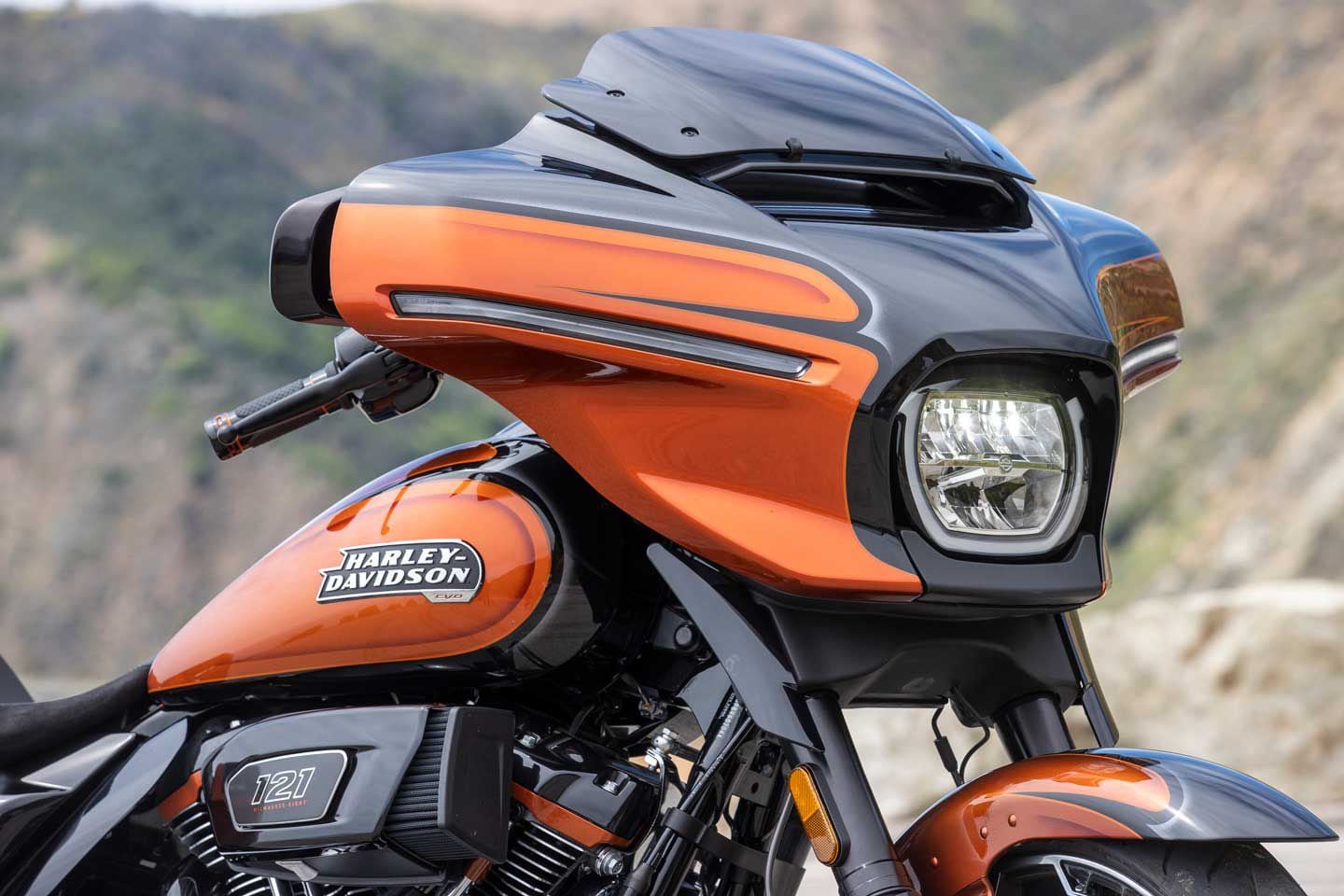
Being behind the CVO Street Glide’s new batwing fairing is a nicer place to be than that of the previous generation. (Jeff Allen/)
Same for the Road Glide. The fairing appears closer to the rider, which with changes in shape and windscreen design have resulted in smoother air. New taller flatter bars are surprisingly comfortable and I found them an improvement over the buckhorn design of the older Road Glide design.
Both bikes benefit from movable wind deflectors. The Street Glide’s are on the fork lowers and can be folded flat to let more air flow into the rider cockpit. The Street Glide gets adjustable “Willie Wings” that function similarly, and are particularly effective.
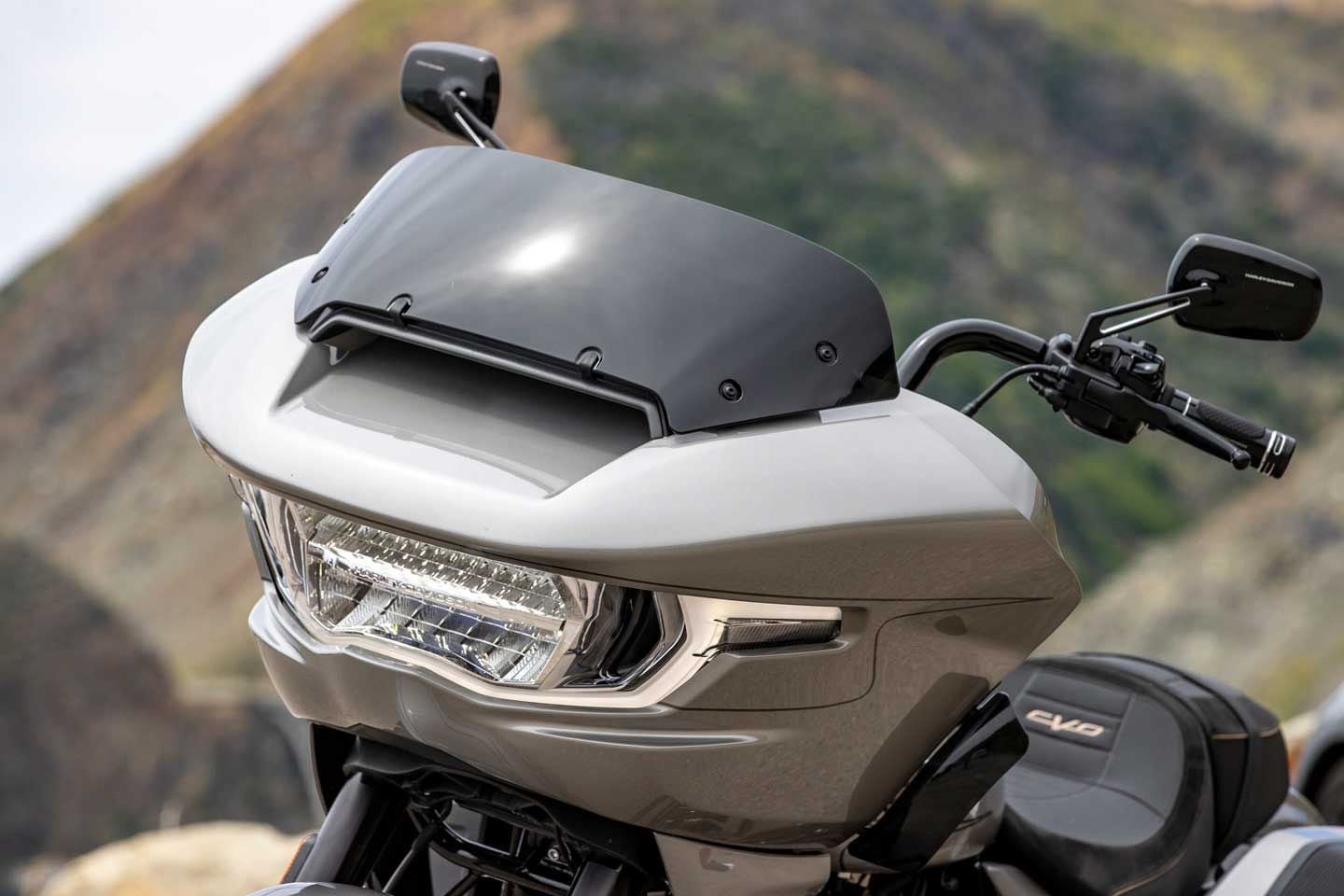
Just like the CVO Street Glide, the Road Glide’s new frame-mounted fairing provides improved air management. (Jeff Allen/)
I did not think of the reshaped seat once during our long day in the saddle. Harley says the new contour results in a more “neutral” back position, and not thinking of the seat is an indication of success.
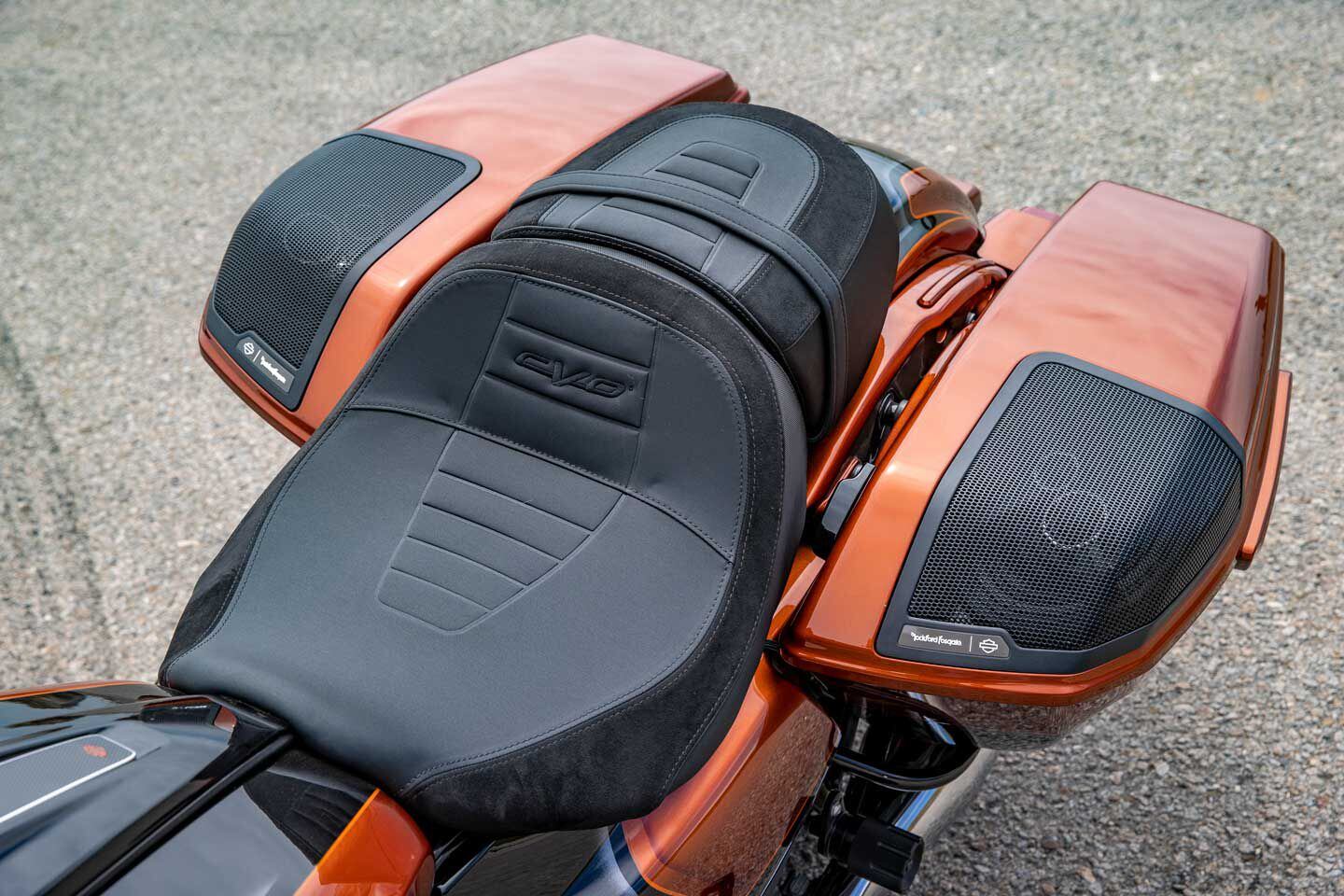
A good seat is one you don’t think about, and this was the case for the reshaped piece on both the CVO Road and Street Glide. (Jeff Allen/)
There is a remarkable difference in rider triangle just from the relative handlebar positions. The Street Glide’s is far more compact with its much lower handlebar, feeling even a little tight for this 6-foot-2 tester. It’s a matter of stance and attitude for the two bikes.
The lighting is LED, including now-integrated turn signals front and rear—there are no stalks, just smooth lighting with distinct visual signatures to complement the redesigns.
Electronic Rider Aids
Harley-Davidson was not on the leading edge of introducing rider aids, only adding TC and other assists to its two-wheelers in 2020 (TC was on trikes before this). The company has finally gone deep. Here’s a list of rider aids on the 2023 CVO Road Glide and Street Glide, including acronyms:
- Anti-Lock Brake System (ABS)
- Electronic Linked Braking (ELB)
- Traction Control System (TCS)
- Drag-Torque Slip Control System (DSCS)
- Vehicle Hold Control (VHC)
- Tire Pressure Monitoring System (TPMS)
- Cornering Enhanced Anti-Lock Brake System (C-ABS)
- Cornering Enhanced Electronic Linked Braking (C-ELB)
- Cornering Enhanced Traction Control System (C-TCS)
- Cornering Drag-Torque Slip Control System (C-DSCS)
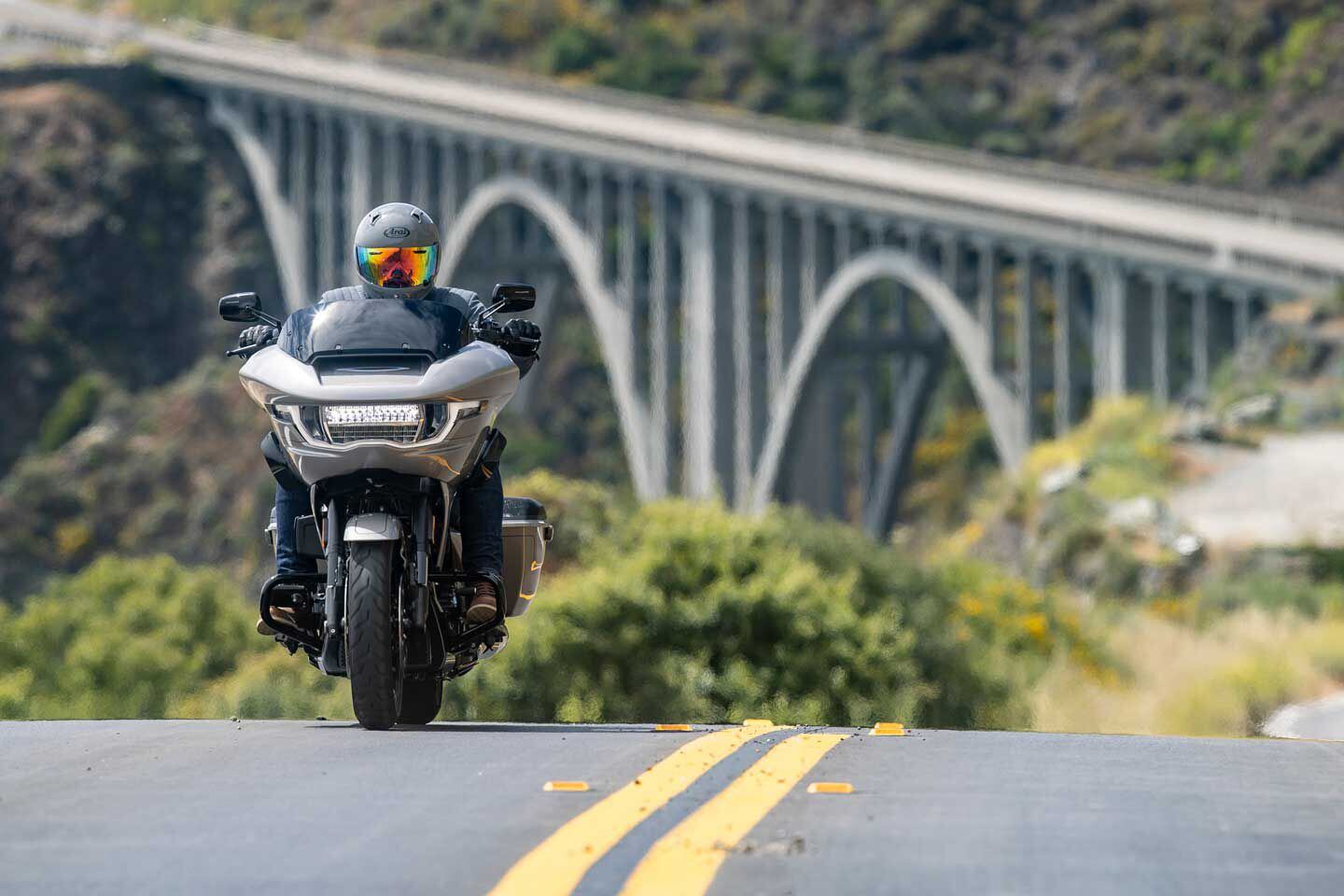
Both CVO Glides have cruise control, but lack the adaptive feature that is finding its way to more high-end motorcycles every year. (Jeff Allen/)
Preset ride modes—Road, Sport, and Rain—vary the degree of intervention of many of these features, as well as how the throttle responds and how much power is on tap. There are two user-customized modes that allow you to set the parameters. You can make the throttle, for example, very aggressive or quite soft in its response. Settings are easy to use and access. I preferred Sport mode’s crisp throttle response and higher engine-braking. Like on previous modes, TC can easily be disabled using a switch on one of the pods. So if you need to lay a smoky burnout or get that hard drag launch, have at it.
Not mentioned above is cruise control, which the CVOs have, but it is non-adaptive cruise. Other manufacturers are adding adaptive cruise to their higher-end motorcycles and it feels like an omission on a motorcycle with a $42,999 base price.
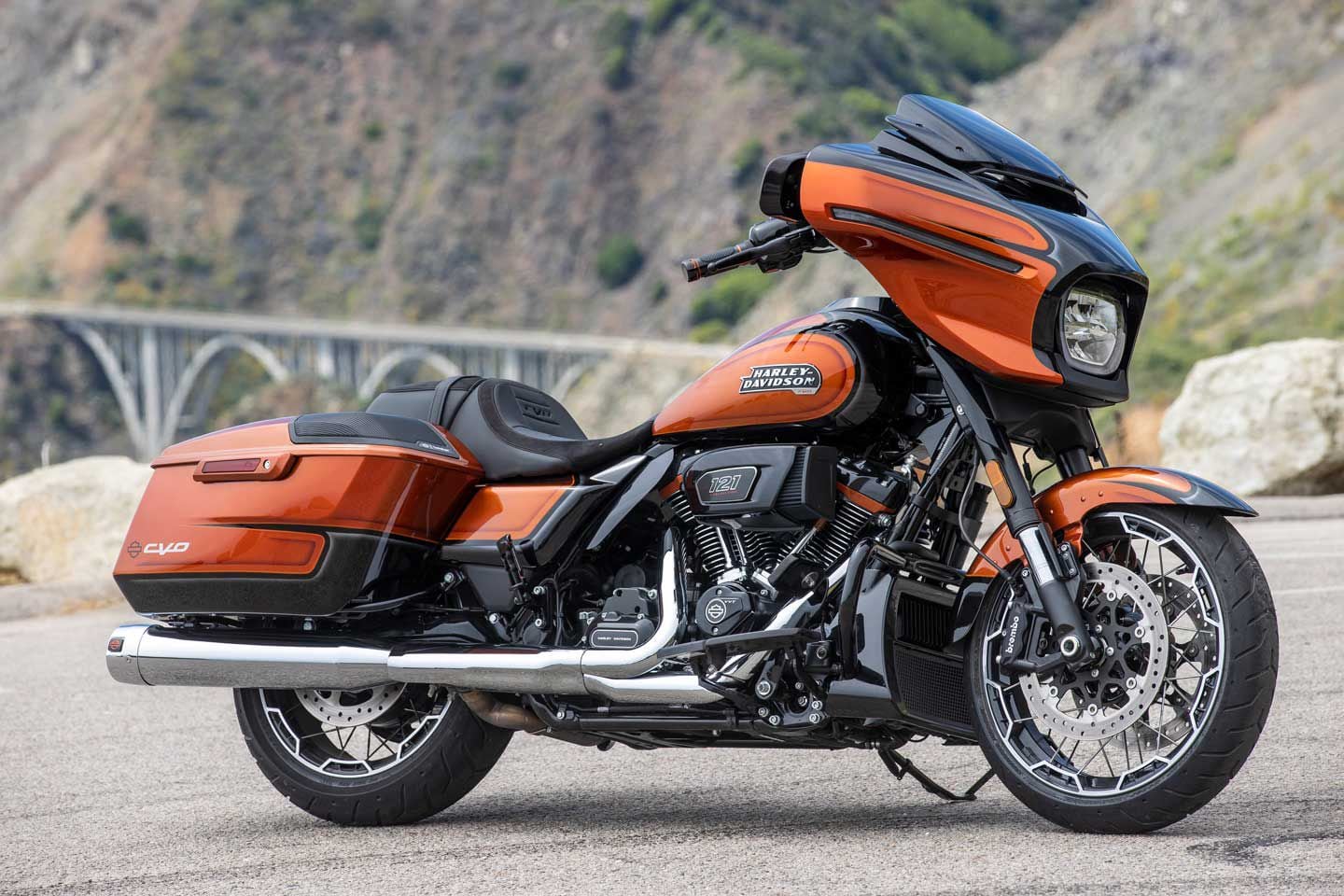
Base price for Harley’s 2023 CVO Glides is $42,999, but the hand-laid-out and sprayed Whiskey Neat with Raven Metallic paint adds $6,000. (Jeff Allen/)
Infotainment
Ride modes and nearly everything else on the 2023 CVO Road Glide and Street Glide is accessed using the very wide 12.8-inch diagonal TFT touchscreen.
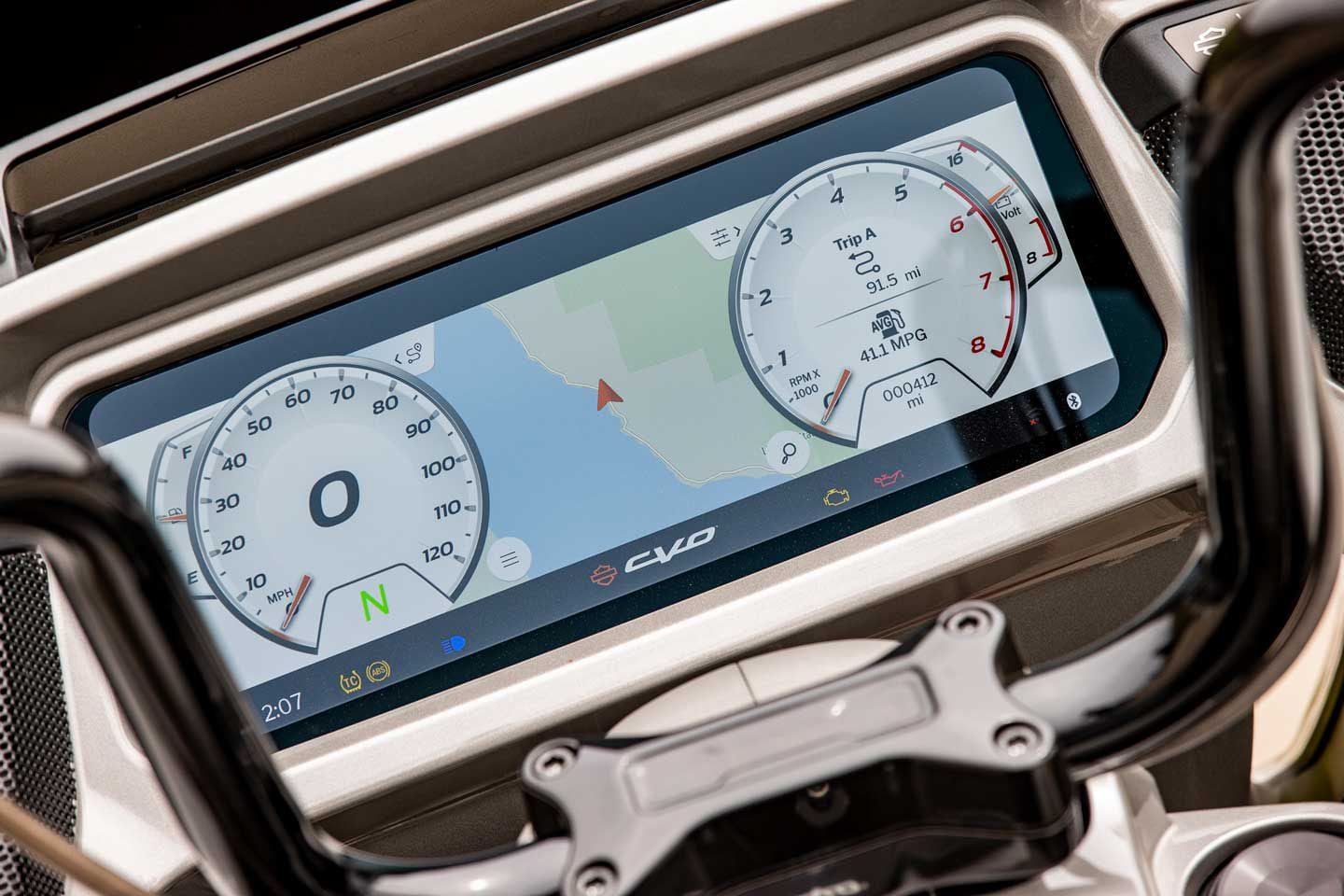
A 12.8-inch TFT touchscreen is the command center of the new CVO Glides’ electronics and infotainment. (Jeff Allen/)
Functionality during our one-day ride was good, and gloved hands worked just fine for poking through (many) options. There are also screen-navigation buttons on both of the new switch-gear pods that allow for most functions to be controlled by the rider without removing hands from grips. I found using the nav buttons a bit more challenging than just straight up poking things on the screen with my finger, but it was just a day ride, so we’ll revisit this when we get more seat time.
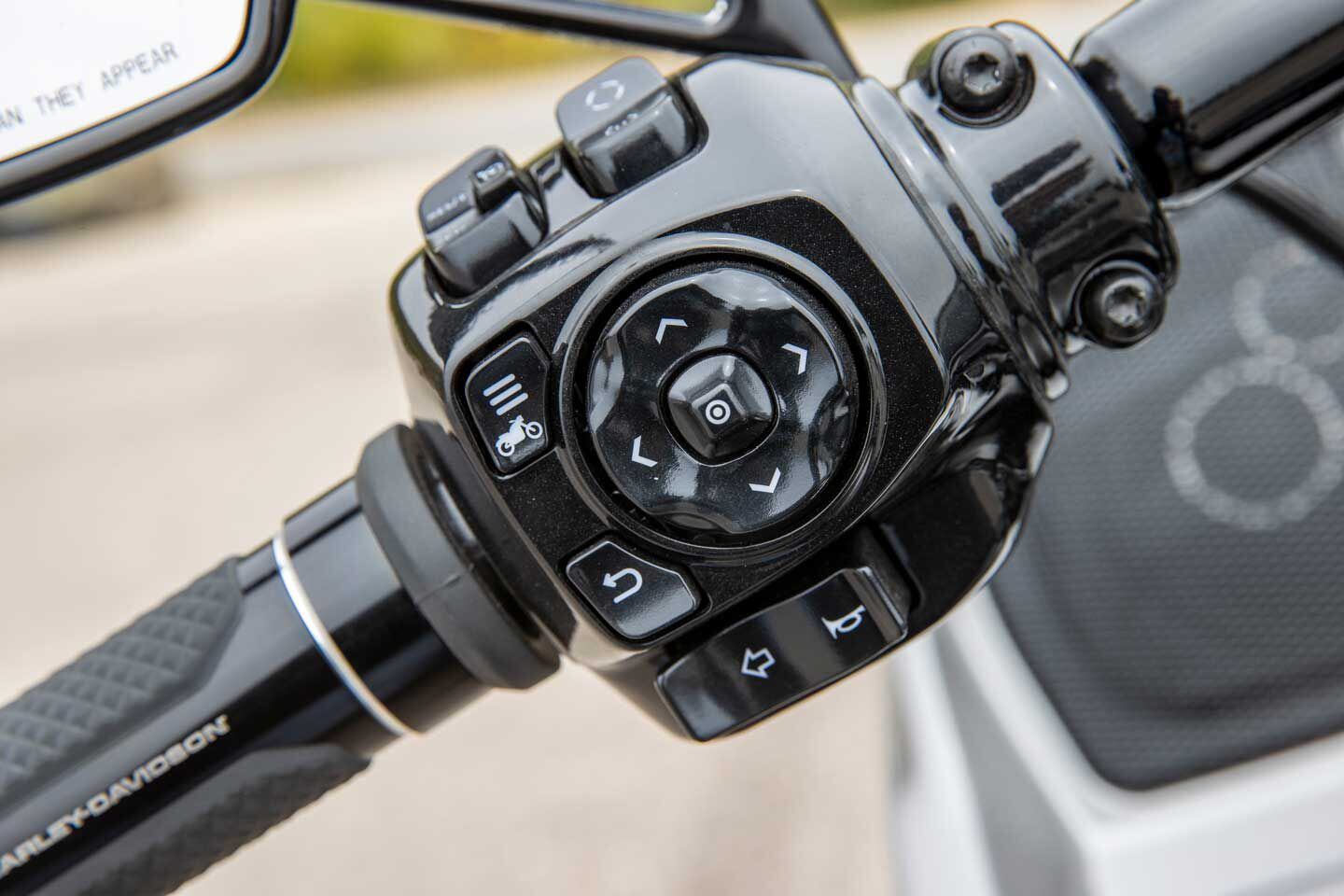
It will take some time to commit all of the switch gear on the 2023 CVO Road Glide and Street Glide to memory. This is roughly half of them. (Jeff Allen/)
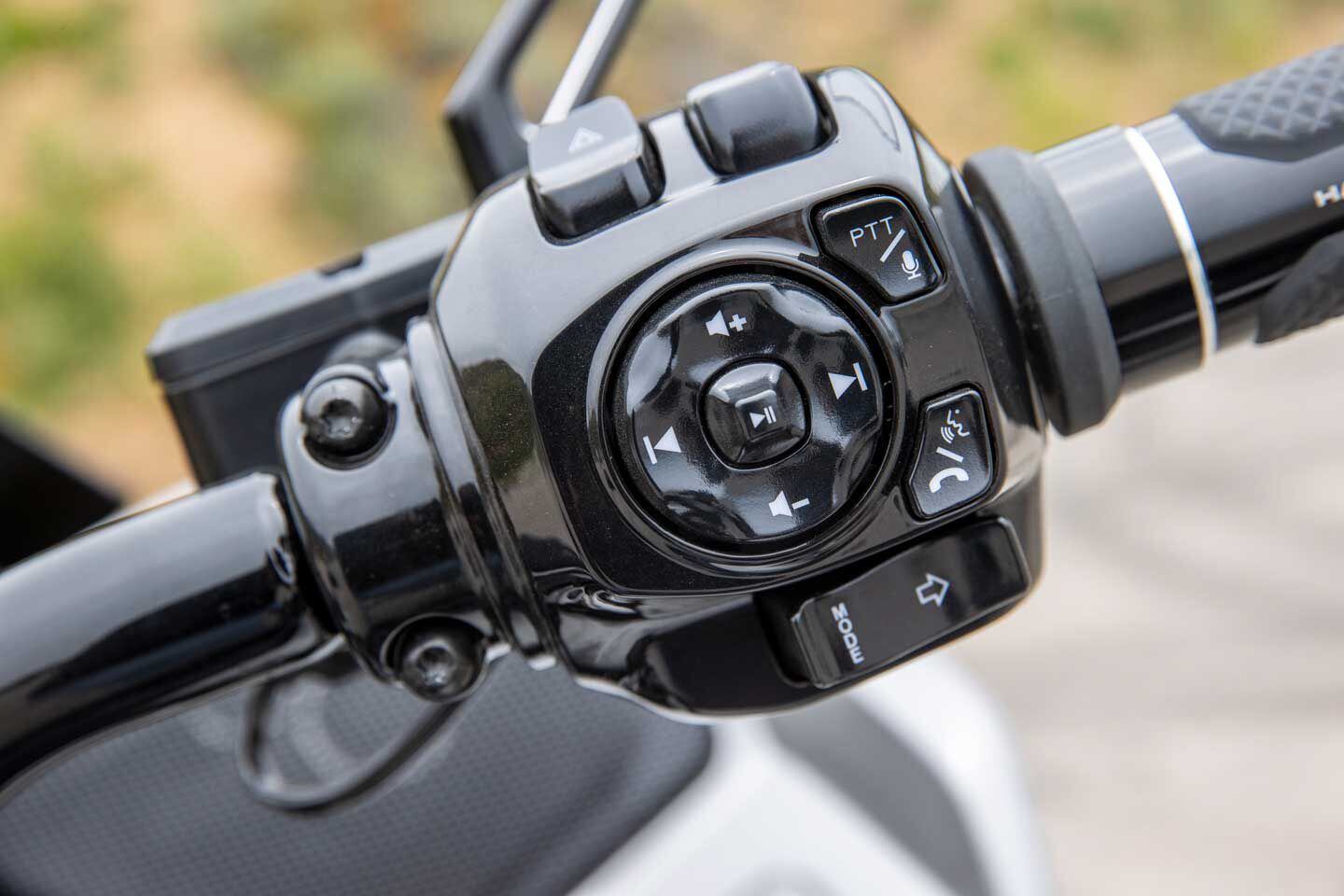
And here’s the other half. (Jeff Allen/)
It was clear Harley-Davidson was still working out a few coding quirks in this complex system as we would sometimes lose one of the widgets (tire pressure/engine temp block and the like) in one of the three display modes: Cruise, Sport, and Tour. Each display mode organizes the gauges, apps, and widgets differently to suit the intended riding. There are no mechanical gauges—tachometer, speedometer, and the rest is all fully digital on the screen.
Apple CarPlay is integrated here, and requires the use of a headset because they’d like you to use voice commands. Harley-Davidson says Android Auto no longer supports motorcycles; streaming music and taking calls are your only Android options. A USB-C cable is in the (enlarged) right-hand cubby on the Road Glide and there is now a drawer below the TFT that slides out to accept your device (and more—it’s generously sized).
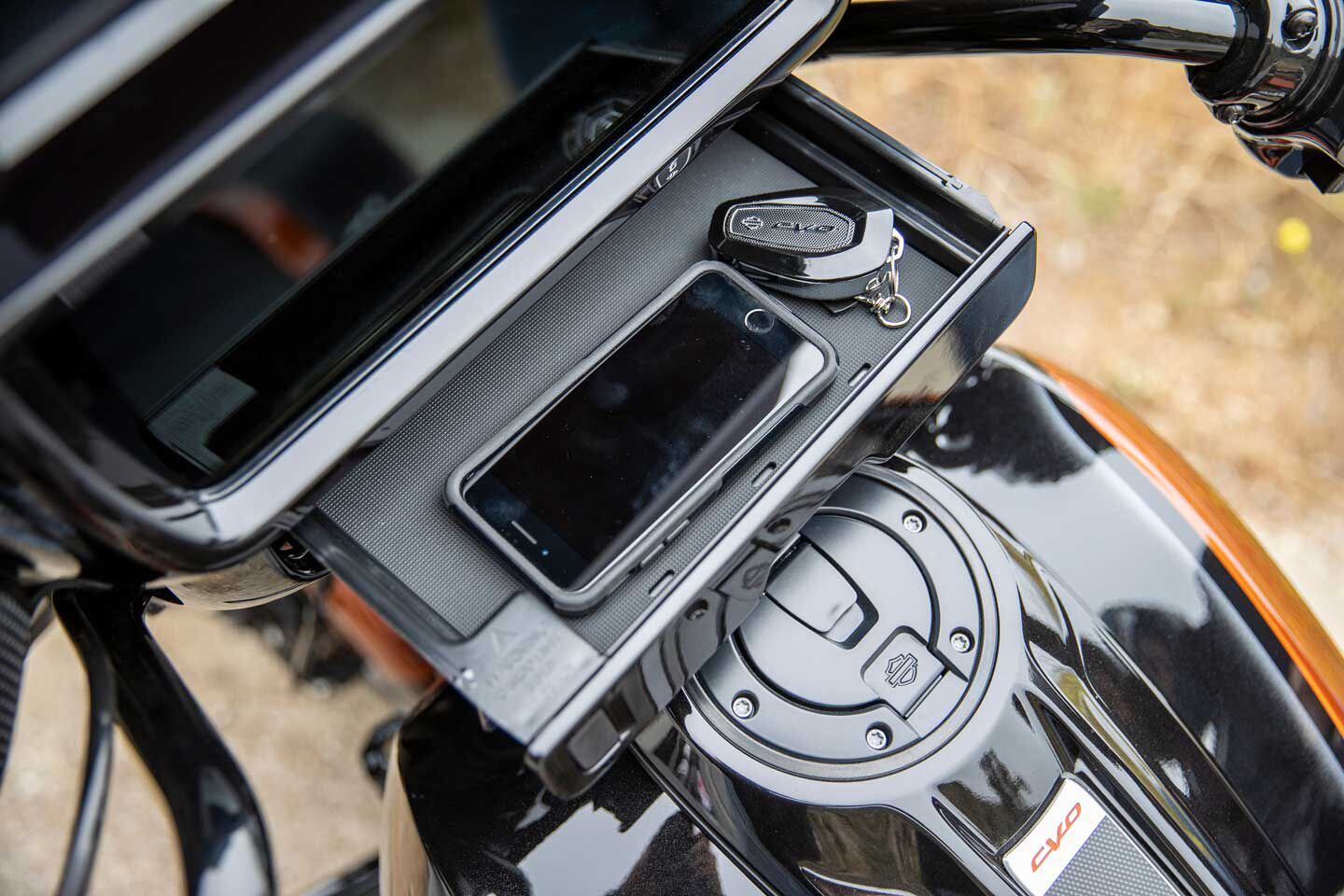
A massive slide-out drawer in the CVO Street Glide’s fairing has room for all the phones. (Jeff Allen/)
Powering all this electronica is a new, higher-output alternator that produces 58 amp. Charging systems are the unsung heroes of touring bikes, and this 20-plus-percent improvement helps power multiple outlets awaiting all the heated gear and chargers you can throw at them.
Conclusion
The 2023 CVO Road Glide and Street Glide appear to represent a new era for Harley-Davidson’s Grand American Touring line. We said “appear” because these are currently the only two motorcycles to have these changes. Will other touring models get some of or all of these changes in the 2024 model year or beyond? As ever, Harley-Davidson says, “We do not discuss future product.” But I will eat my hat if most of these updates don’t go across the touring line. And that’s a pretty big deal because my hat is usually fiberglass.
VVT is long overdue on Big Twins and absolutely belongs on these engines and in this application because it improves refinement, response, and efficiency so much. We wish we’d seen these chassis changes years earlier, in fact, because the inverted fork, floating front brake discs, and new shock with more travel have truly improved already good-handling traditional tourers. It’s just that if Harley-Davidson had done this part of the job sooner, it might be time now to have added electronic damping and spring-preload adjustment, for example.
But previous company leadership during the “More Roads to Harley-Davidson” were actually de-emphasizing touring model development. That’s clearly changed now as the company focuses on the models that have built the brand and are popular with its massive customer base. Imagine.
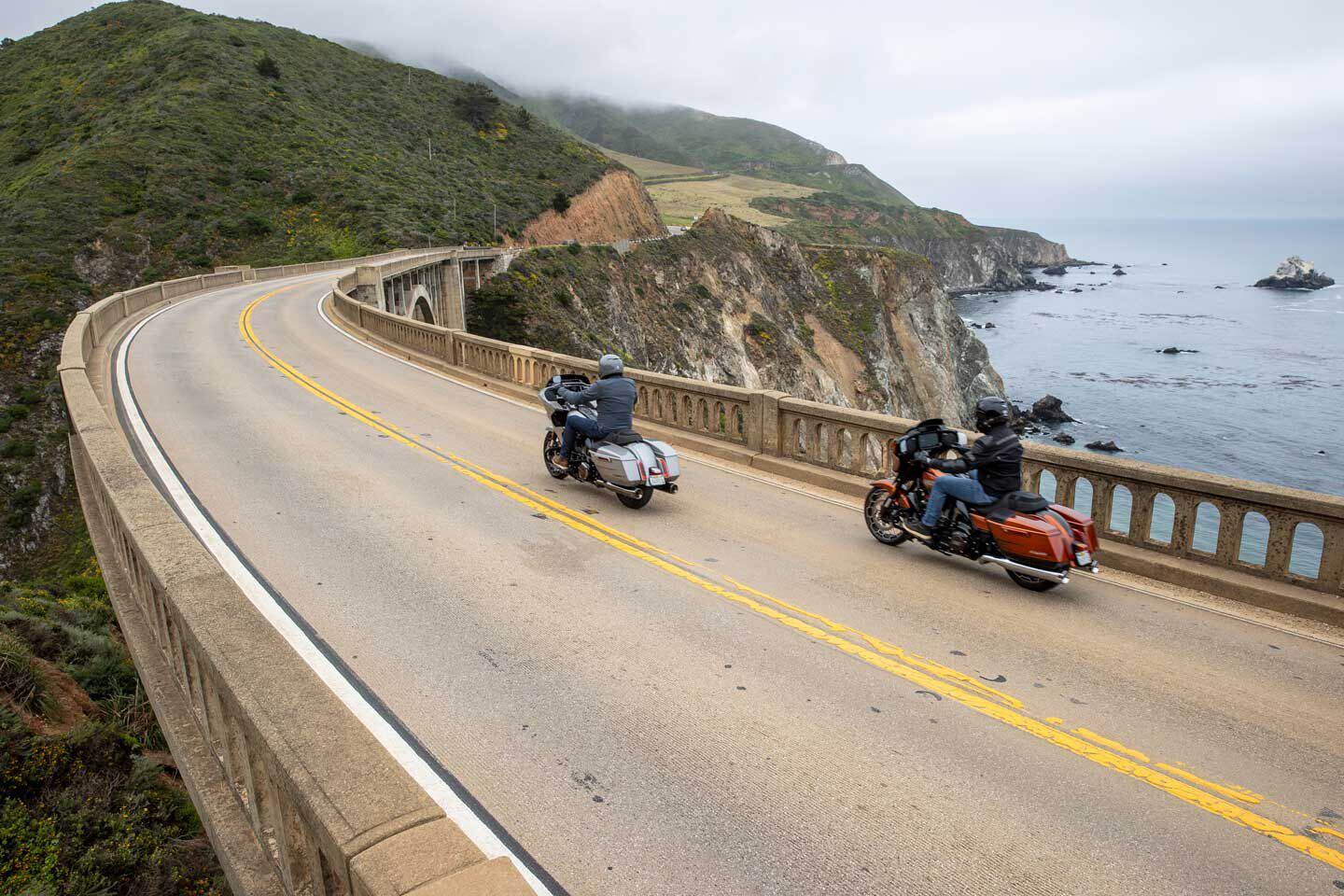
These CVO baggers are most likely an early look at some or all of the features coming for Harley’s non-CVO Grand American Touring line. Good things are to come if that’s the case. (Jeff Allen/)
We’d like to see a few more features, yes, but the CVO Road Glide and Street Glide are genuinely improved. And perhaps Harley-Davidson knows something about its customer and what they value given the roughly 2 million touring bikes it’s sold in the last 22 years.
If you have the budget, the CVO Road Glide and Street Glide are an easy choice versus any of those 2 million used touring bikes in the market and even other 2023 models without the updates. It appears the outsized impact of the Harley-Davidson bagger on American motorcycling is set to continue.
2023 Harley-Davidson CVO Street Glide/CVO Road Glide Specs
| MSRP: | $42,999 (base) |
| Engine: | Liquid-cooled, 45-degree V-twin; 4 valves/cyl. |
| Displacement: | 1,977cc |
| Bore x Stroke: | 103.5 x 117.5mm |
| Compression Ratio: | 11.4:1 |
| Transmission/Final Drive: | 6-speed/belt |
| Claimed Horsepower: | 115 hp (86kW) @ 4,500 rpm |
| Claimed Torque: | 139 lb.-ft. (189 Nm) @ 3,000 rpm |
| Fuel System: | Electronic Sequential Port Fuel Injection |
| Clutch: | Wet, multiplate slipper/assist |
| Frame: | Steel tube w/ two-piece backbone and bolt-on rear subframe |
| Front Suspension: | 47mm inverted Showa fork; 4.6 in. travel |
| Rear Suspension: | Dual emulsion shocks, spring preload, rebound damping adjustable, 3.0 in. travel |
| Front Brake: | 4-piston radial-mount calipers, floating 320mm discs w/ ABS |
| Rear Brake: | 2-piston caliper, 300mm disc w/ ABS |
| Wheels, Front/Rear: | Cast laced; 19 x 3.5 in. / 18 x 5 in. |
| Tires, Front/Rear: | Dunlop H-D Series bias blackwall; 130/60B-19 / 180/55B-18 |
| Rake/Trail: | 26.0°/6.7 in. |
| Wheelbase: | 64.0 in. |
| Ground Clearance: | 5.5 in. / 5.7 in. |
| Seat Height: | 28.0 in. / 28.1 in. |
| Fuel Capacity: | 6.0 gal. |
| Claimed Wet Weight: | 838 lb. / 862 lb |
| Contact: | harley-davidson.com |
The 2023 Harley-Davidson Breakout 117 features the Milwaukee-Eight V-twin powertrain, which is currently H-D’s largest powerplant until the recently announced 121 leads the displacement race. The Milwaukee-Eight 117 is a counterbalanced 117ci (or 1,923cc) air-cooled V-twin with four valves per cylinder, a 10.2:1 compression ratio, and 103.5 x 114mm bore and stroke.
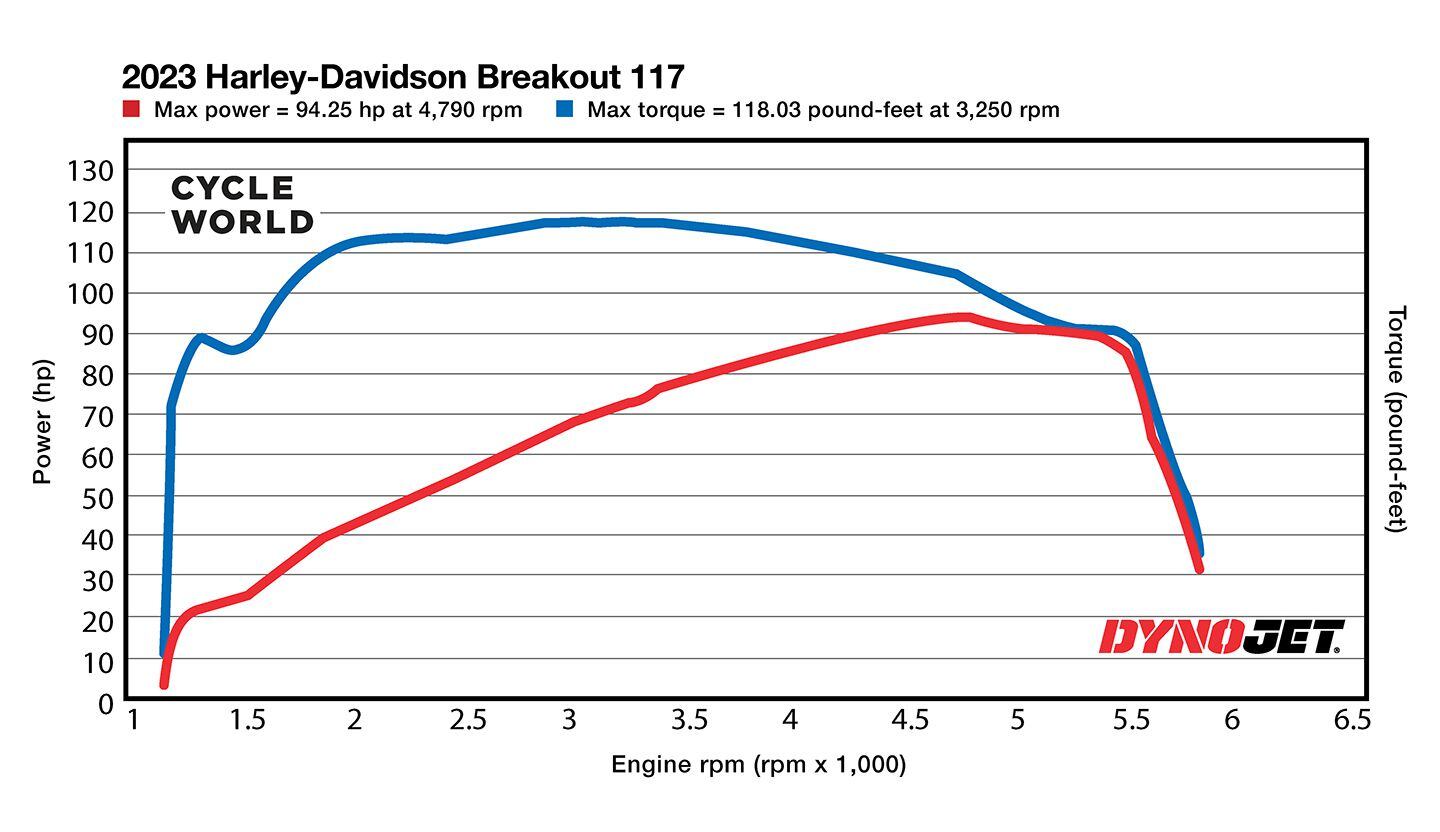
2023 Harley-Davidson Breakout 117 Dyno Chart (Robert Martin/)
On our Cycle World Dynojet 250i dynamometer, the Harley-Davidson Breakout 117 produced an impressive 94.2 hp at 4,790 rpm and 118 lb.-ft. of peak torque at 3,250 rpm. With massive amounts of torque available right off idle and an extremely linear power curve, the 2023 Harley-Davidson Breakout 117 can effortlessly cruise up the boulevard or rip like a dragster from one light to the next.
]]>After teasing a few photos in April, Harley has officially released the 2023 CVO Street Glide and CVO Road Glide models, both featuring the Milwaukee-Eight 121 engine. (Harley-Davidson/)
H-D dropped the usual vague teaser for its upcoming CVO models back in April, citing a new, bigger 121ci powerplant and improved suspension as the main changes for the mid-year bikes. Now, as promised, comes the full info dump, with Harley filling in the blanks for us and providing detailed specifications for the 2023 CVO Street Glide and 2023 CVO Road Glide. The full announcement touts the aforementioned new Milwaukee-Eight VVT 121 engine that appears on both new 2023 CVO models, as well new, beefier Showa suspension components front and rear, new ride modes, a fresh infotainment system, and reworked key external surfaces like the fairing, fuel tank, and saddlebags to create a more “dynamic flow,” as The Motor Company puts it. There’s lots more to discuss, so let’s get into it.
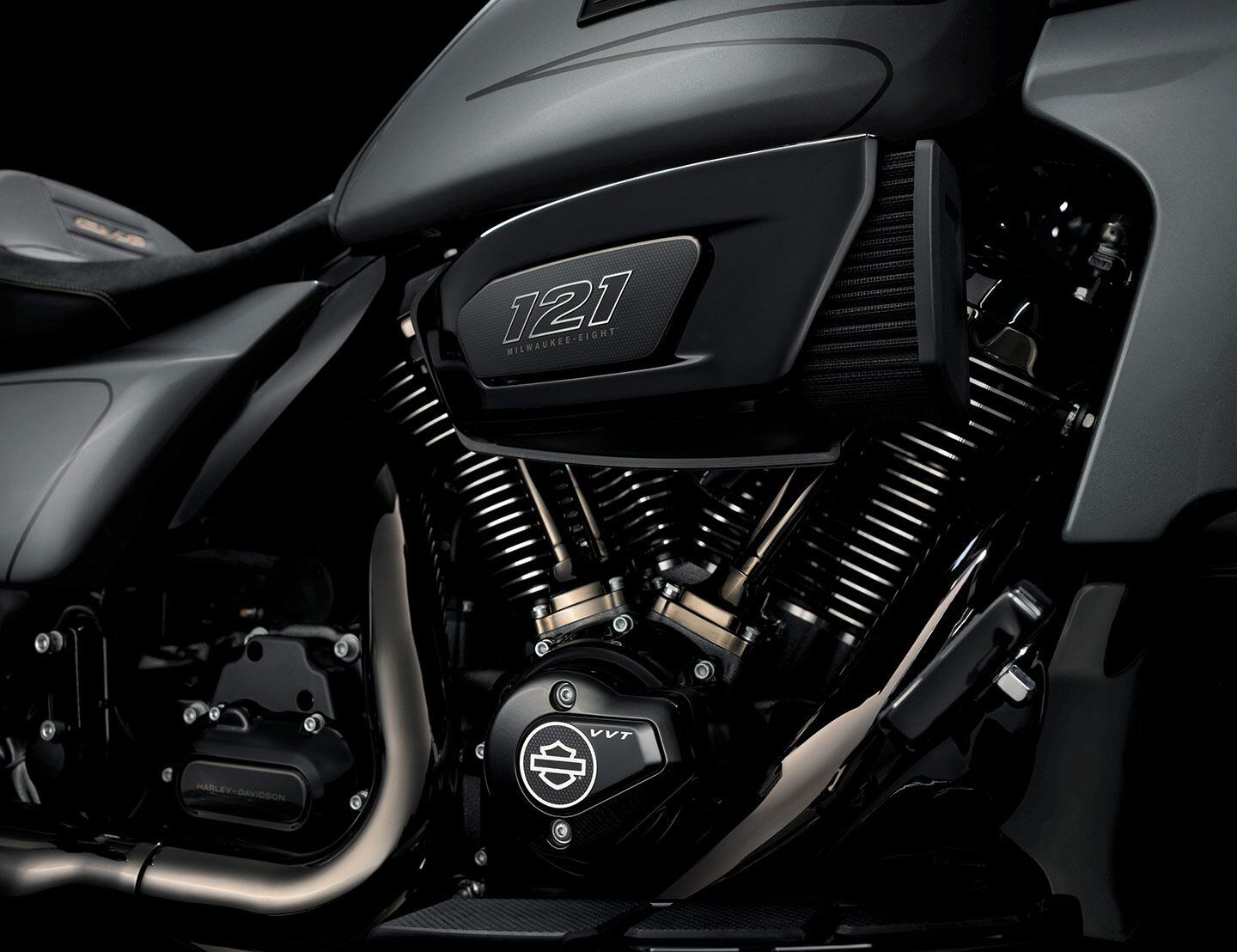
The new Milwaukee-Eight VVT 121 engine features liquid-cooling, displaces 1,977cc, and is said to produce 115 peak horsepower at 4,500 rpm. (Harley-Davidson/)
The main mechanical upgrades are on both CVO models. The marquee feature for both is obviously the new Milwaukee-Eight 121ci V-twin engine, which H-D claims yields approximately 8 percent more torque and 9.5 percent more horsepower than the Twin-Cooled M-8 117 engine. For context, we’re talking a claimed 115 hp at 4,500 rpm and 139 lb.-ft. of torque at 3,000 rpm from the 1,977cc mill, which also employs variable valve timing (VVT). Digging deeper into the M-8 121 engine reveals redesigned liquid-cooled cylinder heads with new channels for coolant flow around the exhaust valves; the aim here is to reduce heat transfer to the rider, especially in low-speed and hot-weather scenarios. A high-performance camshaft with higher lift and longer duration also adds to increased power and torque; compared with the Milwaukee-Eight 117 engine, compression ratio is increased to 11.4:1 on the 121. A single counterbalancer is tuned to cancel any unwanted vibes.
Other refinements to the big 45-degree Vee include a new intake tract and a larger throttle body diameter (now 58mm) positioned closer to the center of the cylinder and to intake valves to enhance airflow. A larger and lighter airbox also replaces the Heavy Breather intake used on previous CVO engines, and is matched to a new high-performance exhaust featuring a larger-diameter muffler (increased to 4.5 inches from the previous 4.0 inches) with a high-flow design.
Related: Harley-Davidson Teases All-New 2023 CVO Street Glide
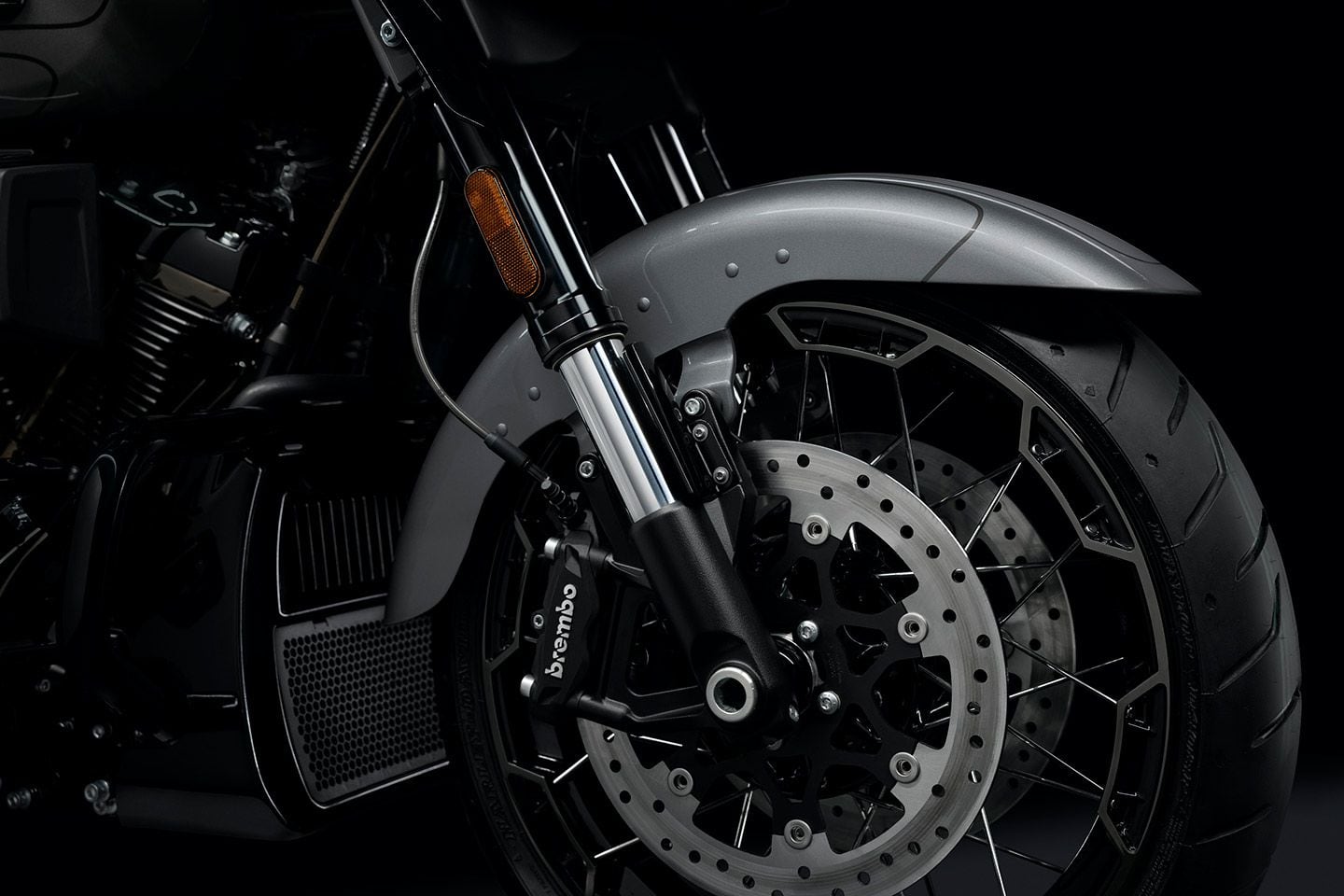
New inverted Showa fork adds 50 percent more travel than on previous CVO model; beefier brake discs with four-pot calipers also appear up front. (Harley-Davidson/)
Another plus for both models is the new suspension, with an inverted 47mm Showa fork offering 4.6 inches of travel up front, but alas, no option for adjustment (believe it or not, that’s still an improvement of 50 percent over the outgoing model). At the back is a pair of Showa outboard emulsion shocks offering a more modest 3 inches of movement, though at least they’re adjustable for preload via a remote hydraulic adjustment knob near the left saddlebag. Rebound damping can also be adjusted for the rear, but it means you’ll be looking at the removal of those saddlebags to gain access.
Braking performance on the new CVO Glides also gets a boost thanks to larger-diameter front discs and premium Brembo components. The dual front disc brakes—now 320mm—are gripped by radially mounted four-piston Brembo calipers, while the single rear brake features a two-piston Brembo caliper with a 300mm disc.
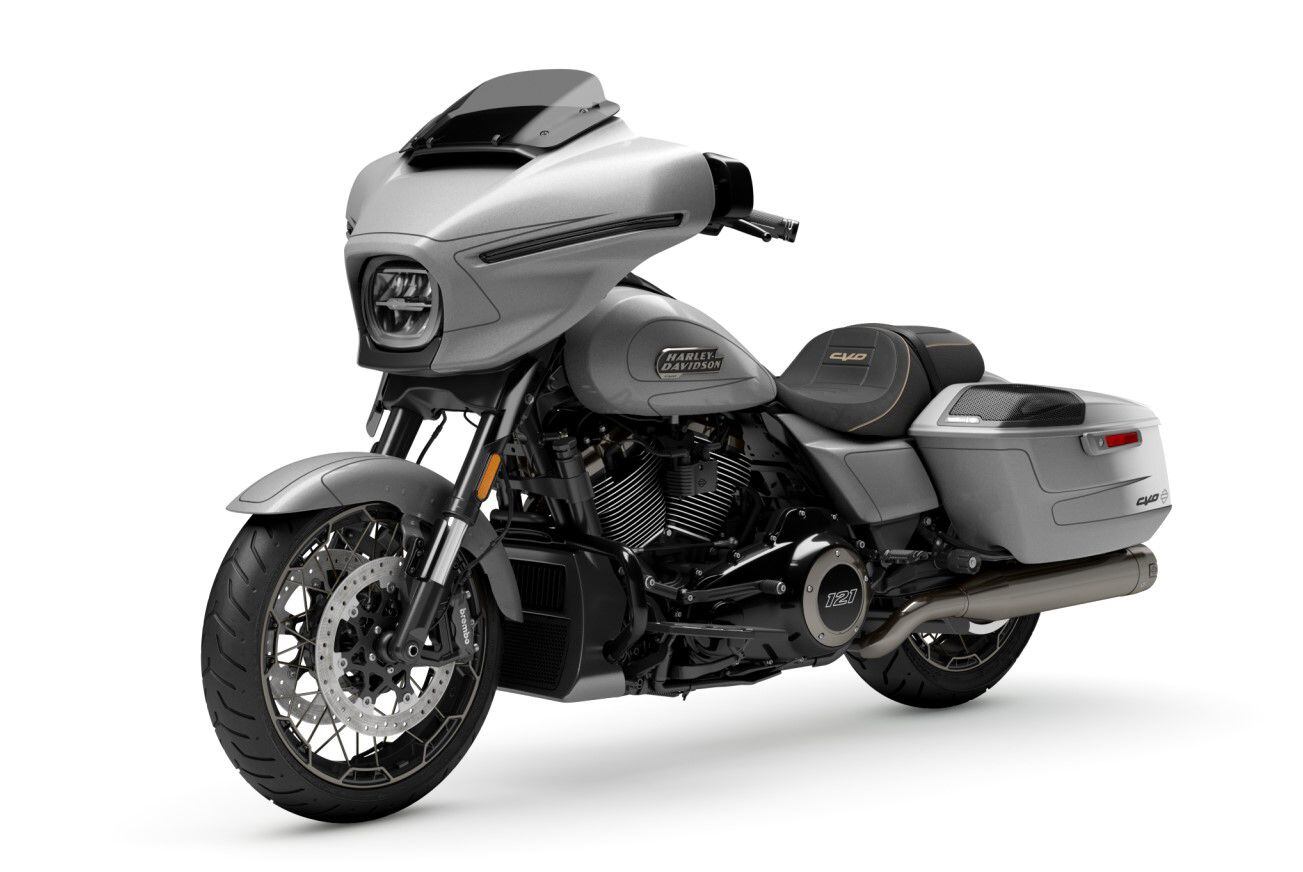
2023 CVO Street Glide features a redesigned front fairing with new LED lighting as a design element; fenders and redesigned tank and saddlebags follow more cohesive design flow. This is the standard Dark Platinum with Bright Smoked Satin pinstriping color. (Harley-Davidson/)
2023 CVO Street Glide
The visual changes on the CVO Street Glide may feel minor at first glance, but there’s substantial refinement from its immediate predecessor. Unmissable is the Glide’s updated batwing fairing which retains the iconic “T” layout, but streamlines its silhouette, with the split-stream vent now fully integrated into the design. As a distinctive design element, the LED headlamp takes on a new shape with its amber LED turn signals now integrated into the left and right lamp elements for a cleaner overall look. Additional LED elements swoop outward from the main lamp along the left and right sides of the fairing for a dramatic effect. The combination rear brake/tail/signal lighting now moves to between the rear fender and the saddlebags, and for even more drama, the lighting stays illuminated for 10 seconds after you shut the bike down.
Related: 2023 Harley-Davidson CVO Street Glide 121 Revealed
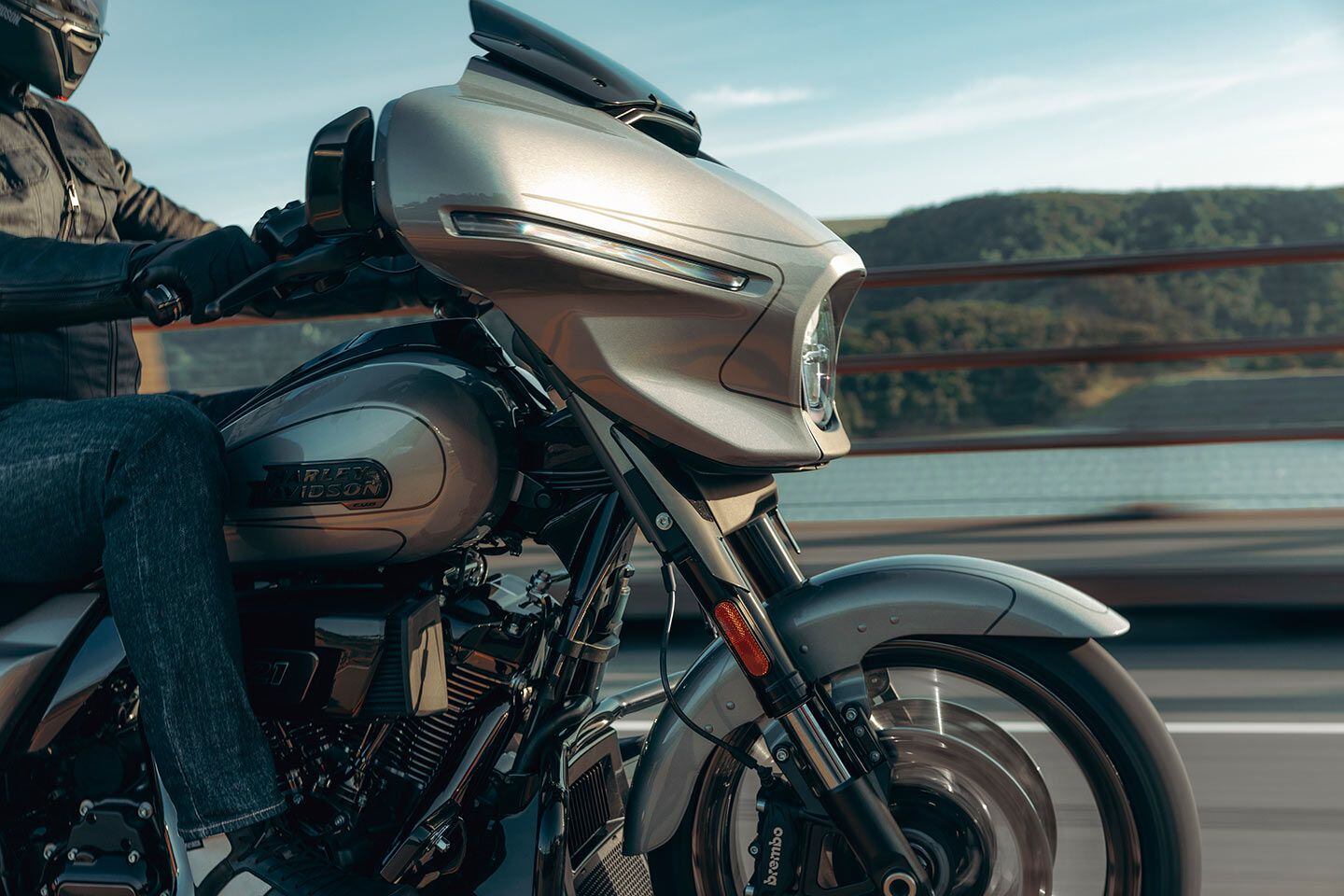
The batwing fairing‘s slip-stream vent is now integrated and a new adjustable center allows riders to dial in airflow. (Harley-Davidson/)
The new fairing also gets a “floating” windshield design with a new adjustable control vane in the fairing center vent of both models, allowing the rider to dial in their airflow, thus balancing air pressure behind the fairing to minimize helmet buffeting at speed. Air deflectors on the fork skirts of the CVO Street Glide can be tweaked to reduce wind turbulence to the rider’s head as well.
There are other subtle design details on both as well, including briefer front fenders, a new 6-gallon fuel tank with a distinctive side bevel, and reshaped saddlebags designed to better flow with the fairings and fuel tank. The new Combo Cast Laced wheels make a bold custom statement with a black machine-cut cast-aluminum rim and laced spokes. Like the CVO Road Glide, the Street Glide will come in two finish options.
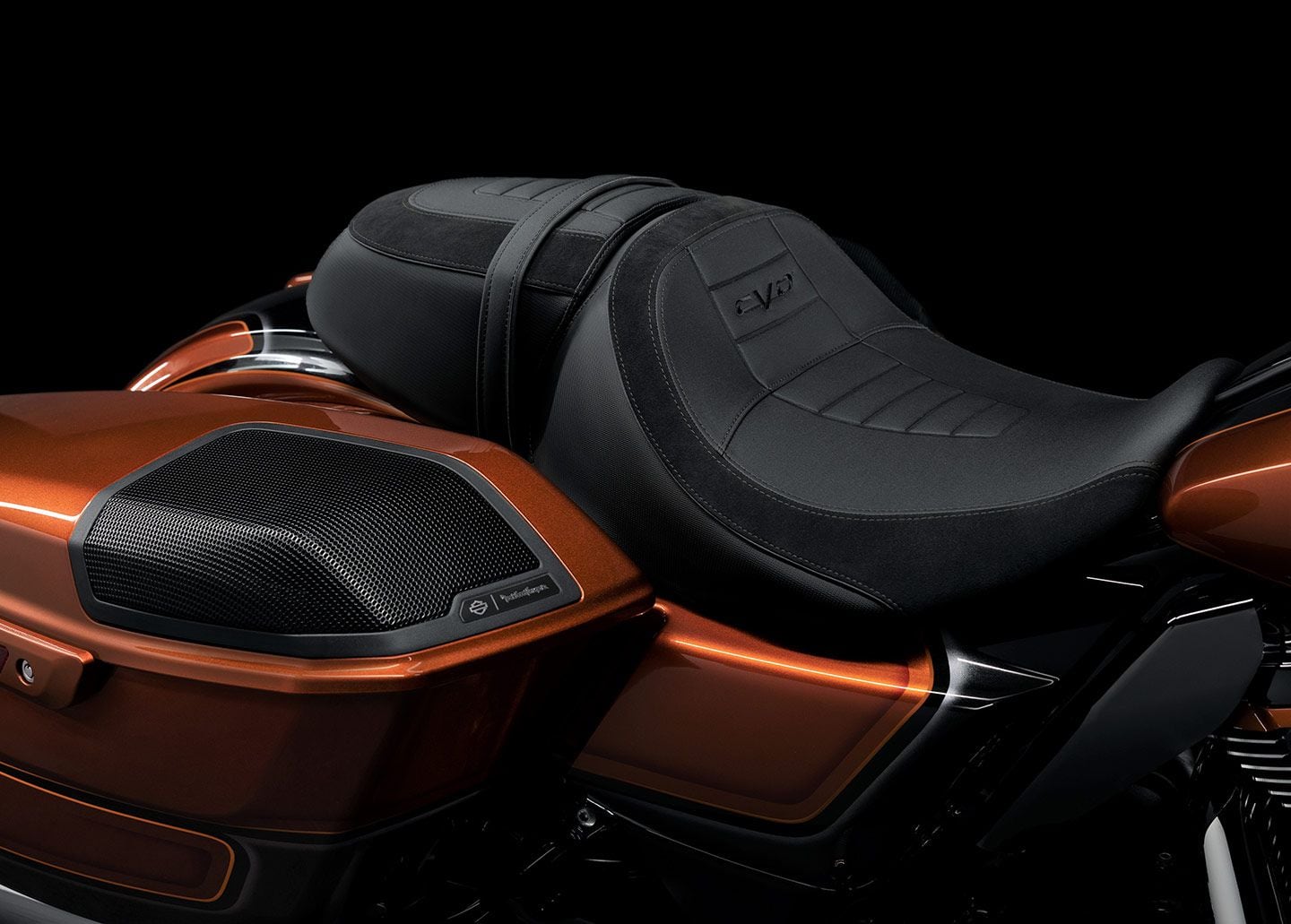
Improved ergonomics include a redesigned seat for both models, set at 28 inches off the ground. The new saddlebags appear more compact, but actually have slightly more volume for speakers and cargo. (Harley-Davidson/)
Ergonomic issues have been addressed on the new CVO Street Glide as well, with a redesigned seat and padding shaped to place rider’s hips in a neutral position reducing fatigue on the back and neck. The front brake lever is also adjustable for reach to better match rider hand size or preference, and the standard heated grips can be temperature-adjusted on the grip or through the infotainment display.
As for that infotainment, say goodbye to the Boom! Box; you’re now looking at a 12.3-inch TFT touchscreen that’s 90 percent larger diagonally than the outgoing unit and replacing most of the switches on previous CVOs. It’s powered by a new operating system called Skyline which has a fancy new voice recognition system and supports Bluetooth and Apple CarPlay (but not Android as of press time) as well as a host of other add-ons. Both CVO models are also equipped with a premium, high-performance Harley-Davidson Audio powered by Rockford Fosgate Stage II audio system buttressed by a new four-channel, 500-watt RMS amplifier and supported by 6.5-inch fairing speakers and Stage II three-way 5 x 7-inch saddlebag speakers.
Related: Harley Releases Ride Routes to 120th Anniversary Festival
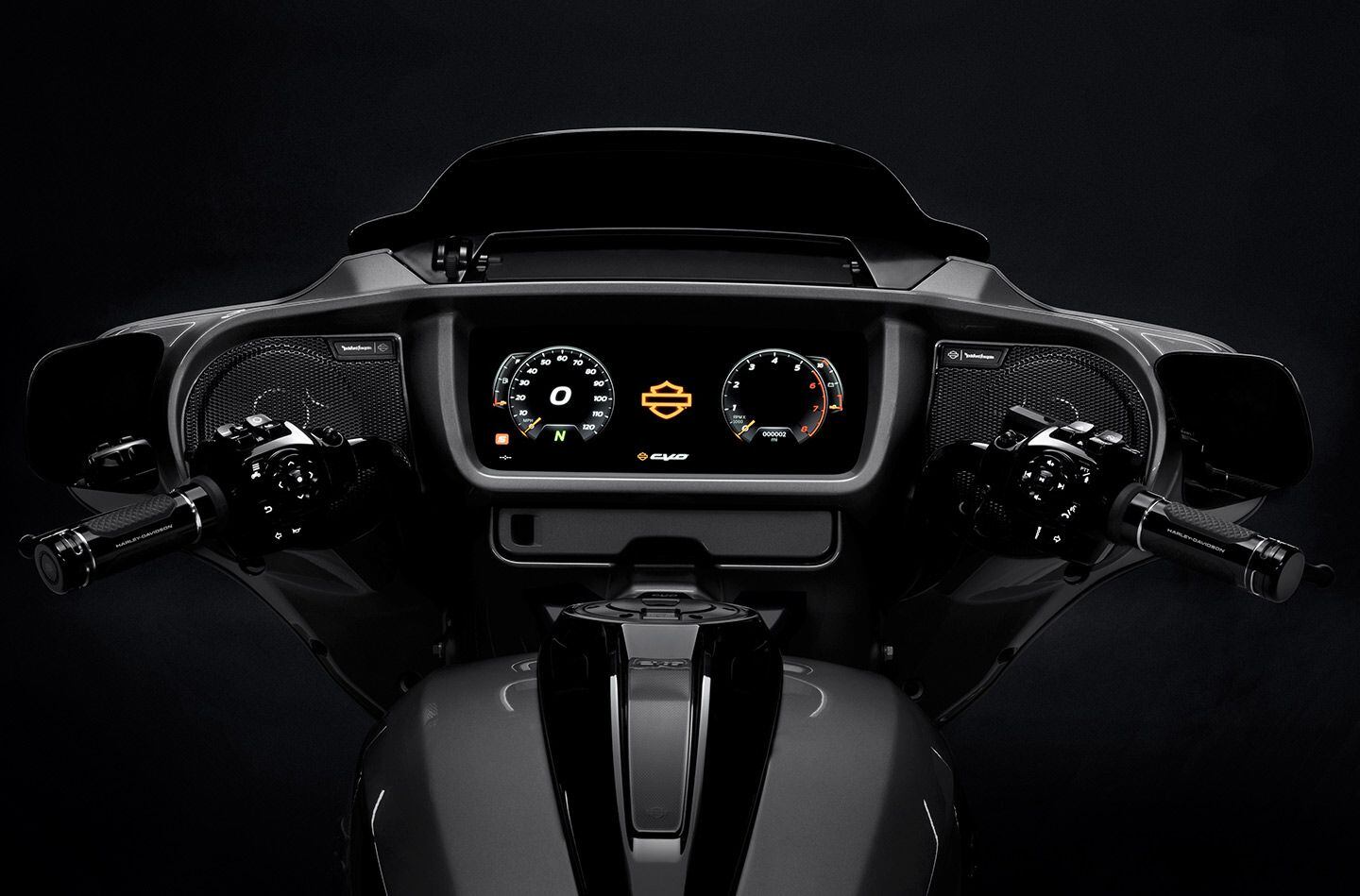
Say hello to a new 12.3-inch touchscreen on both CVOs, powered by the new Skyline OS. The four ride modes (a CVO first) can also be accessed from this screen. (Harley-Davidson/)
That new touchscreen is also the gateway to four new selectable ride modes, a first for the CVO Street Glide and CVO Road Glide models. Each mode (Rain, Road, Sport, and Custom) is configured to deliver a specific combination of power, engine-braking, Antilock Braking (C-ABS), and Traction Control (C-TCS) intervention.
In addition to the cornering ABS and cornering traction control systems, both of the new CVOs also include Cornering Electronically Linked Brakes (C-ELB), Cornering Drag Torque Slip Control (C-DTSC), Vehicle Hold Control (VHC), and Tire Pressure Monitoring (TPMS).
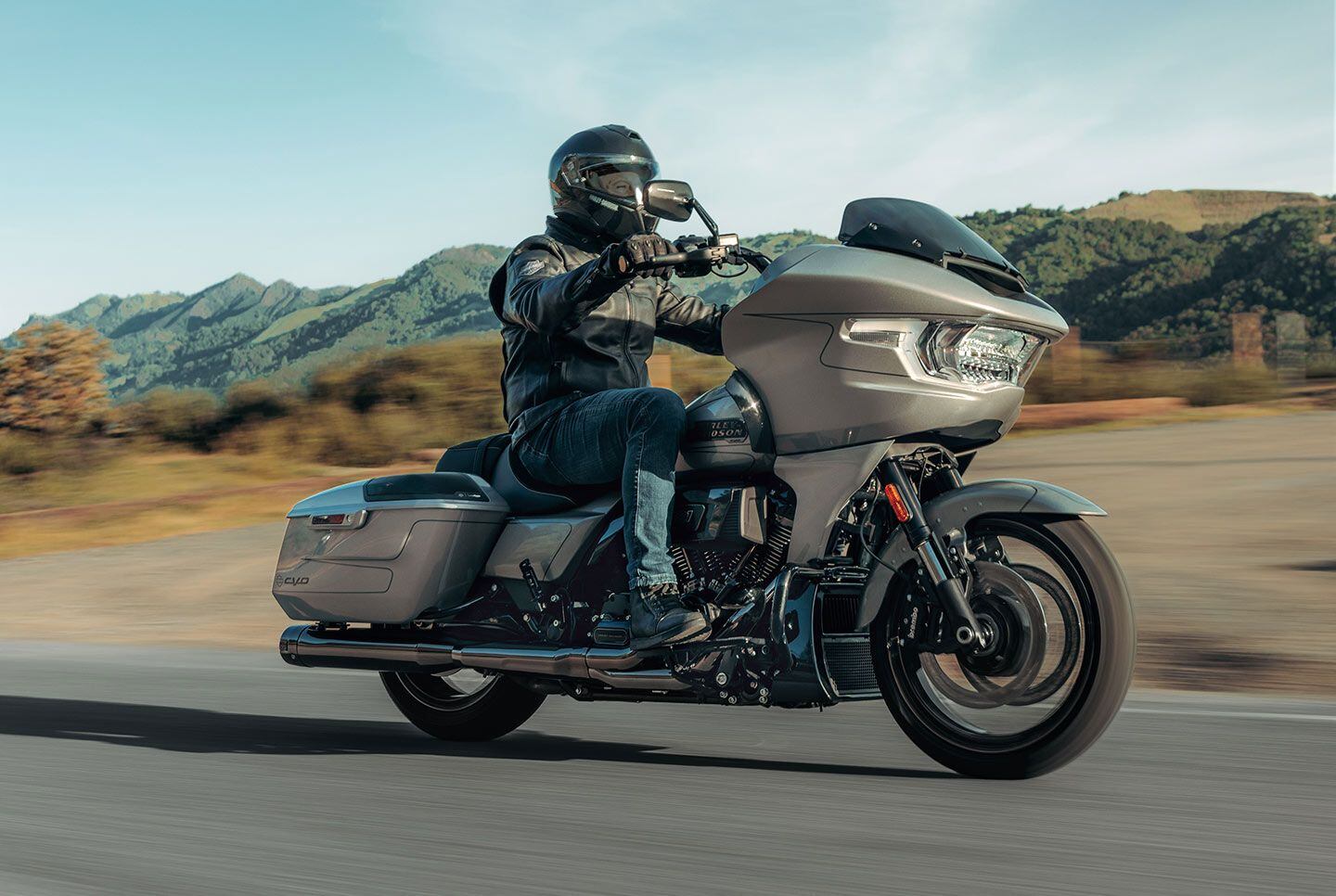
Classic sharknose fairing gets a bold new update on the 2023 CVO Road Glide, with a more aggressive snarl and new LED headlight arrangement with integrated turn signals. (Harley-Davidson/)
2023 CVO Road Glide
The 2023 CVO Road Glide model gets all of the same engine, suspension, lighting, and electronics improvements as the Street Glide, and many of the ergonomic ones to boot. Where things clearly diverge is in the visual arena and some styling differences and smaller details.
The classic Road Glide sharknose fairing, for example, gets an aggressive update with more angular shapes. You can see how the rear edge of the new fairing ties in with the fuel tank shape, and the lower part of the fairing to the front engine cylinder, while the pinstriping echoes some of the saddlebag design.
A single LED headlamp gets a wide, horizontal shape and gives the illusion of having twin elements, riffing on a key feature of previous Road Glides. The “W” shape of that forward lighting is a dead giveaway, though the amber turn signals are now integrated with the outer part of the main lighting, thus ditching the previous bullet turn signals.
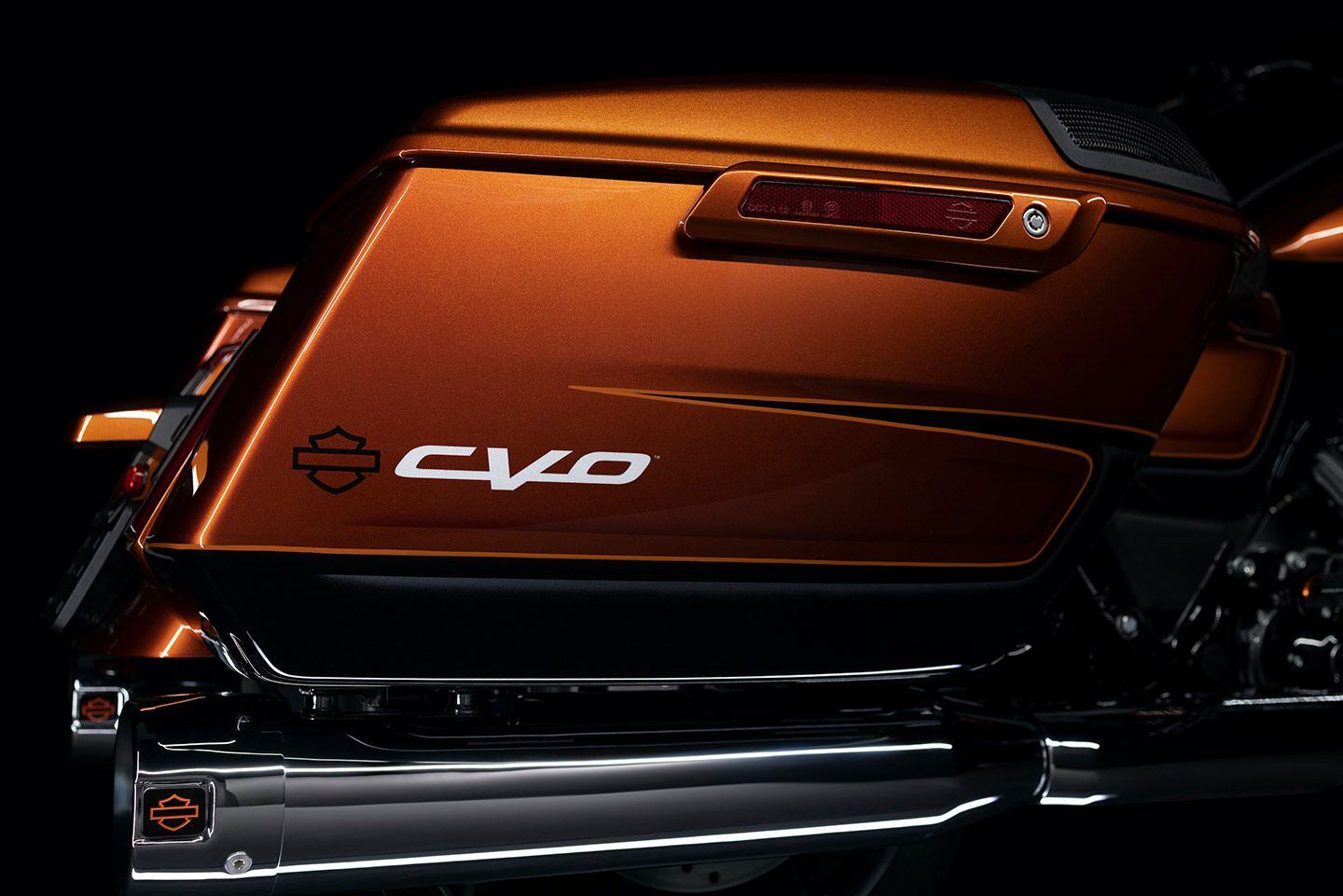
The new saddlebags appear more compact, but actually have slightly more volume for the Stage II 5 x 7-inch saddlebag speakers and cargo. (Harley-Davidson/)
The CVO Road Glide shares most of its other basic surface shapes with the CVO Street Glide too, though it gets new adjustable vanes at the rear edge of its fairing which H-D says can be used to adjust airflow air to the rider’s torso for desired comfort.
The CVO Road Glide handlebar has a wider, flatter bend than the previous shape, which puts the rider’s hands in a more natural position for long-haul riding and also enables 27 degrees of adjustability.
On both bikes, Harley says dry weight has been reduced quite a bit by using different materials and processes. Weight savings are 31 pounds for the CVO Street Glide and 35 pounds for the CVO Road Glide, compared to the older models they replace.
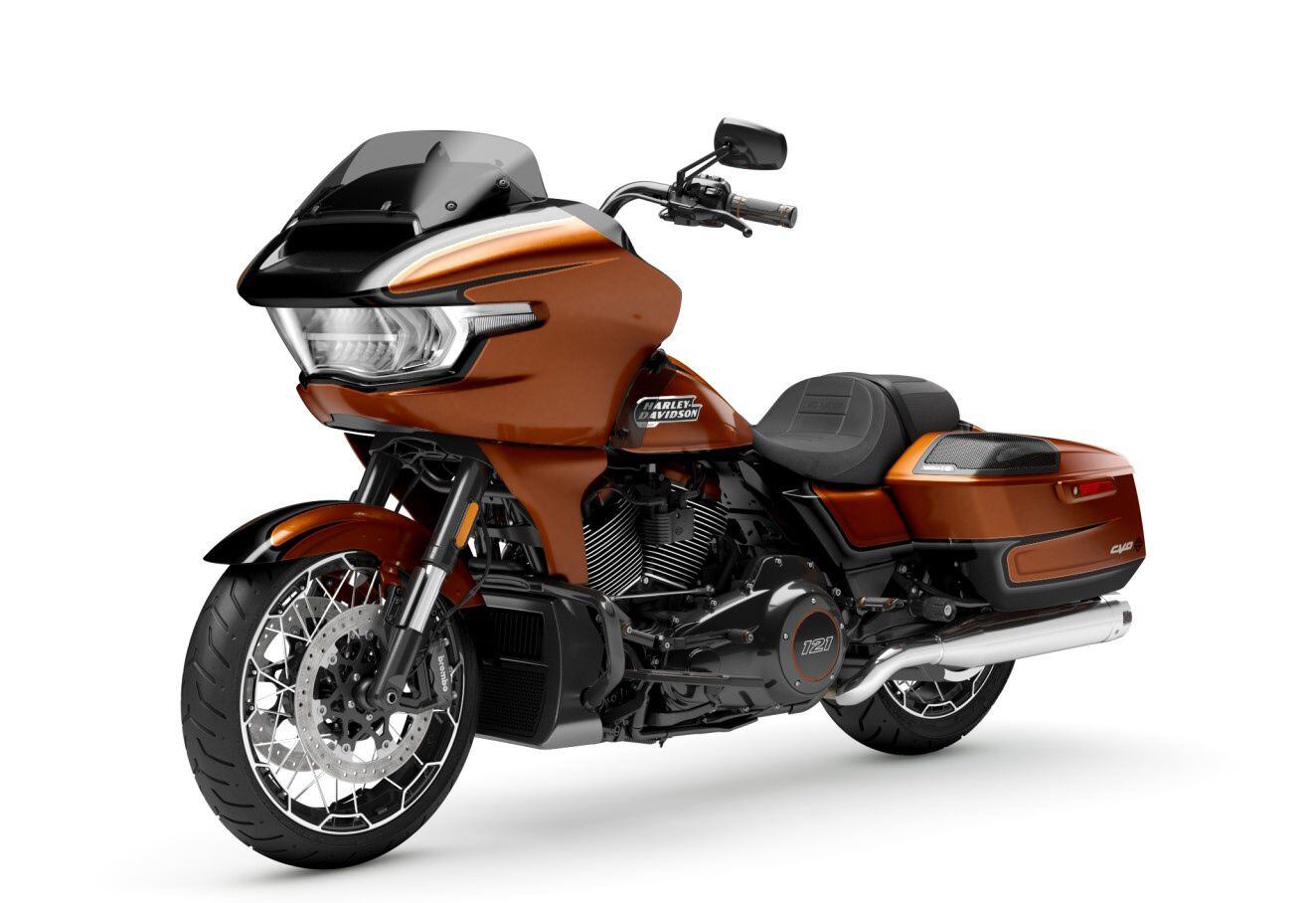
Like the CVO Street Glide, the CVO Road Glide will be offered in two options. This here is the higher-priced Whiskey Neat/Raven Metallic color. (Harley-Davidson/)
“With the all-new CVO Street Glide and CVO Road Glide models, our mission is to advance every aspect of the Grand American Touring motorcycling experience,” said Jochen Zeitz, chairman, president, and CEO of Harley-Davidson. “These models set a new standard for Harley-Davidson performance, technology, and style, accelerating the evolution of the world’s most desirable motorcycle brand.”
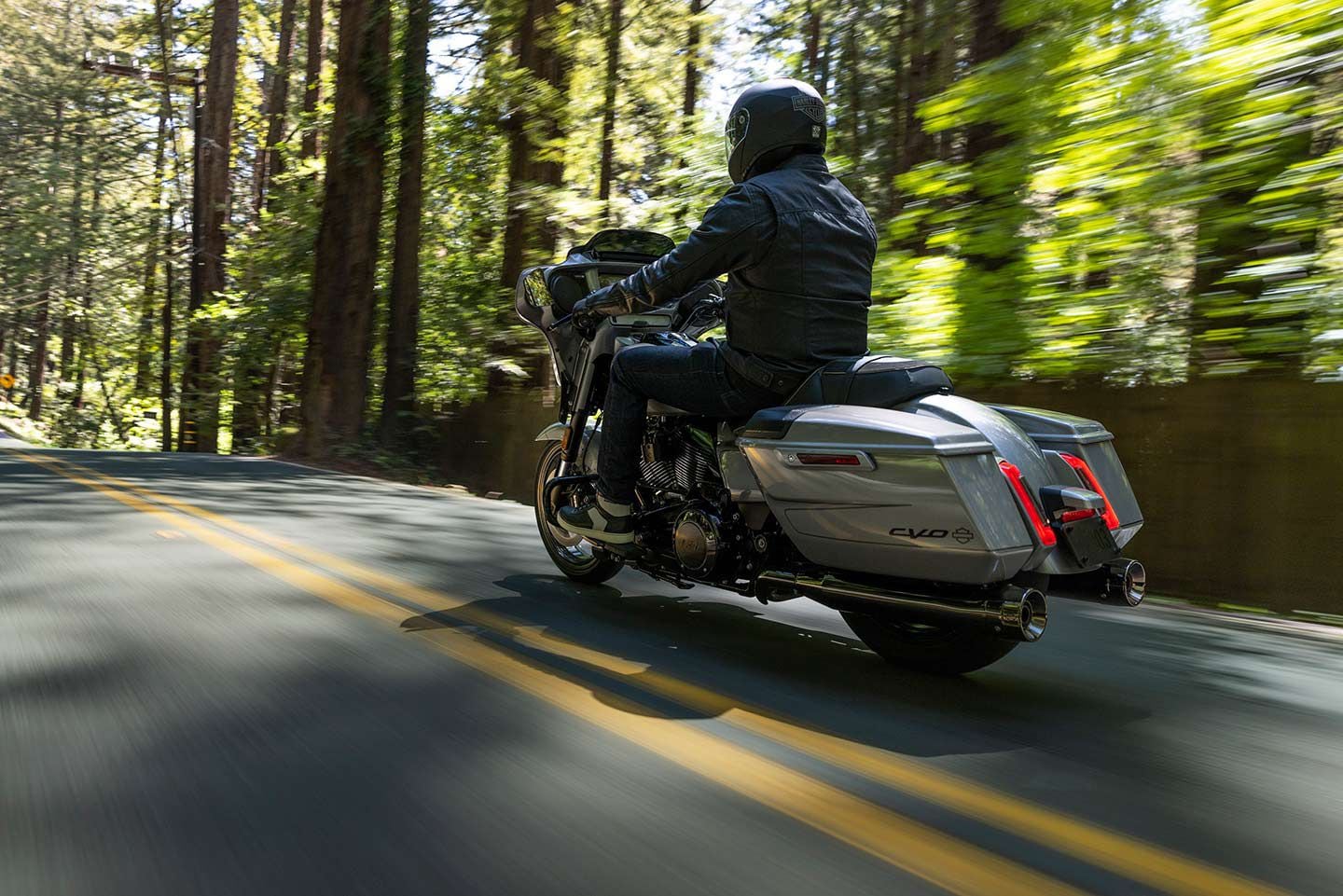
The new 2023 CVO Street Glide from the rear. Base MSRP is $42,999. (Harley-Davidson/)
The new CVO Street Glide and CVO Road Glide models will be offered with two paint/finish choices. The standard Dark Platinum with Bright Smoked Satin pinstriping and color-matched inner fairing is set against a black powertrain and air cleaner with chrome accented engine inserts. Lower rocker boxes, pushrod tubes, and exhaust are also finished in Scorched Chrome; Adversary Collection accessories are finished in black powdercoat with machined highlights.
The next option triggers an additional charge, though H-D does not give that cost. The Whiskey Neat/Raven Metallic two-tone color is hand-applied and gets a color-matched inner fairing. The powertrain and air cleaner are black with orange accents on the engine inserts, while lower rocker boxes and pushrod tube collars are painted Whiskey Neat. Pushrod tubes and exhaust are chrome. Adversary Collection accessories feature a black and orange double anodized finish.
The CVO Street Glide and CVO Road Glide models are set to reach Harley dealers globally in mid-July, with a base MSRP of $42,999. Both will make their US debut in Milwaukee during the Harley-Davidson Homecoming Festival, July 13–16, 2023, and will be available for demo rides at the H-D Pilgrim Road Powertrain Operations facility.
2023 Harley-Davidson CVO Street Glide/CVO Road Glide Specs
| MSRP: | $42,999 (base) |
|---|---|
| Engine: | 1,977cc, liquid-cooled, 45-degree V-twin; 4 valves/cyl. |
| Bore x Stroke: | 103.5 x 117.5mm |
| Compression Ratio: | 11.4:1 |
| Transmission/Final Drive: | 6-speed/belt |
| Fuel Delivery: | Electronic Sequential Port Fuel Injection |
| Claimed horsepower: | 115 hp (86kW) @ 4,500 rpm |
| Claimed torque: | 139 lb.-ft. (189 Nm) @ 3,000 rpm |
| Clutch: | Wet, multiplate slipper/assist |
| Frame: | Steel tube w/ two-piece backbone and bolt-on rear subframe |
| Front Suspension: | 47mm inverted Showa fork; 4.6 in. travel |
| Rear Suspension: | Dual emulsion shocks, spring preload, rebound damping adjustable, 3.0 in. travel |
| Front Brake: | 4-piston radial-mount calipers, floating 320mm discs w/ ABS |
| Rear Brake: | 2-piston caliper, 300mm disc w/ ABS |
| Wheels, Front/Rear: | Cast laced; 19 x 3.5 in. / 18 x 5 in. |
| Tires, Front/Rear: | Dunlop H-D Series bias blackwall; 130/60B-19 / 180/55B-18 |
| Rake/Trail: | 26.0°/6.7 in. |
| Wheelbase: | 64.0 in. |
| Ground Clearance: | 5.5 in. / 5.7 in. |
| Seat Height: | 28.0 in. / 28.1 in. |
| Fuel Capacity: | 6.0 gal. |
| Claimed Wet Weight: | 838 lb. / 862 lb |
| Contact: | harley-davidson.com |
A shortened rear fender is a key feature of a bobber motorcycle, but it’s all about a stripped-down style—even for those that are factory-produced. (Harley-Davidson/)
In the prewar period, the “bob-job” evolved as a performance motorcycle. Stripped of everything but the essentials, it was a frame, engine, tank, controls, and rudimentary lighting. That’s it. Fast-forward decades, and the current bobber craze still honors the early renegade bikes’ bobbed or shortened rear fenders. Think of a bobcat compared to a house cat: feral, wily, unpredictable, dangerous—and little to no tail!
As happens with everything good created by beatniks, hipsters, surfers, fabricators, and other social nonconformists, the motorcycle industry eventually noticed bobbers. And predictably, factory-produced bobbers are the result. Thoroughly sanitized, and DOT and EPA compliant, they nevertheless retain the spirit of the stripped-down originals. Here are some top models for 2023.
Harley-Davidson Fat Bob 114
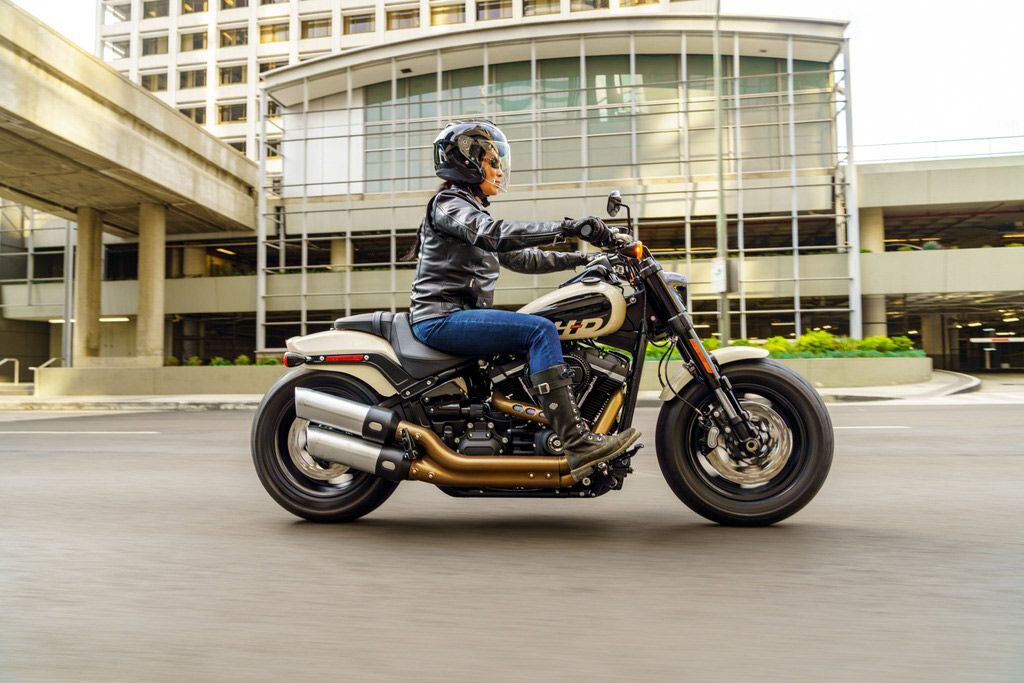
Harley-Davidson Fat Bob 114 (Harley-Davidson/)
It would be hard to find a factory bobber with more brutish swagger than the 2023 Harley-Davidson Fat Bob 114, priced at $18,899. The black-out finishes on the Milwaukee-Eight 114ci engine, laser-etched wheels, frame, and suspension, plus burly 16-inch tires, abbreviated lighting, and naturally, a bobbed rear fender all contribute to a muscular, mass-centralized look.
The Fat Bob is bristling with trick bits. Count among them a 43mm inverted cartridge fork with triple-rate springs that provide a smooth ride over modest road irregularities, along with stability when encountering bigger hits; in back, the hidden coilover monoshock features a toolless hydraulic preload mechanism for quick changes on the road. Triple disc brakes with drilled rotors and four-piston front, two-piston rear calipers get the stopping done in a hurry—especially with the big footprint provided by the Dunlop Harley-Davidson Series tires.
Related: 2023 Harley-Davidson 120th Anniversary Models
Indian Chief Bobber Dark Horse
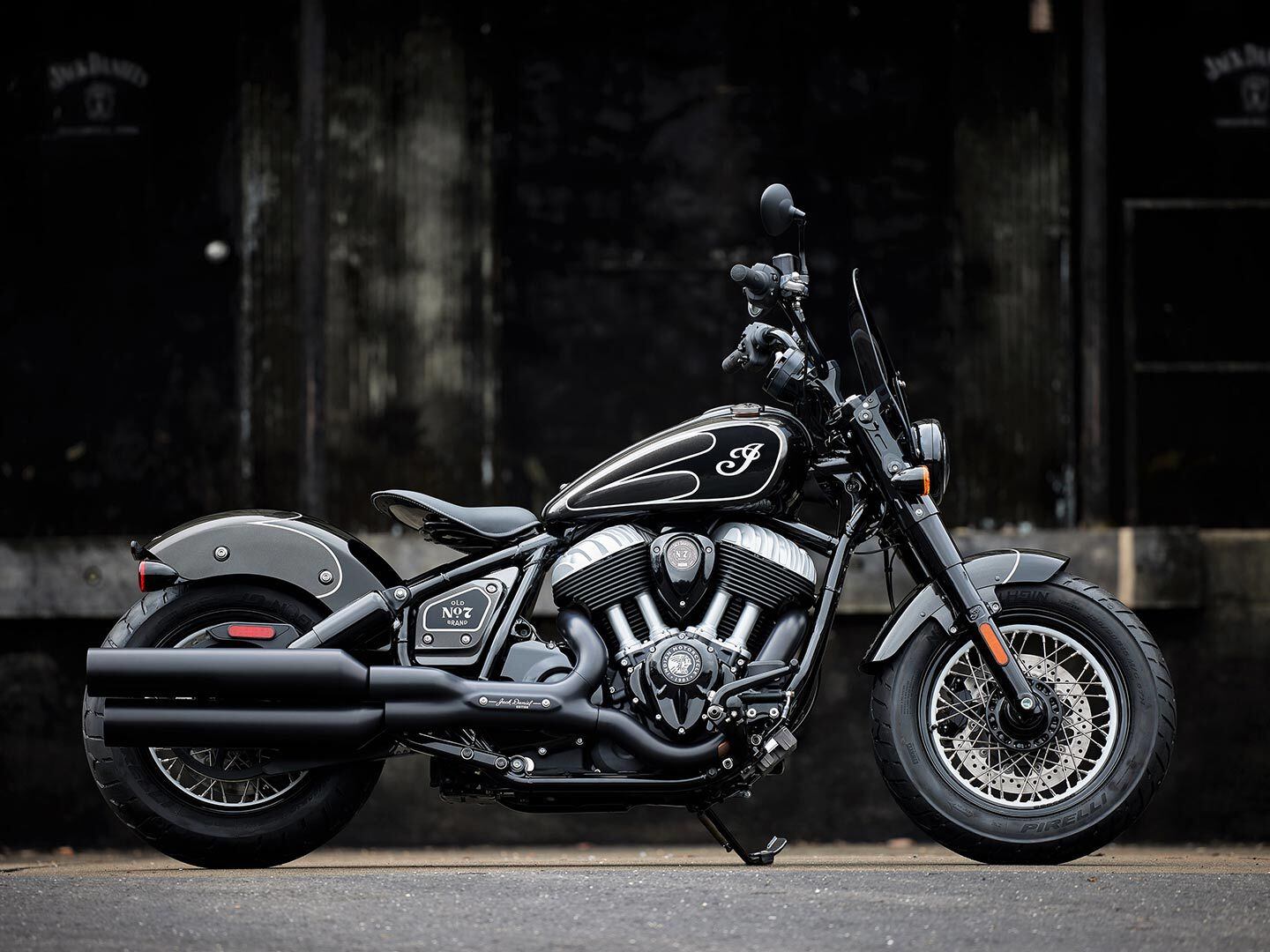
2023 Jack Daniels Indian Chief Bobber Dark Horse is a limited-edition model of the Chief Bobber Dark Horse. (Indian Motorcycle/)
When the model name includes “Bobber,” you can be pretty sure what you’re getting. Priced at $19,499, the Indian Chief Bobber Dark Horse visually delivers the bobber essentials, including a bobtail rear fender, a solo saddle, and bucketloads of attitude. And insofar as finishes go, it seems black is the new chrome. Excepting a few plated and polished components, literally all the running gear on the Dark Horse is black.
And you thought touchscreens are only for Teslas? Not true! This ubiquitous tech has made the leap to hyperspace in the bobber segment. The Indian’s 4-inch touchscreen lets you receive calls, get turn-by-turn navigation commands (including traffic and weather alerts), and access music from Bluetooth devices. Back in a more familiar world for gearheads, an air-cooled Thunderstroke 116 V-twin kicks out bodacious power, with peak torque arriving at just 2,900 rpm. Compact 16-inch wheels wrapped in Pirelli Night Dragon tires help keep the seat height to a friendly 26 inches.
Related: 2023 Jack Daniels Indian Chief Bobber Dark Horse First Look
Triumph Bonneville Bobber
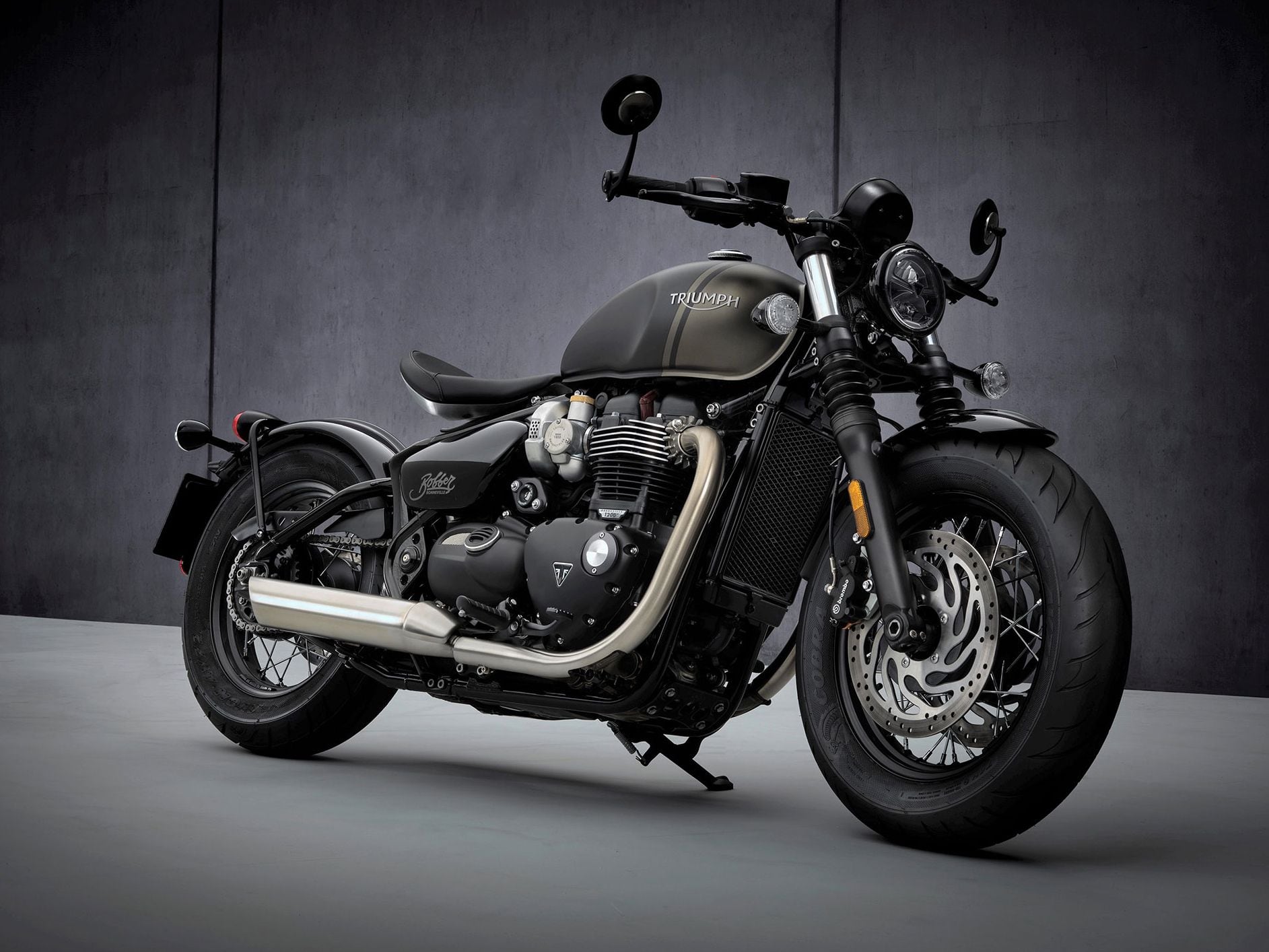
2023 Triumph Bonneville Bobber (Triumph Motorcycles/)
Let’s face it—the bobber phenomenon certainly emerged in prewar America, but it could have viable roots in prewar England too. Because what could be more natural for budding London Rockers in that period than to strip down their bikes for speed and style? One look at Triumph’s 2023 Bonneville Bobber and you’ll understand how that might work today. Finished in Jet Black, the Bonnie Bobber is direct, frank, and in your face. It’s also priced at an agreeable $13,795, ready to ride. (Add $800 for a Chrome Edition with a fair bit more bling.)
The 1,200cc Bonneville engine is a sweetheart—it makes a great baritone sound, develops useful torque over a broad, natural rev range, has a wonderful vibration signature, and offers, per Triumph specs, an impressive 10,000-mile service interval. Despite its solo seat and rigid-look rear suspension, the Bonneville Bobber is quite rider-centric and adaptable, thanks to an adjustable seat, adjustable traction control, dual riding modes (choose either Road and Rain), and electronic cruise control. And while the Bonneville Bobber already looks custom, Triumph takes the concept further with a reported 75 accessories designed for the model.
Triumph Rocket 3 R Chrome Edition
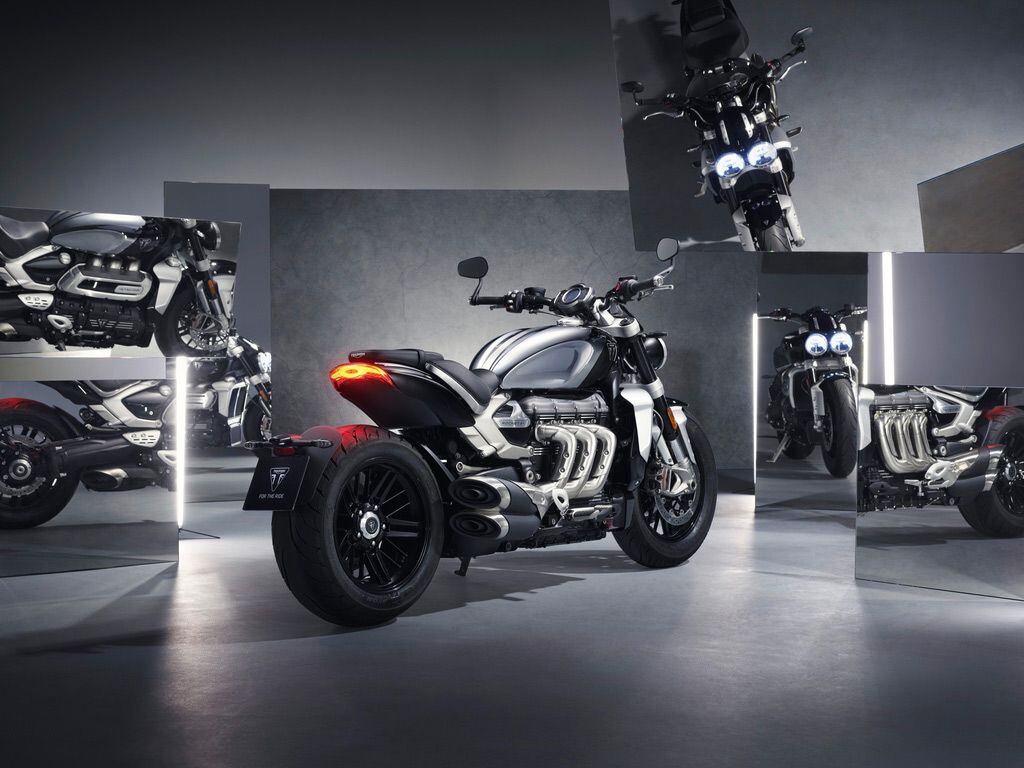
2023 Triumph Rocket 3 R Chrome Edition (Triumph Motorcycles/)
If builders of the first bobbers could see the 2023 Triumph Rocket 3 R Chrome Edition, they probably would not believe it. The centerpiece of the Rocket 3 is a completely over-the-top 2.5-liter three-cylinder liquid-cooled engine mounted longitudinally in the frame. On the right are three exhaust pipes the size of a dragster’s zoomie headers, and on the left are triple intake stacks. They aren’t just for show. The Rocket 3 R Chrome Edition mill develops a claimed 165 hp and a staggering 163 lb.-ft. of torque, and powers through a six-speed gearbox and shaft drive to the massive 240/50R-16 rear tire. Basically, the Rocket 3 “out motorcycles” all other motorcycles—and so does its $24,795 MSRP!
With its crisp, modern styling and audacious engineering, clearly the Triumph Rocket 3 R Chrome Edition—incidentally a one-year only offering—qualifies as a power cruiser par excellence. However, in this case, thanks to its pugnacious, sawed-off rear end, we’ll give it honorary status as a bobber. For a bike with the maximum possible engine, its minimalism is impressive. And so are the dual LED headlights, TFT instruments, configurable ride modes, cornering ABS, and traction control.
Harley-Davidson Street Bob 114
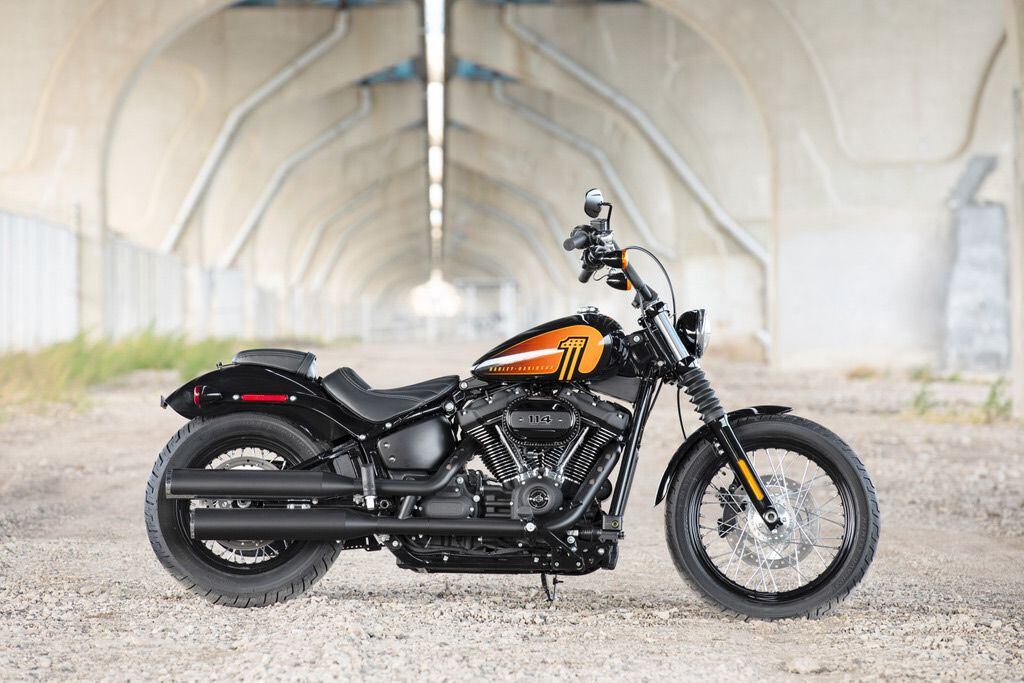
Harley-Davidson Street Bob 114 (Harley-Davidson/)
Another 2023 factory bobber alternative from Harley-Davidson is the Street Bob 114, priced at $16,599—a bargain $2,300 under the Fat Bob 114 shown above. For the money, it nicely features the big 114ci (1,868cc) Milwaukee-Eight engine, replete with electronic fuel injection and framed by Harley’s famous offset shotgun exhausts. Peak torque comes at just 3,000 rpm, making the Street Bob 114 an effortless ride.
Rather than the Fat Bob’s forward foot controls, the Street Bob 114 has mid-mount controls for a more traditional riding position. Likewise, the seat is substantially lower at just 25.8 inches off the deck, making this one welcoming for newer or smaller riders. As well, thanks to its more traditional 19-inch front, 16-inch rear wheels and single front disc brake, the Street Bob 114 embodies the traditional Harley cruiser look more than does the rakish Fat Bob. But don’t worry—the Street Bob 114 offers a choice of Vivid Black and various color options ($525 extra), as well as optional ABS and myriad factory-designed accessories.
]]>The 2024 Honda Shadow Phantom hits the V-twin cruiser market with refreshed looks, an updated rear brake, and a new ABS version. (Honda/)
American Honda’s rolling out 2024 new motorcycle models. This time it’s the 2024 Honda Shadow Phantom. From fender to fender, this beginner-friendly Japanese cruiser features a number of styling updates to help it stand out on the boulevard.
Related: 2024 Honda Grom First Look Preview
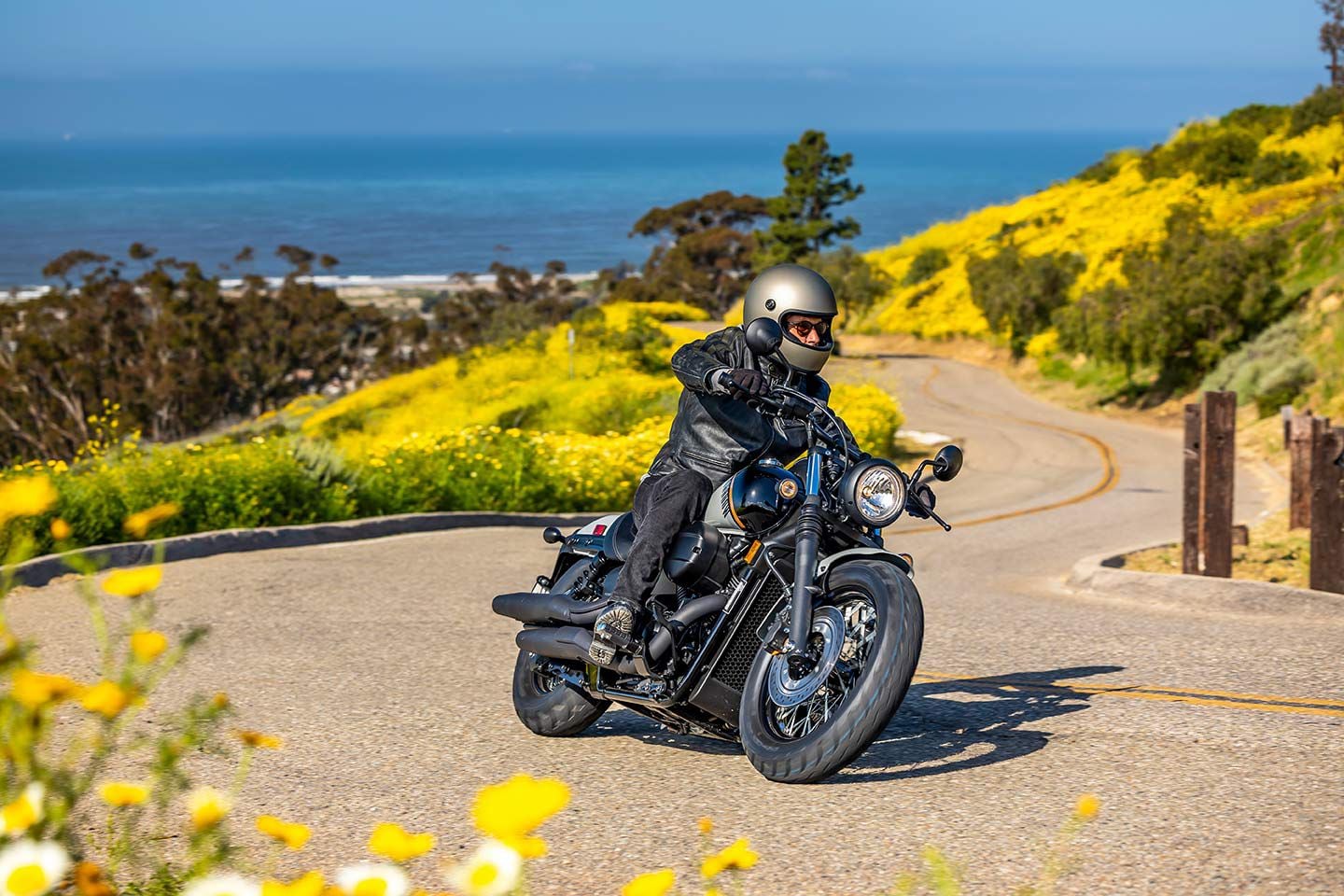
Dealers will have Honda’s updated bobber, the Shadow Phantom, in stock June 2023. (Honda/)
Both front and rear fenders have been reshaped for a more “minimalist” bobber look. Up front, the single round headlight is surrounded by a revised headlight cover. Honda has also upgraded both front and rear turn signals to LEDs.
Related: 2023 Honda Fury First Look Preview
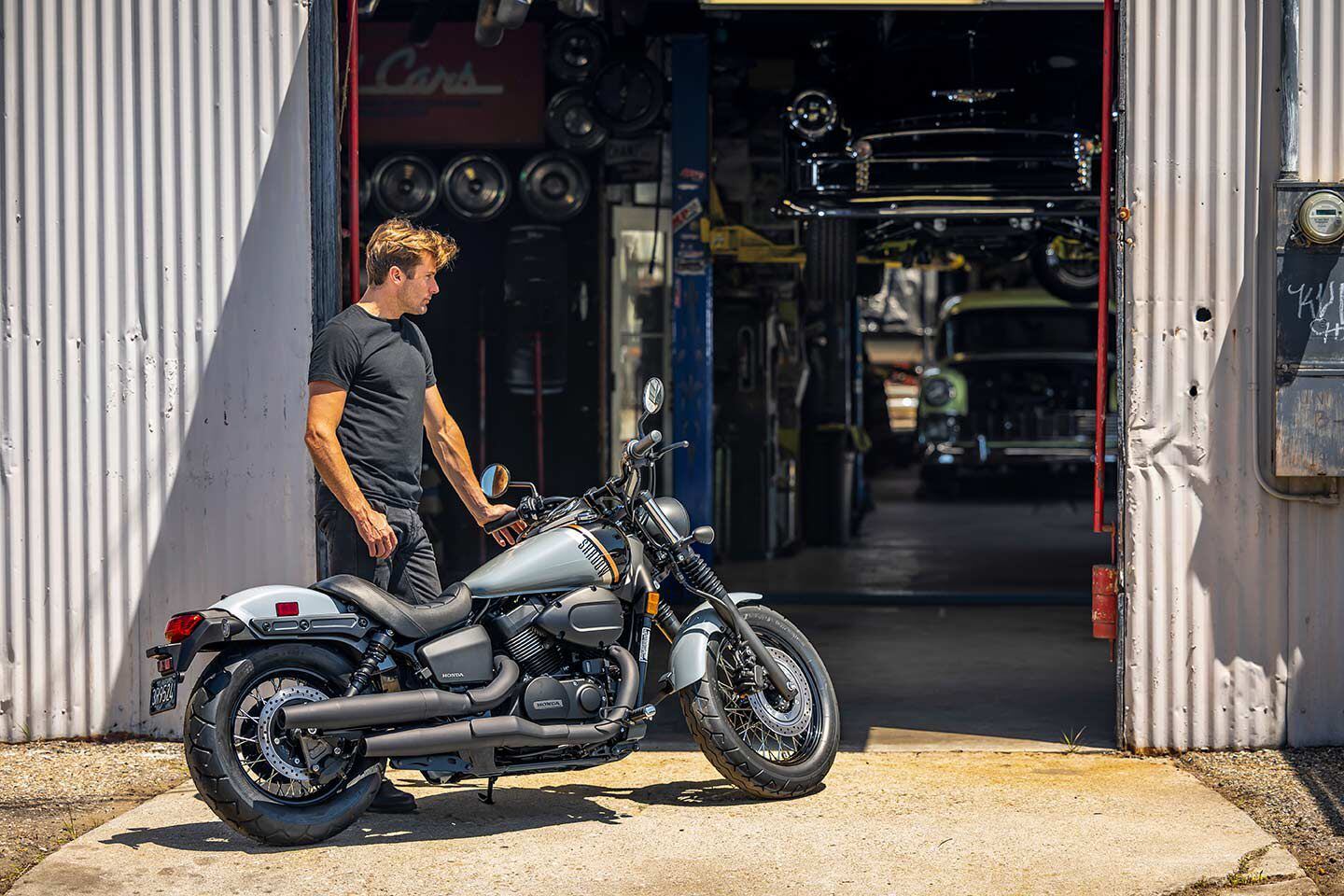
The two-tone tank gives the Shadow Phantom a custom look. (Honda/)
The 41mm telescopic fork previously featured all-black fork tubes and covers, and now the front suspension is dressed up with fork gaiters and matte-finished shrouds.
Then there’s a new handlebar and clamps. These are said to enhance style and comfort, and from the looks of it, it appears the handlebar is slightly less swept-back than the previous model.
Atop the two-tone 3.9-gallon fuel tank is an updated display.
Related: 2023 Honda Rebel 500 First Look Preview
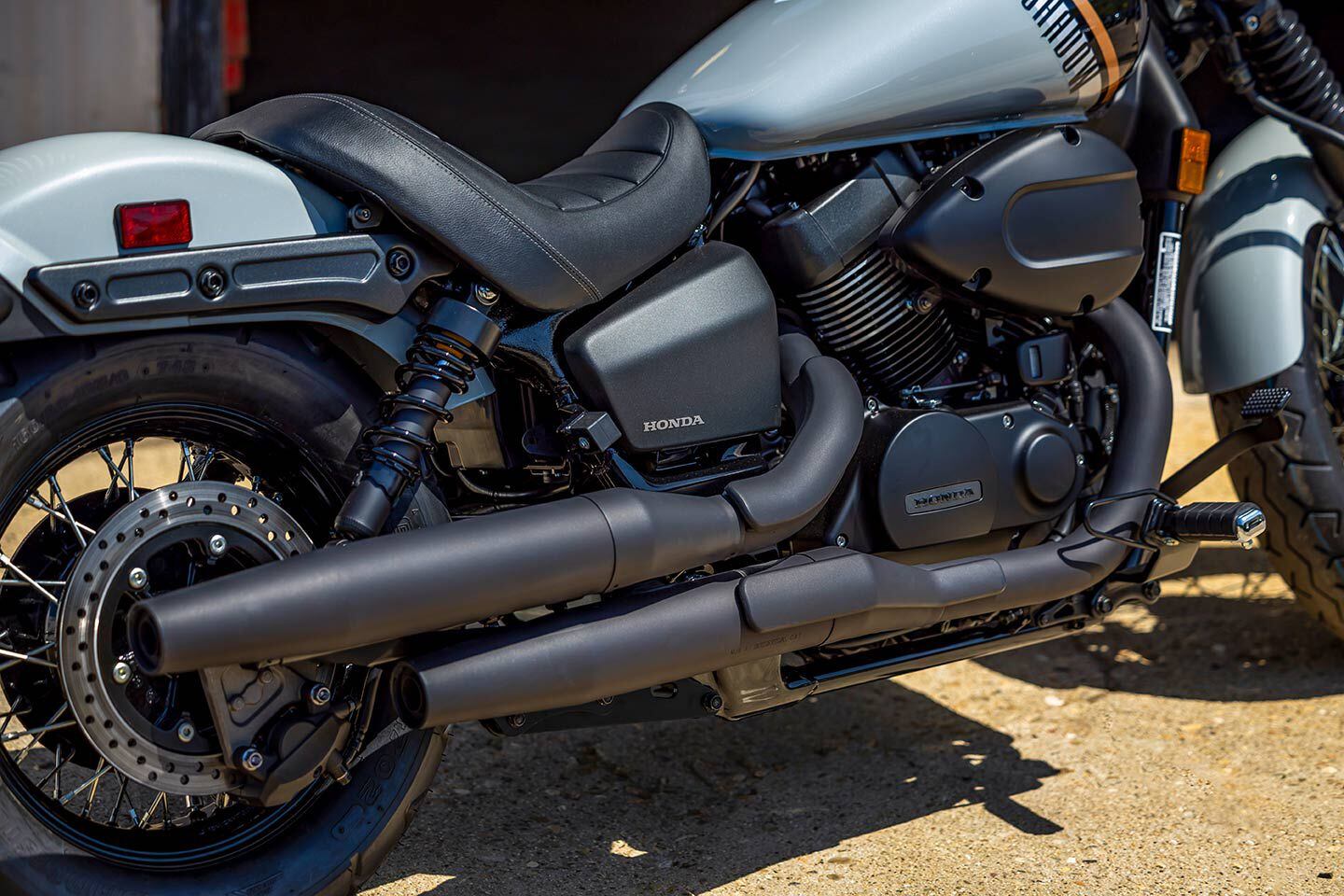
The Honda Shadow Phantom is blacked out from the cylinder head covers to the exhausts. (Honda/)
The fuel-injected 745cc liquid-cooled engine features machine-cut fins, giving a little more depth and contrast to the blacked-out V-twin. The air cleaner cover is also reshaped.
Related: Harley-Davidson Softail Breakout First Look Preview
Riders who plan on going solo won’t have any qualms with this next update. Honda has swapped out the long one-piece seat for a new single seat and got rid of the passenger pegs. A new passenger seat and pegs are now available as accessories for those who plan on traveling two-up.
Related: Is Honda’s 2021 Rebel 1100 DCT Cruiser a Modern Sportster?
Related: 2021 Honda Rebel 1100 MC Commute Review
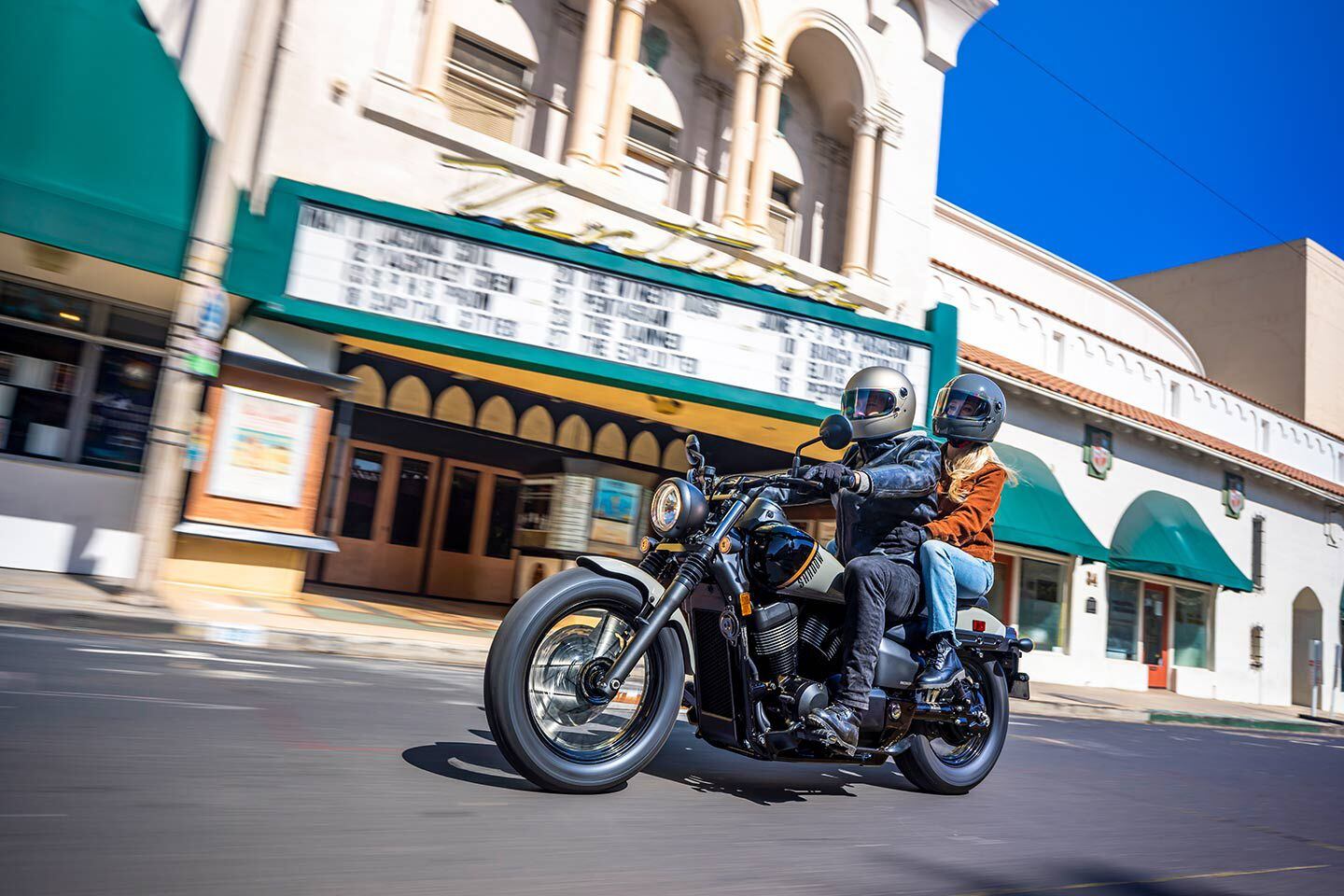
It takes two to two-up. A passenger seat and footpegs are available from Honda for those who want to bring a significant other or friend along for a ride on the new Shadow Phantom. (Honda/)
Another significant update is the introduction of an ABS-equipped Phantom for 2024. Both the ABS and non-ABS versions receive a new 276mm single rear disc brake. Previous Phantoms were equipped with a 180mm rear drum.
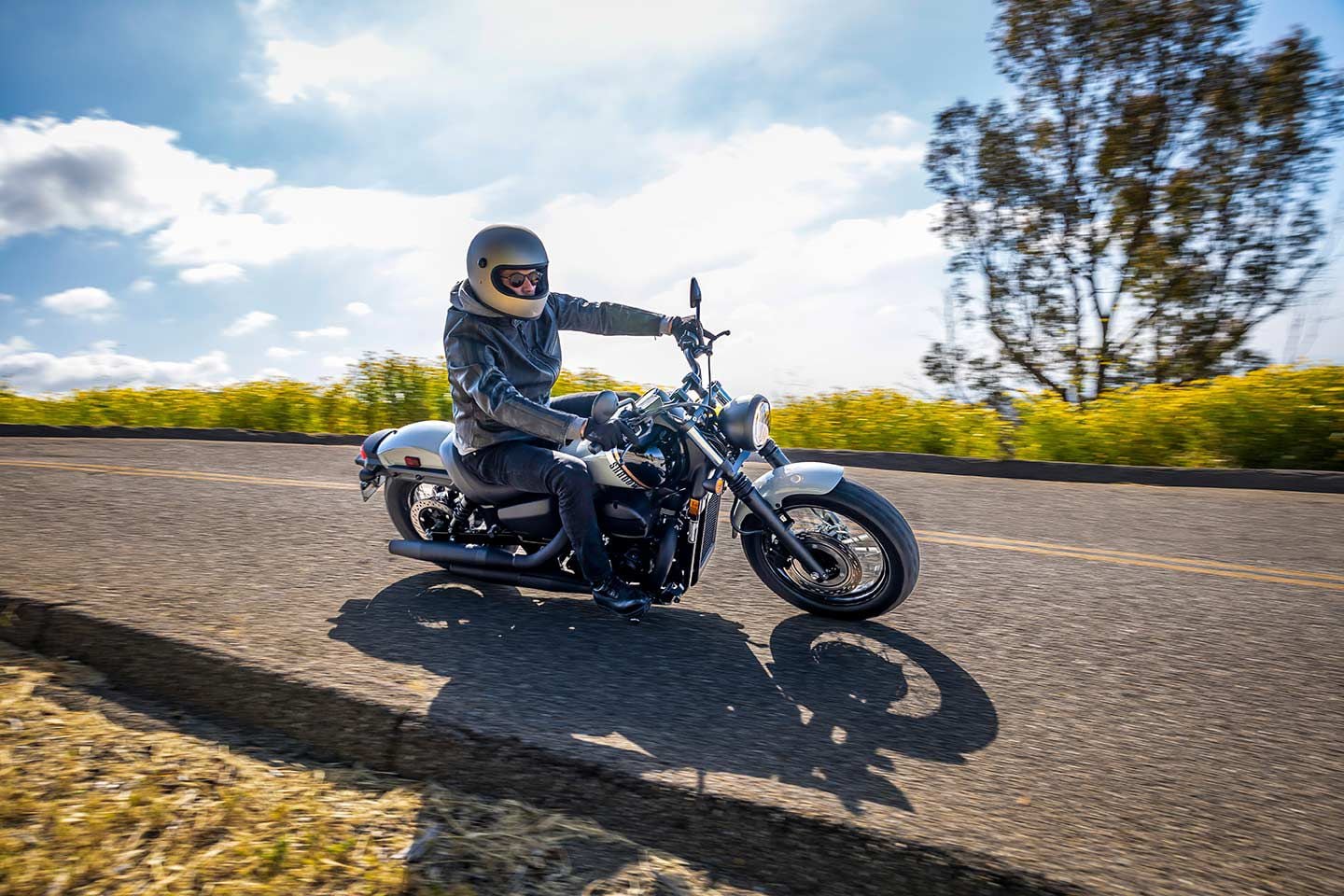
Honda pairs the 296mm front disc with a 276mm rear disc, which replaces the 180mm rear drum of last year’s Shadow Phantom. (Honda/)
The non-ABS model rings in at $8,399, add $300 for the ABS version. Only the ABS-equipped model will be available in California.
Related: Best Cruiser Motorcycles for Women 2023
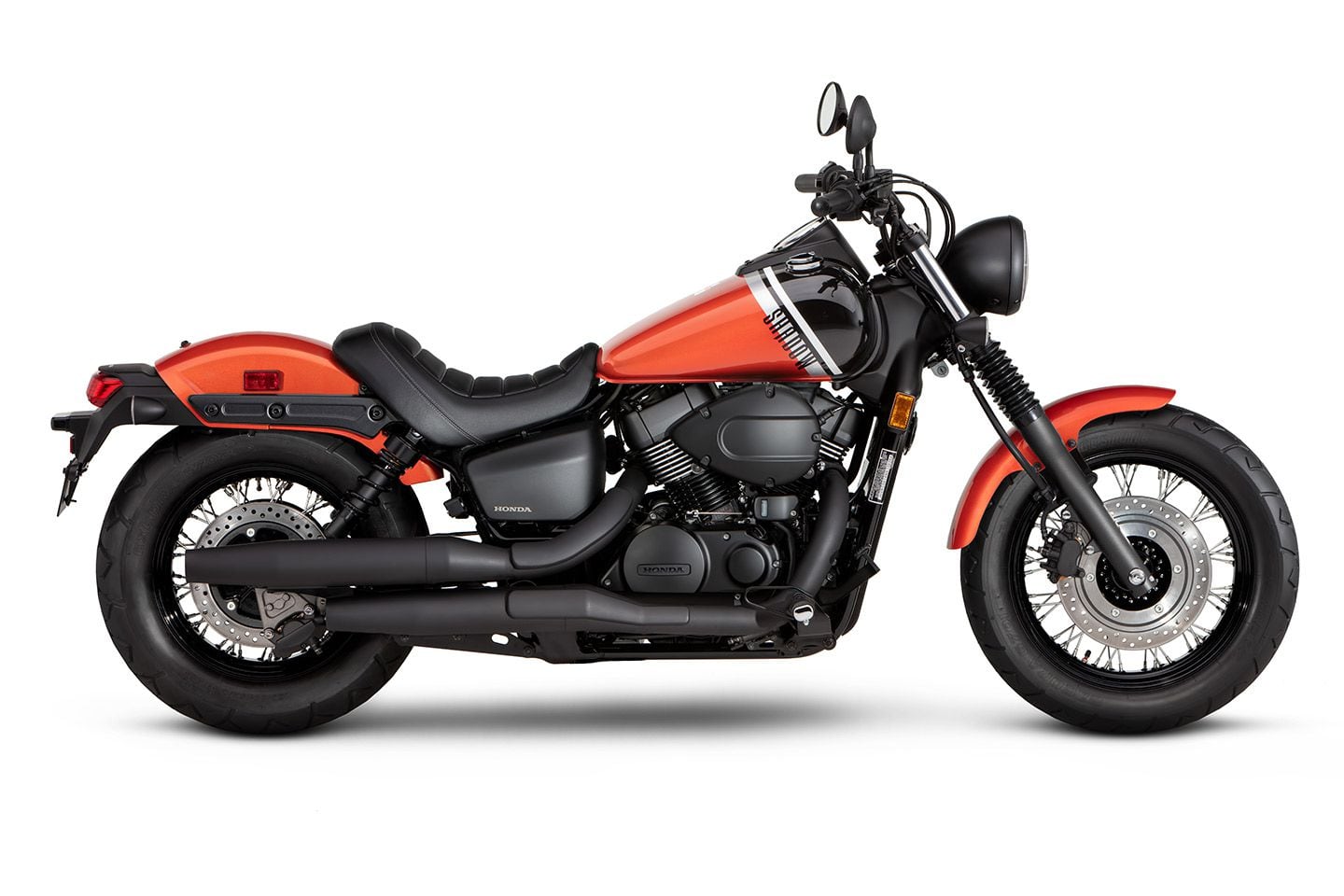
The 2024 Honda Shadow Phantom has two two-tone color options available: Deep Pearl Gray Metallic and Orange Metallic. (Honda/)
2024 Honda Shadow Phantom Technical Specifications and Price
| PRICE: | $8,399 (base) / $8,699 (ABS) |
|---|---|
| ENGINE: | 745cc, SOHC, liquid-cooled V-twin; 3 valves/cyl. |
| BORE x STROKE: | 79.0 x 76.0mm |
| COMPRESSION RATIO: | 9.6:1 |
| FUEL DELIVERY: | Fuel injection w/ 34mm throttle bodies |
| CLUTCH: | Wet, multiplate |
| TRANSMISSION/FINAL DRIVE: | 5-speed/shaft |
| FRAME: | N/A |
| FRONT SUSPENSION: | 41mm telescopic fork; 5.5 in. travel |
| REAR SUSPENSION: | Dual shocks, spring preload adjustable; 3.6 in. travel |
| FRONT BRAKE: | 2-piston caliper, 296mm hydraulic disc (base) / 2-piston caliper, 296mm hydraulic disc w/ ABS (ABS) |
| REAR BRAKE: | 2-piston caliper, 276mm hydraulic disc (base) / 2-piston caliper, 276mm hydraulic disc w/ ABS (ABS) |
| WHEELS, FRONT/REAR: | Spoked; 17 in./15 in. |
| TIRES, FRONT/REAR: | 120/90-17 / 160/80-15 |
| RAKE/TRAIL: | 34.0°/6.3 in. |
| WHEELBASE: | 64.5 in. |
| SEAT HEIGHT: | 25.6 in. |
| FUEL CAPACITY: | 3.9 gal. |
| CLAIMED WET WEIGHT: | 543 lb. (base) / 553 lb. (ABS) |
| WARRANTY: | 1 year |
| AVAILABLE: | June |
| CONTACT: | powersports.honda.com |
Carey Hart’s custom Sport Chief build for Twitch Stenberg looks great but is also constructed to stand up to some serious abuse. (Jeff Allen/)
“Take it easy, it’s got 40 miles on it,” says freestyle motocross legend Carey Hart to friend and fellow FMXer “Twitch” Jeremy Stenberg as they head out for a first ride. Hart built Stenberg a custom 2023 Indian Motorcycle Sport Chief as part of Indian’s Forged video series—and it’s a beaut. A full frame-up build, Hart has put 400 hours into the bike, building a machine that can stand up to Twitch’s abuse. But still, it’s brand-new and the unveiling of this custom Sport Chief was just minutes ago for the cameras shooting the finale of the Forged series.
Twitch just laughs, “Uh huh, sure buddy.”
Twenty minutes later, Hart’s best friend and rapper Big B gets a video text of circle burnouts and a pegged rev limiter. “So much for taking it easy,” he says showing me the video.
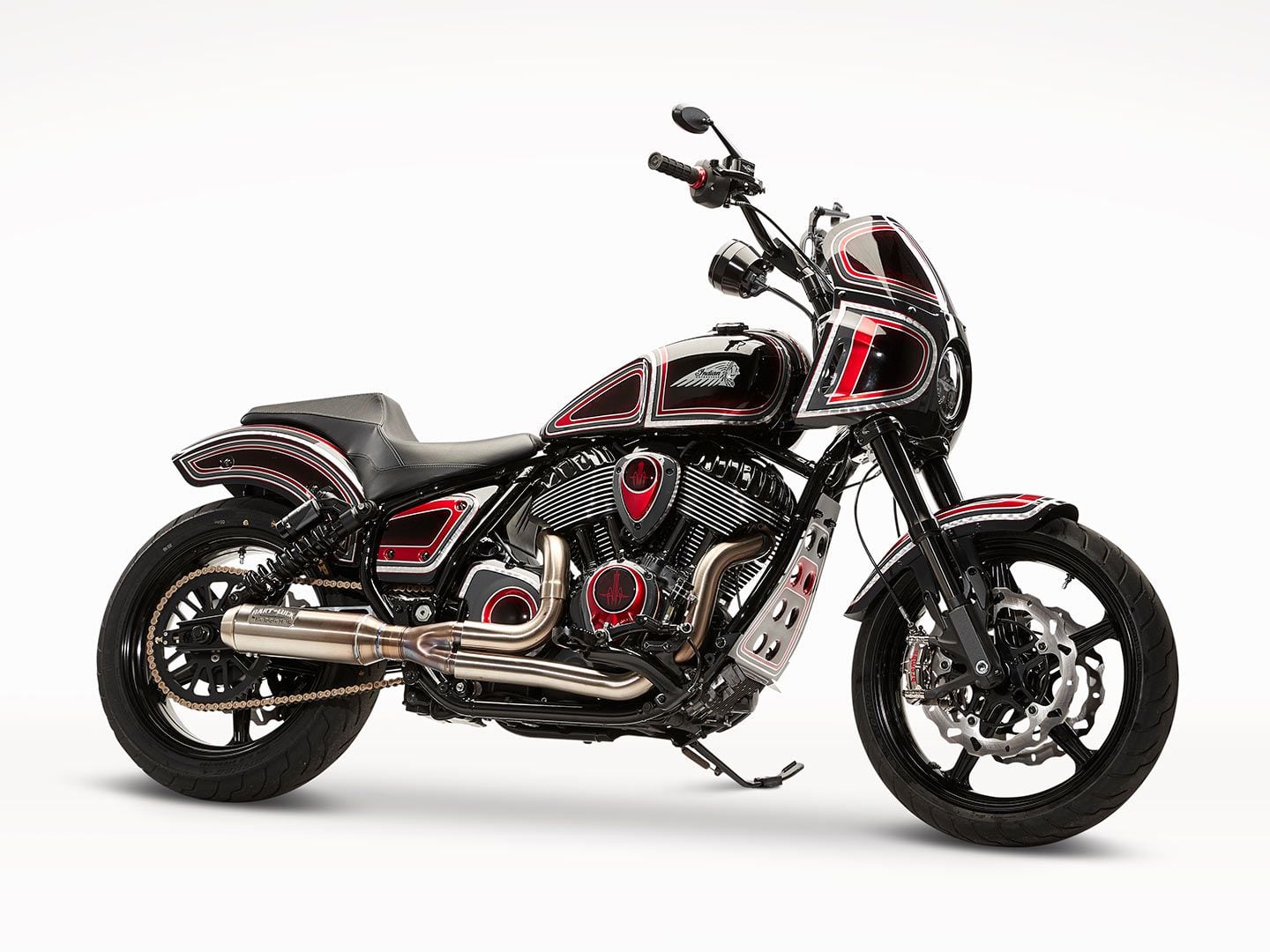
Hart has 400 hours of work in Twitch’s custom Sport Chief. (Drew Ruiz/)
At least I won’t have to worry too much about my ride on the one-off Sport Chief later in the day. Pre-abused is how I prefer to roll on a motorcycle that Indian’s PR company was very worried about me riding. We even had to show proof of insurance that would cover the cost of replacement.
And the worries are well founded. Hart took the Sport Chief down to the frame before building a club-style custom that enhances the performance of Indian’s latest Chief model. The list of parts and mods is extensive including a machined billet-aluminum Trac Dynamics swingarm, Fox rear shocks, Brembo Monoblock calipers, Beringer controls, knee cutouts on the fuel tanks, and paint by Schultz Designz.
Related: 2023 Indian Sport Chief First Look
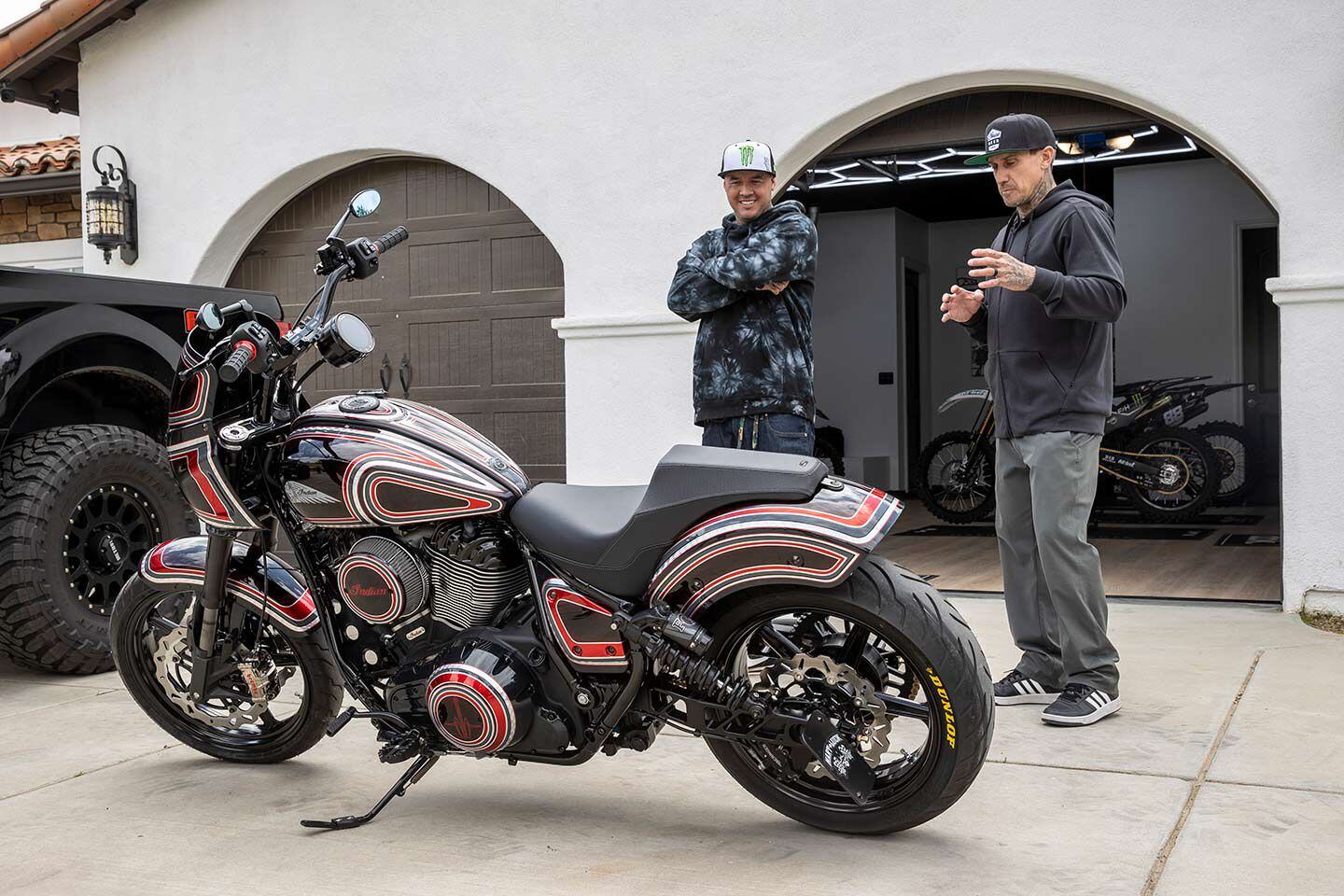
Hart (right) running down the build sheet for Twitch. (Jeff Allen/)
Hart’s privateer motocross racing days instilled the value of doing things the right way and not cutting corners. And this is where all unseen work is hidden behind the silver leaf and glossy paint. Titanium fasteners are used nearly everywhere with threadlocker and the proper torque values. Every pivot is greased. Every touch point is perfected for the rider.
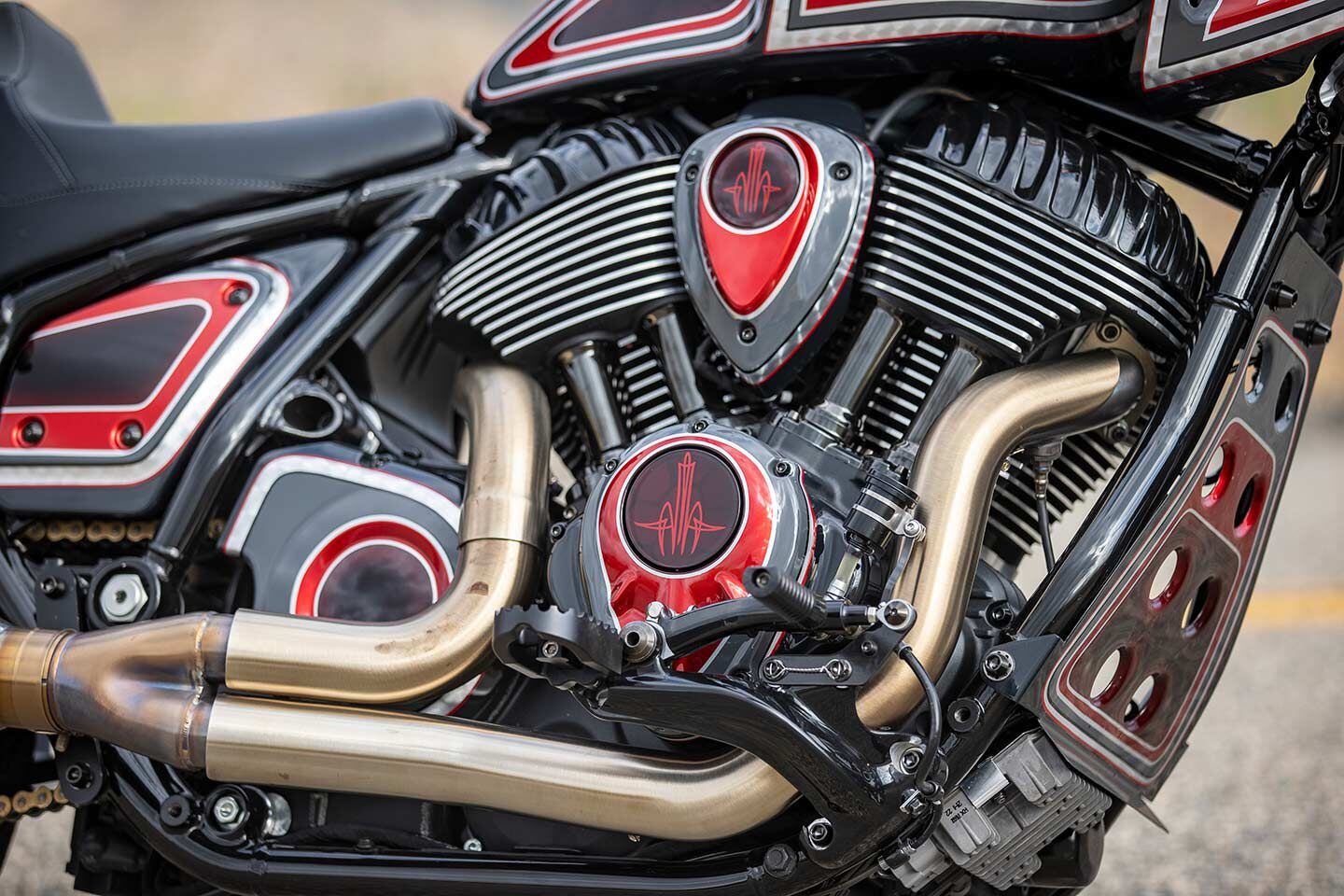
There’s hardly an inch on the bike that hasn’t been painted by Schultz Designz. (Jeff Allen/)
After Twitch returns, the film crew gets some interviews and sound bites as I gear up for my turn after getting a behind-the-scenes look at the production of this final episode for Indian. Having ridden a Sport Chief for a few hundred miles, I’m well aware of my likes and dislikes of this model. I love the torquey grunt of the Thunderstroke 116 engine, but the vibes through T-bar controls at 3,500 rpm forces a short-shift or to rev the engine past the meat of the power. It’s also a stretch for my 5-foot, 10-inch frame to those vibrating grips, and the footpeg position doesn’t fit my knees or hips. Braking at the front is impressive for a cruiser with strong power and great feedback, but the rear is less so with a light switch feel.
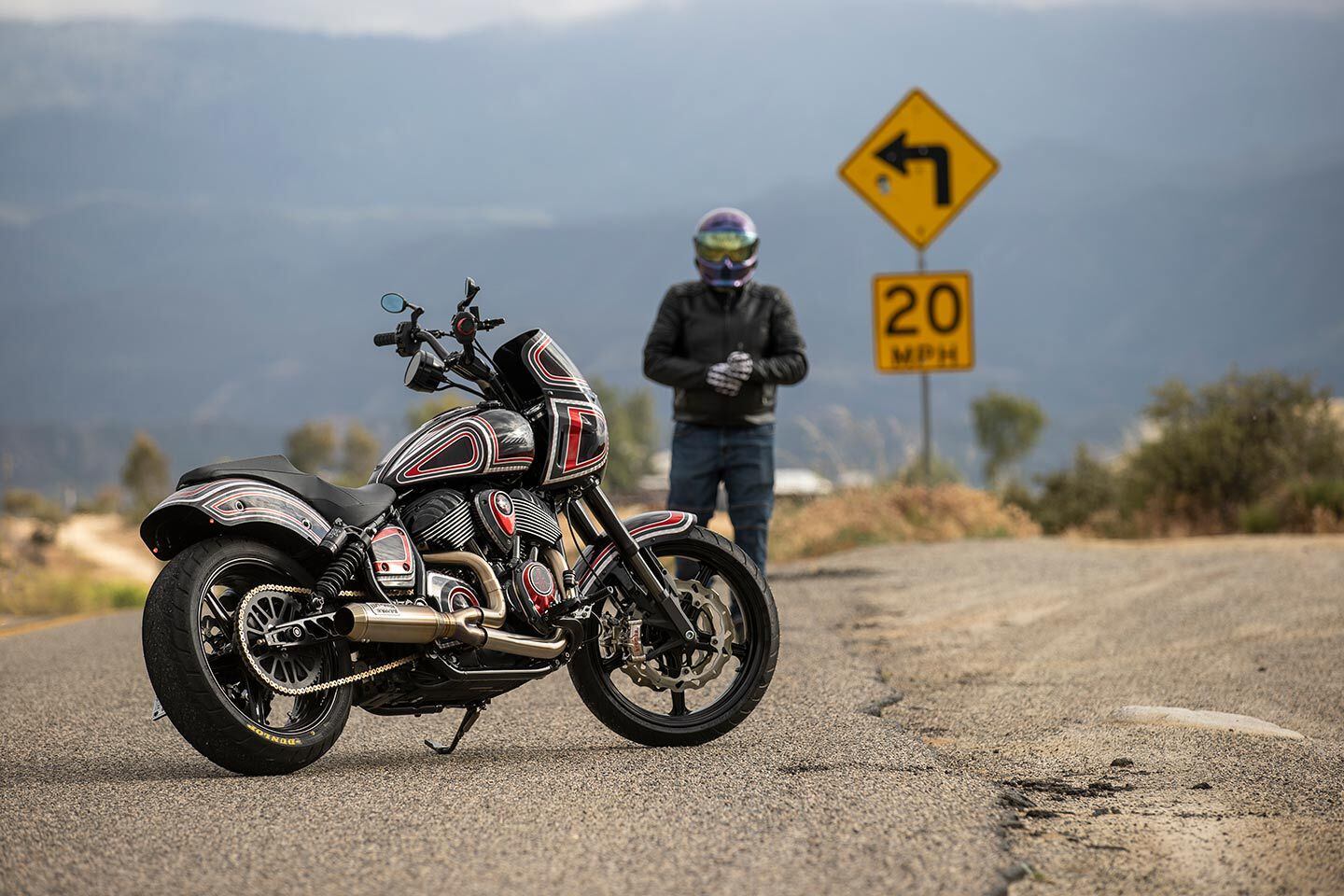
“Don’t scratch it. Don’t scratch it. Please, please, please, don’t scratch it…” (Jeff Allen/)
Immediately it was clear the Hart-Luck handlebar matched to Kraus Motor Co. bar clamps and risers brings the bars into a more comfortable and commanding position with less of a stretch forward. The height of the risers is a bit tall while sitting, but when it’s time to stand up and burn the rear tire off, your hands are right where you’d want them to be. Hart’s signature-model ODI grips are less bulky and match perfectly with the thinner Beringer levers. That highly annoying vibration is now gone as well.
A Hart-Luck Saddlemen seat gives a more comfortable perch while the San Diego Customs footpegs and foot controls are more motocross than street—again, adding more control and comfort.
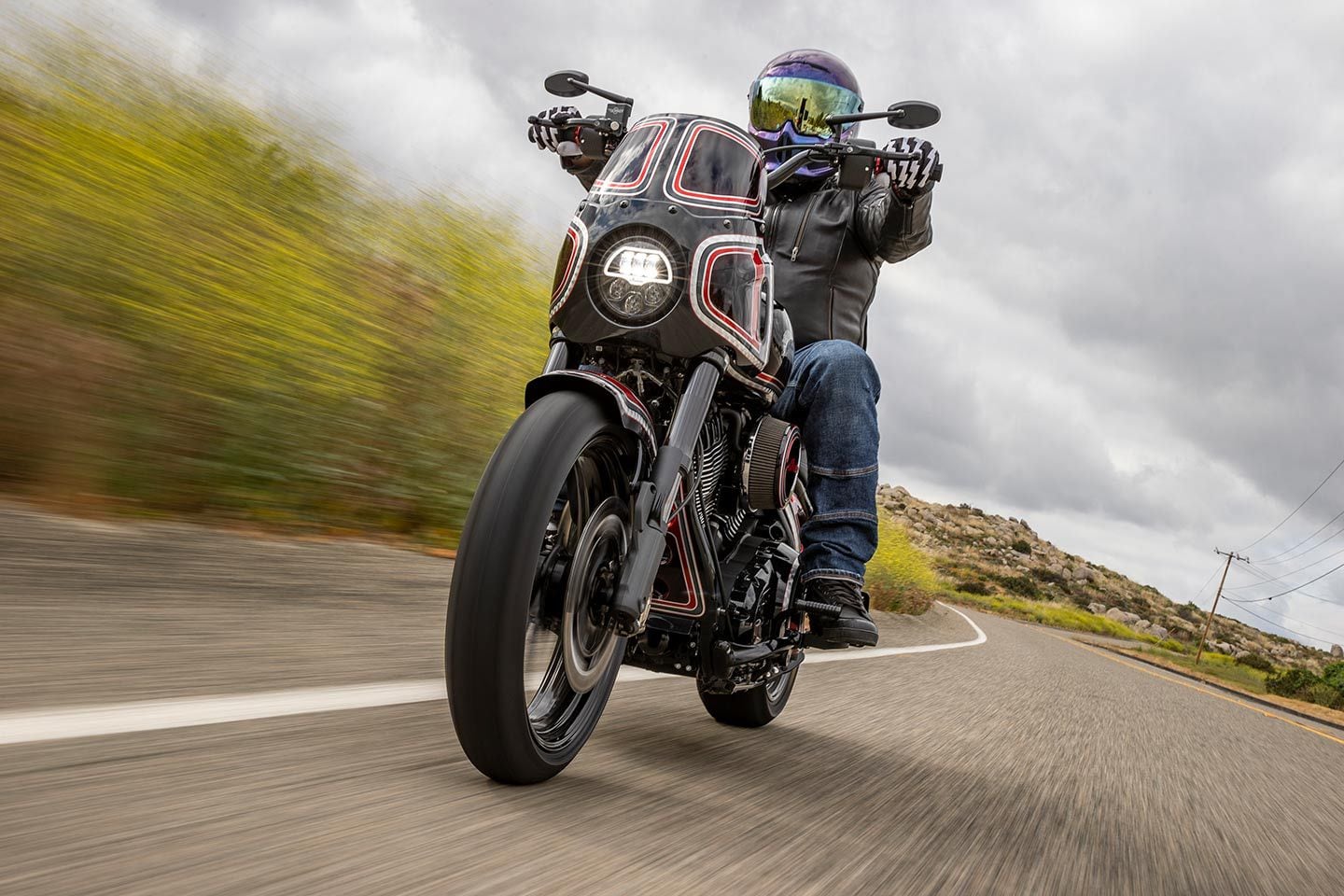
Hart has increased the comfort dramatically with a Saddlemen seat, San Diego Customs footpegs, Kraus bar risers, and Hart-Luck grips and handlebar. (Jeff Allen/)
On the road, the Hart-Luck Bassani exhaust is raspy as you roll on and off the power in Temecula’s hillsides and canyons. While the overall power hasn’t increased much, the lighter chassis and stiffer suspension reacts quicker to throttle inputs. Although the bike has more snap, final gearing through the Barnstorm Cycles chain conversion is identical to stock.
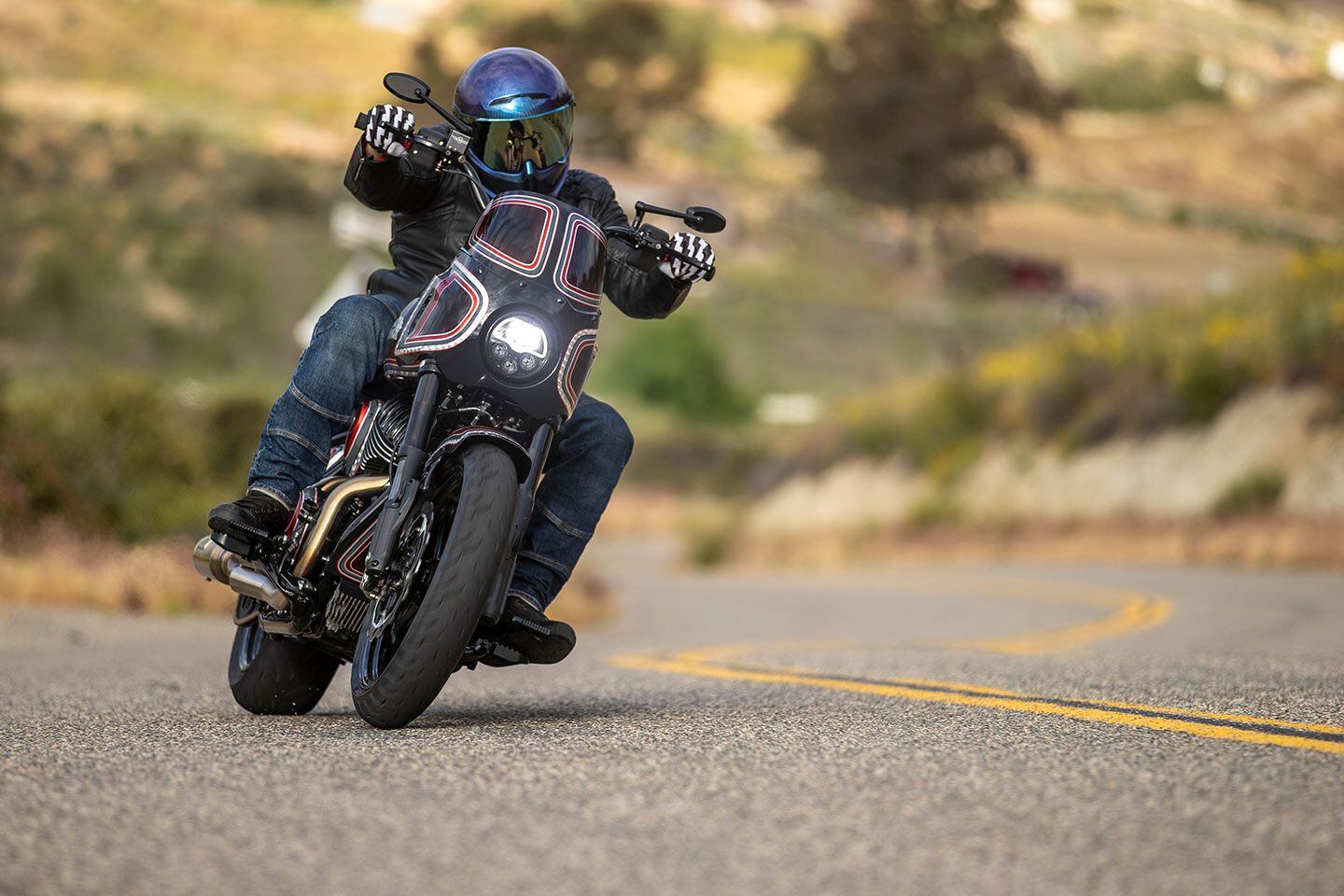
While it may look like a showpiece, Twitch’s Indian Sport Chief is more about having fun and going fast. (Jeff Allen/)
Where Hart’s creation really shines is in handling. Hart-Luck five-spoke wheels wrapped in Dunlop American Elite tires allow the Sport Chief to change directions and drop into corners quicker than the bulkier stock mags. The 1.5-inch-longer fork with GP Suspension valving, springs, and DLC coating raises Twitch’s ride for increased cornering clearance. Overall, the ride is much sharper and responsive.
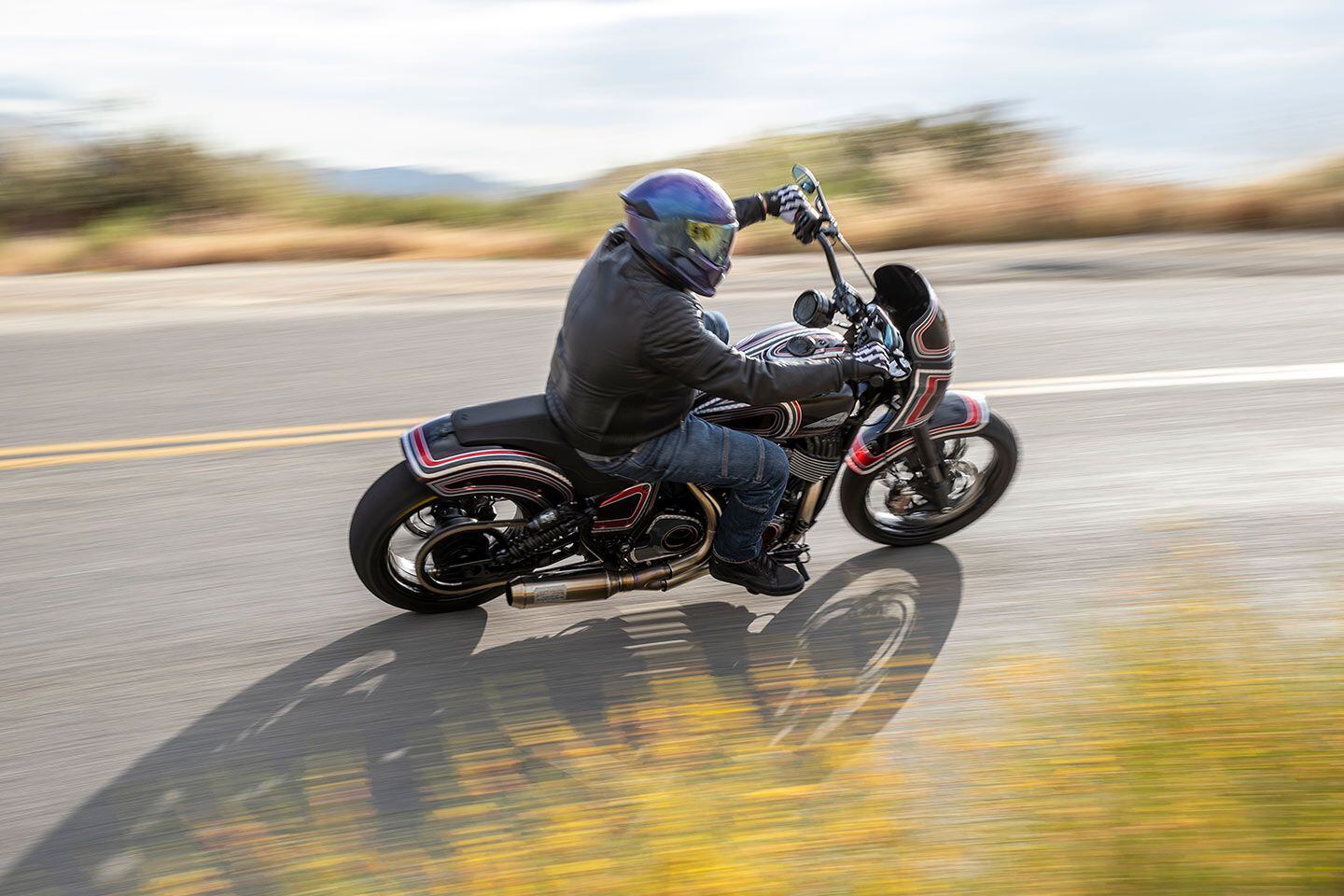
Cornering clearance is increased, adding more sportiness to the Sport Chief. (Jeff Allen/)
Slowing Hart’s build is handled by a revamped braking system. At the front, dual Brembo Monoblock calipers squeezing Galfer Wave rotors actuated a Beringer master cylinder. At the rear a Beringer master cylinder is matched with a twin-piston Beringer caliper. With this setup, the front brakes are now a one-finger squeeze with an impressive initial bite combined with exceptional feedback and excellent power; think superbike levels of stop. At the back the Beringer setup is more progressive in power than the on-off operation of the stocker.
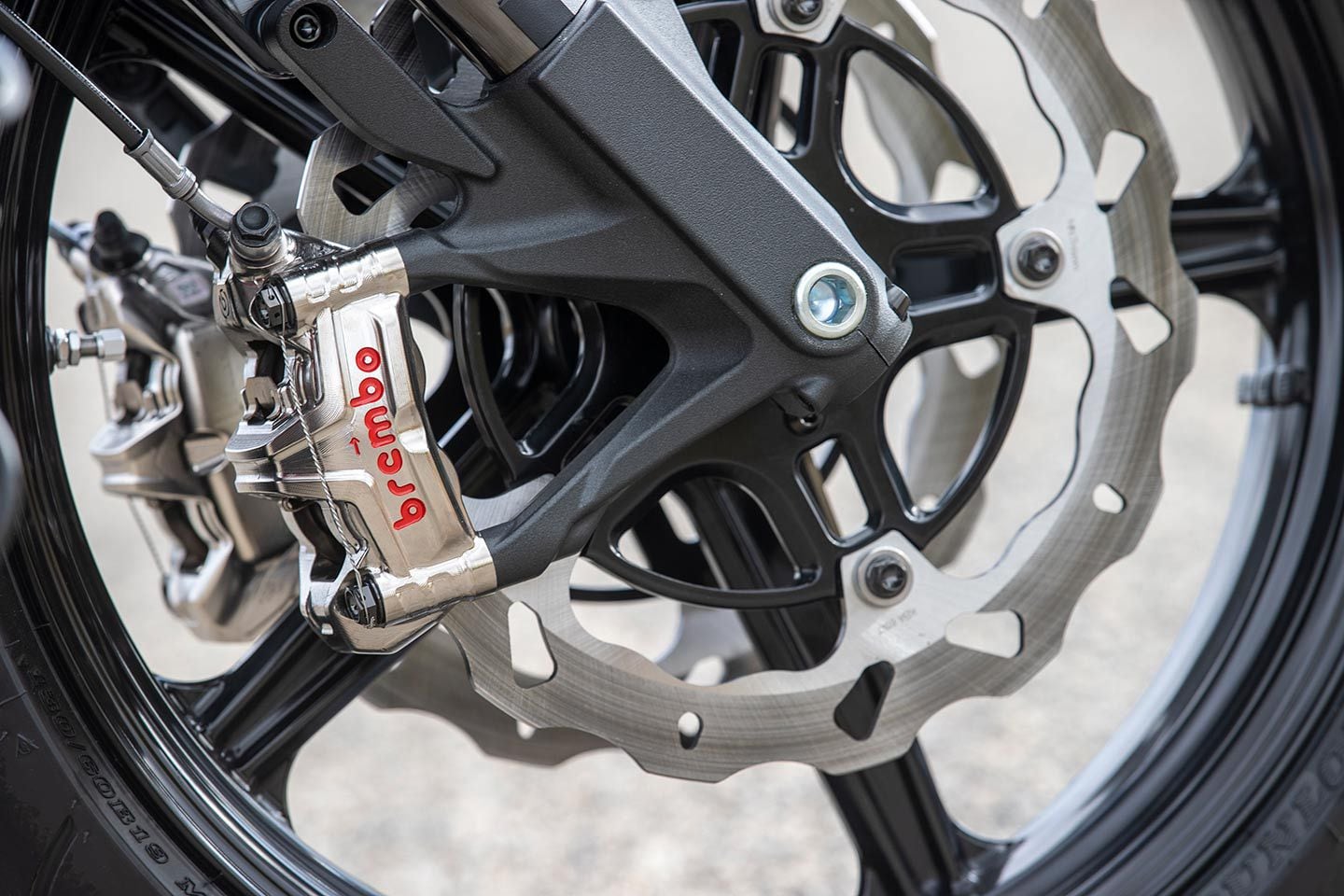
Brembo Monoblock calipers matched to Galfer rotors and a Beringer master cylinder stop the custom Sport Chief with excellent power and feedback. (Jeff Allen/)
Suspension action is markedly stiffer than stock, perhaps a little too stiff at the rear as there’s less squat through the Trac Dynamics swingarm and fully adjustable shocks. This makes hookup out of corners at full stop more difficult than stock. That rear Dunlop spins up easily—great for burnouts and slides, but it does require more throttle attention and finesse when blasting out of corners. Hart got the setup right for the owner and what he wants to do—use a lot of the rear Dunlop tire. Even with the lack of hookup, the Hart Sport Chief waxes a box-stock machine in the twisties.
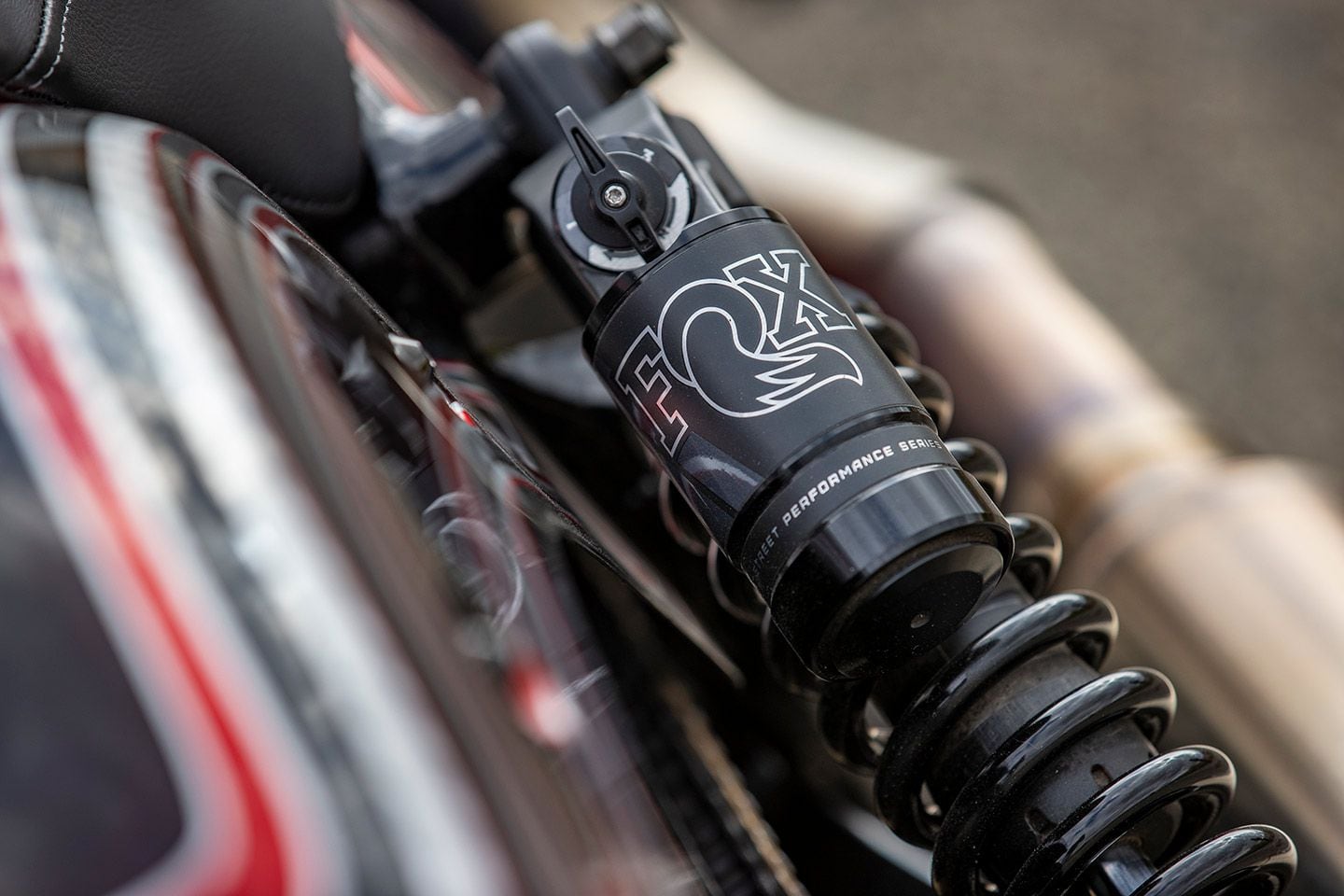
Fully adjustable Fox Factory shocks offer a stiffer ride and more ground clearance. (Jeff Allen/)
As I became more comfortable with Twitch’s Sport Chief, I began pushing harder, lighting up the rear tire out of fast sweepers. Thank goodness the clock ran out for my time with the bike, as I was becoming too familiar with a bike that was not mine. That’s when bad things can happen, and I absolutely didn’t want to put that insurance policy to work.
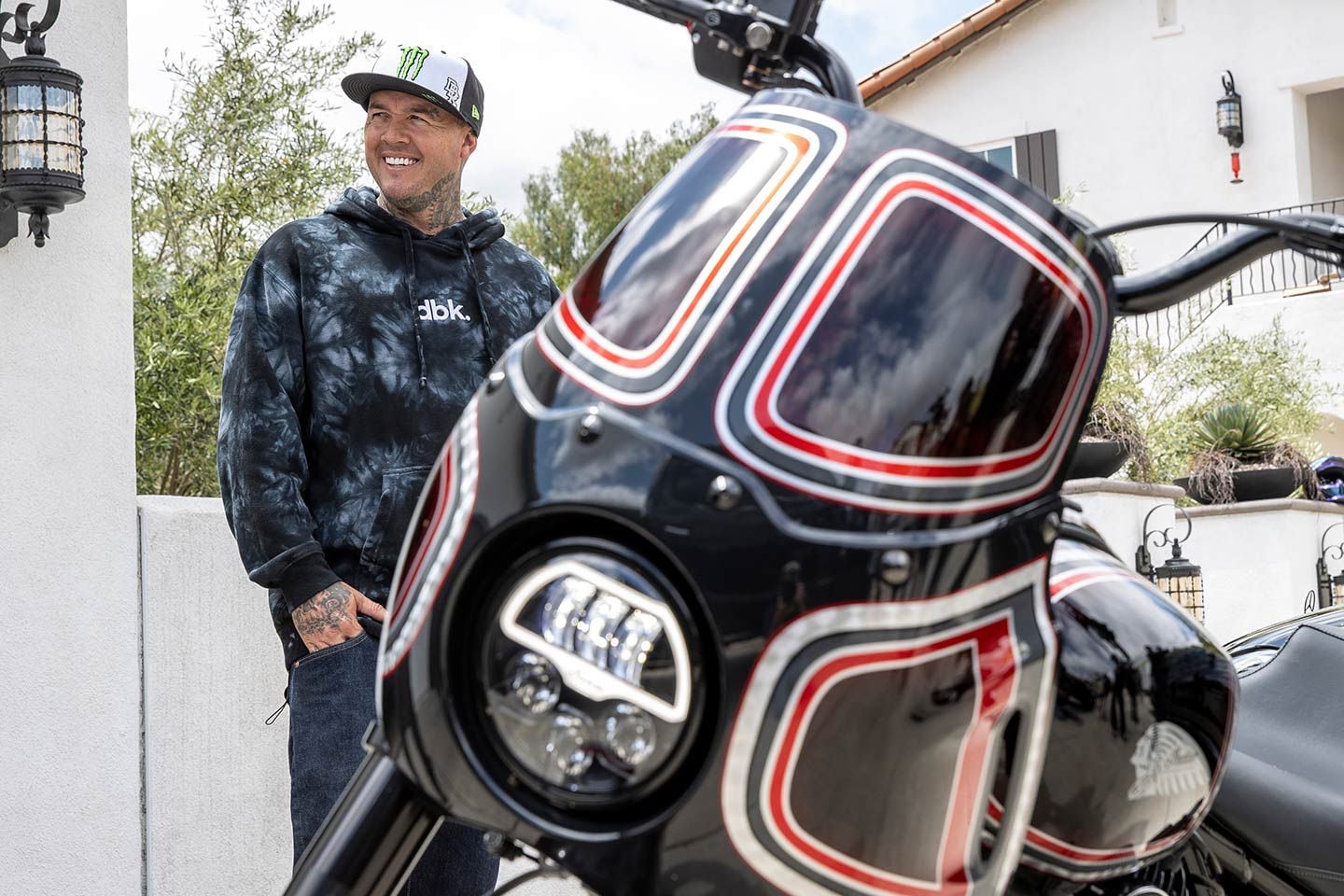
Twitch’s face says it all. (Jeff Allen/)
Carey Hart has increased the performance of the Sport Chief significantly. If you’ve got a Sport Chief, I would suggest following Hart’s lead. You don’t need to do all of the list, but just copying a few of his tricks will increase your fun, even if you don’t beat on your Sport Chief like Twitch does.
Hart-Luck Indian Sport Chief Parts List
| Paint: | Schultz Designz |
| Tires: | Dunlop American Elite |
| Wheels: | Hart-Luck 5-spoke |
| Fork: | GP Suspension w/ 1.5 in. longer, coated lower tubes, spring, and valving |
| Shocks: | Dual Fox Factory 13-in. piggyback shocks |
| Swingarm: | Trac Dynamics billet aluminum |
| Front brake calipers: | Brembo Monoblock |
| Rear caliper and hanger: | Beringer |
| Rotors: | Galfer Wave |
| Brake lines: | Galfer |
| Shift/brake levers: | San Diego Customs |
| Chain conversion: | Barnstorm Cycles |
| Air intake: | Indian high flow |
| Clutch cable: | Barnett |
| ECU program: | Dynojet |
| Exhaust: | Bassani/Hart-Luck |
| License plate mount: | Drag Specialties |
| Pegs: | San Diego Customs |
| Lower frame cover: | Hart-Luck custom |
| Hardware: | Pro-Bolt black anodized titanium |
| Bar clamps and risers: | Kraus Motor Co. |
| Bars and grips: | ODI/Hart-Luck |
| Gauge bucket: | Kraus Motor Co. |
| Clutch perch and front master: | Beringer |
| Seat: | Saddlemen/Hart-Luck |
| Front and rear indicators: | Rizoma |
| Rear master: | Beringer |
| Rear master reservoir: | Rizoma |
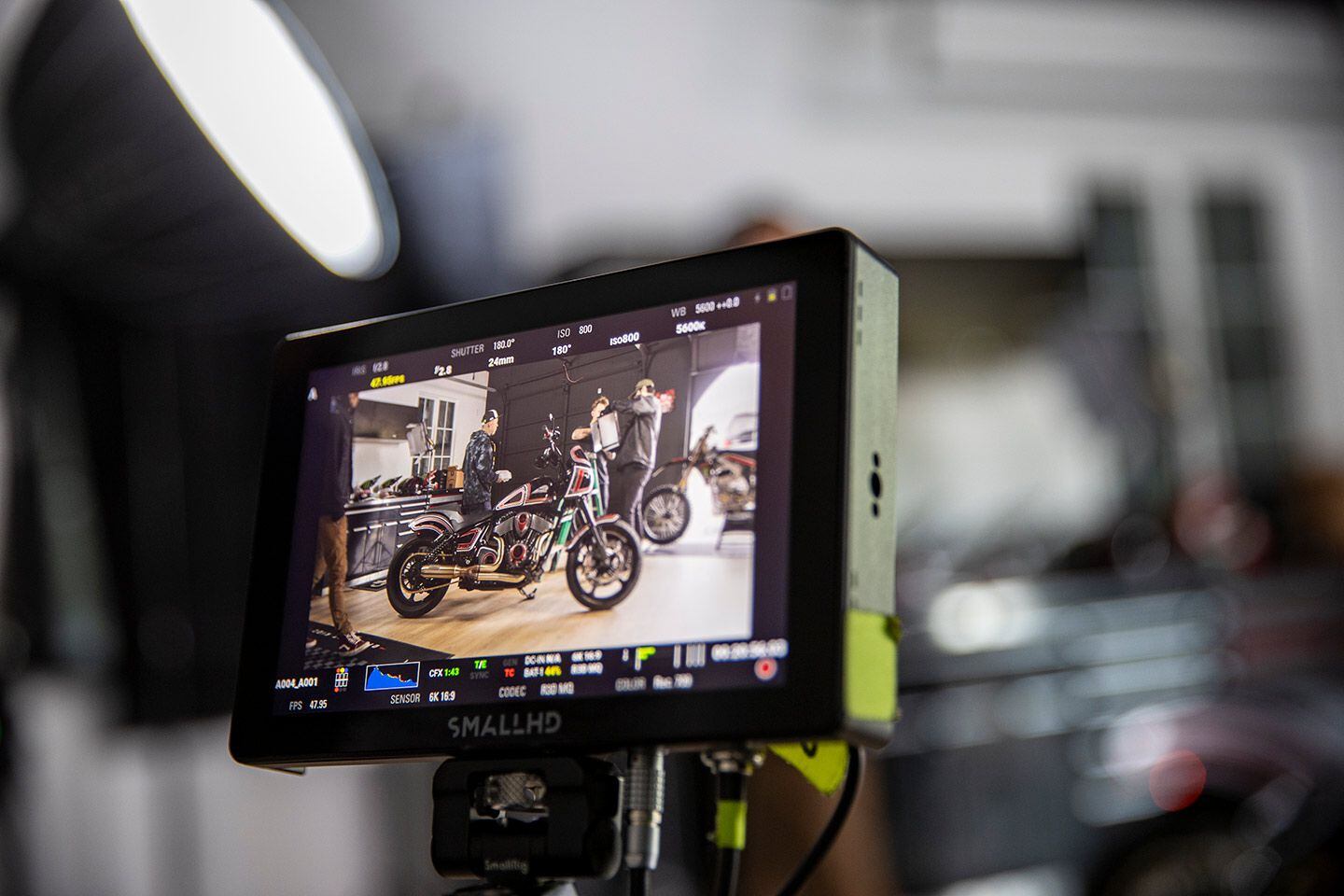
Behind the scenes of the <i>Forged</i> video shoot. (Jeff Allen/)
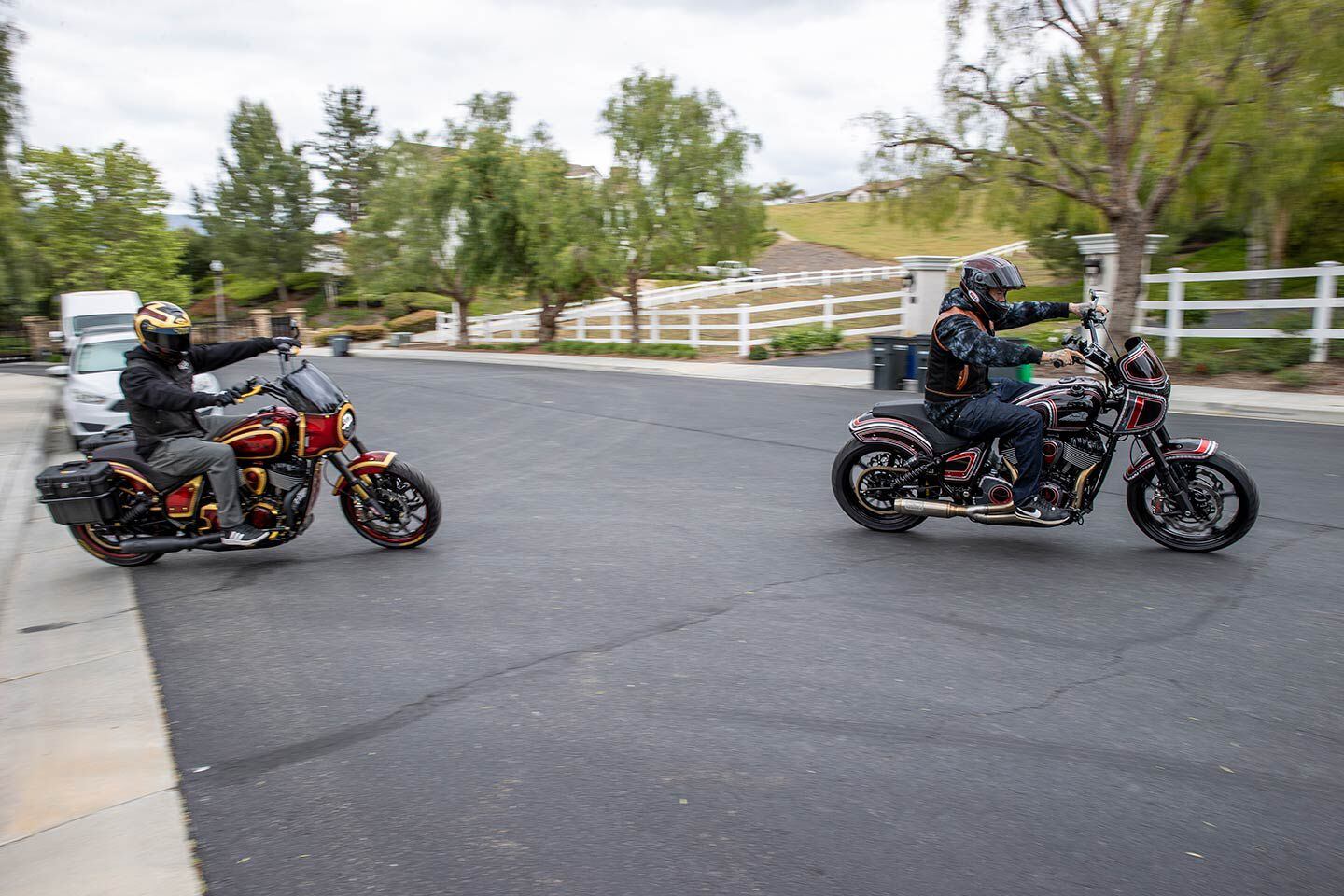
Hart and Twitch head out for the first ride and burnout. (Jeff Allen/)
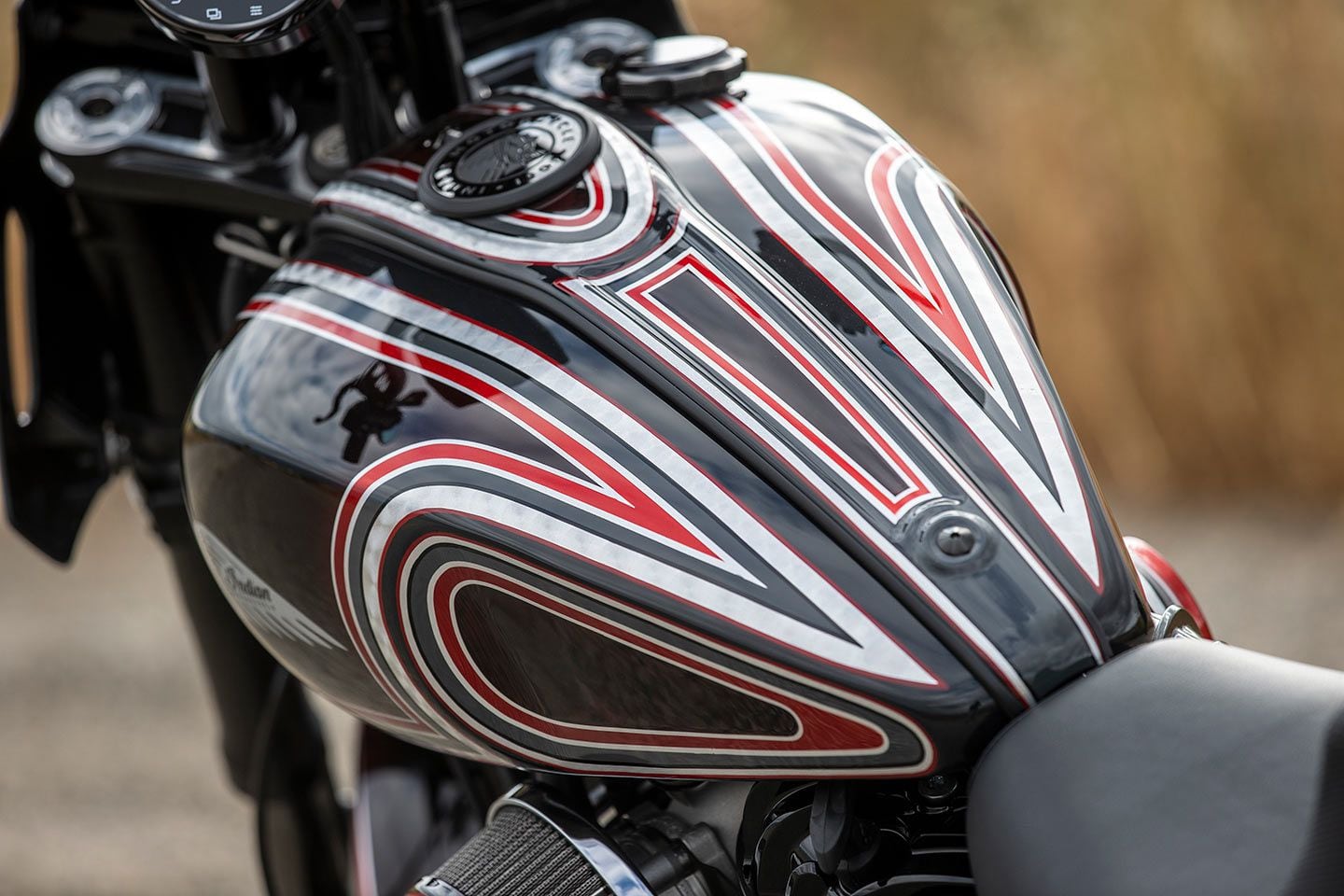
Knee cutouts on the tank create a slimmer cockpit for the rider. (Jeff Allen/)
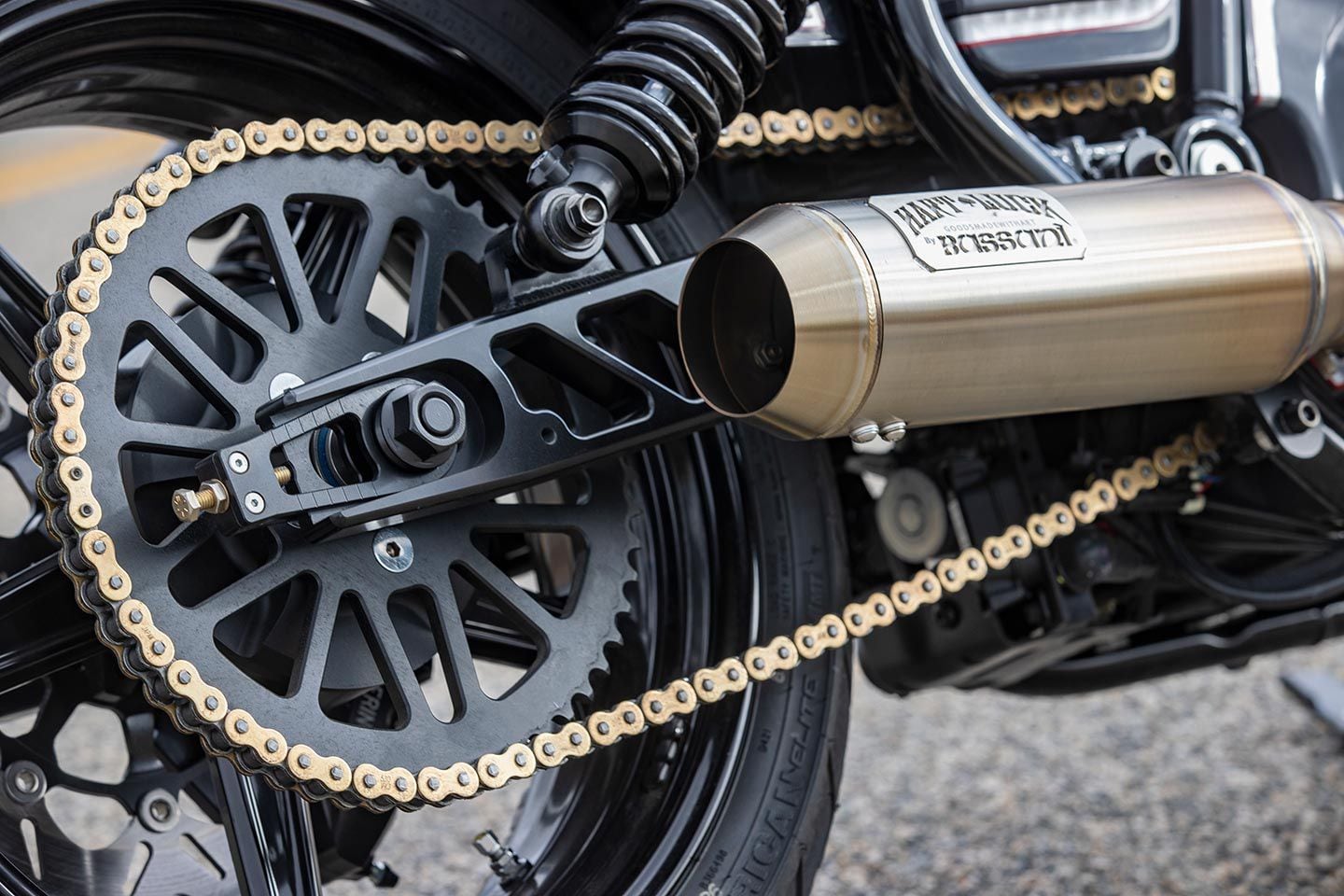
Trac Dynamics billet swingarm, Bassani exhaust, and Barnstorm chain conversion. (Jeff Allen/)
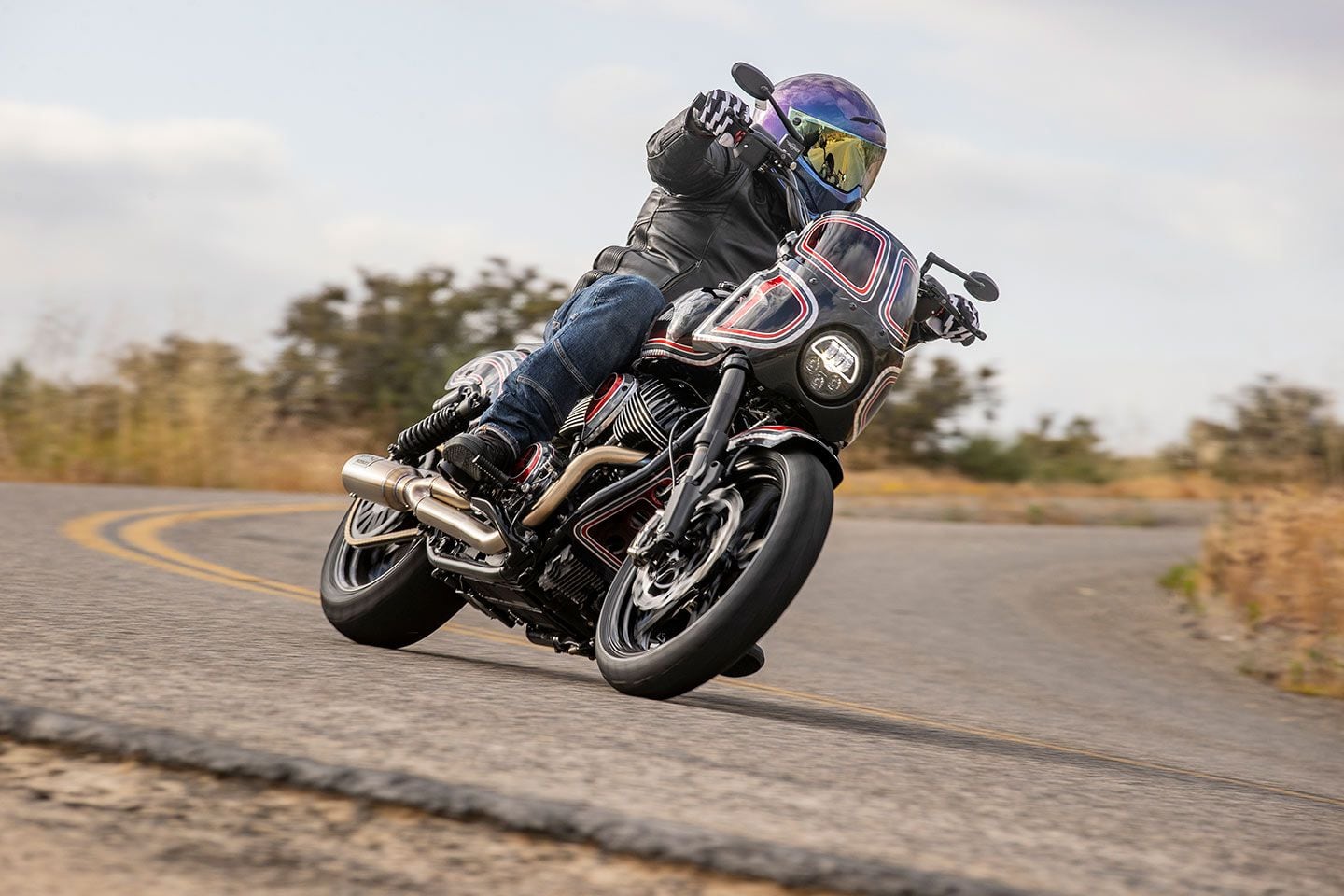
Handling on Twitch’s custom Sport Chief is greatly improved over stock. (Jeff Allen/) ]]>
Back in Harley-Davidson’s lineup for 2023, the Breakout 117 returns with the largest version of the Milwaukee-Eight powerplant. (Jeff Allen/)
There is just something about the stance of the Harley-Davidson Breakout 117 that visually sucks you in, especially the rear three-quarter view. The super fat 240 rear tire with an ultraclean bobbed fender with minimalist indicator/brake lights and the softail rear end just looks so right. Apparently we aren’t the only ones who think so, as Harley-Davidson has brought the Breakout back into its lineup after a couple year hiatus.
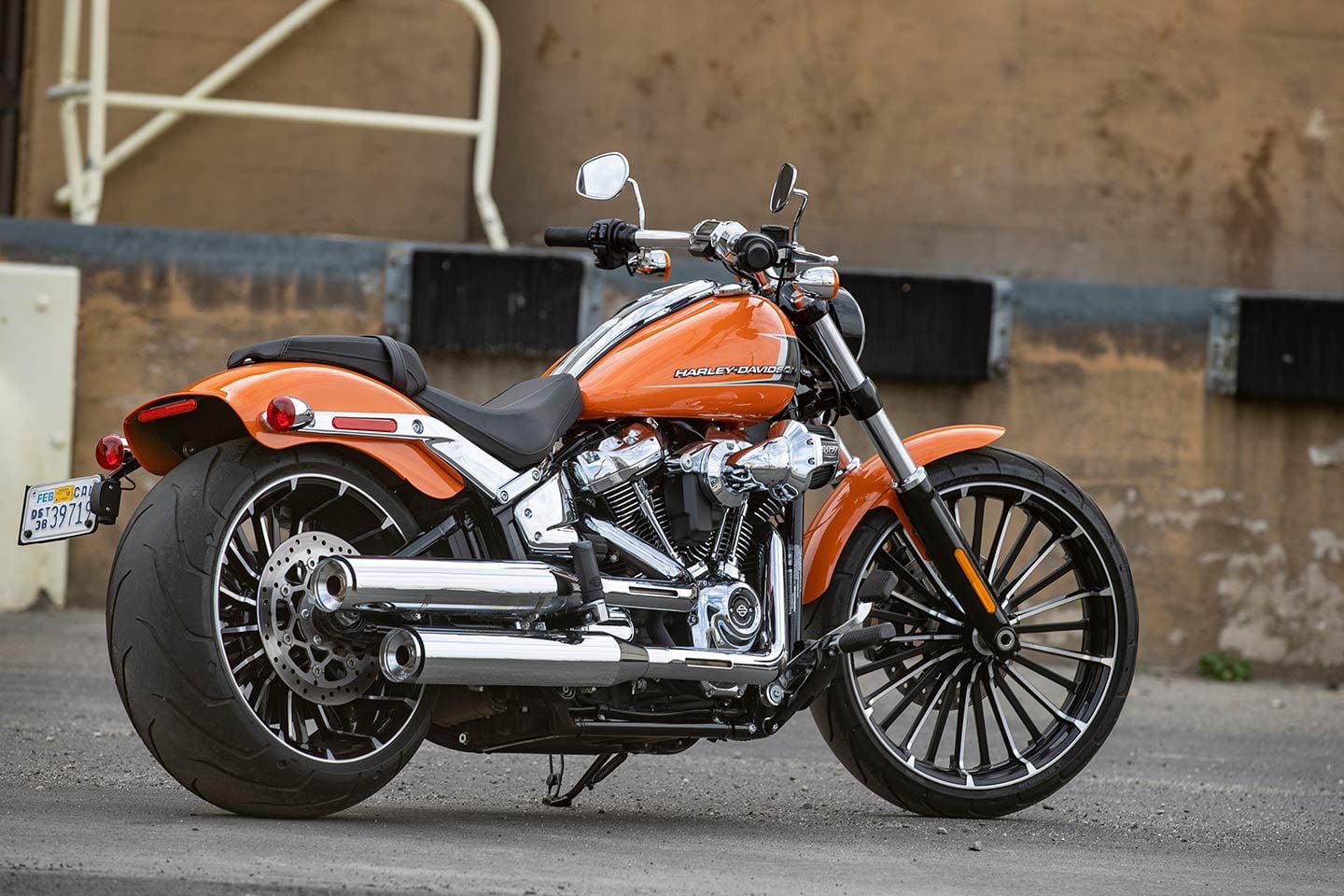
We’re particularly fond of the Breakout from this view. (Jeff Allen/)
The last time the Breakout was on the books was in 2020, and back then it sported a Milwaukee-Eight 114 engine, but has now been upgraded with the 117 version of that V-twin. Other new highlights include a larger 5.0-gallon fuel tank (up from 3.5), a 3/4-inch taller handlebar riser, standard cruise control, and available traction control. This custom cruiser is all about style, but that doesn’t mean it sacrifices substance.
117ci Milwaukee-Eight Engine
As mentioned, the Breakout gets the 45-degree, counterbalanced Milwaukee-Eight 117 V-twin, which is the largest engine currently offered in regular-production Harleys. Yes, The Motor Company just announced the upcoming 121, but for 2023, this is the top of the food chain. The Milwaukee-Eight has been around since 2017, and was first available in 107ci and 114ci displacements. Those have since grown with the 114 becoming the standard size and 117 the larger offering in select models like the Breakout. Can we assume that in 2024 that will creep up to 117/121? History says yes.
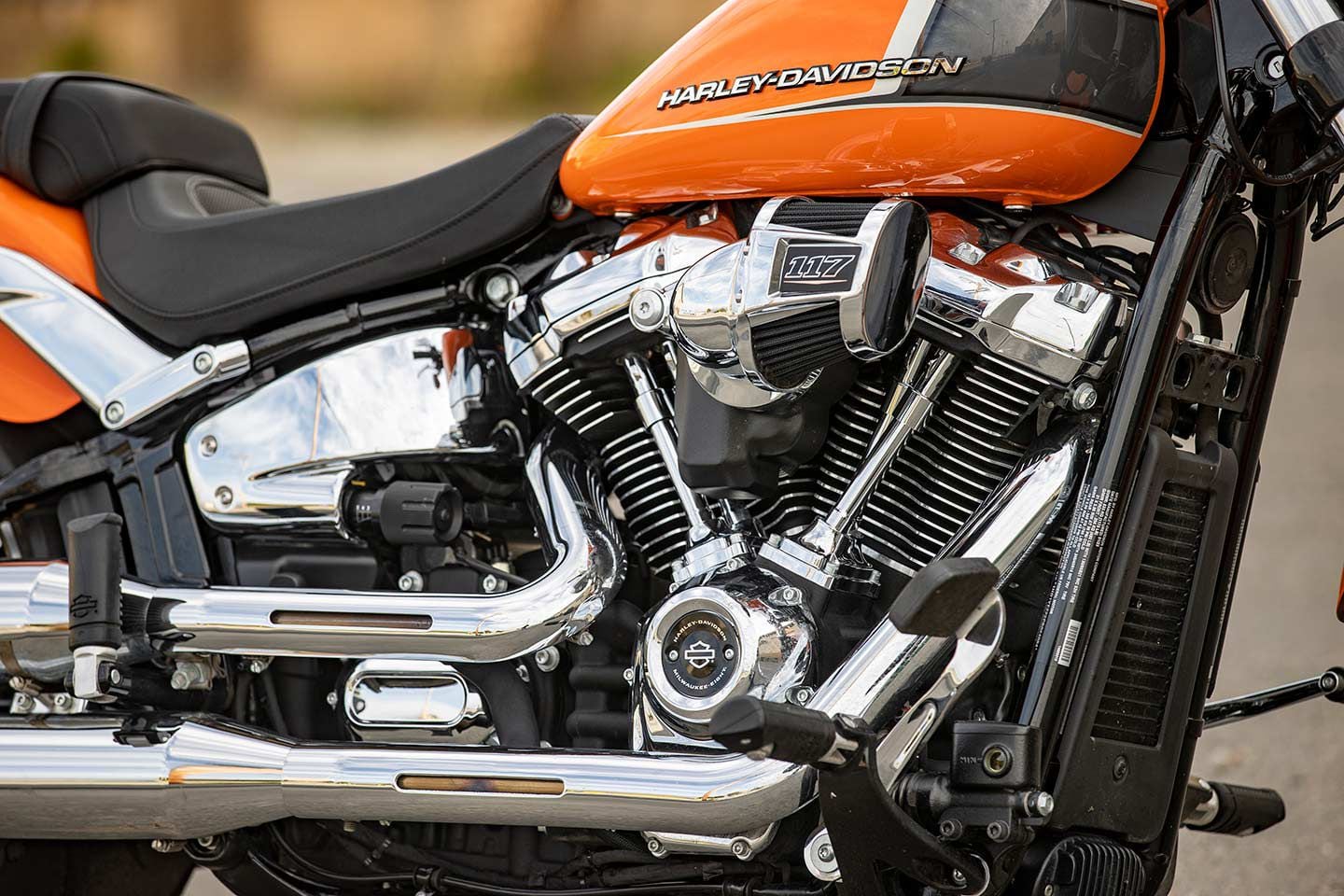
The largest engine currently offered in standard production H-D models is the Milwaukee-Eight 117. (Jeff Allen/)
Back to the Breakout; the Milwaukee-Eight 117 (1,923cc) has 103.5 x 114mm bore and stroke dimensions respectively with a 10.2:1 compression ratio. The “Eight” in the name designates the fact that it’s an eight-valve engine. A single four-lobe cam actuates a pair of pushrods on each cylinder, which in turn operate a pair of rockers in each head. Hydraulic roller tappets maintain valve clearances. Oil is supplied via a dry sump and is circulated through a cooler.
On the Cycle World dyno, the Breakout produced 94.2 hp at 4,790 rpm and 118 lb.-ft. of peak torque at 3,250 rpm at the rear wheel, which is very close to Harley’s claimed numbers of 101 and 125.
One of the design goals that was pursued with the Milwaukee-Eight was heat management. A shallow combustion chamber helps dissipate heat quickly, while the bridge between the exhaust valves is cooled by passages that circulate oil to a mini radiator. Additionally, all Milwaukee-Eight engines feature the Engine Idle Temperature Management System, which deactivates the rear cylinder at a preset temperature if it starts getting too hot.
The engine is fed air through a chromed Heavy Breather intake into the throttle body with fuel delivered via Electronic Sequential Port Fuel Injection. A pair of spark plugs, one in the center of the combustion chamber and one offset on the side in each cylinder, light it up. Burned gases exhale through catalyst-equipped 2-into-2 staggered exhausts wrapped in chrome heat shields.
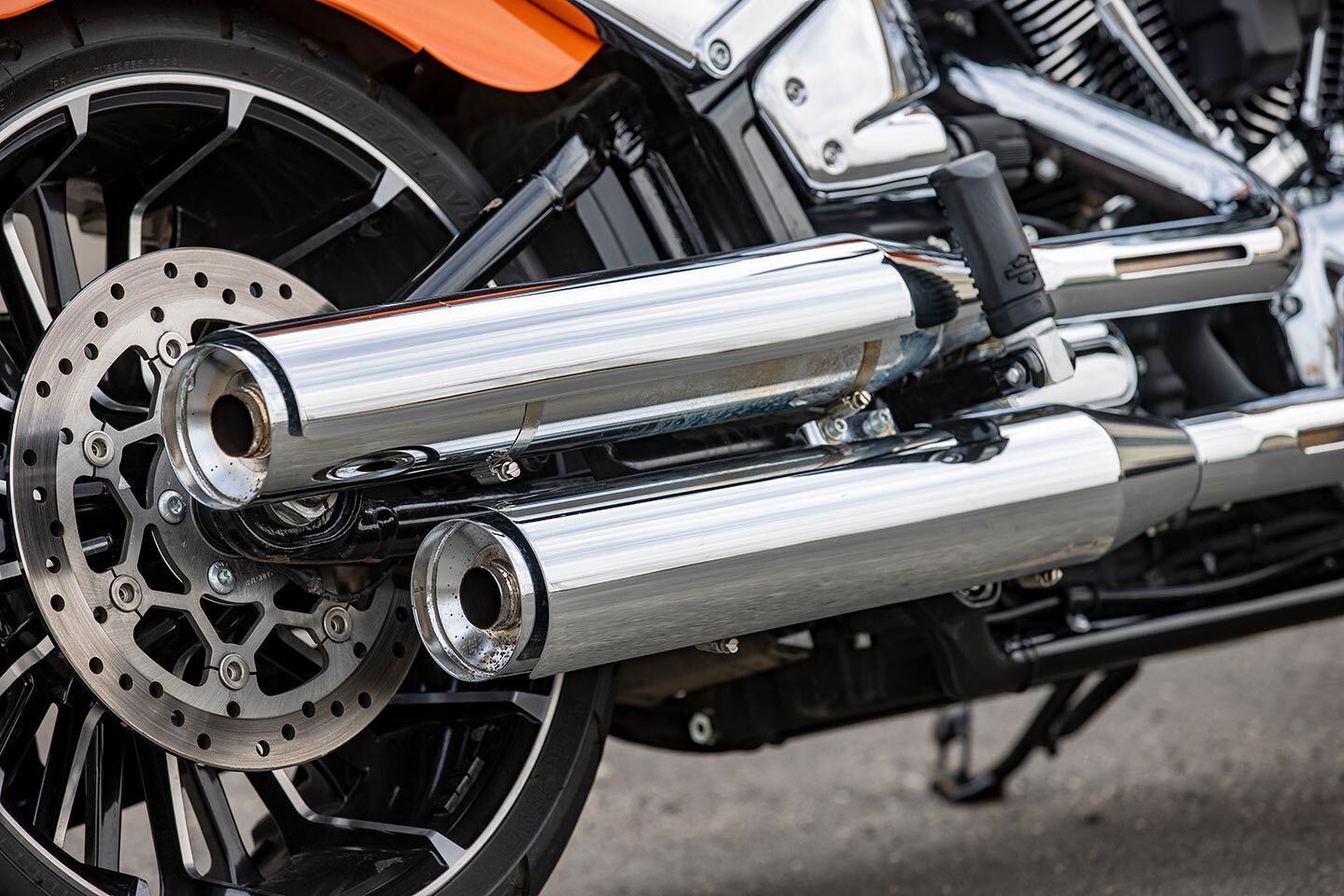
Exhausts are catalyst equipped. (Jeff Allen/)
Power is transferred to the compensator in the primary drive and via chain to the wet multiplate clutch that features assist functionality, making the pull lighter at the bar. Then power is doled out to the six-speed Cruise Drive transmission and onto the rear wheel via belt final drive.
Chassis
The Breakout is long and low, with a steel backbone frame and swingarm. The softail design features a hidden shock with 3.4 inches of travel and provision for spring-preload adjustment via a remote toolless knob. Up front is a 49mm conventional (right-way up) fork with 5 inches of travel. Wheelbase measures 66.7 inches with the rake angle set at 34 degrees with 5.7 inches of trail. The seat height is a super low 26.2 inches. Claimed wet weight is 683 pounds fueled up and ready to roll.
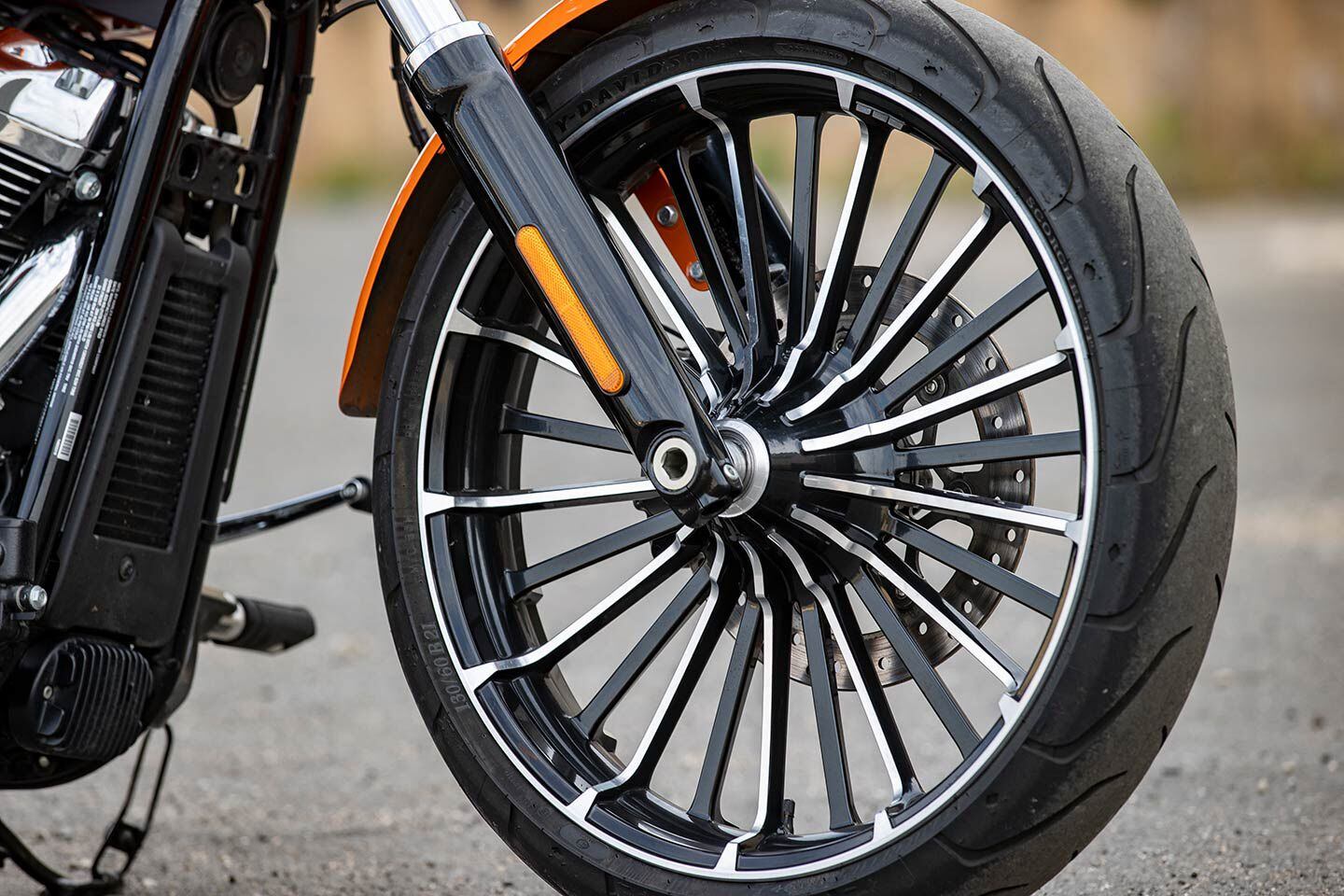
Key to the Breakout’s styling are the contrast-cut, 26-spoke wheels. Up front is a 21, and out back a wide 8-incher. (Jeff Allen/)
Key to the Breakout’s stance are the wheels and tires. Up front is a 3.5 by 21-inch 26-spoke cast-aluminum contrast-cut wheel with a 130/60-21 Michelin Scorcher 11 tire. Out back is a monstrous 8 by 18-inch matching wheel mounted with 240/40-18 tire. Braking is handled by a conventionally mounted four-piston caliper pinching a 300mm disc in the front, while at the rear is a twin-piston caliper and 292mm disc. ABS is of course standard.
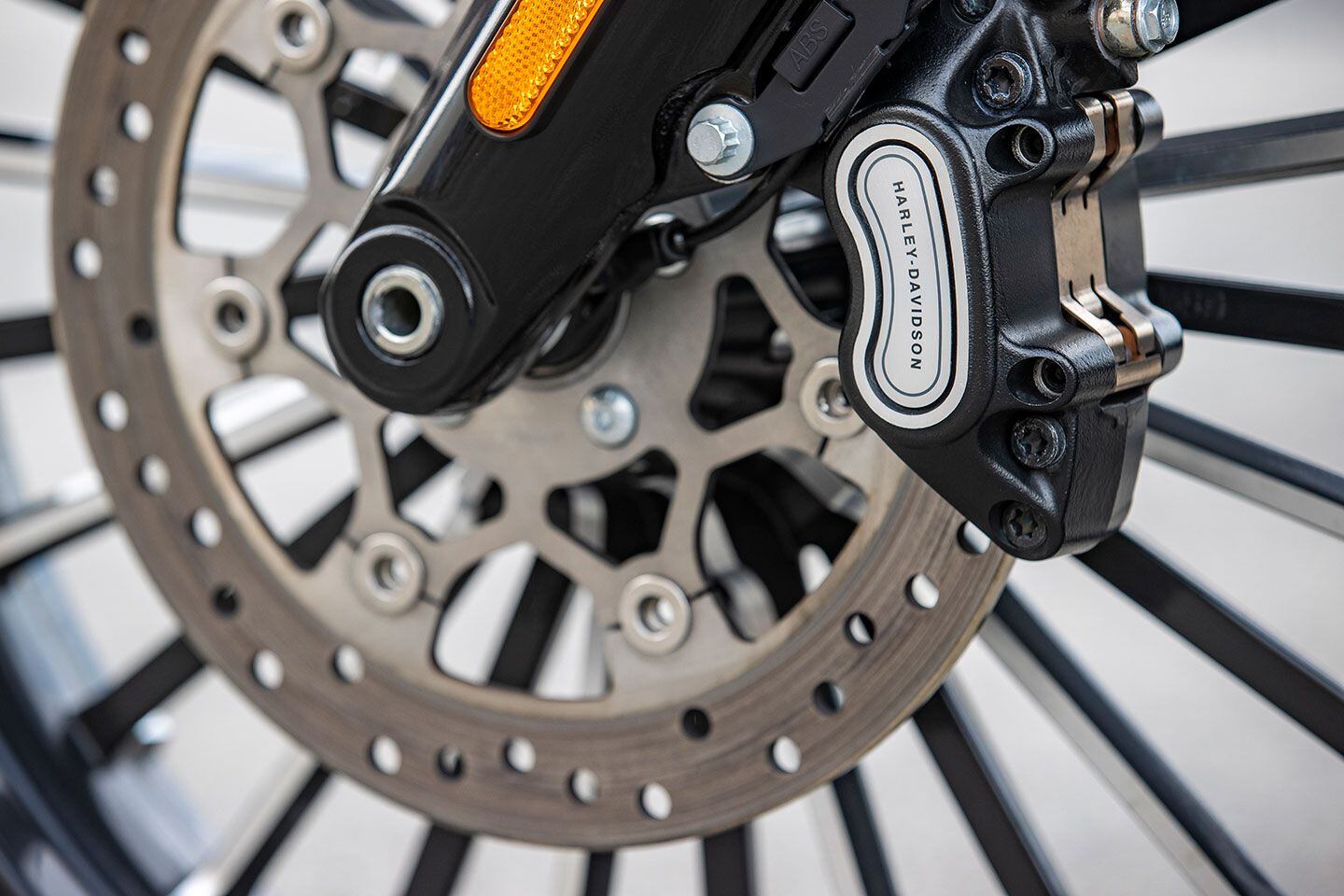
Up front, the Breakout uses a conventionally mounted four-piston caliper and 300mm disc. (Jeff Allen/)
Electronics
The view from the cockpit is dominated by the straight, chromed handlebar set on a slightly taller riser (+3/4 inch) than the previous Breakout and is topped by the small LCD instrument screen and a couple rows of warning/indicator lights underneath. The Breakout has keyless ignition with a fob, while all gauge info can be accessed from the left-handlebar-mounted pod. Love them or hate them, the turn signals are still split, with the left on that side and the right on the other. The bike’s standard cruise control is operated on an intuitive multifunction switch on the left, while the optional TC can be turned off on the right-pod switch.
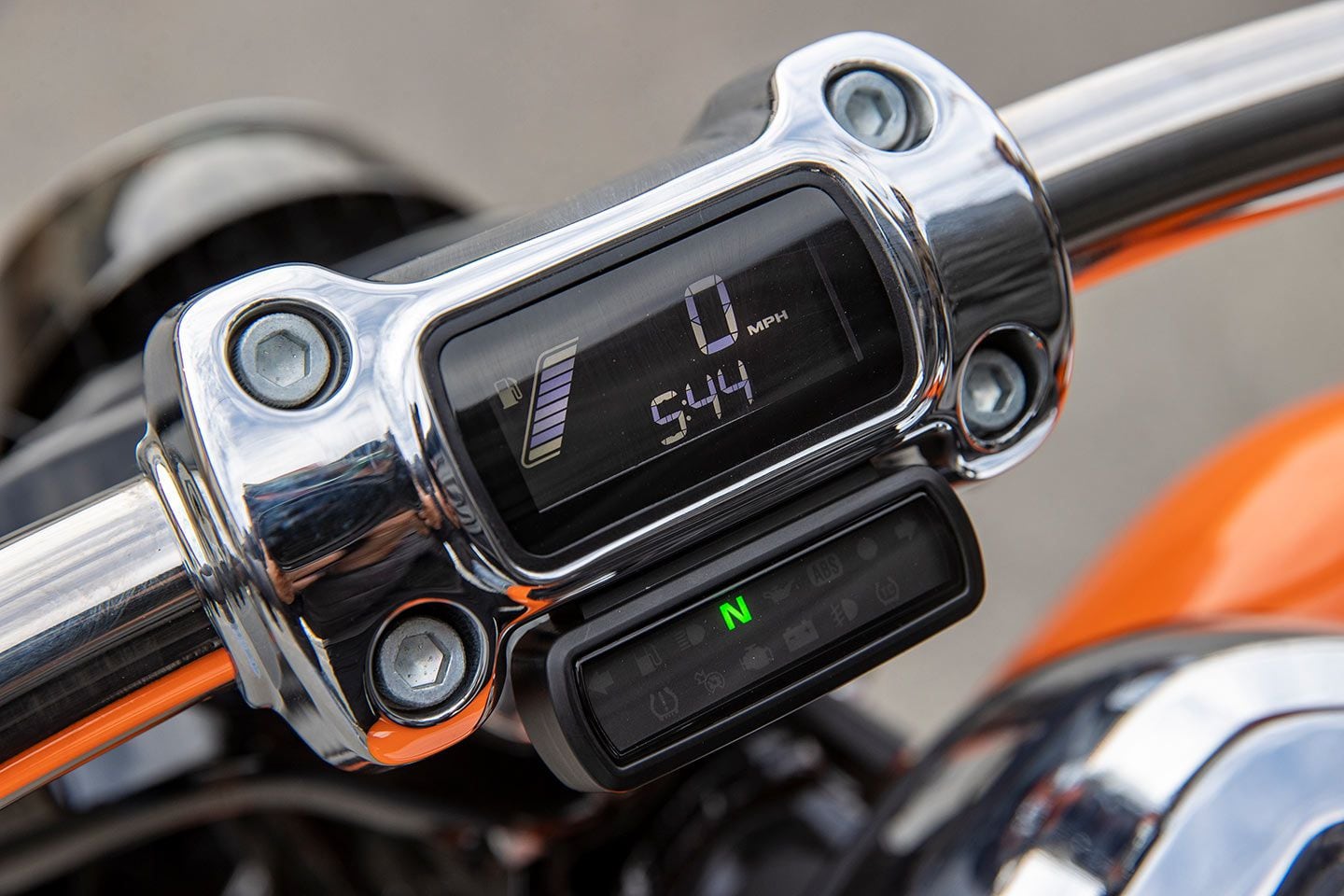
This minimalist LCD screen and double row of warning lights provide all the basic information. (Jeff Allen/)
Lighting up front is from a roval-shaped all-LED headlight, while the turn signals/taillight combo setup still use incandescent bulbs instead of LEDs. There is a USB power outlet that puts out 2.4 amps that will keep a bar-mounted smartphone topped up while navigating.
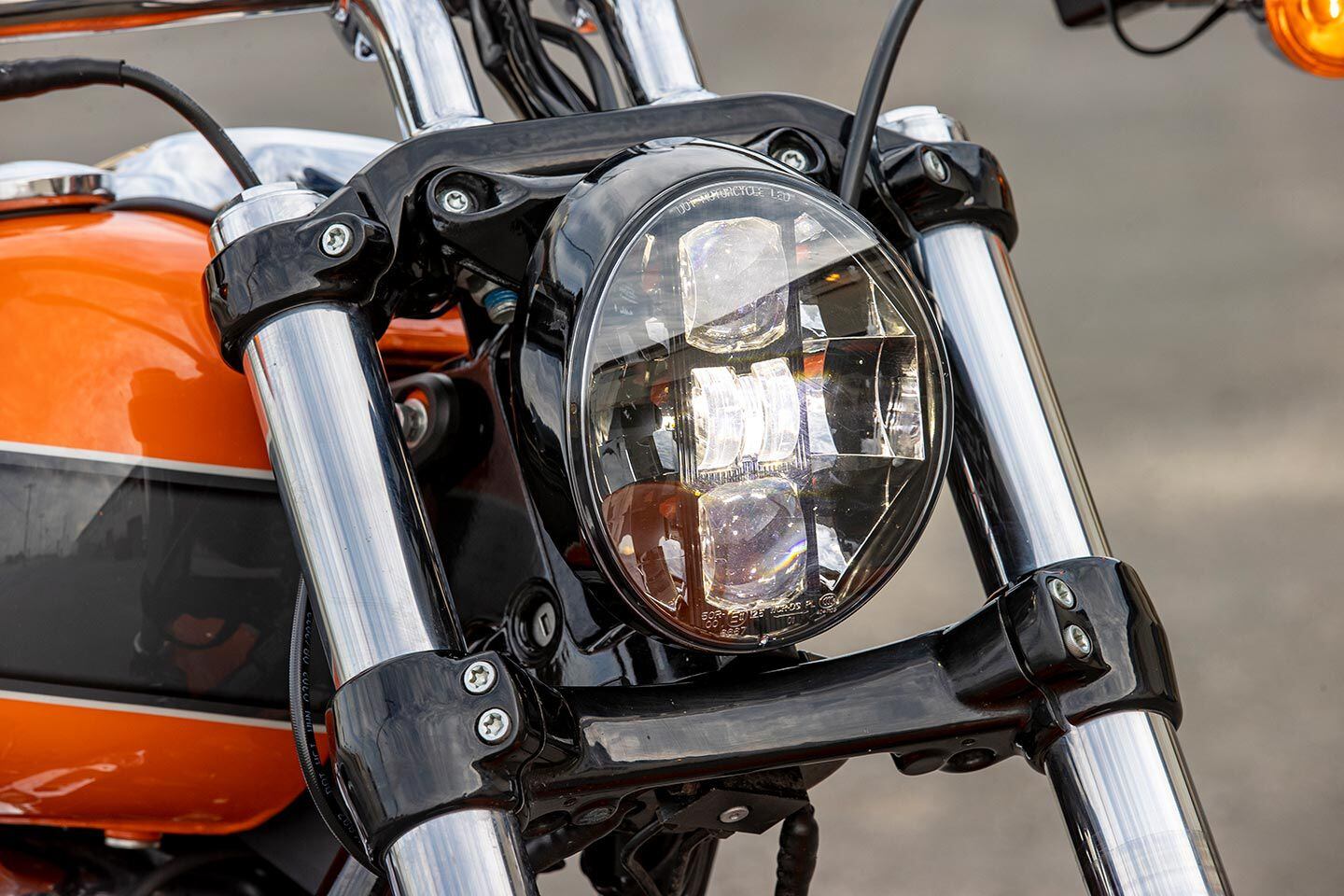
The headlight is an all LED unit. (Jeff Allen/)
Riding Impression
Custom-style cruisers are seemingly one-trick ponies, motorcycles that appear to be happy only cruising the local boulevards. But things aren’t always as they seem when you dig a little deeper with the Breakout; so like our mothers told us, don’t judge a book by its cover.
For sure, it’s quite fun launching the bike from stoplight to stoplight, treating every green light like a “tree” at the dragstrip. The fact that the 117 delivers a ridiculously flat torque curve from 1,750 to 4,000 rpm makes it hard to keep from chucking the clutch lever out and letting it catapult off the line, especially when a Tesla is lined up in the next lane… But there’s more to this bike than just straight-line performance.
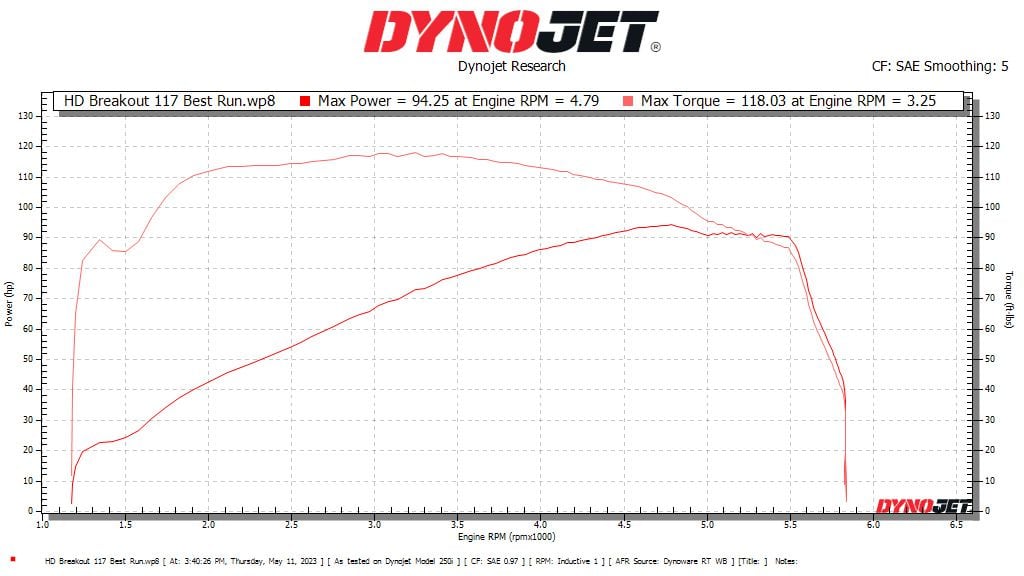
The Milwaukee-Eight 117 has heaps of torque and a totally linear horsepower curve. (Dynojet/)
With so much low-to-midrange torque on hand and a perfectly linear climbing power curve, there isn’t much benefit to revving the thing to the moon. Short-shifting just a bit and staying in the meat of the curve is quite rewarding and actually impossible to avoid. With a nice feel from the clutch and solid shift action from the transmission, keeping the bike on the boil is quite fun.
Our Breakout came with the optional traction control ($200), which seems like a no-brainer. Sure, it’s fun to turn it off and let the rear tire smolder off the line a bit, but with all that torque, if you want it to hook up, the TC definitely helps. Besides, we imagine that the 240-section tire is on the pricey side!
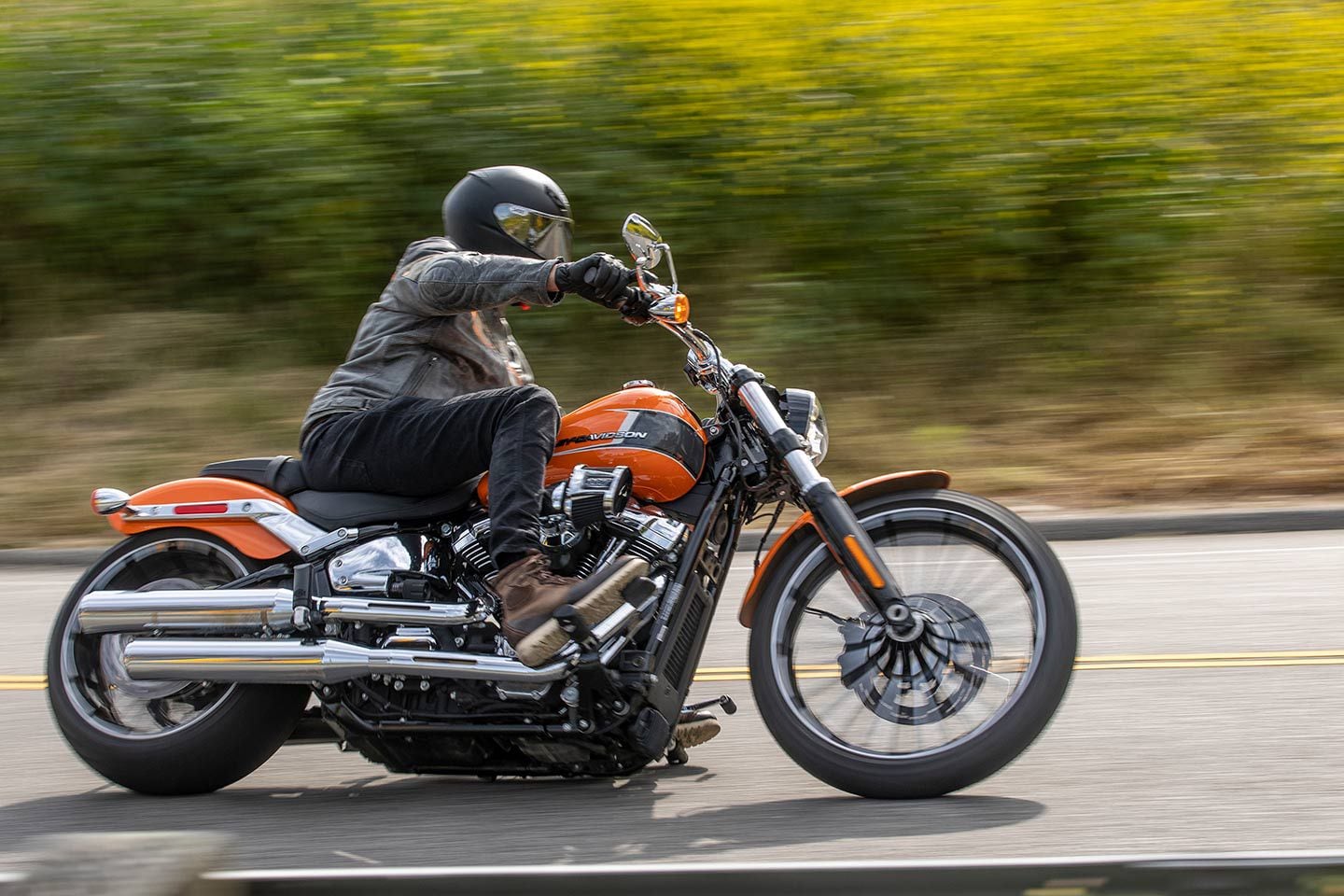
Out on mountain roads, the Breakout surprised us with its stability and fun pace. (Jeff Allen/)
Speaking of that tire. Around town, the Breakout’s massive rear tire definitely keeps the bike from “snapping” into corners. Instead, it requires a firm countersteer at the bars to initiate the turn and let the lean work its way up onto the edge of the tire. The tighter the turn, the more effort is required, but it doesn’t take long to get accustomed to.
With the low 26ish-inch-tall seat, finding firm footing at stops should be easy for most and helps easily manage the bike when maneuvering into a parking spot. While the forward foot controls help by staying out of the way of lower legs and feet when stopped.
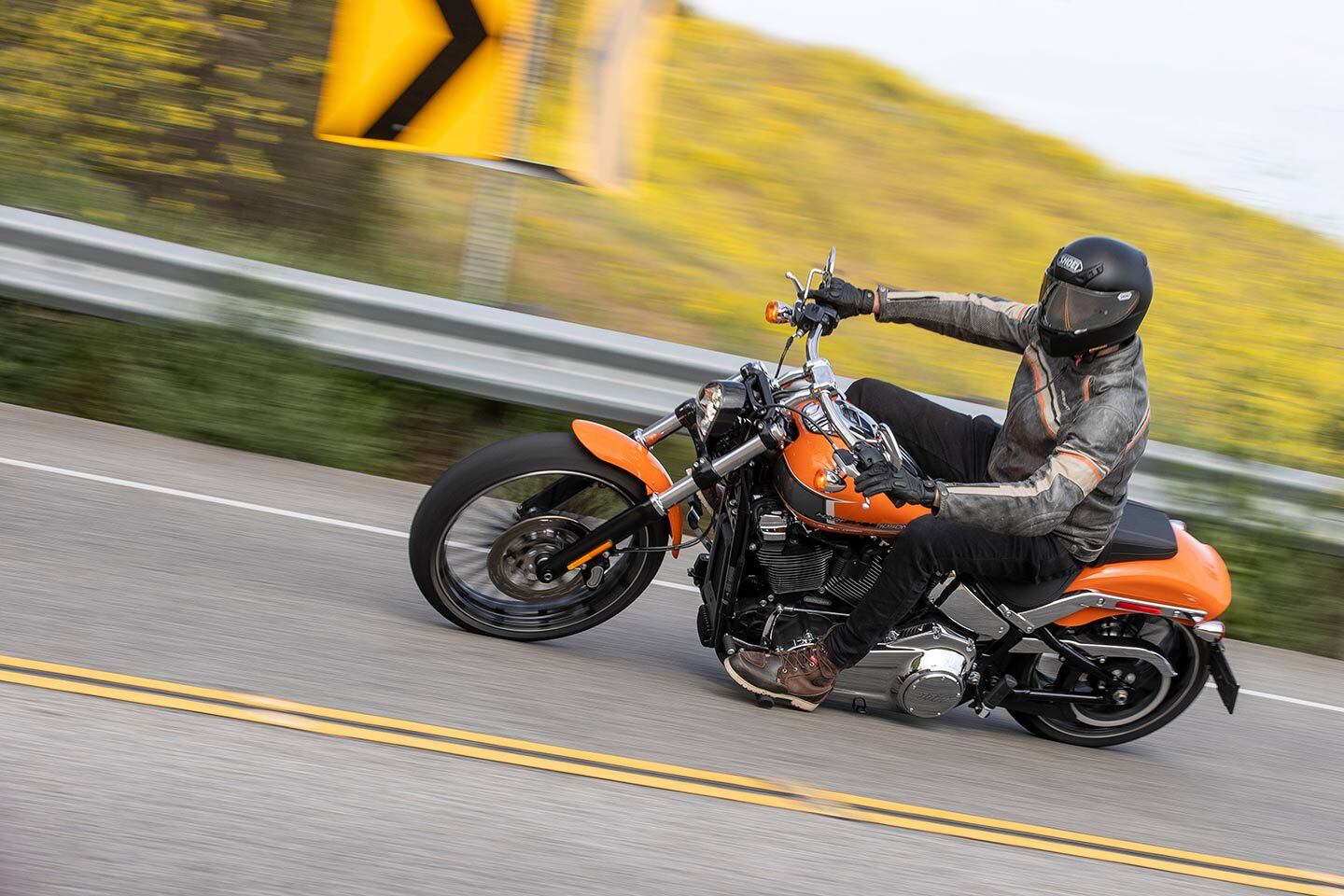
The Breakout definitely doesn’t snap into corners, but it does offer predictable handling that is easy to gauge. (Jeff Allen/)
Speaking of things that aren’t as they appear: One look at the stretched seating position—with feet thrown out front—makes one wonder if it could possibly be comfortable for more than 20 minutes. After spending a long day riding the Breakout around town and in the mountains we walked away surprised how fresh we felt. One of us, who is 5 feet, 11 inches, felt like the seat with its deep pocket offers really good back support, while the reach to the flat handlebar is quite relaxed. Our tall and lanky Bradley Adams (6 feet, 3 inches), however, reported that his long legs make his right appendage ram uncomfortably up against the air intake.
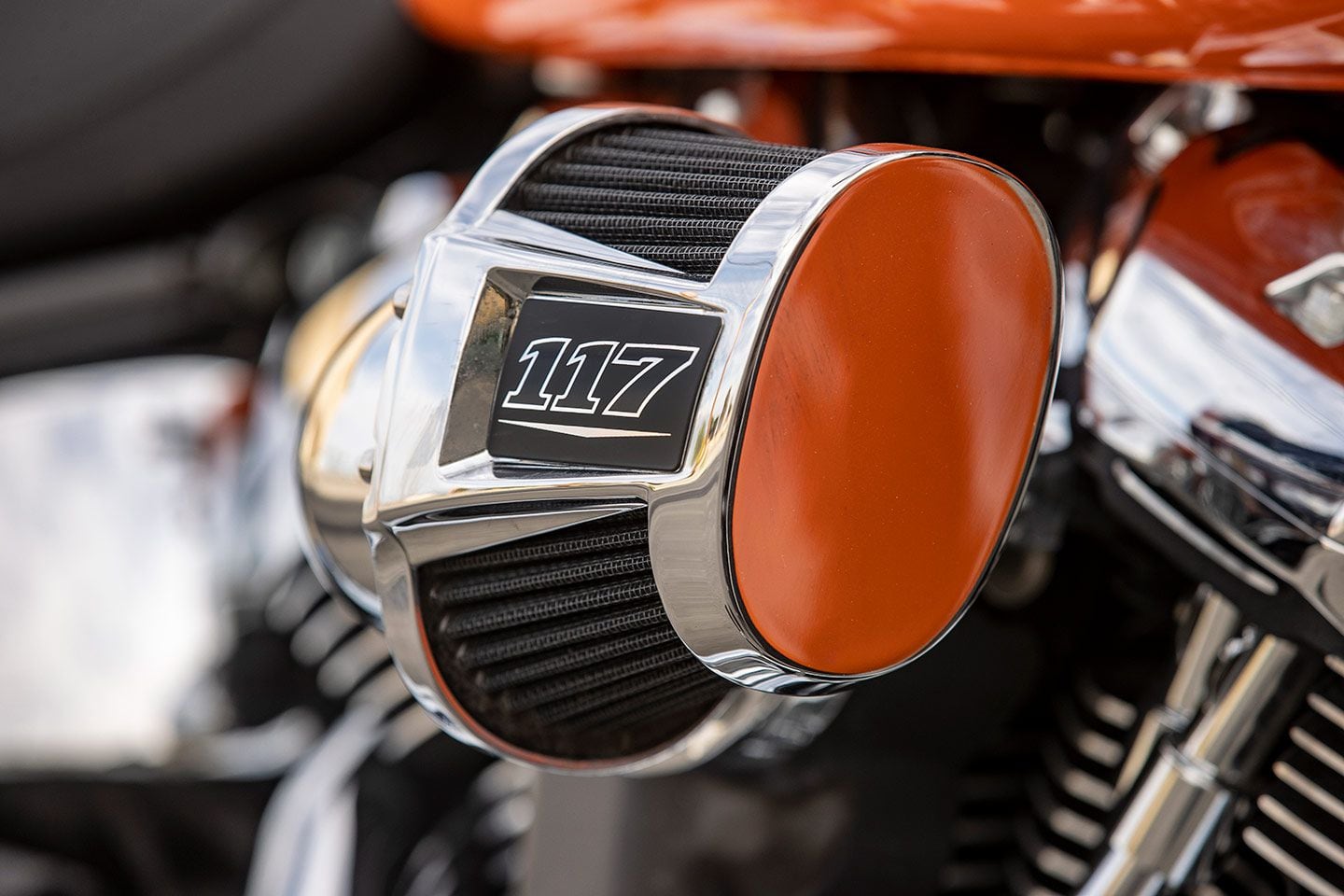
Despite a comfortable riding position, our tallest tester found his right knee interfering with the air intake. (Jeff Allen/)
While around-town handling feels heavy and requires some extra effort at the bars, the Breakout is very at home on big sweeping mountain corners. Rather than feeling like the rear tire is fighting you, it instead offers a ton of midcorner stability. Hairpins are another story and replicate the sluggishness of the urban setting, but when the road is a series of big sweepers, the Breakout is really fun. Since the bike likes to meander over onto the side of the tire instead of snapping from side to side, it’s easy to gauge that last bit of lean before the pegs start grinding into the asphalt. When it starts to grind it’s easy to pick it back up a touch and save your boot from the heel getting smoked off.
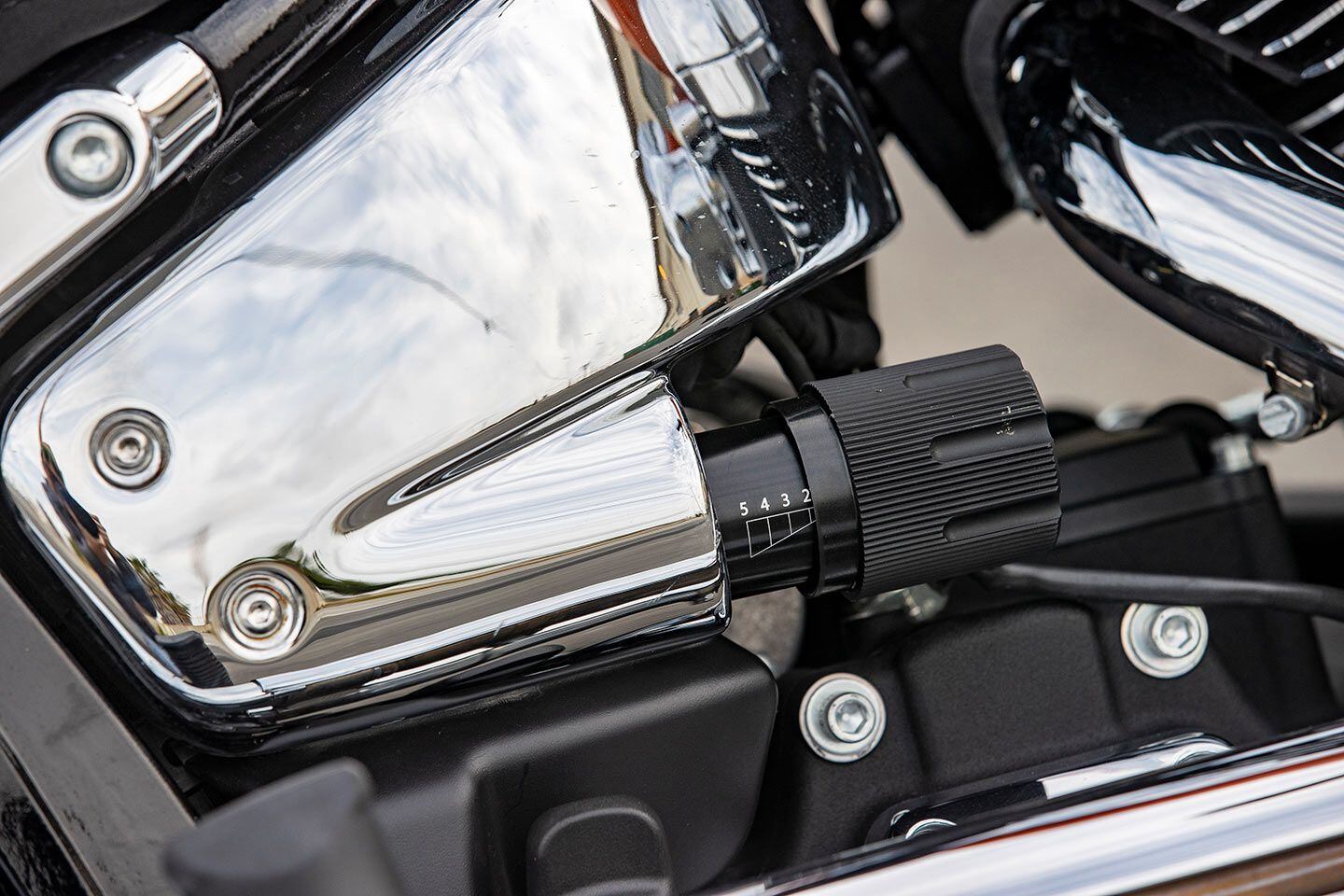
The hidden rear shock has provisions for spring-preload adjustability via this toolless adjuster. (Jeff Allen/)
Another area that the Breakout gets high marks is the suspension. With just 3.5 inches at the rear, you might wonder how the bike reacts over crappy pavement, but the combination of the softail rear end and the deep and plush seat make the ride quite comfortable. Our testing loop definitely served up plenty of bad pavement, but the long stable chassis and 5 inches of front-end travel kept the Breakout composed through the gnar.
Once comfortable with the bike’s handling and composure and a much quicker pace, it was nice to discover that that the single front brake was easily up to the task of getting the near-700-pound machine whoaed down. Feel at the lever isn’t in any way sportbike aggressive, but power is predictable and progressive.
Conclusion
Harley-Davidson’s Breakout 117 sucks you in with that long and low custom-cruiser stance, but the best news is the bike delivers on so many levels beyond its image. The Breakout is also a survivor, as it really doesn’t have any direct competition any longer. The only bike we can think of off the top of our heads is Honda’s Fury, but that bike is virtually a middleweight by comparison and more of a raked-out chopper-style machine.
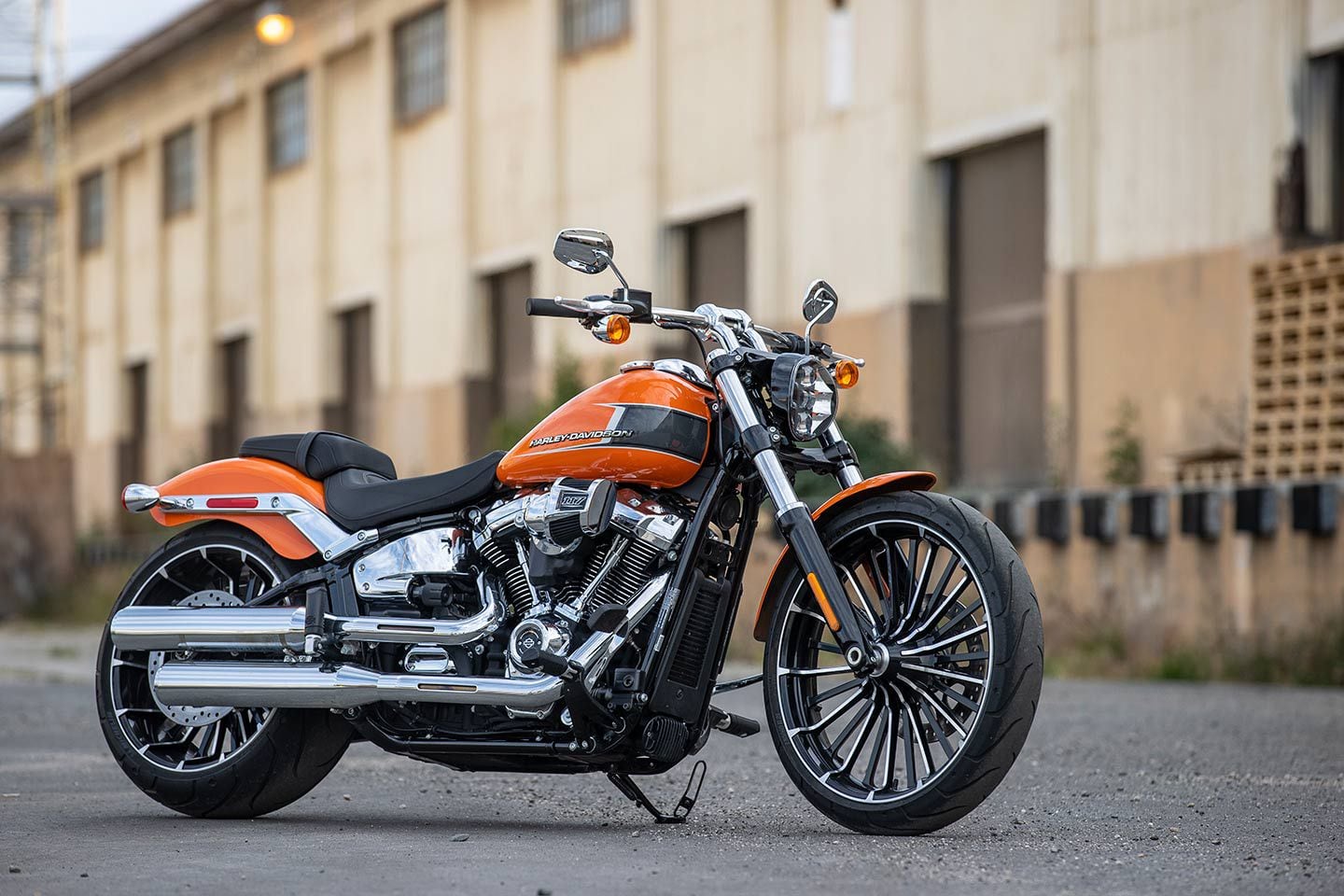
Packed with a lot of style, the Breakout still impressed with performance. (Jeff Allen/)
There is no denying that The Motor Company has this formula down pat, and although the Breakout and Fat Bob are the only two bikes in the lineup with a custom-cruiser profile, Harley-Davidson has delivered a style-heavy machine that performs in a manner that its competitors past and present have never been able to replicate. Function really does match form.
Yeah, the Breakout doesn’t have the broadest range of capability—you’re not likely going to go touring on it—but for what this bike was designed to do, it impresses. The Milwaukee-Eight 117 is awesome, making the Breakout a stoplight-drags hero, the cockpit and riding position are surprisingly comfortable, and there is no question that the over-the-top styling stands out in the sea of matte-black and muted colors that are so popular right now. In short, if you love the look, you’ll be stoked with the performance too.
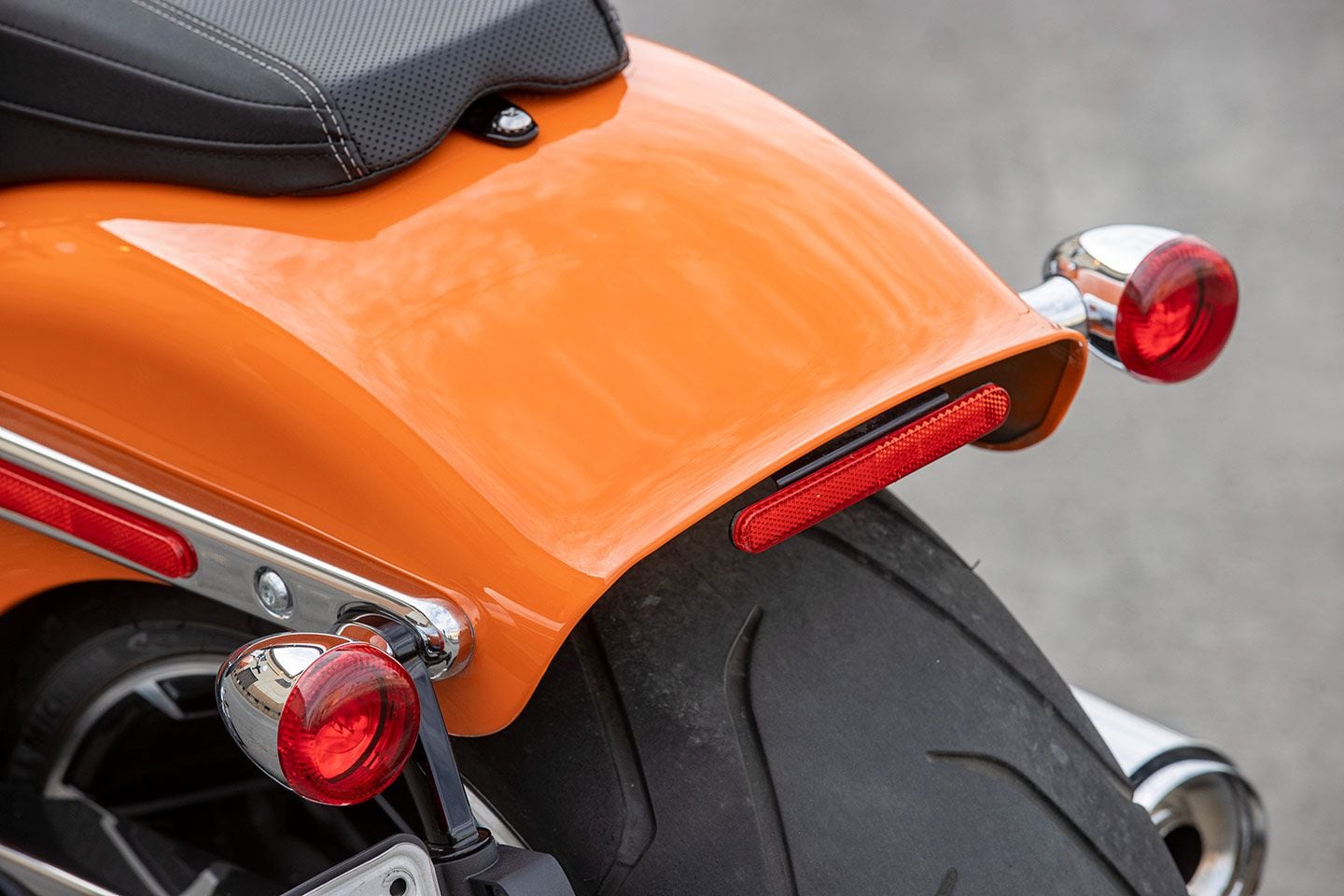
The clean bobbed rear fender features integrated turn signals and brake lights. (Jeff Allen/)
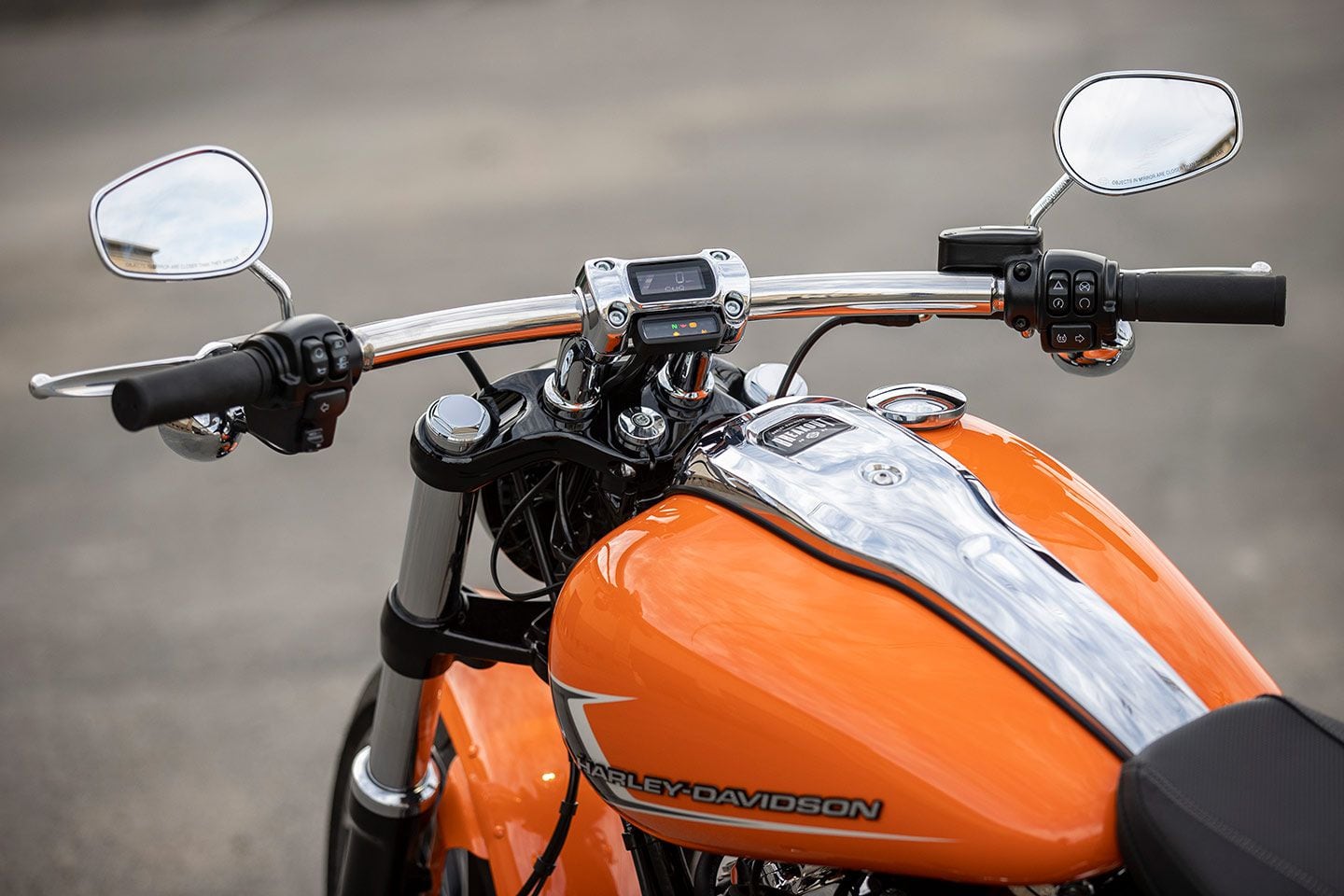
For 2023, the Breakout gets a 3/4-inch taller handlebar riser. (Jeff Allen/)
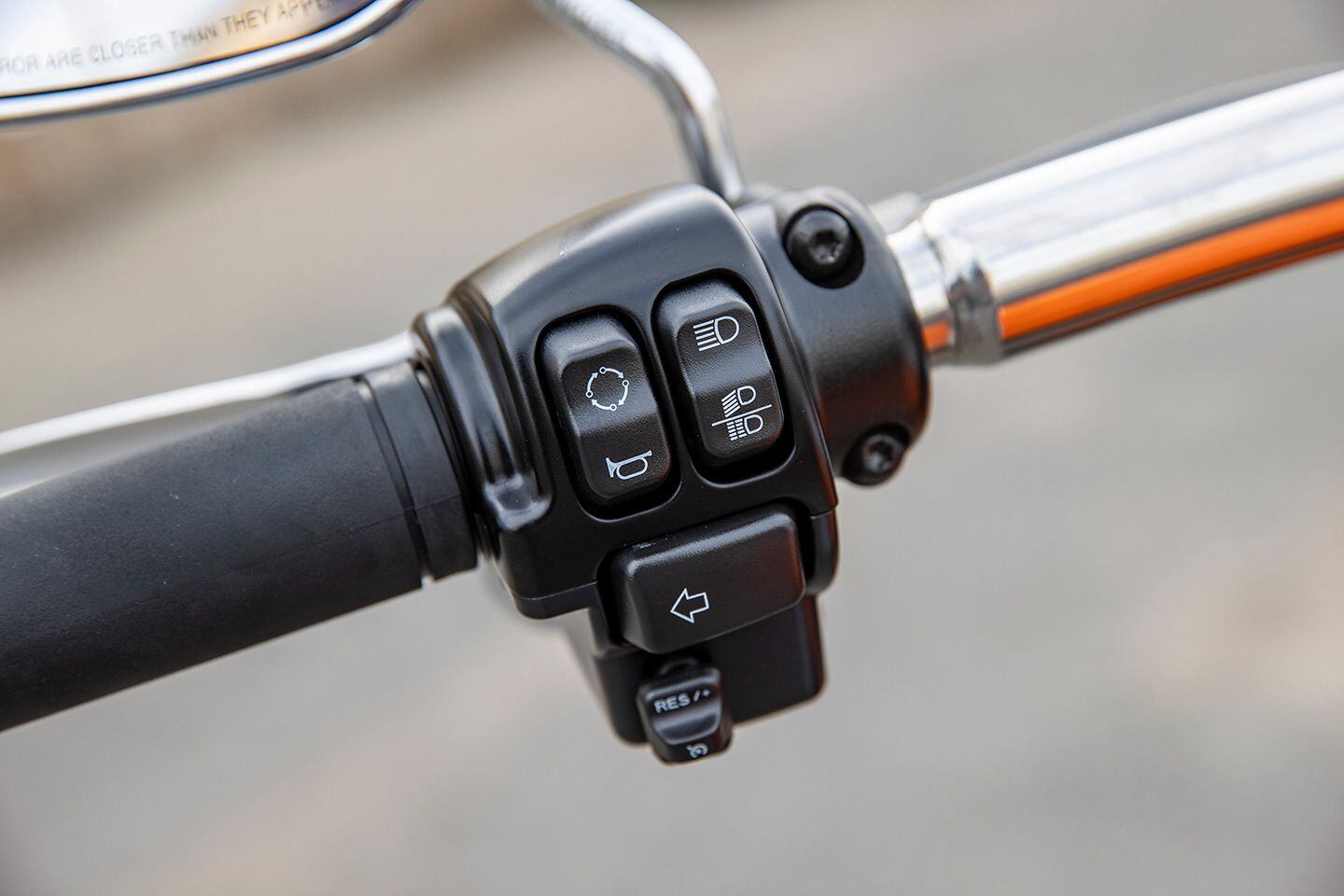
The left handlebar pod has cruise controls, info toggle, and the left-hand turn signal. (Jeff Allen/)
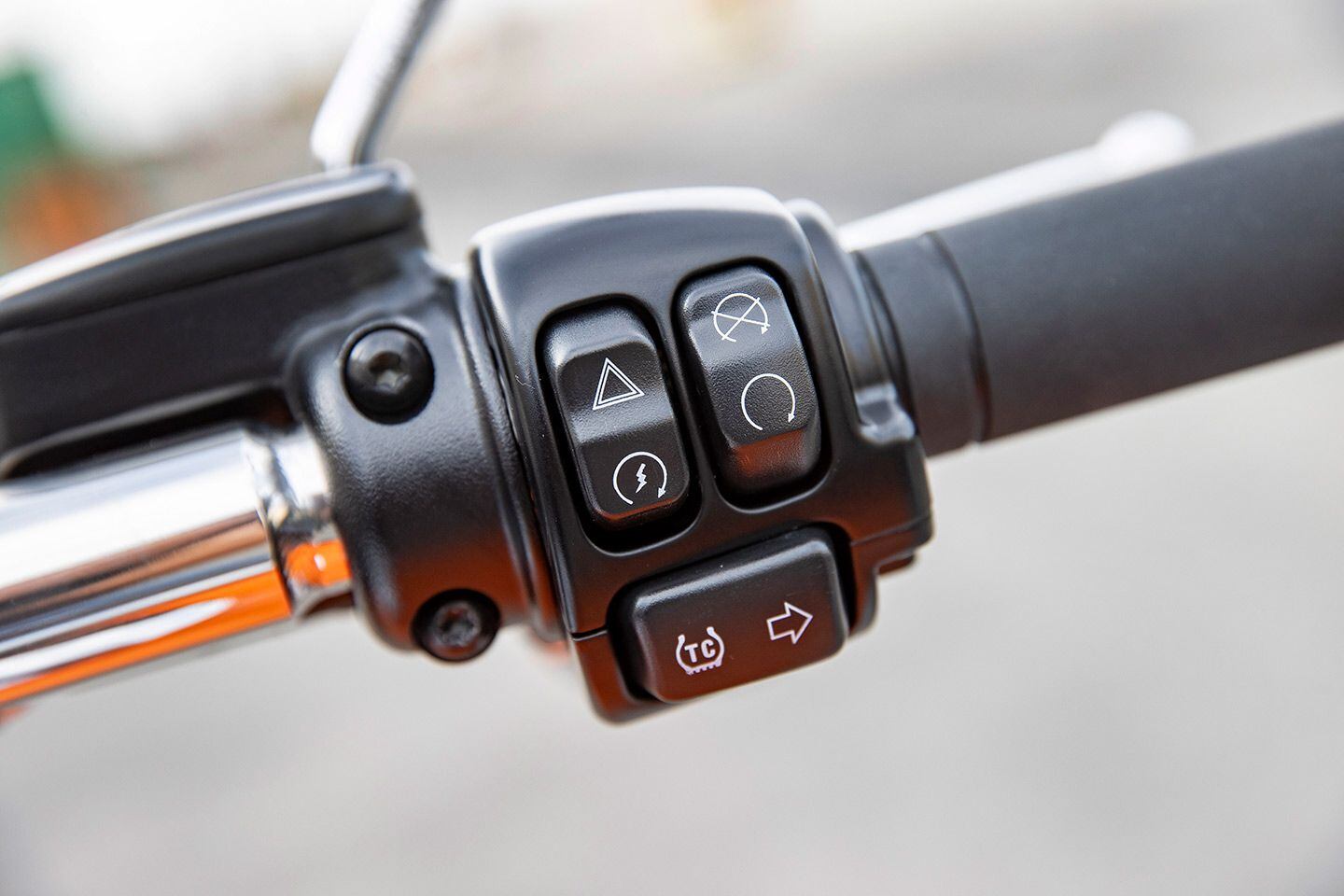
The right handlebar pod features the control toggle for the optional traction control that our bike was fitted with. (Jeff Allen/)
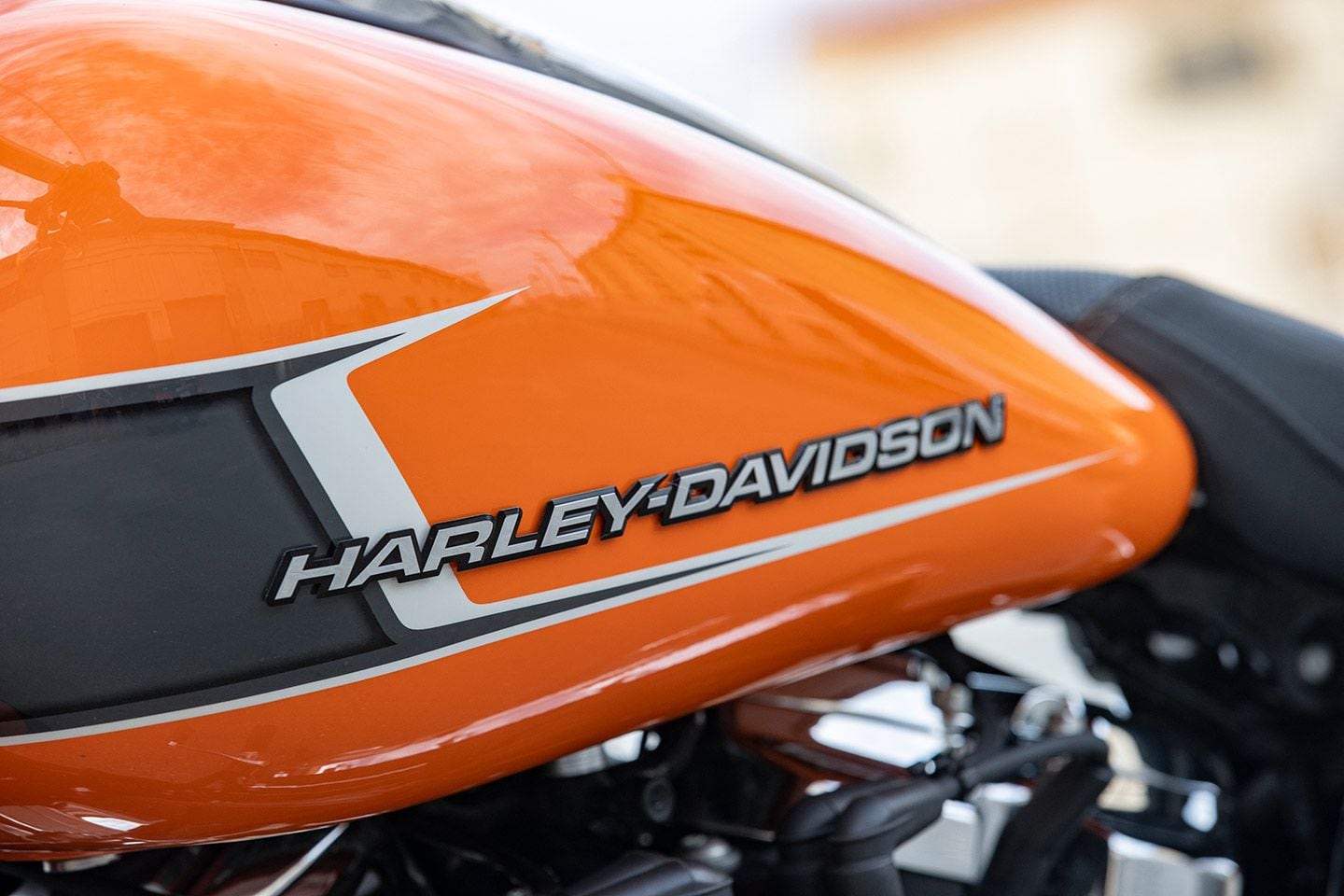
Fuel capacity has increased from 3.5 gallons to 5, providing an average range of around 200 miles. (Jeff Allen/)
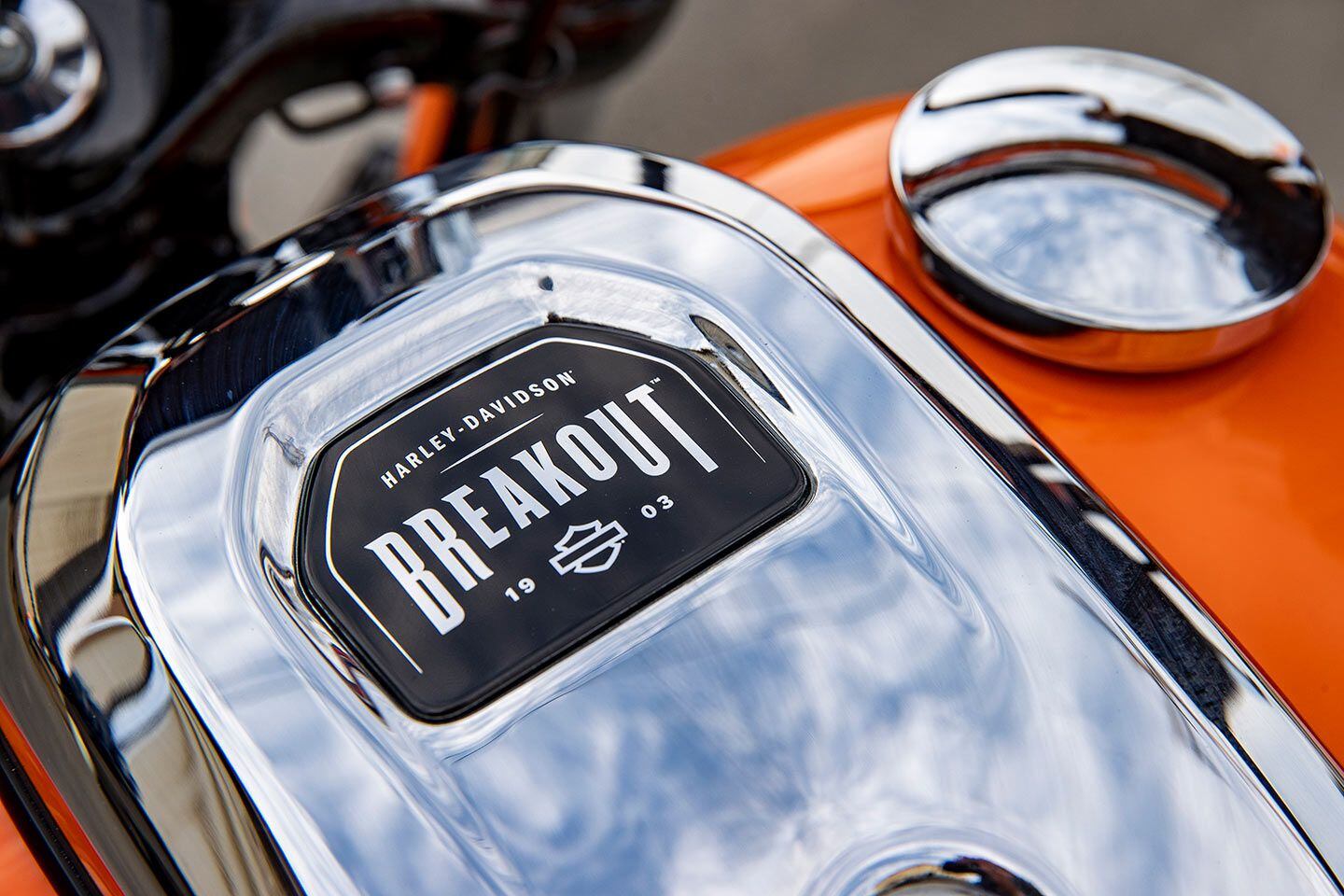
The Breakout is back and better than ever. (Jeff Allen/)
2023 Harley-Davidson Breakout 117 Specs
| MSRP: | $21,724 (as tested) |
|---|---|
| Engine: | Pushrod-operated, 45-degree V-twin; 4 valves/cyl. |
| Displacement: | 1,923cc |
| Bore x Stroke: | 103.5 x 114.0mm |
| Compression Ratio: | 10.2:1 |
| Transmission/Final Drive: | 6-speed/belt |
| Cycle World Measured Horsepower: | 94.2 hp @ 4,790 rpm |
| Cycle World Measured Torque: | 118.0 lb.-ft. @ 3,250 rpm |
| Fuel System: | Electronic Sequential Port Fuel Injection |
| Clutch: | Wet, multiplate w/ assist |
| Engine Management/Ignition: | Electronic |
| Frame: | Steel backbone |
| Front Suspension: | 49mm telescopic fork; 5.0 in. travel |
| Rear Suspension: | Single shock, preload adjustable; 3.5 in. travel |
| Front Brake: | 4-piston caliper, 300mm disc w/ ABS |
| Rear Brake: | 2-piston caliper, 292mm disc w/ ABS |
| Wheels, Front/Rear: | 21 x 3.5 in. / 18 x 8.0 in. |
| Tires, Front/Rear: | Michelin Scorcher 11; 130/60-21 / 240/40-18 |
| Rake/Trail: | 34.0°/5.7 in. |
| Wheelbase: | 66.7 in. |
| Ground Clearance: | 4.5 in. |
| Seat Height: | 26.2 in. |
| Fuel Capacity: | 5.0 gal. |
| Average MPG: | 41.5 mpg |
| Cycle World Measured Wet Weight: | 682 lb. |
| Contact: | harley-davidson.com |
GEARBOX
Helmet: Shoei RF-SR
Jacket: AGV Sport Palomar
Pant: Rev’It Jackson 2 SK
Gloves: Alpinestars Crazy Eight
Boots: Sidi Arcadia
]]>Derek Osner of Crossroad Powersports expert road racer with son Damien. Three generations of Osners have high-level racing on their resumes. (Courtesy of Crossroad Powersports/)
Not everyone can turn a passion for riding into a successful business, but after 26 years, Crossroad Powersports is still racing ahead. Located outside of Philadelphia, this dealership is more than a motorcycle shop. This family of former professional racers supports its customers and community with racer and track sponsorships, as well as rider training, doing what they love, every day.
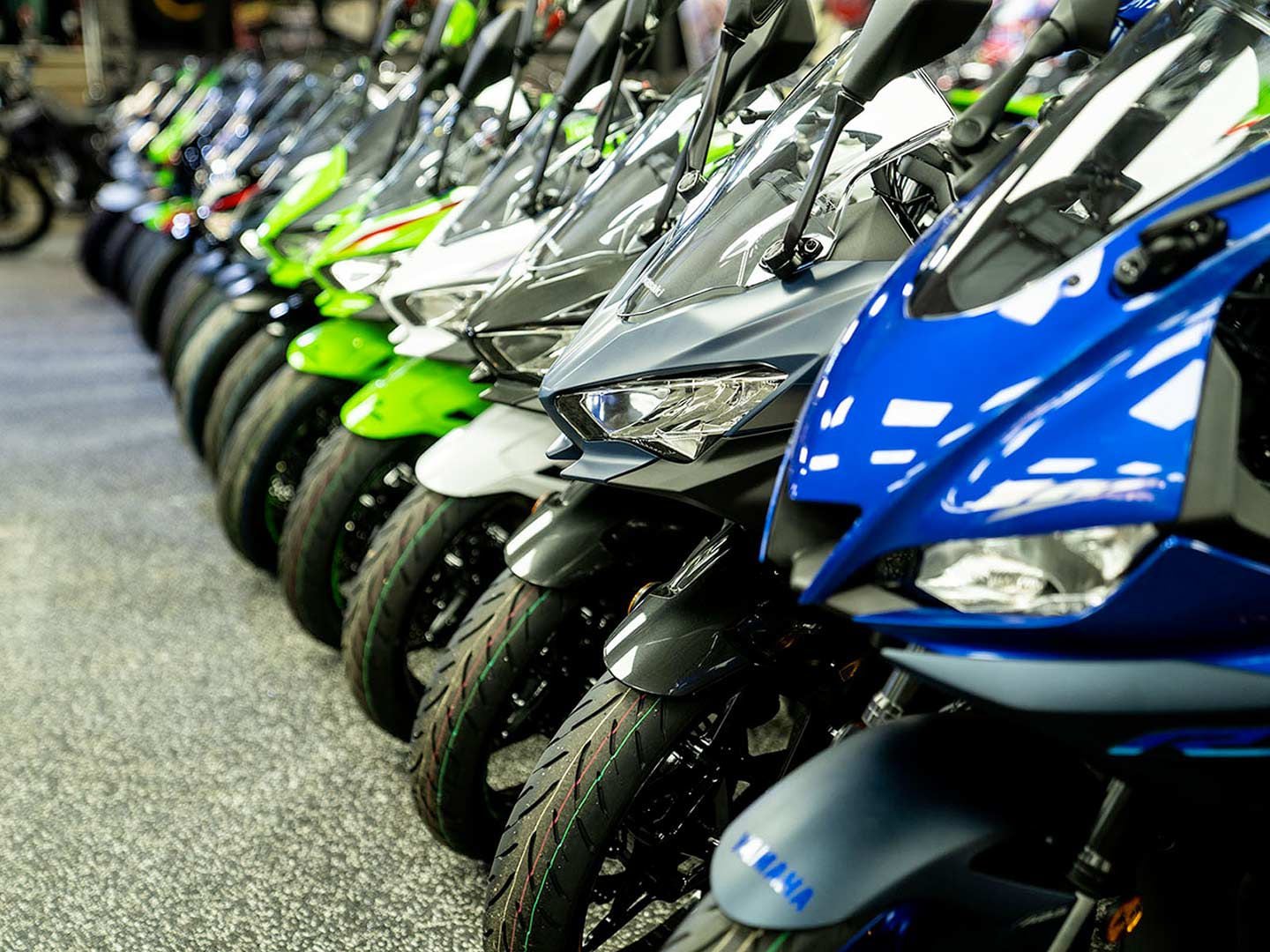
Crossroad Powersports in a multiline dealership carrying motorcycles, off-road vehicles, watercraft and more. The team emphasizes rider training and skill building that stems from the combined decades of racing experience by the Osner family, principals of the dealership. (Courtesy of Crossroad Powersports/)
We spoke to Eric Osner, owner of Crossroad Powersports, about building his business on a foundation of riding and racing. Osner raced professional motocross on the East Coast in the 1970s. His love for competition began by sitting on his first motorcycle at 13. After a quick lesson on shifting gears from his friend’s dad, Eric became unstoppable on a Honda CT-70.
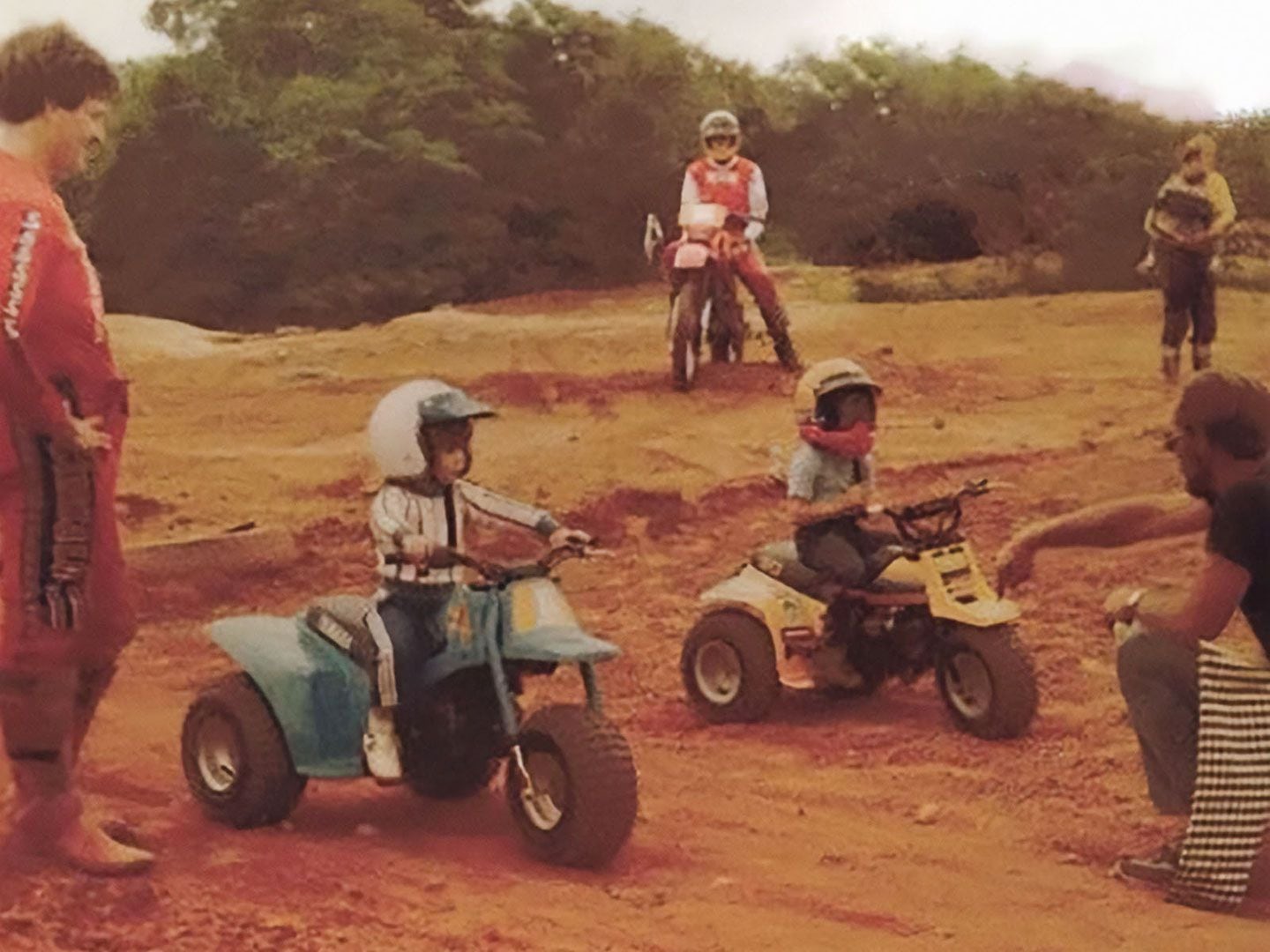
Eric Osner (left) with friends and a young Mariel tearing it up on the track in the 1970s on three-wheelers. (Courtesy of Crossroad Powersports/)
“I had my first race at 15,” Osner recalls. “My heart was pounding out of my chest, I was so nervous. But after that I was hooked.” Eric graduated from a Kawasaki 175, to racing for Montesa on a Capra 250 and 360 starting in 1977. He raced as an expert for a couple years before getting his pro license.
Osner raced pro for three years until the birth of his first child, and after that he instilled his love for racing in both of his kids. “Both of my kids raced motocross,” Osner says. “My daughter Mariel made it all the way to the Loretta Lynn Amateur National Championships, and then at 16 began drag racing professionally. And my son Derek became an expert road racer.”
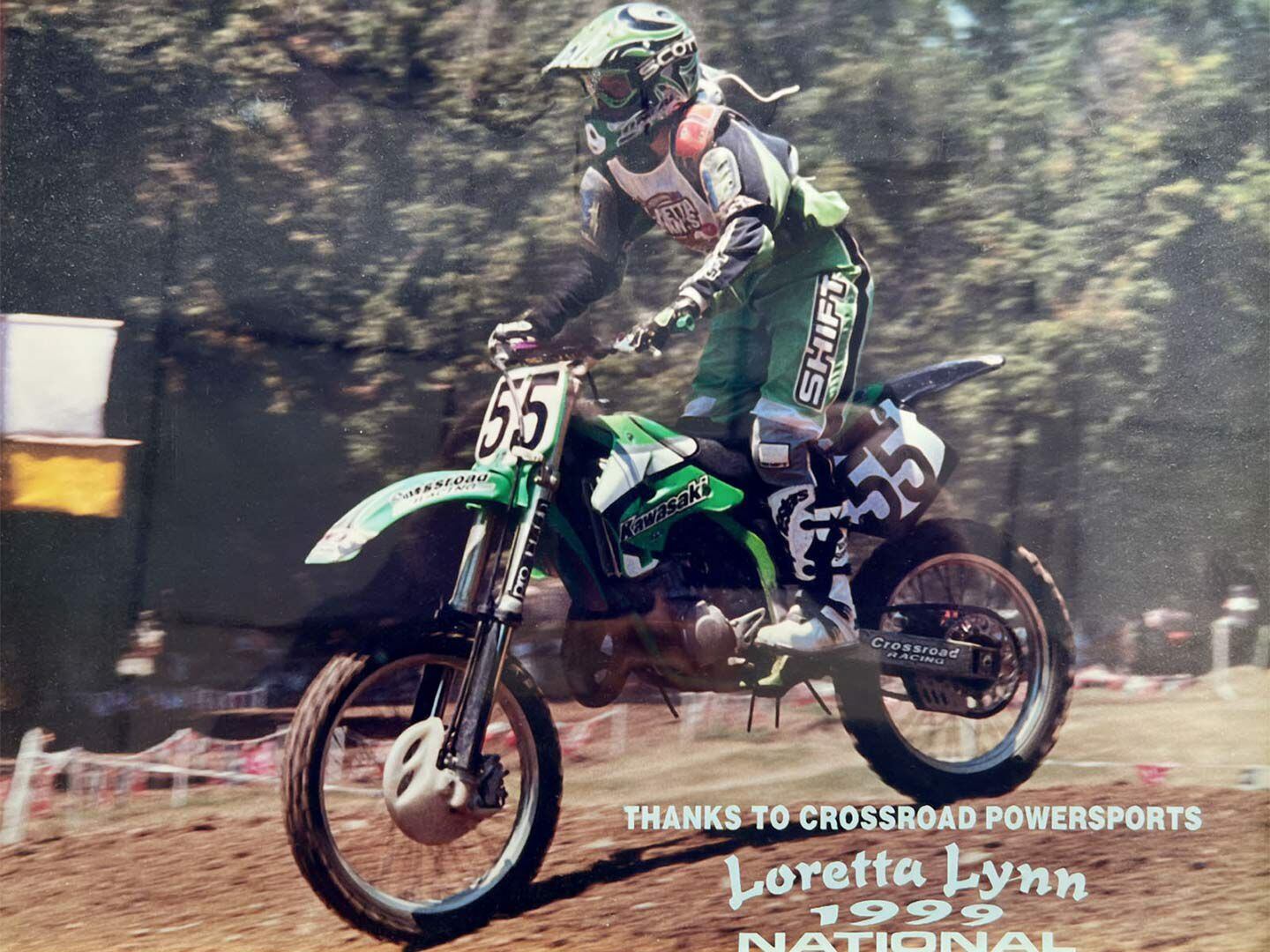
Mariel Osner at the Loretta Lynn 1999 amateur national motocross championships. (Courtesy of Crossroad Powersports/)
In 1997, Eric Osner got the opportunity to take his passion for racing and turn it into a business. “I always said that if I ever had the opportunity, I’d open up a motorcycle shop,” Osner says. “I knew nothing about the business, other than knowing how to ride a bike. After a year and a half of learning on the job, it really took off. Every time we reach a level I’m always ready to hit the next one—small steps but always moving forward.”
Twenty six years later, Crossroad keeps in touch with the racing and riding community by sponsoring two local tracks, and is a key sponsor for professional motocross racer Greg Pamart and his riding school GPMX. Coming from a racing background, the Osners know that the greater competency and skill a rider has, the more they will enjoy and share the sport.
To that end, Crossroad Powersports relationship with Pamart and his motocross school dates back more than 20 years. Riding safety is always a priority for the Osner family, and nearly every customer who buys a bike at the shop is referred to the GPMX school for basic instruction informed by Motorcycle Safety Foundation guidelines. “People need to know how to ride,” said Eric, “They need to know how to turn and jump. Eventually the training wheels come off and riding becomes second nature with the right fundamentals.”
Even Eric Osner’s own grandson, Damien, learned how to ride at GPMX. Damien is the third generation of riders in the family and has become a motocross rider in his own right at just 13 years old—the same age his grandfather began riding.
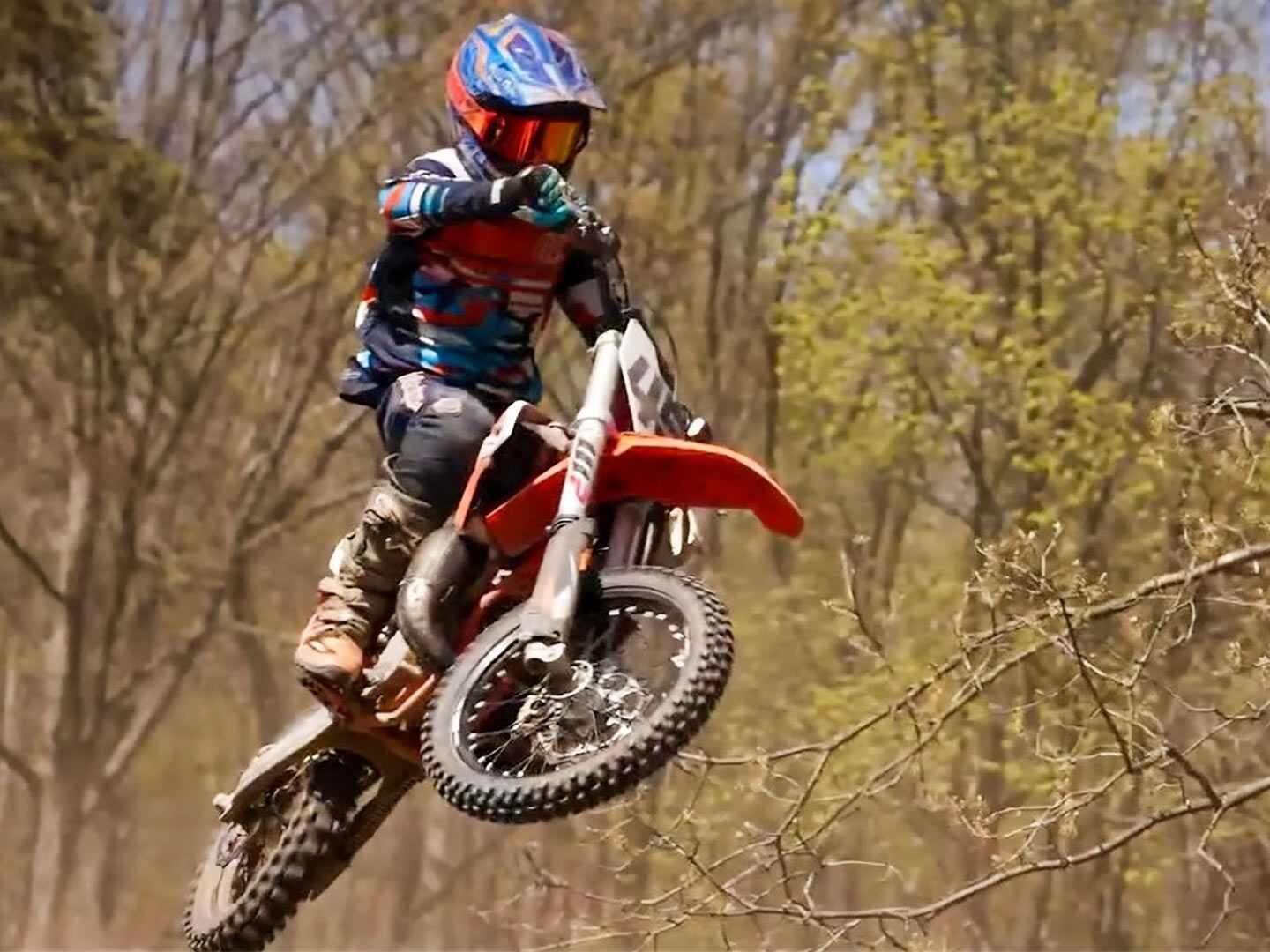
Damien, the third generation of Osners to race motocross. (Courtesy of Crossroad Powersports/)
With a team of pro racers around the shop, Crossroad Powersports has made its mark as a shop for enthusiasts, by enthusiasts. “Our core business model is taking care of the customer first,” said Osner. The team at Crossroad, including The Osners and GM Karen Stankiewicz, can connect riders with opportunities to jump headfirst into the sport. In the words of Eric Osner, “Come visit us, enjoy the experience, and have a great time!”
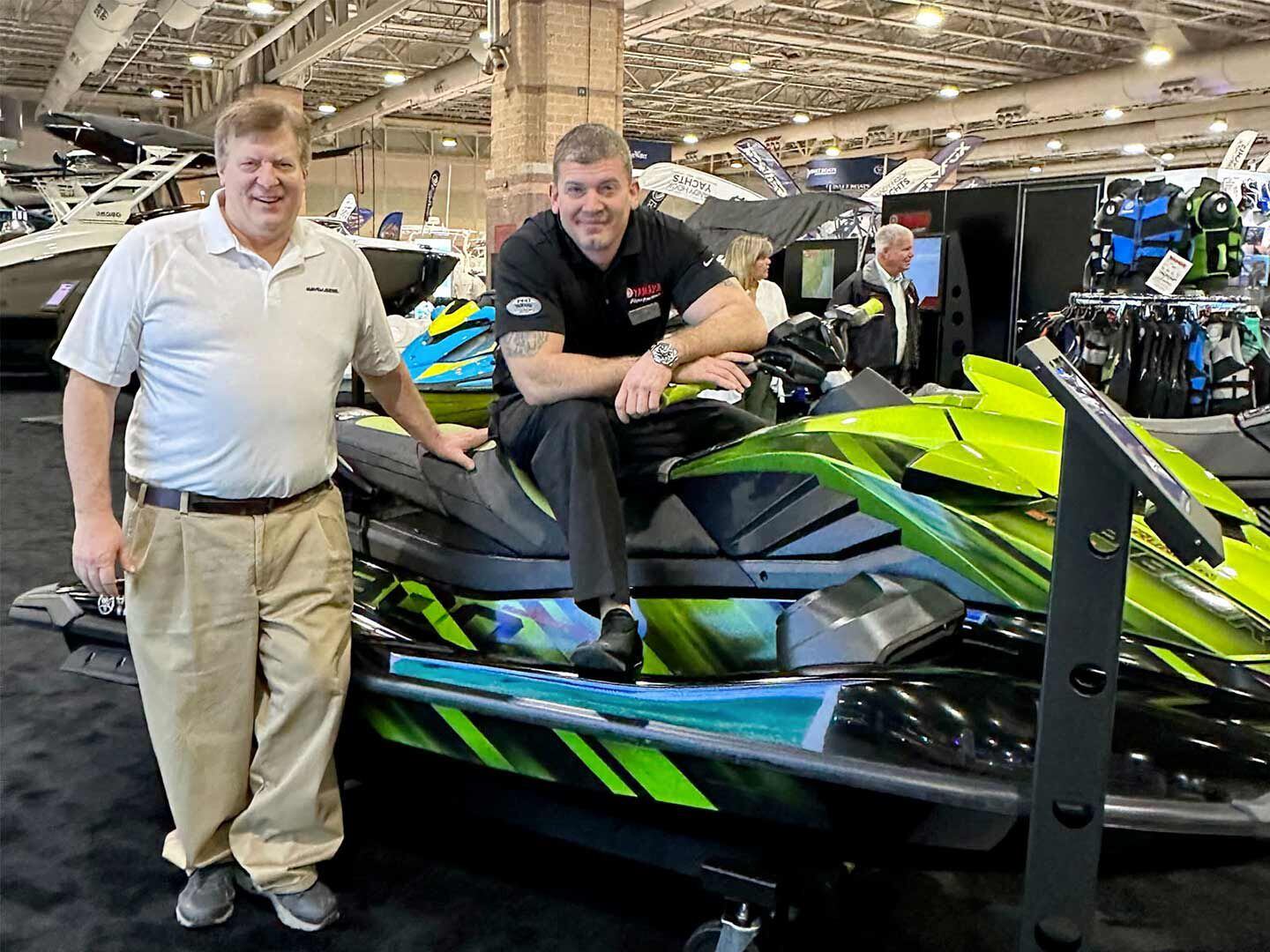
It’s not just wheeled machines at Crossroad Powersports and Eric (left) and Derek Osner show here. The dealership carries 12 brands. (Courtesy of Crossroad Powersports/) ]]>
Harley has just confirmed its new 2023 CVO Street Glide. The bike gets revised bodywork, a new VVT 121ci engine, new suspension, and more. (Harley-Davidson/)
The Motor Company may have released a good chunk of its 2023 model portfolio already in anticipation of its upcoming 120th anniversary, but we just got wind of a new development from Milwaukee’s high-end Custom Vehicle Operations unit. The rumor mill has been churning out reports of a new touring model coming soon, and now Harley-Davidson has confirmed it, with the introduction of the all-new 2023 CVO Street Glide and CVO Road Glide.
According to H-D, both bikes see “dramatic new visual designs, advanced technology, and dynamic performance” but what that really translates into is a reworked batwing fairing for the Street Glide, a restyled frame-mounted fairing for the Road Glide, and new wheels and suspension for both, as well as updates to the tourers’ infotainment system. But the key upgrade here most of us will focus on is the inclusion of the new Milwaukee-Eight VVT 121 engine we speculated about earlier, and which both CVO models receive.
Related: 2024 Harley-Davidson CVO Street Glide 121 Revealed
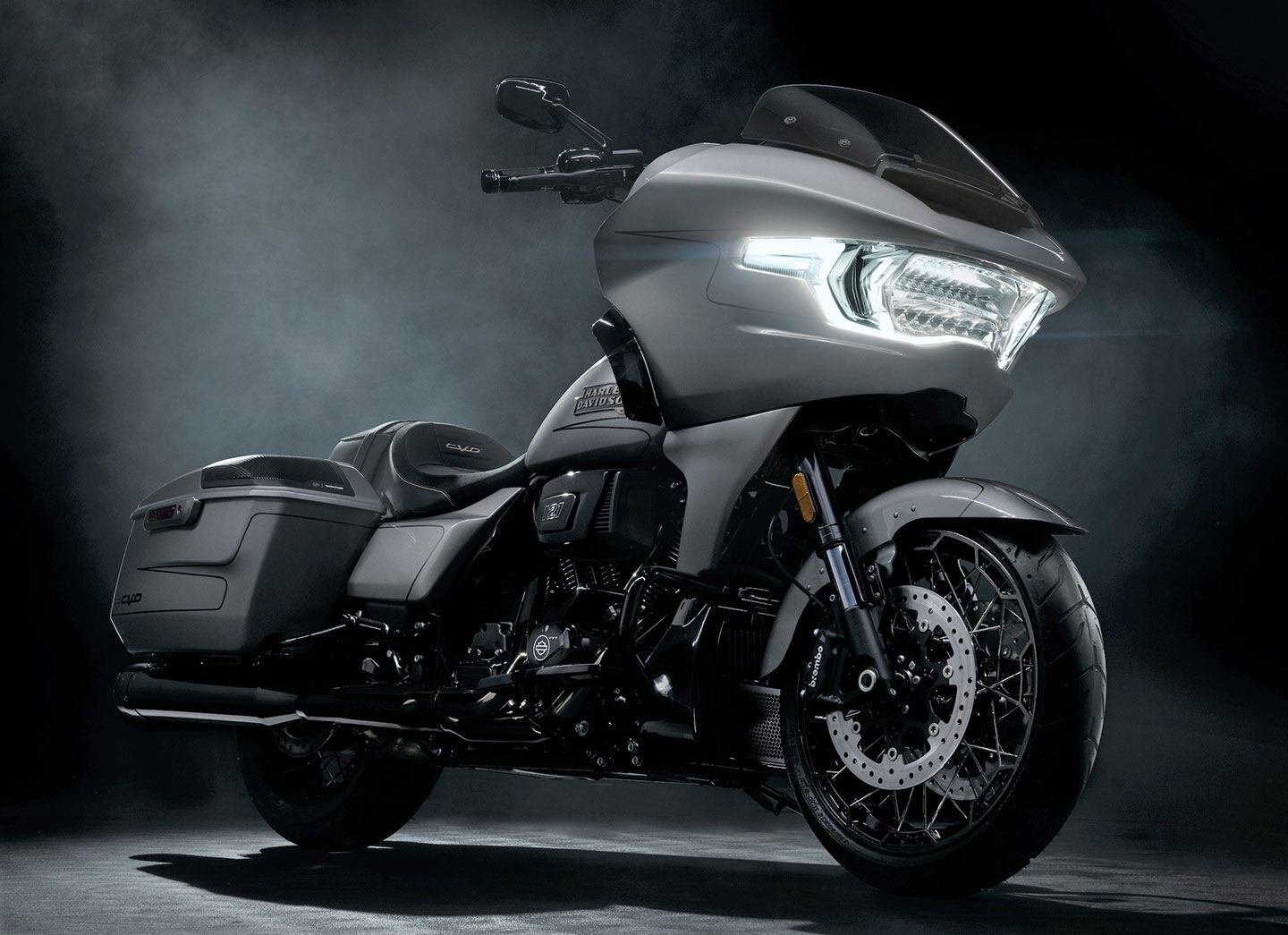
Also introduced was the new 2023 CVO Road Glide, which likewise gets new bodywork and the same mechanical upgrades as the CVO Street Glide. (Harley-Davidson/)
2023 Harley-Davidson CVO Street Glide
Although the bodywork’s been tweaked on both models, it’s not like you won’t recognize the resemblance to previous Glides. On the CVO Street Glide, the visual changes start with a flatter, reworked batwing fairing, which retains its iconic “T” shape, but gets a modernized silhouette with updated surfaces. Most notable is the squarer “Omega-shaped” headlight at center (rather than the current Street Glide’s round unit) that’s also recessed farther back into the fairing. The new fairing more completely frames the square multi-LED unit with a lower edge that’s now angled forward, and the windscreen itself looks to be seriously revised too, so we can expect different aerodynamic qualities as well.
Running lights—in long, horizontal strips, like eyebrows—also run along the forward-facing part of the fairing, while turn signal elements are integrated into the left and right headlamp as well (cleaning up the older model’s external “bullet” units). The resulting profile looks to achieve a better design flow with the side covers and saddlebags, which also see subtle profile tweaks. About the new design, says Brad Richards, Harley-Davidson vice president of design and creative director: “These all-new…designs bring a cohesive and dynamic flow from the front fenders to the saddlebags.”
Lower down, we see a sharper new front-fender design floating over a new wheel that blends wire spokes with an alloy rim (similar to the existing Combo Cast wheel available as a CVO accessory). That front wheel sits at the end of an inverted fork (part of the “new suspension”) and also gets a pair of large, floating brake discs clamped by four-piston Brembo calipers, appropriate for a bike in H-D’s premium CVO range, and a system that will no doubt trickle down to the main line at some point.
The big news here, though, is the appearance of H-D’s new VVT 121 mill powering both of the new 2023 CVO Glides. The 121ci displacement (equivalent to around 1,983cc) is clearly trumpeted on the intake and clutch cover badging, with the variable valve timing system giving the air-cooled Milwaukee-Eight a new lifeline in the fight against tightening emissions limits. Other than those external cues however, Harley has kept mum on other powertrain details.
Related: 2023 Harley Homecoming Celebrates Motor Company’s 120th Anniversary
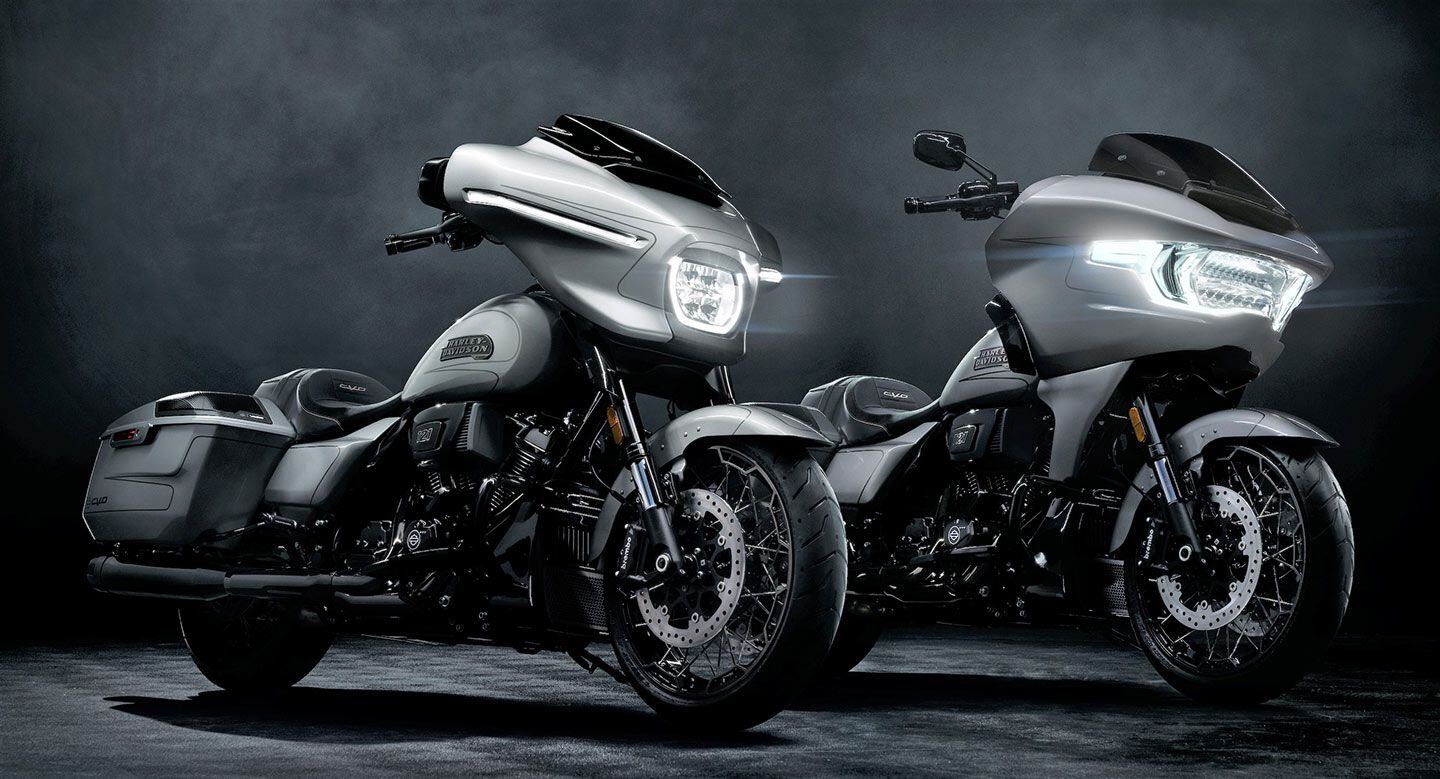
Both the CVO Street Glide and CVO Road Glide will be offered in two color options; no other details have been revealed yet. The official launch for both will be June 7, 2023. (Harley-Davidson/)
2023 Harley-Davidson CVO Road Glide
Like the 2023 CVO Street Glide, the 2023 CVO Road Glide also touts an “all-new” status, and it gets a more aggressive update to its signature sharknose design. Both the upper part of the fairing—which juts out far more forward—and the lower portion receive new shapes, and aim for a better integration with the fuel tank, side covers, and saddlebags.
The single LED headlamp now has a wide, horizontal shape, but in a bit of a design sleight of hand, appears to also have twin elements, which H-D says is a nod back to previous “twin-beam” Road Glide models. On the CVO Road Glide, the turn signal lamps are also integrated within the outer portions of the signature light, and the fairing-mounted running lights, as on the Street Glide, extend all the way out to the edges of the fairing, though on the Road Glide, the look is more of a smirk than the surprised expression on the CVO Street Glide.
The same updated infotainment, suspension, brakes, and wheels we mentioned on the CVO Street Glide also appear on the 2023 CVO Road Glide, as does the new VVT 121 engine. Both models will be available in two paint/finish options, but again, we don’t have the full details on those yet.
We can only speculate on other tweaks on the new models (as we did here), such as to the inner fairings, fuel tanks (which appears to be reshaped), and rear of the bikes, since no other images were included with this release. There was also no further information on the infotainment system updates, though we suspect it will surely include a new digital display to replace the aging analog dials on previous models.
Related: Harley Developing V-Twin With Variable Valve Timing
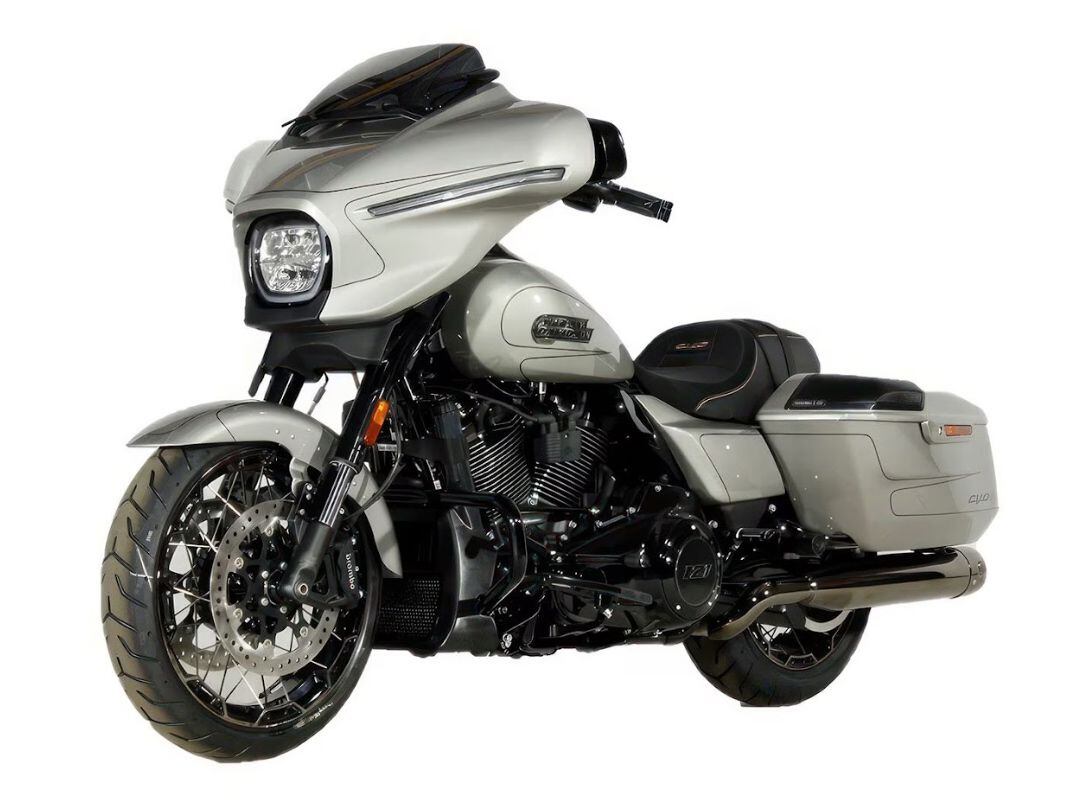
The next-gen CVO Street Glide as seen from the left side, in this Australia certification image. (Harley-Davidson/)
“With the introduction of the all-new CVO Street Glide and CVO Road Glide, we’ve completely reimagined two of Harley-Davidson’s most iconic motorcycles and redefined the boundaries of CVO in the process,” said Jochen Zeitz, chairman, president, and CEO of Harley-Davidson.
The not-so-good news? The bikes aren’t here yet, which is why H-D used the word “announced” rather than “revealed” in the press release. Other than the highlights you just read about, there were no real specifications, pricing, or additional images provided, with Milwaukee saying only that full details will be announced on June 7, 2023, with the actual, official unveiling of the 2023 CVO Street Glide and CVO Road Glide.
]]>Certification filings from Down Under have revealed the 2024 Harley-Davidson CVO Street Glide, powered by a brand-new 121ci engine with variable valve timing. (Harley-Davidson/)
Harley-Davidson’s upcoming CVO Street Glide 121 has yet to be officially confirmed by the factory, but it’s been the subject of huge amounts of internet intrigue already this year. Now, these genuine photos of the bike have emerged via new certification filings in Australia.
The shots (which we’ve digitally enhanced for more clarity) show a machine that’s both instantly recognizable as a Street Glide but also distinctly new compared to its predecessor. The visual changes start with that substantially reworked batwing fairing, which now houses a squared-off “squircle-shaped” LED headlight instead of the current Street Glide’s round design. It sits in a suitably reshaped recess, while the fairing’s lower edge now juts forward to give a more modern, aerodynamic look.
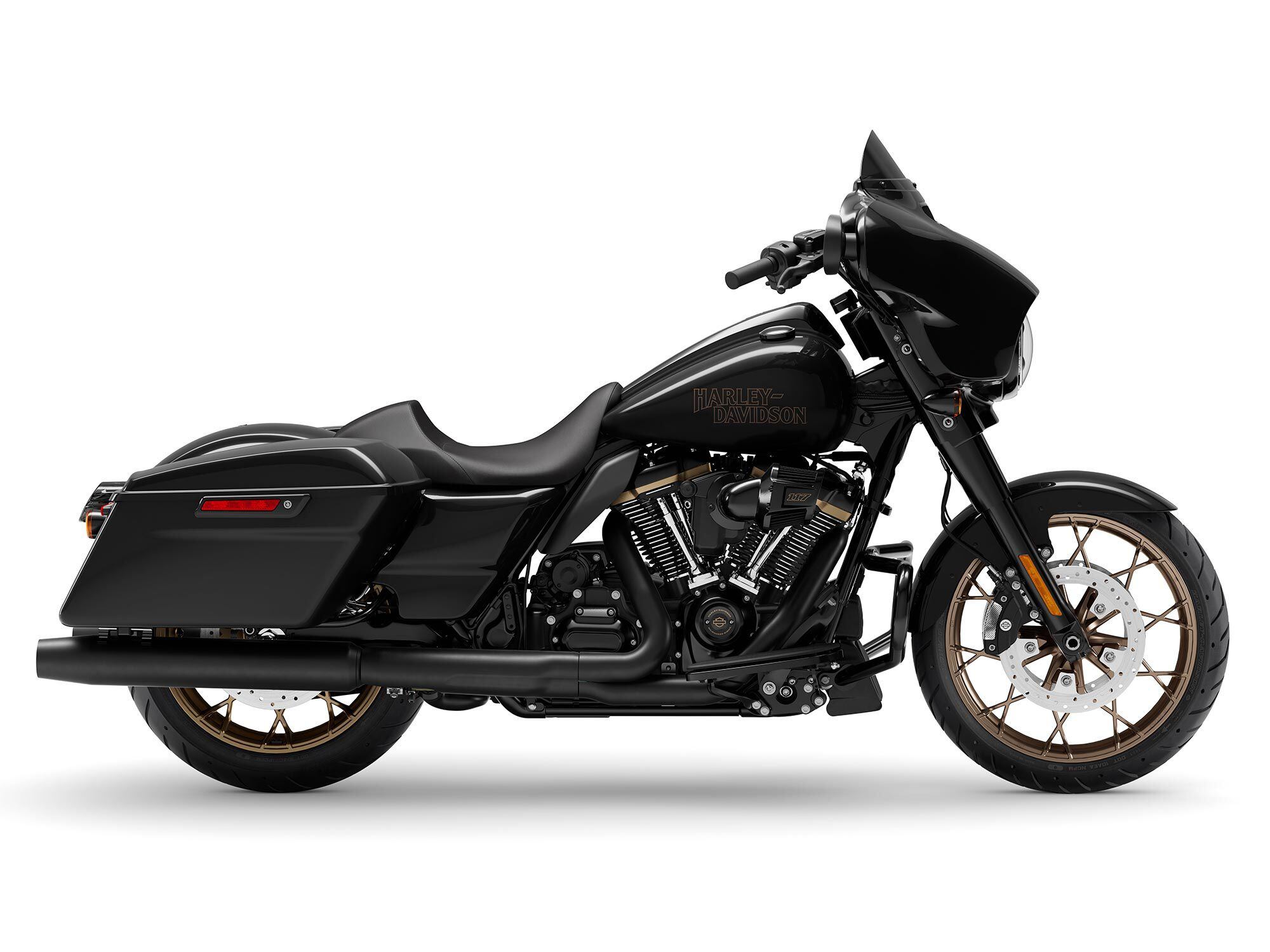
The current-generation Street Glide ST. (Harley-Davidson/)
As well as containing multiple LEDs for its high and low beams, the new light is rimmed with accent lighting and flanked by long strips of LED running lights extending all the way into the mirror housings at the very edge of the fairing. Below it, there’s a new front-fender design wrapped over an innovative wheel that combines traditional-style wire spokes with a cast or forged alloy rim that has raised sections where it meets the spokes, similar in concept to BMW’s Cross Spoke wheels on the R 1250 GS, but more stylish.
A pair of large, floating brake discs, more like those seen on sportbikes, are gripped by radial-mount, four-piston Brembo calipers. This is all revolutionary stuff for a Harley tourer, and while the initial model is part of the high-end CVO range—carrying the FLHXSE model code and wearing CVO badges on the side cases—it’s sure to filter down to the more mainstream bikes sooner than later.
Moving farther back, the rest of the bodywork is also new. The tank appears to be subtly reshaped, particularly around the lower front edges, and sits ahead of a thickly padded seat, embroidered with the CVO logo and contrasting stitching. The side panels below it aren’t as deep as the current design, making for a lighter appearance to the rear end, despite the fact the side cases appear to be bigger. Those cases are topped with speakers, with another pair visible inside the fairing as part of a high-end Boom! Box GTS audio system.
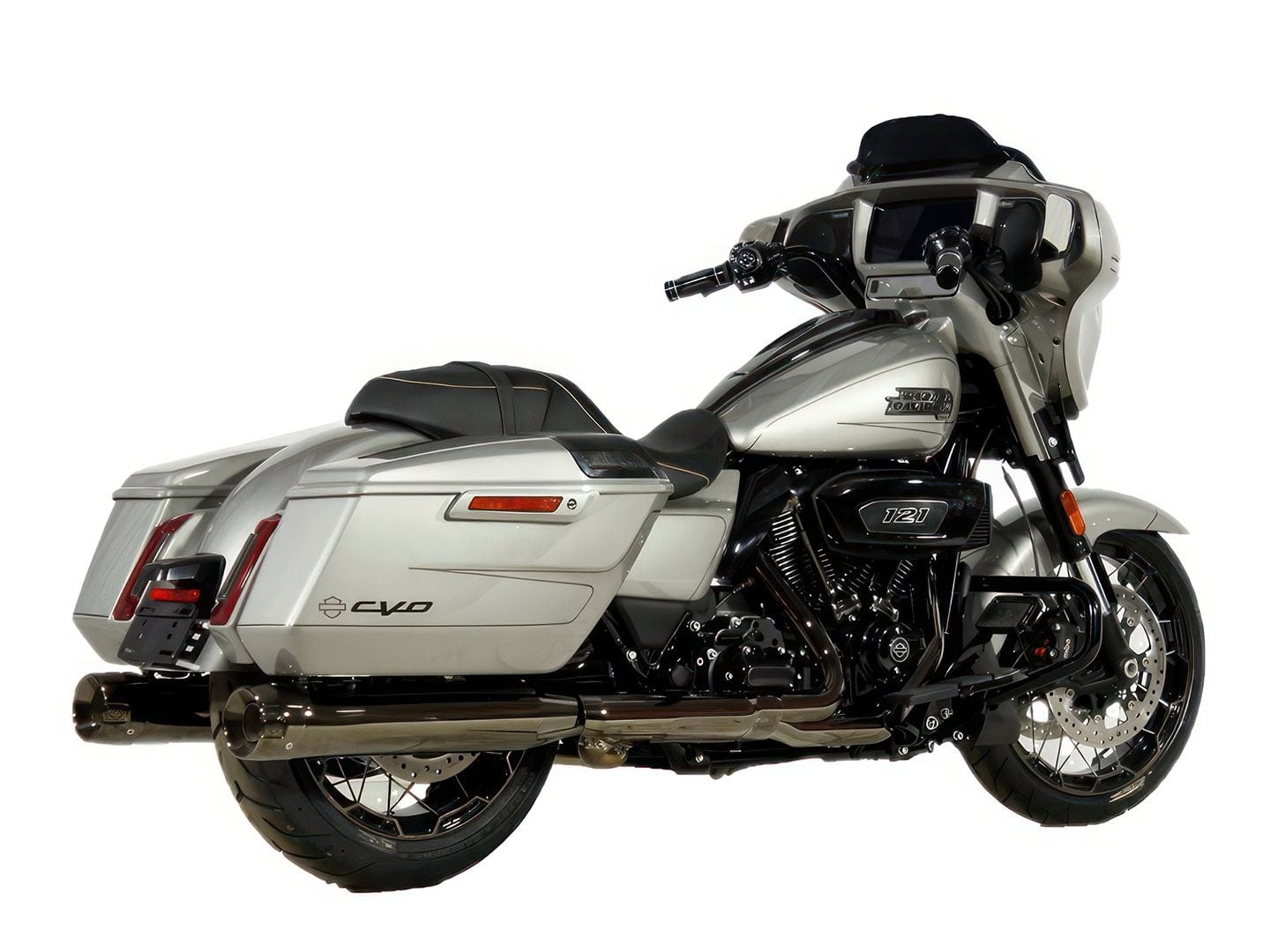
As revealing as the front three-quarter shot, this rear shot shows the new taillights, exhaust pipes, infotainment screen, and most importantly the big “121” on the intake. (Harley-Davidson/)
Seen from the rear, the bike has new, vertical taillights filling the gap between the rear fender and those side cases, and the exhausts are also redesigned with larger exits and a dark chrome finish. The rear angle also reveals the bike’s vast display screen, replacing any conventional instruments and inevitably providing connectivity, navigation, and multimedia control as well as access to an array of rider-adaptable settings. There appear to be new, multifunction control pods on the bars, with a D-pad on left-hand bar controls to operate the added tech.
Despite all this, the CVO Street Glide’s main draw is likely to be its engine. The “121″ badges are clearly visible on the intake and the clutch cover, denoting its capacity in cubic inches. That’s equivalent to around 1,983cc, and a fraction less than the 122ci offered by the current Stage III Screamin’ Eagle kit for the Milwaukee-Eight V-twin, but the capacity alterations are only the start of the new engine’s improvements. It’s widely anticipated to employ the variable valve timing system that we wrote about back in 2020, giving the air-cooled Milwaukee-Eight a new weapon in the constant battle to beat emissions limits.
While still largely air-cooled, the CVO Street Glide has a big cooler sitting in a blacked-out piece of bodywork just ahead of the motor. Whether it’s simply an oil-cooler or a radiator—making this the “Twin-Cooled” version of the engine—isn’t clear from these images. Unfortunately, the paperwork published alongside these pictures doesn’t appear to include the correct details about the new engine, instead quoting the capacity and performance of the existing 117ci Milwaukee-Eight. The quoted mass of 831 pounds and wheelbase of 64 inches also match the numbers for the previous-generation CVO Street Glide—last part of the range in 2022—suggesting the documents, while carrying pictures of the new bike, have figures relating to the old version.
Visually, there are changes to the engine beyond the 121 logos. The timing cover on the right-hand side of the engine has an additional bulge, believed to hide some of the variable valve timing kit, and the transmission side cover is also bulkier, clearly hiding some new mechanical elements. As well as the new CVO Street Glide, Harley is expected to launch a similarly substantial set of updates on the CVO Road Glide later this year, including the same new wheels and 121ci engine, as well as redesigned bodywork.
]]>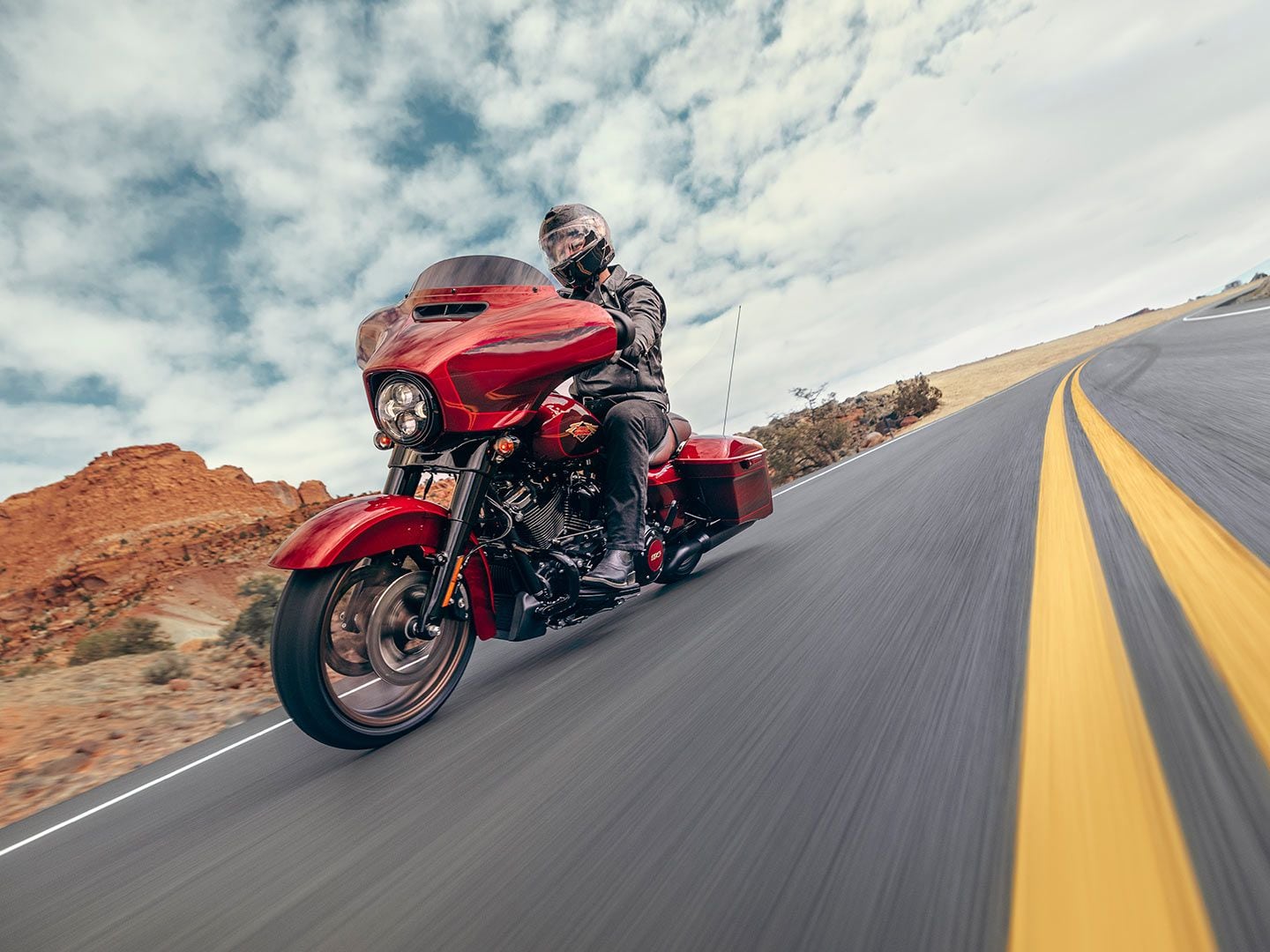
The Street Glide Special Anniversary’s maximum lean angles of 32 degrees right and 31 degrees left are modest, but sufficient for most roads traveled by big baggers like the Street Glide Special. (Harley-Davidson/)
What does nearly 31 large get you? For starters, the FLHXSANV (Harley-speak for Street Glide Special Anniversary) receives a unique Heirloom Red paint scheme that adds $2,900 to the non-limited model’s $27,999 MSRP. Straddle the generously proportioned saddle and you’ll find the Special is substantially decked out with a smattering of switch gear revealing its copious features, among them cruise control and audio controls for the Boom! Box GTS audio system. Tucked below four analog gauges is a 5.25-inch touchscreen that can be operated with gloves, managing features like GPS and stereo controls.
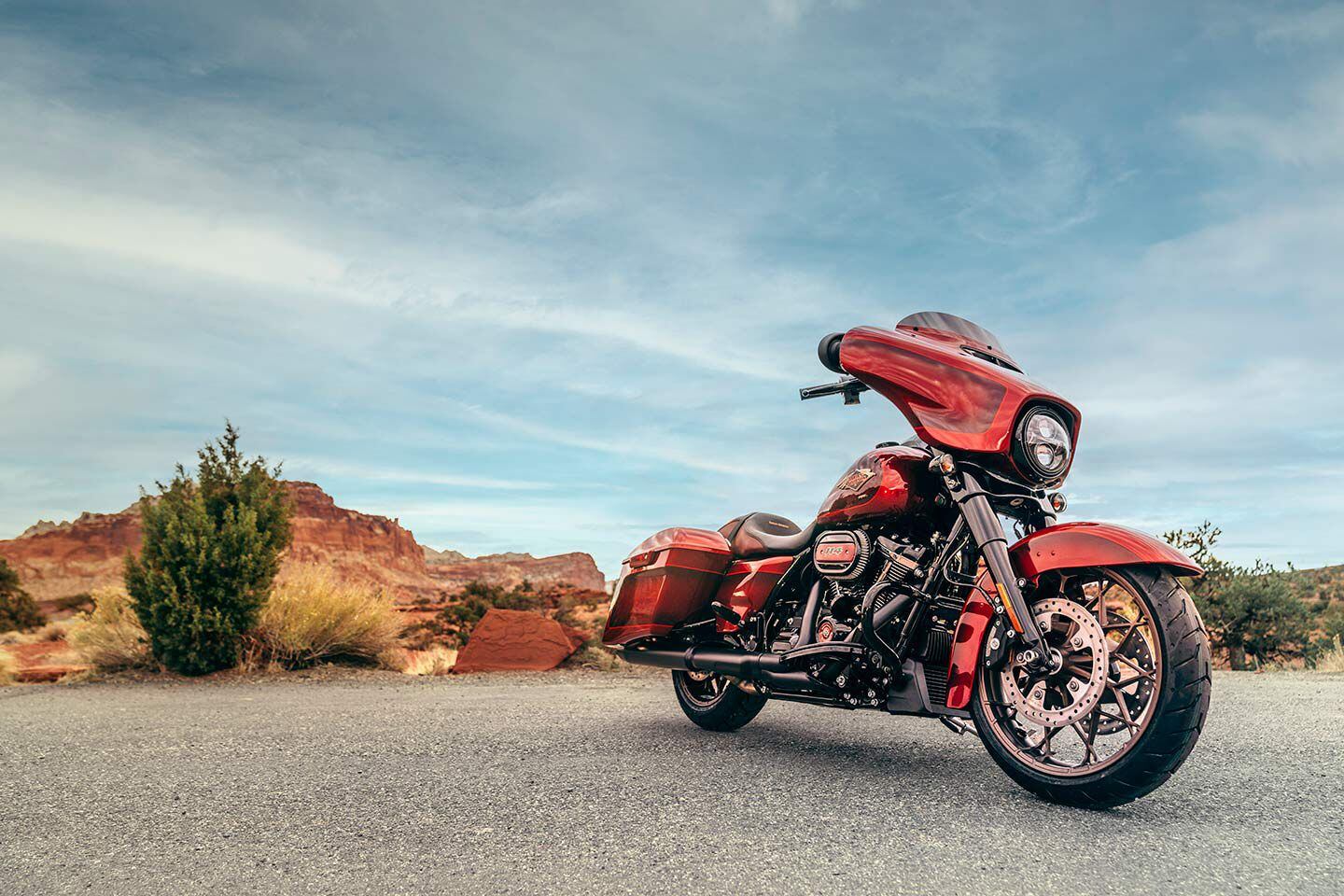
Is there a more iconic image than a Harley-Davidson against the American West? (Harley-Davidson/)
The Street Glide Special has a heavy visual presence. But you won’t comprehend its heft until you try shoving it off the sidestand: With a curb weight of 827 pounds, it takes a serious heave-ho to orient it to vertical, which is a tad easier thanks to the manageable 27.2-inch seat height. Grab the clutch, and the high effort required to pull the non-hydraulic actuation feels consistent with the bike’s heavy metal theme. Once you’ve thunked into first gear and rolled into motion, the Glide starts to glide into motion with ease, dissipating much of the inertia from its large footprint and considerable mass. The batwing fairing incorporates an analog speedo, tach, fuel gauge, and voltmeter; unfortunately missing is an analog ambient temperature gauge, that retro throwback instrument that’s all too easily replaced with a digital temperature readout (which this bike also lacks). While it’s reassuring to see analog dials, we don’t mind the LCD representation of gear position. However, gear positions are not indicated when the clutch is pulled, which is exactly when you’d want to know what gear you’re in. At least a big green “N” illuminates when you’re in neutral, helping avoid awkward lurches at stoplights.
Once at cruising speed, the Street Glide Special comes into its own. While big touring Harleys were once shaky and sloppy in corners, improvements over the years have led to improved handling thanks to the relatively modernized chassis. The mild steel tubular frame incorporates cast and forged junctions, while the two-piece swingarm links the rear wheel solidly to the body. Cornering still requires forethought and won’t confuse this Harley with a sportbike, let alone siblings like the Road Glide which detach the fairing from the fork for lighter, more accurate steering. However, the most egregious aspects of the Street Glide chassis are now limited to a bit of light steering under hard acceleration at higher speeds.
Speaking of speed, Harley’s Milwaukee-Eight 114 powerplant operates under the age-old (slightly) modernized formula, incorporating pushrods, four valves per cylinder, and hydraulic self-adjusting lifters along with electronic sequential port injection. Goose the throttle, and the 1,868cc V-twin lurches ahead with honeyed ease. Most of the grunt resides down low, below the 4,000 rpm range. Although there’s still some momentum in the revs as the needle approaches redline, the official peak power of 95 hp occurs at a claimed 5,020 rpm, with 122 lb.-ft. of torque maxing out at an even lower 2,750 rpm. Never mind rev-happier models like the liquid-cooled Indian Challenger; you’re on Harley time with the Street Glide Special.
Unlike some of its antecedents, however, the Anniversary’s brakes are strong. A press of the automotive-style foot pedal can be enough to bring the cruiser to an easy halt at lower speeds via the rear brake, and the hand lever effectively scrubs speed off at highway velocities via the four-piston fronts.
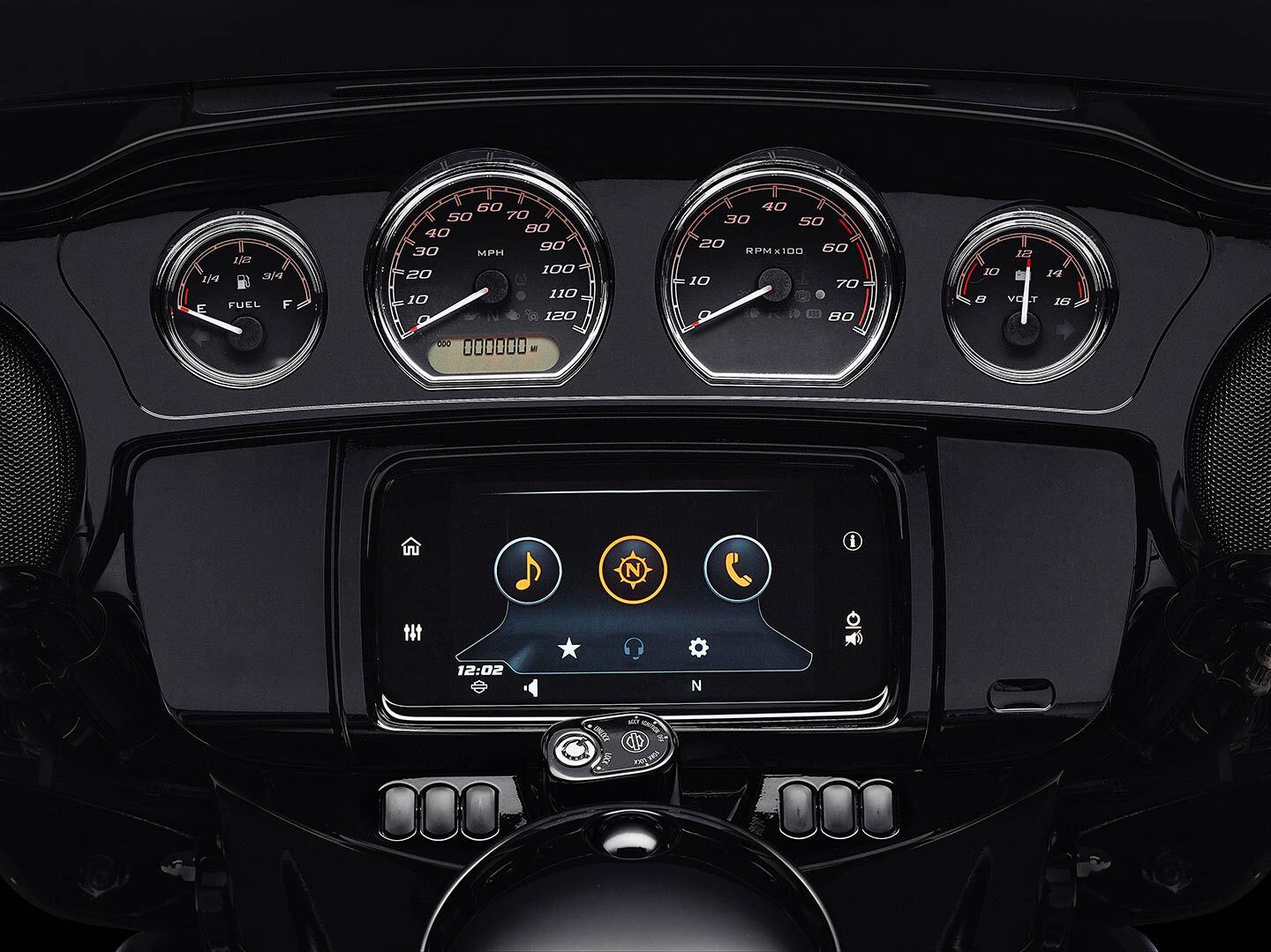
Although this image dates back to the 2020 model year FLHXS, the 5.25-inch touchscreen and analog gauges remain the same for 2023. (Harley-Davidson/)
Long-distance rides reveal a surprising amount of protection from the shorty windscreen, making it easy to cruise at highway speeds for many miles. While my riding was a bit heavy-handed, Harley’s EPA estimate of 43 mpg from the 6-gallon plus 1-gallon reserve fuel tank would equate to a theoretical range of 301 miles. The 25 watt-per-channel, two-speaker stereo is loud enough to overcome the inevitable blast of road noise with decent sound quality, though the multimedia interface through the touchscreen feels like a bit of time travel…not in a good way.
Whereas the screen would have been a prime opportunity for streamlined GPS and audio options, the system instead feels dated and clunky to use. A small grip-mounted joystick can be used to navigate the system, but it’s easier to reach out with your left hand and negotiate the menus while riding. The small cubby to the right of the screen can stow and charge a cellphone, and a port in the fairing enables charging of accessories; at least Apple CarPlay and Android auto are available, though they do require three things: a WHIM (Wireless Headset Interface Module), an H-D wireless or wired headset paired, and the phone to be connected via the bike’s USB port.
Two saddlebags shut with a satisfying chrome latch, offering a modest but better-than-nothing 2.5 cubic feet of storage volume. In typical Harley style, the bags are styled consistently with the rest of the motorcycle, becoming an unmistakable part of the bike’s overall aesthetic experience.
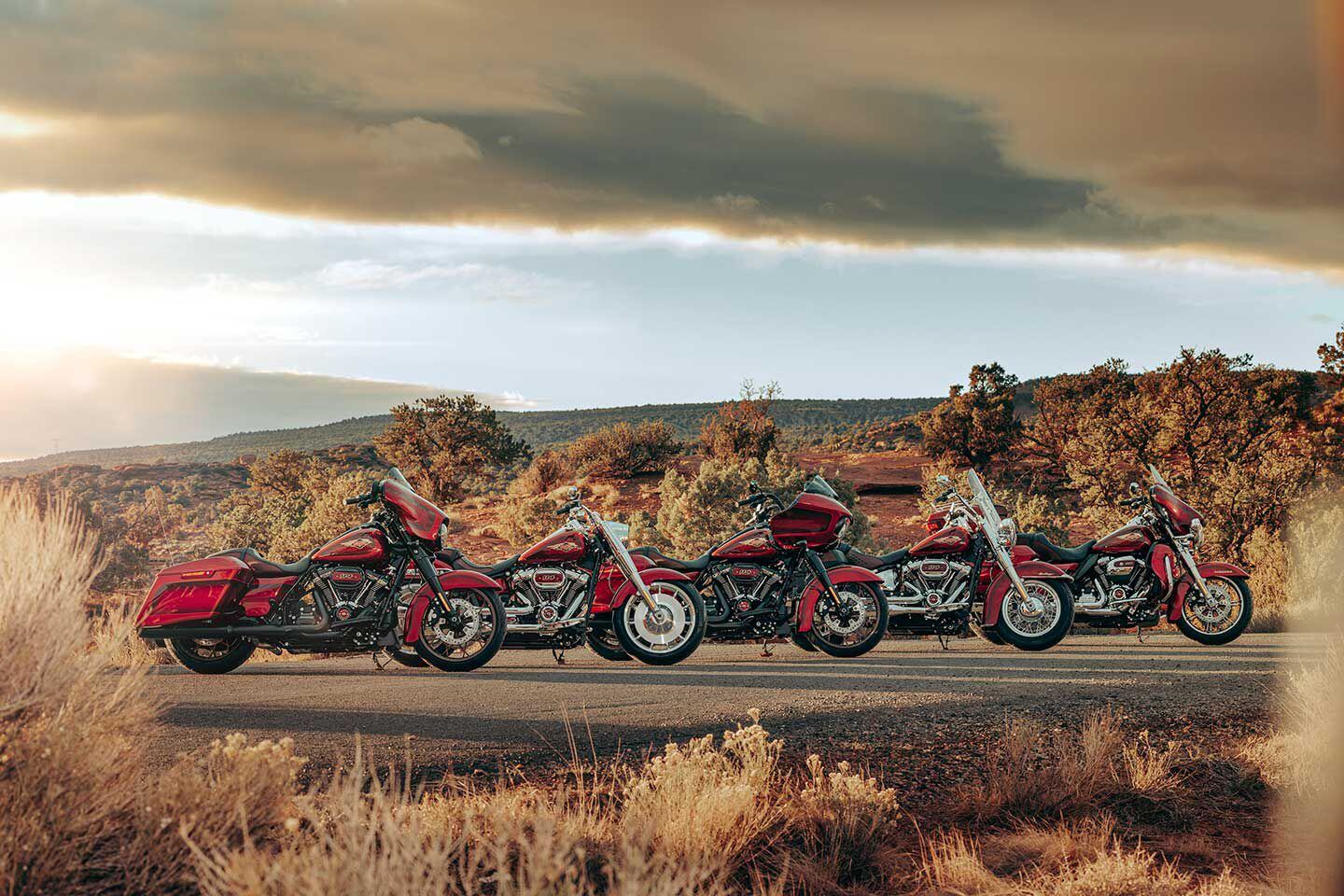
The 2023 Harley-Davidson 120th Anniversary lineup, from left to right: Street Glide Special, Fat Boy, Road Glide Special, Heritage Classic, Ultra Limited. Not pictured is the Tri Glide Ultra. (Harley-Davidson/)
The Harley Street Glide Special Anniversary delivers The Motor Company’s familiar touch points in a classic, premium finished package that doesn’t stray very far from its OG origins. While it’s easy to criticize the weak spots—the not-quite-there infotainment system, the cumbersome weight, the legacy bits and bobbles that feel anachronistic in 2023—this is nonetheless a potent expression of Harley DNA, lending this retro bagger unmistakable charisma. Sure, it’s easy to call out a $2,900 paint scheme as a shallow money grab for an anniversary callout. But considering it took 120 years for Harley-Davidson to get here, let’s cut The Motor Company some slack for a legacy and sense of identity most other brands aspire to.
2023 Harley-Davidson Street Glide Special Anniversary Technical Specifications and Price
| PRICE | $30,899 |
|---|---|
| MOTOR | 114ci (1,868cc), OHV, air-cooled, 4-stroke V-twin |
| BORE x STROKE | 102.0 x 114.3mm |
| COMPRESSION RATIO | 10.5:1 |
| FUEL DELIVERY | Electronic Sequential Port Fuel Injection |
| CLUTCH | Wet, 10-plate assist and slip; mechanically actuated |
| TRANSMISSION/FINAL DRIVE | 6-speed/belt |
| FRAME | Mild steel tubular |
| FRONT SUSPENSION | 49mm dual bending valve fork; 4.6 in. travel |
| REAR SUSPENSION | Hydraulic shock w/ hand adjustable damping; 2.15 in. travel |
| FRONT BRAKE | Dual 4-piston calipers, 300mm discs w/ ABS |
| REAR BRAKE | 4-piston, 300mm disc w/ ABS |
| WHEELS, FRONT/REAR | 19 in./18 in. |
| TIRES, FRONT/REAR | 130/60-19 / 180/55-18 |
| RAKE/TRAIL | 26.0°/6.8 in. |
| WHEELBASE | 64.0 in. |
| SEAT HEIGHT | 26.1 in. (laden), 27.2 in. (unladen) |
| FUEL CAPACITY | 6.0 gal. + 1.0 gal. reserve |
| CLAIMED CURB WEIGHT | 827 lb. |
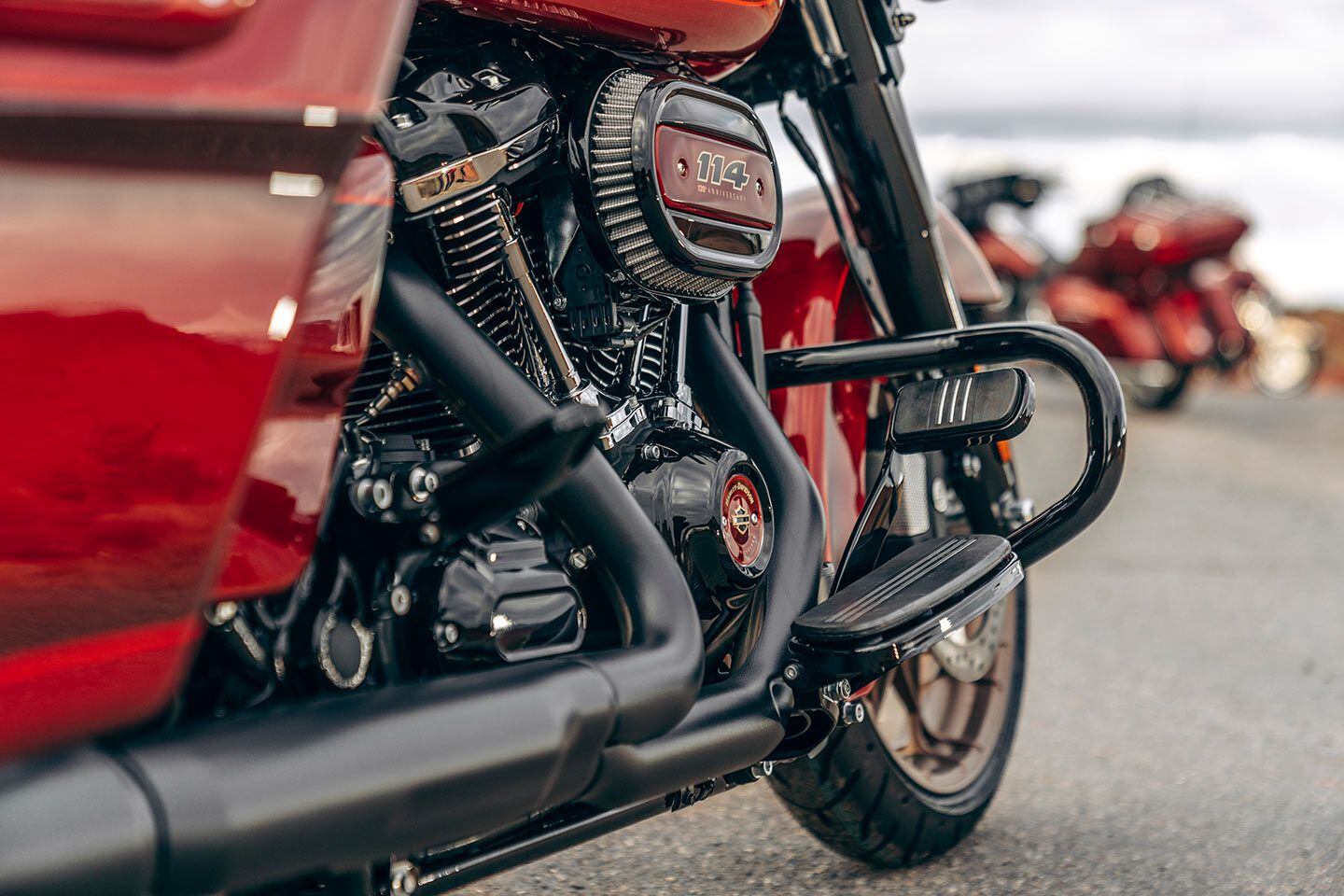
The FLHTKANV’s 114ci V-twin routes the 2-1-2 exhaust through tapered mufflers for Harley’s signature sound. Blackout trim and selective chroming round out the visuals. (Harley-Davidson/)
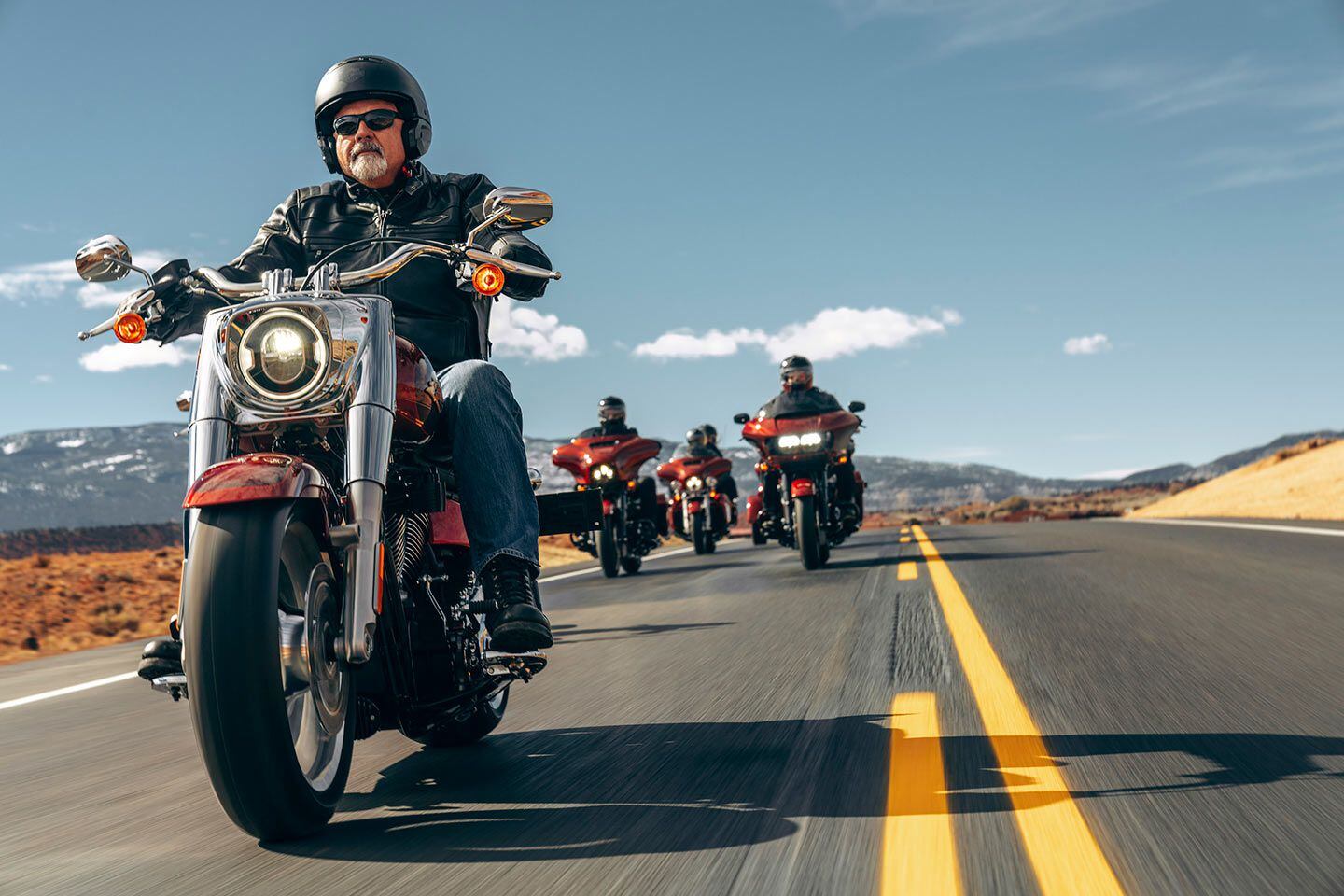
Harley’s 2023 Anniversary lineup on the road; look close, and you'll spot the Street Glide Special’s batwing fairing and LED headlamp to the immediate right of the Anniversary edition Fat Boy in the lead. (Harley-Davidson/)
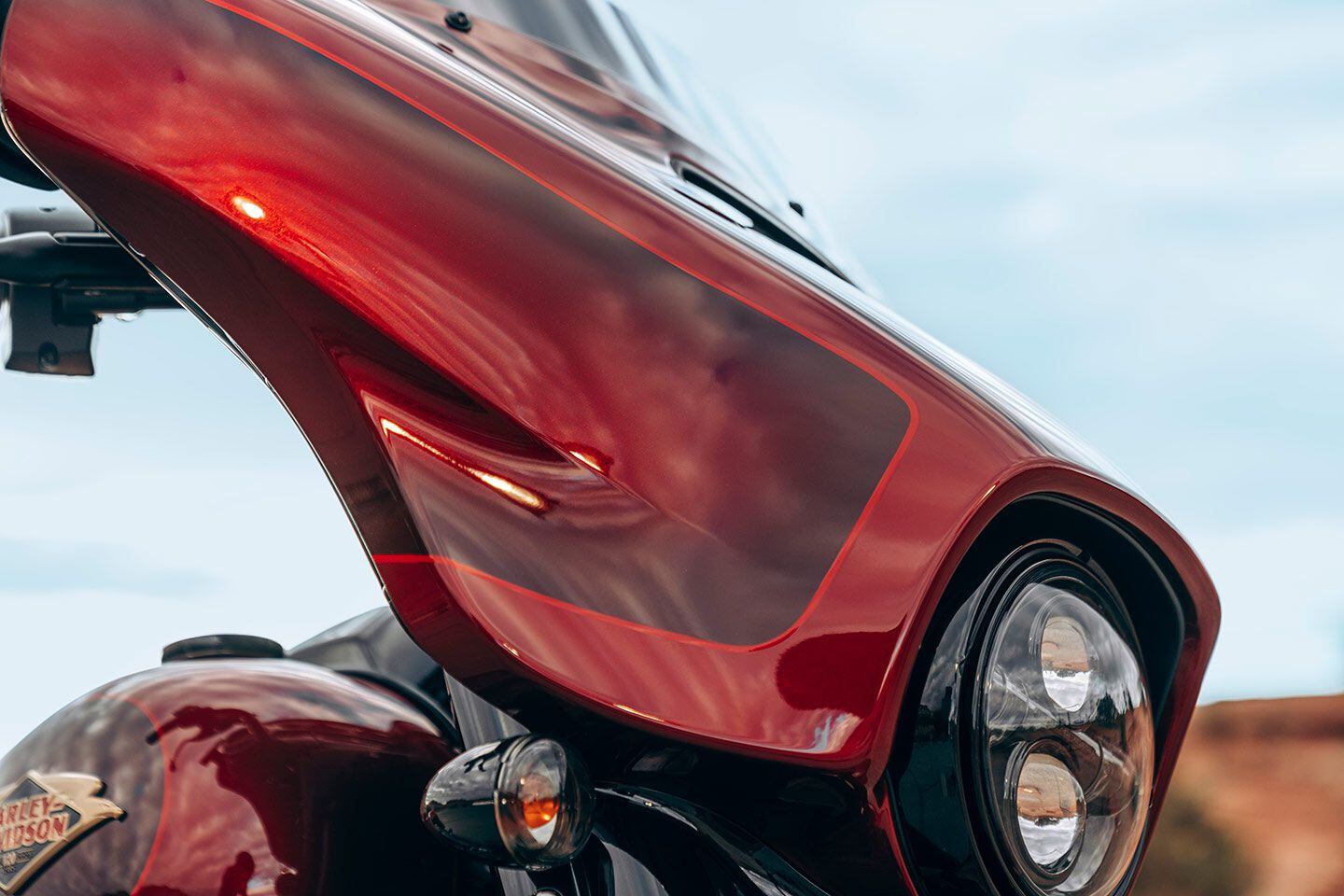
The batwing fairing is a key part of the Street Glide Special’s visual signature, and delivers more wind protection than you might expect. (Harley-Davidson/)
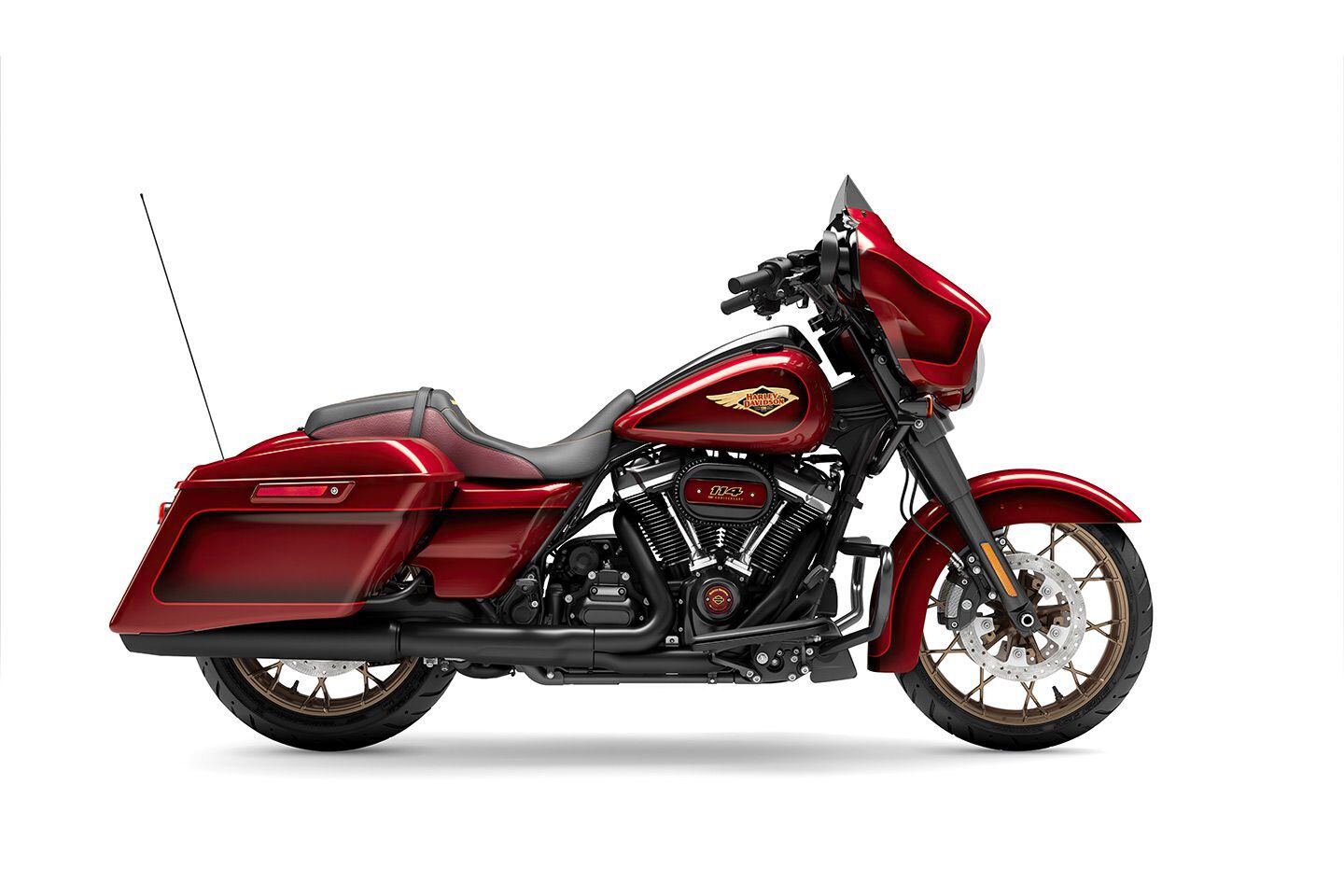
An unladen seat height of 27.2 inches—which shows in this profile shot—makes the Street Glide Special Anniversary easier to manage at low speeds despite its considerable 827-pound curb weight. (Harley-Davidson/) ]]>
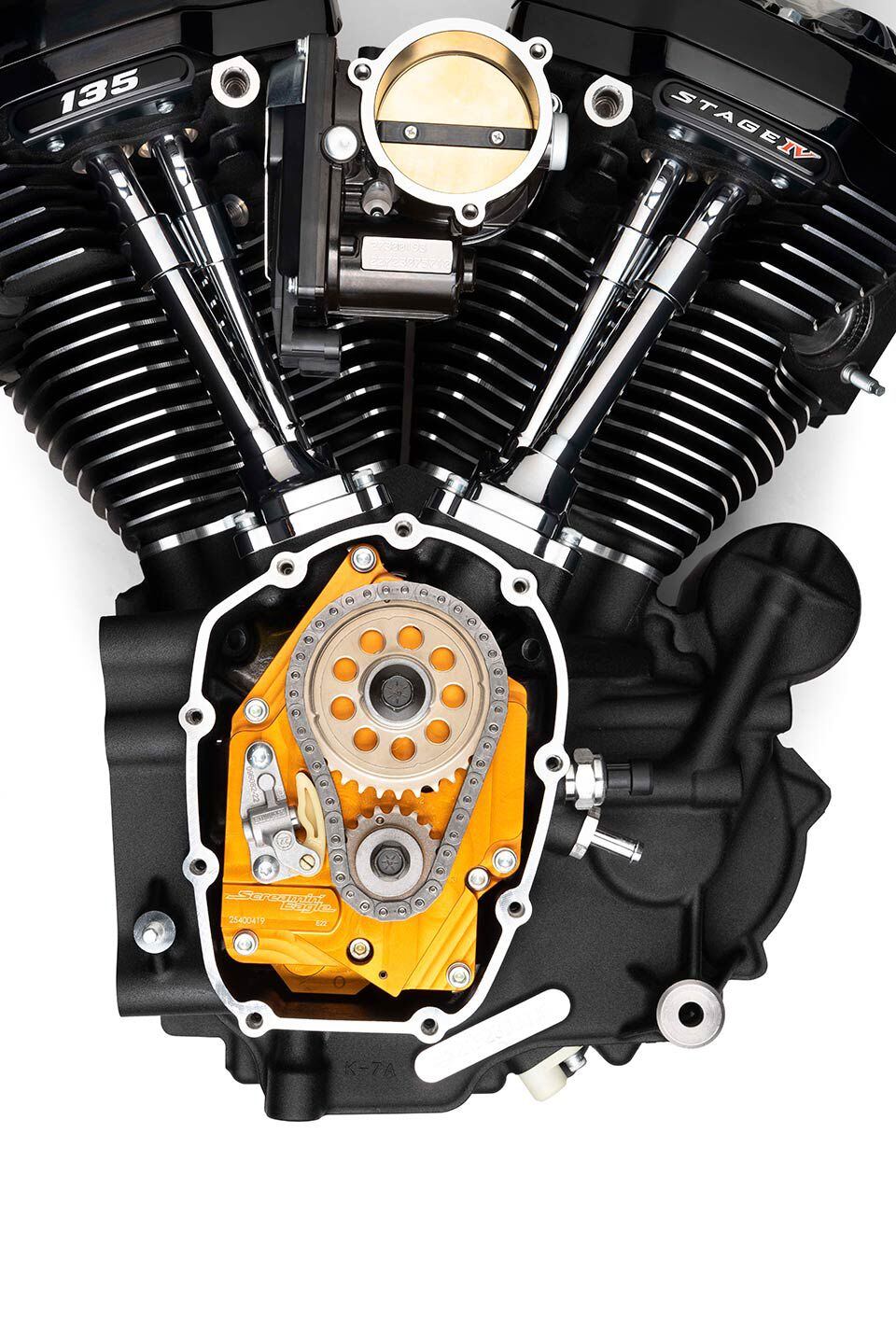
The new 2,122cc V-twin crate engine is packed with Screamin’ Eagle upgrades. (Harley-Davidson/)
The new mill bolts on to the original Touring chassis, so installation will be straightforward. It will feature a bevy of premium Screamin’ Eagle components as well. These include new 10.7:1, high-compression forged pistons, CNC-ported cylinder heads that are designed to maximize efficiency and performance. There will also be a new 68mm throttle body, CNC-machined intake manifold, a Pro Billet cam plate and oil pump, a high-performance cam bearing and high-lift camshaft, and high-capacity injectors.
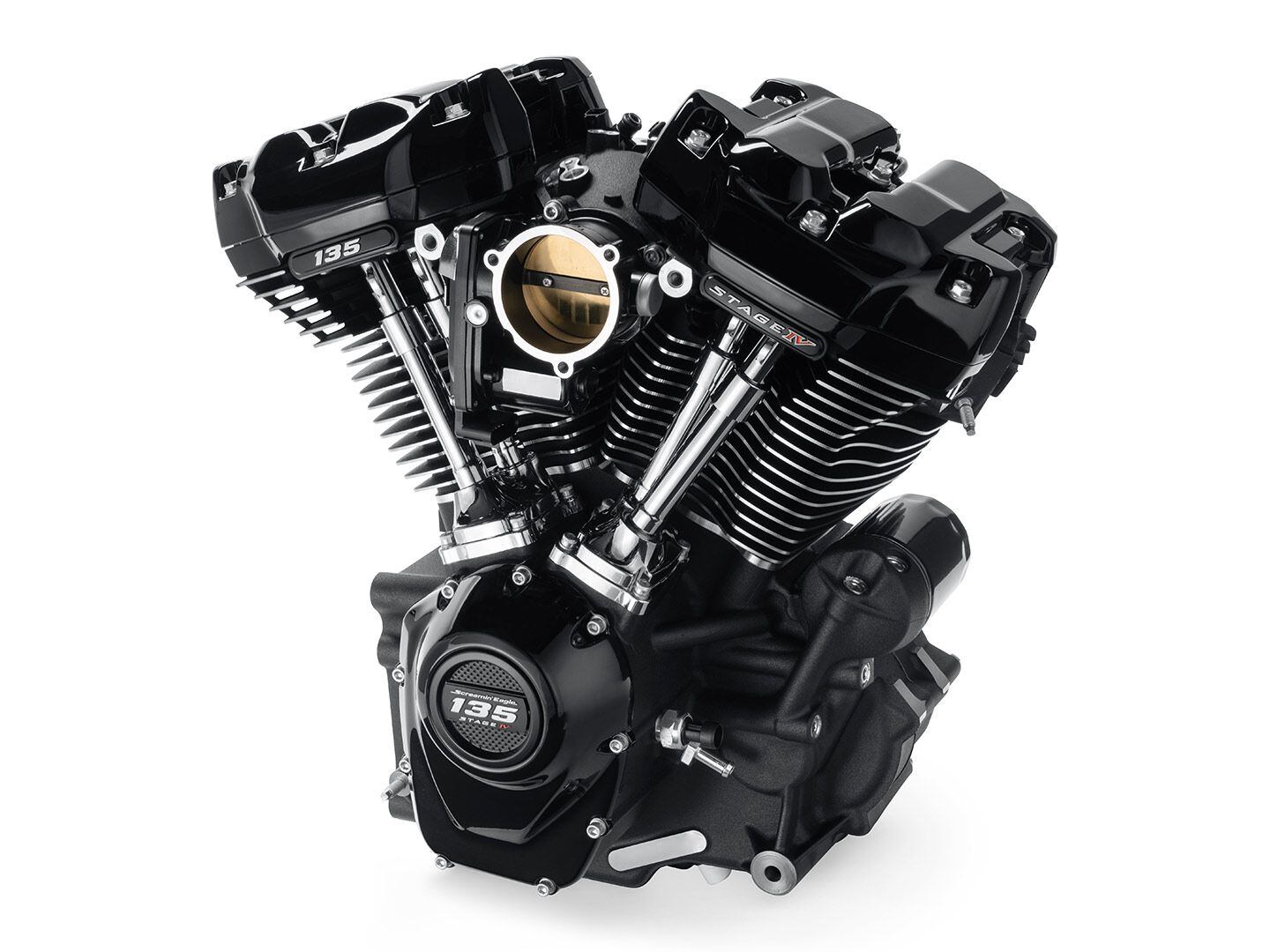
All together, the new mill puts out 143 lb.-ft. of torque and 130 hp. (Harley-Davidson/)
All together the package puts out up to 143 lb.-ft. of torque at 3,500 rpm. It also offers 130 hp at 5,500 rpm. These figures are 28 percent and 41 percent more, respectively, than those offered by the production Milwaukee-Eight 117 engine.
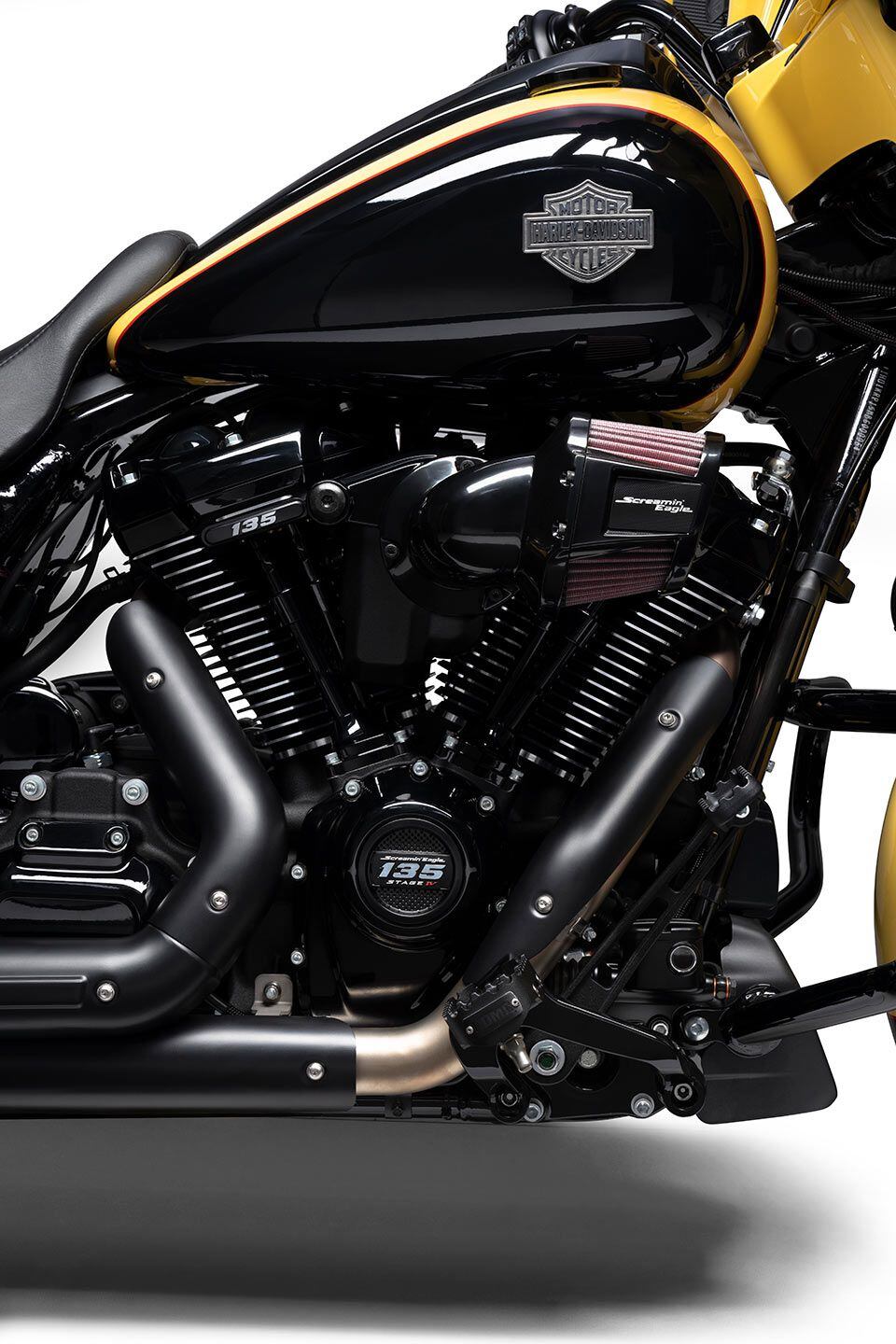
The new crate engine will cost $7,999.95. (Harley-Davidson/)
Riders will want to utilize the wireless Screamin’ Eagle Pro Street Performance Tuner to recalibrate the ECM and optimize engine output, and will no doubt consider adding the Screamin’ Eagle Ventilator Extreme Air Cleaner and Street Cannon mufflers, both of which are sold separately.
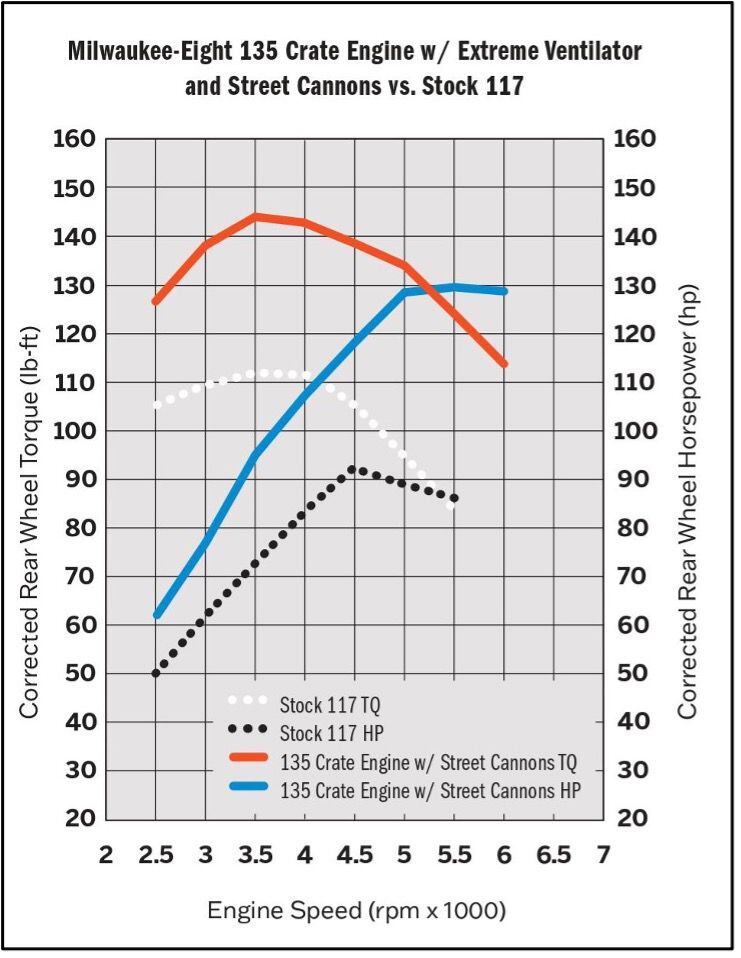
A comparison of torque and hp figures from the Milwaukee-Eight 117 and the new Screamin’ Eagle crate engine. (Harley-Davidson/) ]]>
First laps aboard the King of the Baggers–prepped Indian Challenger at Chuckwalla Valley Raceway. It’s like nothing you’ve ridden before, but not as intimidating as you might think. (Garth Milan/Indian Motorcycle/)
The toughest part about riding Indian’s King of the Baggers Challenger is going slow. Tucked in behind a photo car it feels agitated and anxious. The bike lunges and hesitates in an uncomfortable sequence, subtly reminding you that Indian Motorcycle Racing did not build this bike for pageantry. This is a racebike and it was made to go fast—as a racebike should.
Indian is no stranger to building race-winning machines. The company was founded by racers who developed America’s first motorized bicycles and it’s been racing for 122 years—although not continuously. Indian swept the Isle of Man TT in 1911 with a little luck and some rather forward-thinking (for the time) innovations; Burt Munro set land speed records; and the original Indian Wrecking Crew (Ernie Beckman, Bill Tuman, and Bobby Hill) tallied 14 AMA national wins between 1950 and 1953. Seventy years later and Indian Motorcycle Racing has added another feather to its cap by winning championships across three widely varying classes, including King of the Baggers (KotB), Super Hooligan National Championship (SHNC), and American Flat Track SuperTwins.
Asking Indian to choose a favorite among those titles is like asking a parent to pick a favorite child. They’ll lie and say there are no favorites, but there is always one. Sorry, kid. In the case of these championships, it’s hard to imagine Indian not feeling more than sentimental about the King of the Baggers crown that it’s pried from Harley-Davidson’s hands. Rivalries—especially those that have lasted more than a century—have that effect.
Related: Why King of the Baggers Racing Is So Popular
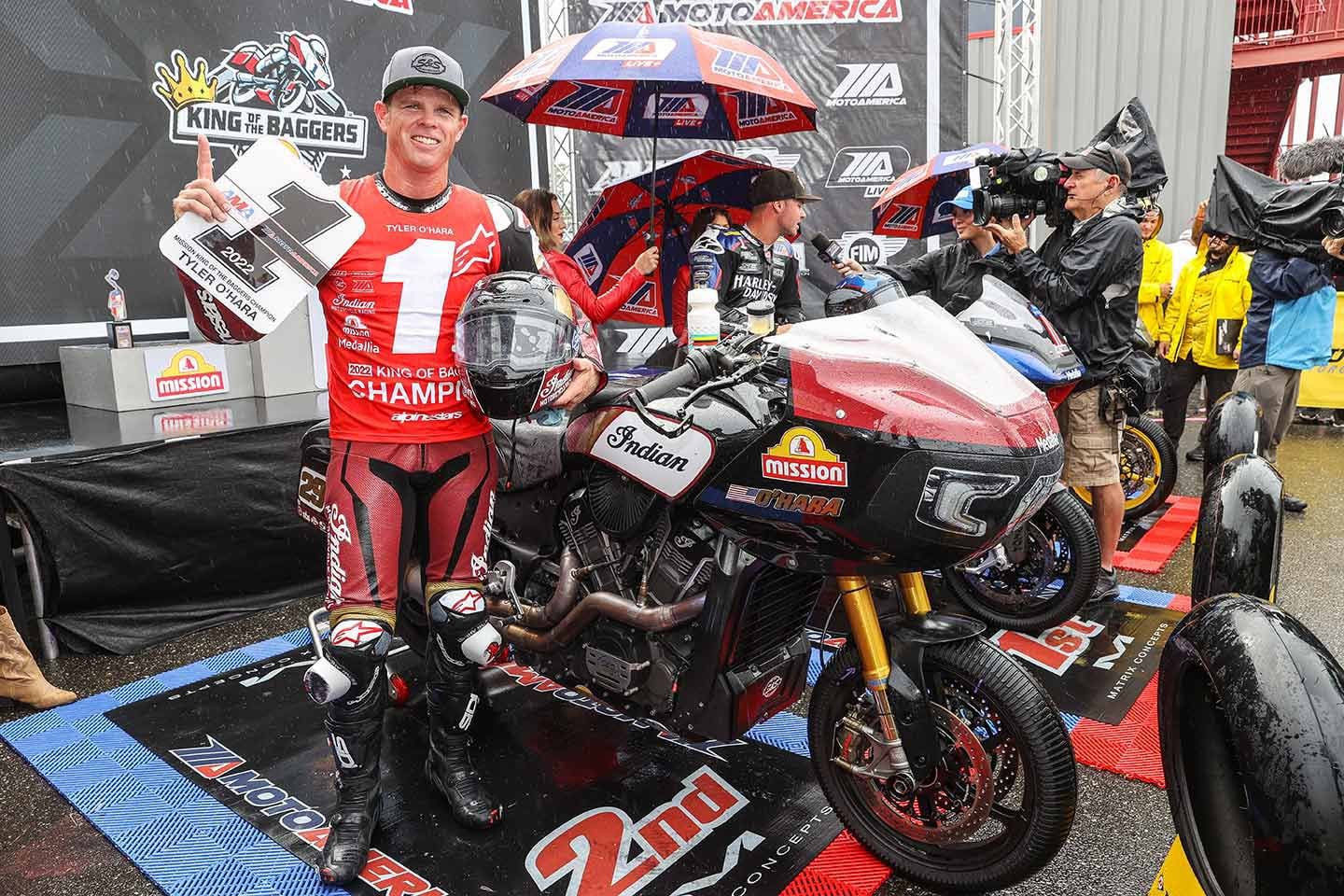
Tyler O’Hara celebrates Indian’s King of the Baggers championship at a rain-soaked New Jersey Motorsports Park. Indian also took top honors in the 2022 Super Hooligan National Championship (SHNC) and American Flat Track SuperTwins. (Brian J. Nelson/)
To win in this class is to showcase the capabilities of the bikes people are buying. “The top-selling bikes in America are baggers, and that’s what we’re racing,” says Gary Gray, vice president - racing, technology, and service for Indian Motorcycle. “If you go to a race, like with Laguna Seca where everybody parks down in the bowl, 10 or 15 years ago it was sportbikes, but that’s not what people ride anymore. They ride baggers. So it’s really cool to get this heavy iron out there and show people what it’ll do.”
The bikes that Indian is rolling out, together with S&S Cycle, are a far cry from what anyone expected to see when the first King of the Baggers exhibition race was announced for 2020 and the package has only evolved since then. Look closely and you’ll find the bones of a production bike, but that image is quickly blurred by a throng of race parts and production-based (so Indian says) pieces that are so heavily modified they’re almost unrecognizable.
During a recent preseason test at Chuckwalla Valley Raceway, we had the chance to talk to the Indian Motorcycle Racing team about the project before throwing a leg over Tyler O’Hara’s 2022 championship-winning Challenger. Perhaps the best reminder of how special this bike is: The fairings wore signatures from Tyler and the team. Nerve-wracking? Yes.
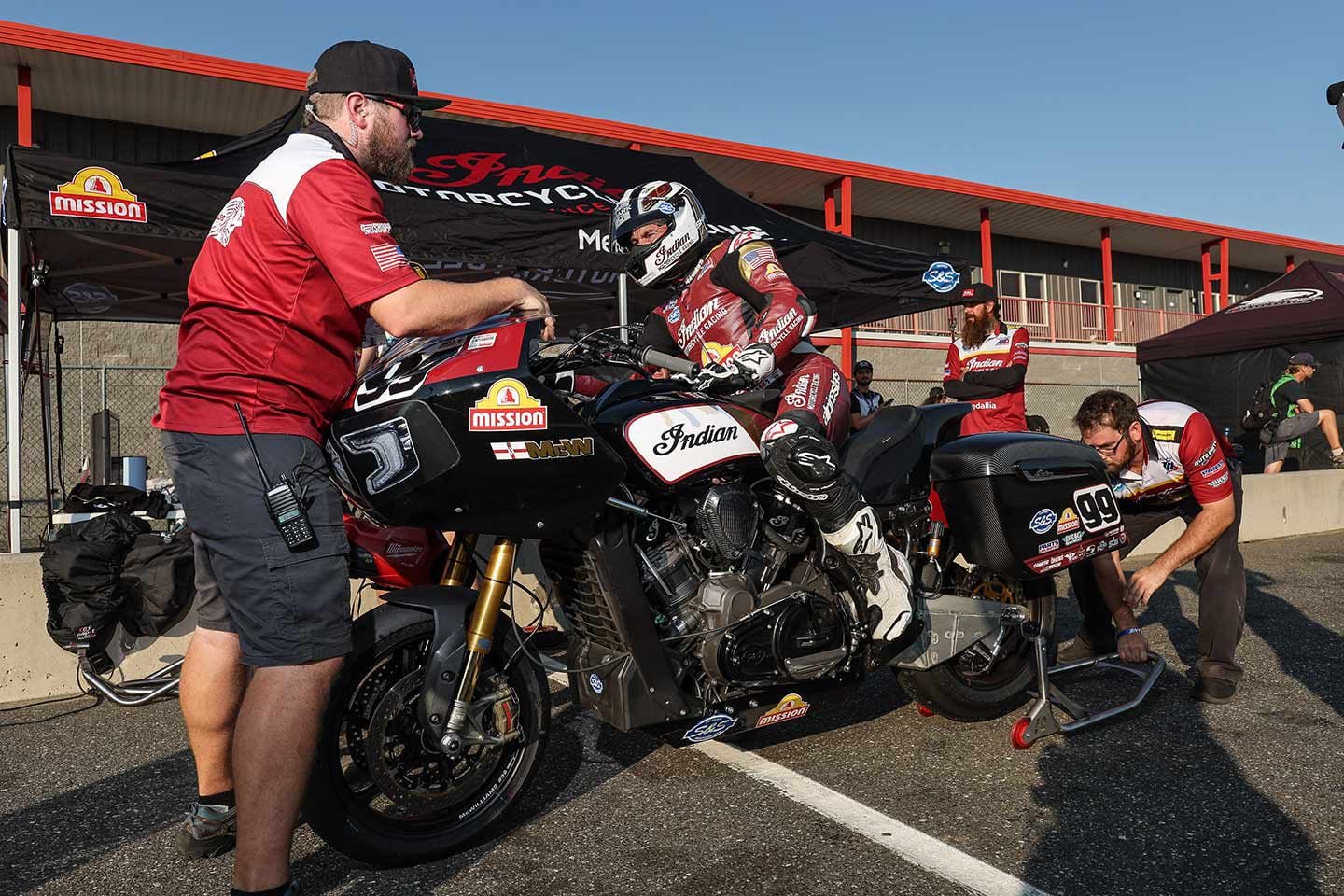
It’s nearly impossible to overemphasize how seriously Indian takes the King of the Baggers championship. (Brian J. Nelson/)
Fears of binning Indian Motorcycle Racing’s pride and joy vanish rolling out of hot pit, though it takes a minute to feel truly comfortable behind the big OEM-ish fairing that serves as a visual reminder of the bike’s size. Indian is using the passenger footpeg mounting holes as the mounting point for the S&S foot controls, and while it admits to wanting to move the rider forward on the ‘23 racebike, these ergos work well for the unacquainted. Consider them a middle ground between racy and roomy; natural and at the same time, not. Ironically, it only takes a few corners to forget the bags are there.
Related: Indian Motorcycle Racing Announces 2023 Race Teams
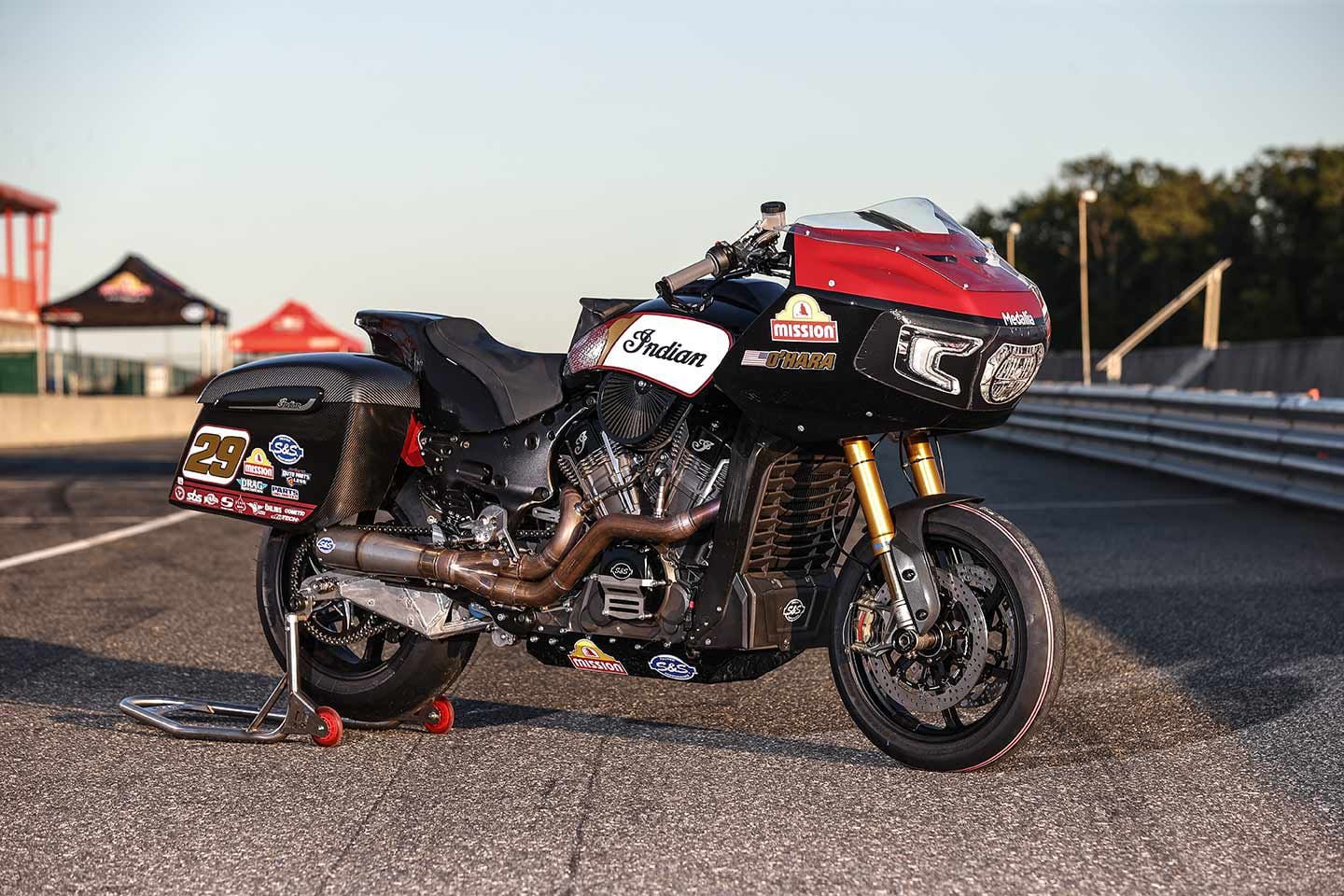
O’Hara’s Challenger in nearly the same spec as it would be for our test. The 2023 bike will use a handful of new parts, the most noticeable being a new intake. The system here required some modifications to the fuel tank. (Brian J. Nelson/)
Nearly every moment on the Challenger is like weaving in and out of two vastly different worlds. Riding the bike feels like a balancing act; push in some places, ease off in others.
There’s a lot less easing off when you’re Tyler O’Hara, and to Indian’s credit, it’s built an incredible package around the stock frame, modified only for additional cornering clearance. Propped up on an Öhlins TTX 36 shock, modified FG 8603 fork from a Ducati Multistrada (!), and heavily braced OEM swingarm, the bike transitions from side to side with an unexpected sense of urgency. Of all the things we expected to be startled by on this test day, turning in too early was not one of them. And yet that was the case as we rolled through the tight left-right transitions at Chuckwalla on our first flying lap. It’s shocking how nimble and sporty the Challenger feels at speed.
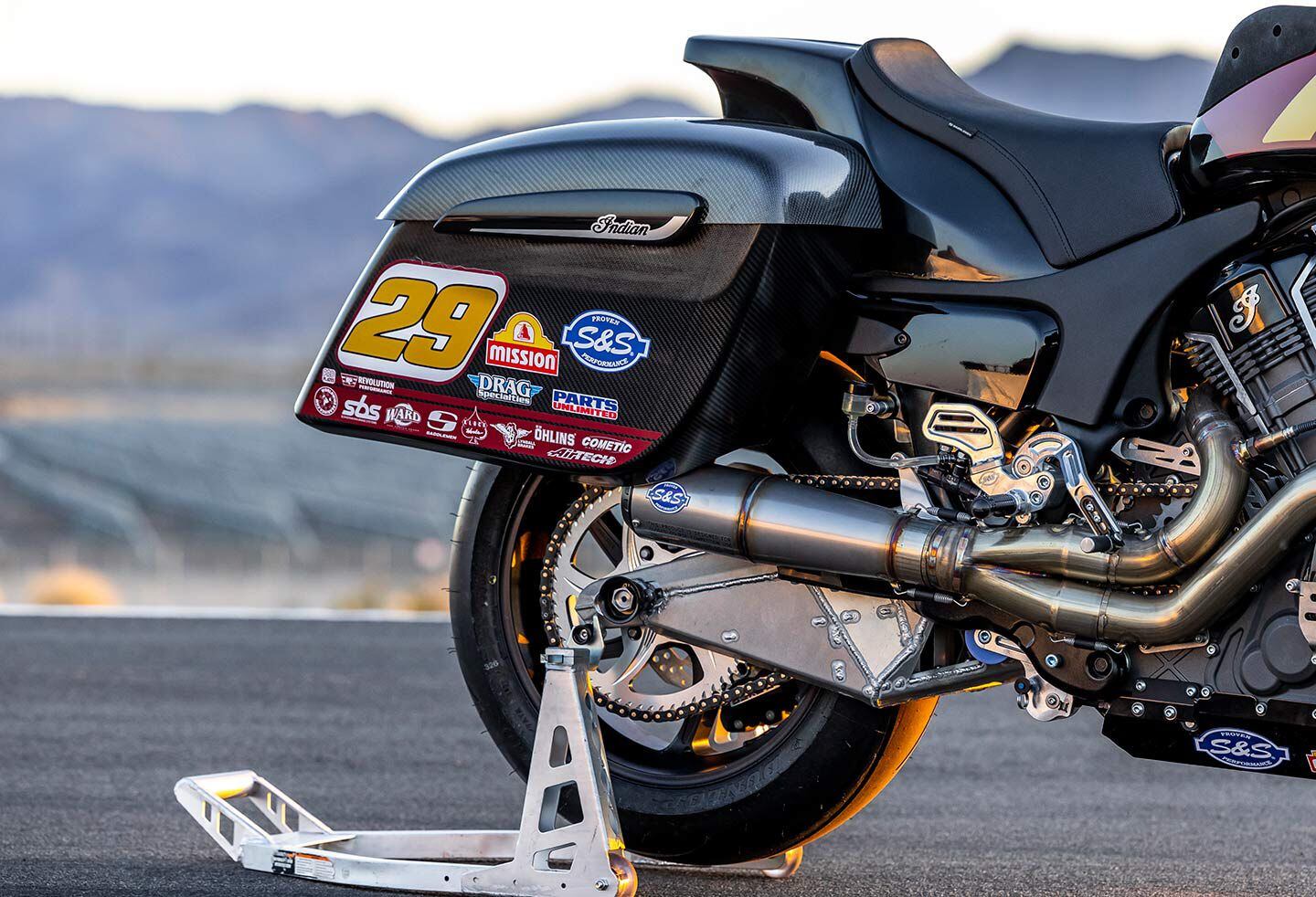
There is a stock Challenger swingarm behind all of that bracing. Saddlebags are carbon fiber. Notice also the custom seat by Saddlemen, and how the rearsets are mounted where the stock passenger pegs would normally be. (Garth Milan/Indian Motorcycle/)
The bike has a slightly different personality when banked over in long, sweeping corners with the throttle partially cracked or off, and it takes time to become comfortable with how much the bike wallows while on its side—a subtle reminder that this chassis was not built for racing. Someone like O’Hara rides right through that, while our best solution was to ease up and let the bike move as it wanted. We’re in no hurry here. Important to mention is that we tested the bike on Dunlop Q4 rubber, but slicks are spooned on for racing duties. That extra grip might increase overall composure, though Indian riders admit that there’s always been a bit of chassis flex.
Well-developed Öhlins suspension and a stout braking package featuring race-spec Brembo calipers are well-integrated into the platform and an indication of the excellent work Indian has done to turn this Challenger into a racebike. The suspension doesn’t feel harsh like a superbike might, but offers great support when hammering on the brakes or driving off a corner. The bike weighs 620 pounds, per MotoAmerica rules, and while you’d expect that mass to overpower any parts you throw at it, that definitely isn’t the case with these bits.
Related: First Track Test Of Indian Motorcycle’s Race Bagger
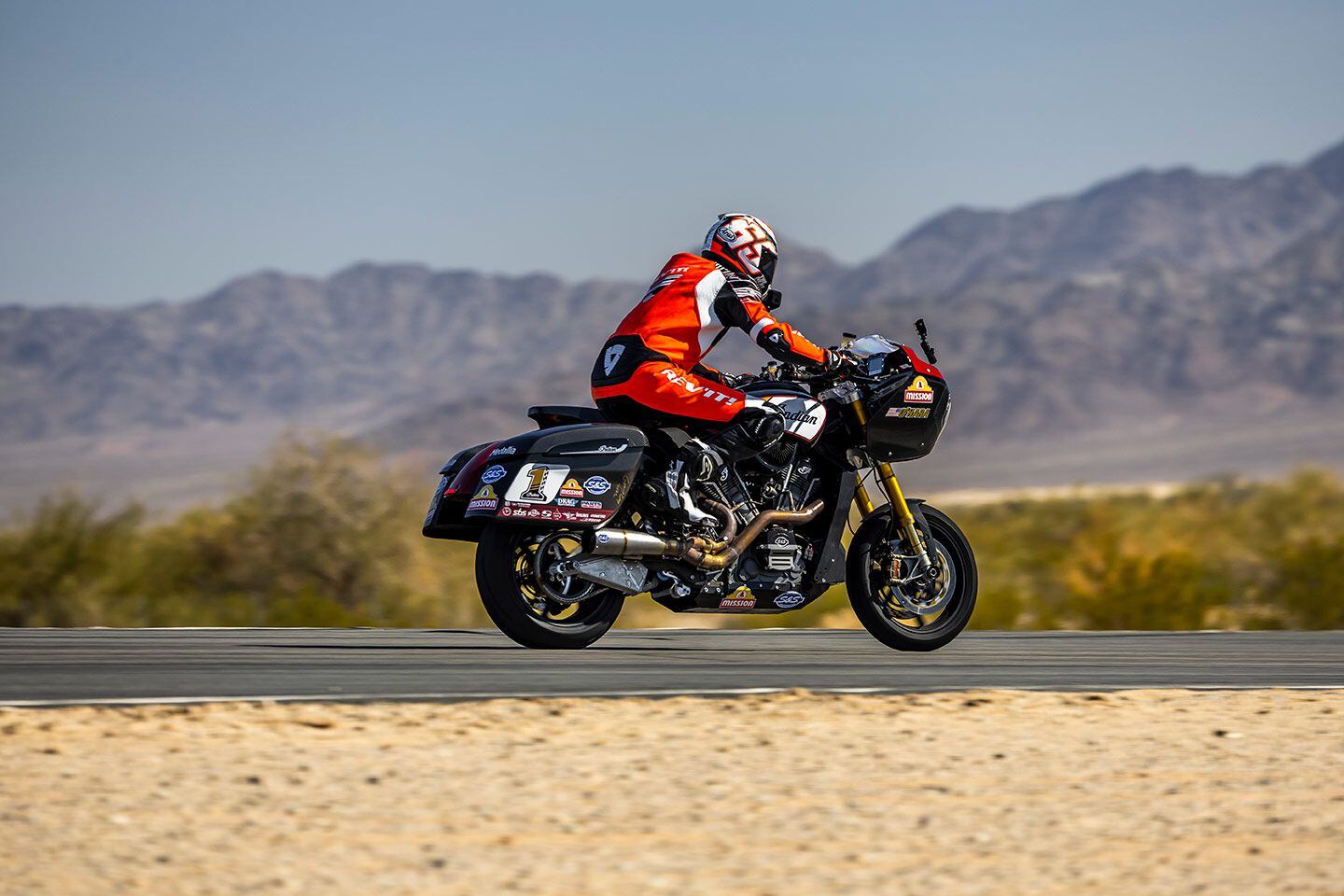
Mid transition at Chuckwalla Valley Raceway. The most surprising thing about the Challenger is how agile it is in side-to-side transitions. (Garth Milan/Indian Motorcycle/)
Speaking of weight, Indian has cut so much meat off the bike that it actually needs to run 10 to 15 pounds of ballast on the bike to meet minimum weight requirements. “We’ve moved it all over the place, but most of the time we’re racing with it down in the bellypan,” says S&S’s chief engineer Jeff Bailey, a critical player in the project.
Indian is continually working on the design of the adjustable billet triple clamps and fine-tuning the geometry, because in racing you’re never truly satisfied. Even still, the setup we rode offered an incredible amount of confidence at corner entry. Somehow, dropping anchor and then trail-braking into a corner doesn’t feel out of place. You’re never struggling to get the bike toward the apex, or feel like it’s in charge. A generously sized thumb brake helps the bike steer even tighter according to O’Hara, while also stabilizing the chassis and minimizing the aforementioned flex.

While the obvious goal is to make more power, Indian and S&S Cycle worked diligently to make power in the rev range they wanted, which is up top. Indian is using 110mm big-bore pistons and ported cylinder heads, along with custom camshafts and other changes aimed at increased durability. (Indian Motorcycle/)
Corner exits are evidence of the solid work Indian has done with the engine, which is making something like 160-plus horsepower. There’s ambiguity in that statement because this is a racebike, and race teams don’t generally want anyone knowing exactly what they’re working with. What we do know is that Indian is using 110mm big-bore pistons and cylinders, CNC-ported cylinder heads, and camshafts with higher lift and more duration. Crankcase main bearings are locked in place and billet manual lash adjustment rocker arms (machined from a solid chunk of steel) are used for durability. The compression ratio is 13.0:1.
It wasn’t always easy to make that 160 hp, and it wasn’t until before Daytona last year that the team “found a few things.” Big changes include a move away from the twin oval throttle bodies and stock airbox, which is actually part of the Challenger’s frame. A large, 78mm throttle body from automotive aftermarket company BBK was the solution, and the results speak for themselves. The intake on the bike we rode was partially tucked underneath a slightly modified tank, while a new-for-’23 setup uses a simpler design with a longer runner placed just outside the tank. An added benefit of the new system is that it helps make power in the rpm range the Challenger will now be racing in; MotoAmerica has lowered the rev limit to 7,700 rpm for the 2023 season. “We were a few hundred rpm over that before,” Bailey says. “We kept extending the rev limiter for certain corners at certain tracks to save a shift once in a while, but peak power is around 7,700 rpm.”
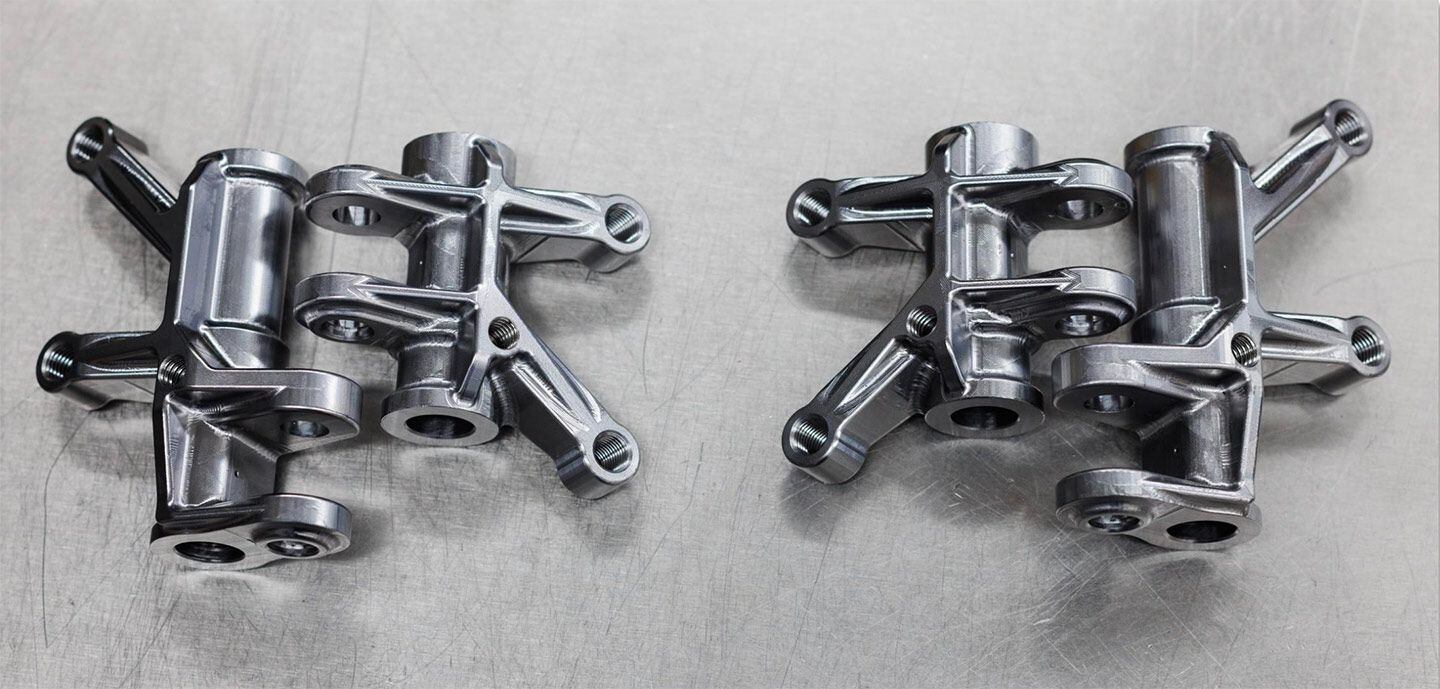
These manual lash adjustable rocker arms are machined from a solid chunk of steel. (Indian Motorcycle/)
Powering out of a corner on the Challenger feels akin to being strapped to a Boeing 747 at takeoff. You can feel the weight before momentum picks up and suddenly you’re eating up tarmac in such rapid fashion you can’t help but be impressed. An abundance of torque makes the bike feel almost easy to ride, and yet all the power Indian found means the bike keeps pulling right up to the rev limiter. Tapping said limiter while leaving pit lane served as a clue to always be watching the shift lights at the top of the AiM TFT dash display. The series of green, yellow, and red lights come quickly.
Massive torque and very large, single throttle body can make for a difficult-to-control motorcycle, especially at anything less than 50 percent throttle opening, thus a lot of time was dedicated to tuning the throttle map. The addition of a MaxxECU enabled Indian to take the next step in tuning. In its current state, the throttle feels sharp, but not overly aggressive. You want to have as much feel as possible when cracking the throttle on a 620-pound racebike with an astronomical amount of torque, and in this latest system Indian seems to have accomplished that—yet another testament to the time and effort this team has put into developing this bike. Even if it is hard to ride at photo speeds…
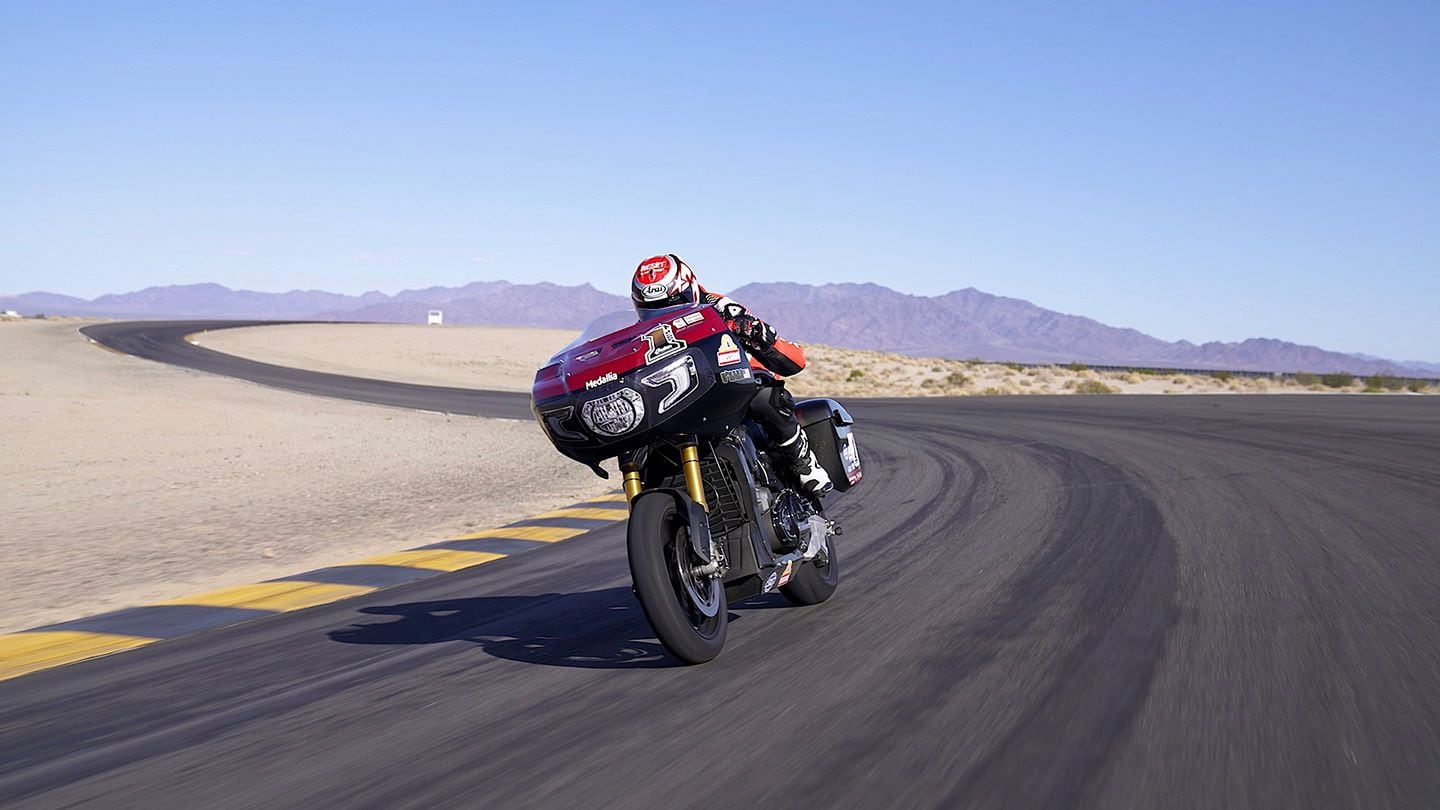
Indian says the outer fairing is an OEM piece of plastic pulled right from the production line. There are obvious modifications, such as the headlight insert, which helped with aerodynamics at tracks like Daytona. The beefy Öhlins fork is a modified version of the fork used on a Ducati Multistrada, though that’s being replaced for 2023. (Bert Beltran/)
Another interesting part of the powertrain is the transmission—it’s stock. And it works exceptionally well. Funny enough, this is one of the things we came into the test most concerned about. Touring bikes aren’t known for having the most seamless transmissions, and reports coming from media tests on Harley-Davidson’s Screamin’ Eagle Road Glide racebike—including Cycle World’s own Michael Gilbert—suggested that the transmission was a big weak point for H-D. Fortunately for Indian, that is not the case. Adding to the experience is a bidirectional quickshifter that’s tuned to absolute perfection.
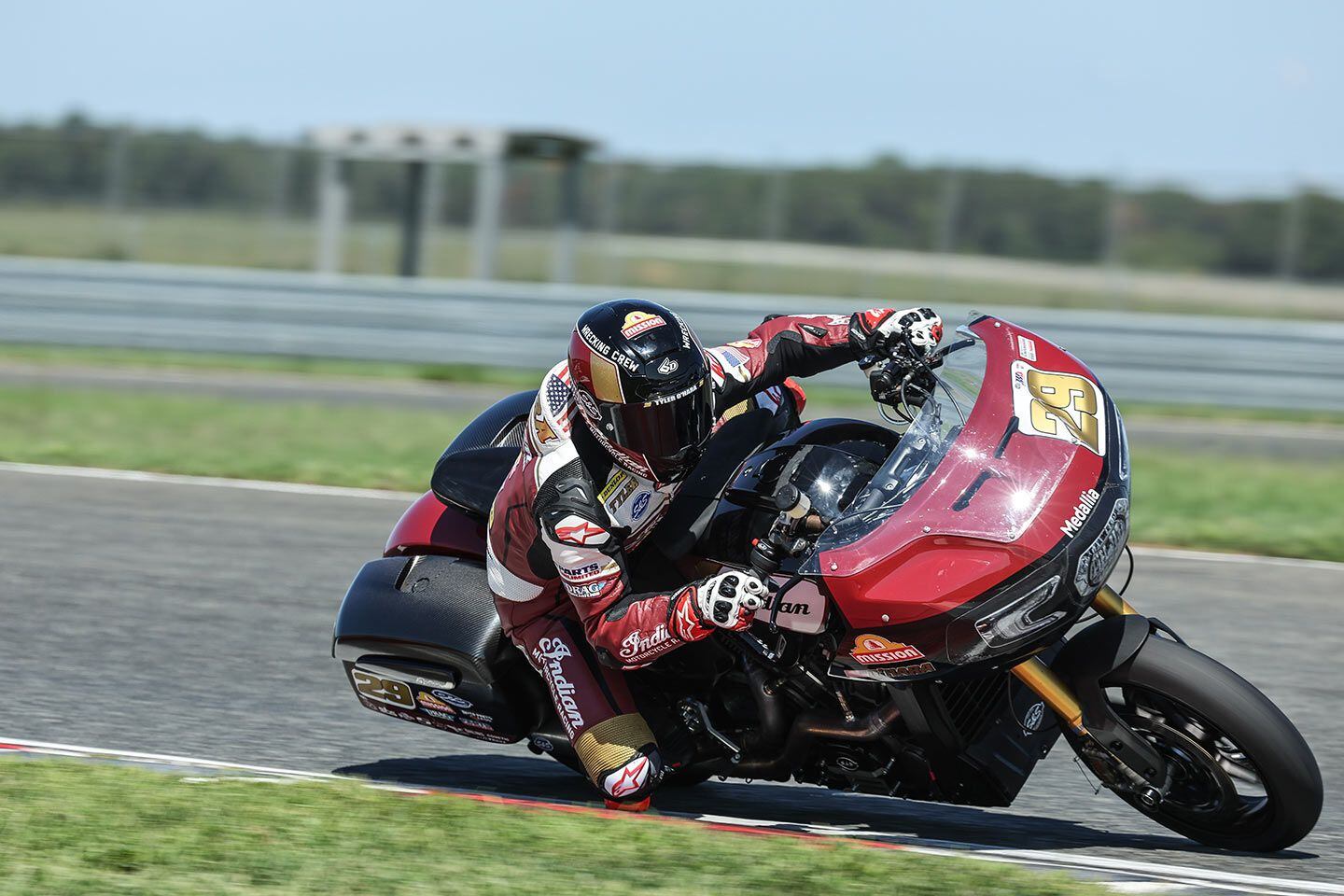
O’Hara’s ability to get the Indian Challenger around a racetrack as fast as he does is awe-inspiring. Kudos also to Indian for building a motorcycle that allows O’Hara (and teammate Jeremy McWilliams) to continue pushing the limits of what is possible on a bagger. (Brian J. Nelson/)
Glowing as all of these comments might be, it’s important to say that this is still a very difficult motorcycle to hustle around a racetrack. Not because of any performance limitations, but because of how truly unique it is and the mindset you must be in to push it to its maximum. We did not come anywhere near that limit in our short time with the bike, but at the pace we rode, it was a genuinely fun experience. What Tyler O’Hara, Jeremy McWilliams, and everyone else on the King of the Baggers grid is able to do on these motorcycles is astonishing.
Credit also goes to the Indian Motorcycle Racing team for continuing to push the limits in search of faster lap times. Their dedication to the project shows through in every part that was engineered, raced, and reengineered. How far this project goes is yet to be seen, but even in its current state, it’s clear that Indian’s built a true racebike. A very fast and very capable racebike.
Interested in experiencing the bike for yourself and have a rather massive chunk of change sitting around? Following our test, Indian announced that it will be selling the Challenger RR, a race replica Challenger with nearly identical build sheet to Indian’s racebike. All yours for “just” $92,229…
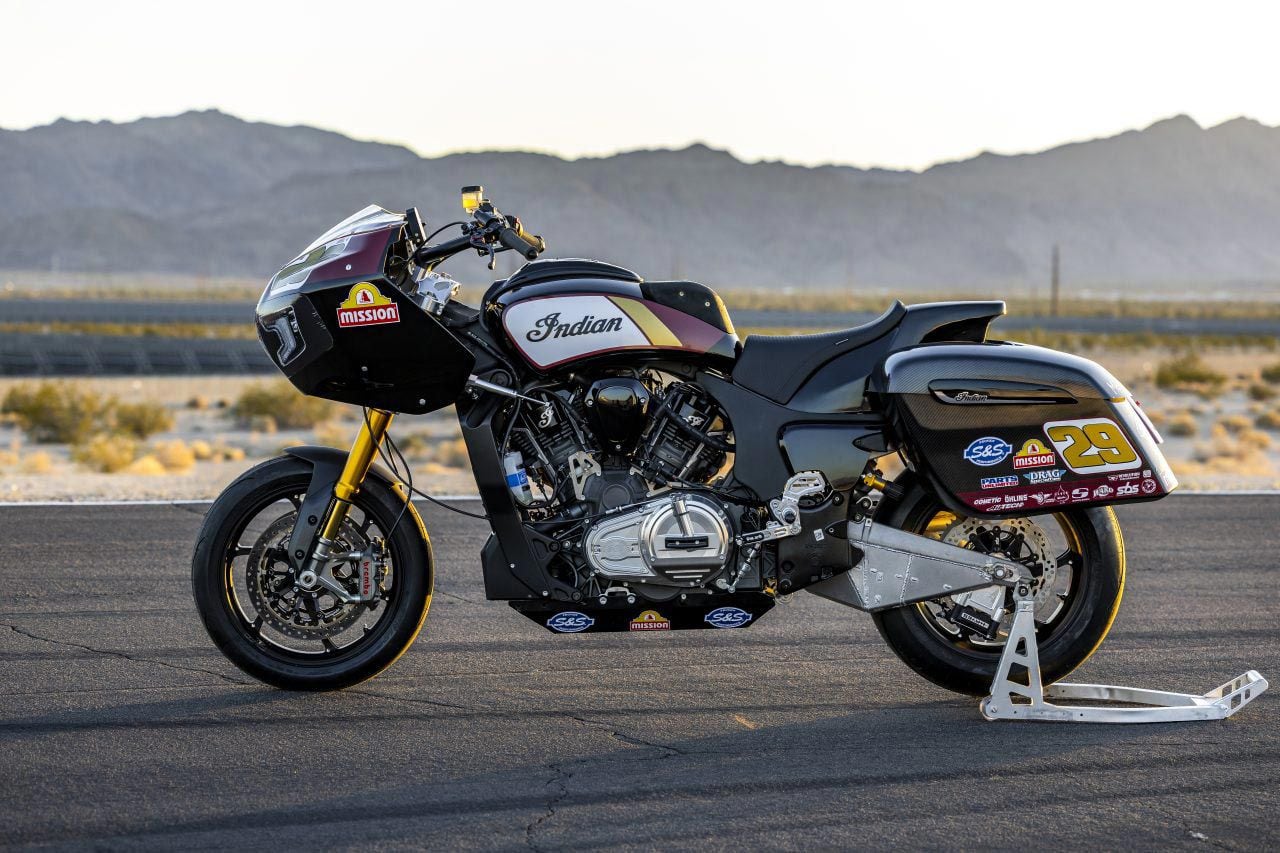
Replica or the real racebike? Shown here is Indian Motorcycle’s recently announced Challenger RR, which has a nearly identical build sheet to the bike that took O’Hara to the 2022 King of the Baggers championship. (Garth Milan/Indian Motorcycle/)
Gearbox
Helmet: Arai Corsair-X
Race suit: Rev’It Apex
Gloves: Rev’It Apex
Boots: Alpinestars Supertech R
]]>BMW has revealed the new R 12 nineT (left) and R 12 (right) models for 2024. (BMW/)
BMW dropped more than a couple of hints last year that we might see a midsize cruiser model joining its Heritage lineup, and wouldn’t you know, the brand is staying true to its word. Say hello to the new 2024 R 12 and R 12 nineT, which despite their word salad monikers, look to continue the clean lines of their R nineT predecessor.
With the original R nineT in 2013, BMW combined classic motorcycle design and modern tech with a host of customizing options. There’s now a whole family of these roadsters in the Heritage line, but any casual observer could see there was a big disconnect between them and the R 18 cruiser in terms of design language and configuration. The R 12 and R 12 nineT are here, apparently, to remedy the situation by carrying on the look and custom possibilities of their forebear, but with some key redesigns. Both bikes share the same 1,170cc boxer engine, but it’s hung from a new steel trellis frame with a bolted-on rear section, with a six-speed transmission and shaft drive to put down the power. Of the two, the R 12 nineT roadster hews to the same urban feel as the R nineT, while the R 12 configuration is more laid-back, embracing a relaxed, classic cruiser vibe.
Related: New BMW Cruisers

The new 2024 R 12 cruiser shares its boxer engine and new frame with the R 12 nineT, but rolls with a differently shaped steel tank and a more sedate engine tune. (BMW/)
2024 BMW R 12
Let’s dig into the shared elements first. Both bikes are powered by the same 1,170 air/oil-cooled boxer derived from the OG R nineT’s opposed twin, with the same bore and stroke, though it has been updated to meet emissions standards and also sports redesigned cylinder head covers. The airbox has been redesigned and relocated underneath the seat, and the exhaust has been tweaked as well. Both come equipped with a six-speed transmission and a hydraulic clutch, with shaft drive to lay down the power. Dynamic Traction Control and Engine Drag Torque Control also appear on the duo, as does the same braking arrangement; dual 310mm discs and radially mounted four-piston calipers up front, with a 265mm disc, two-piston caliper setup out back. BMW Motorrad ABS Pro is standard as is full LED lighting, keyless ride, USB and 12V power sockets, and adjustable hand levers.
Both bikes even look similar and share the same new one-piece steel trellis frame, which delivers a cleaner look and saves weight over the original R nineT’s two-piece unit. The steel trellis rear subframe is still a separate piece that’s bolted to the frame.

LED lighting comes standard on both bikes, but BMW says you can accessorize the new R 12 in a head-spinning number of ways. (BMW/)
There are telltale differences: The R 12′s steel tank has a unique shape, in homage to the “Toaster” tanks from ‘70s-era /5 models, and the wheels are more cruiser appropriate, with a 19/16 configuration that results in a slightly longer 59.8-inch wheelbase. Both bikes are spec’d with an upside-down 45mm fork, but the R 12′s is more basic and without the adjustability of the R 12 nineT unit, and the rake is lazier. Suspension travel is less too, with 3.5 inches available front and rear, which also contributes to a lower seat height. The R 12 sports a single round instrument panel, and the new exhaust layout has a different brushed finish on the rear muffler.
The mellower mill on the R 12 serves up 95 hp at 6,500 rpm and 81 lb.-ft. of torque at 6,000 rpm, less than its nineT counterpart, but more than enough for its intended purpose. You also get just two ride modes on the R 12—Roll and Rock (as on the R 18 models)—as opposed to the three on the R 12 nineT. Roll is the mellower of the two, while Rock uncorks more power thanks to more immediate throttle response and less invasive DTC.
You’ll be able to get the R 12 in Blackstorm Metallic or Aventurin Red Metallic. There’s also the Option 719 Thorium which features Avus Silver Metallic paint contrasted with yellow striping and gold colored handlebars. Pricing is to be announced.

The 2024 BMW R 12 cruiser in Aventurin Red Metallic and an accessory windscreen. (BMW/)

Although it also gets the new one-piece frame, the sportier R 12 nineT inherits most of its predecessor’s streetwise attitude, with more power, 17-inch wheels, and a taller seat than the R 12. (BMW/)
2024 BMW R 12 nineT
The R 12 nineT is the sportier of the two, both in the aesthetic sense as well as in the performance department. Edgar Heinrich, head of BMW Motorrad Design, explained the design team’s approach:
“The purist design language is dominated by the clear tank/seat/rear line, in the style of the traditional /5 or the legendary R 90 S of the ‘70s. At first glance, the tank itself is a classic BMW boxer tank, with a typical bend in the lower edge and classic knee contact.”

The 2024 R 12 nineT roadster offers adjustability on its 45mm fork, and gets a different tank than the R 12 cruiser, recalling /5 models of the ’70s. (BMW/)
All that plays out in the new aluminum tank which features brushed and clear-coated panels leading back to a tail hump, but the chassis elements differ too, with the R 12 nineT rolling on 17-inch cast alloy wheels front and rear, giving it a slightly shorter wheelbase than the R 12. Its 45mm fork is adjustable for rebound and compression and offers a more robust 4.7 inches travel, and is paired with a paralever swingarm linked to the rear shock which features rebound damping and spring preload adjustability.

Accessories galore are available for both models, including this mint Akro pipe. (BMW/)
The R nineT gets a performance boost as well, with a different engine tune that results in an impressive 109 hp available at 7,000 rpm and 85 lb.-ft. of torque at 6,500 rpm. You can tweak engine performance via three ride modes, with Rain, Road, and Dynamic on offer. The cockpit looks different too, with the R 12 nineT sporting dual round instruments, different handlebars, as well as smoked rear turn signals and a twin pipe exhaust system with chrome-plated pipes and front muffler along with a polished rear muffler.

The 2024 R 12 and R 12 nineT will be available early next year, says BMW, with pricing yet to be announced. (BMW/)
As with the R 12, there are a host of optional upgrades available, things like heated grips, Hill Start Assist Pro, Cruise Control, Option 719 packages, Shift Assist Pro, and a pile of other cosmetic, performance, and functional accessories.
The R 12 nineT will be available in Blackstorm Metallic and San Remo Green Metallic, both with gold-colored forks and black frames, or an Option 719 Aluminum in brushed aluminum with black fork, red frame, and a clear-coat brushed aluminum fuel tank with matching tail cover. The bikes will be available in early 2024, with pricing to be announced.
2024 BMW R 12 / R 12 nineT Specs
| MSRP: | NA |
|---|---|
| Engine: | DOHC, air/oil-cooled boxer twin; 4 valves/cyl. |
| Displacement: | 1,170cc |
| Bore x Stroke: | 101.0 x 73.0mm |
| Compression Ratio: | 12.0:1 |
| Horsepower (Claimed): | 95 hp @ 6,500 rpm / 109 hp @ 7,000 rpm |
| Torque (claimed): | 81 lb.-ft. @ 6,000 rpm / 85 lb.-ft. @ 6,500 rpm |
| Transmission/Final Drive: | 6-speed/shaft |
| Fuel System: | Electronic fuel injection |
| Clutch: | Dry, single disc; hydraulically operated |
| Frame: | Steel trellis bridge |
| Front Suspension: | 45mm inverted fork; 3.5 in. travel / 45mm inverted fork, fully adjustable; 4.7 in. travel |
| Rear Suspension: | Monoshock; adjustable rebound and preload 3.5 in travel / adjustable rebound and preload, 4.7 in. travel |
| Front Brake: | 4-piston radial-mount calipers, dual 310mm discs w/ ABS |
| Rear Brake: | 2-piston floating caliper, 265mm disc w/ ABS |
| Wheels, Front/Rear: | Cast; 19 x 2.75 in. / 16 x 4 in.; 17 x 3.5 in. / 17 x 5.5 in. |
| Tires, Front/Rear: | 100/90-19 / 150/80-16; 120/70-17 / 180/55-17 |
| Rake/Trail: | 29.3°/5.2 in.; 27.7°/4.4 in. |
| Wheelbase: | 59.8 in. / 59.5 in. |
| Seat Height: | 29.7 in. / 31.3 in. |
| Fuel Capacity: | 3.7 gal. / 4.2 gal. |
| Claimed Curb Weight: | 500 lb. / 485 lb. |
| Contact: | bmwmotorrad.com |
For 2024, Honda is bringing back the Rebel 1100T touring cruiser unchanged, save for this new matte green color. Prices start at $10,699. (Honda/)
While Honda was grabbing headlines at EICMA last week with its new CB Hornet and CBR1000 sportbike unveilings, Team Red’s American division quietly announced the return of several of its core cruiser models. Among them were the 1100T bagger and its base Rebel 1100 brother, as well as the stalwart entry-level Rebel 300 and 500 models all of them unchanged for the 2024 model year, except for new colors.
Honda also snuck in news of its returning chopper-style Fury cruiser, likewise unchanged but also wearing a funky new color. Let’s get into it.
Related: First Look: 2023 Honda Rebel 1100T Bagger

The standard Rebel 1100 is back as well, and is available in this Metallic Blue for an MSRP of $10,149 (DCT). (Honda/)
Honda Rebel 1100 and 1100T
The biggest Rebel returns in two trims, with the base 1100 rocking a six-speed manual transmission and the Rebel 1100 DCT sporting the automatic dual-clutch transmission. Neither bike gets mechanical changes or significant updates, just what Honda calls “contemporary colors,” for the new year.
The Rebel 1100 in either DCT or manual form can be had in Gray Metallic or Metallic Blue, with prices starting at $9,549 for the base model and $10,149 in DCT.
The closely related Rebel 1100T is back as well with two transmission options, and builds on the base model’s stripped-down approach by ladling on a few light touring amenities like a large half-fairing and hard color-matched saddlebags serving up 35 liters of room.
Both trims get the two fresh color options—which for Honda are definitely a departure from the usual red or black choices. The new Matte Armored Green Metallic gives the bagger more of a gritty street look, while the Metallic Black scheme adds a pair of new bronze wheels to offset the usual ebony tones for a performance vibe.
The Rebel 1100T DCT will have an MSRP of $11,349, and the manual Rebel 1100T will be priced at $10,699. All four 1100 bikes hit dealers in January 2024.

The 2024 Honda Rebel 1100 in Gray Metallic. Price is $9,549 for the standard version. (Honda/)

Green seems to be a popular color over at Corporate this year; the Rebel 500 gets it for 2024 as well. (Honda/)
Honda Rebel 500 and S
No surprise, Honda’s massively popular Rebel 500 is returning unchanged this year, but you can choose from three versions. The 500 middleweight keeps on keeping on with a user-friendly 471cc parallel-twin engine managed via a slipper/assist clutch, with its relaxed ergonomics making it a good fit for new and returning riders alike. The stripped-back, “bobber” style with tube steel frame is also unchanged, though you can choose from two new paint options for 2024.
New this year is a Matte Laurel Green Metallic which joins Pearl Black with bronze wheels; both the Rebel 500 and Rebel 500 ABS will be available in these colors. Riders can choose the Rebel ABS SE trim as well, which tricks out the base model with accessories like a headlight cowl, black fork gaiters, and a different seat. In the US, the ABS SE will be available in Pearl Smoky Gray for the 2024 model year.
Pricing starts at $6,499 for the non-ABS base model, with the 500 ABS going for $6,799 and the Rebel 500 ABS SE going for $6,999. All the bikes will be in dealers this January.

The Rebel 500 SE ABS returns for 2024 as well, but with a new-for-this-year Pearl Gray color. (Honda/)

The Honda Rebel 300 can be had in this funky Nitric Orange color this year. (Honda/)
Honda Rebel 300
Honda says it’s “approachable and fun,” and honestly, that’s not too much of an exaggeration for the smallest Rebel. The sorta-cruiser but modern styling has recognizable cues like a peanut fuel tank, solo seat, and blacked-out engine components, but it also has its own identity. This year the 286cc single-powered machine is back in standard and ABS versions in two colors: Pearl Black (no bronze wheels here) and Nitric Orange, with prices starting at under $5,000.
The Rebel 300 ABS is priced at $5,149 while the Rebel 300 has an MSRP of $4,849.

The 2024 Honda Rebel 300 in Pearl Black. MSRP is $4,849 for the base non-ABS model. (Honda/)

Behold the 2024 Honda Fury, resplendent (?) in Adventure Green. (Honda/)
Honda Fury
It may look a lot different from previous models, but there’s nothing new on the 2024 Fury either—except for the definitely different, new Adventure Green paint job.
The longest current-model Honda we can think of measures 71 inches between the wheels and has a 32 degree rake on the front end, while keeping up appearances with hardtail styling. Despite all that, it handles better than you think, and the 1,312cc V-twin engine is liquid-cooled and fuel injected for modern reliability and a more than adequate punch. All the usual cruiser cues like forward controls, a low 26.9-inch seat, a shapely stretched-out 3.4-gallon tank, and a five-speed transmission can be found here as well, though honestly—who expects shaft drive on a chopper? Yes, there is a rear shock Virginia, and it’s even adjustable for rebound and preload, but travel is a mere 3.5 inches. The nonadjustable 45mm fork, though, gets a reasonable 5.1 inches of travel.
Honda’s custom-style outlier has somehow hung around in the streetbike lineup pretty much unchanged since its 2010 reveal, getting just the usual annual color swaps. And for 2024 it’s more of the same; no changes except for the new Adventure Green paint on the fenders and tank. Sticker price is $11,499—the same as last year—and the bike will be available in December.
]]>Indian rolls out the upgraded 2024 Challenger Elite bagger featuring new Charcoal Candy/Candy Black paint and a completely redesigned audio system. (Indian Motorcycle/)
Indian has released its new model announcements for 2024, and the big news on the list is the new 2024 Challenger Elite, a limited-edition bagger that sits at the top of its ultra-premium Elite series. Actually, can we even call it a series anymore? The press release mentioned no other Elite models (Indian’s website shows a Pursuit Elite and Chieftain Elite but we’re told those aren’t 2024s) so it looks like the Challenger Elite is the sole representative this year, with what’s being called “a sinister blacked-out performance look,” a revamped seat, and most importantly, Indian’s redesigned PowerBand audio system. The bike will be limited to 325 units worldwide.

The limited-edition Challenger Elite will have only 325 units available worldwide. MSRP is $38,499. (Indian Motorcycle/)
First up is the new Charcoal Candy/Candy Black paint job, which starts with black candy color applied over a charcoal metallic paint. An acid-etched silver graphic flows from front to back on the fairing, tank, and bags, with a contrast red stripe outline for impact. Redline badges, stitches on the seat, and even the wheels carry the same red theme. Below those styling refinements, though, you’ll still find the excellent foundation of the base Challenger, with a 108ci liquid-cooled PowerPlus engine good for a claimed 122 hp and 128 lb.-ft. of torque along with an aluminum frame, chassis-mounted fairing, and a full complement of luxury touring amenities.
Related: 2022 Indian Challenger Elite and Chieftain Elite First Look

The 1,768cc liquid-cooled PowerPlus engine gets a darker charcoal tone and special Elite badging, while the seat carries new stitching as well. (Indian Motorcycle/)
As with all Elite models there’s no shortage of creature comforts on the Challenger version, which rocks an adaptive LED Headlight, LED driving lights, an adjustable flare windscreen, driver and passenger floorboards, heated grips, saddlebag lights, saddlebag closeouts, and three selectable ride modes including Tour, Standard, and Sport. Then there’s the slick, electronically adjustable Fox rear suspension, which comes standard on the Challenger Elite and allows riders to adjust the preload right from the bike’s infotainment system.

Redesigned PowerBand audio includes eight revised speakers that now feature accent LED lighting and a new look. (Indian Motorcycle/)
That infotainment setup should come as no surprise either, with the familiar 7-inch touchscreen powered by Indian’s Ride Command system taking center stage and offering Apple CarPlay integration, turn-by-turn navigation, Bluetooth connectivity, and more. Riders can access the bike’s IMU-enabled Smart Lean Technology from here as well to tune traction control and ABS or select ride modes (Rain, Standard, or Sport). Backlit switch cubes help you spot crucial control functions at night while the Pathfinder Adaptive LED headlight and LED driving lights serve to illuminate nighttime cruises, and an adjustable tinted flare windshield up front can be raised or lowered with the push of a button.

The new audio system uses Ride Command on the 7-inch display to access amplifiers and a nine-band equalizer for higher volume and better clarity at speed. (Indian Motorcycle/)
But the main upgrade Indian is pushing on the Elite is its completely redesigned PowerBand audio system featuring four 100-watt speakers, two fairing speakers, and two saddlebag speakers. It comes standard exclusively on the Challenger Elite, though it’s available as an upgrade on the other Challenger models. The system leverages Ride Command to operate a cluster of built-in amplifiers, a nine-band equalizer, and 16 speakers to deliver what Indian says is “better sound clarity at speed.”
The 100-watt speakers are said to produce higher volume, clearer tones, and 50 percent more bass via the new Bass Boost Tune. New Dynamic EQ optimizes tunes for the highest-quality audio as conditions change, and the speakers are also redesigned for a more modern look, as well as getting new UnderGlow LED accent lighting.
The company says it’s the “loudest audio in Indian Motorcycle history,” with riders able to take the system up to 800 watts; the new PowerBand system can be easily installed on 2020–2024 models or owners can get the Bass Boost Tune software upgrade at the local dealership.

The Challenger Elite also comes standard with a Pathfinder Adaptive LED headlight and LED driving lights integrated into the lower fairings. (Indian Motorcycle/)

Rider and passenger floorboards feature a new headdress design this year. (Indian Motorcycle/)
Other returning Challengers for 2024 include the base-model Challenger, the Challenger Dark Horse, and the Challenger Limited, though they’re mostly unchanged except for new colors and pricing.
The 2024 Indian Challenger starts at $26,499 and will be available in either Black Metallic or Titanium Smoke.

The 2024 Indian Challenger Limited is unchanged this year but has new color options. (Indian Motorcycle/)
The 2024 Indian Challenger Limited has a starting MSRP of $29,999 and is available in Black Metallic, Ghost White Metallic, or Sunset Red Metallic colors.
The 2024 Indian Challenger Dark Horse rolls in at $30,999 to start, with color options including Black Smoke; Sunset Red Smoke; Spirit Blue Smoke; Sunset Orange (Icon); Storm Gray (Icon); Black Metallic over Smoky Quartz Metallic Pearl (Icon).

The Challenger Dark Horse is also the same mechanically as last year’s model; MSRP starts at $30,999. (Indian Motorcycle/)
The 2024 Indian Challenger Elite starts at $38,499 and comes only in the custom-inspired Charcoal Candy/Candy Black color. All the bikes will start shipping to Indian dealers in the US and Canada this month. More info can be found at indianmotorcycle.com.
2024 Indian Challenger / Challenger Elite Specs
| MSRP: | $26,499–$38,499 |
|---|---|
| Engine: | 1,768cc, liquid-cooled, 60-degree V-twin |
| Bore x Stroke: | 108.0 x 96.5mm |
| Compression Ratio: | 11.0:1 |
| Claimed Horsepower: | 122 hp |
| Claimed Torque: | 128 lb.-ft. @ 3,800 rpm |
| Transmission/Final Drive: | 6-speed/belt |
| Fuel Delivery: | Closed-loop electronic fuel injection w/ 52mm throttle bodies |
| Clutch: | Wet, multiplate w/ assist |
| Front Suspension: | 43mm telescopic fork; 5.1 in. travel |
| Rear Suspension: | Fox shock, hydraulically adjustable preload, 4.5 in travel; Fox shock, electronically adjustable preload; 4.5 in. travel |
| Front Brake: | 4-piston calipers, dual 320mm semi-floating discs w/ ABS |
| Rear Brake: | 2-piston caliper, 298mm floating disc w/ ABS |
| Wheels, Front/Rear: | 5-spoke cast; 19 x 3.5 in. / 16 x 5 in. / (w/ tire pressure monitoring) |
| Tires, Front/Rear: | Metzeler Cruisetec; 130/60B-19 / 180/60R-16 |
| Rake/Trail: | 25.0°/5.9 in. |
| Wheelbase: | 65.7 in. |
| Ground Clearance: | 5.4 in. |
| Seat Height: | 26.5 in. |
| Fuel Capacity: | 6.0 gal. |
| Claimed Dry Weight: | 796 lb. / 804 lb. |
| Contact: | indianmotorcycle.com |
Triumph calls on its in-house paint shop to work its magic once again for the eight Bonneville Stealth Edition models. (Triumph/)
If you’re a manufacturer with a well-respected paint shop already set up in-house, you might as well get the most you can out of it, right? So goes the thinking (we imagine) over at Triumph Motorcycles, which seems to have found a winning formula in issuing limited-edition versions of its Classics line, each sporting high-zoot new paint jobs. We’ve seen the Gold Line Editions, Chrome Editions, and now, the latest series sporting dramatic hand-finished custom colors, the Bonneville Stealth Editions.
The limited-edition Stealth models will be available for one year only, starting in 2024, and look to showcase a dramatic new paint technique from Triumph’s paint team. The process starts with a mirror-finish silver base coat, and a carefully layered Sapphire Black graphite vignette goes over that, transitioning from a dark to light tone front to back. The final touch is a translucent tinted lacquer applied in several layers for a deep top coat. According to Triumph, the paint looks different from every angle, and pops especially when exposed to light in varying hue and tone. Because the paint is applied by hand, that means there are subtle variations, “making every motorcycle truly unique.”
But while all the bikes look far more sophisticated under a new coat of paint, there are no mechanical or cosmetic changes to these 2024 editions; after all, most of the Bonneville platform received a major update in 2022, with some models also renamed.
Triumph says orders can be placed now at dealers, with units arriving in dealerships by February 2024.
Related: Triumph Announces Cruiser and Modern Classic Models for 2023

The Bonneville Speedmaster Red Stealth Edition keeps its 1,200c engine but gets an intense new red design. (Triumph/)
Bonneville Speedmaster Red Stealth Edition | from $13,795
Triumph’s classic cruiser gets a truly vibrant pop in Stealth Edition guise. The fat tires with spoke wheels, comfortable, laid-back ergos, and smooth liquid-cooled 1,200cc parallel twin remain, but there’s a bit more attitude now, thanks to the rich red color contrasting with its black powdercoated cylinder heads and premium metal badges.

The Bonneville Bobber Purple Stealth Edition plays on the bike’s stripped-back style with a deep purple color. (Triumph/)
Bonneville Bobber Purple Stealth Edition | from $14,595
That unmistakable fat front wheel and chunky 47mm fork will always betray the Bonneville Bobber’s muscular presence. But despite its looks—along with a solo seat and rigid-looking rear suspension—this bobber is far more rider-friendly than you’d think with an adjustable seat, adjustable traction control, dual riding modes, and electronic cruise control. Dip it in a vibrant purple color, and all bets are off.

The T100 classes it up with a rich blue tone on the tank to contrast with its blacked-out bits. The bike’s easy-handling, responsive 900cc engine is unchanged. (Triumph/)
Bonneville T100 Blue Stealth Edition | from $11,745
Accessible and easy handling was always a hallmark of the Bonneville series, and the T100 keeps things as they were, with a 900cc engine that’s easygoing but punchy when you need it to be. The rich Sapphire Blue tones against the rest of its blacked-out components give it a classier vibe, but the T100 Blue Stealth still has the latest-generation ABS and switchable traction control.
Related: 2022 Triumph Bonneville Gold Line Edition Photo Gallery

The higher-spec T120 Blue Stealth gets the same paint treatment, but rolls with a 1,200cc engine and more premium components. (Triumph/)
Bonneville T120 Blue Stealth Edition / Black Stealth Edition | from $13,495
The Bonneville T120 Blue Stealth Edition brings the same spec as the base model, with preload-adjustable rear suspension and Brembo front brake calipers with ABS. The 1,200cc twin engine also delivers the same healthy 80 hp at 6,550 rpm; it’s just finished in Sapphire Blue/Silver Blue or Matt Silver Ice/Matt Sapphire Black in Stealth form, and gets a slight boost in price. The T120 Black Stealth Edition’s tank fades to silver at the back, and the limited-edition model also retains the other blacked-out details like wheel rims, fenders, engine covers, handlebars, headlamp, and exhaust.

Along with a ripping 100 hp, 1,200cc engine, the Speed Twin 1200 Stealth brings a vivid candy red paint that gleams in the light. (Triumph/)
Speed Twin 1200 Red Stealth Edition | from $13,695
The 1,200cc high-power parallel twin is a popular choice across the Bonneville series, and with a strong and linear power delivery, topping out at 100 hp here, it’s easy to see why. The brushed stainless steel megaphone twin mufflers add style and tone, and in Stealth form, the Speed Twin’s Sapphire Red/Silver Red tones give it even more presence.

The Speed Twin 900 Green Stealth Edition gets a lovely Sapphire Green/Silver Green color combo. (Triumph/)
Speed Twin 900 Green Stealth Edition | from $10,645
The Speed Twin 900 Green Stealth Edition gets a standout deep green tank design that sort of reminds you of a lovely British racing color of yore, though it is unique enough to give the smaller Speed Twin its own identity. Otherwise you get the familiar 900cc Bonneville twin engine, cast wheels, ride modes, and an appealing custom-inspired classic look.

The Scrambler was always a looker, and in 2024 you can opt for the Scrambler 900 Orange Stealth Edition. (Triumph/)
Scrambler 900 Orange Stealth Edition | from $12,245
With its unique frame, sit-up style, and mid-mount controls, the Scrambler always seemed like an outlier in the Bonneville family, but then that along with its custom style and good looks are what made it so appealing. For 2024, the Scrambler 900 Orange Stealth Edition ups the ante with a deep orange shade option.

Detail of the Bonneville T120 Black Stealth Edition tank. (Triumph/) ]]>
Honda is bringing back the Honda Gold Wing base model (manual and DCT versions) in a new Matte Armored Green color for 2024. (Honda/)
Honda’s European arm usually trumpets its new model year bikes well before the North American region has its say, but this time, American Honda announced the return of its luxurious Gold Wing and Gold Wing Tour flagships right on the heels of the UK release. None of the models see any mechanical changes for model year 2024, and are just updated with what the company calls “contemporary” color schemes.

The top-of-the-line 2024 Honda Gold Wing Tour Airbag DCT will come in this Pearl White color and also sees no changes. (Honda/)
2024 Honda Gold Wing DCT, Gold Wing Tour DCT, Gold Wing Tour Airbag DCT
As we know, the luxury tourer was almost completely redesigned for the 2018 model year, dropping a pile of weight and getting a double wishbone front suspension as well as a reworked flat six-cylinder engine. The changes instantly broadened its appeal, and further improvements to suspension, electronics, audio and rider conveniences in subsequent years helped evolve the big Wing further. All of which is to say that for 2024, the venerable Wing is essentially unchanged, but you’re still getting a feature-packed spec sheet, with a seven-speed DCT transmission, a 7-inch TFT screen, navigation, Apple CarPlay, Android Auto, an adjustable electric windscreen, Smart Key operation, four riding modes, traction control, Hill Start, and more. The Gold Wing Tour variant adds a rear luggage box with integrated backrest and even more comfort features.
For 2024 the big Wing is returning in top-of-the-line Gold Wing Tour Airbag DCT form, with a $33,000 MSRP and will be available in Pearl White.
The Gold Wing Tour in both DCT and manual forms is back as well, in Gray Metallic/Black or Pearl White options for $29,700 and $28,700, respectively.
The base-model Gold Wing and Gold Wing DCT, however, do feature a new color for 2024; both are available in Matte Armored Green Metallic, with brown detailing on the engine cases. The base Wing rings in at $24,700, and the DCT version at $25,700.
The bikes will be in dealers November, 2023.
Related: Honda’s Bringing Back the Gold Wing for 2023

The Gold Wing Tour returns with both DCT and manual transmission options and will get this Gray Metallic color. (Honda/)

Full-featured 7-inch screen allows access to navigation, Apple CarPlay, Android Auto, four riding modes, traction control, Hill Start, and more. (Honda/) ]]>
The Super Meteor 650 is Royal Enfield's flagship model. (Josh Shipps/Klings/Royal Enfield/)
Royal Enfield’s Super Meteor 650 may be the most significant motorcycle to ever come out of India. Its classic styling, impressive performance, and excellent build quality exhibit where Royal Enfield has been, where it is, and where it’s going. The Super Meteor’s classic styling pays homage to the brand’s original cruisers such as the 1952 Meteor and 1956 Super Meteor. Its 648cc parallel twin maintains the thumpy character that we have come to love in the INT650 and Continental GT 650. And the impressive fit and finish of the Super Meteor 650 represents a new standard for Royal Enfield.

The Royal Enfield Super Meteor 650 model lineup. (Josh Shipps/Klings/Royal Enfield/)
2023 Royal Enfield Super Meteor 650 Overview
The Super Meteor 650 is a retro-styled middleweight cruiser designed to be as accessible as it is functional, while delivering a relaxed stance. Starting MSRP is a class-best $6,999, but that’s the only thing “cheap” about this cruiser. Everything else is top-notch. Designed around Royal Enfield’s sweet parallel twin, the Super Meteor 650 slots nicely into the middleweight cruiser class, competing against models such as the Kawasaki Vulcan S and the Honda Shadow line. And even if it’s smaller in displacement and stature than the discontinued Harley-Davidson 883 Sportster, it is definitely a candidate for filling the void left by that American V-twin.

The Royal Enfield Super Meteor in Astral Black ($6,999). (Josh Shipps/Klings/Royal Enfield/)
The SOHC fuel-injected engine has a 78.0 x 67.8mm bore and stroke and four valves per cylinder working with a 9.5:1 compression ratio. The engine produces a claimed 46.4 hp and 38.6 lb.-ft. of torque. For reference, we had the 2022 Royal Enfield INT650 on the Cycle World in-house Dynojet 250I dyno last year and recorded 40.9 hp at 6,800 rpm and 37.4 lb.-ft. of torque at 5,100 rpm at the wheel. The Super Meteor 650 has a different intake and exhaust system that results in slightly different power delivery, says R-E, but we expect similar results on our dyno.

Royal Enfield's 648cc parallel twin is full of character, thanks in part to its 270-degree crankshaft that gives the engine a 90-degree V-twin sound. Impressive low-end grunt is followed by strong midrange pull and solid high-rpm performance. (Josh Shipps/Klings/Royal Enfield/)
The Super Meteor has an all-new chassis designed by famed British chassis specialists Harris Performance, owned by Royal Enfield since 2015. The tubular-steel frame helps achieve both a low center of gravity and a low seat height of 29.1 inches. Rake is 27.6 degrees, trail 4.7 inches, definite steps to the relaxed side from the Continental GT and INT 650′s 24.0/4.1 figures. The Super Meteor’s wheelbase is 59.1 inches, 4 inches longer than that of the Conti/INT. This all helps set the tone for the stance of the bike, increases stability, while the wheelbase in particular makes more room for a passenger. (Read Technical Editor Kevin Cameron’s story about wheelbase and chassis geometry here if you’d like to learn more.) Tires are 100/70-19 front, 150/80-16 rear, mounted to tubeless alloy rims.
A nonadjustable 43mm Showa Big Piston inverted fork (the first used by R-E) provides 4.7 inches of travel and twin shocks with five-step adjustable preload offer 4.0 inches of travel.
A set of tubeless alloy rims in conjunction with a centerstand are a testament to the Super Meteor’s sincerity as a long-distance cruiser. And with the addition of a windscreen, deluxe touring seat, and pillion backrest for the Celestial variant ($7,499), the Super Meteor 650 is tailor-made for cruiser touring despite its middleweight displacement.

Whether your journey takes you across town or across the county, the Super Meteor 650 is comfortable for miles on end. (Josh Shipps/Klings/Royal Enfield/)
Available safety equipment includes non-switchable ABS. No other electronic intervention or ride modes are present, maintaining a classic experience that is felt throughout the entire motorcycle. A retro-themed instrument panel utilizes an analog speedometer with a digital information screen displaying a fuel gauge, gear position indicator, tripmeters, and a clock. The Super Meteor 650 also features Royal Enfield’s Tripper turn-by-turn navigation pod. Riders can link to the navigation pod via Bluetooth through their smartphone. Further adding to the visceral feel of this Royal Enfield is a mechanical throttle cable that provides a solid, analog connection between rider and machine.

The Super Meteor 650 is the first Royal Enfield motorcycle to receive an LED headlight. (Josh Shipps/Klings/Royal Enfield/)

The Super Meteor 650 Tourer comes with a windscreen, deluxe touring seat, and a pillion backrest. (Josh Shipps/Klings/Royal Enfield/)
The Royal Enfield Super Meteor 650 is available in three variants: Astral ($6,999), Interstellar ($7,299), and Celestial ($7,499). The Astral model comes in three color options (green, black, and blue). The Interstellar features a two-tone paint scheme in two colors (green or gray), and the Super Meteor 650 Tourer is available in Celestial Red or Celestial Blue and features a windscreen, deluxe touring seat, and pillion backrest. Adding to the bike’s iconic cruiser styling is the 4.2-gallon teardrop fuel tank with a metal gas cap. LED lighting, a first for Royal Enfield, is standard on all.
Royal Enfield has a gamut of Genuine Motorcycle Accessories for the Super Meteor 650 which include the windscreen, the deluxe touring seat, the pillion backrest, and a range of other accessories including engine guards, footpegs, mirrors, and LED turn indicators.
2023 Royal Enfield Super Meteor Riding Impression

The fit and finish of the Super Meteor 650 is like nothing we've seen before on a Royal Enfield. The craftsmanship is comparable to a Triumph motorcycle. (Josh Shipps/Klings/Royal Enfield/)
Swinging a leg over the middleweight cruiser for the first time, the quality of the Super Meteor 650 becomes abundantly clear. From the cockpit, the fit and finish of this Royal Enfield is reminiscent of Triumph’s lauded detailing. The sparkle paint is deep, rich, and without blemishes. At the controls, the switch cubes are surrounded by plated aluminum and the levers are adjustable. Fire up the 648cc parallel twin and the rider is greeted with a soft rumble. The cable-actuated clutch has a great feel and a broad, easy-to-manage engagement range. Its pull is not overly strenuous but strong enough to deliver positive feedback.

Royal Enfield’s Super Meteor 650 utilizes the same 648cc parallel twin as the INT650 and Continental GT 650. (Josh Shipps/Klings/Royal Enfield/)
The 650 twin generates plenty of usable torque down low—essential for a cruiser. And, because it’s so readily available, riding a gear high is easy and you don’t sacrifice much get-up-and-go. Rev the engine out for passing, and the Super Meteor continues to perform. Running the engine high into the rpm range does not generate any uncomfortable buzzing and the power continues to pull. At one point on the ride, the Super Meteor 650 was traveling north of 90 mph and it easily could have gone more.
As we made our way out of Dallas before entering the highway, the Super Meteor’s ability to cruise through town in any gear is impressive. Pulling away from a stoplight, I could short-shift up to fourth gear and cruise effortlessly at speeds as low as 20 mph. Clicking through the gearbox, the shifts are quick and decisive whether the clutch is used or not.

On the Super Meteor 650 Tourer, the windscreen (available on Astral and Interstellar models through Genuine Motorcycle Accessories) provided plenty of wind protection for my body, but generated a lot of buffeting around my helmet. (Josh Shipps/Klings/Royal Enfield/)
Traversing through the urban sprawl of Dallas, the suspension provides a stable, precise ride. The nonadjustable suspension settings (preload adjustment on the twin shocks) are taut which allows the bike to maintain a neutral ride despite external forces being applied to the chassis. Grabbing a handful of gas or brake does not make the Super Meteor 650 wallow or seesaw. The 43mm Showa Big Piston Fork offers plenty of holdup when contacting uneven surfaces and provides ample bottoming resistance.
At the rear, the twin shocks are oversprung for a middleweight cruiser. Their stiff spring rate makes the shock ride up in the stroke despite being set on the lowest preload setting. Hitting unexpected bumps in the road can be jarring at the rear, popping my 125-pound frame out of the seat. Some may find this discomforting but I much prefer a bike to be too stiff than too soft.

Cruising lakeside on the Super Meteor 650 in Astral Green. The British racing green paint color is fitting for a brand with so much lineage to the UK. (Josh Shipps/Klings/Royal Enfield/)
Handling is relaxed and neutral, but if needing to make a quick maneuver, an aggressive input into the wide handlebar will quickly change the trajectory of the motorcycle. We did not find any twisty roads near Dallas, despite trying, but on freeway on-ramps, the Super Meteor 650 easily rolls onto the side of the tire and maintains its lean angle quite comfortably. Coming into corners, initiate the lean angle and maintain it with the throttle before mashing the gas and standing the bike up upon exit. If the roads stayed twisty, the Super Meteor would dance all day.

Leaning through one of the few curves available on a backroad near Dallas. (Josh Shipps/Klings/Royal Enfield/)
Traveling on straight roads, the Super Meteor 650′s open rider triangle is comfortable cruising for miles on end. Forward controls, a low seat, and a wide handlebar put the rider in a classic cruiser stance. Sit back, put your feet up, and let the time tick by; the only thing this cruiser needs for easier cross-country travel is cruise control.
The ByBre brake system utilizes a single 320mm front disc with a twin-piston floating caliper. A 300mm disc with a twin-piston floating caliper slows the rear wheel. Both brakes feature a dual channel ABS system. Throughout our ride, we did not encounter any hard braking zones. But when testing stopping performance in a straight line, the brakes will quickly shed speed and with a hard enough pull the ABS system will activate.
2023 Royal Enfield Super Meteor 650 Conclusion

The classic styling of the Super Meteor 650 gives the motorcycle a timeless appearance. (Josh Shipps/Klings/Royal Enfield/)
The Super Meteor 650 is a benchmark for Royal Enfield moving forward. In this new middleweight cruiser, Royal Enfield has delivered a level of quality we have not seen from it before. It’s not just “good for a Royal Enfield.” Starting at $6,999, this classic cruiser offers quality craftsmanship, a versatile engine, comfortable ergonomics, and a three-year unlimited-mile warranty with roadside assistance. Any rider entering the middleweight cruiser market must consider the Super Meteor 650.

The Royal Enfield Super Meteor 650 in Interstellar Grey ($7,299) features a two-tone paint scheme whereas the Astral models are solid colors. (Josh Shipps/Klings/Royal Enfield/)

The Super Meteor 650 is by far the most stylish cruiser in its class. (Josh Shipps/Klings/Royal Enfield/)
2023 Royal Enfield Super Meteor 650 Specs
| MSRP: | $6,999–$7,499 |
|---|---|
| Engine: | SOHC, air/oil-cooled, 4-stroke parallel twin |
| Displacement: | 648cc |
| Bore x Stroke: | 78.0 x 67.8mm |
| Compression Ratio: | 9.5:1 |
| Transmission/Final Drive: | 6-speed constant mesh/chain |
| Claimed Horsepower: | 46.39 hp @ 7,250 rpm |
| Claimed Torque: | 38.57 lb.-ft. @ 5,650 rpm |
| Fuel System: | Electronic fuel injection |
| Clutch: | Wet, multiplate |
| Frame: | Steel tubular spine |
| Front Suspension: | 43mm inverted Showa Big Piston; 4.7 in. travel |
| Rear Suspension: | Twin shocks, preload adjustable, 4.0 in. travel |
| Front Brake: | 2-piston floating caliper, 320mm disc w/ ABS |
| Rear Brake: | 2-piston floating caliper, 300mm disc w/ ABS |
| Wheels, Front/Rear: | 19 in./16 in. |
| Tires, Front/Rear: | 100/90-19 / 150/80-16 |
| Wheelbase: | 59.0 in. |
| Ground Clearance: | 5.3 in. |
| Seat Height: | 29.1 in. |
| Fuel Capacity: | 4.2 gal. |
| Claimed Weight: | 531 lb. w/ 90% fuel & oil |
| Contact: | royalenfield.com |
Gearbox
Helmet: Arai Regent-X
Jacket: Spidi Garage
Gloves: Spidi Garage
Pants: Spidi J-Tracker Denim Pants
Boots: Rev’It Grand Shoes
]]>Triumph is sending off its flagship cafe racer with one last bang—the 2025 Thruxton Final Edition. (Triumph/)
Some of you may be inclined to shed a tear as word comes that Triumph’s signature cafe racer, the Thruxton, is no more. Or at least, it won’t be after the 2025 model year, as the Brit brand has announced the end of the bike’s production run next year. But at least the iconic model will be going out with a bang and not a whimper; behold the 2025 Thruxton Final Edition, a lavishly finished love letter to what some have called one of the best factory cafe racers around.

The Thruxton FE is based on the Thruxton RS model but tarts it up with a custom Competition Green paint job, special branding, and model-specific logos. (Triumph/)
The end comes after 20 years on the Hinckley assembly line, with the Thruxton’s final production run scheduled for 2024—though in reality, the Thruxton has been around on and off since 1964. To send off the award-winning flagship cafe racer, Triumph has unveiled the Thruxton Final Edition, a special-edition model sporting what it calls “incredible specification, performance, capability, and timeless style.”
In current form the bike is based on the up-spec Thruxton RS, which debuted three years ago with fully adjustable Showa USD fork, twin Öhlins piggyback shocks, and Brembo M50 monoblock brake calipers. The bike rolls on lightweight 17-inch aluminum 32-spoke wheels fitted with Metzeler Racetec RR tires aimed for sure-footed stability.
Those premium components act in the service of a 1,200cc Bonneville engine, tuned and mapped specifically for the Thruxton to be the punchiest in the Modern Classics line, with a claimed 103 hp at 7,500 rpm and 82 lb.-ft. of torque hitting at 4,250 rpm. Managing all that grunt are switchable rider modes, traction control, and ABS, with twin clocks to provide info. And the engine externals also carry through on the Thruxton’s signature cafe racer styling, with black powdercoated engine covers, cam cover finishes, and anodized black wheel rims. Even in stock form, she’s a beauty.
Related: 2016 Triumph Thruxton and Thruxton R: Overview

The 2025 Thruxton FE carries on the cafe racer styling with clip-ons and bullet seat, and retains premium Showa and Öhlins components from the RS. (Triumph/)
The special edition piles onto that RS spec sheet with a host of premium finishes and rich detailing for what Triumph says will be a limited-edition motorcycle, though the brand isn’t specifying how many units will be produced. We do know the bike will be strikingly finished in an exclusive Competition Green metallic paint scheme, complete with hand-painted gold lining; the paint is meant to celebrate the Thruxton’s racing heritage with a classic Triumph logo and matching gold-line detailing on the sculpted fuel tank and seat cowl. The rich, deep green is set against the lustrous black side panels and fenders, with the panels showcasing an exclusive Thruxton Final Edition logo.
Otherwise, all the other trademark Thruxton details carry over on the FE, from the single bullet seat and Monza-style fuel filler cap to the brushed stainless steel tank strap, clear anodized aluminum swingarm, and clip-on handlebars.

Rear view of the 2025 Thruxton FE shows details like the stainless tank strap, dual gauges, and rear cowling. (Triumph/)
Triumph also notes that each Final Edition will come with a certificate of authenticity marked with the bike’s unique VIN and signed by members of the Thruxton 1200 design team and Triumph’s CEO, Nick Bloor. The bike also comes with a unique Final Edition engine badge with a gold-finished surround and “Final Edition” graphic infill.
Related: 2020 Triumph Thruxton 1200/R/RS

The 2025 Thruxton Final Edition will be available in 2024 as a special edition with an MSRP of $17,995 for the US. (Triumph/)
Naturally, Triumph is also reminding us that the 80 accessories it already offers for the Thruxton can fit onto the FE, but there’s also a special custom accessory designed to fit just the Final Edition: a dedicated accessory cockpit fairing, color matched to blend with the limited-edition Competition Green paint scheme (presumably its the same one as is available for the RS). The add-on should definitely take the cafe racer style to the next level, especially on the already-flash Final Edition.

An accessory color-matched fairing is also available for the Thruxton FE. (Triumph/) ]]>
Honda has revised its Shadow Phantom for 2024 with key updates to the chassis and styling. (Kevin Wing/)
The metric cruiser (or Japanese-made cruiser) has survived the test of time, providing exceptional value and excellent quality for decades. Like its Eastern rivals, Honda has been trying to cash in on the popularity of American-style cruisers for a long time, in particular with its Shadow motorcycles. All the way back in 1983, Honda released the 45-degree V-twin-powered Shadow 750, followed by the Shadow ACE 750 in 1998, then the Shadow Phantom with its then-new 52-degree V-twin in 2010. Honda’s current cruiser lineup consists of seven models including the revised Shadow Phantom, which received some key updates for 2024 to keep it in the scrum for years to come.
Cruising is as much about styling as it is performance, and the Japanese companies haven’t always done a great job of hitting that nail on the head, often so close, but just lacking the nuances that make bikes from Harley-Davidson the ones that all others are judged against. However, there are other areas that Honda has executed very well.

2024 Honda Shadow Phantom in Deep Pearl Gray. (Kevin Wing/)
Honda’s updated Shadow Phantom capitalizes on the growth of the midsize cruiser market, which really got some legs during the pandemic as people took advantage of downtime to jump back into motorcycling or purchase bikes for the first time. But where Honda has carved out a niche for itself is by offering excellent bang for the buck. Updates to the $8,399 Shadow Phantom include fresh styling, a revised riding position, the availability of ABS ($399 option), and a new disc rear brake replacing the drum unit of the previous model. And the classic bobber styling is, in our opinion, right on the mark.

The Phantom’s 745cc V-twin remains unchanged for 2024. (Kevin Wing/)
Power comes from a liquid-cooled 745cc 52-degree V-twin with 79.0 x 76mm bore and stroke dimensions. The valve train features three valves (two intake, one exhaust) per cylinder with a single overhead cam in each. Air-fuel mixture is fed via a 34mm throttle body controlled by the Programmed Fuel Injection (PGM-FI) system. Power is sent to the rear wheel via a five-speed transmission and then to a low-maintenance shaft final drive.

The standard fork provides 5.1 inches of travel, while a single 296mm disc is pinched by a twin-piston caliper. (Kevin Wing/)
Chassis highlights include a 41mm standard fork with 5.1 inches of travel and a pair of preload-adjustable shocks that provide 3.5 inches of rear-wheel travel. Braking is handled by a single 296mm front disc with a single twin-piston caliper, while the new rear disc measures 276mm and has a single-piston caliper. Up front is a 17-inch spoked rim mounted with a 120/90-17 tire, while at the rear is a 15-incher and 160/80-15 tire.

A pair of preload-adjustable shocks provide 3.5 inches of rear-wheel travel. (Kevin Wing/)
The Shadow Phantom’s wheelbase measures 64.6 inches with front-end geometry measuring 34 degrees of rake and 6.3 inches of trail. But perhaps the most important dimension is the ultralow 25.6-inch seat height. The rider triangle has been altered with the handlebar now moved forward 3.4 inches with the width increased by just under three-quarters of an inch, while the seat and footpeg relationship remains the same.

The 2024 Honda Shadow Phantom is available in Metallic Orange or Deep Pearl Gray. (Kevin Wing/)
Areas that have been refreshed in terms of styling include a new front fender, rear fender and seat rail, new seat shape, LED turn signals all around, a new air-cleaner cover, headlight nacelle, rubber boots on the fork legs, machine-cut cylinder-head fins, and most obvious is the two-tone fuel-tank paint. Two colors are available: Deep Pearl Gray or Metallic Orange.

The Shadow Phantom gets LED turn signals at each corner. (Kevin Wing/)
A quick walk around the Phantom in a parking lot reveals a bike with excellent fit and high-quality finishes from the tank and fender paint to the blacked-out (grayed out?) covers and brackets. One of the most appealing features of the bike for potential buyers has to be that ultralow seat, which makes getting on and off the bike and managing its light-by-cruiser-standards 543-pound fueled weight really easy. Reach up to the bars and you are greeted by modern switches and controls. On top of the fuel tank is the bike’s lone gauge with an analog speedometer and inset LED screen for basic info like the tripmeter, clock, and so on.

A simple and classic single gauge provides all the basic info. (Kevin Wing/)
Fire up the engine and it settles into a pleasant V-twin rumble. Snicking the transmission into gear and pulling away from a stop is helped by light action from the cable-actuated clutch, while shifting through the gears is smooth and positive without any clunkiness. Around town in urban environments, the Phantom is light steering with excellent and balanced low-speed handling. The seating position pulls this 5-foot, 11-inch rider’s upper body just forward with an easy reach to the bars and a relaxed bend of the legs to the forward-mounted foot controls. The seat is firm enough to provide good support for the lower back, but comfortable enough for longer stints. The low seat height should provide solid footing at stops for all but the most height-challenged riders.

The Shadow Phantom’s riding position has been altered to pull the rider forward with a new bar position. (Kevin Wing/)
Heading out into the mountains above Azusa, California, the Phantom provides predictable and stable handling and flicks into corners with light and neutral steering. Pick up the pace through tighter hairpin bends and the forward foot controls’ peg feelers will drag (as will the heel of your boots). The suspension is plush and offers a cushy ride, eating up bad asphalt with no issues, but will tend to bounce a bit after hitting G-outs in the road with less than ideal rebound damping. The only adjustment to suspension is preload for the twin shocks, so fine-tuning the ride is aimed more at firming up the rear if you add a passenger with the optional fender-mounted seat and passenger pegs.
Performance from the 745cc V-twin is good, with decent low-end to midrange torque on tap. Around town and exiting tight corners, the engine provides good drive, but the power definitely falls off in the upper rpm range. Making a quick pass of another vehicle usually requires a downshift if you’re hanging out in the upper two gears. But overall, the engine is smooth, with excellent fueling and a good spread of power for a middleweight cruiser.

Paint and finishes appear to be top quality. (Kevin Wing/)
At a normal riding pace the front brake provides decent power, but if you need to get slowed down in a hurry for an upcoming hairpin, you have to grab a big handful at the front lever. The brake never provides a super-crisp bite but is progressive and predictable. Thankfully Honda has added that big rear disc which can supplement the front and help get the bike stopped without issue. The bike we rode for the day didn’t have ABS, but we can’t imagine why you’d want to forego that option considering it only adds $399 to the price.

Honda’s Shadow Phantom provides a plush ride, and good handling, from its lightweight package. (Kevin Wing/)
The bottom line here is that there are very few options out there for buyers looking for a midsize cruiser, especially one that looks this good in person. Perhaps the most popular bike of all time in this category, the Harley-Davidson 883 Sportster was dropped after the 2022 model year (having been in production since 1957), leaving some big shoes to fill. Currently there are just a handful of bikes remaining to give the Honda Shadow Phantom any serious competition, like the $10,359 Suzuki Boulevard C50T and $8,999 Kawasaki Vulcan 900 Classic.
Clearly recognizing the opportunity, Honda has thrown some smart updates at this bike and delivers a great-looking motorcycle that isn’t intimidating for newer riders with its low curb weight, nice low-speed handling, and mellow power delivery. On the flip side, it delivers enough engine performance for seasoned riders looking for a really nice bike at a very reasonable price and offers all the hallmarks of a Honda, like excellent fit and finish, quality components, and a large dealer network. The Shadow Phantom is available in dealers now.

The blacked-out headlight bezel is bookended by new LED turn signals. (Kevin Wing/)

The 2024 Honda Shadow Phantom in Orange Metallic. (Kevin Wing/)

The 2024 Honda Shadow Phantom in Deep Pearl Gray. (Kevin Wing/)

Don’t be afraid to hit the curves on the Shadow Phantom. (Kevin Wing/)
2024 Honda Shadow Phantom Specs
| MSRP: | $8,399/$8,699 (ABS) |
|---|---|
| Engine: | SOHC, liquid-cooled 52-degree V-twin; 3 valves/cyl. |
| Displacement: | 745cc |
| Bore x Stroke: | 79.0 x 76.0mm |
| Compression Ratio: | 9.6:1 |
| Transmission/Final Drive: | 5-speed/shaft |
| Fuel System: | Programmed Fuel Injection w/ 34mm throttle bodies |
| Clutch: | Wet, multiplate |
| Engine Management/Ignition: Electronic | |
| Frame: | Steel |
| Front Suspension: | 41mm fork; 5.1 in. travel |
| Rear Suspension: | Twin shocks, preload adjustable; 3.5 in. travel |
| Front Brake: | 2-piston caliper, 296mm disc, available ABS |
| Rear Brake: | 1-piston caliper, 276mm disc, available ABS |
| Wheels, Front/Rear: | Wire-spoked; 17 in./15 in. |
| Tires, Front/Rear: | 120/90-17 / 160/80-15 |
| Rake/Trail: | 34.0°/6.3 in. |
| Wheelbase: | 64.6 in. |
| Ground Clearance: | N/A |
| Seat Height: | 25.6 in. |
| Fuel Capacity: | 3.9 gal. |
| Claimed Wet Weight: | 543 lb. |
| Contact: | powersports.honda.com |
Kawasaki’s all-new Eliminator is just as comfortable on twisty backroads as it is in city traffic. (Kevin Wing/)
Market research shows that many motorcycle sales are won and lost on the dealership floor. New and beginning riders value two things more than any other: engine size and seat height. Kawasaki found that entry-level riders prefer 500cc and below. Understanding that research and realizing a gap in its model lineup below the Vulcan S, Kawasaki reintroduced the Eliminator badge as a lightweight cruiser.

The 2024 Kawasaki Eliminator in Pearl Robotic White. (Kevin Wing/)
Kawasaki’s 2024 Eliminator can be described as a mix between a standard and a cruiser. Derived from the Ninja 400 and Z400 streetbikes, the new Eliminator utilizes the same engine, but with a larger displacement of 451cc. The parallel-twin engine found in the Eliminator has the same bore (70.0mm) as its sporty siblings, but with a 6.8mm larger stroke (58.6mm) for increased low-end torque. Its steel trellis frame is inspired by the Ninja 400 platform but has revisions to achieve a 28.9-inch seat height and a 59.8-inch wheelbase, giving the Eliminator its cruiser stance.

The 2024 Kawasaki Eliminator lineup. (Kevin Wing/)
When the Kawasaki Eliminator was originally introduced in 1985, it was a large-displacement power cruiser—a drag bike. Now, the Eliminator name returns as an entry-level, “easy rider” cruiser.

At 28.9 inches, the Eliminator has a lower seat height than the Z125 Pro (31.7-inch seat height). (Kevin Wing/)
“Just Ride.” That’s Kawasaki’s motto with the 2024 Eliminator. Designed with beginner-friendly features such as a manageable engine, low seat height, agile chassis, and a neutral rider triangle, the Eliminator is aimed to be one of the easiest riding motorcycles on the market. Although labeled as “new rider friendly,” it has enough charm to please experienced riders as well.

The Eliminator’s 451cc parallel twin is derived from the Ninja 400 and Z400. To achieve a larger displacement over its cousins, the Eliminator received a larger stroke of 58.6mm. (Kevin Wing/)
The 451cc parallel twin utilizes a downdraft intake in a space under the seat to improve cylinder-filling efficiency. Intake funnels on the 5.8L airbox have different heights to tune out torque valleys throughout the rpm range for smooth engine response. A lightweight flywheel enables the engine to rev quickly and the exhaust system is designed for low- to midrange power.
The Eliminator’s six-speed transmission has close gear ratios for optimized power delivery with a final gear ratio of 43/14. Further adding to the Eliminator’s ease of use is an assist and slipper clutch which provides a superlight lever pull and prevents the rear tire from hopping during excessive engine-braking.

The 41mm fork and dual shocks provided a great balance of performance and comfort. (Kevin Wing/)
In an effort to reduce weight, Kawasaki utilizes the engine as a stressed member. The square-tube-construction swingarm mounts to a die-cast aluminum plate that is bolted to the back of the motor. A nonadjustable 41mm telescopic fork offers 4.7 inches of travel while twin shocks with preload adjustment provide 3.1 inches of travel in the rear. The braking system utilizes a 310mm disc with a dual-piston caliper up front and a 220mm disc and single-piston caliper slows the rear. The 2024 Kawasaki Eliminator is available without ABS for $6,649, with ABS for $6,949, and the upscale SE model is only available with ABS for $7,249.

The Kawasaki Eliminator SE ABS in Candy Steel Furnace Orange/Ebony ($7,249). (Kevin Wing/)
Emphasizing the Eliminator’s cruiser looks is a stretched gas tank with a fuel capacity of 3.4 gallons and a pair of 10-spoke wheels. Where the rubber meets the road, the Eliminator features an 18-inch front and 16-inch rear wheel sizes wrapped in IRC Grand High Speed GS-23F tires. Maintaining a strong balance between form and function, the Eliminator features full LED lighting, a digital instrument panel with a gear position indicator, and has Bluetooth connectivity through the Kawasaki Rideology app which allows riders to check vehicle information, record their routes via GPS, and receive phone notifications.

The digital instrument panel provides a gear position indicator, Bluetooth indicator, current and average fuel consumption, maintenance reminders, and smartphone notifications along with all the other standard information. (Kevin Wing/)
Swinging a leg over the Kawasaki Eliminator for the first time, what’s instantly apparent is just how manageable this motorcycle is. The 28.9-inch seat height gives confidence knowing it is easy to keep the bike upright at a stop, regardless of the surface beneath. With an inseam of 28 inches, I find there are very few motorcycles that allow me to plant both feet flat on the ground. This is one of them. Rolling away from a stop is easy and repeatable with the help of the assist and slipper clutch. The tractable engine ensures the bike won’t get away from the rider but is lively enough to make the ride exciting.

Pulling away from a stop is easy and repeatable with the help of the assist and slipper clutch. (Kevin Wing/)
Cruising down Pacific Coast Highway in Oceanside, California, the low-end power provides enough torque to lug the bike at 3,000 rpm and short-shift it from one light to the next. It can easily pull away from a stop in second gear without abusing the clutch or risk stalling. Plus, the engine can carry fifth gear at 25 mph comfortably. The 451cc parallel twin has just enough chuggability to act like a cruiser around town, but can equally perform in the upper rpm range on backroads and highways like a standard.

Feeling the ocean breeze on the 2024 Kawasaki Eliminator. (Kevin Wing/)
Power delivery is extremely smooth and predictable. Utilizing throttle-by-wire, the system is precise and intuitive; even the tiniest throttle adjustments are reciprocated at the rear wheel. In the twisties, it’s evident this bike is derived from a Ninja 400. Rev the Eliminator out high into the rpm range and it continues to put the power down. Its quick-revving nature makes the bike sporty and willing to attack corners. Neutral ergonomics further enhance its agile chassis on twisty pavement. But, because of a low stance, ground clearance becomes an issue if the Eliminator is leaned too far over.

As sporty as the Eliminator is on canyon roads, its low ground clearance can hold it back if ridden too aggressively. (Kevin Wing/)
The Eliminator has a claimed curb weight of 390 pounds (SE ABS model), but feels even lighter in motion. Cutting through traffic or carving up backroads, the 2024 Kawasaki Eliminator requires minimal handlebar input to initiate lean angle and stays planted and controlled on the side of the tire. Suspension is balanced and offers the perfect combination of comfort and performance. At my weight of 125 pounds, the suspension components managed to absorb the bumps and holes on the road while still providing plenty of holdup on fast corners or under hard braking. Of course, a large bump or crater can get the bike unsettled, but let’s remember, this is a cruiser. And not once, despite a few large imperfections on the surfaces traveled, did the twin shocks bottom out.

Headed for the hills on the 2024 Kawasaki Eliminator SE. (Kevin Wing/)
Hopping back and forth from urban landscapes to winding backroads, the Kawasaki Eliminator’s performance remains constant. The only component that shows any weakness in the twisties is the front brake. Getting a little too ambitious on the binders coming into corners reminds you that this is a cruiser. Leave plenty of space to slow down and flow from corner to corner; the brakes provided ample stopping distance at slower speeds.

A single 310mm disc and dual-piston caliper handles braking on the front end. The 2024 Kawasaki Eliminator is available with or without ABS in Pearl Robotic White and Pearl Storm Gray. (Kevin Wing/)
Banging gears up and down on backroads was a good test of the six-speed transmission. The gearbox is exceptional. A very short throw enhances the riding experience when shifting up or down, and the Eliminator seamlessly goes from one gear to the next without any stickiness or resistance. The Kawasaki Eliminator’s transmission features an easy neutral finder system that does not allow the bike to shift from first to second at a stop. This makes putting the bike in neutral at a stop effortless without fail and is something beginners will adore and experienced riders will appreciate.

The IRC Grand High Speed GS-23F tires provided excellent grip on the roads traveled. (Kevin Wing/)
Further illustrating the Eliminator is a standard in cruiser clothing, Kawasaki says the rider triangle of its Z400 is nearly identical to that of the Eliminator. The Eliminator has a slightly lower seating position, a higher handlebar, and a similar footpeg location. All these attributes make the 2024 Kawasaki Eliminator comfortable for all-day riding. At 5 feet, 8 inches, I never felt the need to get off the bike and stretch my legs. For those taller or shorter, Kawasaki Genuine Accessories offers two additional seat options: high seat (30.1 inches) and low seat (28.1 inches). Standard seat height is 28.9 inches.

The Eliminator’s neutral riding position pays dividends in the twisties. (Kevin Wing/)
The Kawasaki Eliminator SE builds on the standard Eliminator with Candy Steel Furnace Orange/Ebony two-tone paint, a color-matched headlight cowl, a two-pattern stitched seat, fork boots, and a waterproof USB-C outlet. The 2024 Kawasaki Eliminator SE ($7,249) is only available with ABS.

A 130mm LED headlight is fitted on all three Eliminator models. The upscale SE model features a color-matched headlight cowl. (Kevin Wing/)

Specific to the Eliminator SE is a two-pattern leather seat with top-edge stitching. (Kevin Wing/)
Kawasaki took its already existing Ninja 400 and Z400 streetbike platform and reworked it for customers wanting cruiser styling while infusing new-rider approachability. As the 2024 Kawasaki Eliminator enters the market, it is sure to compete with models such as the Honda Rebel 500 and Royal Enfield Meteor 350. Its flexible engine, agile chassis, approachable seat height, and accessible price point make the Eliminator a strong contender in the lightweight cruiser class.

A quick stop to check the waves and we were on our way. (Kevin Wing/)

Maintaining the long and low styling of a cruiser, Kawasaki designed the tailsection to pay homage to the Eliminator lineage. (Kevin Wing/)

It was fitting to have the 2024 Kawasaki Eliminator launch at the Mission Pacific Hotel in Oceanside, California. In the background you can see an exact replica of Maverick’s Kawasaki ZX900 parked next to the original <i>Top Gun</i> house from the 1986 film. (Kevin Wing/)

Whether the roads are straight and slow or twisty and fast, the 2024 Kawasaki Eliminator is a blast. (Kevin Wing/)

The 2024 Kawasaki Eliminator in Pearl Storm Gray starts at $6,649. (Kevin Wing/)
2024 Kawasaki Eliminator Specs
| MSRP: | $6,649–$7,249 |
|---|---|
| Engine: | DOHC, liquid-cooled, 4-stroke parallel twin |
| Displacement: | 451cc |
| Bore x Stroke: | 70.0 x 58.6mm |
| Compression Ratio: | 11.3:1 |
| Transmission/Final Drive: | 6-speed, return shift/sealed chain |
| Claimed Horsepower: | N/A |
| Claimed Torque: | 31.7 lb.-ft. |
| Fuel System: | DFI w/ 32mm throttle bodies |
| Clutch: | Wet, multiplate slipper/assist |
| Engine Management/Ignition: | TCBI w/ Digital Advance |
| Frame: | Trellis, high-tensile steel |
| Front Suspension: | 41mm telescopic fork; 4.7 in. travel |
| Rear Suspension: | Twin shocks, spring preload adjustable; 3.1 in. travel |
| Front Brake: | 2-piston caliper, 310mm disc (w/ ABS) |
| Rear Brake: | 1-piston caliper, 220mm disc (w/ ABS) |
| Wheels, Front/Rear: | 10-spoke; 18 in./16 in. |
| Tires, Front/Rear: | 130/70-18 / 150/80-16 |
| Rake/Trail: | 30.0°/4.8 in. |
| Wheelbase: | 59.8 in. |
| Ground Clearance: | 5.9 in. |
| Seat Height: | 28.9 in. |
| Fuel Capacity: | 3.4 gal. |
| Claimed Weight: | 386 lb. (non-ABS) / 388 lb. (ABS) / 390 lb (SE ABS) |
| Contact: | kawasaki.com |
Gearbox
Helmet: Arai Regent-X
Jacket: Spidi Garage
Gloves: Spidi Garage
Pants: Spidi J-Tracker Denim Pants
Boots: Rev’It Grand Shoes
]]>The 2023 Rebel 1100T DCT in Bordeaux Red Metallic ($11,299). A windscreen, standard Dual Clutch Transmission (DCT), and hard saddlebags make the 1100T the top of the Rebel food chain. (Honda/)
Ups
- Hard bags and a windscreen add comfort, versatility, and style
- Adjustable power delivery, traction control, and engine-braking enable riders to tailor performance to their preference. And there’s a lot of performance to be had!
- Relatively light weight and affordable price tag make it an anomaly in the bagger category
Downs
- Only available with automatic DCT transmission
- Cramped rider triangle
- 35 liters of luggage capacity is tiny
Verdict
The bagger-style Honda Rebel 1100T DCT fills out Honda’s Rebel lineup, adding style and versatility to an already great platform. Thanks to a lightweight design and affordable price tag, the bike opens up the bagger world to a larger segment of riders.

Honda Rebel 1100T DCT in Metallic Black. Notice all of the blacked-out components Honda has incorporated into the design. (Honda/)
Overview
If the Rebel 1100 is the reinvention of the metric cruiser, then the Rebel 1100T DCT is the reinterpretation of the bagger. While most baggers weigh in excess of 800 pounds and cost north of $20,000—often way north—the 1100T weighs a claimed 524 pounds and costs $11,299.
The 1100T DCT differentiates itself from the Rebel 1100 DCT with hard saddlebags and a fairing/windscreen. And that’s about it. It’s a pretty no-frills model for a category that often has from-the-factory “custom” paint and integrated speakers in the saddlebags. But that’s part of the Rebel T’s appeal. For decades, many of the Big Four’s cruiser offerings were chromed-out imitations of America’s highest-selling motorcycles. Often, they were reliable, finely engineered machines catering to a certain segment of the market that didn’t care—or at least claimed they didn’t care—what badge was on the tank. For many of today’s consumers, however, perceived authenticity is a firmly held value, and a “Harley clone,” no matter how well-made, is anything but authentic.

Color-matched fairing and saddlebags add to the overall look. (Honda/)
Honda’s revamped Rebel lineup and the Rebel 1100T DCT take a different approach. Rather than imitate some other brand’s schtick, Honda gave the 1100T its own identity, right down to the parallel-twin engine derived from the company’s Africa Twin adventure bike.
While the 59.8-inch wheelbase, 28-degree-raked front-end, and mid-controls immediately announce “cruiser,” Honda’s DNA shines through; the1100T has electronic rider aids, ABS, a sweet-handling chassis, and an automatic transmission.
Think of the Rebel 1100T DCT as an affordable alternative to a Harley or Indian, but the keyword here is alternative. It offers its own unique take on what a bagger can be. For some, that makes it authentically, proudly subversive. To others, it’s just a good motorcycle at a good price. No matter how you look at it, it’s a whole lot more accessible than big V-twin baggers.
Updates for 2023
The Rebel 1100T DCT was a new addition to Honda’s lineup for 2023. It’s available in Metallic Black or Bordeaux Red Metallic.
Pricing and Variants
The Rebel 1100T DCT is available for $11,299. For comparison, the standard Honda Rebel 1100 is available for $9,499, while the DCT-equipped version is $10,099.
Competition
The Rebel 1100T DCT is sort of in a class of its own. While the standard Rebel models compete with the Harley-Davidson Nightster ($13,499) and the Indian Scout Rogue ($12,749), neither of those models come in bagger variations. Mind you, both of those bikes are an accessory windscreen and saddlebags away from similar functionality.
The Harley-Davidson and Indian both have modern V-twin engines and more true-to-type—though still forward-looking—cruiser styling. The Rebel’s parallel-twin engine and trellis frame help it step out of the shadow of Harley and Indian, allowing it to wear its Honda wing badge with pride. Of the three, the Rebel 1100T is the only one that includes an automatic transmission.

Tweaked and modified to suit the cruiser vibe, the Rebel’s engine has unique engine mapping, a 20 percent larger flywheel for increased inertia, and revised camshaft profiles that give what Honda calls “power pulses,” as though to further mimic the feel of a V-twin. (Honda/)
Powertrain: Engine, Transmission, and Performance
The Rebel 1100T is powered by a liquid-cooled 1,083cc Unicam parallel twin derived from the Honda Africa Twin. Tweaked and modified to suit the cruiser vibe, the Rebel’s engine has unique engine mapping, a 20 percent larger flywheel for increased inertia, and revised camshaft profiles that give what Honda calls “power pulses,” as though to mimic the feel of a V-twin. On the Cycle World dyno, the standard Rebel 1100 produced 81 hp at 7,000 rpm and 67.9 lb.-ft. of torque at 5,000 rpm.
Power delivery is smooth and strong and the engine is well balanced. But even with that flywheel it doesn’t have the classic cruiser pulse. Or, for that matter, an exhaust note that makes you want to blip the throttle at a red light. Three programmed modes alter power delivery, engine-braking, traction control, and shift points. Even with so much technology between the right hand and rear wheel, riding the Rebel is uncomplicated and pure. Twist the throttle and it goes; focus on what’s ahead, not what it takes to get there.
The Rebel 1100T’s automatic Dual Clutch Transmission (DCT) eliminates the clutch lever and the need to manually shift gears. Naturally, it also prevents the possibility of stalling. A manual setting allows the rider to use paddle shifters to take back some control. It’s a nice touch on the Rebel, especially for less experienced riders.

Power delivery is smooth and strong and the engine is well balanced. But even with that flywheel it doesn’t have the classic cruiser pulse. Or, for that matter, an exhaust note that makes you want to blip the throttle at a red light. The Rebel 1100T’s automatic Dual Clutch Transmission (DCT) eliminates the need to ever use a clutch lever. Riders can use paddle shifters if they choose. (Honda/)
Chassis/Handling
The Rebel 1100T uses a steel tube trellis frame with a nonadjustable fork and preload-adjustable shocks, both from Showa.
Handling, as we’ve come to expect from Honda, is delightfully neutral and inspires particular confidence at low speeds. Thanks largely to the engine placement’s effect on weight distribution, the 524-pound Rebel 1100T feels incredibly well balanced and nimble. The chassis feels planted, with no pitching aft as you accelerate out of one corner and brake hard into another. Even leaned over, carrying speed through a turn, the chassis provides excellent feedback and allows for midcorner inputs without the worry of losing composure.

The Rebel 1100T uses a steel tube trellis frame with a nonadjustable fork and preload-adjustable shocks, both from Showa. It uses a dual-piston Nissin caliper up front, and a Tokico four-piston caliper in the rear. (Honda/)
Brakes
The 1100T stops with a Nissin dual-piston caliper on a 256mm disc in the rear and a single radially mounted Tokico four-piston caliper on a 330mm rotor in front. Brakes are responsive with good feel through the adjustable lever, allowing for precise application to help explore the limits of the front suspension and the OE-fitted Dunlop D428 tires. ABS is standard.
Fuel Economy and Real-World MPG
Cycle World-measured fuel economy on the non-T Rebel 1100 is 37.6 mpg.

LED lights are standard. Unfortunately, the 1100T’s saddlebags have a combined capacity of only 35 liters. Long-distance hauls will require additional luggage options. (Honda/)
Ergonomics: Comfort and Utility
The Rebel 1100T has a 27.5-inch seat height and shares a similar ergonomic configuration to siblings. The standard Rebel’s ergonomics are somewhat cramped for taller riders. Mid-mounted footpegs sit high on the frame and put riders in sort of a cannonball position, which can be uncomfortable on longer stretches of highway. This peg positioning is reflected in the Rebel’s 35 degrees of claimed lean angle—significantly greater than its competitors—but testers unanimously agree they’d trade some lean angle for cruising comfort.
Cruise control and ABS are standard. Other nice features include 3 liters of underseat storage and a USB-C charging port.
The 1100T brings a windscreen and fairing to the party as well as hard saddlebags. Unfortunately, with a combined capacity of 35 liters (the Harley-Davidson Low Rider ST’s luggage capacity is nearly 54 liters), long-distance hauls will require additional luggage options.

The Rebel’s simple LCD dash is basic but straight-forward to use, allowing riders quick adjustment of various settings. Note: cruise control and the left bar-mounted paddle shifters. (Honda/)
Electronics
The Rebel 1100T has three riding modes (Rain, Sport, Tour) that preselect power delivery, engine-braking, and traction control, while a fourth User mode allows riders to customize the settings. The Rebel 1100 also gets full-LED lighting and a basic LCD display to relay all pertinent riding information. ABS comes standard.
Warranty and Maintenance Coverage
Honda offers a one-year, transferable, unlimited-mileage limited warranty for the Rebel 1100T.
Quality
The Rebel 1100T feels well engineered and boasts some high performance for what is otherwise a friendly cruiser. Plastic paneling and an excess of wires and exposed plumbing rob it of top-notch aesthetics. Still, blacked-out finishes, clean welds on the frame, high-quality metalflake paint, full-LED lighting, and other touches exude Honda quality. The 1100T is clearly built to a very high standard and without much flash or glitz to distract. Honda has found its own style with the Rebel line, rather than mimic American cruisers.
2023 Honda Rebel 1100T DCT Claimed Specs
| MSRP: | $11,299 |
|---|---|
| Engine: | 1,083cc, SOHC, liquid-cooled Unicam parallel twin; 4-valve/cyl. |
| Bore x Stroke: | 92.0 x 81.5mm |
| Transmission/Final Drive: | 6-speed/chain |
| Fuel Delivery: | PGM-FI electronic fuel injection w/ 46mm throttle bodies |
| Clutch: | Wet, multiplate |
| Engine Management/Ignition: | Ride-by-wire/full transistorized ignition |
| Frame: | Steel-tube trellis construction |
| Front Suspension: | 43mm telescopic fork w/ dark titanium oxide coating, spring preload adjustable; 4.8 in. travel |
| Rear Suspension: | Dual Showa shocks w/ 12.5mm shafts, piggyback pressurized reservoirs, spring preload adjustable; 3.7 in. travel |
| Front Brake: | 4-piston monoblock, radial-mount hydraulic caliper, floating 330mm disc w/ ABS |
| Rear Brake: | 1-piston hydraulic caliper, 256mm disc w/ ABS |
| Wheels, Front/Rear: | Cast; 18 in. / 16 in. |
| Tires, Front/Rear: | Dunlop D428; 130/70-18 / 180/65-16 |
| Rake/Trail: | 28.0°/4.3 in. |
| Wheelbase: | 59.8 in. |
| Ground Clearance: | 4.7 in. |
| Seat Height: | 27.5 in. |
| Fuel Capacity: | 3.6 gal. |
| Wet Weight: | 524 lb. |
| Contact: | powersports.honda.com |
Powering this one-of-a-kind bike is The Motor Company’s Milwaukee-Eight 117. We recently had the same motor on our dyno in the 2023 Harley-Davidson Breakout 117 and were impressed with its exhilarating torque.
Related: Why Harley-Davidson Engines Look The Way They Do
On our in-house Dynojet 250i dynamometer, the 2023 Harley-Davidson CVO Road Glide Limited Anniversary Edition produced 90.1 hp at 4,660 rpm and 111.2 lb.-ft. of torque at 3,290 rpm. Pumping out less peak horsepower and torque than the Breakout 117 as well as weighing 963 pounds on the Cycle World automotive scales (281 pounds more than the Breakout) the CVO Road Glide Limited is noticeably slower off the line from one stoplight to the next.

2023 Harley-Davidson CVO Road Glide Limited Anniversary Edition Dyno Chart. (Robert Martin/)
Although the 2023 Harley-Davidson Road Glide Limited Anniversary Edition’s performance numbers may be inferior to the Breakout on paper, it serves riders in a different way. Our testing staff fell in love with its comfort, character, and charm. Cruising in style and luxury while jamming tunes through the Rockford Fosgate Stage 1 audio system produces an incredible experience. A Harley-Davidson experience. And for those wanting a little more punch off the line: Harley’s 2024 CVO Road Glide Limited comes fitted with the larger VVT Milwaukee-Eight 121 V-twin engine.
]]>Bring on the night. Sunset over Sturgis, South Dakota. (Michael Lichter/)
One word still epitomizes motorcycling in America, even for those who’ve never ridden.
Like it or not, Sturgis is shorthand for freedom, anarchy, and opportunism in motorcycle culture. Not a fan? So much the better for the 458,161 (or so) people who came to Sturgis in 2023. Keep judging, they’ll keep coming.
Riders come to Sturgis to celebrate life on two wheels, past and present. It’s a good thing they do. People put food on the table and pay mortgages with the income earned from a week and a half of biker hedonism. It’s a celebration of freedom in multiple ways. It’s a showcase for the spiritual, logistical, and economic power of our country. And of course, it’s a good time.
It’s OK if Sturgis isn’t your thing. It’s not supposed to be everybody’s thing. Common sense and best practices guide most things in life. But America is partially built on luck, chance, and productive anarchy. For a weekend or two a year, these principles rule the 3,483 square miles of Meade County.
Enjoy the pictures photographer Michael Lichter captured this year.

Famous, indeed. Kyle Ives, of Ives Brothers Wall of Death fame, jumped the 375-foot tightrope of Blake Wallenda, of Flying Wallenda’s fame at the Sturgis Motorcycle Rally, South Dakota. (Michael Lichter/)

Jose Torres (@blue1932vl) shows off his roping skills in front of his 1934 Knucklehead during the Sturgis Motorcycle Rally. (Michael Lichter/)

Run-what-you-brung, tires sold separately. The 8th Annual Free Baker Drivetrain drags at the Sturgis Dragstrip. (Michael Lichter/)

Ladies to the front, as they say. Jody Perewitz gets a squeeze from friend Paul Wideman of Bare Knuckle Choppers. (Michael Lichter/)

Ready for an Italian tuneup. Bob McKay (@bobkzcustomkult) getting ready to ride up Vanocker Canyon to the Nemo Guest Ranch during the Sturgis Motorcycle Rally. (Michael Lichter/)

Scotty Busch (@scottybuschhd) riding Vanocker Canyon on his 1948 Panhead with sidecar. (Michael Lichter/)

Meanwhile, in Deadwood, South Dakota, Main Street’s motorcycle-only parking fills up. (Michael Lichter/)

Minibikes, big fun. Cycle Source–hosted minibike barrel racing at the Iron Horse Saloon. (Michael Lichter/)

You’re sinking my battleship, man! Danger Dan Hardick (@DangerDanimal) attacks Pat Patterson’s (@LedSledCustoms) dinghy at Pat’s Sportster Showdown in Deadwood, South Dakota. (Michael Lichter/)

Jeff Quilty leading the @strikingviking74 ride along Spearfish Canyon with Darren McKeag (@mckeagart) and Paul Wideman (@bareknuckleperformance). (Michael Lichter/)

Still life with rider and steed. Camping at the Sturgis Buffalo Chip campground during the Sturgis Motorcycle Rally. (Michael Lichter/)

As 2023 Miss Buffalo Chip Poster Model, ambassador and model Em Powered (@__em.powered__) adds to the craziness at the Chip. (Michael Lichter/)

Next stop, night fun. Riding Main Street at dusk during the Sturgis Motorcycle Rally. (Michael Lichter/)
The Sportster S had big shoes to fill when it rolled onto the scene in 2021, and while many still miss the simplistic nature of previous-generation Sportsters, there’s no denying the performance of this latest version. (Jeff Allen/)
If you came here looking for an inexpensive and elemental cruiser intended for quick rips through town, you’ve come to the wrong place. Harley-Davidson could have built that bike, but it chose not to. And while the Sportster S will gladly shuttle you from stoplight to stoplight, then home again, Harley-Davidson always intended for this bike to be something more than that.
But who is the Sportster S for, and where does it work best? After spending a limited amount of time with the bike since it first showed up on the “Sport” section of the Harley-Davidson website, we decided it was time to check in with the Sportster S and understand what it’s like living with H-D’s most performance-oriented cruiser. If not to answer the question: Are power and technology enough to draw riders into the H-D family?

The Sportster S reminds us of an American muscle car; wide tires and a stocky stance give it presence, but the star of the show is the Revolution Max 1250T engine. (Jeff Allen/)
About the Bike
Introduced in 2021, the Sportster S is Harley-Davidson reaffirming its commitment to a revamped and fully modern lineup, and to using a clean-sheet approach to new models. Updating the air-cooled, Evolution-based platform would not suffice even if it did appease Sportster loyalists and extend a legacy begun in 1957. Nor would a new air-cooled platform have made sense from a manufacturing standpoint, as Harley-Davidson has heavily invested in the new Revolution Max engine that powers the Pan America. Modifying the Rev Max and using it across different H-D models helps amortize the costs associated with designing, developing, and assembling an entirely new engine platform.
So while the Sportster might be one of Harley-Davidson’s biggest success stories and one of the longest continually produced motorcycles in history (more than 50,000 models were shipped a year from 2012–2017), it’s important to recognize that the Sportster S almost had to be different. One look at the spec sheet and you’ll realize just how different it is.

Harley-Davidson took a unique approach to the Sportster S design. There are design elements from the bobber world but also design cues from the XR-750 flat-tracker. Just look at that tail and solo seat. (Jeff Allen/)
The 1,250cc Revolution Max 1250 engine is the focus here. Dubbed the Revolution Max 1250T, this version of Harley’s liquid-cooled 60-degree V-twin uses smaller valves and ports and a different combustion chamber shape than the Pan America 1250, for added torque at low and midrange rpm. Variable Valve Timing (VVT) remains on intake and exhaust cams (the Nightster’s Revolution Max 975T engine has VVT on the intake side only), and maintenance-free hydraulic lash valve adjusters are used. Harley says torque is up 10 percent between 3,000 and 6,000 rpm when compared to the Revolution Max 1250 engine in the Pan America.
Strapping the bike to our in-house Dynojet dyno supports that claim; our testbike produced 109.6 hp at 7,530 rpm and 85.2 lb.-ft. of torque at 6,000 rpm, whereas the last Pan America we tested made 127.6 hp at 9,040 rpm and 78.4 lb.-ft. of torque at 4,480 rpm. The torque curve is as promised, the Sportster S making near peak torque at roughly 2,500 rpm and the Pan America not getting to its peak torque number until around 4,500 rpm.
You can watch the full Sportster S dyno video here.

The Revolution Max 1250T looks nothing like a traditional Harley-Davidson engine. (Jeff Allen/)
The engine pulls double duty, acting as a stressed member of the chassis and removing the need for a traditional frame. In its place are a front frame, mid frame, and swingarm that mount directly to the engine, which is designed to be rigid so that it can act as a chassis component. And while that might limit how much the at-home builder can customize the Sportster S, there are benefits to this design, the biggest being reduced weight and a comparatively stiff “chassis” that’s better suited for spirited riding.

The Sportster’s engine is used as a stressed member of the chassis, meaning there’s no traditional frame. A trellis front frame bolts directly to the engine. Fork legs are spread wide to accommodate the chunky 160/70-17 front tire. (Jeff Allen/)
More hints at H-D’s performance-first approach come in the form of Brembo brakes and Showa suspension, the Sportster S rolling on a fully adjustable 43mm inverted cartridge fork and fully adjustable piggyback reservoir shock with hydraulic preload adjustment. Yes, there’s only one front brake disc, but at least it’s paired to a Monoblock caliper. More unfortunate is that the rear suspension has just 2.0 inches of travel, which contributes to the bike’s low, stocky stance but doesn’t help much at anything other than a standstill. Old habits die hard, and here Harley is acknowledging that stance still matters.
To build a sportier Sportster and not outfit it with the latest electronic rider aids would defeat the purpose, thus Harley-Davidson threw everything it had at the Sportster S. Three preprogrammed ride modes (Sport, Road, and Rain) are available alongside two Custom modes that the rider can build to their liking, with options for engine map, engine-braking, throttle response, and traction control. Not only do those Custom modes increase the versatility of the Sportster S, but they also help distinguish the more expensive Sportster S from the “entry-level” Nightster, which comes only with H-D’s three preprogrammed ride modes.

The 4-inch-diameter TFT display doesn't feel busy, and is easy to navigate when it comes time to adjust rider modes. (Jeff Allen/)
Harley’s Cornering Rider Safety Enhancements (RDRS) rider-aid suite adds an extra layer of safety, the Sportster S coming standard with such technology as lean-sensitive traction control with Rain, Road, and Sport settings. All of these systems are managed through a 4-inch-diameter TFT screen and Harley’s latest switch gear. Riders can connect the display to their Bluetooth device and headset, which allows them to listen to music, take calls, or even get navigation directions when using the Harley-Davidson App.
Riding Impressions
The best way to approach the Sportster S is to not think of it as a Sportster, or to allow yourself to be boxed in by what you think this bike is supposed to do.
Even just throwing a leg over the bike you’ll notice its flexibility; a rather accommodating rider triangle allows you to sit back in a relaxed position, at the middle of the seat in a more upright, commanding position, or leaned over the tank in a sportier riding position perfect for spirited canyon riding. You’re not locked in place or limited by traditional cruiser ergos that would otherwise make the bike feel out of place as the scenery changes.
Keep in mind that this is with the Sportster S model’s standard forward controls. Harley-Davidson offers a mid-control conversion kit ($693.95) that moves the footpegs to just under the seat, for a sportier riding position and to accommodate shorter riders. Great to have options, sure, but for anyone over 6 feet tall the forward controls feel more accommodating. Maximum stated cornering lean angle is 34 degrees on both sides, and that was more than enough to keep us from dragging pegs in most situations.

The Sportster S feels right at home on city streets. The real fun comes when you can crack the throttle on the Revolution Max 1250T engine. (Jeff Allen/)
It might feel strange reading about “going farther” on the Sportster S and “tackling the canyons,” but that’s what happens when you have an engine that’s as capable and fun as the Revolution Max 1250T, which is in many ways the best part of this bike.
VVT makes all the difference, allowing the engine to be smooth and controllable off idle but open up as the digital rev counter sweeps past 4,000 rpm. This is an extremely free-revving powerplant that isn’t limited in any situation, with a usable spread of power and enough over-rev past 7,000 rpm to keep you from constantly shifting. There’s very little heat from the engine or high-mount exhaust. The only real component we don’t love is the clutch, which has a light pull but limited feel through the lever travel. This can make it tough to launch the Sportster S when leaving a stoplight, especially if you’re using one of the less-responsive riding modes.

The left side of the Sporter S is a little busy. (Jeff Allen/)
The modes themselves add to the bike’s versatile nature, though the only preprogrammed mode we were drawn to was Sport, with its direct throttle response and linear power delivery. Road mode is OK when trudging through afternoon traffic, but in every other situation the tempered throttle response and limited clutch feel make it hard to get going in a way that resembles good, smooth riding. That’s a little bit ironic as we’d otherwise have argued that Road mode would help new riders get comfortable on the Sportster S before tapping into its full potential. If anything, this is an indication that Harley-Davidson is still getting comfortable with what electronic control is best for a platform like the Sportster.
There are of course more options, and ultimately we preferred a Custom ride mode with Sport Engine Map, Base Engine-Braking (five levels total), +1 Throttle Response (five levels total), and Sport Traction Control. We noticed very little difference between engine-brake settings. Another funny thing to mention is that the bike has an Off-Road Engine Map, a clear indication the system’s roots are in the Pan America. And seeing as how unlikely it is the Sportster S will go off-road, one could argue Harley should have taken the time to relabel or remove this. If nothing else, you can see how quickly H-D is working to bring these systems to new models.

A single, 320mm front brake disc and Brembo Monoblock caliper keeps things simple while offering more than enough stopping power. Something else Sportster S owners should consider is front tire replacement; the 160/70-17 Dunlop GT503 sells for $299.95 on the Harley-Davidson website, a $120 premium over the more traditional 100/90-19 on the Nightster. (Jeff Allen/)
The engine does well in its role as a structural element of the chassis, which is to say the bike handles surprisingly well as you work your way up a winding mountain road. The bike remains planted and balanced, allowing you to drive through a corner in a way earlier Sportsters couldn’t unless you’d thrown thousands of dollars at an aftermarket catalog. The only problem here is that the 160/70-17 front tire and narrow handlebar make it heavy to steer, which limits how fast you can attack a set of turns. Even just gently adding front brake pressure in a corner will make the bike stand up, and making small line adjustments midcorner requires effort.
So no, this isn’t a sportbike. But it is a great option for the rider who wants to chase down KTM 390 Dukes on a “cruiser.”

Once you get past the heavy turn-in, the Sportster S is a lot of fun on a canyon road. (Jeff Allen/)
Mind you, that rider will find other limitations, the biggest one being the rear suspension. Two inches of travel isn’t enough to smooth out even moderately bumpy roads, and it’s not long before your back is starting to curse the Harley design team that decided this was the best solution, as there’s essentially no suspension change you can make to get around that limited travel. Fortunately, the Showa fork offers a lot more in the way of bump absorption and road holding, and it’s easy enough to adjust the clickers with a flat blade, for more support during spirited riding. Once heading back to the highway, we’d simply pull compression damping back out and be on our way.
The performance that Harley has pumped into this package makes you wonder about the Bronx naked bike that Harley teased in 2018. Harley is limited by what it can do with the Sportster S while maintaining a traditional cruiser stance, but that wouldn’t be the case with a true streetfighter. Harley-Davidson reps say they “have not officially ever said if it was coming to market or not,” but riding the Sportster S strengthens the desire for that bike, particularly because of how good this engine is.
More laid-back riding gives you a chance to appreciate the areas where Harley has made advancements in recent years, which in this case means the gauge cluster and switch gear. That display is covered in nonreflective glass so that it’s easy to read in any lighting, and the new control layout Harley-Davidson is using makes it incredibly easy to navigate through the rider-aid options. The same can be said for navigating music options with the buttons on the right side of the handlebar. We’re glad to not have turn signal buttons on each side of the handlebar too—more small signs that Harley is willing to leave some things in the past.

Harley-Davidson’s latest switch gear is a step in the right direction and overall very easy to use. The bike is prewired for heated hand grips (notice the heated grips button), but those grips need to be purchased separately. (Jeff Allen/)
Final Thoughts
Perhaps the best compliment we can give the Sportster S is that we didn’t walk away from the test missing the old Sportster. There will always be comparisons to that platform, sure, but Harley-Davidson has done well to make the Sportster S excel in ways the old bike never could. This Sportster has the potential to work for more people of different riding skill and experience, as the performance potential is so much higher than any Sportster that came before it.
Mind you, performance and a more expansive electronics package comes at a cost. MSRP for the 2023 Sportster S is $16,399, a $2,900 premium over the entry-level but still costly Nightster, which is priced at $13,499. You can’t help but feel like Harley-Davidson is ignoring potential new riders with this high barrier to entry. For reference, MSRP for the 2021 Iron 1200 was just $9,999, with the upgraded Forty-Eight at $11,459.
The other concern is in how much the limited rear travel impacts the experience. This is a genuinely impressive platform in terms of engine and handling, but that matters very little if the only thing your lower back remembers is every pothole you pummeled through on your way up to the canyons. Perhaps this would matter less if we hadn’t been teased with the Bronx, which would almost certainly offer all of the same performance as the Sportster S but in a platform with sportbike-like suspension that would be more suitable to the spirited riding that the Sportster S encourages.
Those who are willing to sacrifice a little comfort for a traditional cruiser stance will be rewarded with a fully modern bike that’s a balance between style and performance. But that person must place more value on power and technology, because that is what defines the modern Sportster.

A 3.1-gallon tank sets the tone, and doesn’t allow you to go too far. The bulk of our fuel stops were done in under 100 miles. (Jeff Allen/)

The high-mount exhausts don’t get in the way nearly as much as you’d expect. The seat is thin, but nice in that you can move around on it easily. (Jeff Allen/)

Closer look at the Sporter S front brake. (Jeff Allen/)

The Sporter S uses a Revolution Max 1250 engine that’s been updated for more low and midrange torque. (Robert Martin/)
2023 Harley-Davidson Sportster S Specs
| MSRP: | $16,399 |
|---|---|
| Engine: | DOHC, liquid-cooled, 60-degree V-twin w/ variable valve timing; 4 valves/cyl. |
| Displacement: | 1,252cc |
| Bore x Stroke: | 105.0 x 72.3mm |
| Compression Ratio: | 12.0:1 |
| Transmission/Final Drive: | 6-speed/belt |
| Cycle World Measured Horsepower: | 109.6 hp @ 7,530 rpm |
| Cycle World Measured Torque: | 85.2 lb.-ft. @ 6,000 rpm |
| Fuel System: | EFI w/ 50mm throttle bodies; ride-by-wire |
| Clutch: | Wet, multiplate w/ assist and slip |
| Engine Management/Ignition: | Electronic |
| Frame: | Steel trellis frame w/ stamped, cast, and forged junctions, and forged aluminum mid-structure |
| Front Suspension: | Fully adjustable Showa 43mm inverted fork; 3.6 in. travel |
| Rear Suspension: | Fully adjustable Showa monoshock; 2.0 in. travel |
| Front Brake: | Radially mounted Brembo Monoblock 4-piston caliper, 320mm disc w/ Cornering ABS |
| Rear Brake: | Brembo 1-piston floating caliper, 260mm disc w/ Cornering ABS |
| Wheels, Front/Rear: | Cast aluminum; 17 x 4.5 in. / 16 x 5.0 in. |
| Tires, Front/Rear: | Dunlop Harley-Davidson Series Radials; 160/70R-17 / 180/70R-16 |
| Rake/Trail: | 30.0°/5.8 in. |
| Wheelbase: | 59.8 in. |
| Ground Clearance: | 3.5 in. |
| Seat Height: | 29.6 in. |
| Fuel Capacity: | 3.1 gal. |
| Average MPG: | 39.3 mpg |
| Cycle World Measured Wet Weight: | 508 lb. |
| Contact: | harley-davidson.com |
GEARBOX:

2023 Harley Davidson Sportster S (Jeff Allen/)
Helmet: Bell Eliminator Helmet
Jacket: Spidi Garage Jacket
Pant: Spidi J-Tracker Tech Denim
Gloves: Spidi Garage
]]>Taking a close look at Harley-Davidson’s 131R engine used in its factory King of the Baggers racing effort. (Harley-Davidson/Brian J. Nelson/)
First big obvious thing about the Harley-Davidson King of the Baggers racer bike is its strong, deep sound. Its syncopation comes from its irregular firing intervals, which result from the engine’s since-the-beginning 45-degree Vee angle. On the track its usual operating rev band is 6,000–7,000 and it sounds remarkably like one of the classic big radial aircraft engines of World War II—powerful and authoritative.
M-8 131R crate engines are delivered to product development where they are modified for KOTB use. Bore and stroke are 4.310 x 4.5 inches. That stroke was created for the M-8 114 engine. “M-8″ tells us these are “Milwaukee-Eight” engines, meaning they have a single chain-driven four-lobe camshaft operating four valves per cylinder through pushrods by means of newly designed and longer rockers unburdened by old-time screw-and-nut adjusters. Equal valve operation is guaranteed by holding dimensional tolerances. 131R heads are CNC-ported and combustion chambers are fully machined, giving 10.7 compression. The cam supplied is SE8-517. Valves are 1mm oversize.
These heads have dual ignition with a centrally mounted solenoid-driven timed decompression valve to assist starting.
Not so long ago the realists in NHRA Pro Stock Auto got really tired of trying to design camshafts whose wiggly shape would compensate for the constant flexing of the camshaft itself between its bearings, of the pushrods, of the rockers. Instead, they focused on improving control by making the parts much stiffer. In the old days stiffer meant heavier, and heavier meant valve float. Be that as it may, today’s approach to pushrod valve control is to use really stiff components. And it has worked.
Related: From Road Glide to Roadrace

Forged pistons in a 4.310 bore stroke through 4.5 inches in the 131R. (Harley-Davidson/Brian J. Nelson/)
When engineers need to know the details of valve motion at speed, they go to the “Spintron” which drives the valve train with an electric motor while monitoring valve position to high accuracy by light interferometry. Analysis reveals the natural frequencies of the flexing parts.
That 4.5-inch stroke is a long way to go at 7,000 rpm. Makes me think of England’s Manx Norton racing 500 singles, which began to break crankpins without warning in the 1950s, as peak revs reached 7,000. Their stroke was 78.4mm, or 3.086 inches—only 69 percent of that of this 131R. Let’s next compare piston accelerations at 7,000 revs. For the Manx it was 2,638 times the acceleration of gravity (2,638 Gs), while for this KOTB Harley it is 46 percent greater at 3,847 Gs. When I asked a team engineer about crank reliability I was told, “Really good. Really, really good.” That’s because of two differences between modern and classic Harley engines. First, large-diameter straight crankpins pressed in place replaced the spindly taper-and-nut pins used 25 years ago. This greatly increases strength and raises the “elephant ears flapping” frequency of the flywheels and crankpin vibrating as a giant tuning fork. And second, the fatigue resistance of bearing roller materials has been hugely increased since the ‘50s, driven by the needs of aircraft gas turbines.
On the other hand, because rules allow achieving the displacement limit by any desired combination of bore and stroke, team principal Jason Kehl said, “We may play with it.”
This engine’s peak piston acceleration at 7,000 rpm is far from excessive, considering that F1 engines of 15 years ago were pushing 10,000 Gs.
Looking at a cutaway 131R engine displayed outside the race tent all I could see was an arc of the flywheels and the upper parts of the forged steel rods (which are still of classic fork-and-blade construction). That engineer, following my gaze, continued to assure me that rod design has been greatly improved by application of Finite Element Analysis, in seeking to reduce stress concentrations. Somewhere, on some engineer’s computer, there is a false-color stress comparison of old and new rods. We’d all love to see it.
The production 131R has a single gear-driven balancer that reduces primary shaking force about 75 percent. It is deleted from the race engine.
When I picked up a 131R forged piston from the table on which the cutaway was resting, it had the smoothly curving organic shape I have come to expect from FEA-designed parts. I can only call it beautiful—something that John Britten would have admired. It is a very short “ashtray” design, its skirts coated with a dark anti-friction break-in coating. The light weight of such pistons is fundamental to reliable operation at 7,000 with so long a stroke.
Normally, such a short-skirted piston could not be expected to maintain the cool crown temperature that is essential to preventing an engine from detonating (knock, or detonation, is a destructive abnormal form of combustion provoked by exposure of the unburned mixture to high temperature). Light modern pistons coexist with air-cooling in this engine because of oil cooling from jets in the crankcase, aimed up at the undersides of the piston crowns. The essential details of this engine are thoroughly engineered by modern methods. The traditional appearance—as a 45-degree air-cooled pushrod V-twin—is maintained.
Related: Why King of the Baggers Racing Is So Popular

Holding a 131R forged piston reveals a short skirt and organic shape. (Harley-Davidson/Brian J. Nelson/)
The pistons used in the KOTB bikes are machined from the same forging as the piston I saw, which had only the slightest fly-cuts in its crown for valve clearance. The race pistons surely offer more compression (the class operates on a spec fuel, VP’s T4) and perhaps have deeper fly-cuts to allow valve lifts greater than the 0.515 inch of the SE8-517 cam.
Higher lift? Classic production torque curves were shed-roof shaped. The high peak of the roof was very high torque at low revs, sloping down as the engine revved up because of what engine pioneer Harry Ricardo called “wire-drawing.” The higher the engine revs, the harder it is to pull enough air through an intake system dimensioned to deliver peak torque at lower revs.
That has changed somewhat in recent years, moving toward a “haystack” torque curve peaking in the 3,000 to 3,500 rev range where on-ramp acceleration and passing take place. Below and above that peak, less torque is needed.
For a racing engine, the need for power pushes everything to the right, to higher rpm. I was told the KOTB engine spends a lot of its time between 6,000 and redline at 7,000. That in turn requires increased valve lift (and, likely, later intake valve closure and increased overlap) as means to allow a good cylinder charge to be taken in in less time (at 3,500 revs, the intake event takes maybe 0.009 second, but at 6,000 that dwindles to 0.006 second). Something has to compensate for the shorter time.
Rules require use of a stock gearbox. When I wrote out the ratios it was immediately clear that sixth is a touring overdrive in which rpm at a given road speed falls 19 percent to reduce vibration. That big gap means it’s not going to be used much on a roadrace course because that much rev drop at upshift pulls the revs down enough to compromise acceleration. Conversation with team members revealed that first is little used after the start. What is the result? In effect, this class is using a four-speed gearbox. That in itself places some limitations on how narrowly the engine can be tuned.
If we decide the engine makes 160 hp at 7,000 rpm, that implies a stroke-averaged net combustion pressure (or bmep, as engineers term it) of 138 psi. This is about two-thirds of what is achieved in a mature purpose-designed racing engine, and it makes sense because the KOTB class is young. There’s a lot of tuning territory left to exploit. The more power you make, the more cooling you need. Keep an eye on oil cooler sizes.
The present engine is served by a single giant throttle body and a billet CNC-contoured Y-manifold about the size of a softball. One possibility, should more power be required, would be what was done to the XR-750 years ago—giving each cylinder its own separate and straight-in intake system (where would you put it?). In the present system, the single throttle body faces to the right and a bullet-shaped air filter assembly points straight ahead.
Related: Harley-Davidson Prepares for Daytona

A massive bullet-shaped air intake feeds the 131R’s single throttle body. (Harley-Davidson/Brian J. Nelson/)
It has never been easy to control temperatures in air-cooled engines, which naturally run hotter on hot days and cooler on cool ones. When I asked one of the crew if they’d been able to get their engines to detonate, he replied, “Oh yes! Thermal management has required some serious work.”
I had seen welded-on cooling fin extensions on the 2022 bike, but they are no longer used. I was told, “Getting air to the rear head is crucial.” A substantial air scoop on the left side serves that purpose (you can’t cool anything with air already heated by passing through the hot fins of another cylinder). Team principal Kehl noted that the usual place for a racebike cooler is under the fairing nose, but on this bike that would block airflow to both heads. Therefore the large cooler is located up in the frame-mounted fairing, replacing the lights. Think of the cooler as an “infrared headlight.” I was pleased to see rock screens on these coolers. Racebikes kick up little stones from track surfaces—you don’t want them hitting a heat exchanger core or getting between a drive belt and pulley at 250 feet per second.

An oil cooler sits where the headlights would normally be found inside the Road Glide fairing. (Harley-Davidson/Brian J. Nelson/)
Another classic air-cooled problem is cylinder head distortion. When metals are hot and operate under considerable stress, gradual yielding can occur even at temperatures nowhere near melting point. This is called “creep.” If creep slightly displaces or ovalizes exhaust valve seats, seal is lost and bad events follow. Two supplemental cooling schemes are possible on 131R—the so-called “Twin Cooled” (normal air-cooling plus engine coolant circulated through a heart-shaped passage surrounding the paired exhaust valve seats) and the oil-cooled (oil pumped at high speed through a passage between the exhaust valve pairs). The team’s testing revealed that the cooling needs of the KOTB engine were better served by the latter, pulling heat directly out of the most heat-affected region.
You can recognize a Twin Cooled engine by the presence of water radiators and the pairs of black coolant pipes fastened to the exhaust side of each head.

Harley-Davidson has incorporated lessons learned in King of the Baggers racing in its new 135ci Screamin’ Eagle Stage IV crate engine. (Harley-Davidson/Brian J. Nelson/)
Revealed on March 1 was a further enlarged and powered-up Screamin’ Eagle Stage IV crate engine, the 135R, whose crankpin is moved outward 0.0625 of an inch to give a 4.625-inch stroke and a 135ci displacement. Why mention that here? The reason is that the team is very pleased that their KOTB R&D was quickly applied to this new product. Displacement has increased only 3 percent but power and torque have risen 10 percent. That’s a claimed 130 hp and 143 lb.-ft. of torque at the rear wheel. Remember when they used to say that “racing improves the breed”?
]]>Kevin Cameron has been writing about motorcycles for nearly 50 years, first for <em>Cycle magazine</em> and, since 1992, for <em>Cycle World</em>. (Robert Martin/)
Indian’s “Challenger” went 180 mph at Daytona this year. That’s 10–12 mph faster than a year ago. Things are heating up fast in this class, which has become American factory racing. At MotoAmerica’s Laguna Seca national on the weekend of July 10, the top Bagger lapped quicker than Eddie Lawson did on Yamaha’s fearsome two-stroke YZR500 in the 1988 US Grand Prix.
This stuns and surprises us, making this MotoAmerica’s most popular class. It’s the last thing we expect from heavy, long-wheelbase motorcycles designed for comfy interstate touring or chugging to Sunday club breakfasts. But we love to be surprised.

Indian Motorcycle’s race Challenger may be long and heavy, but anyone who has witnessed MotoAmerica’s King of the Baggers racing knows they are anything but slow and boring. (Brian J. Nelson/Indian Motorcycle/)
Indian’s riders in both KOTB and Super Hooligan classes are current class champion Tyler O’Hara and “the man who’s ridden everything,” development specialist Jeremy McWilliams.
Early this spring I attended Harley-Davidson’s pre-Daytona baggers race team test at Podium Club raceway, southeast of Phoenix, Arizona, to see the new racing class. Then I was invited by its great rival, Indian, to MotoAmerica’s Laguna Seca national near Monterey, California.
There, in Baggers Race 1 on Saturday, I saw O’Hara and H-D’s Kyle Wyman carve each other up in close quarters, flicking (Yes! Flicking!) down Laguna’s famous Corkscrew, then both losing the front entering turn 11, giving the win to Hayden Gillim on a Vance & Hines H-D. O’Hara somehow righted his 620-pound machine and restarted quickly enough to finish fourth!
Related: Diesels
The two building blocks of that 180 mph Daytona speed are mighty acceleration off the chicane and the power to force the mandatory 29-inch-wide front fairing through the resisting air (sportbike fairings are 19–21 inches wide). Acceleration? Because these bikes have huge V-twin engines (Indian’s liquid-cooled PowerPlus 60-degree V-twin is 108ci/1,825cc) and long wheelbases over 65 inches, they are like 2022 MotoGP bikes with their variable ride height systems on minimum. Being long and low turns both into dragsters. I was told that on certain tracks the Baggers achieve quicker sector accelerations than Superbikes.
Why the 60-degree vee angle, when traditional Indians had 42 degrees? As such large-bore pistons approach bottom center (BDC) the vee angle must be large enough to prevent skirt-to-skirt clashing.
I had a long conversation with S&S Chief Engineer Jeff Bailey, who is supervising engine development (and as I would soon see, pitching in as a line mechanic when needed). When I repeated what’s often said about the class, that horsepower is somewhere between 155 and 165, he said, “More.”
More To Come
If we imagine that “more” is 170, we can combine that with the 7,700 rpm rev limit MotoAmerica gives Indian to find that this modified engine breathes and burns well enough to achieve a 162 psi stroke-averaged net combustion pressure (aka “BMEP,” for brake mean effective pressure). That number, about 80 percent of what is achieved in MotoGP or World Supers, indicates that this engine is at a decent but moderate level of development, implying more to come.
Running this engine to 7,700 rpm with its nearly 4-inch stroke (96.5mm) results in an average piston speed of 4,880 feet per minute and a peak piston acceleration of 4,020 G. Compare the latter figure with the 7,000 G regularly achieved in redlined 600 Supersport engines, or with the 11,000 G in MotoGP engines at 18,000 rpm.
Harley-Davidson’s larger 131-inch engine is given a rev limit of 7,000. Before upper rpm limits were set, engines were wrecked by over-revving but reliability now seems solid. Although stock Challenger bore is 108mm, for this class it is 110mm, giving a 112ci displacement.

“More” than 165 hp is being produced by Indian’s 112ci V-twin used in the KOTB Challenger. (Brian J. Nelson/Indian Motorcycle/)
Sitting to one side in Indian’s work area was a 9-foot-long wheeled engine cabinet containing two fresh-off-the-dyno engines, fully dressed and ready for use. At one end of the cabinet was a set of handlebars with a hand brake.
Compare Indian’s engine with Chevy’s famed 427 V-8, whose dimensions were a near-identical 108 x 95.5mm. If the KOTB-modified Indian makes 170 hp, four of them combined into a V-8 would make a perky 680 hp.
Intake System
On stock Challenger engines there are two vertical intake pipes whose oval cross section is equivalent to two 52mm round holes. Intake area was limited by the section of the cast main frame beam directly above the cylinder heads but the modified engine needed more air. The team elected to bypass the frame beam by making a CNC-ported and additive-manufactured right angle bend served by a giant 78mm throttle body on the right side. Despite losses likely associated with the bend, this gained 10 or more horsepower.

A massive air filter feeds a 78mm throttle body. (Brian J. Nelson/Indian Motorcycle/)
Development is always “triaged”: Early in the process, it’s the big items offering large gains that get tackled first. As the project matures, the focus can shift to smaller problems. This is an exciting time, as the technology is visibly changing from race to race.
Cam lift and timings are not regulated in this class, so when these engines are started they sound like V-8s with long cams. They ka-thump ka-thump until warmup evaporates more of the injected fuel, bringing in the second “voice.”
Lubrication
Because this is a modern all-plain-bearing engine, its life depends upon reliable delivery of air-free solid oil 100 percent of the time (bad things happen when air gets into plain bearings). But being originally designed for the low mounting position of a touring engine, it was not designed with a deep sump as found on Superbikes. Bailey told me there is a cavity behind the crankshaft into which the scavenge oil is pumped, assuring that the pressure pump’s intake will remain submerged.
Internal Parts
As in sportbike engines, Challenger’s crankshaft is a one-piece forging having a single crankpin carrying the two connecting rods side by side rather than in a single plane in fork-and-blade fashion. For this reason its separate Nikasil-plated cylinders are offset by the thickness of one rod.
Primary drive from crank to gearbox is by gear, and drive to the rear wheel is by an S&S chain conversion.

Power to the rear wheel is delivered by an S&S chain conversion. (Brian J. Nelson/Indian Motorcycle/)
In early development it was found that the crankshaft flung off too little oil to guarantee gearbox lubrication, so oil jets are provided (there are also piston-cooling oil jets). Like the two-speed Indians that finished 1-2-3 at the 1911 Isle of Man TT, this six-speed gearbox is shifted by light dog-rings rather than by sliding the substantial gears themselves (one key to quick shifting is to reduce the total mass that the rider must move when changing gear).
Chains drive single overhead cams in each head, originally operating four valves per cylinder by forked rockers carrying compact hydraulic clearance adjusters. S&S provide billet rockers with mechanical lash adjustment, eliminating the mass (and a possible “pump-up” rpm limit) of the hydraulics.
Shaping the Torque Curve
When this engine was originally conceived its torque curve was planned to be “rainbow-shaped”—emphasizing midrange acceleration essential for on-ramps and passing. This is in contrast to what was long traditional for such bikes—the “lean-to” torque curve of older two-valve big-inchers—with peak torque at the bottom, decreasing as engine speed climbs, and finally wheezing out approaching 5,000 rpm.
As with any modern engine, PowerPlus torque curve shaping is achieved by a combination of port and valve sizes (in what rpm range will the intake velocity best for cylinder filling occur?) plus intake port downdraft angle (how will the kinetic energy of the intake flow be divided between the two tasks of cylinder filling and the generation of combustion-accelerating tumble motion?).
Compression and Head Temperature
Cylinder heads on Indian’s KOTB engines are CNC-ported. Stock compression ratio of 11-to-1 reflects the value of liquid-cooling, but because the competing 131-inch pushrod Harley circulates cooled oil between its paired exhaust valves, it probably doesn’t suffer as much from high head temperature as a pure air-cooled. Compression ratio may therefore not be that different between the competitors. Maximum torque is achieved by running the highest compression ratio possible without knock on the fuel provided.

Tyler O’Hara flicking the Challenger through the bottom of Laguna Seca’s famed Corkscrew. (Brian J. Nelson/Indian Motorcycle/)
The fuel in this case is VP’s T4, characterized as a pour-in replacement for pump gasoline. It is lead-and-ethanol-free but does contain the oxygenate MTBE.
Exhaust System
The exhaust headers begin with additive-manufactured stainless pieces joining the head ports to cut-and-welded head pipes that merge into a large high-mounted and horizontal collector. Each cylinder has its own oxygen sensor, allowing it to be tuned as a “separate engine,” with its own fuel and spark maps. The large exhaust collector brought important gains. Because the engine is wide and originally mounted quite low, it’s difficult to arrange for equal-length header tubes and still stow the collector under the right-hand footpeg. Again, because this engine was born to tour, it was designed “backward”—with the compromise falling on the exhaust system (in the form of sharply curved exhaust ports) rather than on the chassis.
On Friday I learned that the engines had a few new parts on them not tried before, but they were only an ignition rotor cover and primary cover, both in low profile for cornering clearance.

Old and new tech—and cut-and-weld and additive manufacturing—is used to create the Challenger’s massive exhaust system. (Brian J. Nelson/Indian Motorcycle/)
Tyler O’Hara’s crew chief Al Ludington (who was at American Honda Racing in the Miguel Duhamel years) said the riders typically use five of the six transmission speeds: if you ignore first, the ratio of second to sixth resembles a proper roadrace trans. But from first to second there is a whopping 47 percent drop in engine rpm!
The weekend showed that Indian certainly has competitive power but that Harley may at the moment have more sophisticated control over theirs. Ludington summed up by saying, “On a clear track we can do the lap times, but in a race there can be another bike blocking you.” He noted that corner exit and acceleration are already good. The present problems are in braking and corner entry. He also said, “The bike responds differently to the rider in right- and left-handed corners.”
When a bike is capably ridden near its grip limits, small improvements in engine throttle connection and smoothness can have large effects. Riders on the 2023 MotoGP Ducati speak of such improvements over the previous year’s software. In racing, time, funding, and resources are always in crisis. Everything is a race—winter development, spring testing, and every practice in season.
Pay attention to this racing class because it has the full attention of major American corporations. It is a fast-advancing demo of all the techniques of racing development and rider versatility being applied to a class of motorcycle no one ever imagined on a racetrack.
]]>Just recently, we had a chance to ride with the new Milwaukee-Eight 121 VVT in the 2023 CVO touring models. Utilizing the same piston diameter as the 117ci, but increasing the stroke from 4.5 inches to 4.625 inches, the larger 121ci engine is claimed to produce 12 hp and 13 lb.-ft. more than the 117ci M-8. As 121 VVT test models become available, we will run them on the dyno for a direct power comparison.
But before riding the 2023 Harley-Davidson CVO Street Glide and CVO Road Glide 121, we had the opportunity to dyno the highly anticipated Screamin’ Eagle 135ci Stage IV crate engine fitted in a Fast Johnnie Street Glide ST. The biggest and most powerful street-compliant engine offered by Harley-Davidsons is available as an upgrade for 2021 and later Touring models equipped with an air/oil-cooled Milwaukee-Eight engine.
Featuring Screamin’ Eagle Extreme CNC-ported cylinder heads, an SE8-517 high-lift cam, new high-compression forged pistons, a high-performance cam bearing, high-performance tappets, patent-protected 4.31-inch steel sleeve cylinders, a new 4.625-inch flywheel, new 68mm throttle body, CNC-machined 68mm intake manifold, new 6.2 grams/second fuel injectors, and Screamin’ Eagle Pro Billet Cam Plate and Oil Pump, the 135ci crate engine will be the most powerful street-legal H-D we have tested to date.

2023 Harley-Davidson Fast Johnnie Street Glide ST With 135 Crate Engine Dyno Chart. (Robert Martin/)
On the Cycle World Dynojet 250i dynamometer, the 2023 Fast Johnnie Street Glide ST with 135 crate engine produced 126.1 hp at 5,490 rpm and 141.2 lb.-ft. of torque at 3,700 rpm. That’s 34.1 percent more hp and 19.7 percent more torque at the rear tire than the 117ci mill in the Breakout. For those wanting the most powerful street-legal Harley-Davidson engine available, it will cost you $7,999.95. But there is one stipulation: It’s 49-state US EPA compliant, meaning it’s not for sale in California for use on public roads.
]]>The new Sportster S platform received the Revolution Max 1250T V-twin engine. A liquid-cooled DOHC powerplant featuring variable valve timing, three ride modes (Sport, Road, Rain) including a customizable map, and electronic safety features such as Cornering Enhanced ABS and traction control. On our in-house Dynojet 250i dynamometer, the 2023 Harley-Davidson Sportster S produced 109.6 hp at 7,530 rpm and 85.2 lb.-ft. of torque at 6,000 rpm.

2023 Harley-Davidson Sportster S Dyno Chart. (Robert Martin/)
A linear power delivery, flat torque curve, and quick-revving nature deliver a riding experience unlike any other traditional Harley-Davidson model. Whether you are zipping down the boulevard or pinning it out of a corner on a backroad, the 2023 Harley-Davidson Sportster S is an exhilarating ride thanks to its punchy, arm-tugging engine characteristics.
]]>
Although the fairings are all new, you know immediately you are looking at Harley’s CVO Road and Street Glide. (Jeff Allen/)
In terms of volume and type, Harley-Davidson’s biggest competitor is itself—in the used market. Since 2000, Harley-Davidson has sold well more than 2 million touring models. That’s your Street Glide, Road Glide, Ultra, and similar bikes, not cruisers like the Softail Fat Boy or old Dynas, which also have sold in similar numbers over the same time period. The now-discontinued air-cooled Sportster sold nearly 1.2 million during that period. Harley-Davidson motorcycle shipments from 2000 through 2022, as published by Harley-Davidson, total 5,808,881 units.
That, folks, is a lotta potatoes.
So keeping the Grand American Touring line (Harley’s official name for the platform) attractive—more attractive than last year’s Road Glide and the rest—is exceedingly important.
Which is why Harley-Davidson introduced the 2023 CVO Road Glide and CVO Street Glide with significant changes to the traditional 45-degree V-twin, upgraded suspension, new infotainment, and heavily reworked styling.
Every crease, contour, and edge of the redone fairings is new, and yet the world knows exactly what two bikes it is looking at.
CVO 121 VVT Engine
When the new engine fires up, the world also knows exactly what it’s hearing. Well, you’ll recognize the potato-potato sound as a 45-degree V-twin, but please notice the “VVT” on the side of this 121ci Milwaukee-Eight engine. At long last, a Big Twin finally has variable valve timing.

A new 121ci (1,977cc) Milwaukee-Eight with VVT powers both the 2023 CVO Street Glide and CVO Road Glide. (Jeff Allen/)
The VVT moves the single higher-lift and longer-duration cam through 40 degrees of adjustment (relative to the crankshaft), smoothing and increasing power across the rev range. VVT can be more effective working on separate intake and exhaust cams to control overlap (reducing it at low rpm smooths idle and reduces emissions, increasing it boosts high-rpm output), but because Harley-Davidson’s cams are generally turned for torque and use less overlap than your average Ducati, working on a single cam where the relative position of the intake and exhaust valves is fixed isn’t a big deal.
VVT works with a larger 4-liter airbox that feeds a 58mm (up from 55mm) throttle body and straighter, freer-flowing ports for the four-valve heads. Valve seats and combustion chamber are reshaped, the former providing better flow and the latter giving more squish and improved combustion. Combustion chamber changes and revised strategic liquid-cooling allowed a significant bump in compression from 10.2:1 to 11.4:1 versus the 117.
Piston diameter is the same as the 117ci Big Twin at 4.075 inches, but a very long 4.625-inch stroke helps this 1,977cc engine produce a claimed 139 lb.-ft. of torque at 3,000 rpm, and 115 hp at 4,500 rpm. This compares favorably to the non-VVT 117′s claimed numbers of 103 hp at 4,750 and 126 lb.-ft. at 3,500. For reference, the recent Breakout 117 we ran on the dyno made 118 lb.-ft. and 94 hp at the rear wheel (measured rwhp is usually about 7–15 percent lower than any factory’s claimed numbers). Claimed peak output increases for both horsepower and torque tracks with the roughly 4 percent increase in displacement between the 117 and 121, but the bigger engine feels like it has more area under these curves, meaning a broader spread of power. We will dyno the 121 VVT and get rear-wheel numbers as soon as a testbike is available. Harley-Davidson claims a potential 3–5 percent increase in fuel economy as well.

Harley’s new VVT system moves the higher-lift and longer-duration cam through 40 degrees of adjustment relative to the crankshaft. (Jeff Allen/)
On the road, these engine changes add up to significantly increased performance and livelier response. The Milwaukee-Eight 121 VVT is smoother down low, pulling cleaner from just over 1,000 rpm, where the non-VVT engine would sometimes jerk back and forth against the torque compensator and bounce off either side of the driveline lash, so to speak. The 121 is freer revving, as well, zinging through midrange in a way no factory engine has before. This is followed by strong top-end for what is clearly broader, smoother, and more abundant power than any factory Big Twin we’ve tested. The engine runs to about 6,300 rpm before the rev limiter cuts in.
As we rode on California Highway 1 from Monterey south through Big Sur and to Lucia on our early first ride of the CVO Road Glide and Street Glide, we got an excellent mix of slow corners and 80-plus-mph straightaways, and it makes you think you’d like to see a 121 VVT in all the Big Twin bikes.

There are few roads better than California Highway 1 for testing touring cruisers. (Jeff Allen/)
Chassis and Suspension
I’ve ridden many thousands of miles on various Glides over the years and my familiarity was updated with a 500-mile day on a current Street Glide ST prior to jumping on the CVOs, riding from our Southern California headquarters to Monterey for the MotoAmerica round at WeatherTech Raceway Laguna Seca, including the Mission King of the Baggers races.
While the main frame with rubber-mounted engine is largely unchanged from the significantly upgraded 2009 Touring line, the CVO Road Glide and Street Glide have a new inverted 47mm Showa fork with 4.6 inches of travel, larger 320mm Brembo front floating disc brakes (up from 300), and Brembo-branded radial-mount calipers.

Brembo radial-mount calipers and 320mm discs increase the CVO Glides’ braking performance. (Jeff Allen/)
At the rear, a new Showa shock with spring preload and rebound damping adjustment offers a 50 percent increase in travel. Now, 3.0 inches of rear wheel travel is still not a lot, but it’s a lot more than 2.0 inches. The old bike did pretty well with that limited rear travel, but it always felt “trapped,” so to speak, as the damping/springing tuning tried to keep you in a useful range of travel out back so there was something left for the next bump. Damping is tuned to suit, and the rear ride quality and control is better.
Notably absent, however, is any fork damping or spring-preload adjustment, and the major rear spring preload (a threaded collar) and rebound damping adjustments are only accomplished with the bags removed. There is an easily accessible hydraulic rear spring-preload adjustment knob on the left side of the bike to fine-tune within the range you select with the threaded collar.

Rear suspension travel has increased 50 percent—from 2 inches to 3. (Jeff Allen/)
On a range-topping touring bike at this price, the market, at least in other segments, is expecting electronic suspension adjustment, including especially rear-spring preload. What if, like on the Pan America adventure bike, rear spring preload and adaptive ride height just took care of itself? What if when you parked, the bike could lower itself for that killer slammed stance, but add suspension travel/ride height as you fired up and traveled down the road? This had to have been discussed during development, and we’d like to see this kind of useful tech employed on the touring range.

If you want to make large adjustments to the shock-spring preload, one of the reshaped bags must be removed. (Jeff Allen/)
Front braking is lower effort and with better feel, these qualities combining with the stiffer fork to make for improved turn-in response, particularly when trail-braking into corners.
The CVO Glides lean a claimed 32 degrees left and right, where the previous version only gave you 31 degrees in left turns. Party in the engineering house! Kidding aside, the Softail Fat Bob offers 32 right/31 left, so the CVO Glides are officially the lean kings of the traditional Harley-Davidson models. For reference, LiveWire has 45 and Pan America has 42 degrees of stated lean angle.

Available lean angle is essentially the same as on previous touring models. (Jeff Allen/)
Also of note is a 31 (SG) and 35 (RG) pound weight reduction for the CVOs, highlighted by a 7-pound-lighter lower triple clamp. It’s nice to see the weight conversation finally entering the room for these models. Sure, we bought pizza for the Harley-Davidson Product Development Center staff when they beat the challenge we laid out for the Pan America to come in under 550 pounds in an early story on the adventure bike, but the touring models haven’t been subject to quite the same scrutiny.
So the weight loss on the CVOs is great news, but the Road Glide is still a claimed 862 pounds “in running order,” and the Street Glide is 838. The Road Glide comes off the sidestand easier than the previous model, certainly, but, hey, how about another round of pizza and beer if you guys hit 750 for Road Glides and Street Glides?

Claimed wet weight for the CVO Road Glide is 862 pounds and 838 for the CVO Street Glide. (Jeff Allen/)
These are still big, long, heavy touring bikes but they are more poised and capable than before and riding in your mental “sport mode” is rewarded with a quick pace.
Although the Road Glide “rides bigger” thanks to the physical presence of that large dash and fixed fairing, its steering is lighter and more precise because that fairing is not attached to the fork. You are therefore steering only the mass of the fork and front wheel. Its riding position is also more open thanks to the sort of mini-ape handlebar.

Although the CVO Road Glide weighs more and has a more spacious cockpit, it steers lighter and is more planted in corners than the Street Glide. (Jeff Allen/)
You just can’t get around the fact that the Street Glide’s fairing is attached to the fork. At higher speeds, it leads to feedback from wind that is always there and can affect steering. This generally means the Street Glide has a slightly less planted feeling at the front versus the Road Glide. And that fairing’s extra mass attached to the fork influences steering feel and effort, as well because you have to move it along with the fork and front wheel every time you turn in.
All up, though, there is increased comfort and composure from the CVOs versus previous touring models.

At high speeds, the CVO Street Glide’s fork-mounted batwing fairing affects steering and effort as well as front-end feel, making it less planted and slightly heavier-steering than the Road Glide. (Jeff Allen/)
Styling and Ergonomics
The Street Glide’s batwing fairing and the Road Glide’s fixed fairing are heavily reworked yet also instantly recognizable. Same goes for the reshaped 6.0-gallon fuel tank (expect 240-mile range based on our early fuel economy number) and slightly larger saddlebags. The 500-mile day on the previous Street Glide I mentioned reminded me that the fairing works pretty well up to about 60–65 mph, but buffeting and wind noise increase dramatically at speeds above this. Especially in the presence of trucks and/or under the influence of crosswinds.
The new Street Glide fairing is a big improvement in all regards, providing more still air at helmet level with reduced buffeting and lower wind noise.

Being behind the CVO Street Glide’s new batwing fairing is a nicer place to be than that of the previous generation. (Jeff Allen/)
Same for the Road Glide. The fairing appears closer to the rider, which with changes in shape and windscreen design have resulted in smoother air. New taller flatter bars are surprisingly comfortable and I found them an improvement over the buckhorn design of the older Road Glide design.
Both bikes benefit from movable wind deflectors. The Street Glide’s are on the fork lowers and can be folded flat to let more air flow into the rider cockpit. The Street Glide gets adjustable “Willie Wings” that function similarly, and are particularly effective.

Just like the CVO Street Glide, the Road Glide’s new frame-mounted fairing provides improved air management. (Jeff Allen/)
I did not think of the reshaped seat once during our long day in the saddle. Harley says the new contour results in a more “neutral” back position, and not thinking of the seat is an indication of success.

A good seat is one you don’t think about, and this was the case for the reshaped piece on both the CVO Road and Street Glide. (Jeff Allen/)
There is a remarkable difference in rider triangle just from the relative handlebar positions. The Street Glide’s is far more compact with its much lower handlebar, feeling even a little tight for this 6-foot-2 tester. It’s a matter of stance and attitude for the two bikes.
The lighting is LED, including now-integrated turn signals front and rear—there are no stalks, just smooth lighting with distinct visual signatures to complement the redesigns.
Electronic Rider Aids
Harley-Davidson was not on the leading edge of introducing rider aids, only adding TC and other assists to its two-wheelers in 2020 (TC was on trikes before this). The company has finally gone deep. Here’s a list of rider aids on the 2023 CVO Road Glide and Street Glide, including acronyms:
- Anti-Lock Brake System (ABS)
- Electronic Linked Braking (ELB)
- Traction Control System (TCS)
- Drag-Torque Slip Control System (DSCS)
- Vehicle Hold Control (VHC)
- Tire Pressure Monitoring System (TPMS)
- Cornering Enhanced Anti-Lock Brake System (C-ABS)
- Cornering Enhanced Electronic Linked Braking (C-ELB)
- Cornering Enhanced Traction Control System (C-TCS)
- Cornering Drag-Torque Slip Control System (C-DSCS)

Both CVO Glides have cruise control, but lack the adaptive feature that is finding its way to more high-end motorcycles every year. (Jeff Allen/)
Preset ride modes—Road, Sport, and Rain—vary the degree of intervention of many of these features, as well as how the throttle responds and how much power is on tap. There are two user-customized modes that allow you to set the parameters. You can make the throttle, for example, very aggressive or quite soft in its response. Settings are easy to use and access. I preferred Sport mode’s crisp throttle response and higher engine-braking. Like on previous modes, TC can easily be disabled using a switch on one of the pods. So if you need to lay a smoky burnout or get that hard drag launch, have at it.
Not mentioned above is cruise control, which the CVOs have, but it is non-adaptive cruise. Other manufacturers are adding adaptive cruise to their higher-end motorcycles and it feels like an omission on a motorcycle with a $42,999 base price.

Base price for Harley’s 2023 CVO Glides is $42,999, but the hand-laid-out and sprayed Whiskey Neat with Raven Metallic paint adds $6,000. (Jeff Allen/)
Infotainment
Ride modes and nearly everything else on the 2023 CVO Road Glide and Street Glide is accessed using the very wide 12.8-inch diagonal TFT touchscreen.

A 12.8-inch TFT touchscreen is the command center of the new CVO Glides’ electronics and infotainment. (Jeff Allen/)
Functionality during our one-day ride was good, and gloved hands worked just fine for poking through (many) options. There are also screen-navigation buttons on both of the new switch-gear pods that allow for most functions to be controlled by the rider without removing hands from grips. I found using the nav buttons a bit more challenging than just straight up poking things on the screen with my finger, but it was just a day ride, so we’ll revisit this when we get more seat time.

It will take some time to commit all of the switch gear on the 2023 CVO Road Glide and Street Glide to memory. This is roughly half of them. (Jeff Allen/)

And here’s the other half. (Jeff Allen/)
It was clear Harley-Davidson was still working out a few coding quirks in this complex system as we would sometimes lose one of the widgets (tire pressure/engine temp block and the like) in one of the three display modes: Cruise, Sport, and Tour. Each display mode organizes the gauges, apps, and widgets differently to suit the intended riding. There are no mechanical gauges—tachometer, speedometer, and the rest is all fully digital on the screen.
Apple CarPlay is integrated here, and requires the use of a headset because they’d like you to use voice commands. Harley-Davidson says Android Auto no longer supports motorcycles; streaming music and taking calls are your only Android options. A USB-C cable is in the (enlarged) right-hand cubby on the Road Glide and there is now a drawer below the TFT that slides out to accept your device (and more—it’s generously sized).

A massive slide-out drawer in the CVO Street Glide’s fairing has room for all the phones. (Jeff Allen/)
Powering all this electronica is a new, higher-output alternator that produces 58 amp. Charging systems are the unsung heroes of touring bikes, and this 20-plus-percent improvement helps power multiple outlets awaiting all the heated gear and chargers you can throw at them.
Conclusion
The 2023 CVO Road Glide and Street Glide appear to represent a new era for Harley-Davidson’s Grand American Touring line. We said “appear” because these are currently the only two motorcycles to have these changes. Will other touring models get some of or all of these changes in the 2024 model year or beyond? As ever, Harley-Davidson says, “We do not discuss future product.” But I will eat my hat if most of these updates don’t go across the touring line. And that’s a pretty big deal because my hat is usually fiberglass.
VVT is long overdue on Big Twins and absolutely belongs on these engines and in this application because it improves refinement, response, and efficiency so much. We wish we’d seen these chassis changes years earlier, in fact, because the inverted fork, floating front brake discs, and new shock with more travel have truly improved already good-handling traditional tourers. It’s just that if Harley-Davidson had done this part of the job sooner, it might be time now to have added electronic damping and spring-preload adjustment, for example.
But previous company leadership during the “More Roads to Harley-Davidson” were actually de-emphasizing touring model development. That’s clearly changed now as the company focuses on the models that have built the brand and are popular with its massive customer base. Imagine.

These CVO baggers are most likely an early look at some or all of the features coming for Harley’s non-CVO Grand American Touring line. Good things are to come if that’s the case. (Jeff Allen/)
We’d like to see a few more features, yes, but the CVO Road Glide and Street Glide are genuinely improved. And perhaps Harley-Davidson knows something about its customer and what they value given the roughly 2 million touring bikes it’s sold in the last 22 years.
If you have the budget, the CVO Road Glide and Street Glide are an easy choice versus any of those 2 million used touring bikes in the market and even other 2023 models without the updates. It appears the outsized impact of the Harley-Davidson bagger on American motorcycling is set to continue.
2023 Harley-Davidson CVO Street Glide/CVO Road Glide Specs
| MSRP: | $42,999 (base) |
| Engine: | Liquid-cooled, 45-degree V-twin; 4 valves/cyl. |
| Displacement: | 1,977cc |
| Bore x Stroke: | 103.5 x 117.5mm |
| Compression Ratio: | 11.4:1 |
| Transmission/Final Drive: | 6-speed/belt |
| Claimed Horsepower: | 115 hp (86kW) @ 4,500 rpm |
| Claimed Torque: | 139 lb.-ft. (189 Nm) @ 3,000 rpm |
| Fuel System: | Electronic Sequential Port Fuel Injection |
| Clutch: | Wet, multiplate slipper/assist |
| Frame: | Steel tube w/ two-piece backbone and bolt-on rear subframe |
| Front Suspension: | 47mm inverted Showa fork; 4.6 in. travel |
| Rear Suspension: | Dual emulsion shocks, spring preload, rebound damping adjustable, 3.0 in. travel |
| Front Brake: | 4-piston radial-mount calipers, floating 320mm discs w/ ABS |
| Rear Brake: | 2-piston caliper, 300mm disc w/ ABS |
| Wheels, Front/Rear: | Cast laced; 19 x 3.5 in. / 18 x 5 in. |
| Tires, Front/Rear: | Dunlop H-D Series bias blackwall; 130/60B-19 / 180/55B-18 |
| Rake/Trail: | 26.0°/6.7 in. |
| Wheelbase: | 64.0 in. |
| Ground Clearance: | 5.5 in. / 5.7 in. |
| Seat Height: | 28.0 in. / 28.1 in. |
| Fuel Capacity: | 6.0 gal. |
| Claimed Wet Weight: | 838 lb. / 862 lb |
| Contact: | harley-davidson.com |
The 2023 Harley-Davidson Breakout 117 features the Milwaukee-Eight V-twin powertrain, which is currently H-D’s largest powerplant until the recently announced 121 leads the displacement race. The Milwaukee-Eight 117 is a counterbalanced 117ci (or 1,923cc) air-cooled V-twin with four valves per cylinder, a 10.2:1 compression ratio, and 103.5 x 114mm bore and stroke.

2023 Harley-Davidson Breakout 117 Dyno Chart (Robert Martin/)
On our Cycle World Dynojet 250i dynamometer, the Harley-Davidson Breakout 117 produced an impressive 94.2 hp at 4,790 rpm and 118 lb.-ft. of peak torque at 3,250 rpm. With massive amounts of torque available right off idle and an extremely linear power curve, the 2023 Harley-Davidson Breakout 117 can effortlessly cruise up the boulevard or rip like a dragster from one light to the next.
]]>After teasing a few photos in April, Harley has officially released the 2023 CVO Street Glide and CVO Road Glide models, both featuring the Milwaukee-Eight 121 engine. (Harley-Davidson/)
H-D dropped the usual vague teaser for its upcoming CVO models back in April, citing a new, bigger 121ci powerplant and improved suspension as the main changes for the mid-year bikes. Now, as promised, comes the full info dump, with Harley filling in the blanks for us and providing detailed specifications for the 2023 CVO Street Glide and 2023 CVO Road Glide. The full announcement touts the aforementioned new Milwaukee-Eight VVT 121 engine that appears on both new 2023 CVO models, as well new, beefier Showa suspension components front and rear, new ride modes, a fresh infotainment system, and reworked key external surfaces like the fairing, fuel tank, and saddlebags to create a more “dynamic flow,” as The Motor Company puts it. There’s lots more to discuss, so let’s get into it.

The new Milwaukee-Eight VVT 121 engine features liquid-cooling, displaces 1,977cc, and is said to produce 115 peak horsepower at 4,500 rpm. (Harley-Davidson/)
The main mechanical upgrades are on both CVO models. The marquee feature for both is obviously the new Milwaukee-Eight 121ci V-twin engine, which H-D claims yields approximately 8 percent more torque and 9.5 percent more horsepower than the Twin-Cooled M-8 117 engine. For context, we’re talking a claimed 115 hp at 4,500 rpm and 139 lb.-ft. of torque at 3,000 rpm from the 1,977cc mill, which also employs variable valve timing (VVT). Digging deeper into the M-8 121 engine reveals redesigned liquid-cooled cylinder heads with new channels for coolant flow around the exhaust valves; the aim here is to reduce heat transfer to the rider, especially in low-speed and hot-weather scenarios. A high-performance camshaft with higher lift and longer duration also adds to increased power and torque; compared with the Milwaukee-Eight 117 engine, compression ratio is increased to 11.4:1 on the 121. A single counterbalancer is tuned to cancel any unwanted vibes.
Other refinements to the big 45-degree Vee include a new intake tract and a larger throttle body diameter (now 58mm) positioned closer to the center of the cylinder and to intake valves to enhance airflow. A larger and lighter airbox also replaces the Heavy Breather intake used on previous CVO engines, and is matched to a new high-performance exhaust featuring a larger-diameter muffler (increased to 4.5 inches from the previous 4.0 inches) with a high-flow design.
Related: Harley-Davidson Teases All-New 2023 CVO Street Glide

New inverted Showa fork adds 50 percent more travel than on previous CVO model; beefier brake discs with four-pot calipers also appear up front. (Harley-Davidson/)
Another plus for both models is the new suspension, with an inverted 47mm Showa fork offering 4.6 inches of travel up front, but alas, no option for adjustment (believe it or not, that’s still an improvement of 50 percent over the outgoing model). At the back is a pair of Showa outboard emulsion shocks offering a more modest 3 inches of movement, though at least they’re adjustable for preload via a remote hydraulic adjustment knob near the left saddlebag. Rebound damping can also be adjusted for the rear, but it means you’ll be looking at the removal of those saddlebags to gain access.
Braking performance on the new CVO Glides also gets a boost thanks to larger-diameter front discs and premium Brembo components. The dual front disc brakes—now 320mm—are gripped by radially mounted four-piston Brembo calipers, while the single rear brake features a two-piston Brembo caliper with a 300mm disc.

2023 CVO Street Glide features a redesigned front fairing with new LED lighting as a design element; fenders and redesigned tank and saddlebags follow more cohesive design flow. This is the standard Dark Platinum with Bright Smoked Satin pinstriping color. (Harley-Davidson/)
2023 CVO Street Glide
The visual changes on the CVO Street Glide may feel minor at first glance, but there’s substantial refinement from its immediate predecessor. Unmissable is the Glide’s updated batwing fairing which retains the iconic “T” layout, but streamlines its silhouette, with the split-stream vent now fully integrated into the design. As a distinctive design element, the LED headlamp takes on a new shape with its amber LED turn signals now integrated into the left and right lamp elements for a cleaner overall look. Additional LED elements swoop outward from the main lamp along the left and right sides of the fairing for a dramatic effect. The combination rear brake/tail/signal lighting now moves to between the rear fender and the saddlebags, and for even more drama, the lighting stays illuminated for 10 seconds after you shut the bike down.
Related: 2023 Harley-Davidson CVO Street Glide 121 Revealed

The batwing fairing‘s slip-stream vent is now integrated and a new adjustable center allows riders to dial in airflow. (Harley-Davidson/)
The new fairing also gets a “floating” windshield design with a new adjustable control vane in the fairing center vent of both models, allowing the rider to dial in their airflow, thus balancing air pressure behind the fairing to minimize helmet buffeting at speed. Air deflectors on the fork skirts of the CVO Street Glide can be tweaked to reduce wind turbulence to the rider’s head as well.
There are other subtle design details on both as well, including briefer front fenders, a new 6-gallon fuel tank with a distinctive side bevel, and reshaped saddlebags designed to better flow with the fairings and fuel tank. The new Combo Cast Laced wheels make a bold custom statement with a black machine-cut cast-aluminum rim and laced spokes. Like the CVO Road Glide, the Street Glide will come in two finish options.

Improved ergonomics include a redesigned seat for both models, set at 28 inches off the ground. The new saddlebags appear more compact, but actually have slightly more volume for speakers and cargo. (Harley-Davidson/)
Ergonomic issues have been addressed on the new CVO Street Glide as well, with a redesigned seat and padding shaped to place rider’s hips in a neutral position reducing fatigue on the back and neck. The front brake lever is also adjustable for reach to better match rider hand size or preference, and the standard heated grips can be temperature-adjusted on the grip or through the infotainment display.
As for that infotainment, say goodbye to the Boom! Box; you’re now looking at a 12.3-inch TFT touchscreen that’s 90 percent larger diagonally than the outgoing unit and replacing most of the switches on previous CVOs. It’s powered by a new operating system called Skyline which has a fancy new voice recognition system and supports Bluetooth and Apple CarPlay (but not Android as of press time) as well as a host of other add-ons. Both CVO models are also equipped with a premium, high-performance Harley-Davidson Audio powered by Rockford Fosgate Stage II audio system buttressed by a new four-channel, 500-watt RMS amplifier and supported by 6.5-inch fairing speakers and Stage II three-way 5 x 7-inch saddlebag speakers.
Related: Harley Releases Ride Routes to 120th Anniversary Festival

Say hello to a new 12.3-inch touchscreen on both CVOs, powered by the new Skyline OS. The four ride modes (a CVO first) can also be accessed from this screen. (Harley-Davidson/)
That new touchscreen is also the gateway to four new selectable ride modes, a first for the CVO Street Glide and CVO Road Glide models. Each mode (Rain, Road, Sport, and Custom) is configured to deliver a specific combination of power, engine-braking, Antilock Braking (C-ABS), and Traction Control (C-TCS) intervention.
In addition to the cornering ABS and cornering traction control systems, both of the new CVOs also include Cornering Electronically Linked Brakes (C-ELB), Cornering Drag Torque Slip Control (C-DTSC), Vehicle Hold Control (VHC), and Tire Pressure Monitoring (TPMS).

Classic sharknose fairing gets a bold new update on the 2023 CVO Road Glide, with a more aggressive snarl and new LED headlight arrangement with integrated turn signals. (Harley-Davidson/)
2023 CVO Road Glide
The 2023 CVO Road Glide model gets all of the same engine, suspension, lighting, and electronics improvements as the Street Glide, and many of the ergonomic ones to boot. Where things clearly diverge is in the visual arena and some styling differences and smaller details.
The classic Road Glide sharknose fairing, for example, gets an aggressive update with more angular shapes. You can see how the rear edge of the new fairing ties in with the fuel tank shape, and the lower part of the fairing to the front engine cylinder, while the pinstriping echoes some of the saddlebag design.
A single LED headlamp gets a wide, horizontal shape and gives the illusion of having twin elements, riffing on a key feature of previous Road Glides. The “W” shape of that forward lighting is a dead giveaway, though the amber turn signals are now integrated with the outer part of the main lighting, thus ditching the previous bullet turn signals.

The new saddlebags appear more compact, but actually have slightly more volume for the Stage II 5 x 7-inch saddlebag speakers and cargo. (Harley-Davidson/)
The CVO Road Glide shares most of its other basic surface shapes with the CVO Street Glide too, though it gets new adjustable vanes at the rear edge of its fairing which H-D says can be used to adjust airflow air to the rider’s torso for desired comfort.
The CVO Road Glide handlebar has a wider, flatter bend than the previous shape, which puts the rider’s hands in a more natural position for long-haul riding and also enables 27 degrees of adjustability.
On both bikes, Harley says dry weight has been reduced quite a bit by using different materials and processes. Weight savings are 31 pounds for the CVO Street Glide and 35 pounds for the CVO Road Glide, compared to the older models they replace.

Like the CVO Street Glide, the CVO Road Glide will be offered in two options. This here is the higher-priced Whiskey Neat/Raven Metallic color. (Harley-Davidson/)
“With the all-new CVO Street Glide and CVO Road Glide models, our mission is to advance every aspect of the Grand American Touring motorcycling experience,” said Jochen Zeitz, chairman, president, and CEO of Harley-Davidson. “These models set a new standard for Harley-Davidson performance, technology, and style, accelerating the evolution of the world’s most desirable motorcycle brand.”

The new 2023 CVO Street Glide from the rear. Base MSRP is $42,999. (Harley-Davidson/)
The new CVO Street Glide and CVO Road Glide models will be offered with two paint/finish choices. The standard Dark Platinum with Bright Smoked Satin pinstriping and color-matched inner fairing is set against a black powertrain and air cleaner with chrome accented engine inserts. Lower rocker boxes, pushrod tubes, and exhaust are also finished in Scorched Chrome; Adversary Collection accessories are finished in black powdercoat with machined highlights.
The next option triggers an additional charge, though H-D does not give that cost. The Whiskey Neat/Raven Metallic two-tone color is hand-applied and gets a color-matched inner fairing. The powertrain and air cleaner are black with orange accents on the engine inserts, while lower rocker boxes and pushrod tube collars are painted Whiskey Neat. Pushrod tubes and exhaust are chrome. Adversary Collection accessories feature a black and orange double anodized finish.
The CVO Street Glide and CVO Road Glide models are set to reach Harley dealers globally in mid-July, with a base MSRP of $42,999. Both will make their US debut in Milwaukee during the Harley-Davidson Homecoming Festival, July 13–16, 2023, and will be available for demo rides at the H-D Pilgrim Road Powertrain Operations facility.
2023 Harley-Davidson CVO Street Glide/CVO Road Glide Specs
| MSRP: | $42,999 (base) |
|---|---|
| Engine: | 1,977cc, liquid-cooled, 45-degree V-twin; 4 valves/cyl. |
| Bore x Stroke: | 103.5 x 117.5mm |
| Compression Ratio: | 11.4:1 |
| Transmission/Final Drive: | 6-speed/belt |
| Fuel Delivery: | Electronic Sequential Port Fuel Injection |
| Claimed horsepower: | 115 hp (86kW) @ 4,500 rpm |
| Claimed torque: | 139 lb.-ft. (189 Nm) @ 3,000 rpm |
| Clutch: | Wet, multiplate slipper/assist |
| Frame: | Steel tube w/ two-piece backbone and bolt-on rear subframe |
| Front Suspension: | 47mm inverted Showa fork; 4.6 in. travel |
| Rear Suspension: | Dual emulsion shocks, spring preload, rebound damping adjustable, 3.0 in. travel |
| Front Brake: | 4-piston radial-mount calipers, floating 320mm discs w/ ABS |
| Rear Brake: | 2-piston caliper, 300mm disc w/ ABS |
| Wheels, Front/Rear: | Cast laced; 19 x 3.5 in. / 18 x 5 in. |
| Tires, Front/Rear: | Dunlop H-D Series bias blackwall; 130/60B-19 / 180/55B-18 |
| Rake/Trail: | 26.0°/6.7 in. |
| Wheelbase: | 64.0 in. |
| Ground Clearance: | 5.5 in. / 5.7 in. |
| Seat Height: | 28.0 in. / 28.1 in. |
| Fuel Capacity: | 6.0 gal. |
| Claimed Wet Weight: | 838 lb. / 862 lb |
| Contact: | harley-davidson.com |
A shortened rear fender is a key feature of a bobber motorcycle, but it’s all about a stripped-down style—even for those that are factory-produced. (Harley-Davidson/)
In the prewar period, the “bob-job” evolved as a performance motorcycle. Stripped of everything but the essentials, it was a frame, engine, tank, controls, and rudimentary lighting. That’s it. Fast-forward decades, and the current bobber craze still honors the early renegade bikes’ bobbed or shortened rear fenders. Think of a bobcat compared to a house cat: feral, wily, unpredictable, dangerous—and little to no tail!
As happens with everything good created by beatniks, hipsters, surfers, fabricators, and other social nonconformists, the motorcycle industry eventually noticed bobbers. And predictably, factory-produced bobbers are the result. Thoroughly sanitized, and DOT and EPA compliant, they nevertheless retain the spirit of the stripped-down originals. Here are some top models for 2023.
Harley-Davidson Fat Bob 114

Harley-Davidson Fat Bob 114 (Harley-Davidson/)
It would be hard to find a factory bobber with more brutish swagger than the 2023 Harley-Davidson Fat Bob 114, priced at $18,899. The black-out finishes on the Milwaukee-Eight 114ci engine, laser-etched wheels, frame, and suspension, plus burly 16-inch tires, abbreviated lighting, and naturally, a bobbed rear fender all contribute to a muscular, mass-centralized look.
The Fat Bob is bristling with trick bits. Count among them a 43mm inverted cartridge fork with triple-rate springs that provide a smooth ride over modest road irregularities, along with stability when encountering bigger hits; in back, the hidden coilover monoshock features a toolless hydraulic preload mechanism for quick changes on the road. Triple disc brakes with drilled rotors and four-piston front, two-piston rear calipers get the stopping done in a hurry—especially with the big footprint provided by the Dunlop Harley-Davidson Series tires.
Related: 2023 Harley-Davidson 120th Anniversary Models
Indian Chief Bobber Dark Horse

2023 Jack Daniels Indian Chief Bobber Dark Horse is a limited-edition model of the Chief Bobber Dark Horse. (Indian Motorcycle/)
When the model name includes “Bobber,” you can be pretty sure what you’re getting. Priced at $19,499, the Indian Chief Bobber Dark Horse visually delivers the bobber essentials, including a bobtail rear fender, a solo saddle, and bucketloads of attitude. And insofar as finishes go, it seems black is the new chrome. Excepting a few plated and polished components, literally all the running gear on the Dark Horse is black.
And you thought touchscreens are only for Teslas? Not true! This ubiquitous tech has made the leap to hyperspace in the bobber segment. The Indian’s 4-inch touchscreen lets you receive calls, get turn-by-turn navigation commands (including traffic and weather alerts), and access music from Bluetooth devices. Back in a more familiar world for gearheads, an air-cooled Thunderstroke 116 V-twin kicks out bodacious power, with peak torque arriving at just 2,900 rpm. Compact 16-inch wheels wrapped in Pirelli Night Dragon tires help keep the seat height to a friendly 26 inches.
Related: 2023 Jack Daniels Indian Chief Bobber Dark Horse First Look
Triumph Bonneville Bobber

2023 Triumph Bonneville Bobber (Triumph Motorcycles/)
Let’s face it—the bobber phenomenon certainly emerged in prewar America, but it could have viable roots in prewar England too. Because what could be more natural for budding London Rockers in that period than to strip down their bikes for speed and style? One look at Triumph’s 2023 Bonneville Bobber and you’ll understand how that might work today. Finished in Jet Black, the Bonnie Bobber is direct, frank, and in your face. It’s also priced at an agreeable $13,795, ready to ride. (Add $800 for a Chrome Edition with a fair bit more bling.)
The 1,200cc Bonneville engine is a sweetheart—it makes a great baritone sound, develops useful torque over a broad, natural rev range, has a wonderful vibration signature, and offers, per Triumph specs, an impressive 10,000-mile service interval. Despite its solo seat and rigid-look rear suspension, the Bonneville Bobber is quite rider-centric and adaptable, thanks to an adjustable seat, adjustable traction control, dual riding modes (choose either Road and Rain), and electronic cruise control. And while the Bonneville Bobber already looks custom, Triumph takes the concept further with a reported 75 accessories designed for the model.
Triumph Rocket 3 R Chrome Edition

2023 Triumph Rocket 3 R Chrome Edition (Triumph Motorcycles/)
If builders of the first bobbers could see the 2023 Triumph Rocket 3 R Chrome Edition, they probably would not believe it. The centerpiece of the Rocket 3 is a completely over-the-top 2.5-liter three-cylinder liquid-cooled engine mounted longitudinally in the frame. On the right are three exhaust pipes the size of a dragster’s zoomie headers, and on the left are triple intake stacks. They aren’t just for show. The Rocket 3 R Chrome Edition mill develops a claimed 165 hp and a staggering 163 lb.-ft. of torque, and powers through a six-speed gearbox and shaft drive to the massive 240/50R-16 rear tire. Basically, the Rocket 3 “out motorcycles” all other motorcycles—and so does its $24,795 MSRP!
With its crisp, modern styling and audacious engineering, clearly the Triumph Rocket 3 R Chrome Edition—incidentally a one-year only offering—qualifies as a power cruiser par excellence. However, in this case, thanks to its pugnacious, sawed-off rear end, we’ll give it honorary status as a bobber. For a bike with the maximum possible engine, its minimalism is impressive. And so are the dual LED headlights, TFT instruments, configurable ride modes, cornering ABS, and traction control.
Harley-Davidson Street Bob 114

Harley-Davidson Street Bob 114 (Harley-Davidson/)
Another 2023 factory bobber alternative from Harley-Davidson is the Street Bob 114, priced at $16,599—a bargain $2,300 under the Fat Bob 114 shown above. For the money, it nicely features the big 114ci (1,868cc) Milwaukee-Eight engine, replete with electronic fuel injection and framed by Harley’s famous offset shotgun exhausts. Peak torque comes at just 3,000 rpm, making the Street Bob 114 an effortless ride.
Rather than the Fat Bob’s forward foot controls, the Street Bob 114 has mid-mount controls for a more traditional riding position. Likewise, the seat is substantially lower at just 25.8 inches off the deck, making this one welcoming for newer or smaller riders. As well, thanks to its more traditional 19-inch front, 16-inch rear wheels and single front disc brake, the Street Bob 114 embodies the traditional Harley cruiser look more than does the rakish Fat Bob. But don’t worry—the Street Bob 114 offers a choice of Vivid Black and various color options ($525 extra), as well as optional ABS and myriad factory-designed accessories.
]]>The 2024 Honda Shadow Phantom hits the V-twin cruiser market with refreshed looks, an updated rear brake, and a new ABS version. (Honda/)
American Honda’s rolling out 2024 new motorcycle models. This time it’s the 2024 Honda Shadow Phantom. From fender to fender, this beginner-friendly Japanese cruiser features a number of styling updates to help it stand out on the boulevard.
Related: 2024 Honda Grom First Look Preview

Dealers will have Honda’s updated bobber, the Shadow Phantom, in stock June 2023. (Honda/)
Both front and rear fenders have been reshaped for a more “minimalist” bobber look. Up front, the single round headlight is surrounded by a revised headlight cover. Honda has also upgraded both front and rear turn signals to LEDs.
Related: 2023 Honda Fury First Look Preview

The two-tone tank gives the Shadow Phantom a custom look. (Honda/)
The 41mm telescopic fork previously featured all-black fork tubes and covers, and now the front suspension is dressed up with fork gaiters and matte-finished shrouds.
Then there’s a new handlebar and clamps. These are said to enhance style and comfort, and from the looks of it, it appears the handlebar is slightly less swept-back than the previous model.
Atop the two-tone 3.9-gallon fuel tank is an updated display.
Related: 2023 Honda Rebel 500 First Look Preview

The Honda Shadow Phantom is blacked out from the cylinder head covers to the exhausts. (Honda/)
The fuel-injected 745cc liquid-cooled engine features machine-cut fins, giving a little more depth and contrast to the blacked-out V-twin. The air cleaner cover is also reshaped.
Related: Harley-Davidson Softail Breakout First Look Preview
Riders who plan on going solo won’t have any qualms with this next update. Honda has swapped out the long one-piece seat for a new single seat and got rid of the passenger pegs. A new passenger seat and pegs are now available as accessories for those who plan on traveling two-up.
Related: Is Honda’s 2021 Rebel 1100 DCT Cruiser a Modern Sportster?
Related: 2021 Honda Rebel 1100 MC Commute Review

It takes two to two-up. A passenger seat and footpegs are available from Honda for those who want to bring a significant other or friend along for a ride on the new Shadow Phantom. (Honda/)
Another significant update is the introduction of an ABS-equipped Phantom for 2024. Both the ABS and non-ABS versions receive a new 276mm single rear disc brake. Previous Phantoms were equipped with a 180mm rear drum.

Honda pairs the 296mm front disc with a 276mm rear disc, which replaces the 180mm rear drum of last year’s Shadow Phantom. (Honda/)
The non-ABS model rings in at $8,399, add $300 for the ABS version. Only the ABS-equipped model will be available in California.
Related: Best Cruiser Motorcycles for Women 2023

The 2024 Honda Shadow Phantom has two two-tone color options available: Deep Pearl Gray Metallic and Orange Metallic. (Honda/)
2024 Honda Shadow Phantom Technical Specifications and Price
| PRICE: | $8,399 (base) / $8,699 (ABS) |
|---|---|
| ENGINE: | 745cc, SOHC, liquid-cooled V-twin; 3 valves/cyl. |
| BORE x STROKE: | 79.0 x 76.0mm |
| COMPRESSION RATIO: | 9.6:1 |
| FUEL DELIVERY: | Fuel injection w/ 34mm throttle bodies |
| CLUTCH: | Wet, multiplate |
| TRANSMISSION/FINAL DRIVE: | 5-speed/shaft |
| FRAME: | N/A |
| FRONT SUSPENSION: | 41mm telescopic fork; 5.5 in. travel |
| REAR SUSPENSION: | Dual shocks, spring preload adjustable; 3.6 in. travel |
| FRONT BRAKE: | 2-piston caliper, 296mm hydraulic disc (base) / 2-piston caliper, 296mm hydraulic disc w/ ABS (ABS) |
| REAR BRAKE: | 2-piston caliper, 276mm hydraulic disc (base) / 2-piston caliper, 276mm hydraulic disc w/ ABS (ABS) |
| WHEELS, FRONT/REAR: | Spoked; 17 in./15 in. |
| TIRES, FRONT/REAR: | 120/90-17 / 160/80-15 |
| RAKE/TRAIL: | 34.0°/6.3 in. |
| WHEELBASE: | 64.5 in. |
| SEAT HEIGHT: | 25.6 in. |
| FUEL CAPACITY: | 3.9 gal. |
| CLAIMED WET WEIGHT: | 543 lb. (base) / 553 lb. (ABS) |
| WARRANTY: | 1 year |
| AVAILABLE: | June |
| CONTACT: | powersports.honda.com |
Carey Hart’s custom Sport Chief build for Twitch Stenberg looks great but is also constructed to stand up to some serious abuse. (Jeff Allen/)
“Take it easy, it’s got 40 miles on it,” says freestyle motocross legend Carey Hart to friend and fellow FMXer “Twitch” Jeremy Stenberg as they head out for a first ride. Hart built Stenberg a custom 2023 Indian Motorcycle Sport Chief as part of Indian’s Forged video series—and it’s a beaut. A full frame-up build, Hart has put 400 hours into the bike, building a machine that can stand up to Twitch’s abuse. But still, it’s brand-new and the unveiling of this custom Sport Chief was just minutes ago for the cameras shooting the finale of the Forged series.
Twitch just laughs, “Uh huh, sure buddy.”
Twenty minutes later, Hart’s best friend and rapper Big B gets a video text of circle burnouts and a pegged rev limiter. “So much for taking it easy,” he says showing me the video.

Hart has 400 hours of work in Twitch’s custom Sport Chief. (Drew Ruiz/)
At least I won’t have to worry too much about my ride on the one-off Sport Chief later in the day. Pre-abused is how I prefer to roll on a motorcycle that Indian’s PR company was very worried about me riding. We even had to show proof of insurance that would cover the cost of replacement.
And the worries are well founded. Hart took the Sport Chief down to the frame before building a club-style custom that enhances the performance of Indian’s latest Chief model. The list of parts and mods is extensive including a machined billet-aluminum Trac Dynamics swingarm, Fox rear shocks, Brembo Monoblock calipers, Beringer controls, knee cutouts on the fuel tanks, and paint by Schultz Designz.
Related: 2023 Indian Sport Chief First Look

Hart (right) running down the build sheet for Twitch. (Jeff Allen/)
Hart’s privateer motocross racing days instilled the value of doing things the right way and not cutting corners. And this is where all unseen work is hidden behind the silver leaf and glossy paint. Titanium fasteners are used nearly everywhere with threadlocker and the proper torque values. Every pivot is greased. Every touch point is perfected for the rider.

There’s hardly an inch on the bike that hasn’t been painted by Schultz Designz. (Jeff Allen/)
After Twitch returns, the film crew gets some interviews and sound bites as I gear up for my turn after getting a behind-the-scenes look at the production of this final episode for Indian. Having ridden a Sport Chief for a few hundred miles, I’m well aware of my likes and dislikes of this model. I love the torquey grunt of the Thunderstroke 116 engine, but the vibes through T-bar controls at 3,500 rpm forces a short-shift or to rev the engine past the meat of the power. It’s also a stretch for my 5-foot, 10-inch frame to those vibrating grips, and the footpeg position doesn’t fit my knees or hips. Braking at the front is impressive for a cruiser with strong power and great feedback, but the rear is less so with a light switch feel.

“Don’t scratch it. Don’t scratch it. Please, please, please, don’t scratch it…” (Jeff Allen/)
Immediately it was clear the Hart-Luck handlebar matched to Kraus Motor Co. bar clamps and risers brings the bars into a more comfortable and commanding position with less of a stretch forward. The height of the risers is a bit tall while sitting, but when it’s time to stand up and burn the rear tire off, your hands are right where you’d want them to be. Hart’s signature-model ODI grips are less bulky and match perfectly with the thinner Beringer levers. That highly annoying vibration is now gone as well.
A Hart-Luck Saddlemen seat gives a more comfortable perch while the San Diego Customs footpegs and foot controls are more motocross than street—again, adding more control and comfort.

Hart has increased the comfort dramatically with a Saddlemen seat, San Diego Customs footpegs, Kraus bar risers, and Hart-Luck grips and handlebar. (Jeff Allen/)
On the road, the Hart-Luck Bassani exhaust is raspy as you roll on and off the power in Temecula’s hillsides and canyons. While the overall power hasn’t increased much, the lighter chassis and stiffer suspension reacts quicker to throttle inputs. Although the bike has more snap, final gearing through the Barnstorm Cycles chain conversion is identical to stock.

While it may look like a showpiece, Twitch’s Indian Sport Chief is more about having fun and going fast. (Jeff Allen/)
Where Hart’s creation really shines is in handling. Hart-Luck five-spoke wheels wrapped in Dunlop American Elite tires allow the Sport Chief to change directions and drop into corners quicker than the bulkier stock mags. The 1.5-inch-longer fork with GP Suspension valving, springs, and DLC coating raises Twitch’s ride for increased cornering clearance. Overall, the ride is much sharper and responsive.

Cornering clearance is increased, adding more sportiness to the Sport Chief. (Jeff Allen/)
Slowing Hart’s build is handled by a revamped braking system. At the front, dual Brembo Monoblock calipers squeezing Galfer Wave rotors actuated a Beringer master cylinder. At the rear a Beringer master cylinder is matched with a twin-piston Beringer caliper. With this setup, the front brakes are now a one-finger squeeze with an impressive initial bite combined with exceptional feedback and excellent power; think superbike levels of stop. At the back the Beringer setup is more progressive in power than the on-off operation of the stocker.

Brembo Monoblock calipers matched to Galfer rotors and a Beringer master cylinder stop the custom Sport Chief with excellent power and feedback. (Jeff Allen/)
Suspension action is markedly stiffer than stock, perhaps a little too stiff at the rear as there’s less squat through the Trac Dynamics swingarm and fully adjustable shocks. This makes hookup out of corners at full stop more difficult than stock. That rear Dunlop spins up easily—great for burnouts and slides, but it does require more throttle attention and finesse when blasting out of corners. Hart got the setup right for the owner and what he wants to do—use a lot of the rear Dunlop tire. Even with the lack of hookup, the Hart Sport Chief waxes a box-stock machine in the twisties.

Fully adjustable Fox Factory shocks offer a stiffer ride and more ground clearance. (Jeff Allen/)
As I became more comfortable with Twitch’s Sport Chief, I began pushing harder, lighting up the rear tire out of fast sweepers. Thank goodness the clock ran out for my time with the bike, as I was becoming too familiar with a bike that was not mine. That’s when bad things can happen, and I absolutely didn’t want to put that insurance policy to work.

Twitch’s face says it all. (Jeff Allen/)
Carey Hart has increased the performance of the Sport Chief significantly. If you’ve got a Sport Chief, I would suggest following Hart’s lead. You don’t need to do all of the list, but just copying a few of his tricks will increase your fun, even if you don’t beat on your Sport Chief like Twitch does.
Hart-Luck Indian Sport Chief Parts List
| Paint: | Schultz Designz |
| Tires: | Dunlop American Elite |
| Wheels: | Hart-Luck 5-spoke |
| Fork: | GP Suspension w/ 1.5 in. longer, coated lower tubes, spring, and valving |
| Shocks: | Dual Fox Factory 13-in. piggyback shocks |
| Swingarm: | Trac Dynamics billet aluminum |
| Front brake calipers: | Brembo Monoblock |
| Rear caliper and hanger: | Beringer |
| Rotors: | Galfer Wave |
| Brake lines: | Galfer |
| Shift/brake levers: | San Diego Customs |
| Chain conversion: | Barnstorm Cycles |
| Air intake: | Indian high flow |
| Clutch cable: | Barnett |
| ECU program: | Dynojet |
| Exhaust: | Bassani/Hart-Luck |
| License plate mount: | Drag Specialties |
| Pegs: | San Diego Customs |
| Lower frame cover: | Hart-Luck custom |
| Hardware: | Pro-Bolt black anodized titanium |
| Bar clamps and risers: | Kraus Motor Co. |
| Bars and grips: | ODI/Hart-Luck |
| Gauge bucket: | Kraus Motor Co. |
| Clutch perch and front master: | Beringer |
| Seat: | Saddlemen/Hart-Luck |
| Front and rear indicators: | Rizoma |
| Rear master: | Beringer |
| Rear master reservoir: | Rizoma |

Behind the scenes of the <i>Forged</i> video shoot. (Jeff Allen/)

Hart and Twitch head out for the first ride and burnout. (Jeff Allen/)

Knee cutouts on the tank create a slimmer cockpit for the rider. (Jeff Allen/)

Trac Dynamics billet swingarm, Bassani exhaust, and Barnstorm chain conversion. (Jeff Allen/)

Handling on Twitch’s custom Sport Chief is greatly improved over stock. (Jeff Allen/) ]]>
Back in Harley-Davidson’s lineup for 2023, the Breakout 117 returns with the largest version of the Milwaukee-Eight powerplant. (Jeff Allen/)
There is just something about the stance of the Harley-Davidson Breakout 117 that visually sucks you in, especially the rear three-quarter view. The super fat 240 rear tire with an ultraclean bobbed fender with minimalist indicator/brake lights and the softail rear end just looks so right. Apparently we aren’t the only ones who think so, as Harley-Davidson has brought the Breakout back into its lineup after a couple year hiatus.

We’re particularly fond of the Breakout from this view. (Jeff Allen/)
The last time the Breakout was on the books was in 2020, and back then it sported a Milwaukee-Eight 114 engine, but has now been upgraded with the 117 version of that V-twin. Other new highlights include a larger 5.0-gallon fuel tank (up from 3.5), a 3/4-inch taller handlebar riser, standard cruise control, and available traction control. This custom cruiser is all about style, but that doesn’t mean it sacrifices substance.
117ci Milwaukee-Eight Engine
As mentioned, the Breakout gets the 45-degree, counterbalanced Milwaukee-Eight 117 V-twin, which is the largest engine currently offered in regular-production Harleys. Yes, The Motor Company just announced the upcoming 121, but for 2023, this is the top of the food chain. The Milwaukee-Eight has been around since 2017, and was first available in 107ci and 114ci displacements. Those have since grown with the 114 becoming the standard size and 117 the larger offering in select models like the Breakout. Can we assume that in 2024 that will creep up to 117/121? History says yes.

The largest engine currently offered in standard production H-D models is the Milwaukee-Eight 117. (Jeff Allen/)
Back to the Breakout; the Milwaukee-Eight 117 (1,923cc) has 103.5 x 114mm bore and stroke dimensions respectively with a 10.2:1 compression ratio. The “Eight” in the name designates the fact that it’s an eight-valve engine. A single four-lobe cam actuates a pair of pushrods on each cylinder, which in turn operate a pair of rockers in each head. Hydraulic roller tappets maintain valve clearances. Oil is supplied via a dry sump and is circulated through a cooler.
On the Cycle World dyno, the Breakout produced 94.2 hp at 4,790 rpm and 118 lb.-ft. of peak torque at 3,250 rpm at the rear wheel, which is very close to Harley’s claimed numbers of 101 and 125.
One of the design goals that was pursued with the Milwaukee-Eight was heat management. A shallow combustion chamber helps dissipate heat quickly, while the bridge between the exhaust valves is cooled by passages that circulate oil to a mini radiator. Additionally, all Milwaukee-Eight engines feature the Engine Idle Temperature Management System, which deactivates the rear cylinder at a preset temperature if it starts getting too hot.
The engine is fed air through a chromed Heavy Breather intake into the throttle body with fuel delivered via Electronic Sequential Port Fuel Injection. A pair of spark plugs, one in the center of the combustion chamber and one offset on the side in each cylinder, light it up. Burned gases exhale through catalyst-equipped 2-into-2 staggered exhausts wrapped in chrome heat shields.

Exhausts are catalyst equipped. (Jeff Allen/)
Power is transferred to the compensator in the primary drive and via chain to the wet multiplate clutch that features assist functionality, making the pull lighter at the bar. Then power is doled out to the six-speed Cruise Drive transmission and onto the rear wheel via belt final drive.
Chassis
The Breakout is long and low, with a steel backbone frame and swingarm. The softail design features a hidden shock with 3.4 inches of travel and provision for spring-preload adjustment via a remote toolless knob. Up front is a 49mm conventional (right-way up) fork with 5 inches of travel. Wheelbase measures 66.7 inches with the rake angle set at 34 degrees with 5.7 inches of trail. The seat height is a super low 26.2 inches. Claimed wet weight is 683 pounds fueled up and ready to roll.

Key to the Breakout’s styling are the contrast-cut, 26-spoke wheels. Up front is a 21, and out back a wide 8-incher. (Jeff Allen/)
Key to the Breakout’s stance are the wheels and tires. Up front is a 3.5 by 21-inch 26-spoke cast-aluminum contrast-cut wheel with a 130/60-21 Michelin Scorcher 11 tire. Out back is a monstrous 8 by 18-inch matching wheel mounted with 240/40-18 tire. Braking is handled by a conventionally mounted four-piston caliper pinching a 300mm disc in the front, while at the rear is a twin-piston caliper and 292mm disc. ABS is of course standard.

Up front, the Breakout uses a conventionally mounted four-piston caliper and 300mm disc. (Jeff Allen/)
Electronics
The view from the cockpit is dominated by the straight, chromed handlebar set on a slightly taller riser (+3/4 inch) than the previous Breakout and is topped by the small LCD instrument screen and a couple rows of warning/indicator lights underneath. The Breakout has keyless ignition with a fob, while all gauge info can be accessed from the left-handlebar-mounted pod. Love them or hate them, the turn signals are still split, with the left on that side and the right on the other. The bike’s standard cruise control is operated on an intuitive multifunction switch on the left, while the optional TC can be turned off on the right-pod switch.

This minimalist LCD screen and double row of warning lights provide all the basic information. (Jeff Allen/)
Lighting up front is from a roval-shaped all-LED headlight, while the turn signals/taillight combo setup still use incandescent bulbs instead of LEDs. There is a USB power outlet that puts out 2.4 amps that will keep a bar-mounted smartphone topped up while navigating.

The headlight is an all LED unit. (Jeff Allen/)
Riding Impression
Custom-style cruisers are seemingly one-trick ponies, motorcycles that appear to be happy only cruising the local boulevards. But things aren’t always as they seem when you dig a little deeper with the Breakout; so like our mothers told us, don’t judge a book by its cover.
For sure, it’s quite fun launching the bike from stoplight to stoplight, treating every green light like a “tree” at the dragstrip. The fact that the 117 delivers a ridiculously flat torque curve from 1,750 to 4,000 rpm makes it hard to keep from chucking the clutch lever out and letting it catapult off the line, especially when a Tesla is lined up in the next lane… But there’s more to this bike than just straight-line performance.

The Milwaukee-Eight 117 has heaps of torque and a totally linear horsepower curve. (Dynojet/)
With so much low-to-midrange torque on hand and a perfectly linear climbing power curve, there isn’t much benefit to revving the thing to the moon. Short-shifting just a bit and staying in the meat of the curve is quite rewarding and actually impossible to avoid. With a nice feel from the clutch and solid shift action from the transmission, keeping the bike on the boil is quite fun.
Our Breakout came with the optional traction control ($200), which seems like a no-brainer. Sure, it’s fun to turn it off and let the rear tire smolder off the line a bit, but with all that torque, if you want it to hook up, the TC definitely helps. Besides, we imagine that the 240-section tire is on the pricey side!

Out on mountain roads, the Breakout surprised us with its stability and fun pace. (Jeff Allen/)
Speaking of that tire. Around town, the Breakout’s massive rear tire definitely keeps the bike from “snapping” into corners. Instead, it requires a firm countersteer at the bars to initiate the turn and let the lean work its way up onto the edge of the tire. The tighter the turn, the more effort is required, but it doesn’t take long to get accustomed to.
With the low 26ish-inch-tall seat, finding firm footing at stops should be easy for most and helps easily manage the bike when maneuvering into a parking spot. While the forward foot controls help by staying out of the way of lower legs and feet when stopped.

The Breakout definitely doesn’t snap into corners, but it does offer predictable handling that is easy to gauge. (Jeff Allen/)
Speaking of things that aren’t as they appear: One look at the stretched seating position—with feet thrown out front—makes one wonder if it could possibly be comfortable for more than 20 minutes. After spending a long day riding the Breakout around town and in the mountains we walked away surprised how fresh we felt. One of us, who is 5 feet, 11 inches, felt like the seat with its deep pocket offers really good back support, while the reach to the flat handlebar is quite relaxed. Our tall and lanky Bradley Adams (6 feet, 3 inches), however, reported that his long legs make his right appendage ram uncomfortably up against the air intake.

Despite a comfortable riding position, our tallest tester found his right knee interfering with the air intake. (Jeff Allen/)
While around-town handling feels heavy and requires some extra effort at the bars, the Breakout is very at home on big sweeping mountain corners. Rather than feeling like the rear tire is fighting you, it instead offers a ton of midcorner stability. Hairpins are another story and replicate the sluggishness of the urban setting, but when the road is a series of big sweepers, the Breakout is really fun. Since the bike likes to meander over onto the side of the tire instead of snapping from side to side, it’s easy to gauge that last bit of lean before the pegs start grinding into the asphalt. When it starts to grind it’s easy to pick it back up a touch and save your boot from the heel getting smoked off.

The hidden rear shock has provisions for spring-preload adjustability via this toolless adjuster. (Jeff Allen/)
Another area that the Breakout gets high marks is the suspension. With just 3.5 inches at the rear, you might wonder how the bike reacts over crappy pavement, but the combination of the softail rear end and the deep and plush seat make the ride quite comfortable. Our testing loop definitely served up plenty of bad pavement, but the long stable chassis and 5 inches of front-end travel kept the Breakout composed through the gnar.
Once comfortable with the bike’s handling and composure and a much quicker pace, it was nice to discover that that the single front brake was easily up to the task of getting the near-700-pound machine whoaed down. Feel at the lever isn’t in any way sportbike aggressive, but power is predictable and progressive.
Conclusion
Harley-Davidson’s Breakout 117 sucks you in with that long and low custom-cruiser stance, but the best news is the bike delivers on so many levels beyond its image. The Breakout is also a survivor, as it really doesn’t have any direct competition any longer. The only bike we can think of off the top of our heads is Honda’s Fury, but that bike is virtually a middleweight by comparison and more of a raked-out chopper-style machine.

Packed with a lot of style, the Breakout still impressed with performance. (Jeff Allen/)
There is no denying that The Motor Company has this formula down pat, and although the Breakout and Fat Bob are the only two bikes in the lineup with a custom-cruiser profile, Harley-Davidson has delivered a style-heavy machine that performs in a manner that its competitors past and present have never been able to replicate. Function really does match form.
Yeah, the Breakout doesn’t have the broadest range of capability—you’re not likely going to go touring on it—but for what this bike was designed to do, it impresses. The Milwaukee-Eight 117 is awesome, making the Breakout a stoplight-drags hero, the cockpit and riding position are surprisingly comfortable, and there is no question that the over-the-top styling stands out in the sea of matte-black and muted colors that are so popular right now. In short, if you love the look, you’ll be stoked with the performance too.

The clean bobbed rear fender features integrated turn signals and brake lights. (Jeff Allen/)

For 2023, the Breakout gets a 3/4-inch taller handlebar riser. (Jeff Allen/)

The left handlebar pod has cruise controls, info toggle, and the left-hand turn signal. (Jeff Allen/)

The right handlebar pod features the control toggle for the optional traction control that our bike was fitted with. (Jeff Allen/)

Fuel capacity has increased from 3.5 gallons to 5, providing an average range of around 200 miles. (Jeff Allen/)

The Breakout is back and better than ever. (Jeff Allen/)
2023 Harley-Davidson Breakout 117 Specs
| MSRP: | $21,724 (as tested) |
|---|---|
| Engine: | Pushrod-operated, 45-degree V-twin; 4 valves/cyl. |
| Displacement: | 1,923cc |
| Bore x Stroke: | 103.5 x 114.0mm |
| Compression Ratio: | 10.2:1 |
| Transmission/Final Drive: | 6-speed/belt |
| Cycle World Measured Horsepower: | 94.2 hp @ 4,790 rpm |
| Cycle World Measured Torque: | 118.0 lb.-ft. @ 3,250 rpm |
| Fuel System: | Electronic Sequential Port Fuel Injection |
| Clutch: | Wet, multiplate w/ assist |
| Engine Management/Ignition: | Electronic |
| Frame: | Steel backbone |
| Front Suspension: | 49mm telescopic fork; 5.0 in. travel |
| Rear Suspension: | Single shock, preload adjustable; 3.5 in. travel |
| Front Brake: | 4-piston caliper, 300mm disc w/ ABS |
| Rear Brake: | 2-piston caliper, 292mm disc w/ ABS |
| Wheels, Front/Rear: | 21 x 3.5 in. / 18 x 8.0 in. |
| Tires, Front/Rear: | Michelin Scorcher 11; 130/60-21 / 240/40-18 |
| Rake/Trail: | 34.0°/5.7 in. |
| Wheelbase: | 66.7 in. |
| Ground Clearance: | 4.5 in. |
| Seat Height: | 26.2 in. |
| Fuel Capacity: | 5.0 gal. |
| Average MPG: | 41.5 mpg |
| Cycle World Measured Wet Weight: | 682 lb. |
| Contact: | harley-davidson.com |
GEARBOX
Helmet: Shoei RF-SR
Jacket: AGV Sport Palomar
Pant: Rev’It Jackson 2 SK
Gloves: Alpinestars Crazy Eight
Boots: Sidi Arcadia
]]>Derek Osner of Crossroad Powersports expert road racer with son Damien. Three generations of Osners have high-level racing on their resumes. (Courtesy of Crossroad Powersports/)
Not everyone can turn a passion for riding into a successful business, but after 26 years, Crossroad Powersports is still racing ahead. Located outside of Philadelphia, this dealership is more than a motorcycle shop. This family of former professional racers supports its customers and community with racer and track sponsorships, as well as rider training, doing what they love, every day.

Crossroad Powersports in a multiline dealership carrying motorcycles, off-road vehicles, watercraft and more. The team emphasizes rider training and skill building that stems from the combined decades of racing experience by the Osner family, principals of the dealership. (Courtesy of Crossroad Powersports/)
We spoke to Eric Osner, owner of Crossroad Powersports, about building his business on a foundation of riding and racing. Osner raced professional motocross on the East Coast in the 1970s. His love for competition began by sitting on his first motorcycle at 13. After a quick lesson on shifting gears from his friend’s dad, Eric became unstoppable on a Honda CT-70.

Eric Osner (left) with friends and a young Mariel tearing it up on the track in the 1970s on three-wheelers. (Courtesy of Crossroad Powersports/)
“I had my first race at 15,” Osner recalls. “My heart was pounding out of my chest, I was so nervous. But after that I was hooked.” Eric graduated from a Kawasaki 175, to racing for Montesa on a Capra 250 and 360 starting in 1977. He raced as an expert for a couple years before getting his pro license.
Osner raced pro for three years until the birth of his first child, and after that he instilled his love for racing in both of his kids. “Both of my kids raced motocross,” Osner says. “My daughter Mariel made it all the way to the Loretta Lynn Amateur National Championships, and then at 16 began drag racing professionally. And my son Derek became an expert road racer.”

Mariel Osner at the Loretta Lynn 1999 amateur national motocross championships. (Courtesy of Crossroad Powersports/)
In 1997, Eric Osner got the opportunity to take his passion for racing and turn it into a business. “I always said that if I ever had the opportunity, I’d open up a motorcycle shop,” Osner says. “I knew nothing about the business, other than knowing how to ride a bike. After a year and a half of learning on the job, it really took off. Every time we reach a level I’m always ready to hit the next one—small steps but always moving forward.”
Twenty six years later, Crossroad keeps in touch with the racing and riding community by sponsoring two local tracks, and is a key sponsor for professional motocross racer Greg Pamart and his riding school GPMX. Coming from a racing background, the Osners know that the greater competency and skill a rider has, the more they will enjoy and share the sport.
To that end, Crossroad Powersports relationship with Pamart and his motocross school dates back more than 20 years. Riding safety is always a priority for the Osner family, and nearly every customer who buys a bike at the shop is referred to the GPMX school for basic instruction informed by Motorcycle Safety Foundation guidelines. “People need to know how to ride,” said Eric, “They need to know how to turn and jump. Eventually the training wheels come off and riding becomes second nature with the right fundamentals.”
Even Eric Osner’s own grandson, Damien, learned how to ride at GPMX. Damien is the third generation of riders in the family and has become a motocross rider in his own right at just 13 years old—the same age his grandfather began riding.

Damien, the third generation of Osners to race motocross. (Courtesy of Crossroad Powersports/)
With a team of pro racers around the shop, Crossroad Powersports has made its mark as a shop for enthusiasts, by enthusiasts. “Our core business model is taking care of the customer first,” said Osner. The team at Crossroad, including The Osners and GM Karen Stankiewicz, can connect riders with opportunities to jump headfirst into the sport. In the words of Eric Osner, “Come visit us, enjoy the experience, and have a great time!”

It’s not just wheeled machines at Crossroad Powersports and Eric (left) and Derek Osner show here. The dealership carries 12 brands. (Courtesy of Crossroad Powersports/) ]]>
Harley has just confirmed its new 2023 CVO Street Glide. The bike gets revised bodywork, a new VVT 121ci engine, new suspension, and more. (Harley-Davidson/)
The Motor Company may have released a good chunk of its 2023 model portfolio already in anticipation of its upcoming 120th anniversary, but we just got wind of a new development from Milwaukee’s high-end Custom Vehicle Operations unit. The rumor mill has been churning out reports of a new touring model coming soon, and now Harley-Davidson has confirmed it, with the introduction of the all-new 2023 CVO Street Glide and CVO Road Glide.
According to H-D, both bikes see “dramatic new visual designs, advanced technology, and dynamic performance” but what that really translates into is a reworked batwing fairing for the Street Glide, a restyled frame-mounted fairing for the Road Glide, and new wheels and suspension for both, as well as updates to the tourers’ infotainment system. But the key upgrade here most of us will focus on is the inclusion of the new Milwaukee-Eight VVT 121 engine we speculated about earlier, and which both CVO models receive.
Related: 2024 Harley-Davidson CVO Street Glide 121 Revealed

Also introduced was the new 2023 CVO Road Glide, which likewise gets new bodywork and the same mechanical upgrades as the CVO Street Glide. (Harley-Davidson/)
2023 Harley-Davidson CVO Street Glide
Although the bodywork’s been tweaked on both models, it’s not like you won’t recognize the resemblance to previous Glides. On the CVO Street Glide, the visual changes start with a flatter, reworked batwing fairing, which retains its iconic “T” shape, but gets a modernized silhouette with updated surfaces. Most notable is the squarer “Omega-shaped” headlight at center (rather than the current Street Glide’s round unit) that’s also recessed farther back into the fairing. The new fairing more completely frames the square multi-LED unit with a lower edge that’s now angled forward, and the windscreen itself looks to be seriously revised too, so we can expect different aerodynamic qualities as well.
Running lights—in long, horizontal strips, like eyebrows—also run along the forward-facing part of the fairing, while turn signal elements are integrated into the left and right headlamp as well (cleaning up the older model’s external “bullet” units). The resulting profile looks to achieve a better design flow with the side covers and saddlebags, which also see subtle profile tweaks. About the new design, says Brad Richards, Harley-Davidson vice president of design and creative director: “These all-new…designs bring a cohesive and dynamic flow from the front fenders to the saddlebags.”
Lower down, we see a sharper new front-fender design floating over a new wheel that blends wire spokes with an alloy rim (similar to the existing Combo Cast wheel available as a CVO accessory). That front wheel sits at the end of an inverted fork (part of the “new suspension”) and also gets a pair of large, floating brake discs clamped by four-piston Brembo calipers, appropriate for a bike in H-D’s premium CVO range, and a system that will no doubt trickle down to the main line at some point.
The big news here, though, is the appearance of H-D’s new VVT 121 mill powering both of the new 2023 CVO Glides. The 121ci displacement (equivalent to around 1,983cc) is clearly trumpeted on the intake and clutch cover badging, with the variable valve timing system giving the air-cooled Milwaukee-Eight a new lifeline in the fight against tightening emissions limits. Other than those external cues however, Harley has kept mum on other powertrain details.
Related: 2023 Harley Homecoming Celebrates Motor Company’s 120th Anniversary

Both the CVO Street Glide and CVO Road Glide will be offered in two color options; no other details have been revealed yet. The official launch for both will be June 7, 2023. (Harley-Davidson/)
2023 Harley-Davidson CVO Road Glide
Like the 2023 CVO Street Glide, the 2023 CVO Road Glide also touts an “all-new” status, and it gets a more aggressive update to its signature sharknose design. Both the upper part of the fairing—which juts out far more forward—and the lower portion receive new shapes, and aim for a better integration with the fuel tank, side covers, and saddlebags.
The single LED headlamp now has a wide, horizontal shape, but in a bit of a design sleight of hand, appears to also have twin elements, which H-D says is a nod back to previous “twin-beam” Road Glide models. On the CVO Road Glide, the turn signal lamps are also integrated within the outer portions of the signature light, and the fairing-mounted running lights, as on the Street Glide, extend all the way out to the edges of the fairing, though on the Road Glide, the look is more of a smirk than the surprised expression on the CVO Street Glide.
The same updated infotainment, suspension, brakes, and wheels we mentioned on the CVO Street Glide also appear on the 2023 CVO Road Glide, as does the new VVT 121 engine. Both models will be available in two paint/finish options, but again, we don’t have the full details on those yet.
We can only speculate on other tweaks on the new models (as we did here), such as to the inner fairings, fuel tanks (which appears to be reshaped), and rear of the bikes, since no other images were included with this release. There was also no further information on the infotainment system updates, though we suspect it will surely include a new digital display to replace the aging analog dials on previous models.
Related: Harley Developing V-Twin With Variable Valve Timing

The next-gen CVO Street Glide as seen from the left side, in this Australia certification image. (Harley-Davidson/)
“With the introduction of the all-new CVO Street Glide and CVO Road Glide, we’ve completely reimagined two of Harley-Davidson’s most iconic motorcycles and redefined the boundaries of CVO in the process,” said Jochen Zeitz, chairman, president, and CEO of Harley-Davidson.
The not-so-good news? The bikes aren’t here yet, which is why H-D used the word “announced” rather than “revealed” in the press release. Other than the highlights you just read about, there were no real specifications, pricing, or additional images provided, with Milwaukee saying only that full details will be announced on June 7, 2023, with the actual, official unveiling of the 2023 CVO Street Glide and CVO Road Glide.
]]>Certification filings from Down Under have revealed the 2024 Harley-Davidson CVO Street Glide, powered by a brand-new 121ci engine with variable valve timing. (Harley-Davidson/)
Harley-Davidson’s upcoming CVO Street Glide 121 has yet to be officially confirmed by the factory, but it’s been the subject of huge amounts of internet intrigue already this year. Now, these genuine photos of the bike have emerged via new certification filings in Australia.
The shots (which we’ve digitally enhanced for more clarity) show a machine that’s both instantly recognizable as a Street Glide but also distinctly new compared to its predecessor. The visual changes start with that substantially reworked batwing fairing, which now houses a squared-off “squircle-shaped” LED headlight instead of the current Street Glide’s round design. It sits in a suitably reshaped recess, while the fairing’s lower edge now juts forward to give a more modern, aerodynamic look.

The current-generation Street Glide ST. (Harley-Davidson/)
As well as containing multiple LEDs for its high and low beams, the new light is rimmed with accent lighting and flanked by long strips of LED running lights extending all the way into the mirror housings at the very edge of the fairing. Below it, there’s a new front-fender design wrapped over an innovative wheel that combines traditional-style wire spokes with a cast or forged alloy rim that has raised sections where it meets the spokes, similar in concept to BMW’s Cross Spoke wheels on the R 1250 GS, but more stylish.
A pair of large, floating brake discs, more like those seen on sportbikes, are gripped by radial-mount, four-piston Brembo calipers. This is all revolutionary stuff for a Harley tourer, and while the initial model is part of the high-end CVO range—carrying the FLHXSE model code and wearing CVO badges on the side cases—it’s sure to filter down to the more mainstream bikes sooner than later.
Moving farther back, the rest of the bodywork is also new. The tank appears to be subtly reshaped, particularly around the lower front edges, and sits ahead of a thickly padded seat, embroidered with the CVO logo and contrasting stitching. The side panels below it aren’t as deep as the current design, making for a lighter appearance to the rear end, despite the fact the side cases appear to be bigger. Those cases are topped with speakers, with another pair visible inside the fairing as part of a high-end Boom! Box GTS audio system.

As revealing as the front three-quarter shot, this rear shot shows the new taillights, exhaust pipes, infotainment screen, and most importantly the big “121” on the intake. (Harley-Davidson/)
Seen from the rear, the bike has new, vertical taillights filling the gap between the rear fender and those side cases, and the exhausts are also redesigned with larger exits and a dark chrome finish. The rear angle also reveals the bike’s vast display screen, replacing any conventional instruments and inevitably providing connectivity, navigation, and multimedia control as well as access to an array of rider-adaptable settings. There appear to be new, multifunction control pods on the bars, with a D-pad on left-hand bar controls to operate the added tech.
Despite all this, the CVO Street Glide’s main draw is likely to be its engine. The “121″ badges are clearly visible on the intake and the clutch cover, denoting its capacity in cubic inches. That’s equivalent to around 1,983cc, and a fraction less than the 122ci offered by the current Stage III Screamin’ Eagle kit for the Milwaukee-Eight V-twin, but the capacity alterations are only the start of the new engine’s improvements. It’s widely anticipated to employ the variable valve timing system that we wrote about back in 2020, giving the air-cooled Milwaukee-Eight a new weapon in the constant battle to beat emissions limits.
While still largely air-cooled, the CVO Street Glide has a big cooler sitting in a blacked-out piece of bodywork just ahead of the motor. Whether it’s simply an oil-cooler or a radiator—making this the “Twin-Cooled” version of the engine—isn’t clear from these images. Unfortunately, the paperwork published alongside these pictures doesn’t appear to include the correct details about the new engine, instead quoting the capacity and performance of the existing 117ci Milwaukee-Eight. The quoted mass of 831 pounds and wheelbase of 64 inches also match the numbers for the previous-generation CVO Street Glide—last part of the range in 2022—suggesting the documents, while carrying pictures of the new bike, have figures relating to the old version.
Visually, there are changes to the engine beyond the 121 logos. The timing cover on the right-hand side of the engine has an additional bulge, believed to hide some of the variable valve timing kit, and the transmission side cover is also bulkier, clearly hiding some new mechanical elements. As well as the new CVO Street Glide, Harley is expected to launch a similarly substantial set of updates on the CVO Road Glide later this year, including the same new wheels and 121ci engine, as well as redesigned bodywork.
]]>
The Street Glide Special Anniversary’s maximum lean angles of 32 degrees right and 31 degrees left are modest, but sufficient for most roads traveled by big baggers like the Street Glide Special. (Harley-Davidson/)
What does nearly 31 large get you? For starters, the FLHXSANV (Harley-speak for Street Glide Special Anniversary) receives a unique Heirloom Red paint scheme that adds $2,900 to the non-limited model’s $27,999 MSRP. Straddle the generously proportioned saddle and you’ll find the Special is substantially decked out with a smattering of switch gear revealing its copious features, among them cruise control and audio controls for the Boom! Box GTS audio system. Tucked below four analog gauges is a 5.25-inch touchscreen that can be operated with gloves, managing features like GPS and stereo controls.

Is there a more iconic image than a Harley-Davidson against the American West? (Harley-Davidson/)
The Street Glide Special has a heavy visual presence. But you won’t comprehend its heft until you try shoving it off the sidestand: With a curb weight of 827 pounds, it takes a serious heave-ho to orient it to vertical, which is a tad easier thanks to the manageable 27.2-inch seat height. Grab the clutch, and the high effort required to pull the non-hydraulic actuation feels consistent with the bike’s heavy metal theme. Once you’ve thunked into first gear and rolled into motion, the Glide starts to glide into motion with ease, dissipating much of the inertia from its large footprint and considerable mass. The batwing fairing incorporates an analog speedo, tach, fuel gauge, and voltmeter; unfortunately missing is an analog ambient temperature gauge, that retro throwback instrument that’s all too easily replaced with a digital temperature readout (which this bike also lacks). While it’s reassuring to see analog dials, we don’t mind the LCD representation of gear position. However, gear positions are not indicated when the clutch is pulled, which is exactly when you’d want to know what gear you’re in. At least a big green “N” illuminates when you’re in neutral, helping avoid awkward lurches at stoplights.
Once at cruising speed, the Street Glide Special comes into its own. While big touring Harleys were once shaky and sloppy in corners, improvements over the years have led to improved handling thanks to the relatively modernized chassis. The mild steel tubular frame incorporates cast and forged junctions, while the two-piece swingarm links the rear wheel solidly to the body. Cornering still requires forethought and won’t confuse this Harley with a sportbike, let alone siblings like the Road Glide which detach the fairing from the fork for lighter, more accurate steering. However, the most egregious aspects of the Street Glide chassis are now limited to a bit of light steering under hard acceleration at higher speeds.
Speaking of speed, Harley’s Milwaukee-Eight 114 powerplant operates under the age-old (slightly) modernized formula, incorporating pushrods, four valves per cylinder, and hydraulic self-adjusting lifters along with electronic sequential port injection. Goose the throttle, and the 1,868cc V-twin lurches ahead with honeyed ease. Most of the grunt resides down low, below the 4,000 rpm range. Although there’s still some momentum in the revs as the needle approaches redline, the official peak power of 95 hp occurs at a claimed 5,020 rpm, with 122 lb.-ft. of torque maxing out at an even lower 2,750 rpm. Never mind rev-happier models like the liquid-cooled Indian Challenger; you’re on Harley time with the Street Glide Special.
Unlike some of its antecedents, however, the Anniversary’s brakes are strong. A press of the automotive-style foot pedal can be enough to bring the cruiser to an easy halt at lower speeds via the rear brake, and the hand lever effectively scrubs speed off at highway velocities via the four-piston fronts.

Although this image dates back to the 2020 model year FLHXS, the 5.25-inch touchscreen and analog gauges remain the same for 2023. (Harley-Davidson/)
Long-distance rides reveal a surprising amount of protection from the shorty windscreen, making it easy to cruise at highway speeds for many miles. While my riding was a bit heavy-handed, Harley’s EPA estimate of 43 mpg from the 6-gallon plus 1-gallon reserve fuel tank would equate to a theoretical range of 301 miles. The 25 watt-per-channel, two-speaker stereo is loud enough to overcome the inevitable blast of road noise with decent sound quality, though the multimedia interface through the touchscreen feels like a bit of time travel…not in a good way.
Whereas the screen would have been a prime opportunity for streamlined GPS and audio options, the system instead feels dated and clunky to use. A small grip-mounted joystick can be used to navigate the system, but it’s easier to reach out with your left hand and negotiate the menus while riding. The small cubby to the right of the screen can stow and charge a cellphone, and a port in the fairing enables charging of accessories; at least Apple CarPlay and Android auto are available, though they do require three things: a WHIM (Wireless Headset Interface Module), an H-D wireless or wired headset paired, and the phone to be connected via the bike’s USB port.
Two saddlebags shut with a satisfying chrome latch, offering a modest but better-than-nothing 2.5 cubic feet of storage volume. In typical Harley style, the bags are styled consistently with the rest of the motorcycle, becoming an unmistakable part of the bike’s overall aesthetic experience.

The 2023 Harley-Davidson 120th Anniversary lineup, from left to right: Street Glide Special, Fat Boy, Road Glide Special, Heritage Classic, Ultra Limited. Not pictured is the Tri Glide Ultra. (Harley-Davidson/)
The Harley Street Glide Special Anniversary delivers The Motor Company’s familiar touch points in a classic, premium finished package that doesn’t stray very far from its OG origins. While it’s easy to criticize the weak spots—the not-quite-there infotainment system, the cumbersome weight, the legacy bits and bobbles that feel anachronistic in 2023—this is nonetheless a potent expression of Harley DNA, lending this retro bagger unmistakable charisma. Sure, it’s easy to call out a $2,900 paint scheme as a shallow money grab for an anniversary callout. But considering it took 120 years for Harley-Davidson to get here, let’s cut The Motor Company some slack for a legacy and sense of identity most other brands aspire to.
2023 Harley-Davidson Street Glide Special Anniversary Technical Specifications and Price
| PRICE | $30,899 |
|---|---|
| MOTOR | 114ci (1,868cc), OHV, air-cooled, 4-stroke V-twin |
| BORE x STROKE | 102.0 x 114.3mm |
| COMPRESSION RATIO | 10.5:1 |
| FUEL DELIVERY | Electronic Sequential Port Fuel Injection |
| CLUTCH | Wet, 10-plate assist and slip; mechanically actuated |
| TRANSMISSION/FINAL DRIVE | 6-speed/belt |
| FRAME | Mild steel tubular |
| FRONT SUSPENSION | 49mm dual bending valve fork; 4.6 in. travel |
| REAR SUSPENSION | Hydraulic shock w/ hand adjustable damping; 2.15 in. travel |
| FRONT BRAKE | Dual 4-piston calipers, 300mm discs w/ ABS |
| REAR BRAKE | 4-piston, 300mm disc w/ ABS |
| WHEELS, FRONT/REAR | 19 in./18 in. |
| TIRES, FRONT/REAR | 130/60-19 / 180/55-18 |
| RAKE/TRAIL | 26.0°/6.8 in. |
| WHEELBASE | 64.0 in. |
| SEAT HEIGHT | 26.1 in. (laden), 27.2 in. (unladen) |
| FUEL CAPACITY | 6.0 gal. + 1.0 gal. reserve |
| CLAIMED CURB WEIGHT | 827 lb. |

The FLHTKANV’s 114ci V-twin routes the 2-1-2 exhaust through tapered mufflers for Harley’s signature sound. Blackout trim and selective chroming round out the visuals. (Harley-Davidson/)

Harley’s 2023 Anniversary lineup on the road; look close, and you'll spot the Street Glide Special’s batwing fairing and LED headlamp to the immediate right of the Anniversary edition Fat Boy in the lead. (Harley-Davidson/)

The batwing fairing is a key part of the Street Glide Special’s visual signature, and delivers more wind protection than you might expect. (Harley-Davidson/)

An unladen seat height of 27.2 inches—which shows in this profile shot—makes the Street Glide Special Anniversary easier to manage at low speeds despite its considerable 827-pound curb weight. (Harley-Davidson/) ]]>

The new 2,122cc V-twin crate engine is packed with Screamin’ Eagle upgrades. (Harley-Davidson/)
The new mill bolts on to the original Touring chassis, so installation will be straightforward. It will feature a bevy of premium Screamin’ Eagle components as well. These include new 10.7:1, high-compression forged pistons, CNC-ported cylinder heads that are designed to maximize efficiency and performance. There will also be a new 68mm throttle body, CNC-machined intake manifold, a Pro Billet cam plate and oil pump, a high-performance cam bearing and high-lift camshaft, and high-capacity injectors.

All together, the new mill puts out 143 lb.-ft. of torque and 130 hp. (Harley-Davidson/)
All together the package puts out up to 143 lb.-ft. of torque at 3,500 rpm. It also offers 130 hp at 5,500 rpm. These figures are 28 percent and 41 percent more, respectively, than those offered by the production Milwaukee-Eight 117 engine.

The new crate engine will cost $7,999.95. (Harley-Davidson/)
Riders will want to utilize the wireless Screamin’ Eagle Pro Street Performance Tuner to recalibrate the ECM and optimize engine output, and will no doubt consider adding the Screamin’ Eagle Ventilator Extreme Air Cleaner and Street Cannon mufflers, both of which are sold separately.

A comparison of torque and hp figures from the Milwaukee-Eight 117 and the new Screamin’ Eagle crate engine. (Harley-Davidson/) ]]>
First laps aboard the King of the Baggers–prepped Indian Challenger at Chuckwalla Valley Raceway. It’s like nothing you’ve ridden before, but not as intimidating as you might think. (Garth Milan/Indian Motorcycle/)
The toughest part about riding Indian’s King of the Baggers Challenger is going slow. Tucked in behind a photo car it feels agitated and anxious. The bike lunges and hesitates in an uncomfortable sequence, subtly reminding you that Indian Motorcycle Racing did not build this bike for pageantry. This is a racebike and it was made to go fast—as a racebike should.
Indian is no stranger to building race-winning machines. The company was founded by racers who developed America’s first motorized bicycles and it’s been racing for 122 years—although not continuously. Indian swept the Isle of Man TT in 1911 with a little luck and some rather forward-thinking (for the time) innovations; Burt Munro set land speed records; and the original Indian Wrecking Crew (Ernie Beckman, Bill Tuman, and Bobby Hill) tallied 14 AMA national wins between 1950 and 1953. Seventy years later and Indian Motorcycle Racing has added another feather to its cap by winning championships across three widely varying classes, including King of the Baggers (KotB), Super Hooligan National Championship (SHNC), and American Flat Track SuperTwins.
Asking Indian to choose a favorite among those titles is like asking a parent to pick a favorite child. They’ll lie and say there are no favorites, but there is always one. Sorry, kid. In the case of these championships, it’s hard to imagine Indian not feeling more than sentimental about the King of the Baggers crown that it’s pried from Harley-Davidson’s hands. Rivalries—especially those that have lasted more than a century—have that effect.
Related: Why King of the Baggers Racing Is So Popular

Tyler O’Hara celebrates Indian’s King of the Baggers championship at a rain-soaked New Jersey Motorsports Park. Indian also took top honors in the 2022 Super Hooligan National Championship (SHNC) and American Flat Track SuperTwins. (Brian J. Nelson/)
To win in this class is to showcase the capabilities of the bikes people are buying. “The top-selling bikes in America are baggers, and that’s what we’re racing,” says Gary Gray, vice president - racing, technology, and service for Indian Motorcycle. “If you go to a race, like with Laguna Seca where everybody parks down in the bowl, 10 or 15 years ago it was sportbikes, but that’s not what people ride anymore. They ride baggers. So it’s really cool to get this heavy iron out there and show people what it’ll do.”
The bikes that Indian is rolling out, together with S&S Cycle, are a far cry from what anyone expected to see when the first King of the Baggers exhibition race was announced for 2020 and the package has only evolved since then. Look closely and you’ll find the bones of a production bike, but that image is quickly blurred by a throng of race parts and production-based (so Indian says) pieces that are so heavily modified they’re almost unrecognizable.
During a recent preseason test at Chuckwalla Valley Raceway, we had the chance to talk to the Indian Motorcycle Racing team about the project before throwing a leg over Tyler O’Hara’s 2022 championship-winning Challenger. Perhaps the best reminder of how special this bike is: The fairings wore signatures from Tyler and the team. Nerve-wracking? Yes.

It’s nearly impossible to overemphasize how seriously Indian takes the King of the Baggers championship. (Brian J. Nelson/)
Fears of binning Indian Motorcycle Racing’s pride and joy vanish rolling out of hot pit, though it takes a minute to feel truly comfortable behind the big OEM-ish fairing that serves as a visual reminder of the bike’s size. Indian is using the passenger footpeg mounting holes as the mounting point for the S&S foot controls, and while it admits to wanting to move the rider forward on the ‘23 racebike, these ergos work well for the unacquainted. Consider them a middle ground between racy and roomy; natural and at the same time, not. Ironically, it only takes a few corners to forget the bags are there.
Related: Indian Motorcycle Racing Announces 2023 Race Teams

O’Hara’s Challenger in nearly the same spec as it would be for our test. The 2023 bike will use a handful of new parts, the most noticeable being a new intake. The system here required some modifications to the fuel tank. (Brian J. Nelson/)
Nearly every moment on the Challenger is like weaving in and out of two vastly different worlds. Riding the bike feels like a balancing act; push in some places, ease off in others.
There’s a lot less easing off when you’re Tyler O’Hara, and to Indian’s credit, it’s built an incredible package around the stock frame, modified only for additional cornering clearance. Propped up on an Öhlins TTX 36 shock, modified FG 8603 fork from a Ducati Multistrada (!), and heavily braced OEM swingarm, the bike transitions from side to side with an unexpected sense of urgency. Of all the things we expected to be startled by on this test day, turning in too early was not one of them. And yet that was the case as we rolled through the tight left-right transitions at Chuckwalla on our first flying lap. It’s shocking how nimble and sporty the Challenger feels at speed.

There is a stock Challenger swingarm behind all of that bracing. Saddlebags are carbon fiber. Notice also the custom seat by Saddlemen, and how the rearsets are mounted where the stock passenger pegs would normally be. (Garth Milan/Indian Motorcycle/)
The bike has a slightly different personality when banked over in long, sweeping corners with the throttle partially cracked or off, and it takes time to become comfortable with how much the bike wallows while on its side—a subtle reminder that this chassis was not built for racing. Someone like O’Hara rides right through that, while our best solution was to ease up and let the bike move as it wanted. We’re in no hurry here. Important to mention is that we tested the bike on Dunlop Q4 rubber, but slicks are spooned on for racing duties. That extra grip might increase overall composure, though Indian riders admit that there’s always been a bit of chassis flex.
Well-developed Öhlins suspension and a stout braking package featuring race-spec Brembo calipers are well-integrated into the platform and an indication of the excellent work Indian has done to turn this Challenger into a racebike. The suspension doesn’t feel harsh like a superbike might, but offers great support when hammering on the brakes or driving off a corner. The bike weighs 620 pounds, per MotoAmerica rules, and while you’d expect that mass to overpower any parts you throw at it, that definitely isn’t the case with these bits.
Related: First Track Test Of Indian Motorcycle’s Race Bagger

Mid transition at Chuckwalla Valley Raceway. The most surprising thing about the Challenger is how agile it is in side-to-side transitions. (Garth Milan/Indian Motorcycle/)
Speaking of weight, Indian has cut so much meat off the bike that it actually needs to run 10 to 15 pounds of ballast on the bike to meet minimum weight requirements. “We’ve moved it all over the place, but most of the time we’re racing with it down in the bellypan,” says S&S’s chief engineer Jeff Bailey, a critical player in the project.
Indian is continually working on the design of the adjustable billet triple clamps and fine-tuning the geometry, because in racing you’re never truly satisfied. Even still, the setup we rode offered an incredible amount of confidence at corner entry. Somehow, dropping anchor and then trail-braking into a corner doesn’t feel out of place. You’re never struggling to get the bike toward the apex, or feel like it’s in charge. A generously sized thumb brake helps the bike steer even tighter according to O’Hara, while also stabilizing the chassis and minimizing the aforementioned flex.

While the obvious goal is to make more power, Indian and S&S Cycle worked diligently to make power in the rev range they wanted, which is up top. Indian is using 110mm big-bore pistons and ported cylinder heads, along with custom camshafts and other changes aimed at increased durability. (Indian Motorcycle/)
Corner exits are evidence of the solid work Indian has done with the engine, which is making something like 160-plus horsepower. There’s ambiguity in that statement because this is a racebike, and race teams don’t generally want anyone knowing exactly what they’re working with. What we do know is that Indian is using 110mm big-bore pistons and cylinders, CNC-ported cylinder heads, and camshafts with higher lift and more duration. Crankcase main bearings are locked in place and billet manual lash adjustment rocker arms (machined from a solid chunk of steel) are used for durability. The compression ratio is 13.0:1.
It wasn’t always easy to make that 160 hp, and it wasn’t until before Daytona last year that the team “found a few things.” Big changes include a move away from the twin oval throttle bodies and stock airbox, which is actually part of the Challenger’s frame. A large, 78mm throttle body from automotive aftermarket company BBK was the solution, and the results speak for themselves. The intake on the bike we rode was partially tucked underneath a slightly modified tank, while a new-for-’23 setup uses a simpler design with a longer runner placed just outside the tank. An added benefit of the new system is that it helps make power in the rpm range the Challenger will now be racing in; MotoAmerica has lowered the rev limit to 7,700 rpm for the 2023 season. “We were a few hundred rpm over that before,” Bailey says. “We kept extending the rev limiter for certain corners at certain tracks to save a shift once in a while, but peak power is around 7,700 rpm.”

These manual lash adjustable rocker arms are machined from a solid chunk of steel. (Indian Motorcycle/)
Powering out of a corner on the Challenger feels akin to being strapped to a Boeing 747 at takeoff. You can feel the weight before momentum picks up and suddenly you’re eating up tarmac in such rapid fashion you can’t help but be impressed. An abundance of torque makes the bike feel almost easy to ride, and yet all the power Indian found means the bike keeps pulling right up to the rev limiter. Tapping said limiter while leaving pit lane served as a clue to always be watching the shift lights at the top of the AiM TFT dash display. The series of green, yellow, and red lights come quickly.
Massive torque and very large, single throttle body can make for a difficult-to-control motorcycle, especially at anything less than 50 percent throttle opening, thus a lot of time was dedicated to tuning the throttle map. The addition of a MaxxECU enabled Indian to take the next step in tuning. In its current state, the throttle feels sharp, but not overly aggressive. You want to have as much feel as possible when cracking the throttle on a 620-pound racebike with an astronomical amount of torque, and in this latest system Indian seems to have accomplished that—yet another testament to the time and effort this team has put into developing this bike. Even if it is hard to ride at photo speeds…

Indian says the outer fairing is an OEM piece of plastic pulled right from the production line. There are obvious modifications, such as the headlight insert, which helped with aerodynamics at tracks like Daytona. The beefy Öhlins fork is a modified version of the fork used on a Ducati Multistrada, though that’s being replaced for 2023. (Bert Beltran/)
Another interesting part of the powertrain is the transmission—it’s stock. And it works exceptionally well. Funny enough, this is one of the things we came into the test most concerned about. Touring bikes aren’t known for having the most seamless transmissions, and reports coming from media tests on Harley-Davidson’s Screamin’ Eagle Road Glide racebike—including Cycle World’s own Michael Gilbert—suggested that the transmission was a big weak point for H-D. Fortunately for Indian, that is not the case. Adding to the experience is a bidirectional quickshifter that’s tuned to absolute perfection.

O’Hara’s ability to get the Indian Challenger around a racetrack as fast as he does is awe-inspiring. Kudos also to Indian for building a motorcycle that allows O’Hara (and teammate Jeremy McWilliams) to continue pushing the limits of what is possible on a bagger. (Brian J. Nelson/)
Glowing as all of these comments might be, it’s important to say that this is still a very difficult motorcycle to hustle around a racetrack. Not because of any performance limitations, but because of how truly unique it is and the mindset you must be in to push it to its maximum. We did not come anywhere near that limit in our short time with the bike, but at the pace we rode, it was a genuinely fun experience. What Tyler O’Hara, Jeremy McWilliams, and everyone else on the King of the Baggers grid is able to do on these motorcycles is astonishing.
Credit also goes to the Indian Motorcycle Racing team for continuing to push the limits in search of faster lap times. Their dedication to the project shows through in every part that was engineered, raced, and reengineered. How far this project goes is yet to be seen, but even in its current state, it’s clear that Indian’s built a true racebike. A very fast and very capable racebike.
Interested in experiencing the bike for yourself and have a rather massive chunk of change sitting around? Following our test, Indian announced that it will be selling the Challenger RR, a race replica Challenger with nearly identical build sheet to Indian’s racebike. All yours for “just” $92,229…

Replica or the real racebike? Shown here is Indian Motorcycle’s recently announced Challenger RR, which has a nearly identical build sheet to the bike that took O’Hara to the 2022 King of the Baggers championship. (Garth Milan/Indian Motorcycle/)
Gearbox
Helmet: Arai Corsair-X
Race suit: Rev’It Apex
Gloves: Rev’It Apex
Boots: Alpinestars Supertech R
]]>